
|
||
|
Portland art blog + news + exhibition reviews + galleries + contemporary northwest art
|
||
|
Sunday 06.30.19 End of June Links I've been traveling (will be so glad to be back in Portland) but that pile of Summer reviews is coming very soon. Till then let's look at how June is signing off:
The New Museum is going to expand and Rem Koolhaas will be the architect. Couple of thoughts: 1) It is important for keeping NYC's and by default the art world's edge as other institutions have chased audiences over art's more esoteric concerns and cultural functions. 2) Koolhaas was too radical for MoMA and LACMA expansions over a decade ago. 3) will it create a kind of preserve for Art as it is priced out of the area via condo pressure? 4) Why are buildings given more clout than innovative programming in almost every museum? John Weber returns to Oregon as director of the Jordan Schnitzer Museum in Eugene. Brian Libby discusses the Portland Building renovation. My question, what about the art gallery administered by RACC? I wish there were more programs like it. What's more, making that space as good as it can be is important as the scene has lost so many institutional stepping stones. A British prize focuses on the "disappeared" careers of female artists. It's true there is an "emerging" gleam that fades quicker for women's careers but this solution also has a lot more edge than the Bonnie Bronson awards. Posted by Jeff Jahn on June 30, 2019 at 0:43 | Comments (0) PermalinkTuesday 06.11.19 Early June Links I have a massive polyglot of reviews (and some even larger pieces, like my 20 year lookback etc.) for you PORT readers but to get you warmed up here's whats going on.
So what happens when a prominent up and coming artist uses someone's photo of abuse in their artwork without consent? The hypocrisy goes viral, even if it is touted as one of the 6 most daring works at the art fair. When the woke it, broke it? If this is real, its a shame and I have an intense dislike for anyone that makes money off of the pain of others. Apparently our own Eva Lake is one of the best things at the Volta Basel art fair... she's too edgy for Portland's not so edgy art institutions etc, but Eva Lake the real deal and has been for a long time (our artists out pace our cultural organs). Changes at MoMA via Roberta Smith, the larger the institution typically the more catch up they have to do. Thing is when they have hollowed out their expertise making curatorial subject to other modes of the day and "following the parade," they lose their intrinsic potency. An institution needs to embrace the crisis they represent rather than attempt to address it via architectural program. IE let the artists reconfigure the institution via empowering curatorial expertise rather than muting it. Still more questionable decisions at the Barnes... Then there is this issue over art criticism. Look, the critic's work is not there to produce a book report on the artist's source material. Criticism isnt a service industry for the art produced either. Instead, its a kind of civic test for alternate worldviews to see if the art translates and remains potent under different criteria... even to experienced observers who compare them to the history of what has gone before. That said, radical art is something so rare that it cannot be expected, especially in major museum surveys. Now expecting a show to have some edge is an entirely different thing... how close does the work skate on the thin, sometimes very uncomfortable veneers of decorum and understanding? Most institutional group shows dont really ruffle feathers any more outside of single points of outrage. The thin skin of understanding has become a brittle thing these days and professional art critics do measure the degree of suppleness on display beyond the simple questions of did I like/not like it? The 2019 Hallie Ford fellows list was announced. It is good that a photographer was included this time, but the fact that is notable is lame. Still, artists who have to plug in their work or full on multimedia installation art are once again not in effect and as usual its not a very edgy list with artists that are super well established or are arch academicians. Sure its the Ford Foundation and they can do what they want but it actually effects artistic output... so many artists have gotten the memo. If you want a HF, use your... (more) Posted by Jeff Jahn on June 11, 2019 at 18:20 | Comments (0) PermalinkThursday 05.30.19 City survey left out the Arts, add them back! 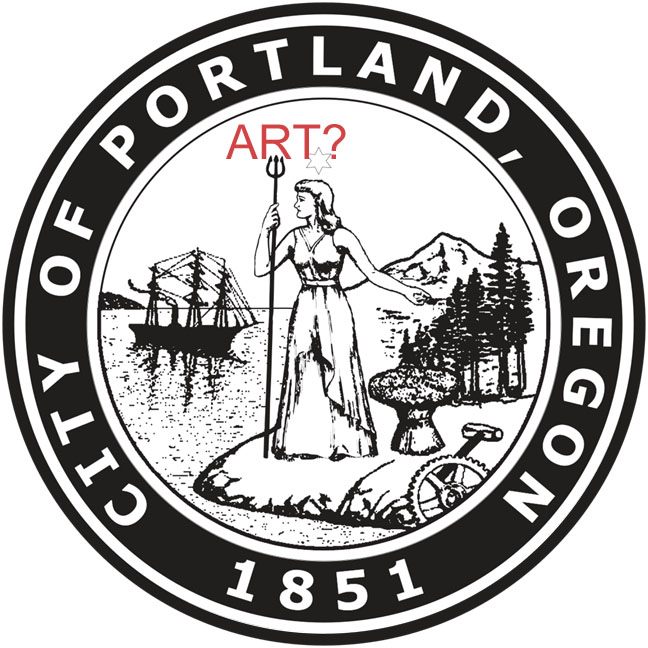 So the beleaguered Mayor of Portland, Ted Wheeler's city survey completely leaves out all mention of the arts as a form of civic participation. That's a tone deaf oversight (sorry Ted I believe you are a talented admin but do you know what makes Portland Portland?... clue its the permissive cultural climate, which is spearheaded by the arts). Keeping Portland's character means supporting the arts ecosystem, which is challenged like never before. That requires more than a namecheck on any document about this place. Yet it doesnt even get a mention. So let's fix this as the survey has numerous places to chose "other" and write in responses. Do it, the squeaky wheel gets the oil so speak! How about access to and support of the arts (visual being my favorite but the varied ecosystem is crucial and I do have a deep background in other areas). For those who feel there are other more pressing matters, well that's a false dichotomy as what we need to support is depth of forms in the arts ecosystem as well as address the homeless and parks. The city doesnt do just one thing and we need all of its organs including the Arts which are kind of like the nerves and glands of the city. Losing great things like several entire colleges and studio buildings is tantamount to losing a coral reef or a rain forest. Get with it Ted, and yeah RRACC... get a clue too. For example, artists cannot get project grants if their work is presented at institutions that get operating funds from RACC... that's essentially a back door tax on the artists that are the lifeblood of the ecosystem. There are other complaints none of which have been addressed by RACC since being called out on them late last year (Since then they've drastically slashed support for many institutions... wrong direction Ted). The art scene does not accept RACC's silence on this and I'm merely one of the few with license to bring it up. The link is here, have at it culturati. Deadline extended through May 31. Posted by Jeff Jahn on May 30, 2019 at 15:39 | Comments (0) PermalinkSaturday 05.25.19 Late May Institutional Links It's safe to say we are in a time of institutional upending, where things are being simultaneously being reconfigured, hollowed out or outright destroyed. Most of it seems knee jerk, follow the parade, performing public wokeness, a war on expertise and overall lacks strategic planning or vision (that's bad as institutions require it). After say 50 year of expansion, the art world for living artists seems to be contracting (except for blue chip commodity art and there dead = bread). Here are some links:
She's 98 and getting her first solo museum exhibition. Good news but why does this take so long? Oh yeah, she's a woman... and her concerns are less easy to commodify. Still its nice to have some good news and a sense of oversights being righted. Looks like Josephine Zarcovich isnt planning on coming back as Linfield's curator. This is part of the overall war on expertise that all elements of the economy have been facing... from taxi drivers to tenured professors and yes institutional curators. It is coming from both the right and the left and a president with no interest in the standards of public service is the top example. Couple things though... I dont think Linfield ever technically had a full time professional curator like Linda Tesner. When I first started going there professors like Liz Obert programmed it, Cris Moss put the place on the map and he did teach as well. Hopefully Linfield can survive the current collapse of higher education and keep up a program worth tracking... the Linfield Gallery under Moss was THE reason to trek out to wine country and they can still do that... even if it is part time if they play their cards right. Another thing The Ford Foundation isnt always helping as much of their support prioritizes academic connections + traditional art forms (painting/sculpture) not the hybridized new mediums involving... (more) Posted by Jeff Jahn on May 25, 2019 at 13:03 | Comments (0) PermalinkMonday 05.06.19 Early May links I've been making the rounds to a lot of galleries and polishing up several think pieces. Till those are ready (soon) here are some links:
The Venice Biennale is a kind of barometer for the art world but to my eyes it still seems to be stuck in the past with a lot of the disaster porn art we've been accustomed to... so much some are calling it the we_are_all_gonna_die-ennial though its aim was for ambiguity (I believe uncertainty is a better subject, splitting hairs but it is important). This Rugoff curated affair has the same kind of failure fetish we have grown accustomed to for a decade+ (it is kind of Rugoff's thing). At least it is more timely than a glitz-ennial, which would be wrong as would a woke-ennial. Still the choice of raw plywood (a favorite with every MFA class) is tired as can be (The MoMA Judd retrospective will expose all pretenders). Here are some more tours of Venice but what I see is a certain stagnant malaise with a longing to escape it. Perhaps that's my curse... I always insist on finding something with a fresh edge rather than some convenient failure to fetish. It is out there, but one has to be looking to see it. What's the U2 lyric, "some places have to be believed to be seen." Right now there is a kind of fetish of fatalism (often accompanied with some quote or footnote by Joan Retallack) that's always playing the victim in a coded and lame way. It has the sound of settling about it and its too easy a look to achieve. All that said, the odd things they approve of, this Breugel book and exhibition seems like a good rejoinder for those who aren't dead inside or still have a healthy habit of intellectual curiosity. Why did this pioneering trustee leave LACMA? See comments about lame anti-intellectual mode mastering trends in the art world. The man had an edge and an understanding. The excellent painter and favorite among those in the know Thomas Nozkowski has died. Here is a wonderful video of what it was like to go hiking with him. Hiking with Thomas Nozkowski from Casimir Nozkowski on Vimeo. Last but not least, Oregon's arts funding for the Oregon Arts Commission is still under threat... take action. Considering the immense amount of economic activity in Oregon it seems unconscionable that arts funding is facing cuts. Posted by Jeff Jahn on May 06, 2019 at 15:49 | Comments (0) PermalinkTuesday 04.30.19 Ending April Institutional Links Whether or not it is fair, most major art institutions are caught in a crossfire these days, whether its forming a line to march in the woke parade, a sense that the 1% has unfairly rigged things too well or artwashing. Things are tense or at least sense of unsettled tension seems to background everything. I'm nearly done going through my archives for my 20 years of being in Portland post. It is about a thousand times more difficult writing about oneself, especially when you are easily bored with yourself like I am. So to distract you with more important things here are some links:
It is your last week to catch The Map is not the Territory at PAM and Grace Kook Anderson spoke to KBOO (isnt it nice to have a curator who speaks very well again at PAM? Too many curators simply perform a certain ingratiating doubletalk). That said Art in America had some problems with the show, mostly because they looked at it through a sort of lens on the indigenous. AiA made some good points but I believe it is conceived to be broader than that. I saw similar problems with The Map Is Not The Territory but attributed them to some of the hang, which for a show about crossing boundaries and communication seemed too bounded by museum conventions and layout problems. It is a difficult step in the right direction. Most group shows are not very satisfying and at this time a show about dissatisfaction might be the only thing that will feel right? Artists, 50 of whom are in the Whitney Biennial are demanding Whitney Chairman's ouster. The banana becomes the sigil of institutional critique in Poland. Jerry Saltz on the upcoming Rugoff curated Venice Biennale. Look, uncertainty is the subject of the age and art as distracting amusement or a series of humblebrag artwashing declarations doesnt really cut it, and hasn't for a long time. As expected Catlin Gabel has bought OCAC and it is over. Ill have more on this in my Portlandageddon article (coming soon, all things in the right time) but all this was needless and nobody buys the agitprop that this could not be avoided and nobody is to blame. Blame = a weak board that was out of their depth and should have stepped down instead of pursuing a policy that put all eggs into merging with another school. Merging could not happen because all tuition based revenue models of higher education are broken... I saw this immediately. OCAC had a lack of vision by creating a leadership gap which ground fundraising momentum to zero, right when they needed it. This is sad especially considering how much most of the community wanted it saved. The situation required real leadership (board and some faculty) that was not inherently fatalistic. Where was the oversight and the understanding that they were in way over their heads? I dont blame Catlin Gabel, they have a super competent board and its a hard lesson that Portland institutions continue to not learn about endowments and stewarding institutional momentum. Posted by Jeff Jahn on April 30, 2019 at 10:08 | Comments (0) PermalinkThursday 04.25.19 Thoughts on Tuski leaving PNCA 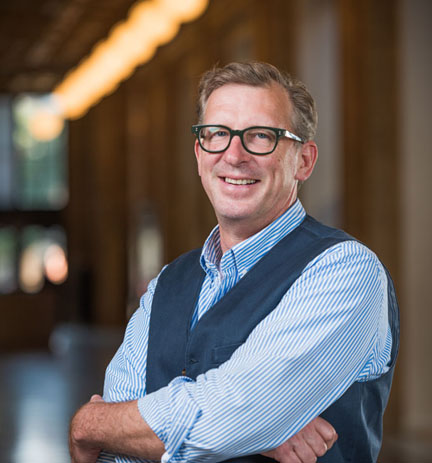 Outgoing PNCA President Don Tuski The news today that Don Tuski, current President of PNCA is leaving the school after only 3 years wasnt unexpected (certain exchanges then lack of follow up were a tell). First, higher education in general is in an incredibly challenging position... that of a destabilized financial model for any tuition based school without state funding (and that's dwindling too). More specific to Tuski, who had a stabilizing influence despite the relentless turmoil of rival school closures and ultimately the decision not to merge with OCAC ... he always seemed like a genial presence rather than the dynamic one of his predecessor (needed for a time). Now that PNCA has been somewhat stabilized (by virtue of outlasting rivals) it really needs a master fundraiser to shore up endowments for scholarships and professor positions as that is the only way to weather the current storm. Seems like Tuski going back to Michigan (in addition to being back to his roots and family) is a return to funders who are trying to reinvest in Michigan. Oregon is a younger state where a lot of the money here hasnt learned how to participate as effectively, leaving only a few Oregon families to take lead roles (most of whom tied heavily to real estate). Real estate money behaves differently than industrial, lumber, financial, new entrepreneurial and tech money (all new money). The Midwest has a different mindset, they realize that without investments all the talent ends up on the coasts. I suggest the next president be a visionary and relentless fundraiser. They should also be a better talent scout than most Portland institutional leaders tend to be. Tuski did have the vision to open a new GLASS building in North Portland, providing large scale ceramics and other staging possibilities. Still, the sense is only the most ambitious and talent driven art schools with the funding to attract those students with scholarships will survive the turmoil of the current student debt crisis and massive cost of education in the coming decade. Yet Portland is full of design and other creative sector firms so the disconnect between where funding/recruitment is placed and where it is derived seems pronounced. Tuski seemed capable but unable to really capture the imagination of Portlanders, perhaps he gave them too much of what they wanted... his predecessor, Tom Manley, was far more ambitious and controversial yet one of the most crucial Portlanders of the 21st century. They both inherited very different times and institutions. Institutionally, Portland has an allergy towards ambitious talent that it needs to get over (the ignoring of Rothko was exhibit A, but now PAM is addressing this so there is hope things are changing). ... (more) Posted by Jeff Jahn on April 25, 2019 at 13:17 | Comments (0) PermalinkMonday 04.15.19 Mid April Links Most of the world has been watching in horror as the 800 year old Notre-Dame Cathedral has been burning. The tall steeple above the nave collapsed but authorities are reporting some of the structure will be saved, including the two north towers of the belfry. *Updates: How close it came to being a total loss and the forests that provided what burnt are nearly gone. In an exciting move France will hold a competition for a new design for the replacement tower that was destroyed and built as part of a 19th century restoration. This is good as an 800 year old cathedral is a living building. I doubt this would happen in the USA as we tend to treat old buildings as antiques rather than living structures tied inexorably to their current age. As expected Foster and Partners is proposing a glass roof like their Reichtag update.
The most powerful work of art Jerry Saltz has ever seen. PORT friend David Anfam, the world's leading Rothko Scholar and Curator of the Clifford Still Museum discusses the Rothko being auctioned off by SFMOMA. I am not a fan of this deacquisition to buy other works by less represented artists but SFMOMA does have better Rothkos and they dont display it very often. That's terrible logic and if SFMOMA were truly committed to telling new stories through their collection they should do it without selling the work by one of the USA's most lauded immigrant artists! It is absurd and unfortunate. This Koons in the collection would be a far better choice (yes yes a partial gift that isnt wholly SFMOMA's but I think PORT readers get the point). That the current Desert X Biennial isnt very sensitive to its surroundings is no surprise... too often art in the desert relies on its otherness rather than compound the situation presented. Some of my favorite works by Walter De Maria, Smithson, Judd and Michael Heizer all understand their inability to compete as an insertion with the site and in fact create "an incompletion" instead. If I were to curate a desert foray... it would have to operate that way (I've actually lived in a desert or 2 and that helps). Not surprisingly the Zumthor LACMA design was approved. Frankly, I liked this design better when it had more gallery space and the curatorial offices were not farmed out to a rental building. Also, I actually like the curving single floor plan. I just dislike the banishing of curatorial expertise... (its a bigger museum problem as less and less curators are expected to be experts and act more like assistant directors). I like Govan's ideas about interdisciplenary non-timeline reliant hangs but it actually takes more expertise to do that right... like having 2 or more great chefs cooking together but now it feels like the curators are being sent a corrosive message. Museums are not just the storage lockers and tax havens of the rich... they are exist as the keepers of culture and that requires human expertise put on display (and it isnt just the art alone... it is the considered display and interplay... when I last visited LACMA there were problems in the displays of interplay). Posted by Jeff Jahn on April 15, 2019 at 14:29 | Comments (0) PermalinkSaturday 04.06.19 Early April Critique of Institution Links Things are coming to a head in LA for LACMA's Zumthor design as funding comes to a vote and detractors have noted it has less space for the permanent collection. Much less apparently. I'm not against this expansion like many voices in LA are but I think the single floor design is a problem as is the decrease in permanent collection space. (Solution add a second floor for curatorial offices and some special focus exhibitions for the permanent collection?) Lately, museums have been having problems activating their permanent collections as well as downgrading the role of expert in house curators. It is part of what Ive been calling the war on expertise (from both ends of the political spectrum). It's terrible and must be countered. Museum expansions should deepen an institution's connection and scope of appreciation of art by lay people and experts alike... they need each other. True intellectuals and artists challenge administrative planning and institutional framing any design that cannot accept that kind of thought pressure isnt the right design and will be seen as culturewashing for the 1%. Zumthor is talented enough to address this as he is one of the world's very best architects. The trick is to make this a gift/investment to LA and not to the 1%. I know Portland with its own looming expansion or two is watching this closely.
In related news, intellectuals and artists are demanding that Kanders be removed from the Whitney board. See above^ I've been saying this for years but uncertainty IS the ultimate subject in contemporary art now, see Venice Biennale... also, a certain artist I am very fond of is the master of this... museum show coming this summer (just being up front about this rather than hinting). I also think Inigo Manglano Ovalle, Jorge Pardo, Anish Kapoor and even Yayoi Kusama also make it a major component of their work. It is at the heart works by Stanley Kubrik, Robert Irwin, Robert Smithson as well as the unmooring of floor and wall in Donald Judd's work are both related as well (I suppose an essay should be undertaken). Overall, it requires a certain unmooring of viewers from reality yet a partial anchor to it (related to the sublime). The Hudson Yards and the Shed have rightfully come under a great deal of critical fire. Posted by Jeff Jahn on April 06, 2019 at 12:06 | Comments (0) PermalinkThursday 03.21.19 More Spring Cleaning I've been busy with several projects (inside and outside Portland)... including curating a somewhat informal Spring show in Portland this weekend. That said I have a large # of reviews to publish (soon, lots going on behind the scenes). Till then these links should tide you over:
With all of the terrible news its nice to hear something positive, C3: Initiative is leaving St. Johns to join the densest visual arts cluster of venues in Portland, right on the NW Park Blocks. We profiled C3 when they were new and they've done many great things since. Frankly its nice to see an organization grow and understand their niche. Another bit of good news is the Historic Landmarks Commission has approved the Rothko Pavilion expansion at PAM. The real trick will be to tailor the Rothko painting exhibition space to his paintings. Often they are lit wrong, dont allow for intimate viewing and have weird lines on the floor to protect the paintings from the required close viewing. Yes, urban legends around Rothko still persist in Portland... all thoroughly debunked in this historic post by Arcy, here on PORT. The sad news of the passing of Okwui Enwezor hits home. Amy Bernstein interviewed the man extensively for PORT in 2009. Other artworlders discuss his legacy here. Here is a fine and challenging interview with Anish Kapoor in the Guardian. Intelligent and anything but fatalistic in his lifelong query via art his work is both generous and thorny. Academia and capitalism... neither is working terribly well these days so combining the two seems like trying to turn two wrongs into a right? The horse ring art project by Scott Wayne Indiana has become a Portland tradition. ...(more on OCAC + social practice) Posted by Jeff Jahn on March 21, 2019 at 20:05 | Comments (0) PermalinkSaturday 03.02.19 Early Spring Cleaning Links First, the BBC takes an incredible look at some long hidden Dr. Seuss, who is still so relevant.
The OCAC saga continues as the board met yesterday with no official announcement. Students protested again on Thursday but as usual certain faculty members set out to shame them into suppressing their concerns. Apparently OCAC comes with lessons in fatalistic suppression? bad form. Look, what has been wrong with this entire thing has been a suppressive attitude from the board and a few faculty enforcers who have taken a similar hospice-like approach with an yen for quashing all critical discussion. I feel for all sides (even the board, which seems out of its league) this is a tough situation with a DOA higher education business model but a cult of fatalism at OCAC is how this mess painted itself into a corner (there are other models). The lack of transparency has been turning natural allies into a Dunning-Kruger polarized mess. Take a breath, find a vision or 4 and turn this crisis into an opportunity by playing different views off each other. It has only been a few weeks since the closure of OCAC was announced and I see how tired everyone is. That makes it a good time to step back... and really is this board capable of giving fresh eyes to this? If its Catlin Gable School, if its a sell and lease back, if it is an aromatherapy spa with a craft brewery and an artist's residency, if it is an artist's park, if its a center for craft that helps veterans off the street all could have positive outcomes but the trick is to pivot the model from a loss to an opportunity. Degeneration of all this into a cycle of fatalism and mistrust (both self fulfilling prophecies)is the first cycle to break before making better decisions. A study finds that artists become famous through their friends not the originality of their work. Ok, one could read that as bad news for the original... though there is a cult of fatalistic/mediocre contemporary work out there where the good is the enemy of the great but Ive found that those patrons and curators with a real eye still exist and are more influential. For example Kahnweiler and Peggy Guggenheim did have an eye and generally its not the richest taste makers who have this ability. It seems like the merely good artists and art institutions are going through a bit of a bubble correction at the moment... Southern California gets a new art center... note to Oregon higher education institutions, enhance not scale back your galleries. A philosopher argues why AI cant be an artist. Really? Im not sure seems like being a mediocre artist isnt that hard and has identifiable trends... like putting studio rags on a wall as paintings or stacking grotty ceramics and some other detritus on a wood grained plinth or some scaffolding with meat hanging from it. Posted by Jeff Jahn on March 02, 2019 at 11:51 | Comments (0) PermalinkWednesday 02.20.19 Save OCAC protests 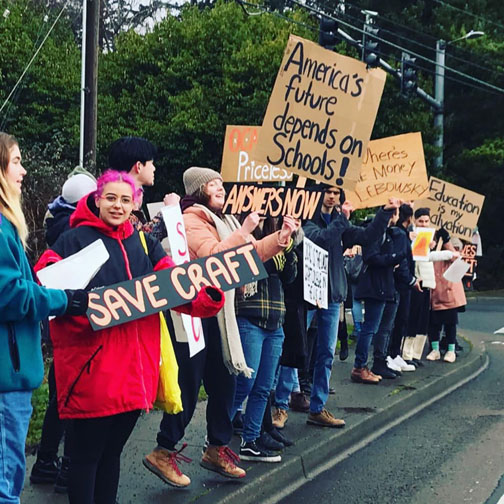 activists protesting to save OCAC This morning protests to save OCAC were ongoing as the board met after moving to an offsite location. Many, including us at PORT have been critical of the secrecy, assumptions and overall tone the board has operated under since the crisis became public... even voting to cease higher education classes at OCAC 2 weeks ago. Word on the street is they are mulling over 3 proposals but as the protester's activity indicates anything other than saving the school is not going to be accepted by the community (whereas the board seems spooked, perhaps understandably but a leadership vacuum is worrisome). A group called The Council To Save OCAC has been formed and the an already existing organization the Friends of OCAC has called for a town hall next week (you can still sign the letter). Those concerned should sign up for both. This is too important to just give up on and sure the business model can be adapted to something sustainable but it takes some leaps of faith... (more) Posted by Jeff Jahn on February 20, 2019 at 11:00 | Comments (0) PermalinkTuesday 02.12.19 February links to Love Stuart Emmons is going full William Wallace on a community charge to save OCAC in this op ed. What is hinted at in the op ed is there is a last ditch community effort underway and I agree, a school is not a simple for profit effort, more like a cultural utility and OCAC represents a lot of the true Portland Ethos acting as a repository and training ground for our values. Clearly, the model and vision still needs to change if there is a bailout but still, the community must try. This is a battle, not a simple balance sheet. Simply selling off assets to retire debt isnt the only way and the community knows it. As far as a new vision, I can see many ways to shift the model away from the broken one of pure higher education, degrees are not the only form of education and this moment in history can desperately use what OCAC offers.
Look, high culture doesnt just pander to one's instagram feed... the higher aims of culture challenges one to grow. It isnt likes that makes the world go round, at the end of the day it is Love... which is more difficult. Nan Goldin stages a die in at the Guggenheim to protest opioid money and deaths. I Love this story about finding an art experience to resonate with. Posted by Jeff Jahn on February 12, 2019 at 8:46 | Comments (0) PermalinkThursday 02.07.19 The end of OCAC? 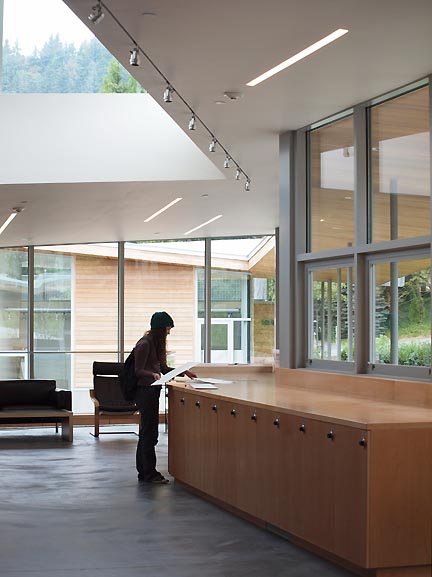 OCAC student using the then new buildings in 2010 There is some incredibly sad news as the Oregon College of Arts and Craft's board of Trustees has voted to cease academic instruction after the final graduating class of 2019. This is an incredibly painful outcome after a seemingly short death spiral that began publicly last summer. Recently, OCAC's board has explored mergers with PNCA and PSU but I never saw those as viable since each school has such a different culture and yet the same underlying weaknesses that all higher education faces today. They needed a new model but could not find one, perhaps simply not being up to that kind of visioning task or perceived risk? Since last Fall OCAC's governing body appeared to be a board that simply wanted another institution to partner in fixing fundamentals at a time when the fundamentals for all higher education are broken. I could liken this situation in higher education to the lifeboats of the Titanic or a hospital patient given a grim prognosis... there are no easy answers but many in the scene still want to fight to save OCAC. In today's statement OCAC's board essentially claim they have run out options and with an interim president the vision gap here was pronounced. I'm seeing immense anger and sadness from many of the arts community regarding this outcome, as well as frustration with the short timeline. Mostly the anger comes from a sense that the board never gave the community a chance to rally and save the school. Those emotions are to be expected but are also energies that can lead to new options and perhaps a better outcome? ... (more) Posted by Jeff Jahn on February 07, 2019 at 16:01 | Comments (0) PermalinkSunday 01.27.19 End of January Links The latest in the OCAC saga is that PSU has decided not to acquire the rival-ish school. As a public school this PSU idea was always a long shot for the private OCAC but not impossible (it takes a bold vision and Portland isnt known for bold institutional thinking). Still, the school needs to be saved, as OCAC is a crucial, even unique entity. The main issue I see is one of vision in the face of a higher education system that is broken, forcing schools to constantly grow enrollment if they dont have prodigious endowments. Vision comes from leaders and OCAC currently does not have a visionary leader... just an understandably spooked board and an interim president (faculty member thrust into this). Plenty of people want to see this school saved but perhaps the best answer is to bear down and draw a line in the sand with a direct campaign. This will take a vision statement and plan that people can rally around (not something that Portland boards ever do). The school itself is quite unique being craft centered and that needs to be highlighted as the asset it is. Let's remember PNCA was in a similar state before Tom Manley came in and helped that school realize some of the untapped momentum it was sitting on. In my mind OCAC needs to remain small and specialized to survive the current crisis in higher education but it also needs to pragmatically innovate. This is something that requires vision... I can see several ways to make the school an innovation leader so it can reposition itself and shore up its fundamentals. The enrollment itself has been stable... unlike Marylhurst University which closed last year. Hopefully the board recognizes... (more)
Contemporary female artists are obsessed with the grotesque... Louise Bourgeios, Eva Hesse and Maria Lassnig were just early pioneers that Marlene Dumas, Tracy Emin, Wangechi Mutu and Kara Walker (to name just a few) have built upon. It is a huge genre in the Northwest too and overdue for a regional survey. Sarah Cain has a lot of good painting moves down in LA. NPR has a great general story about how reaching out to others unlike you generates creative thinking. It is an important reminder. Herzog and de Meuron has revealed their wooden/brutalist mashup design for Vancouver's new art gallery downtown. The use of wood is something PAM should take note of for their coming expansion. Portland Architecture chats about Will Martin (designer for Pioneer Square) with a co-worker. Jerry Saltz on Dana Schutz's latest paintings. I believe the Whitney curators screwed up by not giving the work the right kind of context but as our interview with Schutz shows, bodies are part and parcel of her ouvre. Just because she is white doesn't mean she cant touch that subject matter but it did require far more context in the exhibition. There is a showdown brewing between W.A.G.E. and the Whitney Biennial and its based on the growing sense that artists are underwriting exhibitions by wealthy museums. It is wrong and artists should be compensated fairly for these shows... everyone else at the museums, including installers are paid, why not the artists? Posted by Jeff Jahn on January 27, 2019 at 9:36 | Comments (0) PermalinkMonday 01.07.19 2019 1st links Zaha Hadid's estate is in turmoil. This isn't good for anyone involved, her legacy involves both her kin and those who made her firm great.
These new city rules for brick and mortar buildings in Portland is terrible and threatens to destroy so many venues that make Portland a creative hub. City Council must act in a way that acknowledges the way cultural buildings... even if old and less earthquake resistant are the backbone of our position as a creative center. The arts involve risks, lets acknowledge them and support them. A new movement in British art, research architecture? Italy's government wants a sculpture at the Getty back. Posted by Jeff Jahn on January 07, 2019 at 15:05 | Comments (0) PermalinkThursday 12.27.18 End of 2018 Links 2018 is nearly over, Ill post a list of our biggest stories Saturday and Portlandageddon is coming right at the beginning of 2019. Till then here are some links to tide you over:
Here is Edward Winkleman on the history of art galleries on Artsy. The sense is the business is now driving galleries out of business. Art used to be the refuge of more marginal business mindings. Here is a treat, Amy Sillman on Delacroix. then there are the year end lists (ill just publish our top posts tomorrow): New York Times Hyperallergic Dayton Ohio, looks like they had a good year This interview with David Lynch in Plazm isn't quite ruined by the annoying and cloying tone the interviewer takes. *Update: the Art Gym's records are headed to the Portland Art Museum. So a program becomes an archive... I must note that the PCVA's even more storied archive lives there as well. Overall, Im curious about what will happen to the Crumpacker Library archives after PAM's planned renovation/expansion? Hopefully this opportunity to make the library better known and accessed is seized upon. Also, the space vacated by the library will become a large contemporary gallery space. All that said, any move of the Art Gym away from its Marylhurst site changes things... one really can't turn back the clock. The thing is Portland should be creating more ideal organs of culture to serve its crucial art scene rather than just reshuffle the decks. Posted by Jeff Jahn on December 27, 2018 at 14:10 | Comments (0) PermalinkFriday 12.14.18 PNCA + OCAC Merger Off 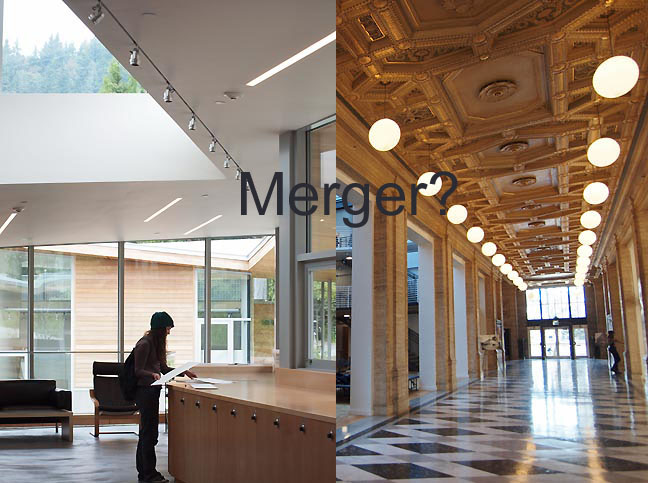 PORT was just notified that the proposed merger between Oregon College of Art and Craft and Pacific Northwest College of Art is for now off after PNCA and OCAC board meetings. To us at PORT this merger never made sense other than for the fetish of this # of 1000 students but its clear that the much smaller OCAC needs a fairy godmother of sorts and the main problem is that higher education as a system seems to be collapsing under costs and student debt. OCAC has grown but I just cant see it having 1000+ students, ever. I suspect that would kill what is special about the college. Ultimately, PNCA and OCAC simply shared the same inherent needs/weaknesses and I likened the idea as trying to find a date for the holidays only to wonder about the long term feasibility? Instead, I think OCAC should think outside the box (how about OHSU, or a massive save craft campaign? Nick Offerman will be in the area in April folks, he's the face of craft... engage him). What's more PNCA should do what it has been doing by focusing on deepening their disciplines. The point is there are competitive advantages that need attention that a merger would be a distraction to. An art school that loses focus doesnt survive, it is just that simple and OCAC is special as a craft focused school. That said no one wants to see OCAC close like Marylhurst University recently did so OCAC needs a capital campaign and this is a major donation time. Ultimately OCAC is without an experienced president and therefore has a vision vacuum at the moment. (The whole merger was originally presented as a fait accompli, which seemed hasty). Here is PNCA's statement: "Over the last three months, Pacific Northwest College of Art (PNCA) and Oregon College of Art and Craft (OCAC) have explored the potential of consolidating their two institutions. Today, PNCA's Board of Governors has made the determination that a merger at this time is not a feasible option and voted to decline the opportunity with OCAC. Both institutions entered these conversations with strong intention and dedicated rigor, engaging in an inclusive process that included faculty, staff and members of the board from both institutions. The PNCA community holds our colleagues at OCAC in high regard, recognizing their contribution to the American Crafts movement, art education and the rich legacy of the arts and creativity in the Pacific Northwest. OCAC has stated its intention to remain dedicated to providing the highest level of arts education in the City of Portland and throughout the Pacific Northwest. We wish them only success in moving forward." Here is OCAC's statement: "During the last 3 months, OCAC and PNCA have completed a due diligence and negotiations process to understand the potential benefits and challenges of merging our two institutions. Today, both OCAC's Board of Trustees and PNCA's Board of Governors made the decision that a merger at this time is not a feasible option for our respective organizations. OCAC and PNCA remain dedicated to providing the highest level of arts education in the City of Portland and throughout the Pacific Northwest. The OCAC leadership is exploring other exciting opportunities to ensure the sustainability of our college and campus. We continue to be fully committed to finding the best possible pathway to a brighter future." Perhaps an innovative public private partnership? Perhaps a non art school? Either way nobody wants to lose OCAC and a committed campaign with vision needs to be mounted. Posted by Jeff Jahn on December 14, 2018 at 15:11 | Comments (0) PermalinkTuesday 12.04.18 Hoffman Gallery Changes at Lewis and Clark? 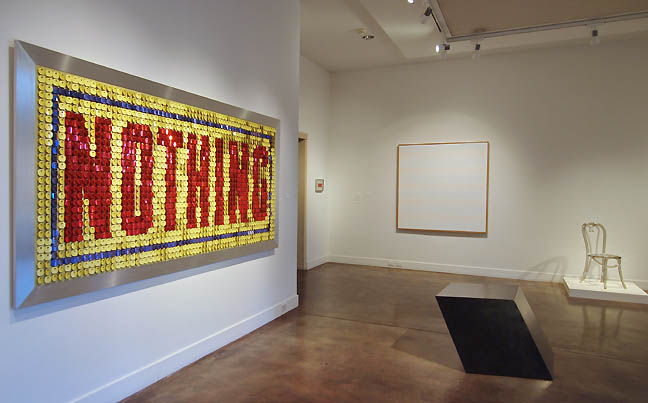 2016's Open This End at the Hoffman Gallery (L to R) Jack Pierson, Andy Warhol, Agnes Martin, Tony Smith and Rita Mcbride **There will be updates as they come in Lewis and Clark College, known for being perhaps the most liberal of all of Portland's Liberal Arts Colleges has decided to "change....toward a more student-centered and student-responsive gallery experience at the end of this school year." That means their excellent curator Linda Tesner has been laid off and according to the school, "we plan to look for a faculty member to lead that process." The question remains is that a professional curator? Linda did shows of startling international caliber but also mounted excellent student and faulty shows that all benefited from a higher level of competence. Portland institutions are terrible at assessing caliber of cultural programs and it will be very difficult for this development to not become a downgrade. How does an institution that touts itself as, "A private college with a public conscience," defend an inward navel gazing + likely cost saving measure? How do the today's students feel now that they are being expected to program their own art experience when for 20 years previous students had a very interactive, socially conscious high caliber professional curator? At first I heard that the space was closing at the end of the school year, which seemed incredibly short sighted as this is one of the jewels in Portland's cultural scene and nothing could be more crucial to a Liberal Arts education than the actual "Arts." For years there has been bureaucratic pressure (like renting the gallery space etc.) but now the director+curator Linda Tesner has been laid off, despite having done an excellent job curating shows like: The world class: Open this End and this stunner and Alison Saar. Reading between the lines this move seems to devalue the curatorial expertise and contributions just like the the closure of the White Box did to their director. (Changing leadership when someone is doing a great job and is popular always looks odd to art critics). Then there was the way the Art Gym's cancelled move to OCAC displaced longtime OCAC staff (its bad to have institutions displacing each other). I can say I never heard L&C art students complain that the Hoffman wasnt challenging or current or engaged enough, the opposite actually. Instead, it was without a doubt one of the best run spaces in the West Coast but always seemed to lack support from some higher ups. Will that change? contact L&C's president and tell them what you think: president@lclark.edu The irony is deep as now L&C President Wim Weiwel will have the main gallery of PSU's new art museum named after him and I know for a fact he likes attending art exhibitions. Many in the arts community consider this a crushing blow and an act of philistinism in a school with an otherwise enlightened reputation that is being tarnished, needlessly. True this is happening all over the country but L&C is a wealthy with a very progressive reputation. This is extremely unfortunate and The Hoffman rightly drew accoclades from Peter Plagens in the Wall Street Journal in 2012 for its student exhibition. Alumni Response: 2012 graduate Drew Linehan described the news as, "remarkably disappointing." 2003 graduate Leah Emkin was shocked saying, "The Hoffman was an integral part of our arts program. Linda was very inspirational as a woman leader in the arts." Other Alumni indicated how the Hoffman under Tesner made the campus less isolated and brought the world to the wealthy enclave in the West Hills. How does looking more inward institutionally help a supposedly ultra-liberal arts college? Something does not sit right... a bit like a big hospital without a surgeon and replacing them with a part time medic. It just isnt the same thing unless the caliber of director remains and from everything I heard over the years it may have contributed to some bureaucratic aca-envy. Linda's program mounted large scale shows for local artists and L&C faculty as well as international artists. This exhibition and cultural exchange with Cuban artists and L&C students is a prime example of the great things Linda did that apparently was not valued. What this seems to be is a bureaucratic push for a different director so the question must be will it be be for someone of comparable expertise and program of comparable caliber? With the loss of so many institutions like the Museum of Contemporary Craft, White Box, Newspace, Art Gym etc. it seems like depth of long term curatorial experience that informs challenging shows doesnt seem to be valued very much. Agendas in higher ed can be some of the most political. Yet, what I liked about Linda is she was one of the most fair minded people in the art scene. The arts arent just a mouthpiece, they are an exploration and I'll be watching this closely. What is sure here is that Linda leaves very large shoes to fill as the Hoffman is not a tiny gallery. It is a large museum style space that requires a lot of experience and preparations to program. Its not the sort of space a faculty member can just pull off as a side gig and in general I fear for the state of L&C's art program. Lastly, let's all go and show our support this weekend. The current exhibition is one of their all time best and will host a closing event on Sunday December 9th from 2-4PM with a Gallery Talk and Pie Tutorial. Loss of Material Evidence | September 8 - December 9 Hoffman Gallery Lewis and Clark College Posted by Jeff Jahn on December 04, 2018 at 12:30 | Comments (0) PermalinkSaturday 11.24.18 Giving Thanks Readings How to talk to kids about art? I dont have kids but I spend a lot of time talking to kids about, partially because they see things adults do not. maybe I should do an article about how kids teach adults to look at art?
A Tinguely is restored to its commotions! Art doesn't always sit quietly in the corner. The artificial divide between textiles and art? In some ways this battle is already over intellectually but not in markets or museum space (hidebound by conservative investment conventions rather than intellectually)). Francis Bacon on how to be an artist... The Menil's new Drawing exhibition facilities set new standards of seriousness. Posted by Jeff Jahn on November 24, 2018 at 14:40 | Comments (0) PermalinkWednesday 11.14.18 Meet RACC's new leader Madison Cario 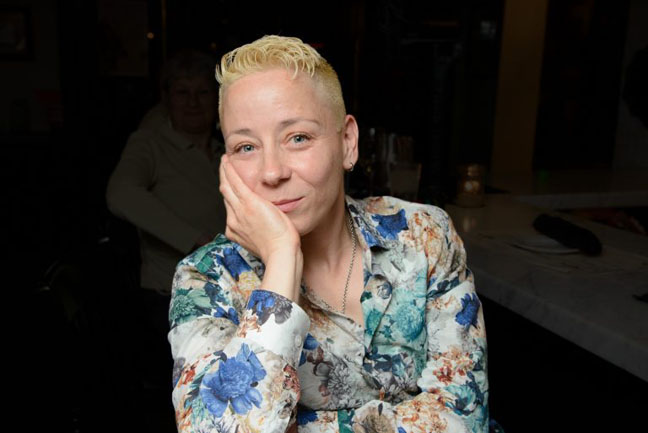
RACC (Regional Arts and Culture Council) and the main public granting agency has finally announced that they have chosen a new executive director, Madison Cario. Cario seems to have an easy, direct but informal way about them that should fit in well in Portland. As a former marine and someone who didn't grow up with arts and culture they seem well placed to inject the decisiveness the agency (which used the word "quirky" too much [even once is too much] and "excellence" hardly if ever in communications). Over the years artists have asked for a lot of reforms and to be sure some have been adopted but the sense is the agency aims too low in terms of ambition... coming off at least a decade or more behind the bleeding edge of Portland's very dynamic cultural scene. Luckily, Casio has been a curator (science and technology oriented visual arts even) and not just a bureaucrat. The question will be if they will merely implement token multiculturalism or if Cario can make the agency become a more important cultural ally in keeping Portland's cultural edge keen? Till now many of its practices have had a dulling effect as Portland likes to pat itself on the back without really challenging the status quo (some important art does make people uncomfortable). Most of our exhibitions institutionally try a little to hard to soften their criticisms, yet the sharpest artists themselves have a great deal of edge. I call this Portland's Artist/Institutional schism and RACC is central in this discussion. You can watch this video to get a sense of Cario: Contemporary Talks: Madison Cario from Jason Parker on Vimeo. Now with City Council calling for an arts affordability plan (it needs to be an arts sustainability and retaining/encouraging creative edge plan) RACC is crucial to executing that effectively. To do that the agency needs a lot of reforms that the cultural scene has calling for decades now. Here are a couple of things that really need to be looked at immediately: ... (more) Posted by Jeff Jahn on November 14, 2018 at 12:43 | Comments (0) PermalinkTuesday 11.06.18 Early November Links Weve got a huge amount of stuff coming for you including reviews and Portlandageddon. But first lets look at some news:
One time Portlander and long time PORT pal Paul Middendorf has re-launched the institution he started in Portland and continued in Houston. Paul is the best kind of person and a hero of the Portland (artists into the city) and Houston (real water) floods... but some well known Portland art scene figures didn't support him (you know who you are, I'm talking institutional people and it wasnt simply money). Well he's proven himself in Houston (just like Portland) yet he's been appreciated more there. Portland's City Council and other leaders who are looking at Portland's art scene need to ask... huh, what could we have done better and apply it to those who are still in Portland? Sometimes Portland's art scene politics are detrimental in their parochial character. That said lots of new, great things have sprung up since, Open Signal, Carnation Contemporary, regime change at Disjecta etc. (History lesson = Paul was Disjecta's first and last non guest curator and the only male staff curator ...though Cris Moss did curate a biennial.) Daniel Nord's almost skeletal sci-fi might seem a bit unsettling but it is exactly the kind of work that is relevant now. Perhaps the art world might be sick of laughing at the same old jokes about itself? Chicago's Mayor does the right thing and pulls a Kerry James Marshall mural from a Christies auction. Look, public art isnt just some asset to flip when the street repair fund is low. Think of it as a public museum collection that enriches the city, not a rainy day fund. The artist said as much in an interview today. Essentially these are civic treasures held in trust by government... the fact that this was actually considered shows how atrophied civics have become in the quantification of assets as some sort of portfolio to manage. 
Speaking of civics, the biggest story in Portland right now outside of the elections is the now planned merger of OCAC and PNCA. This is hardly a done deal though it is being presented as such. There has been precious little info with no public statements but Im of two minds on this and nothing has changed since my initial assessment. For history's sake I'll point out how I worried far more about the previous Museum of Contemporary Craft merger than any other media, which sadly turned out to be correct so take that into account. PNCA has informed their staff and students more than OCAC has, and OCAC is operating in a leadership vacuum with an inexperienced interim president and a board that likely got spooked by something after the State of Oregon's Attorney General started looking into the Art Gym's move to OCAC (timing suggests this). Non profit boards in Oregon tend to be That means a weak bargaining position. The thing is(just like the MoCC merger, and I was the only media to mention this) is they need a kind of autonomy and checks and balances that come from an endowment. I've heard numerous times about a 5 million dollar endowment drive, which is needed whether or not the schools combine. That's good as higher education is broken, with only endowments to support general fund, teaching positions and scholarships as the only protection. The thing is this merger really only makes sense if it produces an institution with greater vision than PNCA and OCAC already have. Considering the way committees seem to run higher education Im deeply suspicious of happening (which means Id love to be wrong/surprised). The way we are hearing only 1 narrative seems to be building suspicions among staff and alumni for both schools... and the way OCAC staff, students and alum are very wary of reprisals now is not ideal (all stemming from a weakness in the board and placeholder interim president (not slight intended she's been thrust into this and would be difficult for a seasoned pro). All that said the best MFA program in the state is the joint OCAC+PNCA Applied Craft and Design and a new combined school that keeps the core mountain village community that OCAC represents, with a more focused PNCA all under a new name (please no Portland Institute for the Arts and Crafts aka "PIAC") could be good if it has vision. Instead, right now I see something akin to a human relationship where both schools are afraid to be alone in some drive for 1000 students as a quorum of safety? So what happens after the holidays? Some ideas: If this does happen, try to find a way to put the Craft Collection on better display (OCAC has a small but important collection too) and an exit strategy if it doesnt work out as planned because ultimately both schools problems are brought on by a broken higher education system. Otherwise I cant see how that narrative gets redirected to something more positive without some real visionary planning and some clear checks and balances (OCAC needs its own senior fundraising officer if it merges). Still waiting on details and a whole public mea culpa for OCAC's board has to be done just as it was for the MOCC, which held public meetings. It is delicate, I appreciate that but Portland is in no mood to lose another crucial institution without some transparency and it would be smarter to release some basic statements that set some expectations because with the MOCC failure most will assume similar outcomes. I personally dont believe that but as I speak to others that's the tone things have mostly taken. Of all the conversations Ive had only a few have expressed great faith in preserving what makes OCAC so special.... that's a failure in the rollout of this story, though it is correctable. Posted by Jeff Jahn on November 06, 2018 at 10:14 | Comments (0) PermalinkTuesday 10.23.18 Countdown to Portlandageddon? 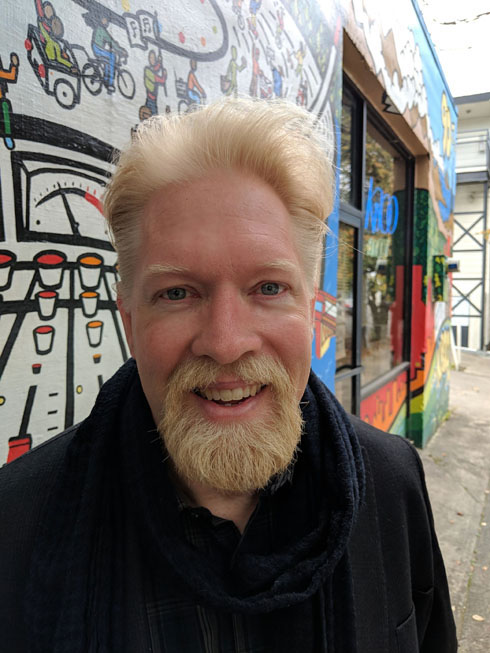
photo: Joseph Gallivan The Portland art scene is due for a thorough physical and KBOO's Joseph Gallivan interviews me as a bit of tease for what's in store today at 11:30AM. Look back later here for Part I of Portlandageddon a thorough anatomy of the scene at the moment and recent past with some predictions for the future. It isn't all bad news either. True criticism isn't a beat down, its a way to gain a more faceted and focused view to address concerns and shortcomings as well as celebrate and further support advances that have already distinguished themselves. I take a look at most every major institution and trend in trendsetting Portland but if you want background and a refresher before then please check out these articles: This critical look at what little we know about the potential OCAC/PNCA art school merger. So little is known but it is supposed to come before the boards of both schools by the end of the month. Much of what I wrote here in 2012 hasn't changed but what I foresaw way back in 2000-2003 has already happened. Portland needs to turn a corner or risk what makes it special... some of this is finally happening with City Hall's Arts Affordability Plan but its scope and vision is too limited. Portlandageddon will point out many of its biggest holes (good news no new organizations or taxes are required but it does require a clearer purpose in our arts funding mechanisms). Posted by Jeff Jahn on October 23, 2018 at 10:00 | Comments (0) PermalinkFriday 10.19.18 Mid October Links including PNCA/OCAC merger talks I've been traveling for nearly a month but some big things are afoot. Time to catch up.

The biggest story in Portland right now is the proposed merger of PNCA (Pacific Northwest College of Art and OCAC (Oregon College of Arts and Craft), but it doesn't seem to have received much press besides this Oregonian piece (with their characteristic lack of critical thinking). Well, that changes now. I've worked with both schools extensively and even served as a mentor for their joint MFA in Applied Craft and Design, so they have shown they can combine forces effectively. Thus, on the surface it seems like another one of Portland's typical, let's combine forces, moments but I wonder what is really driving it? OCAC's President stepped down September 10th so that means that its really OCAC's board driving this. I have a lot of questions as both schools are so different and am suspicious of a march towards monoculture and inherently prefer different types of schools with autonomy. That said higher education currently has major systemic problems. Here are a few starter questions: 1)Why the short time frame for such a major decision? How dire is this? 2)Is the current board at OCAC and interim President's administration still fundraising? 3)It seems like PNCA and OCAC share the exact same problems regarding enrollment and the inherent issues all higher education seem to be awash in. I dont see how this improves either's situation except short term, so how? 4)We have seen a lot of institutional mergers and like the Museum of Contemporary Craft with PNCA they havent resolved optimally. How is the vision here different? How to ensure the identity of each is preserved? (hint it takes an endowment but if that's the case OCAC should just do an endowment drive itself... perhaps the board doesnt feel up to the challenge and is just being expedient... that isnt a good reason to do it). *Update On Friday night a meeting with concerned OCAC Alumni and OCAC's Administration took place. By all reports it was one of those tough meetings that everyone was glad reconnect to each other with such dire news. Ive heard conflicting reports that attendees were, "asked not to discuss it with those who were not at the meeting ,"(they simply cant ask that and yes people are talking). Another report indicated they were encouraged to share info with other alums and the community. (so far there has been no official position for me to refer to, but both sides seem pretty clear in their own understanding). Apparently the meeting was open to press but was not indicated as such and those that understood it as a closed discussion, along with the timing drove many away that wanted to attend. I've also heard that OCAC never really indicated what was driving this rush to merge. More importantly, only one option "Merger" was presented as an inevitability. Many alumni and I myself question the lack of options and creativity in the situation. At this point both OCAC and PNCA probably need to make a public statement (that Oregonian article doesnt count) and my questions for OCAC's board remain. How engaged is OCAC's board? It seems like only one option is being pursued... which seems like a board giving up on fixing it themselves and counting on PNCA to be a deus ex machina to save the school. Portland has seen a lot of that lately and lost too many crucial arts institutions like the Museum of Contemporary Craft, Marylhurst University, the art institute of Portland, The White Box at the U of O, etc (all without a proper fight to save the institutions). I also think City Hall should chime in on this and this is Chloe Eudaly's first test as the New Arts Commissioner. Mayor Ted Wheeler also needs to show an interest. If PNCA is the only way to save OCAC Id be behind that, but the case and details for it have not been made. Also, I worry about PNCA's health if a merger takes place (both schools share the same problems). Overall, Portland's very active residents are in no mood to lose or weaken the very core arts institutions that help make Portland what it is. It appears there is some crisis driving this, but a crisis creates special fundraising opportunities. There has been the customary talk of "transparency" but a lack of official statements and a limited meeting without key information indicate something else and this needs to be handled better. I do think everyone involved is acting in good faith but the main questions regarding vision, current situation and options are main questions for OCAC's board. There will be more press on PORT and elsewhere The Manny Farber exhibition and Helen Molesworth's final curatorial contribution at MOCA look invigorating. Why are museums so adverse to strong curatorial presences these days? So often today the major museum curators just subcontract out to guest curators and though I enjoy a good guest curated show as the next person I also see a lack of curatorial backbone with a preference for ingratiation in the practice. Bruce Nauman reappears and the NY Times pays attention. What Nauman does best is create a kind of crisis of attention, what could be more current than that? David Anfam reviews a new Pollock book that is too academicized. Odd how being arch academic has become anti-intellectual, but it has been the trend for years now. Every artist who goes to art school to rationalize their use of hanging sausages, spray foam, stained tarps (dropcloths?), grotty ceramics and or raw plywood shelves, tables or plinths is also a product of this drive to out humblebrag eachother and its a wasted effort in a world that has so much serious stuff going on. Posted by Jeff Jahn on October 19, 2018 at 9:06 | Comments (0) PermalinkMonday 10.15.18 Paul Allen, philanthropist and arts champion dead at 65 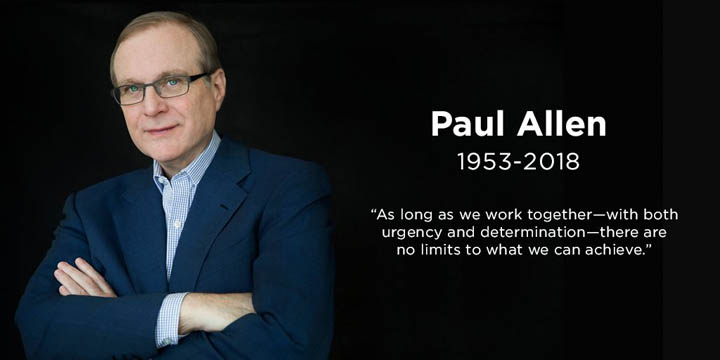
CNN is reporting that Paul Allen has died at age 65 and implies he was fighting cancer aggressively. For me he always seemed like an arch geek (this is a compliment) and unlike most tech billionaires was very involved in the visual arts (including numerous Pacific Northwest art institutions). I reviewed part of Allen's art collection here when on view at the Portland Art Museum. I never met him or I might write more but as a fellow guitarist I imagined Id chat with him about those simple things someday. It wont happen but I hope this spurs others on to do more with the means they have... The problem with most cultural support in the USA is that it falls to too few donors to be deus ex machinas of culture. 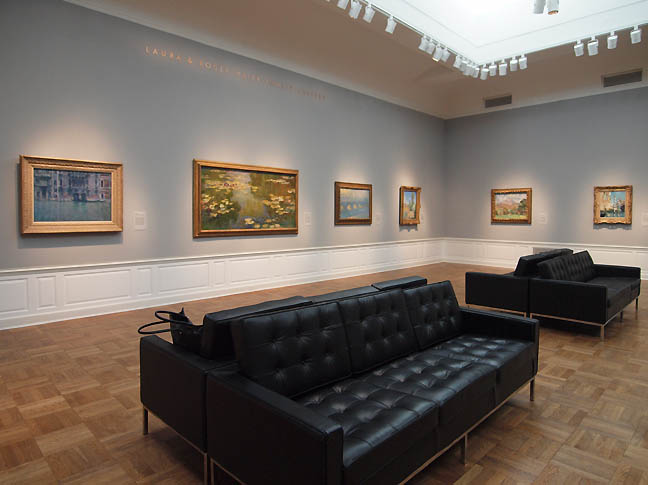
Major landscape artists on display at PAM from Paul Allen's Collection in 2015 Some will complain that he was mercurial and to be sure less charitable sorts will complain about his on again, off again interest and support in projects and organizations but I maintain that sort of intense involvement also drew attention to the need for broader support to ensure continuity of programming. Allen dreamt big and sometimes cut things off abruptly but put his foot down to launch the Seattle Art Fair and other projects that loom large in Seattle and Portland (where he was very active). He did hundreds of more important things besides the visual arts but his passion was what I respected most. Without passion we just have a dull progression of culture, which defeats the purpose of culture. Rest in Peace... if every tech billionaire got as involved as he did the arts and culture as a whole would be valued differently. Posted by Jeff Jahn on October 15, 2018 at 15:59 | Comments (0) PermalinkSunday 09.30.18 End of September News It isnt so much the end of September but the beginning of Fall, that said there are some serious things afoot:
Back in July PORT was the first to uncover the important involvement of Oregon's Attorney General in the transfer of the Art Gym to OCAC, namely the status of the endowment. Yesterday, it was announced that both parties were walking away from that plan after the AG needed to look deeper into the situation of the Art Gym. This is certainly a more perilous situation and throws the Art Gym's survival into doubt. My take is that perhaps thousands of people have donated to the Art Gym and the AG wants to research their wishes. There is an endowment... and I hope the AG is doing this to ensure the endowment is allowed to support the Art Gym? If it is about Marylhurst University assets (like the Art Gym) coming into play in some larger financial entanglement? ... then I am wary. Also, is something moving into the Marylhurst campus that could allow the Art Gym to stay on the grounds? The Art Gym is important to the cultural scene of Oregon and I want it to stay that way. Contact the Attorney General Ellen Rosenblum here, especially if you ever donated to the Art Gym. Ai Weiwei discusses the destruction of his studio. Was Starry Night influenced by Great Wave? Kboo interviews new artist run space Carnation Contemporary. Posted by Jeff Jahn on September 30, 2018 at 9:09 | Comments (0) PermalinkWednesday 09.19.18 Mid September Art News I've seen so many shows and there are some great reviews and a pretty massive article on the way but to tide you over here's what is new:
Jeffrey Deitch returns to LA... Here is a wonderful review of David Wojnarowicz's retrospective at the Whitney in the Washington Post. Here's a fascinating take on art criticism... that it is becoming more common, less judgemental and somehow quite similar no matter where it is being perpetrated? Lots to disagree with there and I've found most dont understand what art criticism can really do and the loooong article I've been working on forever really gets into it, with some new wrinkles. Let's just say the that the ambitions, pecadilleos and greater failures of the moment are laid bare in criticism and most art writing isn't actually criticism. The way a critic conducts themselves is actually a kind of theater that determines a lot of the effect... and worth of what they do. Let's just say that simply tossing a few stones only creates ripples on very calm waters. Joseph Gallivan of Kboo interviews Dana Lynn Lewis for her upcoming public art piece. A review of Avantika Bawa's latest show at PAM's reinvigorated APEX Program series. I still prefer her installation art but it is a very good show and I'm curious how it will shift her career? Shows at PAM that alter careers... what a much needed development that is. Nan Goldin responds to Sackler patenting an anti addiction drug for Oxycontin. Posted by Jeff Jahn on September 19, 2018 at 19:50 | Comments (0) PermalinkMonday 09.10.18 Early September Links I've been looking at so many shows and writing so much (+other things behind the scenes)that I havent had time to do many posts. Till then here are some links:
The Tate is outsourcing its biographies to Wikipedia. This is what happens when museums get away from their relationship with artists. Rising costs in Berlin are affecting artists like most other interesting places. The question is what can cities do about it... Ive got some ideas for Portland. Chistopher Chichocki's art looks at the Salton Sea. Jerry Saltz on Hilma af Klint. And Brian Libby writes about a Portland home (full of art) in the New York Times. An interview with Liza Lou on her latest show. *Update Brian Libby interviews Brian Ferriso and one of the architects working on PAM's new expansion. I interpret all of this as a good direction. The original renderings were very vanilla, plain almost to a fault but now that the pathway is to remain open it also affords an opportunity. Ferriso and I have discussed connecting to the parkspace and the community for years now... with lots of warning from me about being "too museumy") and it seems like an enhanced level of that integration and transparency will now be a goal. Of course funding gets put into the mix there but it is a complicated site and requires some innovative thinking... an off the shelf museum-style solution isnt enough. Think like a garden amenity etc. Losing the staircase is good, it was clunky. As with all things becoming more obsequious/elegant in architecture costs more but only a little more and is worth it. I met with Vinci Hamp last winter and their interior details are impressive. I challenge everyone from City Hall to PAM and its architectural team to dream a little harder... it will make funding easier as the middle of the road is the best place to be hit by the bus of mediocrity. Yes, Brian you'll be my first call if I draw a winning lottery ticket to facilitate this and in liu I'm challenging PAM's patrons to expect a bit more as well. Museum expansions are rare things. This expansion should be a reflection of the ethos Portland has grown into and signal towards what we as a city seek to become. Right now the renderings lack the detail to judge on those terms and the details are everything. So far this revision signals good things but the details really matter. Before the details get finalized though a full reckoning of what this means to Portland has to get shaken out. Ive got a huge article in the works and I dig in to most everything. Stay tuned. ...(more) Posted by Jeff Jahn on September 10, 2018 at 14:20 | Comments (0) PermalinkMonday 08.27.18 Museumy Links Here is a fascinating look at the history of deaccessioning in Museums. It wasn't always a negative thing but today it always seems to be some money grab letting the 1% pilfer the public good for profit.
Andrea Fraser has a new book exploring art and political contributions. The occult in art is an interesting curatorial exploration, for some reason we never see shows like this in Portland, they would be incredibly popular but we just dont do that many interesting group show in Portland. Brian Libby looks at the implications of Avantika Bawa's solo show at PAM's now rejuvenated APEX series. Portland isnt good at valuing things of excellence in its midst unless you put bacon on it... PAM is starting to buck that. PAM is looking at building an under the pavilion walkway to keep from obstructing pedestrians with the Rothko Pavilion. They should figure out a way to turn it into a window display venue. Design-wise it is a great opportunity to engage the city but often institutions in Portland never think outside the box... its odd because Portland loves breaking with formalities. Make the breezeway and exciting design element and turn it into a positive win-win. Last but not least here is a great interview with an influential former Director of MOCA. I agree MOCA needs vision... not just simple nuts and bolts type leadership. Museums are too caught up in their own administrative risk management and not in how they serve their communities... they gesture towards community and education but what they really should do is become talking points for larger ideas within civilization. Now celebrities are kind of a mcguffin... they dont all suck (only most of them). Some adventurous ones can help move things forward and MOCA needs to reinstitute a culture of adventurous expertise. The trick is to be rigorous and smart not pandering and cloying, nobody really wants a museum to be their friend. Instead we want it to be a gym for the mind and eyes, with some heavy equipment and kick ass trainers. Posted by Jeff Jahn on August 27, 2018 at 15:38 | Comments (0) PermalinkFriday 08.17.18 Mid August Links I am polishing off a pretty massive article but until then here are some good reads:
A controversial mural depicting slaves in Kentucky receives an elegant treatment that highlights the oppressed. Stuart Horodner (the best = edgiest+challenging visual arts curator PICA ever had) was involved in this solution. Bravo! The world's formost expert on Abstract Expressionism (and PORT reader) David Anfam reviews a show that tries to connect abEx and Impressionism. Ai Weiwei responds to the destruction of his studio. PORT interviewed Mr. Ai years ago. Berlin artists not having an easier go at it. Not news, but it is that way everywhere, yet art has never received such clout economically. An artist visualizes Big Data. Posted by Jeff Jahn on August 17, 2018 at 9:47 | Comments (0) PermalinkWednesday 08.08.18 Early August Art News This just in, Portland's Mayor Wheeler has reassigned the Arts and Culture Liaison to Commissioner Chloe Eudaly. Frankly, City Comissioner Nick Fish has always cared and done a decent job till now but Wheeler is right the city is at a crossroads. Notably, I appeared before the council 6 months ago and let them have it for their arts affordability plan. It doesn't get at the real issue... where Portland has to become serious about its intentions and how it allocates resources it already has (RACC requires an overhaul, they have improved but still lag behind the cities international cultural ecosystem). The insulting photo of a child at play with paint on the cover of the arts affordability plan pretty much infantilized what is a serious industry in Portland. I heard from a lot of movers and shakers right after I appeared in front of the council, beseeching them to get serious. It really isnt an arts "affordability plan"... its a plan to keep Portland's dynamic cultural edge. We need to look at why, when and how we support the arts and have a clearly articulated plan. In front of the council I mentioned how Houston always considers how it is an international arts hub. Portland is a player, and has been for a long time but the city's leadership and institutions generally have suffered from a lack of vision. Sure there have been steps like PNCA, PSU's new Museum, Rothko and the Japanese Garden, there has been a lot of growing up in the past 20 years but its time for city hall to pursue a plan other than benign neglect in regards to its artists, which are its main repositories of cultural cache. Congratulations Commissioner Eudaly! You will need to be on point, and no the experience of other cities and your own background in the community will only go so far. Most in the arts in Portland are working only in their institutions or businesses and they really dont get to do a lot of big picture thinking. That is what is necessary, and yes that article I've been working on is coming soon.
The Grey Market continues to look at the Biesenbach appointment at MOCA. Look, a lot has been made about rebuilding administratively but I do believe they need vision. They do need more space so the Panza collection and other holdings can shine but they also need an intellectual vision... the right curators can do that but they need to take risks. MOCA has made huge errors by being intellectually risk adverse lately. Biesenbach needs to alter that but he also needs to avoid LA's solipsism (curate a show on LA's solipsism and be done with it) and instead be the point museum on the pacific for global perspectives. Also, nobody has said it yet so I will: "The reason everyone is looking at LA and the west coast is because the East Coast missed the boat and produced the Trump/Hilary situation... the west coast was not excited about either one and California/Oregon/Washington is now the seat of progressive thinking. We are no longer looking back at East, but certainly all good ideas are welcome." There, everyone wants LA to grow up so the whole country can get on with a more mature phase. Portland looking beyond Portlandia... ofc, yeah we were beyond it before it even aired but this fluff article has a good title and I've been thinking a great deal about it. Portland is the capital of the USA's conscience, maybe not the only place involved in the discussion but it is ground zero for the main event. Ai Weiwei's studio has been demolished. Seattle art fair going for the quirk hype Portland is pretty tired of? Posted by Jeff Jahn on August 08, 2018 at 17:01 | Comments (0) PermalinkTuesday 07.31.18 End of July News Is it the End of July or the end of civilization? Just kidding but I have to ask it:
Klaus Biesenbach will be the new Director of MoCA. Well he does like celebrities, which is something you need to embrace if you are going to get MoCA back on track. But can they replace all the curatorial expertise the institution has squandered in the last decade like Alma Ruiz, Helen, Molesworth and Paul Schimmel. Can Biesenbach rebuild that? For an unecessary sports metaphor think of this as "a rebuilding season" because MoCA has lost so much talent. Also, as LACMA reaches the home stretch on its new building campaign will MOCA right itself and expand enough to put its permanent collection to better use? If so I challenge Biesenbach to do so that reinvigorates the tradition of intense and opinionated curatorial expertise at this crucial institution. Otherwise, I fear MoCA my not make it. From what I know Biesenbach might have the skillset, especially if his development staff is stronger. Maybe this director is the chosen one? maybe not? But at least he has plenty of examples of what not to do like squander expertise, tone deaf market lead conservatism etc. Can the reintroduction of curatorial rigor that is in close association with artists be the answer? That's what I believe... it is like the farm to table movement in food, be close to the artists (farmers)! Today's curators at major museums have mostly lost that. *Update: Christopher Knight makes a to do list for Biesenbach and he's right about the tedious Eurocentrism... why go back there when the pacific rim, which includes the West Coast of the USA is still growing into its potential far more than the already mature European continent, which is already well represented. Let's look to the future and we wish Biesenbach luck if he can please with intellectual rigor (LA has a very academically trained cognescenti who are annoyed with MoCA right now) and hollywood sparkle turned into $$$ and institutional momentum he will have what it takes. In an ironic turn it may be Michael Govan and LACMA's new expansion that can give Biesenbach another major wave to catch. That said he's got to know what seeing to catch it... experience in NYC or Europe doesnt really prepare one for the West Coast. Laura Hoptman is also leaving MoMA but unlike Biesenbach is staying in NYC. Like a lot of curators they all seem to want to be directors. In general this is problematic as directorships are very different and it means that the best or at least most ambitious curators all see the job as a steping stone to a directorship, which is more about numbers and the daily operations of a museum. Thus, the expertise pool is depleted upon the altar of management and fund raising. Sacha Baron Cohen flays an art advisor as part of his upcoming movie. He also created a self-hating white male Reed professor so I'm gonna have to see this... It is odd how academia has adopted this prophylactic and anti-intellectual nomenclature. A large proportion of my best friends in Portland are Reedies and most of them have satirized this trend as well so SBC is mining a well defined vein of comedy gold. ... (more) Posted by Jeff Jahn on July 31, 2018 at 13:49 | Comments (0) PermalinkFriday 07.27.18 Mid Summer Reads David Pagel on Mary Heilmann. I saw the 2007 show at OCMA... what I like about her is the brazenly formal means to an ultimately informal end. Also, there are still tons of female artists who are far more important than the art establishment and market can account for... Heilmann, Frankenthaler and Anne Truitt are all still under appreciated but there are plenty that are younger and just as important/active today but the museums dont seem to be willing to shake up the discussion... even when the curators are women. I have a radical art history reinterpretation regarding this.
Portland's Jim Lommason traveling exhibition What We Carried is getting attention at the Japanese American Museum LA. PORT pal Paul Middendorf reports on a house exhibition in Houston. Portland has been doing a lot of house shows for decades now. The difference here is the extreme informality of presentation. London's design museum hosts an arms dealer as a patron and resistance design at the same time... something has to give and what side the take says a lot. I am definitely not comfortable with the level of contemporary shrug Ralph Ruggoff's Venice Biennial is accepting. I disagree completely, Art can do something... not just subtle shifts and slight moves towards understanding. My curatorial senses tell me he's making a huge mistake. Mark this. On a similar note Olafur Elliason criticizes Governments as using culture simply as promotional tools. He'd know. Temporary asks, Are you being Preached to Again?... while discussing Adrian Piper. Fruit, murals and prisons at Manifesta 12. More on Manifesta 12. Posted by Jeff Jahn on July 27, 2018 at 20:21 | Comments (0) PermalinkWednesday 07.18.18 Thoughts on the Art Gym moving to OCAC  OCAC student using the Jean Vollum Drawing, Painting and Photography Building (Photo Jeff Jahn) The Art Gym has announced that it is moving to the Oregon College of Art and Craft. PORT was the first to point out the program could move. *Update: There are complications with moving the endowment that supports the Art Gym in that Oregon's Attorney General must act on what to do with the funds when the Marylhurst University dissolves? Specifically, the AG will take input ... (more) Posted by Jeff Jahn on July 18, 2018 at 9:10 | Comments (0) PermalinkWednesday 07.04.18 July 4th Links We have been hard at work on reviews over here at PORT... till then:
The brilliance of Ocasio-Cortez's design for her campaign. LACMA's drive to finish their building campaign. I'm all for having more of the collection on display and shaking up the art historical cannon but it takes more intellectual rigor and ideas behind it. The architect simply provides a box and the director should be about making the box and ideas possible through funding... but what I'm not seeing are curator's with interesting programmatic imperatives. Without the intellectual rigor it is simply economic grandstanding. Prove me wrong LACMA... MoMA too? There is a reason the best and brightest curators are consistently working outside of the museums... there is a too big to fail problem with so many of these 300 million dollar plus expansions but it follows the problem of blue chip art as an asset class. Im not certain that museums can be saved from themselves but Ive got clear ideas on how. One thing Govan is very right about is funders of bold museum expansions fund other projects too. The ICA Water Shed (lol, good one ICA) opens today. More coverage of Rick Bartow's important traveling exhibition. I have a lot more to say about this but he was a friend and I want to see the show before I comment more. Posted by Jeff Jahn on July 04, 2018 at 11:19 | Comments (0) PermalinkMonday 06.11.18 Early June Links Tablet has a very interesting article on cultural appropriation that everyone in creative fields can take something from. At a certain point culture cannot be a proprietary exercise... do I find the PSU Vikings mascot odd? Yes... but does everyone making pizza have to be Italian? It fails the logic test and the curiosity one. I've found that sharing culture (respectfully) actually promulgates understanding... and liberal elites who protest too much are undermining their arguments. There is a sensitive respectful way to share, lets not be so prophylactic but I think simply dry humping other cultures for design inspirations doesnt go far enough. Dig in, find out what makes a culture what it is. Consider Anthony Bourdain please... Perhaps this was all just a tribute to him?
Brad Cloepfil is finally getting a new ground up project in Portland. Is Portland's allergy to ambition and realizing it finally losing its grip???? Yes, but very slowly. The LA Times did a longish article on Rick Bartow, who is much missed. Id love to see a major museum with the balls to do a show of art by veteran's... Think how great Rick Bartow, HC Westermann, Dan Flavin, Robert Rauschenberg and even Paul Klee could be? Sadly museums seem to have lost their mojo when it comes to being cultural lightning rods (showing what is expected instead of where the tension needs exploring), but by adding in different countries and time periods it could be great and thought provoking. Al Held is always worth another look. Posted by Jeff Jahn on June 11, 2018 at 16:28 | Comments (1) PermalinkThursday 05.24.18 Carol Yarrow one of Portland's Best 
It is with a heavy heart to report that Portland has lost one of its finest citizen's, Carol Yarrow. A prodigious and talented photographer who focused on the humanity of her subjects, she will be greatly missed. She was involved with Bluesky and she was the one person I always looked for there to talk to on First Thursday openings. On a very personal level I verify that she was one of the most compassionate and caring people in the Portland art scene. She excelled in the art of humanity while being concerned with the environment, civil rights and even the #metoo movement. As a photographer you can see it in her work. Just like that work she was going through something serious and decided to meet it on her own terms with grace. Portland isnt what it is because of buildings or institutions... but for its people and Carol was simply one of our best. Talented, artistic, empathetic, curious and full of immense experiences from Japan to Guatemala to cowboys. I've always regretted not having time to review this show, now I do even moreso but Id like to lead the call for a retrospective. Sometimes my friends dont get the reviews they deserve and Carol was a true friend... and I'll always remember our drinks at LeHappy and her tales from the 60's and 70's. 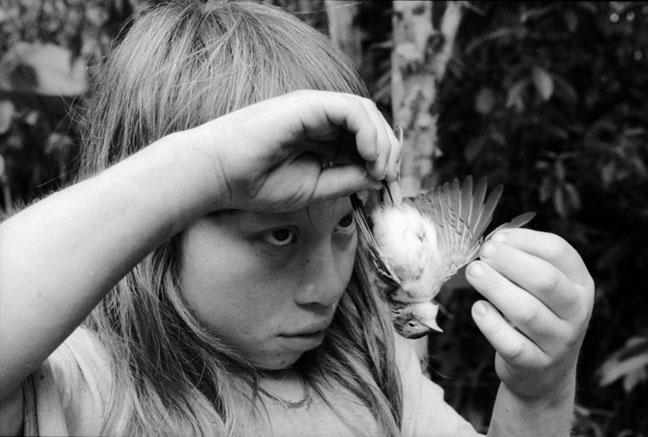 This image of Carol's is one of her best and the one that reminds me the most of her delicate intensity and humanity. I remember her comforting words for me over the last few years as others dear to me have died and now I wish I had more. She was just as beautiful, delicate and unflinching as her photographs and now that is all that remains. Memories too... Our thoughts our with her Family and loved ones. Posted by Jeff Jahn on May 24, 2018 at 11:34 | Comments (0) PermalinkThursday 05.17.18 Evolving thoughts on Marylhurst closure 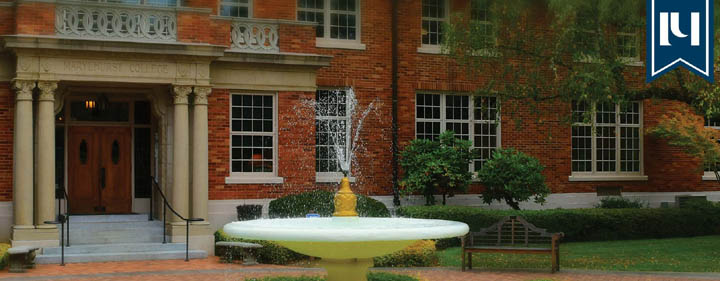
Shocking news today that Marylhurst University's board has voted to close the 125 year institution by the end of the year. I dont buy the Great Recession argument, Portland is awash in new developments and art enthusiasts. Still, it was obvious to those within the art community that something was amiss with the University. Some of the signs were the longtime art school staff departures and rapid turnover of the director of the Art Gym. When I moved here in 1999, The Art Gym was the highest profile contemporary art space in the Portland Metro Area... and only later did other institutions and University galleries arise. Perhaps it stopped being "the place" as the scene expanded and Portland artists became more adventurous than any religiously affiliated institution could hope to show but it has always been an important venue that gave large scale solo shows and retrospectives to local artists (many with national reach). Still, I'll miss it and here are a few reviews we've published over the years: Paula Rebsom's installation on the lovely campus grounds Joe Macca's solo 2 artist show at the Art Gym Mike Rathbun at the Art Gym ...(more) Posted by Jeff Jahn on May 17, 2018 at 17:04 | Comments (0) PermalinkTuesday 05.15.18 Mid May Links The new chief curator for The Henry Gallery is Shamim M. Momin of LAND and before that co curator of the 2004 and 2008 Whitney Biennials. A great hire since the Henry hasnt been the same since the Elizabeth Brown days. Momin brings a present and pervasive intellect to what she does, and isnt one of those curators that tries to out vague her audience and subcontract out all the programming (which sadly is par for the course these days). She's a legit intellectual, which is what I expect from art institutions and rarely find these days. Congrats, Seattle will have her for perhaps 5 years but it will be good for contemporary art in the Pacific Northwest since I consider the Henry to be the top Contemporary Art institution in the region. Too often curators here program what they "should be" curating rather than discovering what they could be curating.
Contemporary art takes on the ease of getting guns in Chicago. One of the world's top architects collaborates with Norway's troublemaker artist for a project to die for. Too many artists today are doing tarp art, as if the wear and tear + stains of life are enough to make their art appealing to liberal elites who are out of touch with whats really going on. That and the artists of the 1970's like Christopher Hill simply did it better. Add him to the list with Sam Gilliam and Helen Frankenthaler who consistently did far more with tarps sopping up the studio. Now Im not against tarps (Love unstretched Frankenthalers and Gilliam) I just wish today's tarpists werent ingratiation attempts in a supplicant's pose to an art market primed to accept art that fetishes its "nothing specialness." Its a mode, weak era tarp art begone. Posted by Jeff Jahn on May 15, 2018 at 11:37 | Comments (0) PermalinkThursday 04.26.18 End of April links The Turner Prize list is out and one of the artists doesnt even consider themselves an artist. The age of the un-artist begins.
The Yard is perhaps the most discussed and oft hated new building in Portland but Brian Libby looks past the recent folklore around the building for Metropolis. What needs to be added to these new developments is space for cultural amenities Barry Blinderman's program at ISU is what sparked my interest in contemporary Art. Up to that point I was mostly interested in art history and not living artists. Yes there was an Alex Grey show (probably my first art opening) but really it was the fact that there was a space that I could return to over and over and there was something different every time I walked across town when I was an undergrad. Congrats Barry! Posted by Jeff Jahn on April 26, 2018 at 17:39 | Comments (0) PermalinkTuesday 04.10.18 Art People Links Art people make the art world turn. Here are some to consider:
The new Director of the Met is Max Hollein. This isnt a surprise and it is a rare thing to not promote from within but it really had to happen. Can the museum regain its composure as a seat of expertise... a place where knowledge and experience is rewarded? Can the museum update itself without undermining its greatest strengths and integrity? It doesnt need to reinvent itself so much as reassert itself with tech. Most 1st tier museums really dont understand these things and dont have to but Hollein's predecessor opened pandora's box already. (*hint) All museums should be free of charge, especially with income inequality the way it is. Richard Speer writes a touching memorial for author and Portland art collector Sandra Stone. She showed up at so many openings and was always engaged and involved. I'll miss her. Meet Mitchell Algus, art dealer... trailblazer. Individuals who stick their necks out to create a climate of exceptional activity are rarely rewarded but they are crucial. Posted by Jeff Jahn on April 10, 2018 at 16:09 | Comments (0) PermalinkTuesday 04.03.18 Early April Links Amid complexities of gentrification LA's 356 Mission will leave its space. This is no surprise but it shows how the art and real estate market can undermine contemporary art's moral position. There are ways to do this in a way that enhances the community rather than be seen as some colonizing situation. Considering the political climate in the USA we need to not pit these natural allies of artists and POC against each other.
Tyler Green does a podcast on the Fazal Sheikh survey currently at the Portland Art Museum. A Macarthur Fellow, Ive yet to catch this exhibition but it is on my must see list. Italy's far right party wants to fascist party's old HQ into a museum? Museums in the USA are themselves at the heart of the class war debate but it looks like Italy is upping the stakes... The world is not a safe place, act accordingly. Posted by Jeff Jahn on April 03, 2018 at 9:00 | Comments (0) PermalinkFriday 03.16.18 Mid March Links I'm polishing off a very long review of one of the best exhibitions in recent Portland memory. (Portland memory as a term... hmmm.) Till then here are some links in an eventful week.
The departure of Helen Molesworth from MoCA is the news of the week. Some have characterized this as institutional manspreading. That is simply too simplistic and I see something deeper underlying it... the growing intolerance of museums for strong curatorial voices. I loved her Kerry James Marshall and Catherine Opie shows last year. It is part of the whole war on expertise that is going on both the left and right of the political spectrum. Does being a woman factor into this?... of course it does (leaving her more exposed than a man) but this is more complicated than that. Paul Schimmel is no longer at MoCA either and he was a giant, also Alma Ruiz is gone (Molesworth reportedly was key in that). That constitutes a great hollowing of expertise... when I was growing up in the arts I looked up to curators like Schimmel... professionals who shook up assumptions with overwhelming experience, saavy and knowledge and they understood the artists. Molesworth was of that ilk, close to the artists and full of expertise in an era when curators seem to farm out their shows, subcontracting to those outside the museum with expertise they professionally do not want to risk acquiring. In the past museums had in house expertise... slippery slope and any curator that keeps a higher profile is sadly in peril. *Update: the LA Times comes to a similar conclusion somewhat reversing their initial assessment. Thing is this isn't just MOCA... the entire museum industry is pushing back at influential curators. I consider it a purge of expertise and the influence that comes with it. What got Molesworth into trouble was daring to go farther than the board's agenda. Solution... hire curators that make their ideas inspiring to their board (you dont get that without expertise and even more daring). Art as an "asset class" rather than an intellectual prompt is hurting museums in very obvious ways. Matthew Collings takes on a very complicated Tacita Dean show with an equally complicated and tricky review. There arent many critics out there who can do this. I like Hans Ulrich Obrist as a curator and he has good ideas, but AFC is right his lectures like a lot of his imitators in the drain the life from what is exciting about art. As someone who can speak well and with passion, I bemoan the dearth of it and I do see it as a way to lower the stakes, which is odd because the stake at this time are higher. Does Dora Maar deserve more credit for Guernica? Well yes, but not as the author for the brilliant final work but as part of the brilliant ecosystem of thinking and aesthetics that went into it. In that sense, absolutely she was involved. Like Helen Frankenthaler to Greenberg, she's crucial and without her you dont get the breakthrough work. Overall, there is no singular artist and if we can look at the entire cadre that these great works require it will make are understanding of richer. There is just too much zero sum thinking. Posted by Jeff Jahn on March 16, 2018 at 10:48 | Comments (0) PermalinkTuesday 03.06.18 Early March Links Internet artists infiltrate MoMA with a virtual reality exhibition among the Jackson Pollocks. Is virtual reality infiltration the new drip technique? nah... but it furthers the position of museums in the crossfire. Currently major institutional curators seem to be less skilled than they were 20 years ago and act simply middlemen who hire those with more expertise for specific shows. The problem with that is that museums require expertise to legitimize themselves and artists see a schism in this gig economy phenomenon. Why buy into something when you bypass the mid-level managers and exhibit directly on the internet or a VR overlay?
Team Gallery is done with art fairs... why? Long story short, they feel terrible. For quite some time art fairs have been dealing from a marked deck and if you dont like how its stacked why participate? A lot of smaller to mid level galleries have closed up as galleries all together as a new consultant class has developed to work in a more hidden way. This even more shadowy art world isnt exactly an improvement but at least Team is retaking his own scene and remaining a gallery to visit and experience. Mondian's heirs claim a museum has stolen the artist's work. That said I just love these 4 paintings shown in series. Olafur Elliason's Reality Projector looks like a must see... (more) Posted by Jeff Jahn on March 06, 2018 at 5:11 | Comments (0) PermalinkWednesday 02.21.18 Pertinent links Jerry Saltz skewers the "woke" biennial. I agree with all of this (and am preparing a response, curatorially). To cut the bull... "liberal elites" still are smelling their own curatorial farts and the more radical segments of Portland's art scene all sneer at academicians and curators who use the word "woke". Despite these being very interesting times (too interesting) is this not a great period of institutional perceptual acuity... and the main problem is one of "chasing the parade." Strong curation in times like these can still follow "issues" but they need to curate against form to keep from coming off like pious careerists. Part of the problem is sytematic since curators have lost their backbone as directors need for "outrage mitigation" have supplanted much of the very pointed curatorial expertise that was in force until recently. Overall, the best ideas right now have deeper roots that are rife with tension, treason and a need to disagree together in the same room. The best ideas dont claim understanding and lack smugness... that pax curatora age is over but most major museums dont understand this. The parts of the art world who get annoyed with Jerry and other real critics miss the message... the art world is not the court illustrator for the liberal elite or an asset class. Art is not the pet of the rich. It is an instrument panel that measures various systems within human civilization... and a lot of things that have been red lining are being ignored (though some venues are wising up like the Art Institute of Chicago's Leigh Ledare show, hint "uncertainty" is the true subject of the day). This whole institutional dampening effect mitigates subtlety... we live in messy times so group shows like the New Museum's Triennial should be a heightened version of that mess... rather than a tip toe tap dance through the tulips. In other words... toughen up and buckle up, this is a bumpy ride age... yet somehow museums are in full ingratiation mode. Curators used to be like great surfers, good at reading and riding risk like the big surf that breaks on the beach. Lately they have become more like lawyers (risk mitigators) concerned with career (hopefully becoming directors) over culture. True some directors are excellent curators but its a hard edged to keep sharp. Museums everywhere are in trouble as the front lines between the haves and have nots and by and large they have an attitude problem... irrespective of them being left or right leaning politically. Overall, it is good that the New Museum engages in this exercise but it is in danger of becoming just like the Whitney Biennial... something that serves an institution more than the culture it supposedly serves. Hyperallegic presents another view... with photos.
The single brightest human being I have ever encountered is Robert Irwin and he has new work up in LA. Overall, I agree that institutional curators really are not where the action is at anymore... it just seems like a broken system. Independent ones can be a force still though. In particular Id argue that artist/curator/critic combos have always held the greatest fulcrum of leverage on culture. Artists like Kandinsky, Judd, Murakami etc... aren't just measured by their own works. They articulated and presented things that reach farther while their works ground and reaffirm their principles. Its kinda like having a legislature (curatorial) , court (criticiism) and executive branches (artist). Most major institutions have difficulty with multi-modal individuals in the arts and just deal with them 1 element at a time... credit to the Portland Art Museum for doing the John Yeon show last year, which was decent. The David Bowie show that was touring was even better... hopefully I'll get to see it in Brooklyn but I have a feeling it will annoy me, but museum shows arent supposed to be about satisfaction and they arent supposed to be the earliest of adopters. I do know that calling Bowie "woke" seems extra trite and laughable. Posted by Jeff Jahn on February 21, 2018 at 9:40 | Comments (0) PermalinkSunday 02.11.18 Early February Links The Ellsworth Kelly Chapel is nearly complete... but it is silly to think of this as some sort of transcendence competition with Houston's Rothko Chapel. I love both artists and in many ways those two projects are fate to never be those artist's best works. Very important, yes... but I Love them as painters of rather portable things rather than site makers. That said... I will go see it.
Well the USA could use a Jasper Johns retrospective right now if it ever did, right? Here is an interview with Mark Dion... wunderkammern never seem to go out of style in contemporary art. I have a lot of thoughts on this but mostly I think it is the discreet spatial experience viewers are already groomed for... you know, look in here for a second, its furniture so how bad can it be? Furniture comes with a lot of cues that most 1st worlders are comfortable with and by being discreet objects are a bit easier to sell/ship/store than many all out installation environments. An architect has used Vanta Black for a pavilion at the current Winter Olympics. It is unique so makes sense that Anish Kapoor would want to secure it for his use only in art but its just a matter of time before very similar blacks become available so ultimately its more of a stunt gesture. In the past artists had to create their own paints so most colors were closely guarded proprietary secrets... which only makes this whole subject seem like a throwback. Posted by Jeff Jahn on February 11, 2018 at 9:40 | Comments (0) PermalinkTuesday 01.09.18 1st items of 2018 Earlier today, Nick Fish and the Portland City Council unveiled its preliminary working report on what the city could do to preserve and expand, "Affordable Arts Space in Portland," you can read it here. First of all, we've been calling for many of these things for more than a decade here, here, here and here. The thing is the art community now has City Hall's attention since Portland's identity as an cultural tourist destination is at risk to rising costs. So yes, a clearinghouse of spaces and incentives is crucial. I'm also glad the cultural liasson position is coming back to City Hall, I made use of it when we did the Donald Judd conference. The thing is the "corner" that Portland needs to turn isnt just about affordability. Technically, Portland cant roll itself back to the dirt cheap days. Instead, it needs to reframe this discussion not just as a return to affordability but as a more pro-active and assertive use of its support resources for cultural use. That means getting the resources (money, spaces, prestige awards and networking) into the right hands and for reasons that raise expectations. Portland is frankly terrible at being serious about support even when its clearly a big deal (think "Portland Polite" and "humble brag" rather than recognition of achievement). Instead, there is an infantilism around the discussion of cultural support. In fact, there is a kid's photo as the first image on the report. Culture creates serious careers, roles and spaces, why the kid photo? Also, of all the stake holders listed there is no active working artist advisory group and most in the visual arts scene dont know anything about this 2 year to date project. Frankly, that's like forming an action plan for getting resources to doctors without asking doctors what they need. Yes, other cities have done similar things, but Portland has some unique challenges and it will take local know how to make it effective in implementation (hint not the same old). Still, this is great news and I have been repairing a topical and very long think piece I hope to get published here soon. This new arts plan is is a needed step in the right direction but it needs to be reframed from "Affordability" to a one of distributing effective support for the brightest lights... because those are the people Portland needs to keep. Just supporting quirkiness isn't enough when resources get scarce and ever more crucial. Currently many outdated practices form barriers that have no place in 2018. February 15th will be the next time the Council meets on this and I'll have an article that goes far beyond the City Council's scope... though it is a crucial pies of the benign neglect policy the city has pursued until now. This is about Portland keeping its edge and cometitive advantage against other cities, that requires a few new moves that I'll get into later.
The Met is now Charging admission, especially for those who are visiting NYC and the critics at the New York times hate it. It smacks of elitist class warfare and puts the museum in the crosshairs of the massive income inequality issue. Not good, all major museums are trying to negotiate this issue and the Met just wiped out on this wave. On the same topic, Hyperallergic interviews the Met's Director who tries very hard to do damage control... but it reminds me of some uncle caught in a nerf battle between 10 kids on Christmas morning. Posted by Jeff Jahn on January 09, 2018 at 14:35 | Comments (0) PermalinkWednesday 12.06.17 Early December Stories Brian Libby has expanded an in print article on the restoration Of Pietro Belluschi's Sutor house. It reminds me how Marylhurst University botched their restoration and move of their Belluschi by altering the hearth for inxeplicable reasons. The Sutor House was done right.
The Portland Art Museum will try once again to get approval for the Rothko Pavilion. I'm in favor of this plan despite the museum going with a very risk adverse design. Currently the museum campus is cut in half and disability access is an immense maze and I believe the expanded hours and greater access for pedestrians and bicyclists should be enough. My greater concerns is that the galleries be great spaces for looking at art and that the museum's design is so standard museum when in fact the space called for more creativity. Problem is both city hall and patrons at PAM are so conservative that that kind of groundbreaking design was not undertaken and the resulting back and forth between the community and PAM became fraught. PAM is sitting all of the civic and social faultlines. City Council meets at 2:00 Thursday. The climate of moral revisionism and censorship is in full effect and calls to remove a Balthus at the Met are just the latest round. Look ... Art isnt supposed to illustrate moral ideals (which change over time). Instead art pulls at the loose threads that make up humanity and our world. Not all of those threads can be noble, that would be a great disservice and art can act as a lightning rod. The activities of individuals are somewhat different from their art but they are related and its that series of complications which gives some art its staying power. If it no longer stays over the long term then history has sorted things out. Politicians are elected, art isnt. Myself, I find Balthus distasteful and would relegate him to the storeroom but not because of a petition. the whole "wisdom of the crowd" idea misses the fact that such crowds usually lack wisdom. Still, perhaps tastes have changed... we no longer eat somewhat spoiled foods like the Romans did. Posted by Jeff Jahn on December 06, 2017 at 16:38 | Comments (0) PermalinkFriday 12.01.17 Jim Archer 1942-2017  Jim Archer I was saddened to learn of James (Jim) Archer's death today. He always had that steady form of persistent but serious energy for art and the lives of visual artist that distinguishes true trail blazing champions from mere art supporters. As the first director of what eventually became named the Archer Gallery (eponymously) at Clark College he gave Portland's neighbor to the north its premier visual art space. He was also an avid collector donating 129 works to to Clark College last year, doubling his legacy and cultural footprint in Vancouver Washington, just as the city is beginning to embark on a more ambitious arts agenda. One could rightly say that Archer was a foundational figure for that city and a model for advocacy I wish there was more of. A very active member of the Portland art scene, he will be missed. ... (more, including Clark College's comprehensive obituary) Posted by Jeff Jahn on December 01, 2017 at 17:44 | Comments (0) PermalinkThursday 11.30.17 End of November links First of all, shops in Portland that are also a gallery is nothing new in Portland. Nationale and others have been doing it for years and Motel (run by PORT Co-Founder Jennifer Armbrust) broke a lot of new ground. With rents rising and online being ever more important to retail and fine art brick and mortar seems to need the flux that 2 genres can offer. Thing is it always seems to benefit the merchandise more than the fine art. I'd like to see some one make it a win win on both sides. That said I am all for more of these hybrid spaces.
It is no secret that artists dont make that much money but this study digs deeper and Portland clocks in as the second highest concentration of artists in the country with 500 per million, far above the next closest (Denver at 250) and second only to Miami's 581. Question is what is city hall doing to encourage this entrepreneurial edge? We want to maintain this. Dan Cameron is curating a Midwest Biennial in Kansas City. As a former midwesterner myself Im all for this... the whole perception of flyover states and arts being concentrated on the coasts is corrosive to what makes the USA great. Posted by Jeff Jahn on November 30, 2017 at 15:33 | Comments (0) PermalinkTuesday 11.14.17 First half of November links I have been traveling a great deal but PORT has a lot of reviews and other content heading your way. Till then here are some links to mull over.
Jerry Saltz doubts the recently "found" Da Vinci painting... it is up for auction with a starting bid at $100M tonight. Overall, I find the painting to be just too convenient and yes pre-renaissance stylistically to be a Da Vinci without major question marks. The thing is auctions at this and of the market have very little to do with the art and a lot to do with turning cash (legal and dubious) into an asset that can be used as collateral for other things. This isnt about building a collection or appreciating art and most of the major collectors I know have a certain distaste for auctions. Interesting that Jerry's segment for NBC news got cut after it was taped. hmmm... Here is a fascinating article about whether art can effect science... answer is yes. Science like most professions has certain preoccupations driven by what people believe and one great thing about art is it can present different epistemologies.... ones that can be tested scientifically. Sometimes, one has to see something to believe it is worth testing. I've always loved the odd hems and seams (seems?) that are woven into to the art/science dialectic. That also means that art is not some isolated cul-de-sac of civilization. It can express idiomatic world views rather than just illustrating them. The work which seems like a strange outlier is actually quite important... it can be a different understanding knocking on the accepted ideas. Something that has been increasingly rarer to find in art and politics... both of which have been losing their more supple approach to connecting with people. Sometimes you have to challenge something to keep it valid and capable of fixing themselves. Freedom and liberty are two of those things. Science and Art are both crucial, it was making both science and art available to the public that lead to greater liberties. The second those things stop being free range and directed by ideologues things get worse for all but a few. Which is a great segue... No, artspeak generally is not used to disseminate actual research as art. It is a special kind of careerist sublimation of how and why certain art operates. True some research works (notice how Andrea Geyer's dialog around this show was pretty direct... and arguably the last "Great" visart thing I've seen PICA do) but more often it is just code for, "dont challenge my all important CV." In fact, anything is fair game and in a time where institutional rigging and tampering effected a major political election I'd say that no amount of research actually justifies work. Instead, its the way art reveals the mortar that holds various bricks of civilization together... or even how those walls fail that makes art and critical assessment (which requires comprehension of goals and intentions) important. It is a long established fact that developers usually come into places that artists revitalize 10-15 years after the artists move in. This has happened in Portland. The difference in this latest situation in LA with Laura Owens is a very successful artist (many of whose collectors are wealthy developers)is seen as being too quick a catalyst. It is a cautionary tale and I'd like to see development in Portland that creates new... (more) Posted by Jeff Jahn on November 14, 2017 at 14:10 | Comments (1) PermalinkTuesday 10.31.17 End of October links Hyperallergic looks at the Istanbul Biennial... exploring what makes a good neighbor (in the Middle east, ugh). Interesting how the smaller biennials seem to get how art needs to relate to the unspoken things that grease the wheels of our world. The work itself?... a tad too illustrative and reliant on cues that it is contemporary art, but I'm not expecting bold moves.
Most any intellectual worthy of the word has found Artforum of the past 20+ years to be a an avoidable style guide for looking like the boorish art inteligencia... and should applaud that the magazine is vowing to turn over a new leaf after its former head stepped down in scandal. Now David Velasco is the new Editor in Chief. Congrats to David who has contributed to PORT in the past! ...(more) Posted by Jeff Jahn on October 31, 2017 at 19:39 | Comments (0) PermalinkWednesday 10.18.17 Mid October links and news With the Weinstein reckoning an artist whose work touches on this reality of abuse has been removed. Should the prophylactic response be used here? Do we remove anything that might be provoking or address inconvenient truths? It certainly wasnt Weinstein-enabling, if anything it addressed his type of behavior when others wert gym curator
re turning a blind eye. Earlier this year Sam Durant's piece at the Walker made sense to remove... those gallows were simply like dancing on graves though it worked when initially shown at Documenta (why was the Walker so tone deaf and not understand that it worked in Europe but not the USA?). The difference here is the Hollywood day bed was more nuanced... perhaps too much for a retail setting but that's popular culture failure not the artist's or the work's. True freedom requires dissent and the mainstream left can cause greater harm to itself by by policing culture and general dissent. As a critic I try to engineer pressure points where the inconvenient is foregrounded and to try to drive these upsetting things back into the background is a kind of censorship.
The Art Gym names Ashley Stull Meyers as its new Director and curator. Good that she has a background in marginalized communities... but how is she on dissent? Portland is a city of dissonance but its arts institutions are mostly very safe... rewarding those who sit on panels but not work that causes an uproar or provoke discussion. It is a civic weakness that requires correcting rather than mutual congratulation societies. We wish her well and hope she has the full support of the university as these programs have come under increasing pressure. What's more Portland is a notoriously tough place to fund raise and being new often means 5-10 years of proving yourself. Artnet asks who the most influential curators were. That's an interesting question, mostly because curators... particularly those at museums have been losing cache (going mostly to directors, most who act like curators but often arent... when they are both the split attention can be a blessing or curse). I wont make a silly top 10 list but here are my picks: My favorite was likely William Rubin (whose time at MoMA explored risk as cultural currency), other MoMA greats like Alfred Barr, Kirk Varnedoe and Robert Storr all matter. Im a fan of Lynne Cooke and I want to name Ann Philbin who is technically a director. Pontus Hulten, Okwui Enwezor, Hans Obrist, Paul Schimmel and the brilliant Walter Hopps come to mind as well. We just dont have that many brilliant curators at major museums any more... they typically act like investment portfolio managers managing risk rather than ... (more) Posted by Jeff Jahn on October 18, 2017 at 14:30 | Comments (1) PermalinkWednesday 09.20.17 September quandries Matthew Collings reviewed the new Basquiat exhibition at the Barbican. What Ive always liked about both Collings and the artist is the way they hone in on conceits and generally accepted nonsense. It gives them both a bit of grit 'n gristle. Too bad the "notions of cool" sound like another Basquiat show which tries far to hard to be both in the know and safely institutional. It is hard to be both and it always makes those curators seem off balance... I call it oversteer. The good thing is Basquiat's work can survive such posing... because it is precisely designed to be critical of such posur-posturing. We could use more of that but it is a difficult thing to achieve in a world of instant gratification.
Brian Libby has two articles on thePortland Building. The second discusses the issue of preservation. I tend to agree with him on this, the Portland building was never right and therefore always compromised... sort of like the Leaning Tower of Pisa started tipping right away. Better acknowledge the flaw by stabilizing it so it can last. Besides the materials are not as important as the visual impact here. At least they are going to save the Portland Building and make it a proper functioning structure. One thing they must do right is the revamped gallery space. There are many ways to improve it through the renovation. It is already an important venue but it could be so much more. Artists defend Documenta and its curator. That's all well and good but I'm a firm believer that curators should be defending both the artists and the institutions. True this value engineering of culture is a problem but somehow I do sense that bigger leads to diffusion and this Documenta 14 got away from its staff by design (we covered 13). Last year's Portland Biennial was also a mess because it spread itself too thin... at a certain point these festivals need to be distillations not simply an invitation to get lost. That strategy has diminishing returns, especially with a world growing ever hostile to open ended thinking. Try to raise the stakes rather than obscure them.... and this financial inquisition is just another distraction that points to something amiss. Let's be smarter than the cultural bean counters by knowing how many beans will be required to plant? They had to know the Athens section would be scrutinized relentlessly in financial terms... state of the EU and Greece's debts and all. Jasper Johns creates an artist retreat out of his home... generous but doesn't he need that? Moves like this are important but worrysome. There is never enough time to cover everything so Jerry Saltz does short reviews. Ive done that occasionally done that... due for another batch but I use it to look back as an overview (Jerry has a very complicated locale to cover). Last but not least I'll be one of the panelists at this years Clark Arts Summit in Vancouver. Look, I've never thought of the 'couv as a cultural dead zone (the Archer does some of the areas best shows) and by looking to activate Fort Vancouver etc. they might just be able to avoid some of Portland's mistakes (too much middling collaboration at the cost of vision, little support for small arts venues + a general phobia around ambition) at the institutional level. See you there. Posted by Jeff Jahn on September 20, 2017 at 9:19 | Comments (0) PermalinkWednesday 09.06.17 Early September Links I'm still working on numerous long pieces due out before Fall officially begins (we are still in the early September rev up days). Till that backlog subsides here are some important reads:
The ousted Met director Thomas Campbell does a loaded two part interview, mostly on the Met. First off, all major US museums and many around the world take their cues from the Met and I wonder what chilling effect on digital departments this ouster will have? I'm rather certain that "Tapestry" Tom's ouster had nothing to due with finances or his digital initiatives and everything to do with the culture of the board and key staff. Blaming "digital" is like blaming Hilary's emails and the finances are suddenly fine after the booting (something we reported all along and much of the less savvy generalist media bought hook line and sinker). Those are smokescreens. The real issue is that the digital didn't have a deep culture within the board and the distrustful and "stressed" staff fed that fire. Overall, I welcome the Met being a player in more recent contemporary and less recent Modern Art but the problem with all these initiatives is they were separate strategies. Thing is most museums dont have a feel for new tech/art and by giving it a new division missed the point. Tech isnt something new, the entire collection of the Met is a catalogue of once new art/technologies and their effects. Specifically, tech should be an overlay that expands each division rather than be seen as a rival for the affections of funding. Most contemporary art curators at museums are relative luddites when it comes to tech too (and they wonder why tech billionaires avoid the art world). There is more to all this of course, but the Met needs to play culture cards like the house (most major museums should) because that is what they are. Lag along, its fine as long as you seem more dignified and adult. Problem was the Met looked like it was buying a Miata or three for its mid-life crisis (especially with that logo redesign) and the staff revolted. Thing is, major museums are in a precarious time and the Met like many is making the mistake of chasing the parade of relevancy. Part of the problem is a lack of curatorial verve and prescience, which comes from boards that aren't being asked to step up in visionary ways by curatorial programs (for a while the best curators are avoiding major "collecting" museums, hence Robert Storr, Paul Schimmel and Okwui Enwezor). Leadership means temerity and I haven't been seeing the same caliber of it most major museums as of late. Was it a situation of directorial oversteer? Probably... better to leave that to curators and have the director look stately and reassuring. Who does things well then?... most cities that are not New York should look at the Des Moines Art Center, whose Director Jeff Fleming PORT interviewed years ago. For example, the Met or any museum with over a billion dollar endowment should be open free of charge... or at least be so once a week. Jerry Saltz thinks the new Kara Walker show is the best work about America this century. Perhaps, but that is a pretty low bar. Can US citizens really explore America that well?... isn't it dreaming immigrants who do that best? As a second gen American I just want to float that out there.. The American experience has always been best described by new immigrants. How are Houston artists coping with the hurricane Harvey aftermath? Former Portlander (and much missed) Paul Middendorf is director/founder of Gallery Homeland down there and has been been working rescue operations. Brian Libby writes a sad but wonderful piece about the Gorge on fire. It will be changed but I bet a great deal of wonder will remain... remember the biggest trees are designed to survive these fires. Still, I am deeply saddened about this blaze. Posted by Jeff Jahn on September 06, 2017 at 18:02 | Comments (0) PermalinkWednesday 08.09.17 Early August News We are still working on no less than 3 major articles, till then here are some things to chew on:
This interview with Philippe de Montebello is fascinating regarding the future of the Met. In many ways mission creep has pushed museums beyond their core competency. Is the Met really in trouble? uh no. Is there a crisis? All institutions need crisis to remain relevant and the question with the Met is interesting. My thought is the Met needs to do contemporary art at the same level it does any other kind of Art. Can it do that? The core competency for any museum is to play to their strengths by testing that strength. A digital initiative sounds great but if it isnt as enlightened as their Egyptian program it becomes a distraction. Once again mission creep can diffuse crisis in core competencies but that can undermine that core. New programs work better to bring a crisi of understanding to the museum's collection and programs. Today museums seem to have lost their way, always chasing the parade. No, play like the house... because the museum is the house. An intellectually rather than fashionably engaged crisis is all that is needed. Sadly, the contemporary art world isnt producing curators like that... or they arent ending up at museums anymore. Great curators like Robert Storr and Paul Schimmel are no longer at museums... that's a bad kind of crisis. (yes I like to point out that the Greek word Krisis is the root of the word criticism. For those who like to say there is a "crisis in criticism"... you are being intellectually redundant. Crisis and Criticism have the same linguistic origin. In conclusion, all great curatorial programs and museums use crisis of understanding to spur critical thinking about what they present. Simply having a program that chases its trending demographics will fail to capture them. For example Gen X and Milennials are disengaging from museums, partially because museums are acting as if they are too big to fail. The museums are failing to understand their own crisis. *Hint, great curators who bring the tensions of the present to what is presented are great communicators... they dont do what most contemporary art curators are doing now, which is extremely defensive. So many are failing and not in a good way. While on the subject of crisis in contemporary art, here is a fascinating article where the strongest work tends to misread its predecessors to create room for itself. A strategy called "Misprision" where mere imitation is just a form of "cultural suicide" or at least death by thousand cuts from hedging... i.e. hiding in the cultural hedges. Simply doing research and evoking history and its forms isn't quite enough.... (more) Posted by Jeff Jahn on August 09, 2017 at 14:15 | Comments (0) PermalinkWednesday 08.02.17 Cooler Through Art Portland is hotter than a furnace (ok technically not) but still in a city where air conditioning can be rare in even finer homes heat challenges Portlanders. Frankly we arent used to being cooped up and with the unusually wintery Winter we had Portlanders are starting to feel like tatertots that have gone from the freezer to the frying pan. Here are three solid bets to feed you eyes and mind.
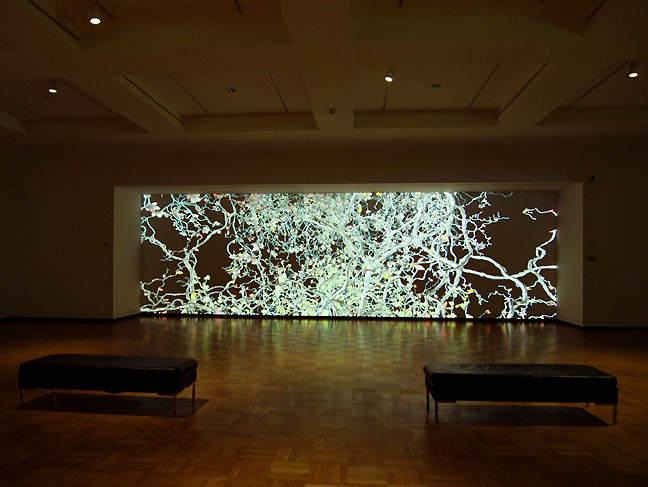 Jennifer Steinkamp's Orbit at PAM (photo Jeff Jahn) The top of most peoples list should be the Portland Art Museum and their current Jennifer Steinkamp exhibition is a long overdue look at a pioneer of computer generated art. She's a favorite of mine melding computer generated graphics and architectural recolonization as art. We saw her Jimmy Carter piece last year (her most important work) and though the selection of pieces here are'nt as cutting as her political or disease related works (who can tell the difference these days), being more non still lives and some related to teachers it constitutes a major multi-media show at PAM. A step in the right direction. True, having at least one work projected in non gallery spaces would have been even smarter but perhaps there is room for that once PAM sorts out its Rothko Pavilion expansion in the future? What's more, this Steinkamp show guarantees that this year's Converge 45 at least has one worthwhile anchor exhibition (last year was a planning phase, becoming more like a contemporary art version of a talk radio show... all of which sounded very dated after the last election). All that said Steinkamp does some pretty timeless stuff for being involved in new media and one piece Judy Crook is a poetic homage to a beloved color theory teacher. Art isn't all glitz and opaque curatorial hedging, the best of it is profoundly related to growing through life and as an artist who has rehabilitated the still life through new media Steinkamp is a must see. Yes, an interview is on the way. . Jennifer Steinkamp July 8 - September 17 Portland Art Museum 1219 SW Park Ave 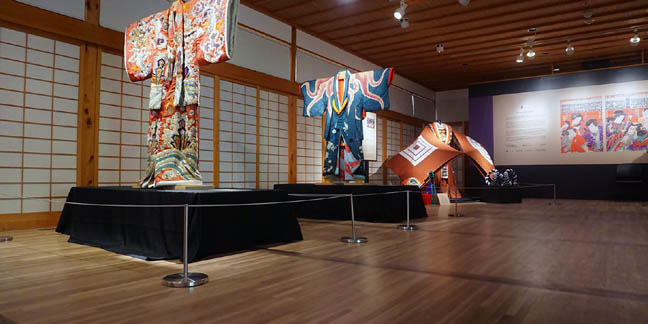 Kabuki: A Revolution in Color and Design at Portland Japanese Garden (Photo Tyler Quinn) Another great choice for beating the heat is the recently renovated Japanese Garden, everyone should see the new Cultural Village expansion by Kengo Kuma. Its always a bit cooler up there and the garden has always put on the best craft oriented exhibitions in Portland like the current Kabuki: A Revolution in Color and Design carries on the tradition. It is a good time to see the exhibition, new architecture and the garden. itself. Honestly, for Portlanders there is nothing cooler than visiting Japan for a quick day trip without leaving the city. Kabuki: A Revolution in Color and Design | July 29 - September 3 Portland Japanese Garden 611 SW Kingston Ave ... (more) Posted by Jeff Jahn on August 02, 2017 at 9:34 | Comments (0) PermalinkThursday 07.27.17 Summer reading I hope everyone (in this hemisphere) is having a great Summer despite and we have 3 major pieces in the works for you (two interviews and an extensive thinkpiece). Till then here are some of the best things I've read over the past few months.
Jerry Saltz half forgives MoMA, but he really doesnt give a stamp of approval. He's seen that The Museum is becoming more of a transit hub trying desperately to cope with its success, yet inherently incapable of fixing its real problem... an identity crisis that gets to its core competency, The Collection. The building is an issue sure, but its mostly exacerbated by the institution not wanting to use its influence and empower curatorial penache. Simply put they require a curatorial revolution and the directors who have slowly usurped curatorial competency over the past 2 decades simply wont allow it. Instead, the discussion is centered safely around the building's program but what I see is a certain curatorial temerity because rewriting the narrative of MoMA's collection too quickly would effect the assets... ahem "Art" that it is a custodian of and a benchmark for. This isnt news... the more powerful an institution is the less freedom it has in challenging its base and lore. The Met is going through similar things but at least its identity crisis seems to be questioning why its collection and curatorial voices have had diminishing impact over the past few years. Then there is the more radical approach LACMA is taking, only curatorial/intellectual penache will keep it from becoming a study in modes of cultural fashion. Overall, the crisis for museums is the question is one of egality. Is the crowd the chief tenant of a museum building or is the Art? Most museum directors will try to deflect that or say its both... but it cannot be. The core competency of an art institution has to be the art and all the content and or baggage it brings with it. Perhaps the proble with with major museums is related to the reason both major political parties are in tailspins? Has the art of patronage stalled as a form of critiquing civilization in a healthy way? Should the ICA pull a show over a Painting that isn't there? Obviously not, PORT has interviewed Dana Schutz in the past and by protesting a painting that isnt even on display the whole drama just becomes a lynch mob (so much sad irony). I posit that Schutz was hung out to dry by a Whitney Biennial curators who didnt bother to contextualize her work in any way (that's their job though... instead they minimized their own exposure). Overall Dana's subject matter has often dealt with corpses on display and this lack context and scale of response says something about where we are as a culture now. Technically, "outrage" isnt a critique and all serious artists deserve a fair shake in the court of critique... vocal outrage is an important thing but without scope and targeting it falls on its own sword. ... (more on LA and the CIA's love for French Postmodern theory + Robert Yoder) Posted by Jeff Jahn on July 27, 2017 at 15:30 | Comments (0) PermalinkMonday 07.10.17 Newspace Closure? & Analysis 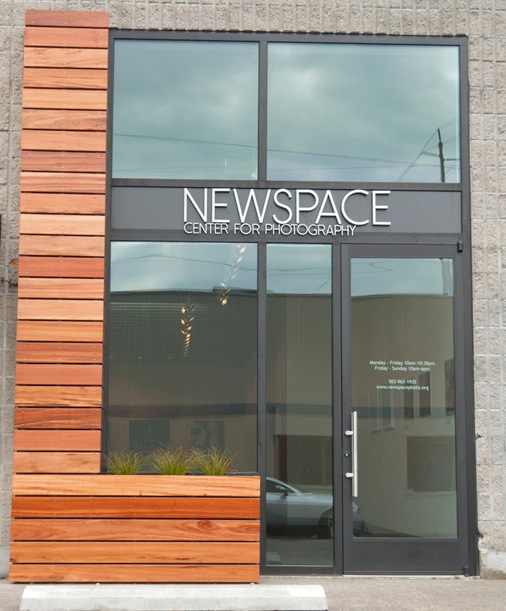 This past weekend the Portland art scene was shocked to learn that Newspace Center for Photography was closing its doors. There hasn't been a formal statement about what happened from the board but the fact that a "for lease" sign has gone up on the building is a clue that it relates to their building. The board and staff was apparently working hard to find a solution so everyone is quite interested in what will be said today at 7:00PM in an open information session. Hopefully they are still considering alternatives like a move or reconstituting of the organization in a different form because their program has been socially engaged and excellent at a time when Portland absolutely requires it. If you care about photography and social engagement in Portland it would be wonderful to sit in and offer your 2 cents. Arts orgs die because of neglect and perhaps this shock treatment can spearhead support? For some context, Portland has a terrible history of simply ending longstanding and very popular exhibition programs like the PCVA, PICA at their old Weiden + Kennedy Space (something they haven't yet fully recovered from with a consistent and diverse year round visual arts program... their new home does hold promise though), the New American Art Union, Portland Art Center, Museum of Contemporary Craft and the just 2011 when Newspace moved into this exciting new space. Obviously fundraising in Portland is challenging... there is a certain benign neglect (that isn't benign) and an aversion to leadership and strong vision that makes our art organizations bleed into each other as it is typical for 5 or more organizations to work together on a project. This leads to difficulty reaching donors who cant tell who does what? There is also a huge shift taking place in the way traditional art organizations are being used and supported. *Update Details about the closure came out in the Oregonian. First off, that is never the correct way to close an institution... you issue a more detailed statement, not a town hall leaving the news sources to sort it out. Second, it looks like the lease was not the issue, instead it is the model. Relying on classes for revenue is a dicey proposition and most of the art schools around the country are facing decreased enrollments. What's more this was more of a skill center rather than a degree oriented institution so their courses are competing with online guides.... (more click below for more analysis) Newspace Closing Remarks? • 7:00PM • July 10th Newspace • 1632 SE 10th • 503.963.1935 Posted by Jeff Jahn on July 10, 2017 at 13:48 | Comments (0) PermalinkFriday 06.09.17 PSU's new Jordan Schnitzer Museum of Art bucks sad campus trend 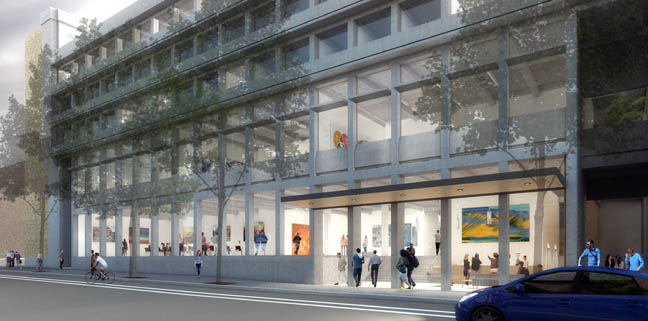 rendering of the new Jordan Schnitzer Museum of Art at PSU At a time when nearly every college gallery or museum seems to be under pressure the exciting news this week is that Jordan Schnitzer has given Portland State University 5M for a 7500 square foot, 2 level museum within the renovated Neuberger Hall. It reminds me a lot of two respected University programs that taught me a great deal decades ago, the Illinois State University Galleries and the INOVA program at the University of Wisconsin Milwaukee, both of which do museum caliber shows and similarly have a discreet director position that makes the space more than just an extension of the existing faculty and their prerogatives. Instead, those spaces expanded the cultural climate of the campus (INOVA in the early days was extremely daring, later they moved off the central campus and became less cutting edge but still good). What is great about PSU's new museum is how visible this will be on the campus quad, inviting students to just stroll in.  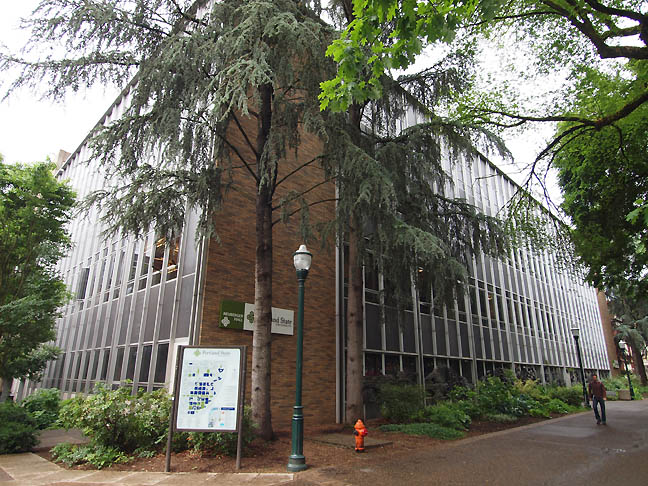 New rendering (top) and current Neuberger Hall (below) Situated right on the Park Blocks the JSMA should add civic vibrancy to what is now just a mid-century curtain wall. I've long felt that university galleries expose students to art at a crucial time when they are building their intellectual apparatus. I experienced this first hand. Simply wandering into an exhibition on campus introduces an opportunity for curiosity and unlike most tests and quizzes there is no right answer and a museum scale setting gives it more weight. Overall, "Art" inherently encourages tolerance and flexibility... something our world certainly could use more of and possibly lost sight of until recently. The gift also makes PSU a much bigger cultural player and it was mentioned at the press conference how they could coordinate related exhibitions with the other museums and schools on the Park Blocks. It enhances the South Park Blocks "Museum District" count and considering Portland as a hot tourist destination it simply strengthens our civic cultural portfolio. PSU is still in the process of sorting out details like whether the Museum will have a collection or not but regardless the museum will have access to the Jordan Schnitzer Family Foundation's vast lending library of art. That is the easy part of this story, but it really requires more context in a time where University budgets and brass haven't seen the value of even internationally important spaces like groundbreaking Rice Gallery in Houston, which sadly closed just last month. Spaces just do not fit narrowly proscribed "core" mission statements. Yet, they are important for that very reason, breaking up the cognitive biases we all develop. For a local example, June is the last month for the White Box space at the University of Oregon's Portland Campus. Let's not mince words, closing the White Box for simple storage space is a horrible philistine waste considering its excellence and 7 year history.... (more) Posted by Jeff Jahn on June 09, 2017 at 17:12 | Comments (0) PermalinkTuesday 05.23.17 Tuesday links Well, Ive been enjoying running around to so many thesis group shows (I prefer no to see the solos because Im more interested in the work they make after art school). Though expectedly a bit wobbly on their new legs its nice to see some real resolve and sometimes outright anger in the work this year. The times demand it. Ive got some review and some other longer form content coming but till then here are some interesting stories.
Agnes Gund is the gold standard when it comes to patronage in this country and this interview by artnet partially explains why. What is important is her focus on follow-through not simply funding vanity art space projects that just advertise her activities. I wonder about most younger collectors... they seem far more fickle. They start spaces or exhibition programs, then they let them go fallow. In a city like Portland where things are rapidly becoming more complicated for artists (studio and living space) as well as rent pressure on experimental spaces that foster careers and create a ladder to build a career/life upon. Art F City did a nice job of taking down the Venice Biennale this year. The entire art world isnt completely out of touch (Mark Bradford at least made an effort to stay in touch... his paintings are good but his sculpture and installation isn't really his strength) but it is important to point out art that is too far up its own "artist statement".... AFC did that. Whether you like her work or not this piece on Phyllida Barlow in the Telegraph is a moving look into one artist's journey to the Venice Biennale. Posted by Jeff Jahn on May 23, 2017 at 10:00 | Comments (0) PermalinkFriday 04.28.17 Late April Links I've been traveling and unpacking those sojourns and recently catching up on shows. There will be many articles on the way to round out the month. First though let's catch up.
Sad news, Vito Acconci has died. PORT interviewed this trouble making giant years ago and his last answer is advice all artists should heed. Look who showed up in the New York Times, Portland's old Appendix gang is going to be moving American Medium to Chelsea. Congrats, we singled them out a very long time ago as ones to watch in this article from 2009 (they had a 5 year run in Portland as an incubator). As for terms like "Post Internet", like other terrible terms see; Minimalism, Postmodernism, Modernism, Cubism, Fauvism and Expressionism etc... its a very weak description of what is going on. More accurately it is the way geek cultures have flourished since the computer age made sharing sometimes obscure interests easier but it predates the internet and is more wholly related to the collateral effects of the computer/information age. Lots of luck as a Chelsea gallery is a very difficult thing to pull off these days if you aren't selling blue chip work. That said its what the art world needs to do. Then there is the whole mess with the Metropolitan Museum's ouster of its Director. Everyone, everywhere during my travels wanted to talk about this and Vanity Fair did a decent job of unpacking it. Really what happened was the way the Director bled out institutional experience in favor of updating agendas... and there was inter office blowback. It has nothing to do with deficits which the Met routinely runs (its a typical non profit shell game). The thing is the Met was a supreme repository of institutional knowledge (much of it arcane)... yet was moving too fast into new digital interfaces and educational mandates. With encyclopedic museums there is a danger there... to undervalue what it already does well and many such institutions have had similar problems. Basically it is disrespect for one's core competencies and I see it as a moment where the war on expertise (in the guise of edutainment) had an interesting little big horn moment. The problem is further exacerbated as many digitally savvy Gen X and Millenials just don't feel like museums are speaking to them anymore as a front for the 1%. That is a big problem, but I dont think losing core competencies is the right way to go. Charging tourists isnt the right way either... go open source. Simply put, museum's need to be a very physical manifestation of the rich making riches available to all. Last but not least the Portland Art Museum's Rothko Pavilion plan is causing some friction and Bike Portland covers it. I'm a big proponent of the Rothko Pavilion... it was my idea before PAM ever thought it even possible. Still, I believe this is a good thing. I believe that PAM was making a very understated architectural footprint to avoid stirring these sentiments up but what they needed was a bit more architectural temerity (this isnt a 1% grab of public space since the pavilion would be open to foot traffic). OK tough questions... can Vinci Hamp do a redesign that goes beyond just the basic "museum" dictates and creates something that becomes an amenity for the Park Blocks and casual passers by? Perhaps a more adventurous architect is required? Privately, I have always indicated to PAM's director that this needs to bring the museum and park blocks together as a mixing zone rather than present PAM as a bunker. I just think this site is more complicated than the current design contends with. Yes, addressing these issues will cost more $$$ but I believe the added complexity will help both PAM and the South Park blocks area become something more than what they already are... islands. What is more I'm not certain this needs to be a cyclist's super highway through the museum... that isn't a realistic or sober goal. The current space has some foot traffic and almost no bike traffic... a redesign could be more inviting... perhaps to a rooftop sculpture garden open for free 9AM-PM as a kind of Highline? Perhaps sacrifice the current tunnel? My best advice is PAM needs to be more like a park and less like a museum. That is something very difficult for most museums and boards to understand but in the current political climate being seen as a wealthy fortress isn't what they need. I could also bring some Rothko lore into this take as well (Rothko's worldview was like a lot of Portlanders of today are now). Basically. I believe there is a solution and it will make both the passer by and museum experiences better. Right now as it is the street and museum experiences are bit of a mixed bag and I hope all sides see this as an opportunity. Good can come from the Museum and the public having a strong dialog with realistic goals for once. Posted by Jeff Jahn on April 28, 2017 at 10:48 | Comments (0) PermalinkWednesday 03.22.17 Disjecta reboots with Shell 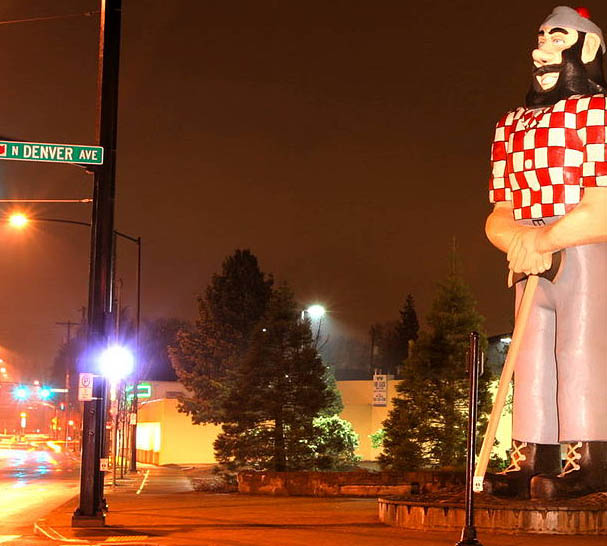 Disjecta (behind Bunyan) reboots The interesting news in Portland today is that Blake Shell is to be the new Director of Disjecta. It is a bit of a surprise as she hasn't been at the Art Gym for that long (though her programming felt less like her previously excellent work at the Archer Gallery, perhaps over the shoulder oversight?). Regardless congratulations are in order to Blake Shell. Clearly the institution needed a shift and we covered Disjecta with a critical eye since its inception. The choice of a locally based director is interesting since they seemed to be casting their nets afar... (more) Posted by Jeff Jahn on March 22, 2017 at 11:47 | Comments (0) PermalinkMonday 03.20.17 Monday Links No, we don't need celebs to give context to art coverage. It seems harmless but considering the sensational nature of most every other art damage event story it just seems supercilious.
Yes this President (for now) plans to defund the NEA and seemingly every other useful organ of the federal government. Not surprised, perhaps if the country survives all this we can remember how pathetic the Federal support of the NEA already is? Just a semi positive thought... let's remember the lack of things like the nuanced thinking fostered by the arts that lead us to this situation. ArtFcity reviews the latest Whitney Biennial. Of course it can't possibly capture the grist of the moment, no major museum has the kind of guts that takes but unlike the surveys we've seen of Oregon art it is engaged that there is a certain dissonance. Jerry Saltz wrote about it too ofc. Overall, I see these shows as more of a measuring stick for the calibrating how museums serve their audiences rather than a real state of the art... big festivals seem to be more in tune... perhaps it is the museum industry itself where the curators have lost intellectual edge to the mediating imperatives of directors? The Whitney still has some teeth and that is important. It doesn't have to be perfect but all museums need to find the tensions of the age. I've been thinking of a show that can do what the museums just can't. Posted by Jeff Jahn on March 20, 2017 at 12:28 | Comments (0) PermalinkTuesday 03.07.17 Early March links Sorry, I've been under the weather with the virus that has been going around Portland and plan to get out to the galleries asasp. Till then here are some links to get March kicked off.
Here's an interesting interview with Tony Cragg and I like how it ends with a discussion of Art as a defense against mediocrity. To do that you need exhibition venues that celebrate something other than mediocrity though. The upcoming Whitney Biennial looks at the definitions of "American Art"... which can mean a lot of things. I'm not exactly stoked about this exhibition and usually one can skip the bi-annuals if you are working with interesting artists, getting in studios and seeing a lot of work. They are good for all the people who need cliff notes for what's going on. I'm not being snide, most people need cliff notes for a very complicated and turgid art world. It takes a while to develop one's own eye, measuring sticks and tastes. Perhaps the Whitney's real value is in the way it seems to fail in each iteration. That said do the surveys in the Pacific Northwest even give themselves opportunities to fail in enlightening ways? (answer = no) The latest Vancouver Biennial contends with the dreams and blights that accompany gentrification, something that would have been an easy subject for any Oregon art survey show but somehow we have mostly avoided it. Posted by Jeff Jahn on March 07, 2017 at 20:07 | Comments (0) PermalinkTuesday 02.28.17 End of February Links The Director of the Metropolitan Museum, Thomas Campbell, has resigned. Partly this is interesting because the Met has been slowly losing its "expertise quotient" on the curatorial front and the fact that most major encyclopedic art museums follow its lead. Overall, the Met's supposedly more serious foray into contemporary art hasn't really wowed many... perhaps because it was following the same kind of "Liberal Elite" ideas that fizzled out in 2016 so stunningly (Portland is fairly radical). All "Great Art" is rather radical in its execution and is designed to challenge institutions and the problem with producing shows of art that most museums "think" have a moral high ground is they tend to smooth out all the rough, even jagged edges that radical ideas and art traffic in. Many of us call this "following the parade." What happens at the met now?
Brian Libby conducted a fine interview regarding Minor White's historic photographs of vanished architectural gems in Portland. Very topical in this era of rapid redevelopment in Portland. One time Portlander Ann Marie Nafziger writes about Standing Rock for Art21. Posted by Jeff Jahn on February 28, 2017 at 17:29 | Comments (0) PermalinkMonday 02.13.17 Monday Links Peter Plagens on Raymond Pettibon is a must read. Pettibon the godfather of contemporary art punk drawing and I fondly remember his band playing an opening at Gallery 500 downtown back in the early aughts.
John Waters foresees a new kind of subversive radicalism for the easily offended. Ive met him several times and in person he's something special, a lanky walking talking and working statue of liberty. Brian Libby reports that historic buildings in Oregon now have somewhat more protection and process. Some buildings are great and historic but until now a process for inventorying them... with a true process hasn't been undertaken. For example the only Frank Lloyd Wright building in Oregon was moved, narrowly escaping demolition. Posted by Jeff Jahn on February 13, 2017 at 12:48 | Comments (0) PermalinkSaturday 02.11.17 Last day, Mary Henry at Archer 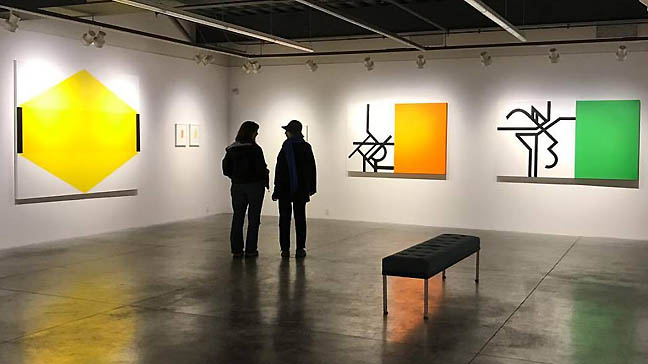
A mini survey of Mary Henry's abstract greatness at the Archer Gallery I'd argue it was the best show of 2016 and today is your last to see it, with Henry "Practice" makes perfect. Mary Henry is one of the greatest under recognized female modernists of the 20th century and the Portland area is being treated to a micro-survey of her work at the Archer Gallery called Practiced Exuberance. Last Spring, PORT reviewed another micro-survey of just her drawings to give you a taste. As part of the American Phase of hard-edged Bauhaus work under Maholy-Nagy she occupies an important place in art history and is a favorite among those with good eyes and taste in the Pacific Northwest. Mary Henry | Practiced Exuberance | November 22 - February 11 Clark College | Archer Gallery 1933 Ft. Vancouver Way, Vancouver Washington Posted by Jeff Jahn on February 11, 2017 at 10:00 | Comments (0) PermalinkWednesday 02.08.17 Early February links Artnet explores the issues 7 artists face with the new travel ban.
New Orleans, like Portland is facing housing price increases that are pushing artists out... new development strategies are being undertaken. Portland needs to do this. Portland's art scene vitality defines this city, its our identity and competitive advantage and Portland has to be more proactive. Portland should treat arts activity like a public good amenity and offer incentives for reduced rents and cultural vibrancy built into new developments, especially now that Portland acts as a kind of sanctuary. I am very curious how Portland's city council responds. Art Critical on the great John Mclaughlin. MoMA installs artists from countries affected by the travel ban. Posted by Jeff Jahn on February 08, 2017 at 11:50 | Comments (0) PermalinkWednesday 01.25.17 Dead tree media & dead horse flogging news Old fashioned dead tree media art coverage worth reading: Oregonian, NYT's, a Judd telegraph and GQ? really?
It has been a very long time since the Oregonian has done something worth reading, but their piece on the new NW Curator Grace Kook-Anderson is a welcome bit. It hints a bit at things we discussed when she was first announced, like an inherent conservatism of form that has done little to jostle Northwest stereotypes. Among the cognoscenti we call it "chasing the train" with ideas like craft and diversity being more cautious, familiar forms than challenging provocations... (more) Posted by Jeff Jahn on January 25, 2017 at 14:16 | Comments (0) PermalinkThursday 01.19.17 More Disjecta'd Well, the more you know about Disjecta and its founder (two different entities btw) the less surprised one is that things had to go this way.
Long ago PORT published this article... in many ways its founder never changed and was ousted as we reported here and here. Then yesterday he went on another of his infamous email campaigns prompting the board to respond by revealing his self-serving actions and retaliations (read below). There is a pattern here and many have put a lot of effort into apologizing for his tactics over the years. For example, you can see perhaps his staunchest supporter Meagan Atiyah in the comments of this PORT post. Their close coordination has always made me uncomfortable... when she left the board of directors a few years ago his support started to erode. There is simply a difference between being colorful and difficult... and someone who can't operate by taking the high road. It was a very Trump-ish move to build a wall (read the board letter below). It is true some artists still stand by him (many do not, especially after the disastrous biennial) but he relied on cultivating those kind of buddy buddy relationships. Going for drinks, hanging out in a Blazer game skybox, being one of the guys etc. but there is a pattern there and it really doesnt serve an organization which takes up a lot of nonprofit art ecosystem resources. A non profit director has to walk a line as a steward. In Disjecta's founders case that line was clearly drawn around himself and I support the board's decision. A board isnt there just to rubber stamp the director's agendas. Like many in the art scene here, I could say more but am trying to be charitable. Here is Disjecta's Board of Directors response... I hope Portland can learn from this: "Statement to Disjecta's Friends and Supporters, The most successful arts organizations encourage dialogue and community. To those of you that reached out to the board in response to an email from disjecta@comcast.net (not the organization's server), thank you for your messages and for your belief in Disjecta. We hope you continue to participate in Disjecta's future. Initially, the Disjecta Board of Directors felt it would be neither appropriate nor respectful to Bryan Suereth to go into detail about the inner workings of our decision-making, but in the spirit of accuracy and balance, we offer the following: Beginning in late 2015, and following an extensive evaluation process involving 100% of the board, external stakeholders, advisors, and... (more) Posted by Jeff Jahn on January 19, 2017 at 15:08 | Comments (0) PermalinkMonday 01.09.17 Monday Integrity Links Jerry Saltz discusses what the Art World needs to do in 2017. Right now art has become a bit too pleased with itself and isnt challenging itself or its audiences enough. As Robert Hughes once wrote art had become too much of "a vocation" rather than "an avocation." Curators and artists need to find the edge rather than the safe middle ground for their careers. It will take some visionary collectors to support it rather than just rely on advisors and "best practices" that perpetually turn art's wild intellectual and physical brambles into well manicured golf courses that make art the Pet of the rich. It takes integrity. I'm working on a big piece for PORT on this to kick 2017 in the arse.
Why are so many Universities putting so much energy into their art museums? The two in Portland that could are Reed and Lewis and Clark. Something tells me L&CC is the more likely bet. I like it better than a lot of private museums and that wealth has to go somewhere... better to make it public. That said a private space with some realy integrity, insight and edge can make a huge difference. For example this project in LA has promise but I can think of a hundred solid ways to spend less and do more, especially in Portland. ... (more) Posted by Jeff Jahn on January 09, 2017 at 13:42 | Comments (0) PermalinkThursday 12.15.16 Mid December Links It is mid December, which means the typical year end lists are making their rounds (Ill do a list of our most viewed posts soon and then a more substantial post as a look back later).
Christopher Knight's picks in the LA Times certainly look like a great Best Of list for the entire country, even though it is LA focused. The Guardian's 2016 American art list didn't seem to get to LA or the west Coast at all... Um, considering the # of Brits on vacation on the West Coast I'm pretty sure we arent a flyover situation. Jerry Saltz did his thing as did Roberta Smith + Holland Cotter in the NYT's... New York is is still king because they simply have more long standing career art critics and overall care about critical reception more than any other place, except perhaps London. Speaking of critical thinking this poorly titled piece about Art World creating Donald Trump is the most useful thing Ive read since the election. For those who really want to use Keirkegaard to understand the dark places of the internet that did partially spawn Trump this piece offers some useful contexts. Artists go to these places and have been for some time but the art World isn't really paying attention to them very much (yet). The Oakland fire has lead to a crackdown on those crucial warehouse spaces that artists thrive in. I'm curious what Portland Commissioner Nick Fish thinks, he's calling for a committee but will it include people with real insight? Will it dig deep? So far only PICA's Precipice Fund, which just announced its 2016 awardees (I was one of the four panelists) has really has targeted the issues. The arts thrive best with non-linear thinking and actions... something government granting in Oregon has had difficulties supporting and our major art awards generally seem to favor very conservative approaches and outcomes. It must change if Portland is to retain its advantage as a hub of new ideas and ways. Posted by Jeff Jahn on December 15, 2016 at 18:18 | Comments (0) PermalinkThursday 12.08.16 Grace Kook-Anderson appointed Curator of Northwest Art 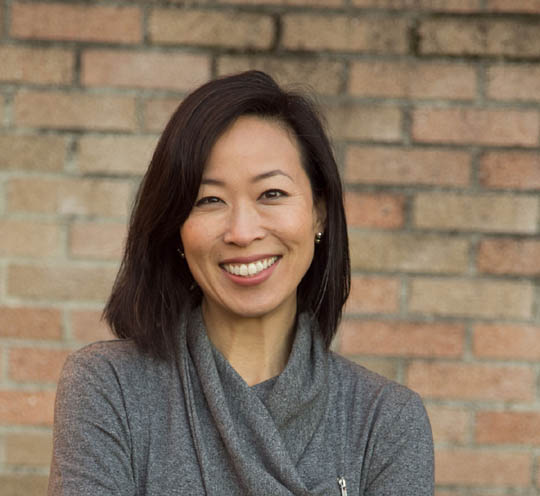 Grace Kook-Anderson The Portland Art Museum has announced that Grace Kook-Anderson will be the next Arlene and Harold Schnitzer Curator of Northwest Art. Congratulations are in order as the position is the chief connector of PAM's curatorial program to the very active art scene. There is a challenge inherent in this as the Museum is somewhat disconnected from the more cutting edges of a nationally and internationally active local scene, often doing a better job of focusing on Seattle and Montana than its own back yard. Challenges are a good thing and it seems like PAM is aware of them because Grace's background seems to address these issues. The Museum's statement: "I am thrilled by the appointment of Grace Kook-Anderson as the Arlene and Harold Schnitzer Curator of Northwest Art," said Brian Ferriso, the Portland Art Museum's director and chief curator. "Grace's highly regarded tenure as the Curator of Contemporary Art at the Laguna Art Museum, coupled with her recent work in Portland as...(more) Posted by Jeff Jahn on December 08, 2016 at 12:00 | Comments (0) PermalinkMonday 12.05.16 U of O plans to close White Box Breaking news, PORT received word that the University of Oregon plans to close its wonderful White Box exhibition space in Portland after this school year. Curator Cris Moss will carry out programming through June 2017. Another institutional change is that the John Yeon Center will be directed by core faculty members and not Randy Gragg as it is now. Overall, it seems like a very rash decision that hurts the U of O's reputation as a serious art school since the White Box is one of the premier exhibition spaces in the State of Oregon. It also gives the school legitimate roots in the very vibrant Portland art scene. They should reconsider, as it will damage the school's reputation immensely by shuttering it without exhausting every avenue (not just AA&A's very Eugene-centric avenues). Earlier this year we helped lead the outside charge to successfully save PSU's Littman gallery from administrative undersight. Big schools have silos and galleries usually are at the short end od most budgetary sticks, despite the fact that they are major connectors to the community and the good will/resources they bring.
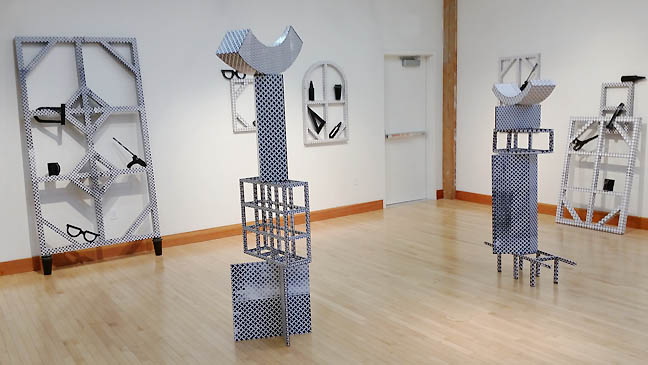 The current Christopher Michlig exhibition at White Box through December 10, 2016 All of this is very sad news and puts the U of O's Portland Campus commitments into question. Disclosure, I have a long history with the White Box, co-curating the Donald Judd exhibition and conference in 2010. It was one of the first shows there and of the very highest caliber. This past April Cris and I co-curated the extremely adventurous Habitats multi-media exhibition so I have a lot of insight into how things are in that building. The current Christopher Michlig show was one of my picks for First Thursday this month and indicates how highly myself and others consider this exhibition space's role in the community. This is terrible news as Cris is among the most thoughtful, adventurous and rigorous curators in Oregon. The Dean of the School of Allied Arts and Architecture Christof Lindner's statement was, "White Box has served as a valuable extension of A&AA's academic mission in Portland for the past seven years. We are particularly thankful for Cris Moss' contributions in ... (more) Posted by Jeff Jahn on December 05, 2016 at 17:08 | Comments (0) PermalinkFriday 11.25.16 Post Holiday Art Field Trip Picks Well, the feasting holiday is over, leading to the post holiday/family need to exit the house and exercise the mind's eye and take in new contexts. Art can be great for this and here are my picks for some great shows to feed/sustain the mind.
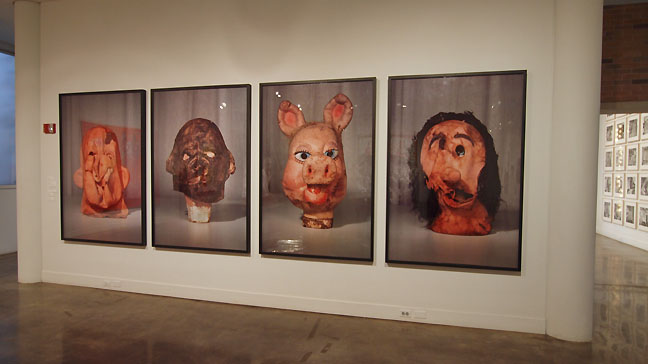
Paul McCarthy and Ed Ruscha in Open This End Open This End is the most exciting group show in Portland this Fall. Partly, this is because it comes from one excellent collector, Blake Byrne, whose good taste and adventurous attitude the work maintains a sharp edge about it. Collecting something that carries an implicit challenge takes on the responsibilities of what Art with an "edge" demands and therefore occupies a special place between civics and taste. Thus, what Open this End does so well is provide a variety of multifaceted world views. Open This End | September 8 - December 11 Ronna and Eric Hoffman Gallery of Contemporary Art Lewis & Clark College 0615 S.W. Palatine Hill Road 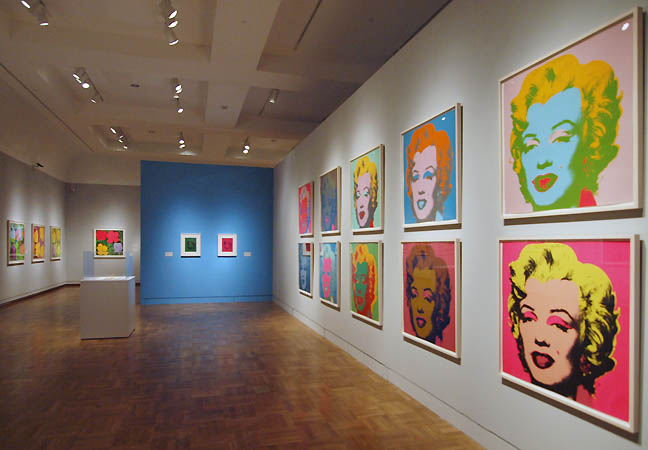 Andy Warhol Prints from the Collections of Jordan D. Schnitzer and His Family Foundation at the Portland Art Museum The current retrospective at the Portland Art Museum, Andy Warhol: Prints from the Collections of Jordan D. Schnitzer and His Family Foundation is the largest of this seminal artist's output ever and should be on the to do list for anyone who can make it. There is breadth and scope here and PORT interviewed catalog essayist Richard Axsom for the occasion. Like so many Post WWII artists Warhol had mostly drained his work of allegory while introducing popular iconography as a kind of folk or kitsch context. This was something fascists had abused so Warhol's rise as an artist became a rehabilitation of sorts, bringing back iconic secularism without nationalistic jingoism and other subjugation. As the Cold War continued Warhol became became the defacto Pope of Americana, canonizing our taste in many secular/cosmopolitan things. The show is an ideal way to connect to the kind of America that is both being threatened by the next presidency. In other words a great post holiday field trip for Portlanders. Andy Warhol: Prints from the Collections of Jordan D. Schnitzer | October 8, 2016 - January 1, 2017 Portland Art Museum 1219 SW Park Avenue Posted by Jeff Jahn on November 25, 2016 at 14:59 | Comments (0) PermalinkWednesday 11.16.16 Post Election Art News and Shifts Well there has been a political shift, it is not a slight one and this will affect art. PORT was one of the first to write about post election art. A week later there are now some more voices discussing what this might mean:
Jerry Saltz can always be counted on to charge forward in difficult times and like myself he sees this as an opportunity to get away from the recent parochialism that the market and some very soft thinking have lead to. Jerry always has a very New York take and I'm not certain what a Trump presidency means for art in NYC but it certainly means that money wont be going away as part of the equation. At Jezebel this piece disagrees with Saltz, thinking that the bohemian artist on the outside is gone (neoliberal art school talk). That seems like an argument akin to "painting is dead" but the pessimism is healthy. That said artists find a way and yes radical action can outflank a lot of this very mitigated neoliberal stuff art schools have been cranking out. This E-flux essay also seemed to see the radicalization in art as a consequence of the election. Jennifer Rabin writes a good morale boosting piece in the WWeek. That said I do feel Portland now has a duty to up its game, not simply accept what we have as good enough (especially institutionally, Portland needs to up that game). Artists should assay the task of creating culture but the past 10 years have not been the best. One artist that is right on target and incisive is worth more than 100 that arent... that said those 100 may have been part of the collective Weldschmertz that leads to some stronger art. The key is expectations. News from Disjecta on the growth front, its controversial director will be leaving his post at the helm. As this piece on PORT once chronicled long ago, Bryan Suereth has always been his own biggest asset and weakness. I knew that when Michelle Grabner was chosen to curate the heavily built up but poorly realized Portland 2016 Biennial it would also expose problems. Possibly, it was the way the host exhibition at Disjecta had all the care of an overstuffed estate sale... using the same old more artists = more attendance strategy Bryan has used since the Modern Zoo in 2003. The institution needed to grow beyond the ploy of being big rather than good (being stretched all over the state made the host show all the more feeble and pointless) and Suereth always had people making excuses for him, none more than Meagan Atiyeh (often uncomfortably so, read the comments). Behind the scenes board members have long confided they are annoyed with issues he's needlessly created and this last biennial set off another wave of many artists who were simply put off. True, some artists love him and he's always been an ardent supporter of those he saw as allies but ultimately one needs other skills for Disjecta to grow into something more serious. (*Side note, the last male curator to work for Disjecta was Paul Middendorf who quit in 2005). That said, Suereth a founder (however mercurial) has put in a lot of work over the years and improved to a point. It is exciting that they can move forward building on his efforts and a bit of tragedy that its founder never seemed to learn some of the basics. Posted by Jeff Jahn on November 16, 2016 at 12:44 | Comments (0) PermalinkMonday 11.07.16 Hard Core Pre Election Links The US election has most of the art crowd in Portland very agitated so I'll dish out some already agitated but topical links.
Donald Judd is very important for a number of reasons but one that gets lost in the mix is is critique of institutions of all kinds and the way that such things de-radicalize the choices of artists. Thus, this historical take on Judd in new publication called Affidavit is interesting, if a bit light. Fact is, most museums still find Judd very challenging because his work inherently critiques the kind of procedures, contexts and presentation methods that museums are addicted too, yet have nothing to do with the work and the ideas themselves. Basically, Judd is a hardcore artist who drives the discussion, not a pawn of the marketplace and patrons. I wrote on this for the Judd exhibition and conference I co-curated a few years back. Portland has a major problem with its "success" eating into the very neighborhoods that produced such cultural vibrancy... so I find this creative super space in Amsterdam project very interesting. Years a ago Portland created something called Milepost 5 and the developers wished they had spoken to I and my team before they had already built/executed most of it. Right now Portland could put these new tech companies and others who are outpricing the core arts ecosystem here and turn them into allies. As a cultural laboratory these interests could enhance each other rather than compete for space and Amsterdam gets that. It doesn't actually cost more money but it does take forethought that most US cities do not engage in. Last but not least check out Roberta Smith's review of Pipilotti Rist's retrospective at the New Museum. I consider her to be the most important artist of the past 30 years (think internet tropes not art museums) and showed her in Portland back in 2006. She complicates the art experience as a form of knowledge that we could use more of and she is just starting to get her due. For some reason it takes edgier female artists a longer time to get their due if their work is not particularly sexualized and titillating. In fact, Rist makes work that transcends that ploy, it is work of the body and intellect without relying on or ignoring sex. It is just a facet rather than a focal point. Rist is hard core curious and perplexing while being generous. I've found that all the best artists tend to be more generous in the way they present/position their work. Posted by Jeff Jahn on November 07, 2016 at 13:13 | Comments (0) PermalinkMonday 10.24.16 Monday Links With An Edge Yves Klein is perhaps art history's biggest wildcard and arguably his influence on the artists of today has never loomed larger. This latest exhibition at Tate Liverpool seems to make a great case as joker savant but it also shows how committed the artist was in comparison to the texture, pigment, happenings and materially exhausted stack sculptors of today. It's that gonzo conviction that seems to be missing often... as if any artist who moves something around deserves a gold star. For Klein it was never about the moves he was making, it was about the strive... that drove a beautiful and fractured subtlety. Klein's work was whole by never attempting to be a complete exercise in art, architecture, or performance. He kept his edge by never being too proud of his genre or material, instead testing Art's elemental use and validity powered his work.
This review of No Man's Land provides a quick but not shallow look at what Art created women can sometimes be without just resorting to the easy cliches. Sure they are there and even then they are better than what I normally come across... nutcrackers and that worn out 2012-2016 trend of mannequins but I also like how it approaches the body. Earlier this year PORT interviewed Wengechi Mutu and years ago I interviewed one-time Portlander Mickalene Thomas. The fact that it all comes from one collection makes it an interesting document but I'd like to see something that rigorously pursues the idea looking at significant art that the market isnt so attached to for greater breadth. Western Culture by and large doesn't value the body and the use of space and the discussions around such things are stilted or often relegated to some project room rather than front and center. Frankly, I'd like to see that change in many Portland spaces because I'd argue that female artists here tend to be the genre MVP's... despite the fact that the least edgy ones get a disproportionate share of institutional resources. I will argue that female artists with an edge are being undervalued in Portland... despite the fact that they have international and national careers that seem value that very quality. ...(more) Posted by Jeff Jahn on October 24, 2016 at 11:14 | Comments (0) PermalinkWednesday 10.12.16 Wednesday Links First Brexit, now England is devaluing the importance of art history as a form of education. Not a good sign for the USA where such things have never been taught or valued much, leading to a lack of critical thinking skills.
5 art cliches that have run their course. I agree, limp fabric was DOA years and years ago, anyone who tacks a tarp or dropcloth from the studio floor on a wall is generally not concerned about looking like a derivative hack. Leaning stuff, also weak. Stacks of anything... especially stuff that looks like it was found in a dumpster is also deeply lame. I'll add another, anything grotty looking on top of a wood grained or painted plinth. People, Isa Genzken and Rachel Harrison did this years ago... Rauschenberg, decades ago. Its revival happened almost 20 years ago and caught on at MFA programslike wildfire since. It is done and isnt a bus that artists can catch anymore. Curator resigns in St. Louis after controversial art hits the wrong notes. Its true the work was tone deaf... but if curators had to resign for that there would be no curators at major institutions. The problem is the way that artists overreach to... (more) Posted by Jeff Jahn on October 12, 2016 at 13:35 | Comments (0) PermalinkThursday 10.06.16 Rothko pavillon for PAM's expansion 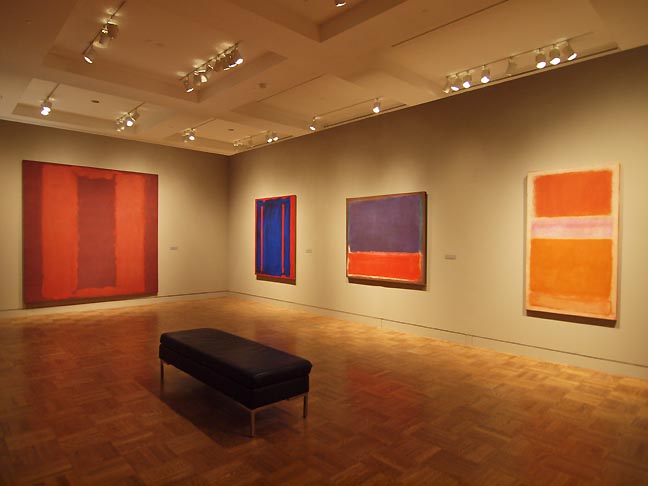
Mark Rothko retrospective at the Portland Art Museum 2012 (photo Jeff Jahn) Major news PAM has announced its long anticipated expansion, featuring an idea that was first suggested by Tyler Green (it was in private but repeated publicly and constantly by PORT since... a Rothko pavilion with works on loan from the Rothko Family collection). PORT has been the biggest champion of this idea and Rothko's legacy for a very long time, even in the face of heavy resistance from Rothko deniers... one simply cannot deny history, which Arcy notably first brought to greater light on PORT. Here is the Press Release: "The Portland Art Museum today announced both an expansion that will unify its campus by connecting the Museum’s freestanding buildings, and a 20-year partnership with the children of Mark Rothko, Christopher Rothko, and Kate Rothko Prizel".... (more) Posted by Jeff Jahn on October 06, 2016 at 13:08 | Comments (0) PermalinkThursday 09.22.16 First links of Fall 2016 Well the long expected correction of zombie abstractionist artists has begun (other young artists with absurdly high prices too). Dont get me wrong, there's nothing absurd about a young artist making 25-65k on a painting after only a few shows but it should be rare and by 2014 many zonie abstractionist works were going for 500k+. Only a carefully orchestrated economy produces that effect.
I can see 1-3 very special even "exceptional" artists being "worth it", sure that's fine but a hoard of artists pulling down over 100k per painting after only a few shows and a short career... that smells funny. Also, artists who stack some junk on top of other junk with some pastel colors + foam or lumpy clay pots are not any better and art schools are pumping them out in droves (I call it hoarder art and Robert Rauschenberg pioneered The Combine before most of these artists were born). A few months ago this story on the Lisa Cooley Gallery seemed to say it all. Now I'm not applauding any closures or corrections... the Art Life is difficult, even for people whose lives are comparatively easy but when art is treated like an asset class it skews what is created and why. It seems the world has lot of very complicated problems and opportunities to tackle... so we shouldn't be awash in uncomplicated art that is easy on the culture that creates it, but we are. Does that invalidate abstraction? ...of course not (the most simple paintings can complicate any viewer's understanding but why buy some kid out of art school when you can buy a dozen very good Mary Henry works for half as much? The issue is one of scale and depth of understanding and it takes that to have mid level galleries that sell art between $2000-$25000. Most of the greatest works of art were bought in that range initially. Hopefully a return to some connoisseurship will result from this contraction. Of course, the most important, already historically "vetted" art wont be affected by this, which should make the best Gen-X and Millennial artists ask more difficult questions of the art world. I hoping the most sought after art becomes more like wild caught salmon rather than the farmed stuff I've noticed a lot of lately.
On a related note Jim Behrle thinks the art world is trolling you with art that isnt as radical as it presents itself to be. Well, sorta... Institutionally things have gotten very tame in the 15-20 years with curatorial power being ceded to the director's chair. Directors answer to the #'s ultimately ... (more) Posted by Jeff Jahn on September 22, 2016 at 16:15 | Comments (0) PermalinkTuesday 07.12.16 Tuesday Links The grotestque that is the art of Trump's hair. Ugh, this political season is gonna be brutal on anyone sensitive to aesthetics and meaning
Getting blue and naked for Spencer Tunick is a thing. The generalist press does love nudity, though there is a serious history of blue nudes in the art of Picasso and Matisse. Also, I suppose the blue skinned Smurfs have lost their cultural profile enough to make this project serious enough to undertake. What does and doesn't make for good museums, the Art Newspaper asks around. First of all, museums rarely take real risks and the main thing they do is transpose egalitarian ideals in the context of often expensive and otherwise elitist objects. Where they usually founder is by seeing themselves as too much repositories, which they aren't. In fact museum's are vehicles for experiences (history, context and intellectual juxtapositions) rather than mere estate sales for the rich. That said because institutions require patrons they often cater too much to the act of pursuing them, blunting their intellectual and social edge. This is because curators as a class have been losing their voices within major museums. In fact, having strong curators dedicated to specific fields that act as ombudsmen and aesthetic chefs for all classes is what makes a museum different than more entertainment driven venues or smaller university spaces where the curator is expected to do director duties as well. Ultimately the biggest mistake museums make is valuing the building over their curatorial staff. Very good staff can also inform the design process but typically only the best museums can afford inspiringly flexible curators and sensitive/perceptive architects who can accomplish that. Instead, most museums simply do what most other museums have done. ... (more, including Artnet's Portland2016 travelogue) Posted by Jeff Jahn on July 12, 2016 at 10:52 | Comments (0) PermalinkMonday 06.27.16 Brexit thoughts 
The Brexit vote sent shockwaves everywhere last week, how will it effect the art world? Better question which art world? There isnt just one. In the short term it puts Great Britain in question as the cultural center of Europe for sure... will Scotland leave? Will there be another vote? More likely will there be a chance for a counter offer from the EU to trigger another vote? Certainly the world uncertainty has a clearer face after the vote. Here is what Artnet had to say about the Brexit. Many artists like Damien Hirst, Anish Kapoor and Wolfgang Tillmans campaigned for the IN vote. The arts always suffer from reactionary sentiments. I suspect Great Britain will renegotiate but till then expect young contemporary art to be seen as riskier than it was and older history book art will become even more of a hedge against uncertainty. Short term, it certainly isn't good for living artists and such things tend to embolden reactionaries... not a good thing for anyone who isn't interested in consolidating power. In the USA everyone is anxious about what might come next. Look for more artwork that explores uncertainty and those that try to explore the roots of reactionary impulses. Posted by Jeff Jahn on June 27, 2016 at 16:07 | Comments (0) PermalinkThursday 06.09.16 PNCA's new President Don Tuski 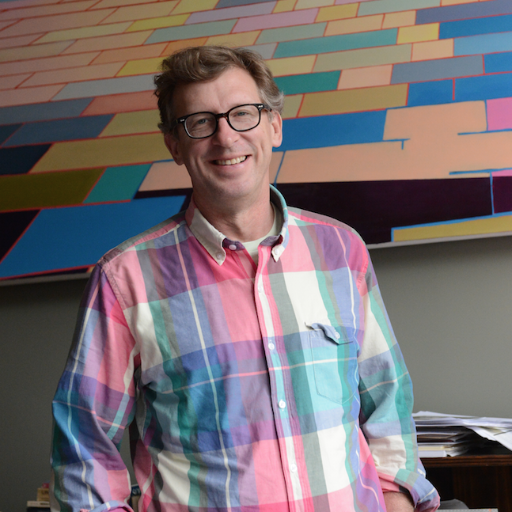 Don Tuski PNCA's new President (Photo Mike Weymouth) this is an image Portlanders will like... PNCA has a new president, Don Tuski, from the Maine College of Art. Tuski's record at MeCA indicates a deepening commitment to documentary studies and the largest gift he brought in was 3 million dollars, the largest in that school's history (though not huge esp. by East Coast standards). He seems eager to embrace PNCA's fluid culture of design and art without a lot of barbed wire, that is a good thing as Portland's greatest asset is its opportunities for change married to being a leader in 21st century ethics. His predecessor Tom Manley was a friend and we had some long brainstorming sessions on growth strategies for the school but Tuski has inherited some challenges. By absorbing the Museum of Contemporary Craft and recently dissolving it serious blowback has occurred. Also, the education industry wide problem of relying heavily on underpaid and under appreciated adjuncts has also caused strife but where PNCA and Portland are different is the school is expected to find a solution for this gargantuan problem (answer = endowments for teaching positions, also very rare today). In many ways PNCA has moved very far and very quickly...... (more) Posted by Jeff Jahn on June 09, 2016 at 10:00 | Comments (0) PermalinkMonday 06.06.16 Monday links and news Bullseye Glass and the State of Oregon have reached an agreement. This is good as Bullseye is a part of the arts economy, while at the same time the kinds of materials that were being vented into the air were simply unacceptable. The problem was relaxed regulation of most industries and there are plenty of other industrial air quality polluters in the city that have also been exploiting the same loopholes (hopefully this gets addressed and soon). For example, Overlook neighborhood residents hope that enforcement is uniform.
At age 70, Mary Heilmann's career is red hot, but why does it take so long for many females? Retrospectives for women are rarer and prevailing wisdom in museums always tends to follow patronage money rather than taste and importance... not having many critics to assess that makes it twice as hard. Do art spaces = gentrification?... often yes but that's like shooting the messenger. It can also work in reverse, like PICA's new home. The question in Portland is creating funding sources that support formal arts entities when informal ones are out-priced. Formalizing affordability for artists is the key but that takes serious know how as the people who did Milepost 5 (they kinda stumbled through it and it takes a bit more cultural seeding). The best editor I ever had was Karen Wright (back in Modern Painter's excellent London days) and she thinks the Turner Prize needs to be more substantial and less a series of affected ploys. I agree with her, though Portland has the opposite problem... much of our discourse is mired in hobbled and antiquated discussions of craft that dont acknowledge the skills in computers, other tech and design or that somewhat irritating aspect of art that drives people crazy... some call it "edge". Besides skill alone doesn't truly make art powerful, it takes a sense of an "edge of understanding"... rather than the ploy of being edgy. Having a true edge seems to embody and encapulate the flux between the known and unknown. In Portland our talking points often scratch at craft, the environment and often a very token discussion of diversity, whereas challenging male Mexican artists or anyone with and incisive edge are far too threatening to show with the group or be given awards (Hallie Ford Fellowships and CNAA's to name names). Portland and London could and should have more exchanges as both places have excellent international art scenes.... Portland is full of weird woodshedders and London is full of people who are unapologetic about being unapologetic (aka the antidote to the humble brag). Posted by Jeff Jahn on June 06, 2016 at 15:24 | Comments (0) PermalinkWednesday 05.25.16 Painting Links Sure, I'm widely associated as one of the biggest advocates in new media art in the Pacific Northwest but I also love painting (I learned landscape paining in oils and watercolors at age 6 so its also my longest standing art love affair... other things like musical instruments, poetry, photography and installation art all came later). Here are some great painting links:
Jerry Saltz discusses the abstract work of Philip Guston and the sublime. The sublime doesn't get enough deep discussion in contemporary art lore at the moment but it is crucial... that feeling of sensitivity to vastness and the distinct sense of the indistinct as a form of threat and safe harbor experientially. Great minds tend to crave these experiences. Maybe that's what is wrong with the art world at the moment, not enough deep seekers? Closer to home there is a very brief interview with Katherine Bradford who has a show at Adams and Ollman. At PORT we do very long interviews but we also don't grant them to very many local artists... partially because it is a blank check and an artist has to have long and varied enough career where yet another review doesn't really achieve anything. We have a lot of rules that we adhere to, but it also provides freedom because interviews mean something when they dig in. Here is an interesting interview with John Currin from a while back. Posted by Jeff Jahn on May 25, 2016 at 14:46 | Comments (0) PermalinkSaturday 05.07.16 Weekend Links The Harlem Art Fair does something a little different with a series of public works? Frankly, this has been done before but not as ambitiously... treating the fair like an international biennial. It creates a zone of exploration not just an isolated enclave. This promotes repeated visits.
Jonathan Jones can be clueless (but at least an interesting one) but taking a non romantic view of Dada is refreshing. Randy Higgins is one of my favorite people to talk to in Portland. We always have these intense philosophical and spatial discussions and Portland Architectures piece hits the spot. AFC does the Frieze Art Fair goings about... Posted by Jeff Jahn on May 07, 2016 at 13:59 | Comments (0) PermalinkTuesday 05.03.16 Reed College Art Theft The generalist media loves these sorts of stories about art thefts but stealing one half of a carved diptych by Leroy Setziol from Reed College is pretty sad. Yes it is worth something (quoted insurance values are accurate but in terms of easy resale, no) but as only half a piece it is essentially damaged goods. Anyone with information is asked to contact Reed's Community Safety's non-emergency line at 503-517-5355
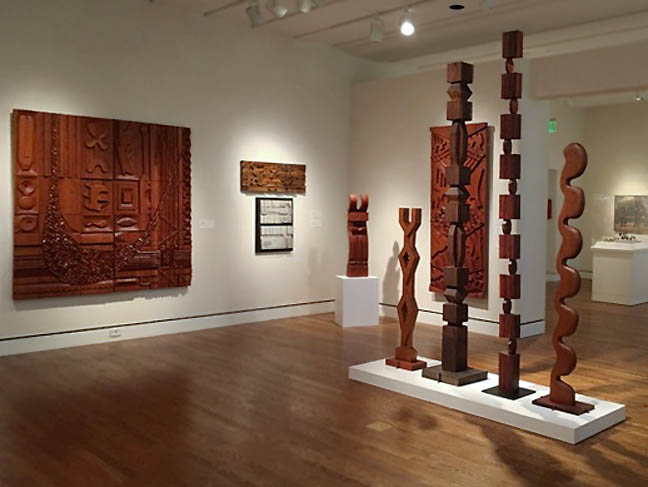 Leroy Setziol exhibition currently on view at PAM To put a positive spin on this the Portland Art Museum currently has an exhibition of the artist's work on display and he's been a bit of a secret favorite of mine for years. My sense is someone decided this would be an escapade of opportunity... a professional would have stolen both parts or much more valuable pieces on display at Reed. Let's hope it comes back in the next 72 hours. You can find Setziol's work all over Portland and it always adds an air of grandly lyrical civilized activity... let's hope the spirit of the work convinces the perpetrator(s) to bring it back. *Update: Good news, the panel has been returned though with some damage. Posted by Jeff Jahn on May 03, 2016 at 22:00 | Comments (0) PermalinkMonday 04.25.16 Monday Links An artist in London sends the gallery staff on vacation.
Though the installations for Megacities Asia are LARGE I'm not that convinced by most of them. Still it is good that they are utilizing the museum in nonstandard ways... most museums could be better about thinking of themselves as habitats for art rather than formal galleries. San Francisco's art scene evolves at the top end with the new SFMOMA... while still out of the affordability range of most artists. That is a problem and though Portland is feeling pressure compared to other major West Coast cities we are still more affordable. Some interesting things could be done and I'm working on a think piece about this... to me a healthy arts ecosystem has room at all levels. San Fran is a place millionaires feel squeezed and many are decamping to Portland. Interesting how this will play out but one wonders if San Fran is just becoming a collection of itself? Seattle has struggled with to a much lesser degree and is still a city full of serious artists and among artists there is an international exchange zone between Vancouver BC going to to Seattle, Portland and then San Francisco.... sometimes LA. I'd like to see more West Coast co-curiosity? The Met has been stumbling in its expansion but MoMA has Geffen's 100M gift... not certain if either will improve the institutions but they will "grow". Is growth ultimately the true measure of success? Seems like the Met could win simply by being a better/smarter patron to artists rather than simply building spaces with little intention? Growth for growth's sake just creates new problems. Posted by Jeff Jahn on April 25, 2016 at 12:46 | Comments (0) PermalinkThursday 04.21.16 PICA has new 16,000ft home 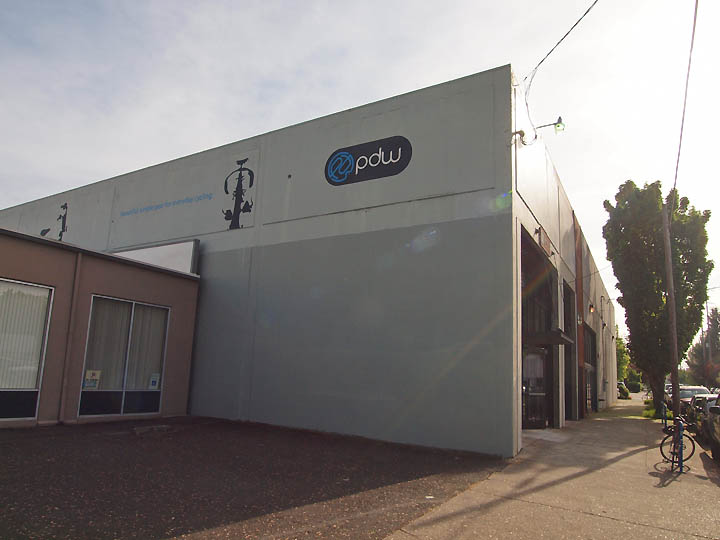 PICA's 16,000 sq ft new HQ at 15 NE Hancock Exciting news, PICA has a new 16,000 sq ft permanent home at 15 NE Hancock thanks to help from the Calligram Foundation. The architect will be Holst. Location wise it is just a few blocks from both the Rose Quarter and the main portion of N. Williams Avenue's district around Cook street. This will certainly be Northeast Portland's cultural anchor. ...(more including multiple interior images) Posted by Jeff Jahn on April 21, 2016 at 10:45 | Comments (0) PermalinkTentative labor agreement at PNCA The interim PNCA President Casey Mills regarding the ongoing labor protests, which are cancelled for today:
"A tentative agreement has been reached regarding the recent protests on campus. That agreement should be finalized today and implemented over the next two weeks. More details will follow as the agreement is implemented. In the meantime, let's celebrate one of the great events of the year at PNCA: Focus Week. Join me in going to as many events as you can to support our students and faculty. John Casey Mills" This is a good development. Hopefully, they have come with something innovative that will be a longstanding template for all higher education regarding adjuncts? The system is very broken. I have friends both on the PNCA board and adjuncts affected. In knowing both as I do if anyone can come up with solutions, they can. Posted by Jeff Jahn on April 21, 2016 at 10:38 | Comments (0) PermalinkMonday 04.18.16 Dispute Links There were labor protests today at PNCA regarding treatment of adjuncts and fallout from the move to the 511 building. I'm going to take a balanced approach to this... adjuncts in most higher education institutions are simply not compensated enough and it makes sense that a progressive city like Portland would be a place this question of fairness is addressed. It also shows how much Tom Manley meant to the school by keeping things together and how crucial his replacement will be. It also reiterates why the Museum of Contemporary Craft closure was inevitable (some of the adjuncts not renewed were extremely critical of the closure and took rather personal shots at the administration, so some of this should not be a surprise... others like Nan Curtis are pretty much PNCA personified so losing her seems to be a squandering of institutional continuity [Curtis was once the head of the sculpture department and founder/curator of the Feldman Gallery] others were simply very experienced educators). What I see is this, building campaigns continuously forget to raise endowments for teaching positions and expanded programs and pain ensues. Ironically this is exactly what got the Museum of Contemporary Craft in trouble in the first place. The only solution is what I call the Ferriso strategy (after PAM's Director who insists on endowments to support programs and positions, not a new idea but very stabilizing). Handled the right way this could make PNCA and Portland stronger, but this is difficult when both sides harshly typecast each other when in fact both sides have their backs against different but valid financial walls. Solution, raise endowments, review allocations and or size accordingly but the best way is to take the ethical high ground and not demonize each other personally (despite being Portland's toughest critical voice I never do that). Right now things are in the Mea culpa finger pointing phase and some moderate PNCA voices are feeling unwelcome in either camp. Another idea, what if the sales from the MoCC space added to an endowment for adjuncts? That would be a radical change, no school does that and I doubt they would consider it.
Knoedler director breaks her silence over forgery scandal. Labor protests over the Guggenheim are set to resume. So it isn't just an Arab Spring... it it an uprising of ethics in the visual arts? hmmm... Warhol theft isn't exactly the headline grabber that is being shilled to the generalist media. It is why we need specialists covering these things... we have understanding of scope and scale that a jack of all trades wont (even a cultural jack of all trades). Posted by Jeff Jahn on April 18, 2016 at 10:08 | Comments (0) PermalinkTuesday 03.22.16 Keeping up with links I've been very busy on another major multi-media exhibition and scholarly conference that we should be announcing very soon (it is next month). PORT currently has 1 review and 2 major interviews in the works that we hope to drop on you soon. Till then here are some links:
Portland's Nathaniel Thayer Moss took part in Meow Wolf's newest extravaganza and even notched some pictures in the New York Times Magazine. It is this sort of artist driven pandemonium that makes most institutional biennial/survey attempts seem like stale ingraciatory exercises executed more for the institution than the health of an art ecosystem. back in the aughts Dave Hickey and Robert Storr were able to curate relevant things at Site Santa Fe by letting the work fuel and somewhat direct a probing intellectual premise. Lately, where most every institution fouls up is by trying to let the premise... or "we followed the process" be the guide. Arch-meh copout pseudo curiosity, and yeah my upcoming project follows that advice... the artists are not just illustrating an idea. Instead, the idea came after we chose the artists and their interests framed the intellectual scaffolding. Meow Wolf tropes to pay attention to "Mystery" and "Fantastical" artists who generate the unknown should be on everyone's radar and Portland is full of them and it isnt just a Surrealism/Dada rehash... there is a lot of design as a disruption of the reality going on. When reality yields a presidential race like this one one can see why artists are creating a parallel universe. But I do like some places like London still parse how and why certain artists are chosen... for example the new Hepworth Sculpture Prize. Unlike Oregon's prizes, which seem to be mostly illustrative doteage on unchallenged cliches ... (more) Posted by Jeff Jahn on March 22, 2016 at 22:00 | Comments (0) PermalinkWednesday 02.24.16 Serious Links I'm working on another complicated review and we have a major interview in the works... till then here are some more links to consider:
Francis Bacon's last painting is uncovered.... and it is purposefully dusty. Now Bacon is a bit of a toss up, is he overrated or brilliant. Both, but what I love about his work is the crushing self awareness he gives to his subjects, become a kind of liberty by proxy. I'm not always in the mood for it frankly but I do appreciate the way this work approaches death as both proceeding and receding... coalescing and atomizing. You have to care about such things to see it. One cant just cite a bunch of quotes about his genre, you really have to take his work personally to get or even see the better ones. That simply isn't always possible as not every one is good. Would love to see the last one in person to determine that. Western civilization in general isn't good at addressing death but a few painters like Rembrandt and Goya were fantastic at it. Seattle's King Street Station will become a permanent cultural space. Portland needs to look at surplus space the city owns and could rehabilitate in such a way. I know of several great sites and we shouldn't waste the kinds of spaces that are under rent pressures. In similar news Meow Wolf is doing interesting things in Santa Fe (Portland's Nathanael Thayer Moss has work in this inaugural exhibition). Here's more detailed information on Meow Wolf. ...and San Francisco has also seen the need for a kind of preserve for cultural pursuits as well with a large new building project. All of this is great but artists also need a kind of free range biome to live and grow within... if the community is too gated or simply founded on dull ideas it fails. Posted by Jeff Jahn on February 24, 2016 at 18:00 | Comments (0) PermalinkTuesday 02.16.16 Tuesday Links Temporary published an interesting essay on slow art criticism. I generally agree with most of it and it is what we do here at PORT but there need to be a few clarifications just for discussion's sake. First off the idea that there is a "crisis in criticism" is odd because "Crisis" and "Criticism" both share the same Greek root of Krisis. In other words, without a crisis there is no criticism, which supports the articles successful attack on "International Art English." It is a style that embodies no crisis, just a pedagogical resume of precedents (becoming an odd careerist statement of belief rather than critical assessment). Instead, I agree that spending a great deal of time teasing out the individual experience of the critic then comparing it with other relevant experiences is generally the thoughtful and responsible thing to do. This is different than simply forming an opinion though, a critic engages the matrix of ideas around the work rather than simply pronounce. That said a critic's most sensitive instrument is arguably themselves... and yes some critique me for bringing myself into everything but it is very much on purpose and in the tradition of Baudelaire, Herodotus, David Sylvester, Matthew Collings etc. where the critic is an on scene interlocutor and historian. Owning up to that inescapable subjectivity is a kind of honesty, which we lack from IAE... which is just junior varsity level college art curator wall text. Its just a dressed up CV in code and a kind of advertising.
Did the Knoedler settlement just ruin the best chance to enhance art market transparency? Let's just say that expensive collectibles markets have always been a haven for hiding and transferring money. A fascinating report on the College Art Association's latest conference. Millennials aren't joiners... yes and no, like Gen X they are suspicious of anything "Boomer" and or they did not build from the ground up? I also wonder if they realize that Miranda July isn't a Millennial? Posted by Jeff Jahn on February 16, 2016 at 12:02 | Comments (0) PermalinkThursday 02.04.16 Thoughts on Museum of Contemporary Craft dissolution 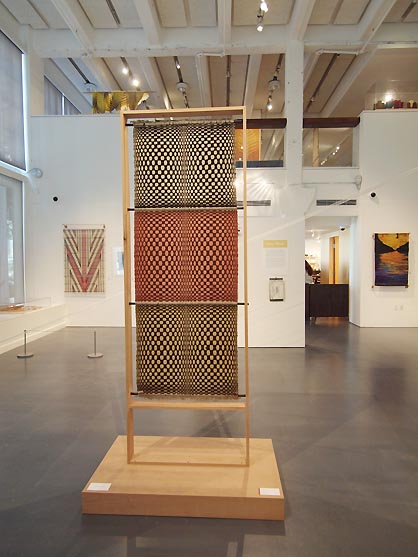 MoCC Exhibition view: Laurie Herrick Weaving, Yesterday, Today and Tomorrow (2011) Photo Jeff Jahn Yesterday PNCA announced that it will sell the property which currently house the Museum of Contemporary Craft and transfer the collection to its new headquarters building at 511 NW Broadway just down the street creating a new Center for Contemporary Art and Culture (a name that could mean anything). It has provoked strong responses ranging from anguish to relief and PNCA's leadership is getting a lot of blowback (some fair, some is simply hurt finger pointing). We could use some deeper and more nuanced thinking regarding this sad news as PNCA's hand was simply forced after years of subsidies. The troubled museum, which began life as craft oriented social/professional club simply had difficulties making the transition as it tried to become a museum. In fact, it has always been on life support from PNCA since the merger in 2009, which PORT covered extensively... ...(more) Posted by Jeff Jahn on February 04, 2016 at 14:06 | Comments (0) PermalinkMonday 02.01.16 Monday Links Hans Ulrich Obrist on the future of Contemporary Art. One of the things that distinguishes him from most big name curators is the way he readily admits their cultural cache supersedes that of curators and institutional immpreneur. Of course the idea that the "present" is slippery or splintered into intangible pieces is a very Los Angeles sort of notion and yet a lot of art is about being "present" and is not so slippy for anyone with an eastern outlook or access to the splintering the internet, which seems to record what is present with relentless detail. The difference is velocity of consciousness/awareness. Here's my quote, "The future is always over before you know it"... that means those with "an edge" find it through the obsessive over-familiarity of experience that is hard to rationalize...
Ken Johnson on Flatlands at The Whitney. The de-skilling thing is hardly new and the masters of this sentiment like; Rosenquist, Duchamp, Max Ernst, Picasso, Neo Rauch and Dana Schutz should continue to loom large in the minds of those contemplating the exhibition. The Internet didn't inspire current painting... perhaps painters dreamed (or memed) of the internet? Werner Herzog discusses virtual reality. The Knoedler trial continues... Posted by Jeff Jahn on February 01, 2016 at 17:15 | Comments (0) PermalinkWednesday 01.27.16 Save the Littman Gallery at PSU 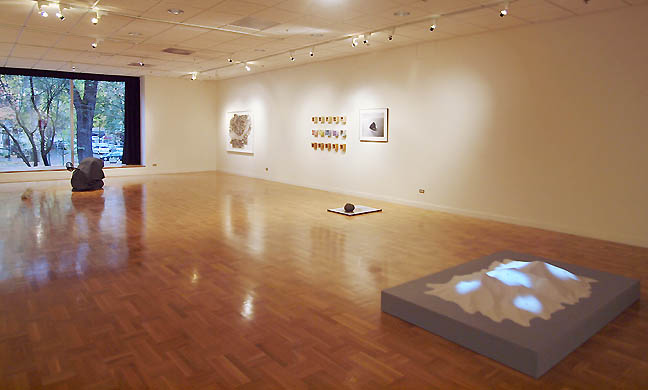 Littman Gallery (foreGround exhibition 2012) Apparently the future of the Littman Gallery at PSU (one of Portland's best art spaces) is in serious question as the school's administration is planning to restructure the Smith Student Center, which houses it. One plan is to reallocate the space for an African American and Pacific Islander center. This makes little sense, diminishing established and noted cultural resources for other cultural resources seems to completely miss the point of having cultural spaces in the first place and takes away from the college experience. The Littman has long been the best place for PSU to engage the community (see this interview with William Pope L. on the occasion of his Littman Gallery exhibition.) Despite being student run the Littman has launched countless art careers and numerous exhibitions that have changed the city's cultural complexion. I've personally curated 3, including PLAY (2002) where Bruce Conkle first exhibited his snowman in a freezer eco-existentialism. PLAY also posited the idea that Portland was a place for experimental and conceptual new media art (back in 2002 this was a contentious idea). What's more, unlike other PSU galleries the Littman isn't hidden away in a building only art students see and fondly remember the interactions I've had with casual visitors to the exhibitions I've curated at the Littman. As an art city that needs spaces open to new programming Portland simply cannot lose this valuable cultural resource and the fact that it is run by the students also makes it more susceptible. It greatly diminishes the invaluable experience that the student gain from running the space as well. The Littman Gallery staff has asked you to email them with your support here: littmanandwhite@gmail.com and please spread the word. *Update: in a rare bit of good cultural news for Portland the Littman Staff just announced that the gallery is no longer in danger of being closed, mentioning that the all of the responses made the difference. Posted by Jeff Jahn on January 27, 2016 at 20:25 | Comments (1) PermalinkMonday 01.18.16 Bowie edition links David Bowie died just over a week ago and frankly I waspretty busted up about it. From 1999-2003 I wrote for Modern Painters magazine, during the London era when he sat on its advisory board... I know a lot of people who actually knew the man and it is pretty plain that most people know the art more than the person. He was deeply interested in critical dialog, not just garnering attention.
Here in Portland the constant din of people trying to out Bowie one another... even at New Seasons just made me want to pull back. Here are a few Bowie links related to Art that might be of interest: David Bowie's top 100 books... you get a sense of his interest in artifice for its own essentially humanist sake. Michael Kimmelman interviewed Bowie on his taste in art. Notice the edge the man has? ... even for artists he liked. BTW that is a Great Auerbach. An interesting interview with the musician who worked the longest with him... all sorts of good things for any artist to take from it. Posted by Jeff Jahn on January 18, 2016 at 13:07 | Comments (0) PermalinkThursday 12.31.15 Round the web 2015 wrap ups I've decided to publish PORT's look back at 2015 post after the first of the new year... partly because it is so extensive and partly because I don't like simple lists and everyone seems more receptive to reflection right after the new year begins. Before that, it is just kind of a popularity contest and people don't think too hard about the year when they are at holiday parties. Like the 2014 look back 2015 will be a doozie and not merely celebratory (another reason not to put a burn notice out on anyone on New Years Eve). I already published our top 10 most popular posts of 2015 here here as a appetizer.
To tide you over here are some other year end wrap ups: Here is Artnet's art world winners and losers list of 2015... notice how Jerry Saltz is in the winners list yet there was significant blowback at him at the beginning of the year? Lesson, good critics thrive on criticism. Killing off a critic with words and chest thumping is like trying to put out an erupting volcano with a forest fire. Fail. Kengo Kuma has been chosen to replace Zaha Hadid for Japan's 2020 Olympic Games stadium. Kuma is designing the new Portland Japanese Garden expansion which we spoke to him about here. Lately, Olympic Games have been saturated with immense cost overruns that take decades to pay off and what I like about Kuma is his sober focus on excellence rather than flash. Leave it to the Japanese to start fixing the somewhat broken Olympic system. Jonathan Jones is often wrong as a critic but he's right about the art world's turn to do-gooder morality art becoming stifling to the health of the art world. Art is not simply the illustration of our intentions, good or bad it is about exploring the amplitude of humanity's potential (which does have a dark side)... too much moralizing gets in the way of that. I also think his call for simple "rebellion" is just typical screed. Basically "rebellion art" and "radical art" are completely different critters and I'll take the latter. Rebellion is easy, you just point at something and say... that's bad (kinda like artists who think criticism is bad for them, it isn't). Radical thinking usually takes some brilliant thinking and makes room for even more approaches. Posted by Jeff Jahn on December 31, 2015 at 13:53 | Comments (0) PermalinkMonday 12.14.15 Monday Links It is that time of the year again and everyone is doing their best of 2015 lists (PORT waits till just before or after January 1st to really dig into things and make it more than a list). Still, The New York Times and The Guardian are already making their lists. Jerry Saltz too. To my eyes, early 2015 seemed like a year where an impulse of "kill the King" reigned... where every major art impresario from Klaus Biesenbach to Jerry Saltz & Roberta Smith were thought of as passe. By the end of the year that sentiment had waned and yes it is good to be king... but it is even more important to recognize what gives certain people staying power as cultural voices. The great ones do get complaints, partly because they are great... even Great enough to make mistakes occasionally and STILL matter.
Trolling the art world is a thing and some of this has little basis, some of this is hilariously valid. Jerry Saltz makes up with MoMA... kinda. It is true that most museums are experiencing a tremendous identity crisis these days trying to balance popular and serious pursuits but the real issue is how well thought out the new MoMA expansion plan will be. MoMA has deservedly received massive blowback for losing their edge and seriousness recently but the new building configuration will cement or correct those errors. Everyone is watching this (Jerry does not sound enthused after seeing the latest designs). This is all the more important since the Whitney and Metropolitan are both poised to usurp MoMA's place in NYC (and the world's) in the hierarchy of relevance. The thing is other museum's tend to follow their lead but I'm not convinced any of them are on the right track. Museums are in a difficult position as they occupy that difficult place between patronage, populism and relevance, the last seems to consistently get the short straw because the quality of and institutional trust in curatorial expertise has been slipping. OPB did an exit interview with Tom Manley but it doesn't tell us much other than he did not seek out Antioch, they invited him to apply. PORT broke the story locally (even before PNCA) but it was strangely quiet when it was announced he was leaving the city. It was also incredibly wrong because Tom was the single most influential leader in Portland over the past 12 years... (more) Posted by Jeff Jahn on December 14, 2015 at 1:18 | Comments (0) PermalinkMonday 12.07.15 Monday Links We are just putting the finishing touches on a review for you. Till then here are some links.
Kenny Schachter dishes on ABMB in a way that isn't just anecdotal fluff. But no, art history survives this because that is what history is... the survival of what mattered or will matter. Martin Puryear is one of those artists whose work seems to have always existed... yet it is made. There is poetic genius in that kind of approach. Christian Viveros-Faune on why Art Basel Miami Beach puts the cart before the horse then kicks the horse. True that this has been written a million times but this article gets at the meat of the matter. An idiosyncratic curator who likes to call herself "a director" because it is "more modest." Ok, I can't buy that but I do like the other aspects of her approach, which is mostly about giving artists what they need rather than the other way around. Posted by Jeff Jahn on December 07, 2015 at 1:06 | Comments (0) PermalinkTuesday 11.24.15 Holiday week links Here are some things to tide you over.
The Stranger reports that the much anticipated Paul Allen backed Pivot Center for Art + Culture isn't going to be a full time exhibition space that Seattle had expected. That's disappointing because I liked the interaction of art and science it was supposed to address. I find it all the more interesting because art and science don't have very clear channels of dialog between each other. Whether this is just another adjustment or part of a broader shift in Allen's cultural activity remains to be seen? Still, I am hoping this signals a move into a more innovative direction but it certainly isn't good news for the full time staff Pivot recently announced. Ultimately, those who have the greatest impact on the arts are those who take an idiomatic position then follow it up with dogged determination for about 10-20+ years. That said the New York Times ran an interesting art and science piece on space. Our perception of spatiality is something that is created through how space is used and not enough is done to explore its influence on us. The Guardian asks if "hip Portland is over?" First I don't think they know what really is hip about Portland (*hint it is values based on moral distinctions... mostly non-corporate and knowing the true cost of things not just $$$). It isn't and never was the quirk hype that the Portlandia show overplayed. Absolutely though, there is an affordable housing/artspace crisis, but all interesting places including New York, Berlin, Santa Fe, Seattle and London have all faced this phase as well and it comes and goes. I think is good that it has been a relatively sudden issue that built over the past 2+ years rather than a slow bleed. Overall, I want to address this elsewhere and not as just a reaction but I can say that Portland's days of expecting artists to do everything for free ended a few years ago and treating art/artists as a cheap resource needed to go away. For the meantime read this bit I wrote a few years ago about priming the cultural pump in Portland. The indie industrial complex always has a new cheaper less-developed city but that just means we have to be more serious about what we support or else you lose the best talent (much of which actually bought property here and will stay, for now). Basically, raise the stakes institutionally/funding-wise and make it tied to merit and critical thinking. A very interesting review by Matthew Collings on Artists and Empire at Tate Britain. Imagine if US museums used art and objects to interrogate and question the past like this? Also by Collings is an interesting article focusing on quantity over quality in the art world today. He's one of my favorite art critics for the precision he applies to art's ambiguities... Posted by Jeff Jahn on November 24, 2015 at 13:25 | Comments (0) PermalinkWednesday 11.18.15 Tom Manley leaves PNCA 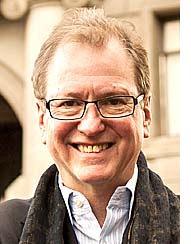 Tom Manley It was announced today that Tom Manley will be stepping down as President of PNCA to take over Antioch college. Manley leaves after December 31st. It suffices to say that of all the leaders in Portland over the last decade or so Tom Manley has had the most impact on the Portland cultural scene, period. ...(much more) Posted by Jeff Jahn on November 18, 2015 at 10:50 | Comments (0) PermalinkMonday 11.16.15 Great Links Today, the idea of "Greatness" in certain artists is somewhat out of vogue in the academies and perhaps too popular in museums, where every big name painting is suddenly touted as a masterpiece. The Truth is both are intentional dilutions and are institutionally self serving. (Yeah I used the word Truth, one can invoke it but not pinpoint it... it is easier to identify in its absence or the promise to be attentive to seeing it cross our paths, however fleetingly)
For perspective, today Portland is full of good to very good artists (500-1000?), perhaps 50-100 consistently excellent ones and maybe 3-4 ones who can summon greatness any time they want (those 3-4 are very different than the others, I've never once seen any of them satisfied and are incredibly good critical thinkers that have immense technical capabilities that they feel are just barely adequate). Real greatness isn't that rare as most people experience it in flashes but the kind I'm talking about lies in a kind of constant questioning, questing relentlessness. One where every action is an interrogation of the matters at hand; what to do?... what can be done? ...and why not? These are conceptual and existential questions that meet the world at its terms... not just the projection of the artist's desires. I find that the strongest artists are like rivers, their flow finds their channel by abandoning their preconceived notions. Just like rivers they follow fault lines and grind into the bedrock becausethey are so supple intellectually and often materially. Their process isn't just the path of least resistance, it is the natural path of relentlessness to work at the fissures and the seems of that what most people take for granted. The always work/cut in the deepest channel. That said here are some great links to consider: I'm not sure is George Shaw is a Great artist but he is consistently very good and this interview in the Guardian is a good read. Roberta Smith's account of what makes Picasso a Great sculptor explains a few things that we never seem to grow tired of. You can hate the man or the reputation but the artist is hard to deny. Another artist that many younger artists have grown to grudge is Ellsworth Kelly but this visit with the Guardian shows just why he is the real deal. The man breathes art and I admire him greatly. If you have a problem with his art, read this piece. Peggy Guggenheim was a truly Great art patron. Today most collectors are just that, collectors and it is a more commodity driven exercise than one of sustained development between patron and artist. True, some do a bit more but the Great ones challenge artists and take real risks... not just offer incremental opportunities or vanity projects. Great patrons stretch artists beyond any demonstrated previous capacity and the artists do the same for patrons. I'm not certain Great artists are possible without Great patrons and perhaps a Great institution or two. Posted by Jeff Jahn on November 16, 2015 at 11:06 | Comments (0) PermalinkMonday 11.02.15 Monday stories Well there is a lot of talk about Frank Stella. Yes he is influential, yes he is an unlikely instagram star and yes it is ok to hate the late work but as Jerry Saltz says it will tell you something about yourself. My take, Of course I prefer the black paintings but I love to tolerate everything he's done that is at least painted. The naked unpainted metal stuff... well I see why he went there (he had gone everywhere else) but it feels like mall art. Maybe he isn't going out on a high point but it is further evidence that the so called "minimalist" artists had nothing to do with sober geometry as an aesthetic. Judd and Serra ate his lunch as a sculptor but all this attention reminds us how this guy IS a painter.
Speaking of painters Squeak Carnwath's "guilt free" work does make its case. There is a pluralism that we have to applaud... because anything that breeds and encourages freedom (I know that sounds sappy but it isn't) has immense value today. Painting can be the voice of adolescence in a good way and anyone named Squeak basically has to own that fate. Check out Paige Powell's photography show at PAM in the old grey lady (show opens Wednesday night at the Portland Art Museum). With this, the Kenny Scharf show and a William Jamison exhibition in a week Portland is going 1980's to the max this Fall. Here is some very exciting news, the Oregon College of Art and Craft has received a grant from the Murdock Charitable trust to, "enhance the educational and studio resources of OCAC through the acquisition of specialized digital machines that will dramatically expand the college's tools of craft. This technology will open new possibilities for students and faculty in creating their own art, and it will prepare students for careers in advanced making and manufacture." Translated, that mean digitally driven machines (3d printers etc.) that evolve the ever expanding tools that we use to craft our world. This is important as so many have framed the craft fetish of the Northwest as some purely handmade and tradition. It is false notion and even computer coders are a kind of craftsperson. What's more, Portland, Seattle and Vancouver BC (and many other smaller Northwest cities) are players in the digital forest and it is great to see the premier craft-oriented school in the region making this leap. Other institutions need to follow into a more expansively cogent discussion of craft in the Northwest. We live in a world where DNA and even sub atomic particles are being manipulated. Science and technology are part of craft. Last but not least, 15 years ago Phong Bui started the Brooklyn Rail and they parallel what we do here at PORT (Ive even championed some of their writers in national grant panels). I like that Brooklyn Rail aims not for the most readers (200k a month is great though, PORT has 150K) but instead focus on having a cogent and critical voice that coalesces into a kind of authority. "Likes" are fine but culture ultimately isn't a popularity contest and a like isn't LOVE. Culture is much more important than being accepted on trivial terms. I'd argue that "Culture" helps us identify and perhaps understand the tensions and joys of the age. At a certain point that requires a critical voice that goes beyond saying this artist is the favorite of this gallery and this collector. At a certain point you have to ask why? ...and to what ends? Congrats to Phong Bui and the Brooklyn Rail. Posted by Jeff Jahn on November 02, 2015 at 12:00 | Comments (0) PermalinkWednesday 10.28.15 Save the Coliseum It came out today during a Portland City Council meeting that Commissioner Steve Novick wants to destroy the Memorial Coliseum by selling the land to a developer. 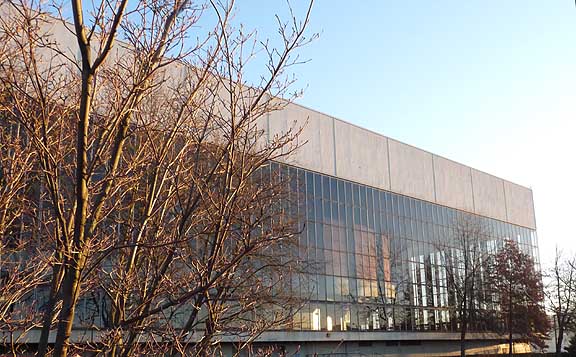
This is both ecologically and culturally irresponsible... not to mention financially since the building still breaks even in its current state. The promise of "affordable housing" with new construction also deserves some incredulity. We have discussed this before but the building is one of the very best Mid Twentieth Century modernist buildings in the Pacific Northwest and deserves to be renovated in a way that preserves this important historic aspect. I encourage everyone interested in this to write: Mayor Charlie Hales at mayorcharliehales@portlandoregon.gov, Commissioner Dan Saltzman dan@portlandoregon.gov, Commissioner Amanda Fritz, amanda@portlandoregon.gov and Commissioner Nick Fish nick@portlandoregon.gov Posted by Jeff Jahn on October 28, 2015 at 14:30 | Comments (0) PermalinkTuesday 10.27.15 Substantial Links The Walker Art Center was nice enough to publish Alexander Blauvelt's catalog essay for their Hippie Modernism exhibition titled Aesthetic Radicalism. It brings up a number of good points though I think the dichotomy he makes between minimalism/formalism and psychedelic art are an unsustainable argument. For example, Smithson was obsessed with Judd's crystaline fragmentation and Judd's own love of John Wesley and Claes Oldenburg's work undermines his argument's premise. He is right in that the art market, most historians and museums did separate them. Hopefully, this exhibition will help break down some of the very bad art history done on so called minimalism the 1960's and 70's. This is the sort of design/art aesthetic/societal movement show we should see in Portland more often too... I curated this show last year.
Artinfo asks if can single venue galleries survive? Good question... answer of course is no. Gallerists must mix and show outside their brick and mortar spaces, art fairs are crucial but oversaturated so choosing the right one or two matters tremendously. The real question is how do you develop a brand and following? ...(more, including a tough review and thoughts on Paul Allen) Posted by Jeff Jahn on October 27, 2015 at 10:36 | Comments (0) PermalinkThursday 10.15.15 Weekly Links Hermann Nitsch's work isn't academic or formalist, more like a religion of signs without being tied to beliefs. His work is getting a lot of consideration now because it also isn't terribly commodifiable becuase how do you put a price on provocation?
An interesting discussion of higher education and art. The sheer # of art schools and students isn't so much the problem as is very low standards for being a "lifestyle artist" these days. Pedagogy and being able to explain yourself doesn't make you an artist. When the few strong curators and critics can't fully explain why they keep paying attention to you, but still do it because you are leading the way into something nobody fully understands but need to... then you are probably an artist. The trick is that "tracking" that occurs and though art schools are important they are kind of a side bar to the art world... kinda like the relationship of butterfly hunters to butterflies (which isn't necessarily trivial, but no where as important as the butterflies actual environment they live and die in). Think of it like salmon raised completely in captivity vs wild ones. The question of "who" is benefitting from the education system is important though and one problem I see with all these school expansions is they don't endow their new programs like they do the buildings. Free tuition is interesting but I can't see it being the norm. The Met is commissioning Cornelia Parker for its rooftop. I've always liked this model of museum's as patrons... it gives room to push boundaries where individual collectors or galleries that rely on them can be timid or simply space constrained. Posted by Jeff Jahn on October 15, 2015 at 15:30 | Comments (0) PermalinkTuesday 10.06.15 Portlandia at 30 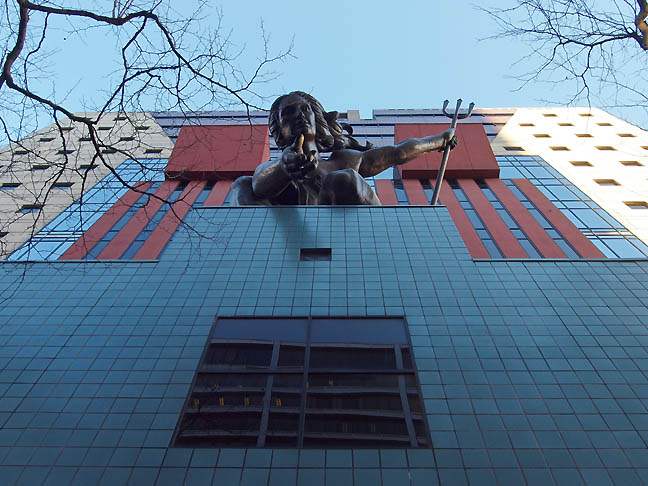
Perhaps the first litmus test for anyone's basic knowledge of Portland is whether Portlandia calls to mind a cable tv show or a sculpture which serves as the focal point of Michael Graves historic Portland Building. Well it turns 30 this week and RACC is throwing a bash on Thursday featuring Mayor Hales, former Mayor Clark and Nick Fish from 12:00- 1:30PM October 8th. Still, it is very important that the sculpture isn't considered just a stand alone cultural feature. Instead, it is a kind of hood ornament for the first Postmodern building... an anthropomorphic totem that conveys the then radically humanistic aims of the entire Graves designed project (the interior is dismal). Sure, we remember the hood ornament on a car but its kind of an introduction to the spirit of the design and in this case it is a historic building that is designed to be a kind of gallery for the sculpture. That was a radical move and it is troubling how many feel the only sculpture itself is important. The world renowned building needs to be saved and rehabilitated sometime in the near future. Besides, without that building Portlandia simply becomes a big neo beaux arts sculpture, but upon its pedestal it is a kind of spirit of what Portland's government (with offices within) should aspire to. Posted by Jeff Jahn on October 06, 2015 at 12:36 | Comments (0) PermalinkMonday 10.05.15 Monday Links Well I'm back from my travels. Riding other transit systems and looking at bridges will inform my comprehensive review of Portland's Tillikum Crossing bridge and the art around it (stay tuned, I should have it polished off soon... yes I will finish off the Guenther history piece as well, but the bridge is first and far less complicated). Both look at the big picture as well as the details.
Till then check out these links: Can art still shock? ...especially in the selfie age when artists are expected to create art that panders to the audience's need for their expression? This pushes art deep into a polarity of sycophantic or narcissistic strategies for resonance but that's just the mediocre stuff. The great work like Anish Kapoor's bean (Cloud Gate) in Chicago rises above the pandering by pushing that need to commune into an ecstatic outdoor cathedral devoted to humanity as a macro-organism. On a similar note the new Turner Prize lineup does look ultra-earnest, pandering and therefore extremely dull. By pandering to narrow and cliquish sensibilities the work is guaranteed to speak to a small group of people who expect pandering on their narrow pet subjects. That's why so much research art is mediocre, it achieves predictable aims because it researches things it has already formed a kind of fetish for. There is a lots of earnest navel gazing art these days, much of which looks like post-minimalism or other 70's art (fetished white walls used as a foil for raw wood constructions, performances where someone does something with a liquid and or nudity etc.). Stronger work gets lost in its own needs and emerges from the development process very different and it confuses the hell out of you when you encounter it. Here is an interesting interview with Kate Rothko on how the art world sought to cheat her after her father's death. Considering Rothko's connection to Portland I feel like more here need to be aware of what happened. One bright spot was the first Nasher sculpture prize going to Doris Salcedo. She isn't being "authentic" or fetishing an era of art gone by... her work evokes a serious sense of loss and longing for what cannot be recovered. It is powerful because it is hard to wrap your head around it physically, intellectually and emotionally... as strong art should be. Posted by Jeff Jahn on October 05, 2015 at 18:04 | Comments (0) PermalinkMonday 09.21.15 Monday Links The Guardian reviews Ai Weiwei's first major retrospective in London and gets at the heart of the matter. True, so much of it is recycled pop art but it is his ability to effect and redirect history instead of a simply affect it in a quotidian way that separates him from so much art that has been littering the art world for decades and the Portland Art Museum just showed a major if relatively well behaved work of his. We interviewed Mr. Ai here and the question remains if his work will keep its potency with his newfound freedom?
Airborne art fence at the US/Mexico border. The most toxic sites in America as art. (Portland has plenty of sites btw). Posted by Jeff Jahn on September 21, 2015 at 8:33 | Comments (0) PermalinkSaturday 09.05.15 Weekend links Everybody must read this review of Hal Foster's latest book on the various cliches that a lot of art has become. Every decade or so the art world starts to purge prevailing strategies which have become a kind of pantomime of themselves... we are at one of those "correction" moments in art history.
This little bit of art writing is too generous for the overly precious, research based cliches it reviews but it is good that it points out the problem. Basically if you want to make cliched contemporary art simply do some research, then present in the center of a clean white room in a precious way. Let's look at the takeaway vocabulary as a synopsis: hermetic, intersubjective communication, suppressed. Hermetic an intersubjective communication cancel each other out, leaving suppression as aform of formal presentation the end result. It is basically the way this type of work is placed that is the primary information of the installation... it say I have institutional carte blanche to present this glittery contemporary art postcard in a blank room. It is festival art 101, contemporary art as souvenir. (Thanks to Matthew Collings who brought this to my attention) Yes,looking at art makes you smarter... but I'm pretty sure that reading a lot of art writing handed out at the venues will challenge your tolerance for cliched thinking. Posted by Jeff Jahn on September 05, 2015 at 11:10 | Comments (0) PermalinkMonday 08.31.15 Suggested Reading A review of a second book that is about the writing of a first book on Francis Bacon. Sometimes the art is in that which survives the transcription into history.
An excellent interview regarding a great late Barnett Newman exhibition. Ralph Rugoff comes off as a deflecting pedant when talking about his 2015 Lyon Bienniale but the shift in taboo word of "modern" is interesting. Rugoff is a practiced contrarian when it comes to language and these festival shows are frequently intellectually capricious. In many ways he is a very right way to strip Alfred Barr's progressional timeline from what should be a very common and useful word "modern". All the School of Paris artists were trying to do is something current and yes "Modern". They didn't form salons devoted to "Modernism"... that was bill of goods the world was sold after the fall of fascist regimes involved in WWII. That's why the swipes at modernism and an attempt to rehabilitate the term is a bit of a straw man arguement. Hyperallergic looks at writing art criticism. We at PORT see criticism as an experimental form that actually prioritizes challenging communication that embodies the challenge of communicating something about the challenge ...whew. And no academic diplo-dialects that never take a stance aren't so much... (more) Posted by Jeff Jahn on August 31, 2015 at 1:01 | Comments (0) PermalinkMonday 08.24.15 Monday Links Here is a fascinating article on the arts and development/gentrification from Great Britain. Part of the problem I see with Portland's very knee jerk reaction to gentrification is the way it is prophylactic... as if change can somehow be halted. Needless to say that isn't realistic and Mayor Hales announcement last week was a step in the right direction but it needs to also incorporate the additional amenities that cultural spaces add to a displaced community that is trying to re-seed itself. Portland needs to embed cultural amenities into new development and provide the economic incentives to make it happen. Still, these re-seeded communities are kind of a consolation prize though we also need to protect those special artistic micro-ecosystems that take place in buildings. What's more the city has big red "U"-s on a lot of buildings that though not up to seismic code could be put to some use... just like artists have always done (they know the risks). Also, that means we should reward artists who take risks in Portland... for as progressive a city that we are we are programmatically very conservative on the institutional and awards level. Part of how Portland maintains a competitive edge is to help foster those artists who contribute to the "fine edge" that our city currently enjoys. Portland has to get over its phobia of individual achievement... often letting institutions from elsewhere (museums, publications, awards) be the first to give a national platform to artists from Portland.
A fascinating article on the crisis that art schools currently face, in this case San Francisco's AAU. One problem that nobody ever seems to bring up is the way fundraising for these schools do not endow specific teaching positions and programs (it is all about buildings and creating new programs rather than strengthening current ones)... that's the reason many of these schools have under experienced professors, tenure and depth of support has evaporated placing all of the pressure on enrollment. Ah, lets get back to the art... Richard Diebenkorn was born here in Portland Oregon and here are images from his sketchbooks. He didn't grow up here in a formative way like Rothko did but we hardly need that to appreciate the seeds of his practice in his sketchbooks. There was a little news on Converge 45, an international arts festival for Portland beginning next summer. Though the title theme "You in mind" sounds like a "curatorial selfie stick" of an umbrella idea that has been done to death already (there are far smarter concepts we could and should highlight and hopefully the component shows can rescue it from anonymity). Here is an interesting look at Snohetta, the architecture firm that is designing the planned James Beard Market in downtown Portland. Currently that preliminary design strikes me as somewhat generic Nordic architecture but the devil is in the details of these things and I'm certain they will give it a more Portland personality. *(Hint more eclecticism that heightens the bizarre cacophony of a bazaar... Portlanders don't easily grow fond of unified textures/treatments.) Both this market project and the new Japanese Garden expansion set the bar for design in Portland (PAM & Portland Building projects take heed). Posted by Jeff Jahn on August 24, 2015 at 12:39 | Comments (0) PermalinkMonday 08.10.15 Monday Links Spanish artists rig ATM's to spew drachmas. Things are tense everywhere and somehow Greece, the cradle of western civilization is at the top of any attentive person's radar these days. It seems like a full circle civilization question... do people serve the system if the Kantian contract is broken between economies, governments and people? Seems like this Fall will bean social and economic roller coaster. Good that artists are inserting themselves, they are kinda the cartilage of a civilization's body.
Artists and writers creating crosstalk at the Guggenheim... hmmm. Carol Bove is probably the best of this genre at the moment, one where bookshelves are used constantly in installation art (add the extensive use of white if the artist is really gonna run with the cliche). Most writers just use art to an excuse to make words though and the writers who wish they were good artists usually just rip off Carol Bove these days (Bove is better because she isnt just a twee quotidian who makes one or two moves, there is a relationship to Giacometti that is actually more than just namedropping and posturing). Frankly, very few have done anything interesting with shelves on walls since Judd (partly because they weren't actually shelves). Museums like the Tate are trying to engage and provide more experiences... but I think the real problem is not having enough immersive installation work. Let the Francis Bacon be a great painting (they work fine) and collect some great sensory stimulating installation art if the institution doesn't seem relevant, varied and current enough. Square peg round hole situation. Nice try but its a bit of a band-aide for a more endemic engagement/edifice problem. The art is current but the art market which defines patronage doesn't value experience as much as branded precious objects. It's a problem with Western thinking... best of luck with solving that my museum friends. Participation isn't the answer, promoting concentration and appreciation are and it takes curators who are philosophers not just ingratiator/careerists to do that. ...(more) Posted by Jeff Jahn on August 10, 2015 at 18:02 | Comments (0) PermalinkMonday 06.22.15 Art World Stories Kenny Schachter's damage report for Art Basel. As much as these articles always seem to present themselves as an all new scenario, generally things have always been this way. The difference today is the scope, scale and stakes have shifted considerably... the art world consists of a series of negotiated confidences but what happens when art is considered a class of investment? Something that has been going on since the Romanoffs etc... only now it is far less of a medieval style market.
Which brings us to the revolving door article on museum curators and the top art galleries. Once again, institutional curators always have kept up relationships with galleries. What I find most interesting is that the most talented curators at the height of their powers and confidences like; Storr, Schimmel, Elderfield... all people I know and admire greatly, somehow don't feel like they fit at our top museums anymore. Museums have always been on the sometimes tense border between the interests of the 1% and their duty as custodians of culture/access for the public but what happens when all the best and brightest talent either becomes a museum director or an art consultant? In a related story, "Death by Curation," and the dangers of blockbusters... but is it really a lack of curators with a integral programme? Art pavilions have been a major trend for institutions and festivals trying to get beyond the art bunkers and white boxes and the latest trippy cocoon for the Serpentine Gallery is no exception. They can catalyze different types of engagement. Some artists like Jorge Pardo have made careers out of them, (his permanent one in Portland is a personal fave because it subverts function by substituting shelter for lighthouse-like navigation concerns). 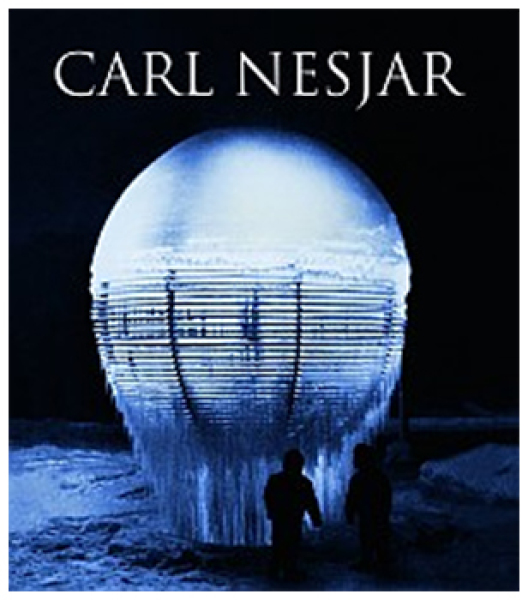
Here is a fascinating obituary for those unfamiliar with Carl Nesjar, perhaps the only artist allowed to alter Picasso's work. There is something incredibly current about the level of delegation and collaboration that existed between these two artists and I'm a fan of Nesjar's personal ice fountain work as well. Posted by Jeff Jahn on June 22, 2015 at 10:32 | Comments (0) PermalinkMonday 06.15.15 Monday Links Well, finally they've done something potentially "whelming" with Disjecta's Portland 20##Biennial series, which has always been more about the institution's aspirations than anything else. The 2016 version will be curated by Michelle Grabner, 2014 co-curator of the Whitney Biennial and someone I've known since she was in grad school. Grabner has a knack for getting past the sometimes juvenile local politics so she should well equipped to deal with those chasing the Whitney effect. She will need it as previous biennials have been more social gatherings than strong shows. Rather than probing looks at what an art scene in Portland constitutes/means they have been adept at showing us things we are already incredibly familiar with throughout the year before and the works themselves never seem to standout (rushed time frame and a sense of low stakes). Other challenges are the fact that the previous versions have included so many artists that this one will likely be forced to finally present new discoveries (something sorely missing previously) and group shows at Disjecta always seem to lose the plot (making the shows at commercial galleries a questionable practice and a caste system step up from the host venue). An outside curator is a good idea, but like their curator in residence program it also means they come in not knowing the terrain. Lately though, Disjecta's group shows have improved to reach unmemorable status (the last biennial mentioned craft but didn't go any deeper than checking off a local buzzword that is both fetished and pushed back at). This scene has been asking for better since 2010 and Michelle might be one of the few capable of pulling off something sophisticated enough to pay attention to. Besides, we cheeseheads tend to call it like it is so I'm curious what Michelle will make of the legendary Portland style passive aggressive tendencies. Also, here is a more exhaustive analysis of why and how local surveys and awards miss the mark, it is older but everything still holds. We haven't had an institutional survey that took chances and yet made an impact since the 2006 Oregon Biennial at PAM. As always, execution will matter most in the end... if the institution, curator and artists don't really take care and just let "the process" drive the result, it will resemble itself like these things often do. She has the backbone to counter the false more is more strategy they have been using and being an artist and not just a curator should help her. The question remains why both locals and outsiders have bun unable to contend with the scene here, which has become both increasingly local and international at the same time? Portland in general is tired of being reduced to catchphrases.
I'm shocked but pleased that even the Oregonian's editorial board is seeing the need to preserve important architecture like the Memorial Coliseum and the Portland Building. We've argued for this constantly for the past decade... and no the fact that TLC is required and they are architecturally notable is not lost in the cross talk... it is the cross talk. Barbara Hepworth gets her due in Britain. Francesco Clemente is back in a big way at Mass MOCA. A look at Art Basel's influential jury in the NYT's. Posted by Jeff Jahn on June 15, 2015 at 10:24 | Comments (0) PermalinkMonday 06.08.15 Monday Links John Waters' 2015 commencement speech for RISD. Art is a hitch hiking trip and it does just take one person to get on board. The final irony... becoming an insider. Hilarious and true! It happens... Becoming the first artist in space? Novel stunt... but is it enough? It also says a lot that outer space doesn't seem that terribly challenging in itself. Glasstire on arts criticism not being dead. Good to hear. I have been working an essay (for a long time) that addresses this and much more but a few things are just wrong. For example, positive reviews like this recent one and this on Storm Tharp do go viral. Interviews like this one with Luc Tuymans and this also go viral. If you do something truly intelligent and far more perceptive than we are accustomed to, people do pay attention to criticism. I'll be publishing the criticism essay this month as part of PORT's 10 year roundhouse, along with several other things people have been waiting for (yes THAT post). It will be worth it. Posted by Jeff Jahn on June 08, 2015 at 18:48 | Comments (0) PermalinkWednesday 06.03.15 Hallie Ford 2015 Fellows Up to 5 this year the 2015 Hallie Ford Fellows in the Visual Arts are Ben Buswell, MK Guth, Tom Prochaska and Samantha Wall of Portland, and Jack Ryan of Eugene. Congrats to all.
Parsing it out it still seems like the awards favor: men academicaly afiliated locally as teacher or graduates at Oregon art schools those who foreground "effortful" craft, even if the work is conceptual (avoiding technological and experiential work or which is purely conceptual) On the plus side it seems like a better mix of younger and older midcareer artists who work in a variety of media... (more) Posted by Jeff Jahn on June 03, 2015 at 14:04 | Comments (0) PermalinkSunday 05.31.15 Weekend links Jerry Saltz reviews Jessica Jackson Hutchins latest. She is a Portlander. Interesting that he doesn't bring up Kienholz, which seems pretty obvious. She's different of course, there's a debt to Tracey Emin in there as well but nobody brings YBA's into the discussion around leading women in art today. They should.
Even Andreas Gursky has difficulties using trademarked super heroes. PORT's own Tori Abernathy had a great deal of exposure this last week... nice to see the mainstream press catching onto the issue of the arts and "creatives" being pushed out by developmentof supporting alternative art spaces. Perhaps Portland could look at Vancouver BC's Community Amenity Contribution system to ensure the arts are not pushed out? This was a fascinating read on conflicts of interests for reviewers at the New York Times. It is a must read for those who think they understand how criticism is supposed to work. Fact is, criticism and journalism are not the same thing and ultimately a true critic is a very different beast than a traditional journalist... (more) Posted by Jeff Jahn on May 31, 2015 at 13:54 | Comments (1) PermalinkFriday 05.22.15 Friday Links: Great Artist Edition We will have an essay and reviews for you soon but till then here are some exciting links about all time great artists. It isn't in vogue in academics but "Greatness" does exist (museums still hold the banner for this crucial idea) and these artists all are exemplars.
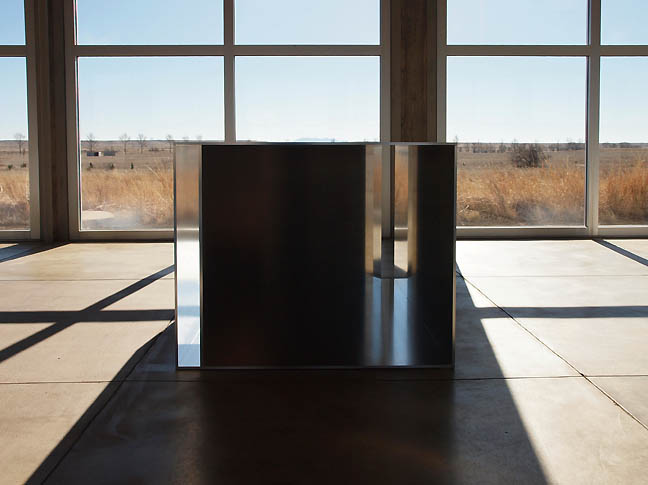 at Chinati (c) Judd Foundation. Licensed by VAGA, NYC (photo Jeff Jahn) at Chinati (c) Judd Foundation. Licensed by VAGA, NYC (photo Jeff Jahn)
The long anticipated Judd Retrospective at MoMA has finally been announced for Fall 2017. Judd is a crucial figure, partly for how he changed the terms under which we experience art and define ideal circumstances. His influence is so wide that most artists after him have had to contend with his rigor, logic, methods and integrity. In 2010 I helped organize a conference and co-curated a very unique Judd exhibition that explored his radical application of delegated fabrication. That conference and exhibition in Portland began an important return to the core discussions around Judd's work, something which had been obscured partly by ubiquity and forces in the art market. ... (more Hesse & Heizer) Posted by Jeff Jahn on May 22, 2015 at 11:38 | Comments (0) PermalinkFriday 05.15.15 Friday Links Excellent review of Yoko Ono's solo show at MoMA in the NYT's.
The news of the week is that an entire MFA class at USC has dropped out in protest. That schools do this is nothing new, Mark Rothko even had something similar happen to himself and two other Jewish students from Portland at Yale. What is different is the sheer # of art students and the internet as a platform for sharing these protests. As the pact between higher education and students grows ever tenser with skyrocketing student debt we haven't heard the last of this. The evolution of Van Evera Baily's midcentury modern homes on Portland Architecture. We art critics are very protective of our voice and Christopher Knight is absolutely right to demand something different be done with his misattributed words. Museums simply have a responsibilty to the art and the history of discourse around it, especially if the critic in question has made a formal request that it be changed. It also reaffirms why long term staff critics are necessary... a revolving door of freelances doesn't have the same kind of backbone to stand up for their words. A blighted urban street is in the running for the Turner Prize. *Update: Images of painter's palettes through the ages. Posted by Jeff Jahn on May 15, 2015 at 13:25 | Comments (0) PermalinkSunday 05.10.15 Chris Burden dead at 69 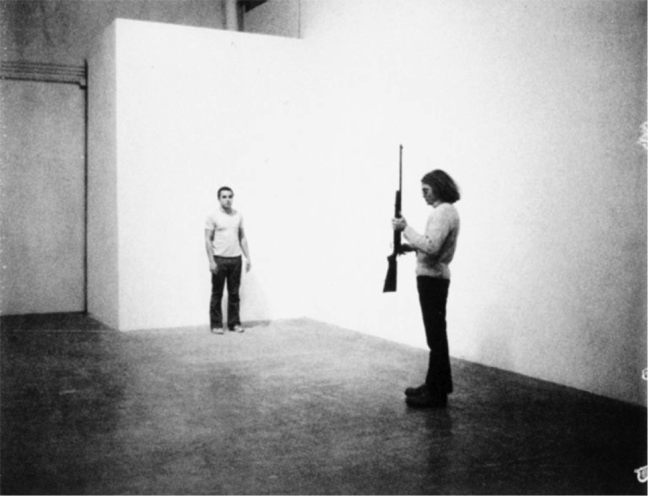 Shoot, Chris Burden's most famous performance piece Sad news today, Chris Burden a landmark performance artist who became one of the more interesting sculptors of the late 20th and 21st century has died of Melanoma at 69. PORT interviewed Burden here and I fondly remember his pilotless ghost ships at PAM a few years ago as they seemed to capture the zeitgeist in that holds still in the USA today. Burden was one of the relatively unknown artists that came through Portland's groundbreaking PCVA program, later achieving legendary status. For me, what always resonated about Burden was the work never seemed self centered, even when he was being shot for his work. He made art a kind of martyrdom or at least a symbol of humanity's reliance on self sacrifice (as a kind of structural necessity for culture... bridges etc.) and as such his example will live on. Christopher Knight's obituary in the LA Times hits all the right notes. The Art Newspaper's obituary also touched on the importance of the later work as well. Posted by Jeff Jahn on May 10, 2015 at 11:30 | Comments (0) PermalinkFriday 05.01.15 Friday discussion PORT will have the latest version of The Score series of reviews for you shortly. It will focus on curatorial decisions and you can read #2 from 2011 to revisit the single worst curatorial mistake in Portland history... never put Carl Andre sculpture in a display case.
Guggenheim occupied. Museums are on the front lines of the widening income disparities. On the other side of thefence the WSJ chronicles the making of the Frieze art brand. Christopher Knight rightly calls out the Whitney for misrepresenting his words. Roberta Smith discusses the uneveness of the Morgan Library's Embracing Modernism exhibition and it is a healthy to keep an eye on such connoisseurship if NYC is to keep its position... (more) Posted by Jeff Jahn on May 01, 2015 at 10:00 | Comments (0) PermalinkMonday 04.27.15 Discussion Links Christopher Knight pens the much anticipated rebuttal to all the Whitney love. Well, the cries of parochialism are a given though Knight celebrates the exclusion of Greenbergian Color Field painters like Morris Louis and Helen Frankenthaler... but really is it just substituting one parochialism for another? That's ok, one can come to Portland to see Frankenthaler, Anne Truitt and other Greenberg artists here at the Portland Art Museum, where the critic's personal collection now resides. What's more, the Whitney did just restage a great Robert Irwin last year so I'm not certain they are as guilty as Knight's still legitimate argument seems to present. Perhaps a museum's identity comes chiefly from a permanent collection, so the Whitney will still be able to play against of their expected New York focus as they years roll by. Still, for the first show they had to play the NYC card since they are in competition with MoMA as the NYC art museum. Frankly, I look forward to the LACMA expansion's LA style rebuttal. That is one of the nice things about being here in Portland, we make no claims to being an art capital but sitting out the cola wars style museum wars gives us a kind of Switzerland position (which is its own kind of parochialism). The more I think about it... parochialism that is self aware isn't necessarily the slur it is intended to be as long as the program learns to curate against form enough to keep it feeling vital.
We seldom hear from Michael Craig Martin in the USA but this interview in the Guardian gives insight into how the British addressed Warhol and eventually birthed the Britpop/YBA phenomenon. Those details... (more) Posted by Jeff Jahn on April 27, 2015 at 13:51 | Comments (0) PermalinkMonday 04.20.15 Monday Links Jerry Saltz on the New Whitney is today's must read, though it is kind of a rehash that uses the new building and program as a testcase. I agree, many museums have lost their way and the art (along with the serious curators that serve it) have been getting the short end of the stick for about 15 years now. The Whitney here seems to be finding a clarity of purpose through this building rather than the muddle that most recent building campaigns have produced. Going pure timeline and ism-dogma is a kind of intellectual death and the Whitney is right to avoid it. Question is if programmatically/curatorially it can utilize this new breathing space? (My forthcoming Guenther piece goes in depth into how curatorial programs have changed... yes it is still coming, likely closer to PORT's 10th anniversary on June 1 since it is kind of a retrospective on PORT as well). Basically, we live in an age that requires more incisive critical thinking precisely when it is in somewhat shorter supply than any time I can remember. Still, I like the way Saltz has focused on Weinberg here. He's a major reason this museum expansion seems less craven... somehow the Whitney now seems to be curious about itself and what it and NYC has been missing lately.
Surprising discoveries as the Glasgow's incinerated Macintosh masterpiece begins to emerge from the ashes. I've waited to chime in on Robert Storr's pronouncements on today's art critics because I Love both Storr and Saltz... both are true critics and just like having wolves and bears in a confined space conflict is pretty much preordained. First, we are in a moment of authority bashing (any misstep and someone will call for heads) and both Saltz and Storr both being ubiquitous authorities have an impressive cache of detractors. Familiarity breeds contempt and an art market/system that would rather farm careers rather than... (more) Posted by Jeff Jahn on April 20, 2015 at 14:25 | Comments (0) PermalinkMonday 04.06.15 Monday Links Brian Libby asks, can Portland contain its rising housing costs and "Grow the right way?" Generally the art scene is right on the front lines of this question as galleries and artist's apartments and studios are the canaries in the coal mine. For Portland it will basically take more property owners like David Gold, Al Solheim and Brian Wannemaker who understand that vitality in the arts can pay off in the long term in ways that aren't in the typical property asset management playbook.
Rogue sculpture seems far more edgy than Banksy with this unauthorized Edward Snowden Bust in NYC. Edward Winkleman on the new art world buzz around transparency in markets. Posted by Jeff Jahn on April 06, 2015 at 11:10 | Comments (0) PermalinkWednesday 04.01.15 April 1st links and musings 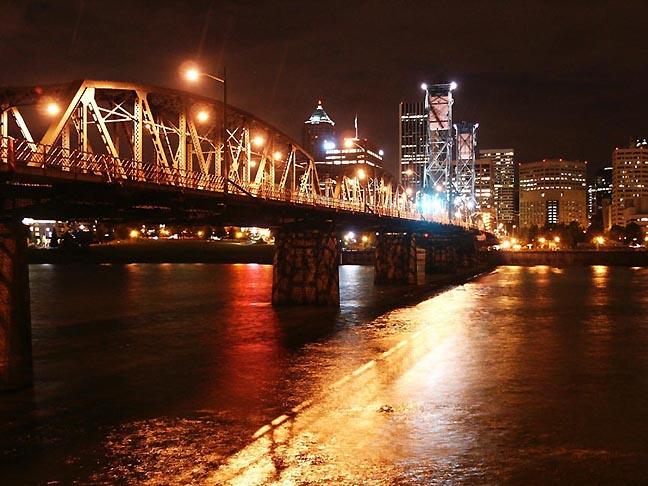 Photo Jeff Jahn Richard Speer pens the last of his articles for the WWeek with a reflection on the art scene and a list of his favorite shows. First of all it wasn't "better" it was far smaller and less academic with an odd sense that we were discovering our potential as a city (one which it had been deep denial of). Let's just say Richard has never been a lover of the academic position. Also, back then the same 50-100 people could be seen at every... (more) Posted by Jeff Jahn on April 01, 2015 at 12:11 | Comments (0) PermalinkMonday 03.23.15 Monday Links Zumthor's latest LACMA design crystalizes into something more than a blob. I think Los Angelenos were mostly reacting to an outsider simply reiterating the stereotypes about LA being shapeless and image conscious above all else. Though true it goes over about as well as an outsider producing a building or art about Portland being rainy and quirky. Sure, but can't we dig deeper? I Love Zumthor so I have faith he will continue to refine this into something special. MoMA in NYC looks like the Mall of America in so many ways comparatively.
Richard Diebenkorn's 10 guidelines for himself in and about the studio. I like #10 best (strong artists interrogate themselves and test their assumptions). Also, I would be remiss if I didn't mention that Diebenkorn was born here in Portland Oregon. Unlike Rothko, he spent virtually no time here and had not other significant history with our fair city. Because it is a season of bashing authority... it is now Klaus Biesenbach's turn at MOMA for the Bjork retrospective. One bad show, review etc. can't be grounds for dismissing people but it does hint that NYC is rightly concerned about losing its cultural edge and long-view relevancy/seriousness... especially at a time of tension between the haves and have nots is at a boil. There is a sense that many museums, MOMA in particular have jumped the shark by seeking short term popularity at the cost of other more crucial things (this is being played out in the rancor over MoMA's expansion designs). Posted by Jeff Jahn on March 23, 2015 at 22:08 | Comments (0) PermalinkFriday 03.20.15 Friday Links Brian Libby has a wonderful piece on the Feldman house remodel... yes the same Philip Feldman whose name once graced PNCA's Feldman gallery in the old Goodman building.
Review of Alfredo Jaar's latest in the New York Times. Jaar is one of those artists who seeks out the most difficult subject matter and frequently pulls it off with deft poetics involving, space, mood and conflicted cognition. Google is to create a database of street art. The unlikely push from major museums like LACMA an MoMA to protect the land around Michael Heizer's city. More handwringing over museums and Millennials... look it isn't just an app that is a magical meaning-making bullet (though I support the move). I've worked with them and myself am part of the Gen X wave that was the first to experience total integration of computers into our lives. I think a deeper more soulful approach is required, something my generation has been asking for as well. The world changed and museums + other arts institutions need a more savvy outlook that is based on the way people use museums not just one app. Notice how few tech people are involved in the arts? That has to change. It isn't a generational problem it is an anthroplogical understanding issue. The Walker Art Center has taken steps but sometimes they come off as ploys that aren't any different than just an app which is just a surface reaction to an endemic rift. Put it this way it takes far more than clickbait. 25 women curators... a good list but let's not forget that though female curators are plentiful female artists are valued for significantly less in the market and are under represented in myriad ways for their crucial contributions culturally. Not certain what to make of that cultural dissonance. Too few female directors as well. Posted by Jeff Jahn on March 20, 2015 at 10:58 | Comments (0) PermalinkMonday 03.16.15 Monday Links The racially charged debate over the Kehinde Wiley review in the Village Voice is the talk. Overall, the critical shots rely too heavily on archetypes (predator/prey)... which doesn't work because it is obvious that Wiley is all about personalizing archetypes and giving them the kind of projected confidence that provokes viewers. It is the the intellectual equivalent of critiquing an insult comic for being insulting. Or to use an art world equivalent it is kinda like criticizing Warhol's interest in celebrities. Of course of course he is and it works because it is a little uncomfortable with their bold but deliberately obsessed/hyperfocused opening moves.
Technically, it is what Wiley and Warhol do after the opening "obsession move" that keeps them relevant and complex. I'd argue that all interesting art... and people for that matter make you a little uncomfortable with their presence at first because of their intensity (quiet or loud). The problem here was the editor not going back to the critic and telling them, "too facile an argument, it will be branded racist." Personally I like Kehinde Wiley's work... it is bold and personal as Amy's review of Wiley's show at PAM explored. Portraiture thrives on conflicted characters and chutzpah that mocks itself a little. The reviewer focuses too much on the audacity of Wiley's success to actually undermine it and it comes of as someone who rightly or wrongly seems like they cant effectively see past the forms. Racism is everywhere... it is common because it relies on established forms and archetypes that remain unexamined (yet that reliance on archetypes is something criticism is supposed to examine). Conversely, professional art criticism is actually quite rare because there aren't many editors that really understand how to cut close to the bone (at the right time) and still remain valid. Perhaps the main reason journalism and criticism aren't natural bedfellows is a true critique isn't a blunt instrument it is a scalpel and with the gutting of expertise in generalist publications they have shot themselves in the foot. I've always seen PORT as a trade journal dealing in expertise, not journalism, which at some point tries to separate itself from its subject. That "objectivity" is an impossible thing when it comes to art criticism and a crucial distinction always needs to be made... is it criticism first? In the VV's case it is but the lack of editorial savvy hangs them out to dry... Adrian Searle on Bruce Nauman's latest. The Critic pens an open letter to Gardner Museum thieves.... ??? Posted by Jeff Jahn on March 16, 2015 at 11:06 | Comments (0) PermalinkSaturday 03.14.15 Carl & Sloan and the new gallery scene 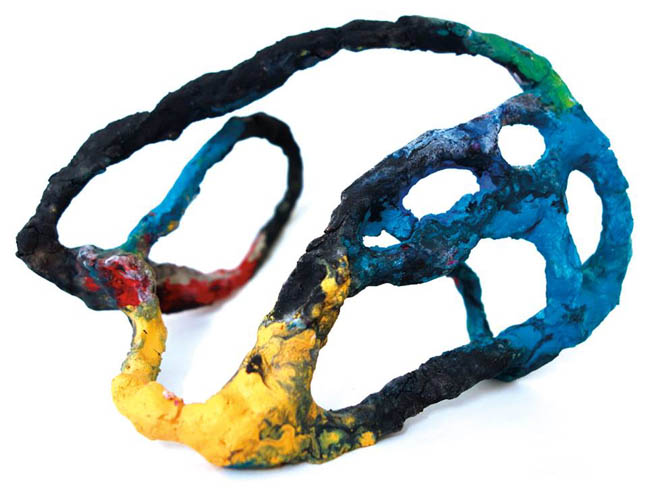 Portland is in the midst of another major sea-change in its gallery scene with the appearance of Upfor, Hap, Adams & Ollman and the reappearance of Soho veteran Jeffrey Thomas after a 20 year absence. Add Carl & Sloan to the list. As an artist run space it is different but in the past similar spaces like Tilt, Soundvision and Nil helped reseed what was happening here... though it is way up in North Portland. Their first show Testable Predictions, featuring Perry Doane, Michelle Liccardo and PORT's own award winning Amy Bernstein should be lively. These sorts of projects are labors of love... and perhaps naivete but let's remember that Dan Graham was the first to show Sol LeWitt and group shows for Donald Judd, Dan Flavin and Robert Smithson (Testable Predictions sounds like a Dan Graham Title BTW as it implies an empiricism). Testable Predictions | March 14 - April 12 Opening Reception: March 14, 6-10PM Carl & Sloan 8371 N Interstate #1 Posted by Jeff Jahn on March 14, 2015 at 13:40 | Comments (0) PermalinkThursday 03.12.15 Michael Graves Dies at 80 | Changed Portland 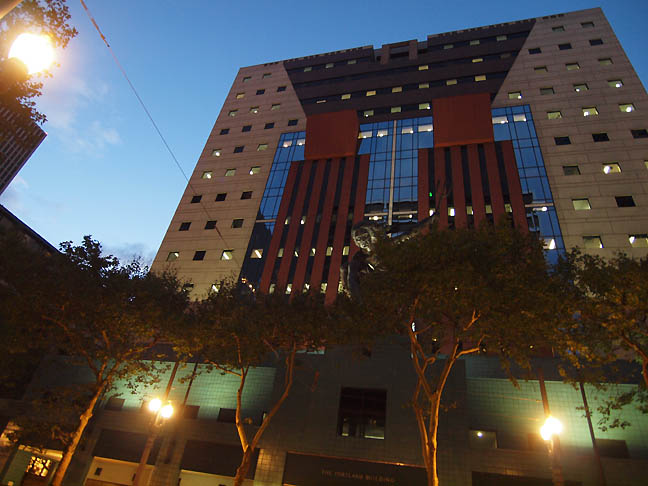 Portland Building (photo Jeff Jahn) Michael Graves has died at 80 years old today. I wrote about his complicated relationship with Portland and his career making Portland Building here. Suffice it to say he changed the city of Portland and influenced the world of architecture with that building and the effects will be felt as long as there are humans who study design. First and foremost Graves was an innovator in what he called, "Humanistic Design" and the Portland Building as designed was a way to relate big buildings back to the human scales and aspirations that make up a city...(more) Posted by Jeff Jahn on March 12, 2015 at 14:54 | Comments (0) PermalinkMonday 03.09.15 Monday Links Local artist is arrested for forging Mark Tobey paintings by the FBI. I'm interviewed and not really surprised as Tobey fakes have always surfaced. One should always go through a reputable dealer + check with the estate or authenticating authority before buying works. If it seems too good... it probably is. Authentication should never be rushed either, that's a red flag. What I am surprised about is how they never once mentioned how valuable Mark Tobey's authenticated works are? We did discuss it (along with a lot of other art historical background) so I suppose they will get the dollar signs in there eventually. As it is now it is kind of refreshing how they didn't make value the main thrust of the story. I mean he doesn't exactly look like someone who should have a trove of Northwest Mystic works to sell. The good news is you can go to the Portland Art Museum and see a real Mark Tobey on display. *Update: the alleged forger was released but it looks like he was forging an extensive # of Northwest Mystic works and has a history of this sort of activity. The question is did he have any conspirators beyond the FBI informant? The Guardian does a nice piece on Hans Ulrich Obrist, who is an innovative curator because he dares to generate his own discussion, taxonomies etc. through cultural activity... not simply an essay published as a show opens. What I like about HUO is he creates his own weather or at least hitches sails to winds that aren't always prevailing and lets them run a course. I also like the way in which he is one of the few curators today that openly admits that groups of artists who cull together themes and trends are ultimately more substantial than curators who gerrymander theme shows to fit their thesis. Last week, while people were distracted by Jerry Saltz being kicked of Facebook (he's back now) the gadfly critic published one of his best pieces ever on the New Museum's latest triennial. It is the way he gets the need for fresh new tangents in these shows and the way the internet doesn't exactly drive this trend... it enables it. A great and versatile tool for keeping things fresh and not pre-approved. As far as Facebook goes... Jerry is a gadfly, he tests the limits but mostly because those limits are so narrow and reactionary. Some critics strive to never offend but others make a point at getting to the tension of the age and yes Facebook and many other social media does quash dissent by avoiding anything that might seem offensive. You just cant please everyone... I love social media but that is its achilles heel. We understand each other through patiently exploring views different from our own... consensus can be even more stifling than loud dissent. Basquiat's notebooks, look... the original clickbait before the internet existed. Robert Storr on the hilarious and horrifying that is Guston. Posted by Jeff Jahn on March 09, 2015 at 22:41 | Comments (0) PermalinkMonday 03.02.15 Cynthia Lahti Bonnie Bronson Fellow 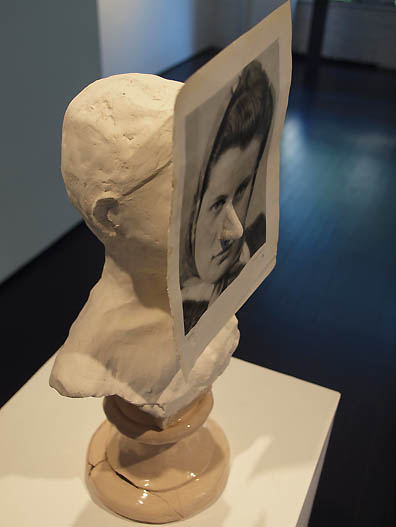
Cynthia Lahti, Frau (2012) photo Jeff Jahn Congratulations to Cynthia Lahti who was announced as the latest Bonnie Bronson Fellow today. Ever since a residency in Germany in 2012 the subseuent work that explores the frisson of photography and sculpture as a kind of visual/material dissonance has been intriguing... akin to surrealist collaboration between Alberto Giacometti and Man Ray... but definitely made by a woman. It has edge and she even has a new show that opens tomorrow at PDX Contemporary. The Bonnie Bronson award is different than most regional awards in that it primarily goes to mid career female artists (male academicians in traditional media tend to win most other major awards around here) and it is nice that this one is going to an artist who is making the best work of her career. Generally, the Bronson award goes to academics or someone who is extremely visible in the community but Portland needs to turn a corner and reward those who are doing not simply good work but that which has a keen edge and is the strongest of their career. True, some will complain that so many awards go to a small pool of the same artists (David Eckard unfairly was targeted for angst after... (more) Posted by Jeff Jahn on March 02, 2015 at 11:09 | Comments (0) PermalinkSaturday 02.28.15 Weekend Art Criticism Art criticism is becoming rarer and rarer because most outlets dont take the time to develop space and expectations for strong critical voices. PORT turns 10 June 1 and we have always taken the long view as well as the immediate taking both with a grain of salt. What little visual arts writing there is tends to be aimed at ingratiation rather than evaluation.
Roberta Smith reviews Louise Nevelson... it means something more because the NY Times has critics like Smith. Instead of merely announcing the show she givesa sense of where Nevelson has stood and why. If it weren't coming from a critic with experience it would sound catty but in actuality it reveals how popular attitudes change... critics cboth surf those waves and disrupt them. Daily Serving and Arts Practical are merging with CCA. I have mixed feelings about the need for art writing and criticism remaining independent of large art institutions though at the same time large universities have hosted print journals for years... is it just an internet SEO grab or just another academic writing puppy mill? That said it is certainly very difficult to... (more) Posted by Jeff Jahn on February 28, 2015 at 11:38 | Comments (0) PermalinkTuesday 02.24.15 Tuesday curatorial links David Salle discusses the much disliked The Forever Now at MoMA. He is right that forever and now are two terrible words in show titles but I still feel that much of the ire stems from the use of "Atemporal". Look, painters are always loosely using the history of painting in paintings... it isn't new and it isn't special to now. The Great drummer Buddy Rich said it best, "everyone borrows, the great ones steal." Of the whole lot I think Mark Grotjahn has something going on as do Mehretu and Sillman (where is Tomma Abts?).... many of the others, not so much.
Reports for the New Museum's under 35 triennial are filtering in here and there. These massive group shows are almost always inherently disappointing but the focus on non commodity zeitgeist art makes sense. Unless you can take viewers a little off balance, instead of what they are familiar/comfortable with they fail. Art isn't for understanding what you know, it is for experiencing aspects of what you hadn't considered. Though it is true that the way things are installed become even more important... a digitally connected world makes everything available instantly so the way art venues present things thoughtfully has become an ever more valued respite. I call it, "a considered zone," where art is given the space and context to contrast with the way we usually take in information and experiences. Having a guest curator makes it fresh but it also makes it hard to install well or feel like some internet feed but I think the New Museum got something right here, a sense of discovery. OPB spoke to 4 of the many voices in regards to the Portland Art Museum's next Modern and Contemporary Curator. The real trick will be finding .... (more) Posted by Jeff Jahn on February 24, 2015 at 11:22 | Comments (0) PermalinkFriday 02.13.15 Friday Links
Christopher Knight on low tech frottage art at the Hammer.
Lucy Lippard's advice for arts writers. I think being a true critic is important though... Anish Kapoor's black whirlpool is interesting though I dont like the railing. Posted by Jeff Jahn on February 13, 2015 at 14:15 | Comments (0) PermalinkMonday 02.09.15 Monday Links Artcritical does an critic's roundtable on the much maligned The Forever Now painting exhibition at MoMA. Generally I think it is the lack of these sorts of polymorphous discussions amongst critics that has been keeping galleries and curators from doing more interesting current painting shows. The thing with painting is it dies when it accepts too many congratulatory platitudes. Abstract paining needs to be contested territory... not a safe haven that seeks to insulate itself from dissent.
The New Museum's 2015 Triennial looks like a winner already featuring the kind of challenging asymmetrically strategic work I've championed since I moved to Portland. It looks better than any major survey (even regional ones) that I've seen in a decade+. I still dislike the idea of post internet (or post anything for that matter, because it packages the idea before it is explored) but the sense of an entropic digital universe that reveals the darker aspects of the real world is fantastic. What is important is the way it approaches the unease of the age... something everyone from Manet to Pollock and Hirst then Forcefield have done. The lack of abstract painting seems to be blowback against zombie formalism and the market in particular. Basically, artists who make work that jams the prevailing version of reality create space for the viewers to develop different angle of contemplation. That is what art is supposed to do, not simply flatter the rich or perpetuate an obstruse career. I was wondering when an artist would really take on the Cosby scandal... it is very interesting that it is being done by a High School student... but man, you just can't unsee this once you see it. It is also interesting how it immediately went viral last week then an exhibition was announced. Not surprising, just interesting. Though many find cellphone photographers an annoyance at museums I embrace the idea. It is a great way for people to internalize and personalize their experience with art but the selfie stick does constitute a danger to the art. Posted by Jeff Jahn on February 09, 2015 at 10:32 | Comments (0) PermalinkTuesday 02.03.15 Portland Building to be fixed  Portland Building (photo Jeff Jahn) The Oregonian is reporting that the infamous and historically very important Portland Building is to be renovated instead of torn down. Now 100 million dollars might seem like a high price but it achieves two important objectives. First and most obviously, it improves a building whose interior is mostly terrible to work in... thereby correcting mistakes that were mostly the City of Portland's own fault, not the architect's as Brian Libby has detailed. Second, it is the most famous important bit of architecture in the Pacific Northwest, the first major Postmodern building. You might not like it but as a an arts and design city Portland simply cannot condone destroying what constitutes an important moment in world history. ... (more) Posted by Jeff Jahn on February 03, 2015 at 13:04 | Comments (0) PermalinkMonday 02.02.15 Monday Links The big art news to start off the week is the attribution of two bronzes to Michelangelo. It's a good old fashioned art historical detective story of works that have been hidden in plain sight. These are the only surviving bronzes that have been attributed to the artist and Jonathan Jones discusses the mechanisms that are bringing such discoveries to light.
Another fascinating read is Holland Carter on Ellsworth Kelly and Claude Monet. Honestly, I've always considered these two as kindred spirits because both used an empirical process of seeing. Monet painted haystacks repeatedly in varying light conditions and Kelly is hugely influenced by John James Audubon's observational process of approaching nature in the field. Both artist processed this empiricism with aesthetics to distill the presence of the phenomenon they observed. Or to make an ever simpler statement both artists left the studio to find the source material for their art. Posted by Jeff Jahn on February 02, 2015 at 12:58 | Comments (0) PermalinkWednesday 01.28.15 Jeffrey Thomas Is Baaack 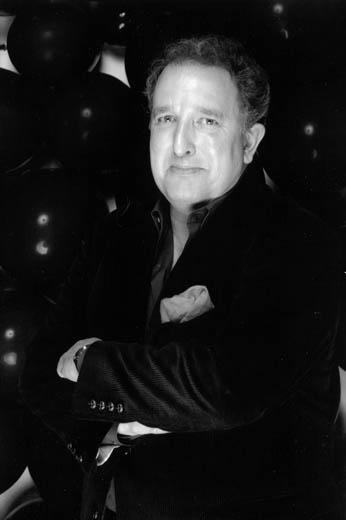
To keep it brief, former Soho gallerist Jeffrey Thomas returns to the art business with a new gallery model in the form of Jeffrey Thomas Fine Art in NW Portland. (the website is still beta but has plenty of info) So you say that you don't know who Jeffrey is? ...well this link covers a lot of it. First show in 2 weeks. Just check out the site, there is a reason we never interview gallerists on PORT, besides I've been behind the scenes on this. Posted by Jeff Jahn on January 28, 2015 at 1:31 | Comments (0) PermalinkMonday 01.26.15 Monday Links The effort to find a good home for the Lovejoy Columns continues. We've covered this before and it is important to preserve these famous artworks that art part of the Pearl District's once quite gritty past. We can build new things but the grit also gives us a sense of how time has passed and we cant simply just manufacture such history. It is also important as it shows how the Pearl district started out as a an artist's stomping grounds.
Portlandia takes on "shock art"... yes it really has come to that point and hopefully we can avoid more doll part art. Cornelia Parker is one of my favorite contemporary artists and this article on her process is definitely worth reading. What I like about her is the way her brand of inquisitive causality parallels scientific inquiry, without aping it. Is the current art market bubble driven by money laundering and tax evasion schemes? The advice to look to museums isn't the safest bet either... but the museums have to have programmatic integrity and with the diminishing of the crucial curatorial role there is a house of cards situation at play here. The solution... collect for personal enlightenment, museums should have programmatic integrity. All of which is easier said than done. Posted by Jeff Jahn on January 26, 2015 at 10:19 | Comments (0) PermalinkFriday 01.23.15 Friday Links Brian Libby takes a look at the still not fully complete Schnitzer Center for Arty and Design, PNCA's new base of operations. The opening is just a couple of weeks away.
The Prada Foundations new exhibition spaces, designed by Rem Koolhaas will display contemporary art and antiquities together. Not a new idea but considering that Prada is a tastemaker it is the details that will be worth paying attention to. Glass is the art world's "buzziest new matereial?" Yes since like 2008! Or 1908? Though I think this exhibition hit the nail on the head better, it was about glass and glass-like materials... not simply glass. The Guardian asks if art can still shock? As a Baudelairean advocate... yes of course it can. The difference is the way we process and discuss "shock" now. Look at Amy's Review of The Enclave or this interesting show full of decapitations. The problem isn't the art... its viewers who cant distinguish between empathy and sympathy which this essay discusses. Empathy involves understanding, sympathy is cheaper and more knee jerk. Sympathy doesn't last, empathy changes you and THAT is where lasting shock/changes comes from. Shock comes from understanding things from a viewpoint that you haven't considered... it is very possible but in a world that where the feedback loop caters to your already identified interests it is harder to achieve. It is why Great Art is important. It places different and inexhaustible demands upon your comprehension. Posted by Jeff Jahn on January 23, 2015 at 10:46 | Comments (0) PermalinkSaturday 01.17.15 Weekend Reads Artists may soon have their use of drones regulated.
There is a lot of talk about Portland's soon to be replaced airport carpet, here is a refresher course on the history behind airport carpets and their aesthetic crimes. ...(more) Posted by Jeff Jahn on January 17, 2015 at 12:46 | Comments (0) PermalinkSaturday 01.10.15 Weekend Required Reading Here are two articles that seem to be calling for a greater degree of critical thinking and more nuanced language in society at large. I don't think the current lack of critical thought in the art world is some outlier... it is an endemic issue for a globalized world that needs to learn how appreciate the inevitable disagreements that competing value systems inevitably create. New or at least completely recalibrated models seem inevitable. Perhaps something more supple and open to nonconformity?
First is Jerry Saltz on the power of images to in incite a disproportionate response from terrorists. Jerry looks into belief systems as are espoused by religions but I think the discussion can go deeper. In a world where everyone is so connected we can devolve into cliques of group-think more easily. We can instantly find those who agree with our views and this can fester in isolation cells, which create disproportionate or non-scalar and circuitous thinking. Maybe its my Viking heritage or love of Greek and Jewish debate traditions but when someone disagrees with you publicly it is a gift. If it has some strength behind it and you are suddenly seeing red it means you've just encountered "another way" that should be considered. It takes a kind of cosmopolitan approach, which is tolerant of diverse thinking. In that way Art is an important cultural exercise or a way to agree to disagree. Often this comes in an environment of respect (gallery) and maybe even an understanding can come of it. In general, respect comes from acts of critical thinking. Dogmatists who have those knee jerk, "you insulted what I worship & there will be reprisals"... can be found everywhere, even in art scenes but criticism is a way to be tested and grow. In the past few years I've seen a call for the rare kind "supple" avenues of respect that more criticism creates. It isn't taught very much in schools anymore and most curatorial initiatives have devolved into evasive curatorial speak and practices. Those programs that risk misunderstandings in a thoughtful way are all the more important for this. The second is this article on important female artists who are discovered late in their careers. I agree that there needs to be a different historical/critical discussion. Many excellent artists who... (more) Posted by Jeff Jahn on January 10, 2015 at 12:27 | Comments (0) PermalinkThursday 01.08.15 Cris Moss to White Box 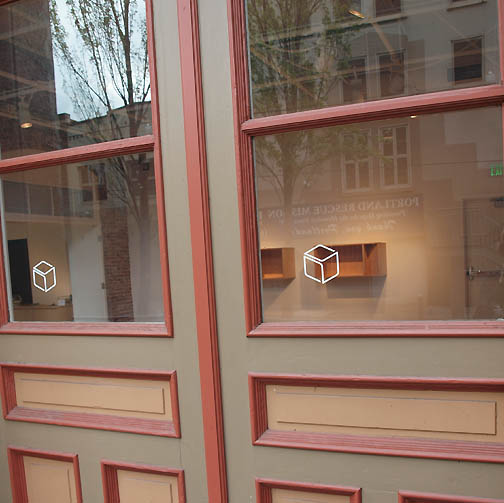
Today it was announced that longtime Linfield curator Cris Moss will be moving to downtown Portland, programming the White Box exhibition space for the University of Oregon. Cris has consistently made Linfield perhaps the most challenging univerity art space over the past decade. Shows like Suzanne Opton, Peter Campus and Wafaa Bilal certainly set the curve and were always well executed. Likewise the U of O has always been in need of a coherent exhibition program, Cris (a friend) will achieve that aim I'm sure. He wouldn't have moved unless it were an opportunity where he was set to kick things up a notch. The move also signals how institutionally the Portland area is formalizing its commitment to contemporary art. Congrats, the young curators who revolutionized Portland's art scene in group warehouse shows 15 years ago are driving things these days. Posted by Jeff Jahn on January 08, 2015 at 13:15 | Comments (0) PermalinkMonday 12.29.14 Top Posts of 2014 Time to start our string of end of the year posts, so here are our top 10 in terms of eyeballs (PORT is still the top ranked Google search for "Portland Art" and has already broken last year's record of 1.3 million unique viewers). It was an odd year where art history seemed to be on everyone's lips... almost as a balm against the market's corrosive effect on critical thinking.
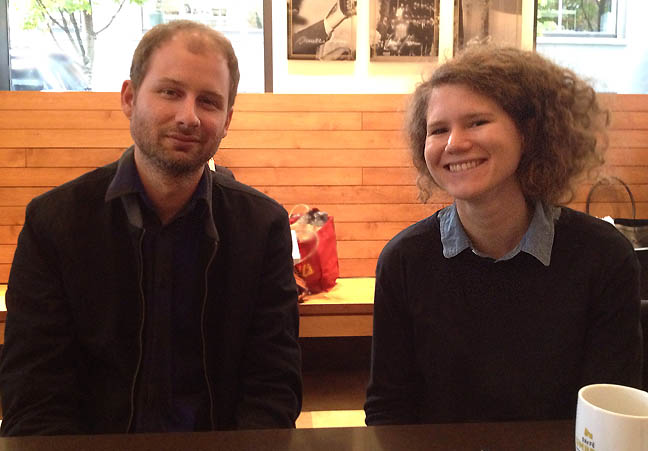 Ryan Johnson and Dana Schutz (photo Victor Maldonado) Dana Schutz and Ryan Johnson spoke to Victor at length about Portland and the odd ways their subjects find them. A must for any working artist to read. It surprised me just how much people allover the globe LOVED this interview with Michael Lazarus... which reminds me I haven't seen him since last summer. Three Chants Modern at PICA was perhaps the most complicated art historical project Portland saw in 2014 and this review strove for a similar sense of scope. PICA took quite a risk showing this as Portland's audience and press (in particular) aren't always the most versed in art history. Perhaps that is why I loved this show? Nice to see this being so widely read. Amy spoke with Luc Tuymans on the occasion of his exhibition at PNCA. Portland's art scene is constantly attracting new artists and churning out new alternative spaces where artists refine their game... sometimes before hitting the international stage so it is important that we pay attention (that takes someone who is always looking coupled with the desire to dig for the newly sprouted the way PORT does). These posts are incredibly popular and at the same time create a tremendous amount of whining. ... (there are 6 more after the jump) Posted by Jeff Jahn on December 29, 2014 at 10:07 | Comments (0) PermalinkTuesday 12.23.14 Xmas tide overs It is just about time for our annual year end wrap ups (2013's was very popular), the Guenther era digestion and some other pieces the team have been working on. Till then here are some things to tide you over:
I love this interactive Map of New York's art history. Maybe I should do something similar for the last 15 years in Portland... perhaps the most culturally dynamic period in the city's history. This death of painting 2014 discussion is mostly interesting for its focus on "Atemporal". It doesn't surprise me... it is very similar to the "new economy" talk that preceded the dotcom bubble crash in 2000. The only argument more tired and wrongheaded than the death of painting argument is the death of history argument. It is a pangloss and perhaps the exhibition is a kind of institutional extinction burst that behavioral psychologists describe in experiments that are an awful lot like market bubbles. Here is a very interesting article on the Centennial Mills building at the north end of the Pearl District. What really gets my attention about this project is the way Frank Gehry and Maya Lin are name checked and Jordan Schnitzer states, "We're not going to do this project unless it is right." (Disclosure the Jordan Schnitzer Family Foundation is a PORT sponsor) This is a corner that Portland needs to turn since growth/density is inevitable but the quality of those spaces aspire to wont rise without vision. Also, Gehry is no stranger to these sorts of reuse projects like the much larger Atlantic Yards but it is also all about keeping the historical record visible as a variegated urban edifice of human use. For example, think about Venice and the way it is built upon itself. Saving the Centennial Mills preserves the stories of a part of town that has already lost most of its history. Still, someone like Gehry signals some promise of progressive thinking about this very visible bit of Portland's waterfront... besides the East Bank Esplanade and the new transit bridge Portland has mostly ignored the Willamette river. The trick will be to keep the convivial Portland ethos and still pencil the project out. Posted by Jeff Jahn on December 23, 2014 at 10:35 | Comments (0) PermalinkThursday 12.18.14 Thursday Topics It's a slow time of year and I'm making my final "avalanche push" on the mountainous Guenther piece with several other interviews, a year end piece and reviews also already in the works. Here are some excellent posts to consider:
Brian Libby has done a great job covering this early part of Snohetta's James Beard Public Market design process. The egalitarian spirit seems to fit Portland... and it needs to because this is going to be a public space... perhaps the most significant one to be designed in the Northwest since Seattle's Olympic Sculpture Park. Hopefully the mandated public art will be of similar caliber as Jorge Pardo's streetcar stop on the other side of the river? Instead of just plonking down some moderately ingenious metal in front of the building the art should be a kind of brilliant amenity (a Portland sentiment). 8 museum directors choose their favorite art... fine idea but honestly why not ask curators? Perhaps because they are more specialized they would choose from their department? Police killings lead to a more overtly political art? Well, yes but I believe there is a deeper wave of discontent moving through the art world that comes from the real world. It put Obama in the White House with one word, Change. I feel like the Occupy Movement, police killings, continued violence/silence towards women and broadening income inequality are all just indicators of a tempestuous 2015. Art should be a part of the discussion not just an island floating on a buoyant market and games of certainty. These themes are so pervasive that Art can address them without losing its ability to speak to the ages. ...(more including the CNAA list analysis) Posted by Jeff Jahn on December 18, 2014 at 12:12 | Comments (0) PermalinkMonday 12.15.14 Monday Links Getting to know the artists that make other artist's work.
The 2014 year end best of lists have started here in the New York Times. Yes to Robert Gober, but somehow no Hockey and Matisse cutouts because they originated outside NYC venues. (I always like to wait with PORT's lists). The Guggenheim and other museums are set to start "big data" gathering on you as you move around the museum. Posted by Jeff Jahn on December 15, 2014 at 16:00 | Comments (0) PermalinkFriday 12.12.14 El Greco at PAM 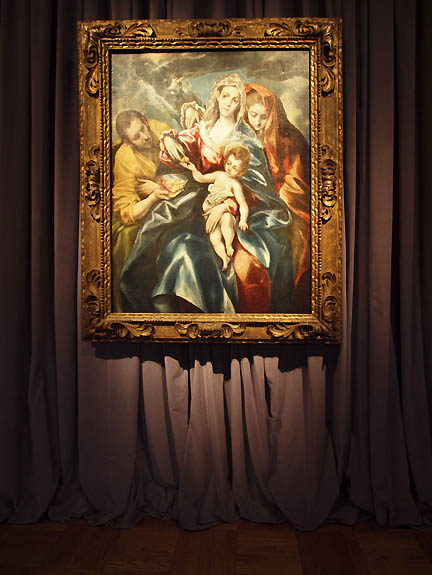
On view at PAM, El Greco, The Holy Family with Saint Mary Magdalen, 1590-1595, oil on canvas, The Cleveland Museum of Art, Gift of Friends of the Cleveland Museum of Art in memory of J.H. Wade (all photos Jeff Jahn) As the latest of the Portland Art Museum's very successful Masterworks series, El Greco's The Holy Family with Saint Mary Magdalen, is now on display a few days early. It is difficult to stylistically pigeon hole the Spanish Baroque painter El Greco (Domenikos Theotokopoulos) but his incredibly stylized elongations of the human body connect him to Italian Mannerists though his explosively empathetic compositions even remind me a little of the Carracci school (Ludovico in particular). Still, perhaps only the later Rembrandt can be considered his rival for supernatural presence and curator Dawson Carr has done a great job in bringing this truly stunning painting to Portland on loan from the Cleveland Museum of Art. Religious or not, it is a must for all lovers of painting and is nothing short of remarkable as all of these Masterwork Series works have been. Born Crete in 1541... (more) Posted by Jeff Jahn on December 12, 2014 at 14:30 | Comments (0) PermalinkThursday 12.11.14 Precipice Fund II 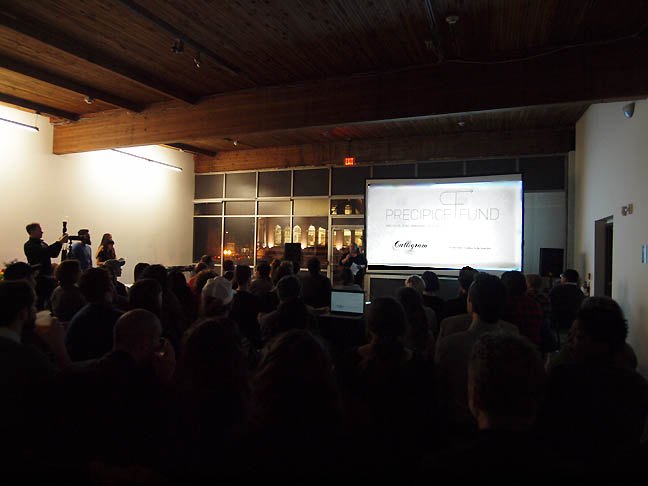 Just some of the crowd at the PICA's Precipice Fund announcements Now in its second year The Precipice Fund was designed to foster the otherwise difficult to fund projects and alternative spaces that have become a major hallmark of Portland's very active art scene through a regranting program administered by PICA. Overall, it is good to see so many in round II that PORT have pointed out in our previous 3 New Faces segments here, here, and here. 19 artist/collaborations/spaces will receive a share of $75,000. What is incredibly valuable is the way it funds somewhat unproven/experimental projects that broaden the programming scope of projects that in most cases would have taken place even without this aid. This is all very important as it is essentially an exploratory progressive grant rather than one that is backloaded on previous history (though progressive Portlands funding sources tend to be safer rather than risk taking). Congratulations everyone. Here's the list as described by PICA:: ... (the list and more) Posted by Jeff Jahn on December 11, 2014 at 19:26 | Comments (0) PermalinkMonday 12.08.14 Monday Links I and other PORTsters are still working on half a dozen major pieces for you (I know, Guenther its coming... it is very close and it is some of my best work but I want it to be done right and we covered so many of his shows that PORT constitutes an important archive of his tenure). Till then:
I just Love this story about a dieing Japanese town where a woman has made scarecrows to repopulate it. The Art Newspaper reports that curators really don't discover new artists at the fairs. I've found this to be true, the art fair experience generally doesn't provide enough information. Though I did find Hank Willis Thomas' video work at a fair before he became big (video work that needs just a screen or two does work). Here's the best and most comprehensive collection of Miami art fair images. Yes the Greeks are incensed about disputed pieces of the Parthenon being lent to Russia. Posted by Jeff Jahn on December 08, 2014 at 12:31 | Comments (0) PermalinkFriday 12.05.14 Friday Links Read this fascinating review of the Pierre Huyghe retrospective at LACMA. It makes sense that cacophony would improve rather than detract from the experience. Some artists thrive on cognitive dissonance and Huyghe who showed at PAM in 2006 is definitely one of them.
If you are curious about the cacophony of Art Basel Miami Beach this ridiculous article and these images are good surveys. This year with rioting in the streets and an art market that seems less calibrated to reality than profits it seems intellectually irresponsible to expect Miami to be a true bellwether or leading indicator these days. Seems like everyone is expecting more from the art world in 2015 already. Stunt performances jumped the shark a while back, can we be less vapid now? Portland architect James Harrison gets a little love from Architizer for his Land Yacht project. It has a Olafur Eliasson meets conestoga wagon aspect to it. Philippe de Montebello former Director of the Met answers questions... including if Museums are really the best place to view art? Eligin Marbles to be lent to Russia? Wow... perhaps the most disputed artifacts on earth to be sent to a country that the rest of the world is trying to isolate and pressure into better behavior. The Greeks (or anyone paying attention to this tricky issue) cannot be happy with this. Many major museums seem to be tone deaf these days,. it isn't confidence building and loaning these disputed artifacts is akin to giving Bill Cosby an award while amidst very serious allegations. The Greeks understandably consider these pieces of the Parthenon to be a kind of cultural rape. More here. Posted by Jeff Jahn on December 05, 2014 at 9:20 | Comments (0) PermalinkMonday 11.24.14 Monday Links It is Thanksgiving week and we will have that big Bruce Guenther piece (never has there been such anticipation for a post) and we will have several other things for you on this over stuffed holiday. Till then here are some links:
26 female artists on Lynda Benglis 40 years after her uproar raising Artforum ad. I called it earlier this year, 2014 has been the year of reassessing women in art but I'm pretty sure it will be just as important in 2015 and 2016. This issue isn't going away. Wired explores Facebook's corporate art collection... Side fact: not many know that Mark Zuckerberg has a home in Portland's Pearl District. ... (more) Posted by Jeff Jahn on November 24, 2014 at 11:35 | Comments (0) PermalinkMonday 11.17.14 Monday Links Jerry Saltz asks, "When did the art world become so conservative?" I was in NYC recently and noticed that the galleries on the whole have never been so toothless, formulaic and predictable. So why so conservative? Partly it is because art is being treated as "investment grade", which it has always been... just it used to be only for those very few who cared about art and ultimately there was a sense that the good was the enemy of the great. Today, as a market (like any other) good performance on all levels is generally preferred to the Great, which is a historical construct... (more)
Don Bacigalupi leaves Crystal Bridges for George Lucas' museum of narrative art in Chicago. Not surprising as State of the Art at Crystal bridges came off as a somewhat too narrative tour of art in the USA. Instead of picking the outliers that make art weird and difficult to pigeonhole it came off as critic Peter Plagens described as, "the worlds largest university faculty show," which I interpret as very easy to digest into narrative discourse. Mass MOCA takes on the Dia model (which is adapted from Donald Judd's Chinati model). Posted by Jeff Jahn on November 17, 2014 at 14:25 | Comments (0) PermalinkMonday 11.10.14 News Links We currently have 3 major interviews, two essays, reviews and my historical piece on Bruce Guenther in the works (all coming soon) till then here are a few links:
A young curator's button shop in NYC is just another example of the hybrid gallery model that has become popular in many places, including Portland. Big architecture news in Portland... the James Beard Public Market will be designed by Snohetta. With Kengo Kuma doing the Japanese Garden and PNCA set to open the 511 building by Brad Cloepfil architecture in Portland is getting increasingly serious. Any institution seeking to expand in the next 10 years has a very high bar to meet these days in Portland. World's biggest art collector dies at a rather young age of natural causes. An interesting article on Zumthor's blob (or not) design for LACMA. Clearly MoMA made mistakes though I can't agree with the article's assertion that the stakes are somehow higher in LA... they just aren't. Still, the idea that a new building should put the viewing experience above all else is a welcome breath of fresh air. Somehow I missed my friend Liz Obert's article in Slate (my excuse was I was traveling). Always nice to see an article on Portland that isn't some quirk-hype fluff piece. Portland is a busy cauldron of humanist ideals and Liz is stirring the pot. She will have an exhibition at Linfield soon. Posted by Jeff Jahn on November 10, 2014 at 12:07 | Comments (0) PermalinkFriday 11.07.14 Friday Links Eskenazi Gallery out-maneuvers the art fair at Frieze.. is there a paradigm shift in the works? I don't think it is an isolated event though I don't think it actually threatens the art fairs either.
Was Van Gogh shot? An article in Vanity Fair makes a stronger argument... As often with history that becomes legendary first the facts get muddled and conveniently shuffled towards an easy soundbite description of what happened. If true it would go some distance in de-tigmatizing the act of being an artist as a pathological condition with inevitably fatal consequences. For those interested in Van Gogh is creates a more complicated picture of the man and for that reason alone, even if proven untrue is worthwhile. Pompidou President wants a design and architecture space ASAP. In many ways this is where the applied arts mediate between museums comprised of traditional objects and the ever expanding education departments. All major museums are going in this direction if they are looking forward. OCAC and The Jordan Schnitzer Family Foundation (both PORT sponsors) explored a weekend retreat called The Art of Possibilities to explore how OCAC might expand "existing internal and external programs for K-12 age students in the area. It is something we want to keep an eye on as... (more) Posted by Jeff Jahn on November 07, 2014 at 10:13 | Comments (0) PermalinkMonday 11.03.14 Monday Links I'm back from NYC and I'll be posting images from the two people we had at Prospect 3 in New Orleans in the next few days (yes the Guenther post is still coming). Till then here are some links:
ArtFCity felt Prospect 3 had a weak curatorial compass. Roberta Smith on Chris Ofili's Night and Day. Jerry Saltz on the same show. Overall I found it inherently theatrical... which is something that most painters have a hard time achieving. 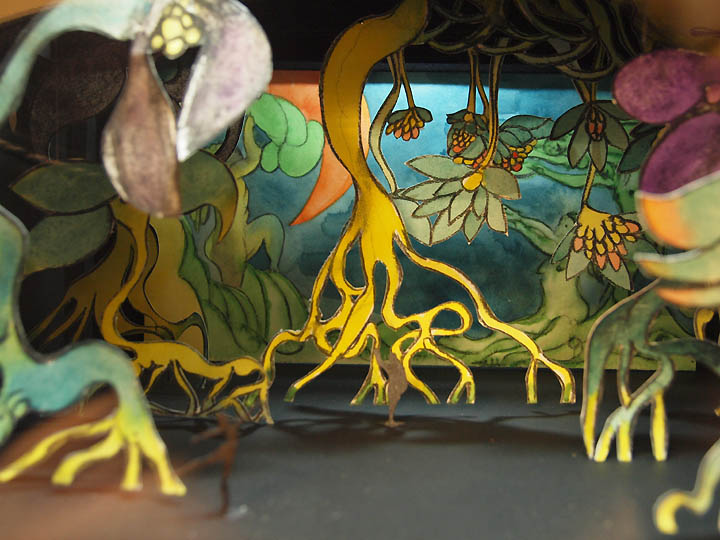 Chris Ofili, set design model at the New Museum Posted by Jeff Jahn on November 03, 2014 at 13:51 | Comments (0) PermalinkFriday 10.24.14 Friday Links The WSJ asks what if everyone is a curator? Obviously they aren't (a true curator isn't making one time choices, they consider a programmatic/object arc of meaning). I get into this issue in depth in my Bruce Guenther piece (which is coming...it is long) but the article raises the question of the type of institutions that don't have full time curators developing programming. In a way it makes the programmatic arc flexible but also schizophrenic, trite & flirty and therefore hard to fund long term. For example, Jeffrey Deitch is an excellent gallerist/gadfly but as a museum director his approach didn't work, creating massive backlash (the Fry is widely considered to be losing its reputation and MoMA is on the brink). Overall, I'm of the belief that museums need to own the long game yet do an occasionally porous event that challenges the typical museum authority. PAM does this with Shine A Light and New For The Wall events but not having a chief Curator would be a problem as The museum is really a 3 house system, the executive (fundraising), curatorial (collections and programming) and education (outreach).
Brian Libby with Michael Graves on keeping Portland's architecture wierd... and nothing is weirder than Graves' Portland Building. Amir Nikravan's accretion paintings reviewed. Richard Prince unintentionally gives a young artist a Chelsea debut. Jerry Saltz on Marina Abramovich... he gets it. The work is a tease and for some that is enough. Others, not so much. I loved her Great Wall piece but lately it is a bit too much like Downton Abbey to take seriously. Posted by Jeff Jahn on October 24, 2014 at 14:32 | Comments (0) PermalinkMonday 10.20.14 Monday Links Ok it is Bruce Guenther's last day at PAM and I'm finishing off my long piece on his career just as, "Elvis has left the building." It will be ready soon and its important to have it right because ity is very comprehensive and a good moment to think about where this leaves PAM both in terms of challenges and opportunities. Till then here are a few links:
Lots of stories on Jeff Koons including a documentary of a crucial career moment and vandalism. I truly doubt that he doesn't want people to see the film... just doesn't want to foreground it (silly press, Jeff Koons not want attention?). Europe's first carpenters. More art vandalism. It's never good for the specific installation but it does draw attention to the piece and artist... there's a fine line and should never be condoned, but stronger work survives and even gains more relevance through the indignity. Posted by Jeff Jahn on October 20, 2014 at 11:08 | Comments (0) PermalinkTuesday 10.14.14 Tuesday's complicated links We will have a review for you shortly and my in depth piece on Bruce Guenther will post on Saturday (the 20th is his last day and many of the most crucial aspects have not been discussed). Till then here are some links:
The uncontested works (?) from the Gurlitt trove will go to the Bern Kunstmuseum. It is a fact, museums walk an incredibly fine line between ennobling culture and the messy way that sausage gets made but the Gurlitt acquisition is perhaps the most tainted situation to come to light in the 21st century to date. Yes, it looks like Bern is being very cautious, but still... this promises to take another 50-100 years to sort out. Look, art fairs are not Ikea for millionaires. There are a lot of class warfare tinged sentiments out there at the moment but I think we need to separate the discussion of high priced masterworks from relatively unproven contemporary art and the living artists that create it. In general, many of the names you see bandied about right now wont be around in 5-10 years. That "other" work that already has been certified great is still great, despite the very impressive price tags. The worst case scenarios are when these great works leave the public view all together. They both have cultural value worth discussing beyond monetary value. That is what museums are for. ... (more) Posted by Jeff Jahn on October 14, 2014 at 14:29 | Comments (0) PermalinkTuesday 10.07.14 David Byrne gives up, sorta Today David Byrne published an essay on why he doesn't care about contemporary art anymore. Some may ask, David who? That is a good question but pretty much anyone age 30-60 knows he was once the bellwether of postmodern artyness and yes he made some music too.
I'm not going to comment so much on the content of the art he has lost interest in but to me it seems like it is a very community based critique (and anti-marketplace) of how much Art has lost its awkward struggle... (more) Posted by Jeff Jahn on October 07, 2014 at 11:05 | Comments (0) PermalinkSunday 10.05.14 Bluesky Birthday 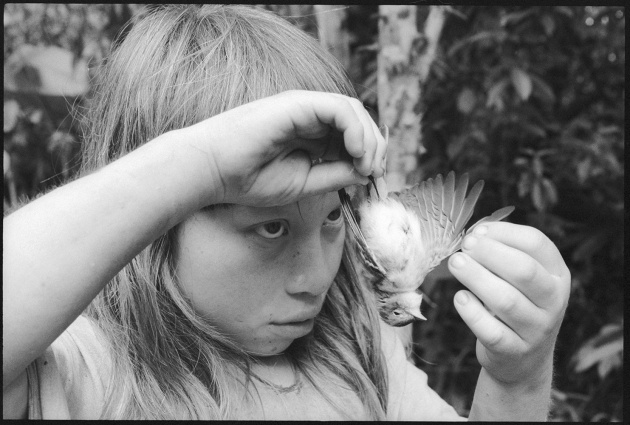 Carol Yarrow's Boy with bird, currently on display at Bluesky Today, Bluesky Galllery (AKA the Oregon Center For The Photographic Arts) turns 39 and will be celebrating with a 40 year show at the Portland Art museum later this month. Congratulations and let's look back at a few of the shows we have reviewed covered: F & D Carter's Wait and See this past Spring was an exciting tour de force of experimentation. Richard Barnes' Animal Logic showed photography's ability to crystallize concentrated contemplation. Torben Escerod's meditations on death and photography as a relic. Amy Stein's juxtaposition of animals in a developed American landscape. Robert Rauschenberg's final body of work debuted in their then newish home. Posted by Jeff Jahn on October 05, 2014 at 13:03 | Comments (0) PermalinkFriday 10.03.14 Friday Links Christopher Knight isn't convinced that Warhol's Shadows on display at MOCA are a top tier work, which is hardly a radical art historical position to take as Warhols late work is often derided. Then MOCA's Director Philippe Vergne took the controversial step of responding to the criticism. I tend to disagree with Knight on the importance of this particular work as it is a somewhat elemental late work that adds a new dimension to one's understanding of Warhol (maybe not top tier but provocatively near it). As for the Vergne responding to criticism publicly... those who are more old fashioned might not like it but we live in an era of fluid debate and response and Knight can certainly take it (that separates him from mere internet trolls). It is healthy and Knight's reputation is hardly at risk... a weak critic needs some protection, great ones survive, even grow ever stronger from having some pushback like this. Lastly, Vergne is European, they simply have a stronger tradition of pointed critique and I think it is an important step for the West Coast to publicly step out of the very passive aggressive cycle in discourse that we have been known for. Admittedly, I have a dog in this hunt. I cut my teeth with British art publications and that tone does threaten some other west coasters in the visual art scene. What it does do is cuts through all these false politeness that doesn't serve the work or ideas in question. Overall, I think the Warhol will fare just fine as will Knight and MOCA... So is the opiece in question a masterpiece or the birth of the zombie formalism that Jerry Saltz and others including myself have been railing against? The jury is out.
Indeed, all of these are deficient designs in Portland. Jerry Saltz on Robert Gober. Checkout this fascinating video on the conservation of Matisse's Swimming pool. I think it is right to treat the burlap as a support to be swapped out and not as a relic. Going back to the studio version is also provocative though a thornier issue. Do we present paintings the way they were stored in the studio? It is an interesting pickle. Posted by Jeff Jahn on October 03, 2014 at 11:19 | Comments (0) PermalinkThursday 10.02.14 First Thursday Picks October 2014 October is one of the power months in the Portland art scene... and we know it better than anyone else. Here are my picks
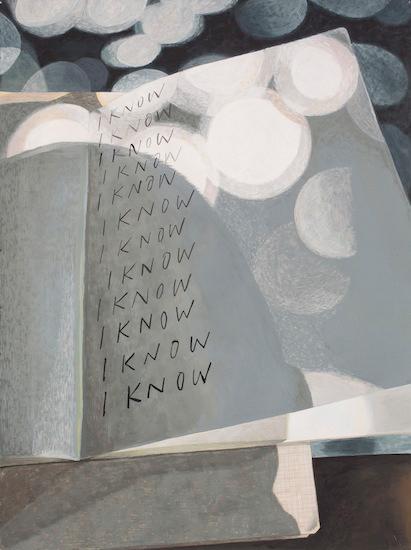 Habit Forming When Storm Tharp broke out in 2007, he established himself as one of the premier contemporary portraitists in the country but since then has been adding facets and layers to that reputation. For his latest show Tiger he doubles down on influences like David Hockney, Fairfield Porter's paintings, Donald Judd and numerous literary figures. Tiger | September 30 - November 1 PDX Contemporary 925 NW Flanders ... (more, Pugay and Unbecoming) Posted by Jeff Jahn on October 02, 2014 at 14:47 | Comments (0) PermalinkMonday 09.22.14 Monday Links We've got several in depth articles for you this week (critical essays and interviews) till then here are some links:
David Lynch's paintings and drawings tell a different kind of story... The whole Vivian Maier case keeps getting more and more complicated. This Jean Nouvel museum design for China is breathtaking... museums a are increasingly becoming gardens. A trend I support completely, PAM's recent Parisian park exhibition should be noted as a signal locally. Renegade art school all about painting... Locally, I feel like OCAC does this but in a less painting centric way. Christopher Knight describes how the Anderson collection signals the end of old school connoisseur based collecting for SF. I don't really buy that LA talking about SF thesis but the Anderson Collection is special. Posted by Jeff Jahn on September 22, 2014 at 10:45 | Comments (0) PermalinkFriday 09.19.14 Friday Links I'm just about finished with my history piece on Bruce Guenther, who is retiring next month, so far the best thing on him so far was by April at OPB, but I've got a great deal more historical context to add. This isn't just a staffing change at PAM it is an opportunity to examine Oregon's cultural history in an important way.
Finally the long awaited Robert Irwin piece/structure for the Chinati Foundation has been finalized. Looks like Irwin is inverting the structure turning the interior into an exterior with a courtyard and attention to windows. Verdicts on the Crystal Bridges State of the Art show are in and it is scathing despite praising the only Oregon artist in the show James Lavadour. Peter Plagens calls it in the WSJ, "the world's largest university faculty show". Overall I think it was a good idea but by blunting the edges and not including the more demanding eccentricities that make great art great the curators hamstrung themselves. That PG rating aspect is probably why no Portland artists are in it (Portland has a strong allergy to Walmart too). That said, our lone Oregon representative James Lavadour is a national treasure and we will have an interview soon. It is a common curatorial error in constructing large group shows in that by following the "process" so much it filters out the kind of work that challenges and sparks more meaningful debates. Posted by Jeff Jahn on September 19, 2014 at 10:27 | Comments (0) PermalinkTuesday 09.16.14 Tuesday links I've been traveling but will have a more personal, in depth and detailed look at Bruce Guenther's career (his retirement was the big news yesterday)... we've worked together, sometimes closely over the years so I've got a unique window on what he has meant and will continue mean to Portland's cultural scene (his current Joel Shapiro exhibition is classic classic Bruce). It is a crucial history. Till then here are a few links:
Artnet asks, is the art world sexist and biased? Absolutely. Tomorrow is ask a curator day on Twitter and PAM is participating, check out their schedule. Brian Libby's latest Dwell Magazine article on an affordable Portland home. No Google wont replace museums... but it will alter expectations and perhaps raise the knowledge base? Check out Anselm Kiefer's studio... Posted by Jeff Jahn on September 16, 2014 at 9:45 | Comments (0) PermalinkFriday 09.12.14 Friday Links We will be publishing another big interview Saturday morning but until then here area few links.
First of all, there is a high probability of Northern lights visible in Portland tonight. Jerry Saltz dives into the Lower East Side. It is TBA's opening weekend and since their visual art offerings always run the spectrum from good (sometimes great) to resoundingly meh (piles of things, or some writer... writing) I'm not gonna strongly suggest much till I see them (though Jennifer West and MSHR seem like good bets). Other things to see would be Dana Lynn Lewis at Lewis and Clark College and Victor Maldonado's talk at Froelick on September 13 11:00AM (his drone video is likely the best piece on view in Portland right now... it kinda deserves its own room). Bob and Roberta Smith invite artists to quit making art. The Brisbane Biennial with a focus on the sublime looks like it delivers. Posted by Jeff Jahn on September 12, 2014 at 14:57 | Comments (0) PermalinkThursday 09.11.14 Ralph Pugay wins Betty Bowen Award 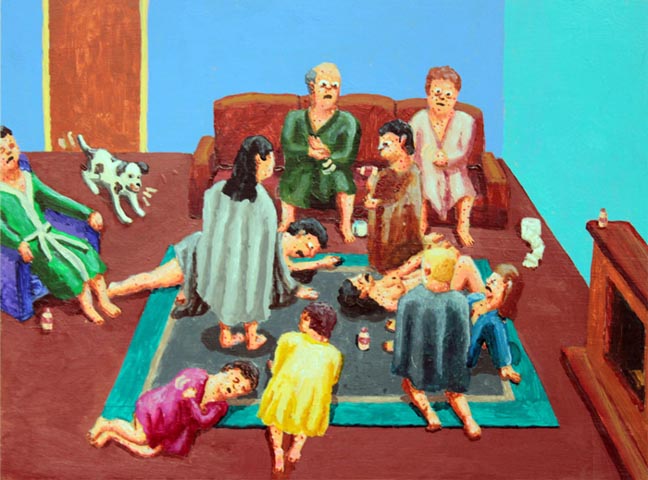 Ralph Pugay's Chicken Pox Orgy Congrats to Ralph Pugay for winning the Betty Bowen Award in Seattle. More important than the well deserved prize money (15k) it is heartening since most awards in the Northwest (especially Portland) go to artists that are late-midcareer (from before the change in say 1999-2000), mostly known as educators/community-minders and aren't terribly edgy. Yet it is an influx of such artists to the Portland scene... and are active nationally/internationally that has been instrumental in transforming the city from a sleepier backwater to an artistic hotbed. Back in 2012 Peter Plagens made note of Pugay during a survey visit. His edgy humor is kinda what people think about Portland (thanks to Portlandia)... a place where quirks seem to fester into full blown absurdity. Well deserved, if only all the other regional art awards had similarly sharp teeth and rewarded work that finds the edges. Posted by Jeff Jahn on September 11, 2014 at 13:58 | Comments (1) PermalinkMonday 09.08.14 Monday Links The final Art Vs. Reality involves art critics and though it is a bit rudimentary I think it is a useful series.
One thing I wish Peter Drew had fleshed out a lot more is the difference between simple opinion and higher levels of comparative connoissuership. For example, there is experience and when applied it can predict the difference between good, better and great work, because art doesn't exist in a vacuum ... though a lot of art schools and low-mid level dealers act like it does or want to treat everything with equivalence (it isn't). I discussed it a bit in this primer to an essay on art criticism I have been writing off and on, but it is crucial to note how not all art writing involves truly critical thinking and comparative discourse. Instead, it typically involves personal allegiances, which are not the same thing (rhetorically any time someone tries to make something personal it means they don't have an intellectual response and I take special joy in demolishing those bunkers of mendacity). On another front a lot of academic art writing would rather supplant the work and replace it with dialogical text, which I find careerist and designed to fluff CV's. Instead, real criticism purposefully acknowledges its diagnostic and separate role from the needs of the artist, presenting institution and genre. Instead, it tests the often presupposed effects and outcomes of the work as well as the overall value of those presuppositions, which always attend any work today. Social media is often a shouting match or a builder of group momentum, which does have its value. Whereas criticism is a long game and I don't see the two making each other less relevant. A strong critic that stands up to the group think and reveals the way it can really miss the boat is very valuable. There aren;t many such critics because there are few platforms these days. PORT is one of them. Yes, here is a map of a large part of the universe... I don't need to write anything more. If you aren't interested you can't be helped. Rauschenberg Foundation's artist as activist grants sound inspiring. Posted by Jeff Jahn on September 08, 2014 at 12:29 | Comments (0) PermalinkFriday 09.05.14 Supports/Surfaces links For at least the past 5 years many of today's would be painters/wall art practitioners have been basically raiding the playbooks written by Supports/Surfaces and Greenberg's Color Field painters (BTW Greenberg's personal collection is at the Portland Art Museum). Both were interested in the structure and delivery of medium, though Surfaces/Supports had a more political underpinnings. The clones tend to make work that looks like tarps or studio drop cloths or what Jerry Saltz described as Zombie Abstraction. The original stuff was way better and isn't about playing what I call the, "false humility of medium card."
Surfaces/Supports at Canada Lately, Surfaces/Supports have received a lot more attention including Yesterday's article in Art in America by Raphael Rubenstein and an earlier one by Hyperallergic. I'd like to see today's would be surface-supporters get a bit more ambitious because knowing the past, not just for its style... but its rigor should be on any painter's must research list. Posted by Jeff Jahn on September 05, 2014 at 11:33 | Comments (0) PermalinkFriday 08.29.14 Friday Links We will have not one but two interviews for you later this holiday weekend but till then here are a few links to keep you connected:
For the Folkstone Triennial one artist is burying gold bars on the local beach. It seems like such a natural stunt art piece for an 'ennial and the Robin Hood element is undeniable if potentially unseemly. Are Twitter and Tumbler feeds putting cultural sites in Syria at risk? A big reminder as to what "iconoclast" truly means. Onetime Portlander Miranda July starts an an Instant messaging service, and yes PICA is its node locally. Posted by Jeff Jahn on August 29, 2014 at 10:51 | Comments (0) PermalinkMonday 08.25.14 Monday Links We are still finishing up 3 different interviews at the moment but till then here are some links:
This Adrian Scheiss show should give painters and fans of painting something to chew on. Artists reconstructing architecture to reveal the Arab now. Interesting... German artists get their white flags back from atop the Brooklyn Bridge, revealing how TENSE Americans are and how RELAXED Germans seem to be comparatively. (what's with that?) File under, odd and not entirely compelling art that creates an interesting international incident. Some pretty bad historic building redevelopments in England (well the slug is ok)... token facade fetishing is one of the worst architectural sins. Posted by Jeff Jahn on August 25, 2014 at 10:07 | Comments (0) PermalinkThursday 08.21.14 Thursday links We are just polishing off a bunch of interviews (always very time intensive) but till then here are some links:
The birth of Impressionism tracked down to the minute? Hadid, Gehry, Libeskind etc. revealed in their early drawings. Public art in Sydney elicits a debate over originality... that's a good sign for Sydney. Overall, everything seems pretty standard and of the mildly engaging type that most public art aspires to today. Everything seems designed to make everyone feel like they understand it with no twists. That's why Pardo's streetcar stop in Portland is so good. It challenges the easier assumptions. Olafur Elliason creates a mini watershed in a museum. This is interesting but mostly for how weakened or like "public art" it seems. Much like the more famous Earth Room that the Dia commissioned it derives most of its charge from the cognitive dissonance of bringing the outdoors indoors and by reminding us that buildings are caves. Why Portland is building a new bridge without cars. As I saw early on (one of the first when others were in love with a more anachronistic design that pandered to many Portlanders' aversion to the new and bold) this bridge design makes sense and looks like a worthy icon for the city. See, things have changed. Posted by Jeff Jahn on August 21, 2014 at 11:06 | Comments (0) PermalinkTuesday 08.19.14 Revisiting Benjamin 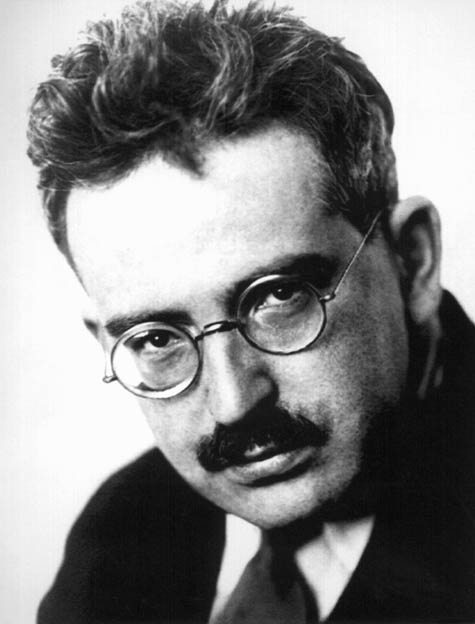
Walter Benjamin Walter Benjamin is the philosopher that usually appeals to art critics...at least the "real" ones who are actually interested in exploring through critiquing art. Thus, this clever piece in the Brooklyn Rail is definitely worth a read. I like the way academic consensus is lampooned. Consensus is overrated and perhaps the cult of personality that evolves around a philosopher is the worst kind of consensus. Perhaps the dispute, when it arises is the only thing worth exploring? Perhaps the presence of dispute is the only thing that keeps culture from getting stale? Posted by Jeff Jahn on August 19, 2014 at 10:40 | Comments (0) PermalinkFriday 08.15.14 Friday Links Saving Louis Kahn's masterpiece Salk Institute.
The birth of Indian Art? Im pretty sure there were predecessors but that doesn't diminish this crucial site. The Robert Rauschenberg Foundation is appealing the ruling that three of the former employees of the foundation did such an outstanding job that they should be paid $24,600,000 in fees for their services. Now that might be something akin to the golden parachute amounts most energy company executives can expect but it does seem excessive considering it is a non profit and charitable foundation. Portlander Christopher Rauschenberg seems to be reiterating the charitable aspect in press statements. Basically, it comes down to scale... the unreasonable corporate scale or the more reasonable non profit world scale. German artists want their white flags back. mmmkay... it doesn't really work that way. Posted by Jeff Jahn on August 15, 2014 at 19:02 | Comments (0) PermalinkMonday 08.11.14 Monday Links Gilbert and George share life lessons, surprise they care what Mom thinks...
Ben Davis' review of Christopher Williams' show at MoMA is a must read. About 5-6 years ago art that was mostly in code that was never meant to be understood was all the rage... and Davis explains why this show is the moment the trend has truly jumped the shark. In general, any visual art that leans hard on its title is in trouble. Kosuth, Weiner and Baldessari do it right by making the title kinda besides the point and redundant (ie. it isn't code or a secret handshake,that's just being clubby). In short it is too satisfied with itself and too cute by half. By comparison Duchamp seemed considerably less amused with himself... and instead implicated his part in the great art and life con, R. Mutt indeed. The Prado looks like it might lose Bosch's The Garden Of Earthly Delights. Sure, it is one of the most famous paintings in the world but it was on loan from the King of Spain, whom coincidentally will be completing his own museum shortly. I don't know what is lost by having more museums? The Prado has plenty of masterpieces already. HA proposes that Lygia Clark's work doesn't really mesh well with a crowded museum experience. It is true, some experiences demand a bit more space and less people to produce their full effect. Posted by Jeff Jahn on August 11, 2014 at 10:44 | Comments (0) PermalinkFriday 08.08.14 Friday Links I have to agree with the Guardian... what makes Touching The Art so good is the way it doesn't know what it is (Borat for the art world?). Others who have tried this often desperately want to be comedy, critique or performance art but where TTA wins is the way in which it has no wish fulfillment and simmers in its own conceited white box. Overall, it isn't how it remains fastidiously out of touch with its own agenda (it's there of course) but it is the awkward way the art world isn't asking better questions and just shrugs itself off that is funny.
Peter Schjeldahl on the popularity of art and museums today. Posted by Jeff Jahn on August 08, 2014 at 14:44 | Comments (0) PermalinkWednesday 08.06.14 Art radio on the internet There is always something awkward about talking about visual art on the radio that can be quite refreshing... I think of it as a double awkwardness that strips away some of the normal defensiveness one finds in the art world. Think of it this way, those who are very generous and genuine really shine through when it is just their voice. Recently two of the most genuine and generous artists in Oregon have been on the radio.
Yesterday Eva Lake completed her last regularly scheduled interview for KBOO's Art Focus with the generous and eloquent James Lavadour who has a show at PDX Contemporary this month. Last weekend PORT star Victor Maldonado guest curated OPB's State of Wonder (some of it concerning his residency at the Lavadour connected Crow Shadow project). Posted by Jeff Jahn on August 06, 2014 at 12:50 | Comments (0) PermalinkFriday 08.01.14 Friday Links The WSJ explains how the big auction houses find first time buyers for very expensive art. The fact that 25% of all auction sales went to 1st time buyers last year is incredible and why many seasoned vets avoid auctions (or at least say they do). The houses chum the waters with new blood, can't blame them really but it does explain why auctions are different than the galleries.
This letter to an artist includes some extremely practical advice... in particular this nugget, "There were a hundred people at my show last night and I knew everyone one of them by name." Being the truth teller I was I replied "That's too bad" and she was stunned and angry at me. She asked me why, and I replied "You can't depend on people you know to support your work indefinitely." Tracey Emin and the Tate will be shacking up for the next 10 years... I want to dislike Emin's work but in fact I'm a huge fan (she's the diva of diaristic art). I hope it goes well... Oregon City ups the ante... in terms of river redevelopment. Will it put Portland to shame or simply wake us up? Posted by Jeff Jahn on August 01, 2014 at 14:12 | Comments (0) PermalinkMonday 07.28.14 Monday Links We have some amazing interviews coming your way (we are 3 deep right now) but till then here are some links for your Monday:
Artist sues American Eagle for using his work without compensation. The International Space Station gets its first sculpture... made from meteorite. Is that the best they could do? How to be supportive of an artist? Well, definitely don't sugarcoat things and make decisions for long haul sustainability (living situations etc). Don't overreact. Don't assume anyone cares until they actually make it clear you have some kind of audience. European museums are straining under the crush of crowds... The new MoMA redesign seems to serve this crowd more than the art, which has everyone thinking some is definitely wrong in the state of Denmark. Posted by Jeff Jahn on July 28, 2014 at 11:44 | Comments (0) PermalinkWednesday 07.23.14 Public art in Portland winning awards RACC just announced that two pieces, Jorge Pardo's Streetcar Stop for Portland and Inversion +/- by Lead Pencil Studio were cited as two of 37 outstanding public arts projects completed in the United States in 2013.
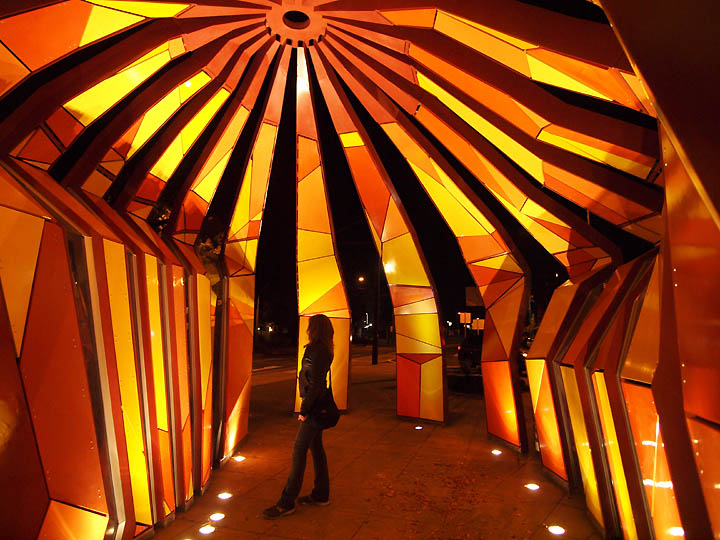 Streetcar Stop for Portland (detail inside at night) photo Jeff Jahn Both projects certainly were site considered works that went far beyond last year's Nepenthes travesty, also commissioned by RACC for its, "Quirkyness." I've been writing about it for a L O N G time but quirky just isn't good enough in Portland anymore (yes you too Art Beat) and as PORT's interview with Pardo explored last year... doing something excellent and successful is never an accident. Pardo's project is the most successfully ambitious public art project in RACC's history. Im more reserved about Inversion +/-. I feel like the ghost warehouse idea is... (more) Posted by Jeff Jahn on July 23, 2014 at 14:45 | Comments (0) PermalinkMonday 07.21.14 Monday Links The top art story this weekend had to be the Mana Contemporary project in New Jersey. In many ways it isn't dissimilar from what the Portland Art Museum did with the Francis Bacons and other works... only this project is an ultra ambitious approach to redeveloping lower valued real estate. PAM is just being a museum (borrowing important works and presenting them), whereas Mana is providing a storage option and creating a museum... which will then bolster real estate. I'm very surprised nobody has seen the potential in Portland as Oregon does not have sales tax (like New Jersey).
I'm not certain I buy this argument about Scotland remaining part of Great Britain as keeping it from being culturally cut off. But it is interesting that someone is forwarding the idea that nationalism = xenophobic regionalism. The Scots are a bright people with excellent arts... I cant see independence doing anything but make them try harder to assert themselves as presenter independent of England? US museums provide emergency support to curators in Syria in anticipation of a cultural cataclysm. Posted by Jeff Jahn on July 21, 2014 at 9:43 | Comments (0) PermalinkWednesday 07.16.14 Around the web James Lavadour will be in the upcoming State Of The Art survey, congrats... a great painter.
Don't be so shelf-ish? Haim Steinbach's takeover of the Menil looks like it is worth braving Summer in Houston. With so many artists making use of shelves and 1980's design for their work today it makes perfect sense to pay more attention to the 80's shelfmeister. Millennium Park is 10 years old now and what was once seen as wasteful has proven itself. I discussed it a bit with civic/landscape/art historian Mark Treib last year. It is very related to Portland of course ,which is a city of parks... but we haven't had the same grand intentions... which PAM's current Tuileries Garden show seems to be prompting a discussion of. It leaves us to ponder what would a showcase park devoted to great civics look like in Portland? Posted by Jeff Jahn on July 16, 2014 at 11:23 | Comments (0) PermalinkThursday 07.10.14 Thursday news Sad news On Kawara has died. It's the rigorous humor of his extremely dry work that set it apart but the addition of oxygen in his installations fascinated me the most... as a way to subtly influence the viewers conscious state.
LACMA is definitely throwing down a gauntlet for MoMA, which just doesn't seem to have its hierarchy of goals in the right order by comparison. How LA is it to have a museum that one window shops by driving by? They are also planning a similar residential tower. Portland Architecture looks at the pressures that threaten classic residential homes here. Posted by Jeff Jahn on July 10, 2014 at 19:03 | Comments (0) PermalinkMonday 07.07.14 Monday Links Painting is hard but Amy Sillman makes the challenges her subject matter. There is something about making an art historical standoff your own that points towards success in painting.
The perils of showing the photos that Garry Winogrand took but never selected. In his case since he wasn't a complete control freak I think this is ok, gone are the days when artists were expected to have no changes in their late career. All the shiny Jeff Koons reviews distilled into a poem... yes he's good and I like the work, but has he peaked during his own lifetime? Posted by Jeff Jahn on July 07, 2014 at 10:49 | Comments (0) PermalinkWednesday 07.02.14 Guggenheim heirs rebuffed 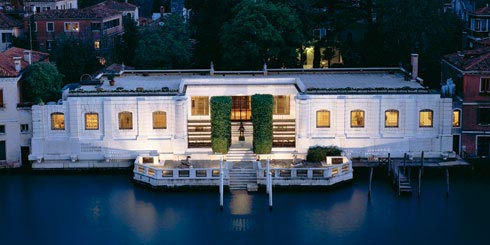 Guggenheim Palazzo in Venice The NYT's reports that the suit to have Peggy Guggenheim's Palazzo in Venice displays returned to a configuration she had them in during her lifetime has been rejected by a French court. This is interesting because the heirs do have a point, but it is all how the gift of the Palazzo to the Guggenheim Foundation was set up. Would Peggy want it to be a mausoleum to her collection and nothing else? ...I find that doubtful but the heirs have a point in that other patronage pandering seems to be seeping into the displays. The question is one of degrees of exclusivity and serves as a cautionary tale for those giving whole collections (and a building) to one institution. I believe the family's outrage comes from the intensive sometimes ham-fisted placement of other "living" patrons works but the foundation has a point... they are not required to keep it as a shrine. Hopefully a middle ground can be found, one where new works are rotated in on the merit of the conversation with Guggenheim's collection that their presence prompts. Posted by Jeff Jahn on July 02, 2014 at 17:02 | Comments (0) PermalinkMonday 06.30.14 Monday outrage links Ok it is Monday, time to get fired up over these stories (we have a ton of major articles coming your way very soon).
Hopi masks and other sacred objects were auctioned in France. Tracey Emin did an astonishing thing with her My Bed, turning her messy personal life into a diarhetoric art that so many artists today owe a great deal to. It is being auctioned. I really don't want to like Emin's art but I always rather like it... still I feel My Bed's mildly scandalous status tends to overshadow how good an artist she really is. Does the Mojave Desert need a swimming pool? Probably more than most places do... but it is still art looking a lot like redevelopment and encroachment. Posted by Jeff Jahn on June 30, 2014 at 0:25 | Comments (0) PermalinkFriday 06.27.14 Friday Links A study on the connections between art and food presentation, why is a Kandinsky knockoff salad tastier than something arranged with less thought put into it? My thoughts are is that it is about the visual exploration the sensing of subtle arrangements and shifts make us more observant in all of our sense when our visual ones are engaged. Of course food and art are a very big players in why Portland is Portland.
Activist museums... I think there is a place for this but it requires multifaceted viewpoints not simple propaganda. Percent for art programs have been having a tough road lately, but in Portland they have been doing sometimes great things. Posted by Jeff Jahn on June 27, 2014 at 16:24 | Comments (0) PermalinkMonday 06.23.14 Monday Links Ai Weiwei on incarceration and his Alcatraz show.
The Guardian on why digital art matters. Any article that mentions the ENIAC in the first sentence gets my attention. Art Basel... the one in Basel. Posted by Jeff Jahn on June 23, 2014 at 9:16 | Comments (0) PermalinkMonday 06.16.14 Monday Links Insanity in Miami as a board rejected director acts as director, mmmnokay...
When faking a Pollock, spelling still matters. Sooo Mark Rothko's mid period watercolors are important for the technical qualities he took with him to the later works... of course that means his even earlier watercolors (many of Portland) have a similar importance (expect to see a show on this). It may have a rather boring name but Portland's new bridge is turning out to be rather good. I like the Donald Macdonald designed bridge and I saw Rosales' earlier design as kind of a kiss up to the retro looking and somewhat conservative architectural tastes in Portland. I think this design better connects Mt Hood to the tree lined heights of the west hills by echoing their angularity. What can I say... I like edge and don't like it when architects pander to the conservative tastes of a city. Macdonald went the right way, you don't build a modern bridge to echo an antiquated design... you use the best technology of the present to create one that reflects the time it was created in. Posted by Jeff Jahn on June 16, 2014 at 0:28 | Comments (0) PermalinkWednesday 06.11.14 Links Former EssEff-er Modou Dieng suggests that all artists leave San Francisco and move to Portland. I also suggest a few patrons move as well. We do have many new patrons but they definitely lag far behind the # and level of artists working here.
What is keeping all the rats off of Kara Walker's sugar sculpture? Matt McCormick puts the Great Northwest online. Posted by Jeff Jahn on June 11, 2014 at 11:22 | Comments (0) PermalinkFriday 06.06.14 Friday Links The troubled Oregon Arts Commission has named Brian Rogers of Philadelphia as its new Director. On numerous occasions it has been mentioned that the OAC has transparency problems and to date they still have not explained why the previous director was asked to leave. I'm certain many journalists are going to be clamoring for an interview with him but frankly I am more curious as to whom he sits down with to get his bearings when he gets here. Overall, Oregon is shifting its expectations from that of numerous insular communities to that of a world wide player on the cultural front. This shift has made the Director position a lightning rod for everything that is both good and bad in the state. Frankly, we should expect innovative solutions, while honoring our history and be focused on merit (not cronyism) as Oregon exists in a competitive international marketplace for talent. We can improve and welcome to Oregon!
Hyperallergic on Richard Serra in Qatar. Restoration of a beach scene reveals... a whale. Posted by Jeff Jahn on June 06, 2014 at 12:11 | Comments (0) PermalinkThursday 05.29.14 2014 Hallie Ford Fellows The three Hallie Ford Fellows for 2014 have been announced, congrats. They are; Tannaz Farsi of Eugene, Storm Tharp and Geraldine Ondrizek of Portland.
True, these panel driven type award decisions are easy to criticize but they do give us an opportunity to provide a heuristic kind of feedback that is necessary, especially since all of these regional awards are so panel driven. On the plus side yes that's 2 women and one man, but it is also two academics and one non (Tharp), which is an underwhelming trend I have mentioned before as academicians tend to explain their work better than create something more original. Of the three only Tharp is a critical favorite (in fact he's one of the state's premier artists (would make everyone's top 10 list). It is good they are picking artists without gallery representation in Oregon (Farsi and Ondrizek) but that shouldn't = academicians like it has frequently. Oregon has a deeper scene than that... (more) Posted by Jeff Jahn on May 29, 2014 at 13:00 | Comments (0) PermalinkTuesday 05.27.14 Robert Adams Photographs to PAM 
Robert Adams, Kerstin, next to an old-growth stump, Coos County, Oregon 1999 Last year the Portland Art Museum mounted an exhibition of world renowned and Astoria based photographer Robert Adams. It was wonderful and bittersweet, partially because it is Robert Adams' work (which measures the pang inducing endurance of nature in position to man's destructive tendencies) but also because the work itself wasn't in the museum's collection. Today PAM officially announced that the 69 photographs would enter the collection. Bravo! Oregon has a bad habit of not celebrating its greatest artists but one by one, starting with Mark Rothko then Carrie Mae Weems and Robert Adams it has sought to rectify this studiued "disinterest" and start keeping score with home grown products who matters internationally. Besides, there is a sense of a humanist-activist-poet in Adams' work... even if they weren't photos of the Oregon Coast it would fit Portland's civic interests and ethos. Big props to collectors Bonnie Serkin and Will Emery, some anonymous donors and the Oregon Arts Commission who made this landmark acquisition happen. This is one for the ages and the cultural patrimony of every Oregonian from this point forward. Posted by Jeff Jahn on May 27, 2014 at 18:01 | Comments (0) PermalinkAdvising artists This fascinating and important article details how artists (the lifeblood of the art world) are systematically not compensated. The net effect is that it requires artists to be wealthy before they become artists... this tends to dampen the ambition in the work (Not always but usually). The situation is even worse in the USA which has far less public funding.
Richard Speer discusses some of the taboo topics at art openings. Odds are this describes most artists reading it... but I've found that it is incredibly hard to generalize. Instead, I've found that there are many who pursue these taboos with impunity. Generally they are artists who thrive on true feedback rather than sycophantic enabling. They also tend to move farther in their careers and tend to crave true feedback. Best rule... "never assume" because in the majority, those in the art world tend to want to believe what is emotionally true at the moment. Whereas, those that can see beyond that emotional smokescreen achieve rigor and tend to rise above. Lessson, never try to explain another person's beliefs... simply make your own so pervasive that over time it becomes clear what your intent is. Posted by Jeff Jahn on May 27, 2014 at 10:02 | Comments (0) PermalinkFriday 05.23.14 Friday Links PORT will have a fantastic and in depth interview with two major artists later today. To hold you over here are a few links:
Animated GIF's as a vibrant and ubiquitous art form. Disjecta has a new curator in residence, Rachel Adams from Austin Texas. Not surprisingly, this marks yet another female curator (they have all been women and I'll leave it at that) but it is interesting that she is doing a show about structure and has an interest in architecture. Portland has a very strong and well developed peerage of artists that use design and the built environment as a major component of their work. So much so that simply doing a show involving superstructures will require the kind of rigor that we generally don't see in group shows at that venue (the space is difficult and the revolving curator door means that about the time they figure out what works they are onto a new face). Then there is the other issue where many of those artists have already shown there(ie how to do something relevant and fresh when most of those artists are already showing outside of Portland and or are concentrating on solo shows). OCMA, responsible for the recent California-Pacific Triennial that completely ignored Portland (it is kinda nice that someone is doing it) gets a new director. Posted by Jeff Jahn on May 23, 2014 at 12:04 | Comments (0) PermalinkMonday 05.19.14 Monday Links A fascinating New York Times article on the rehang of the Warhol Museum. True, no museum can hope to recreate the manic "scene days" of the factory or holding court at Studio 54 but it should deepen our understanding of a great artist in both his stronger and weaker moments.
The BBC is launching a three part series on Women in art, catch episode one here. Even in Portland men still seem to get a majority of the presentation/representation space and awards. The Met could be getting a new modern art wing to replace the current and (ughhhh) carpeted ones. With MoMA lagging and the Whitney re-imagining itself (also a necessity) the Met might find itself making all the right moves if it takes this opportunity to not do what MoMA is doing. Posted by Jeff Jahn on May 19, 2014 at 0:14 | Comments (0) PermalinkWednesday 05.14.14 The fascination with finding A very significant Lynda Benglis that has been hiding in a sewage treatment plant might see the light of day in public display again soon. The piece in question, The Wave (the wave of the world) was originally created for the 1984 world's fair.
We are still tracking the Crystal Bridges State of the Art project... here's a little info on how they found those 10,000 artists. They visited about 10 artists in Portland last summer. The research logistics of this kind of approach alone are daunting. Also, after the apparent punt that was this year's Whitney Biennial many are wondering if this will be yet another show that uses artists to create an intentionally indecipherable spectacle designed to serve the institution and not much else?... or a real digestion of what is going on in art in a way that isn't a rigged marketing exercise? What people hunger for is a show that has a kind of integrity to it, willing to both make mistakes and uncover things that truly rise above the fray and reveal our world in a way we hadn't taken fuller stock of. A show where the artist's work is allowed to clear its throat. It is very rare these days when it is often easier to just pack redundant ideas together so that everything is just a simple exercise in comparative degrees (edging out more idiomatic developments). I much prefer shows like the 2001 and 2004 Site Santa Fe biennials, which had strong clusters of work that posited very different ideas/work in stark relief around central themes. Fetishing genre over case by case content (or worse careerist connection mongering regardless of the critical issues of the day) is the death of a thousand small cuts that most group shows today suffer from these days. One thing is certain, a lot is at stake for this well endowed institution. The critical response to the show will define the museum's success as a national player... nice to see an institution risking this much. The truly great Richard Tuttle on exploring life in art. Posted by Jeff Jahn on May 14, 2014 at 10:50 | Comments (0) PermalinkFriday 05.09.14 Friday Links I really like this anti-object bench project, which is designed to nullify any creative uses other than being a bench. I liken it to a prophylactic design ethos that takes all the fun and accretive uses out of an object? No wonder it looks sooo uninviting! It might have interesting applications in art. Sometimes NO is the most creative move a designer or artist can play.
Frieze's New York Art fair as seen through the Guardian and the New York Times. Phase three of Pacific Standard Time will focus on Latino contributions. The Whitney Biennial through the artist's eyes... though curator Stuart Comer's, "non-hierarchical multiplicity," comes off more as utopian wishful thinking and curator speak than anything observed in reality. Posted by Jeff Jahn on May 09, 2014 at 13:52 | Comments (0) PermalinkMonday 05.05.14 Monday Links Last weekend tour of art in Berlin... post sexy?
My old stomping grounds, the excellent Milwaukee Art Museum is proposing a modest addition but The Journal has a convoluted response itself to the proposal. The museum on Lake Michigan is a wonderful site and suggesting that change is backwards thinking. Also, the museum isn't that convoluted and I'd describe it as variety. The Calatrava wing is an obvious entrance and re-establishing the lake entrance to the very good for art viewing Kahler wing is a great, understated idea that consolidates the experience. The Saarinen and Calatrava constitute a variety of achitecture that shakes up the midwestern lakefront in a way that is enviable (even Chicago lacks this). BTW, most major Museums are undertaking expansions as a generation of key philanthropists are looking for legacy projects... it keeps the wealth in the community rather than Federal estate taxes. All of which isn't a good enough reason to move the museum off an already ideal site. The Guardian Q & A with Marc Quinn. Yau on Schnabel. He is pretty much the patron saint of derivative painting, which isn't necessarily a slight but says a lot about his MFA puppy mill clones. I think of Schnabel as an American response to Sigmar Polke, replacing Polke's supple inquiry with Schnabel's ambition. Once again that isn't necessarily a bad thing, just something that limits Schnabel's place in the grand scheme of art, an interesting cautionary tale for those who would be great and a road map for those who want to be great at being OK. Posted by Jeff Jahn on May 05, 2014 at 10:37 | Comments (0) PermalinkFriday 05.02.14 Friday Links A secret Whistler portrait revealed.
Artforum's take on the Whitney Bi is rather fatalistic but it underscores what I noted a few months ago, that this show was a feint passed off to outside curators. I think everyone is ready for something that is more than an exposure op but a true context builder and challenger. In short the stakes have been too low and too diffuse. Ongoing labor abuse in the middle east's museum building boom. One of my favorite people in Portland a little profile on Glenda Goldwater. Posted by Jeff Jahn on May 02, 2014 at 13:17 | Comments (0) PermalinkMonday 04.28.14 Monday Links I'll have a very involved review for you later today but till then here are some links:
Eva Hesse and Sol LeWitt at the Blanton Museum of Art A short history of the Berlin art scene in the 90's Duplex gives it to you straight regarding the Portland 2014 Biennial attempt. As Ive already mentioned when the list was announced, not enough women and no new names. Mostly it is the institution's attempt to ingratiate itself amongst others that made their reputations without Disjecta's help already and the show did nothing for anyone's careers save thye presenting institution. It is a tired model and any group show that shines a light on a scene should at least make a few discoveries to create anticipation and a climate of change rather than staleness... it was ok but told us nothing we didn't already know in more fully realized solo shows. That and it was basically a clone of every other recent group show, not embarrassing but achieves little for anyone besides the presenter. Brian Libby on MIT's use of Big Data for mapping and architecture. Posted by Jeff Jahn on April 28, 2014 at 9:56 | Comments (0) PermalinkWednesday 04.23.14 Links I've been very busy guest curating the State of Wonder radio program for Saturday on OPB but here are some links:
Nanobots are going to reinvent kinetic sculpture and installation, among other things. Three views of art criticism in Europe. Of course clay is hot these days... it has been for the past 6-7 years as the careers of Ken Price and Jessica Jackson Hutchins made plain long ago. The news is the bandwagoning that has started because of the latest Whitney Biennial. There is an art market to feed you know. The other interesting bit is how little resistance there really ever was to it... in craft circles they made it seem like the medium were persona non grata but its always been the message not the medium in contemporary art. The message has always been boutique, with limited production = value and it is tied to a larger discussion over design. It isn't craft (which is technique) that is crucial but "design" because it encompasses craft and gives it an outlet. Contemporary Art works in parallel and pantomime to the Design World, which is the bleeding edge of production. Think of Contemporary Art as the court jester to the court of culture and Design is the army. Franco a credibility problem for the art world? Basically, it is all too easy and anybody who gets too wrapped up as "for or against" is wasting their time on an easy mark. For the first time ever I'm linking without reading the article. Click at your own risk. Yes MoMA is jumping the shark and it sounds just like Deitch did during the MOCA debacle. Lowery's claim of being radical doesn't hold water... they are very thin gestures at new media and genres and doesn't really address the bigger problems MoMA already has since it has started diminishing the scholarship... the kind that was a step above academics. By always meeting in the middle ground Lowery is going down as the man who ruined MoMA. His days are numbered (but probably not this year) but the question is will MoMA ever recover? Posted by Jeff Jahn on April 23, 2014 at 12:03 | Comments (0) PermalinkMonday 04.14.14 Monday Links Brian Libby says goodby to PNCA's Goodman building. It is no secret that PNCA has been undergoing growing pains... experiencing both massive growth and contractions at the same time (in different areas like enrollment, new departments and physical plant). This gets more painful the larger the institution is. Let's hope the 511 years lead to a stable golden age for the school as it consolidates more around the North Park Blocks. The Goodman building's commons area has been Portland's arts oriented living room more than any other space in the city can claim, though they were also difficult for some uses.
File under odd, Cyndy Sherman responds to James Franco. He's a good actor and a forgettable artist but I appreciate his appreciation of visual art. 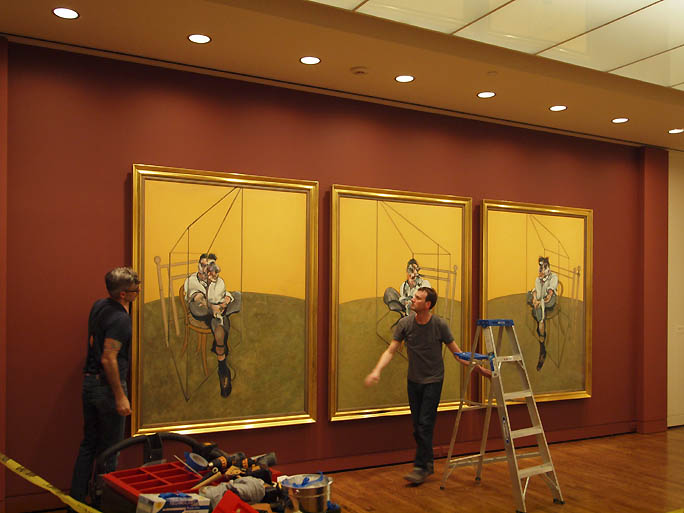 Francis Bacon Triptych recently on view at PAM (during install) This is very stale news in Portland's scene but the NYT's has finally taken notice of something that has been going on for over a decade in Oregon, showing art bought at auctions in our museums. It can blind some (like traditional journalists) with a less broadly based art historical backgrounds and it makes the discourse reactionary and short sighted. First of all, some arguments are more than a little specious. Arguably, the history of arts patronage has always been related to tax avoidance, but perhaps that is the wrong term. Museums have always trafficked in that grey area interchange between wealthy collectors and sharing with the masses. Thus, in a way they take the mostly hidden impulse to hoard treasures and turn them into cultural/economic boosters (bringing people downtown etc). Museums are one of the few places the rich are taxed more proportionately... (more) Posted by Jeff Jahn on April 14, 2014 at 10:57 | Comments (0) PermalinkTuesday 04.08.14 Jesper Just speaks at PAM Jesper Just spoke at the Portland Art Museum last Sunday but you can watch much of it here. Catch his exhibition on dislpay at PAM until June 1st. Posted by Jeff Jahn on April 08, 2014 at 10:36 | Comments (0) PermalinkMonday 04.07.14 Monday Links Finally some hard stats on women in the art world... basically 70% of represented artists are men. I'm uncertain about how those stats bear out in Portland but it is definitely true that men generally get statistically more representation in awards and group shows (Portland2014 being just another example, as is the far more consequential Whitney Biennial). Why is this? I think it is generally the way women are penalized for being ambitious and or promoting themselves, whereas men are encouraged. It also comes down to complicated interpersonal politics (who has kids, who doesn't, who teaches with whom, a cultural preoccupation focus on the events in a woman's life rather than the work) that are almost always more loaded for women. In general, the dudes are simply less complicated even though to my eyes a clear majority of the strong to excellent artists in a place like Portland are women.
Check out this tiny self portrait Caravaggio snuck into one of his most famous works. See? Larry Sultan and Mike Mandel's altered billboards in Juxtapoz. Seattle buys some Ai Weiwei baubles. Namita Wiggers on Craft in the Brooklyn Rail. First of all, the term accidental primitivism doesn't work, its terrible jargon. There is nothing "accidental" about utilizing a centuries old tradition, and it is... (more) Posted by Jeff Jahn on April 07, 2014 at 11:02 | Comments (1) PermalinkMonday 03.31.14 Wafaa Bilal at Linfield  In 2007, Iraqui artist Wafaa Bilal caused an international sensation with a performance called Domestic Tension, where he lived in a gallery constantly shelled by paint ball guns controlled by people far away via the internet. It was a critique of unmanned drones and it also gave the artist PTSD on the way to art world stardom. For Linfield college Bilal will perform a site specific piece called I Don't Know Their Names, an exercise in barely perceivable writing that recalls the way victims cease being individuals and simply become part of an aggregate disaster toll. "Bilal will engage in a durational performance daily in the Linfield Gallery, Tuesday, April 1 - Friday, April 4, during regular gallery hours, 9 a.m. - 5 p.m. The performance will continue on Saturday, April 5, 12 p.m. - 5 p.m. Gallery visitors are welcome to quietly watch as the artist is focused on creating this site-specific exhibition". Wafaa Bilal | April 1 - May 10 Artist Talk: Wednesday, April 2, 6PM, reception following Linfield Gallery | Linfield College 900 SE Baker st., McMinnville, OR Posted by Jeff Jahn on March 31, 2014 at 15:14 | Comments (0) PermalinkMonday Links You don't hear much about female light and space artists but LACMA's Helen Pashigan show is set to alter that.
Jerry Saltz takes on an art flipper. The main problem is treating artists as a mere market that is easily cornered, hyped, inflated then turned over like what used to happen to commodities in the 70's and 80's. The thing is Art requires a long term view and a supple aspect that is being lost here. It isn't the market, academia, institutional commitments or critical response... it is all of the above that matter. Also, when attention in any one area is over-inflated it builds resistance from the other corners of the art world. Also, the question of taste isn't being foregrounded... it is the ability to influence and motivate. There is a distinct difference and strong taste tends to justify itself because it has a certain integrity to it. In case you missed it, for the second year in a row Brian Libby chose the venues for the Portland Modern Home Tour. My oh my, has Portland's image and design IQ changed or what? Posted by Jeff Jahn on March 31, 2014 at 10:05 | Comments (0) PermalinkFriday 03.28.14 Friday Links The hoard of Nazi Looted art in Salzburg is far better than at first thought.
Jerry Saltz on Finding Vivian Maier. Definitely this is the year when the art world is looking at the contributions of women in a new light. The Guardian shows shocking images of America's race war that you probably wont see in US publications. Hyperallergic on Kara Walker in Eugene. See it, the show ends soon.... the same with the Francis Bacon at PAM (it is the last weekend actually). As predicted 2014 is definitely shaping up as the year women are raising awareness again.... and Yoko Ono's latest project invites all women to participate. Posted by Jeff Jahn on March 28, 2014 at 10:46 | Comments (0) PermalinkMonday 03.24.14 Monday Links The biggest news in Portland's art scene this weekend was that PLACE has abruptly had its lease terminated by Pioneer Square Mall. PLACE was our pick as the alternative space of the year in 2013. It was always an odd fit, an alternative art space that staged mock suicides or an outright protestation of consumer behavior (like Paul Clay) in a downtown mall, but that is what made it work (and what the Portland 2014 biennial totally missed by being 3-6 years behind the curve). In general it is disappointing but in some ways an ending like this is great... it is better to burn out scalding hot than just fade away and it reemphasizes the crucial nature of these improbable alternative spaces to Portland's overall character... if only Portland's more official institutions would get involved (or actually have curators attend shows) during their short lives.
Even the local Fox affiliate got ahold of the story... nothing seems odder than seeing Michael Reinsch's name and fake suicide project on Fox News, but there it is. Hopefully all of the publicity will help PLACE find a new home... perhaps in some place downtown and equally unexpected like a bank? An excellent essay on Victorian occultism and its relevance to contemporary art should be required reading for all artists working today. Lobbyists for major auction houses are opposed to artists and their estates getting a cut of the action in inflated art market... predictable. Shigeru Ban, an architect known for making temporary structures has been awarded the Pritzker Prize. This is significant as his work is often decidedly unmonumental and temporary. Last but not least, PORT welcomes our newest sponsor the Jordan Schnitzer Family Foundation. We are very selective about our sponsors and currently the foundation's generosity has a facilitated a long list of exhibitions it has lent works to such as, the excellent Emancipating the Past: Kara Walker's Tales of Slavery and Power in Eugene, Under Pressure at the Missoula Art Museum and Radical Repetition at the Whatcom Art Museum. The Jordan Schnitzer Family Foundation has an encyclopedic collection of master prints and Northwest art that it lends to venues around the country. In particular, they make exhibitions and support programs available to communities that often would not have access to such work. Built to share, the collection was one of the first large scale lending libraries in the USA, leading the way for other collectors like Eli Broad and Nicolas Berggruen. In 2012, the Jordan Schnitzer Family Foundation lent an encyclopedic survey of Ellsworth Kelly's prints to LACMA. That show later traveled back home to Portland. Posted by Jeff Jahn on March 24, 2014 at 11:03 | Comments (0) PermalinkThursday 03.20.14 Museums & Generations There is always a lot of hand wringing when generations hand the baton and in this case Gen X and Millenials are taking over as patrons and visitors to museums (Gen X was missed by the article, mistake... Gen X is far more museum friendly than Millenials because my generation like to go off and contemplate "alone"). The thing is the Baby Boomers never really distinguished themselves the way their parents did, so though they may have 70% of the disposable income they are likely spending it on their bucket lists and golf outings. Considering how much more culturally sensitive and less "me" centric Gen X and Millenials are museums should be fine in the future. Though they have made huge strides local museums like PAM and MoCC haven't really captured the imagination of the younger Gen X/Millenial crowd that has flooded Portland.
The Peter Doig early works show every young painter should check out. Hell, the old ones might find it worthy too. New MOCA Director Philippe Vergne is moving in a prudent and serious way to re-imagine the museum's programming, with a focus on relevance. I tend to think he will be a better fit wit MOCA than he was with the Dia Foundation as MOCA is first and foremost an urban, West Coast laboratory that doesn't program like East Coast institutions do. The West Coast is closer to Asia out here and the more you look the more it shows. Posted by Jeff Jahn on March 20, 2014 at 15:22 | Comments (0) PermalinkMonday 03.17.14 Monday Links Hyperallergic thinks that US museums don't want comics. I don't think that is completely accurate, especially on the West Coast where most major museums have staged major shows involving comics (for example, PAM's big R Crumb show)... but it is true, they might not really know what to do with them when outside of featured exhibitions. Are they prints, books, design driven craft/pop art? YES!
The heirs of Peggy Guggenheim sue the Guggenheim Foundation. This is very complicated but I tend to agree with the heirs... basically turning Peggy Guggenheim's burial space in Venice into a rotating exhibition space for collectors who donate enough just doesn't work. Toyo Ito wins the Thomas Jefferson Prize for Architecture. What happens when a civic sponsor witholds funding to shape the programming of a festival, the Artistic Director of the Adelaide Festival responds. There is a line that patronage should not cross, especially if it is a civic organization. Vanessa Renwick is this year's Bonnie Bronson Fellow... congrats. The award is the only one in the region that frequently focuses on mid career women and there is generally a community component that drives the selection process as well. PORTstar Amy Bernstein was on KBOO radio last week discussing her solo show. Last but not least check out David Pagel's review of Walead Beshty's work. Posted by Jeff Jahn on March 17, 2014 at 10:30 | Comments (0) PermalinkMonday 03.10.14 Monday Links A look at the Detroit Institute of the Arts bid to separate itself from city ownership.
Check out this interview with Carolee Schneemann in the Guardian... Women and their position in the visual arts is turning out to be THE topic of 2014 (especially since the last 12 months have been so dude oriented at an institutional level. Tyler Green on the restoration of Pollock's Guggenheim Mural. I don't put a lot of cred into the before and after GIF though. I saw the painting in Des Moines before being shipped off to the Getty and it certainly wasn't as dull as the "before" image indicates. The yellows were very apparent but still I'm sure it needed some of the TLC that the Getty was equipped to give it. Pictures of Paris before gentrification... I've updated the Whitney Biennial links several times and its interesting how the Portland2014 Biennial seems to pantomime it. There is a lot of monkey see monkey do when most curators do survey shows, which is why having a kind of thesis like the Hammer's Thing or the Tacoma Art Museum's last NW Biennial focus on interdisciplinary art make sense. Otherwise you see the same show (better and worse versions) over and over again. I still believe these shows are important social events but unless they take a stance and make a point of really highlighting strong new developments in art (with enough space/focus to do so) these things are just anonymous vehicles designed mostly to benefit the presenting institution. An art historical thread like Robert Storr's focus on the grotesque in 2004 at Site Santa Fe meant something... Kara Walker even debuted her first video piece there. The 1999 Oregon Biennial redefined art in Oregon and introduced 4-5 new stars to the scene. That is the sort of discovery that makes a survey memorable. Presenting artists or art that looks just like hundreds of other recent shows just doesn't differentiate the exercise of a survey enough. Posted by Jeff Jahn on March 10, 2014 at 14:09 | Comments (0) PermalinkSaturday 03.08.14 Women In Art for 2014?  Eva Lake's Target NO.46 (Jean) Yesterday was International Women's Day and the New York Times published a stunning article on the lack of women in top museum director positions. To be sure there are a variety of reasons but it also follows related but dissimilar gaps in representation for women in all aspects of the art world. For example the current Whitney Biennial (which I've been following with updates here) only can claim only 32% of its participants as women. Closer to home we've pointed out that the Portland 2014 biennial is also short on female artists and no woman has ever won the Arlene Schnitzer prize for the CNAA's. Also, women are still a minority in the Hallie Ford awards. Jen Graves pointed out the stunning shutout of women from the Betty Bowen awards last year too. This is despite the fact that a majority of cultural gatekeepers in Portland (curators and gallerists) are women and I think it might be part of the reason more men get awards. Clearly this is an issue to track in 2014 and any survey, award and hiring will be scrutinized for it... (more) Posted by Jeff Jahn on March 08, 2014 at 15:35 | Comments (0) PermalinkWednesday 03.05.14 Whitney Biennial Links 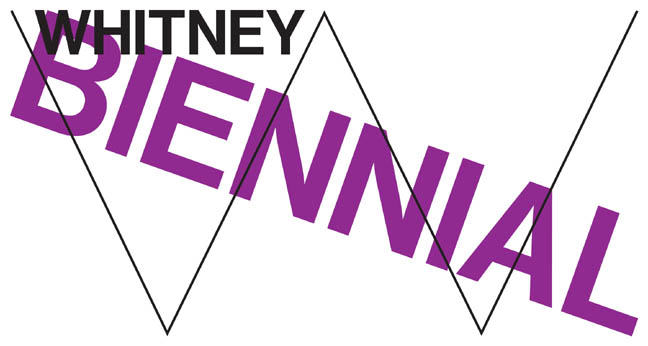 Well the Whitney Biennial has opened and the reviews are starting to come in. I'll track them here, so check back for updates. Thankfully or sadly there are no Portlanders in it this time but with its focus on the midwest I understand... Portland is very popular with midwesterners as a relocation spot and we have already had a lot of presence in recent previous shows. I'm personally over these giant surveys that always do more for the institution than the artists or the discussion of art (though the flailing attempt to do "something" is nearly always worthwhile as an institutional barometer rather than satisfying/challenging statement). Not to say they can't be good, they often seemed rigged to mildly placate, rather than discover and promote new talent by giving the uncertainty of the present a voice. Instead, they ingratiate themselves to the art world choir creatures they serve (artists and gallerists) and or keep at arms length. Ideally, they spotlight some new faces and trends that keep things from being stagnant... not certain this one achieves that goal. I haven't heard the word "fresh" much. Jerry Saltz found it bland with some energy on the 4th floor. I think this is an amplitude problem... ie. how to achieve escape velocity for an art world exerting such gravitational force, especially in NYC? It incentivises a kind of bland punting (choosing 3 outside curators etc, I discussed it yesterday). It is very predictable because so much is at stake and anything embracing the radical becomes a massive threat. NYC's art world is easily threatened these days. Accepting threat or the uncertainty and amplifying the shifts that the unknown demands is a far healthier way (an essay I penned in 2002 that Jerry liked a lot gets to the point). Also, Jerry may love the camera obscura(curated by Elms) but I've seen so many of those over the past decade + it just seems like it stood out because it was a reprieve from the anxious index of familiarity he described in the rest of the show. Interesting that he liked Sterling Ruby's ceramics... a similar vibe to the 2012 standout by Portland's Jessica Jackson Hutchins... both are steeped in West Coast 60's arts and crafts grottyness. Hyperallergic starts with images and a discussion of the 4th floor, which most everyone seems to be liking the best. Ah, so the big standout artist of 2014 is one of the curators... That is good because Michelle Grabner is an old Wisconsin grad school dayz friend but does any of the work suggest or demand a shift in the art world the way Forcefield did in the 2002 Biennial? I'm not hearing anything like that... (more) Posted by Jeff Jahn on March 05, 2014 at 10:41 | Comments (0) PermalinkTuesday 03.04.14 Tuesday Links Tyler Green looks at the coming absorption of the Cocoran's collection into the NGA's and what it could mean.
The NYT's discussed this week's 2014 Whitney Biennial and its wrong to give the article much focus beyond being a brochure guide. Mostly, the focus on; witty craft, works on paper, nostalgia, architecture and female painters is a restatement of the previous decade and a half (which is accurate and on trend though not enough women are in this show). Still, the addition of "Looks That Can Decieve" is somewhat interesting but also very familiar if you've looked at contemporary art since say 1999. Several of my friends are in it and one of the curators is an old grad school chum so I've got a vested take in this... but overall I see it as an index style show. There are lots of other regional surveys of American art (Made in LA, State of the Art etc)... some more comprehensive (no Pacific Northwest artists despite the fact we are hot, probably because there is a big Midwest presence and Midwesterners often move Northwest). Some, like TAM's Northwest Biennial (I was in the last one) or the California-Pacific Triennial are more narrow than this but it is the New York style marketing blood sport of who will stand out that keeps people focused on the Whitney. No other show on the planet, besides perhaps the Turner Prize... (more) Posted by Jeff Jahn on March 04, 2014 at 10:37 | Comments (0) PermalinkFriday 02.28.14 Friday Links The story of the week: should artists and their estates receive a cut of resales in the USA the way they do in France?... you bet. Why? consider all the artists whose work goes for millions at auction when their estates don't have the funds to care for and promote the understanding of the work. It keeps the work in what I call, "the market orphanage," where objects only have monetary value but have no custodianship and no one looking out for the integrity of something that has value.
Embattled museum director Malcolm Rogers steps down in Boston. Sol LeWitt in Australia. Posted by Jeff Jahn on February 28, 2014 at 8:01 | Comments (0) PermalinkMonday 02.24.14 Monday Links One of the designers behind sex in a box a.k.a. Twister, discusses the game that at one time raised an uproar.
Roberta Smith on the Futurists and their tarnished but intriguing past. It is rarely ever good when artists attempt cozy up to the offices of power. The Structure sensor (3d sensor for Apple products) is just the sort of thing many artists and designers have been dreaming about. Turn your iPad into a tricorder! Posted by Jeff Jahn on February 24, 2014 at 9:58 | Comments (0) PermalinkThursday 02.20.14 Oregon Arts Commission & Trust Survey Results  The Oregon Arts Commission and Trust (director search) stakeholder survey results are in and fascinating to dig through (especially all of the write ins, just scroll down). Analysis: 1st thing, there has been no statement describing why Christine D'Arcy was let go... though some of us were tipped off that something was odd months before. I'd prefer the state would just be transparent before I go publishing off of what scraps I and many others know. Not knowing this crucial bit of information makes attracting good applicants more difficult. There is a widespread transparency problem that any new director will need to fix, but who fixes the state run oversight? Communication was easily the highest ranked category ... (more) Posted by Jeff Jahn on February 20, 2014 at 16:04 | Comments (0) PermalinkTuesday 02.18.14 Best of the worst links Vito Acconci (whom PORT interviewed here) declares Marina Abramovic's performance at MoMA as the nadir of performance art. I tend to agree, though I also agree that some of her earliest works especially with Ulay are the best (the Great Wall was such a mature reckoning). Why? Because the MoMA project complicitly feeds the queue of the museum... making the wait a kind of institutional kowtow and moment of fealty. The implications are incredibly lame, kinda like The Gates by Christo and Jeanne-Claude in Central Park had a kind of cultural imperialism about it... de democratizing a typically less structured space.
Then this joker had to destroy an Ai Weiwei (whom we interviewed here). The issue with this is the self centered vandalism of this bitter artist destroying another artist's work. When Weiwei destroyed an artifact he was making a statement for his own people and history... this fellow simply built a temple to his own bitterness and ignorance. The institution in question even did a locals show last year, thus completely undermining the vandal's attempt at critique. Hopefully this doesn't prompt venues to cordon off work... which would be a shame and strengthen the artifact vs. art paradoxical divide. Is Frank Gehry the worst living architect... hardly, though he does take chances and any essay that compares architecture to a C.C. Deville guitar solo that goes on and on gets points from me. Posted by Jeff Jahn on February 18, 2014 at 15:20 | Comments (0) PermalinkMonday 02.10.14 Monday Links This is an excellent piece on the state of the Dia Foundation with and without Philippe Vergne, whom I consider a better fit for MOCA than the Dia. The Dia was once the country's premier experimental art institution and they championed site specificity better than anyone before or since. It was rooted in the most surprisingly supple aspects of Donald Judd's philosophy, which acted as an antidote to market driven art... providing a patronage platform for integrity driven work. It really hasn't gotten its groove back since Michael Govan left. Frankly, civilization needs an active and relevant Dia that can exist without deacessioning and the new director will need to repair some damage done by such activity.
Michelangelo the forger. Interesting about the way forgers were considered back in the day. No big surprise, the Oregon Arts Commission has lost another 3 officers. Something complicated is at work and there is something in this earlier article. What is missing is transparency at every stop along the line here, especially the composition and mechanisms for being added to awards panels. You can fill out your criteria for the new director here. There was a mention of Portland visual arts in the New York Times this past weekend. It is nice that Portland was being portrayed as an edgy art adventure rather than simply some quirk fest or other regional stereotype (you can find whatever you are looking for here). As I've mentioned before the Crystal Bridges Museum's State Of The Art project is interesting. Will it be a conservative World's Fair type event where regional stereotypes are trotted out? If it is critics will eat it alive but I do believe that the US could benefit from a survey that isn't based in New York, more voices would be healthy when so many cant see beyond the Hudson. The question will be if they can bring out work that has an edge? Does it reflexively interrogate, negate and transcend, rather than merely illustrate genre? ... (more) Posted by Jeff Jahn on February 10, 2014 at 10:28 | Comments (0) PermalinkThursday 02.06.14 First Thursday Cancellations and Openings Due to the snow many First Thursday venues are cancelling. I will update as they come in.
List of cancellations: Littman Gallery PSU (rescheduling Thursday Feb 13th) All Desoto Building Galleries (Bluesky, Museum of Contemporary Craft etc.) Autzen Gallery, PSU Ditch Projects reception(rescheduling on a Friday soon) White Box at the University of Oregon, Portland Duplex Collective (rescheduling February 13) Elizabeth Leach Gallery Blackfish Butters Pulliam Laura Russo Gallery PNCA List of venues open: PDX Contemporary (Terry Toedtemeier wasn't afraid of a lil snow) The Portland Art Museum plans to keep the Museum open till 5PM. PIFF's opening night at PAM and the screenings and opening party will go on as planned. HAP Gallery Posted by Jeff Jahn on February 06, 2014 at 13:20 | Comments (0) PermalinkFriday 01.31.14 Friday Links Tavis Smiley interviews Teller about his documentary film Tim's Vermeer. Interesting how Teller is surprised at how artists and scientists were once the same vocation. Lately with artists like Inigo Manglano-Ovalle, Olafur Elliason, Anish Kapoor, Cartsen Holler and Robert Irwin/James Turrell's early work, we see somewhat of a return to this kind blurring of lines... locally artists like Kyle Thompson, Laura Fritz, Laura Hughes and Zachary Davis have all taken a similar investigative approach to applying Bacon's Novum Organum (which is rooted in Davinci's observational and trial studies). Jerry Saltz is also excited about this. The point is, given enough time and thoughtful concentration anything one human being has done can be reverse engineered and replicated.
Adrian Searle discusses Martin Creed's exhibition at the Hayward Gallery. Carnegie Mellon University has scuttled its curator... why is this bad? Many institutions have been doing this of late and it essentially destroys the programmatic integrity of a space. A curator's voice creates continuity and a programmatic arc, which when dispensed with leaves a rudderless exhibition schedule driven by opportunistic or void-filling exhibitions with nobody to answer for their quality and execution. That "Arc" is crucial as often it isn't a single exhibition that matters but the probing variety that a curator brings. It is the difference between having a chef or putting on a pot luck affair. When no one is responsible, a program loses its voice at budget meetings... guaranteeing it will be ever more shunted to the periphery of institutional priority. Lastly, galleries are the place where the institution meets the rest of the world. Ditching the castellan responsible for that interaction means the institution will become more navel gazing and insulated. Brian Libby and Kieth Daly debate the infinitely debatable Portland Building. I'll have an in depth piece for you soon that takes the discussion in a new direction (it is nearly complete and as usual, it draws blood). Posted by Jeff Jahn on January 31, 2014 at 12:14 | Comments (0) PermalinkMonday 01.27.14 Do's and Dont's I'd put LA's new Mistake Room on the to do list. It doesn't matter where you go, LA or Portland... most institutions aren't open enough to this sort of thing. The Dia used to be the king and before that, what the PCVA did very well was take chances and actively avoid parochialisms.
Edward Winkleman on the "Don'ts" of the new MoMA expansion. Hyperallergic catches some parents letting their kids use a Judd stack as a bunk bed. I wish this were just some outlier episode but these sorts of things are pretty common. Museums and art going in general has gradually taken on the same audience pandering as other "entertainment venues." There has a been a general lowering of the respect quotient in art production and it has been replaced with a sort of funhouse mentality. This cues parents (who obviously need to reign in this sort of misbehavior) to treat the art experience like a playground. Obviously, this doesn't describe every parent/child situation but because a Judd is involved it is heightened. Judd took everything very seriously. The problem with positioning cultural production as "entertainment" certainly has its pitfalls. This online exhibition of Judd's woodcut prints by the Judd Foundation makes his seriousness all the more present. Jerry Saltz on selfies... do or don't everyone online today is expected to ha an online persona, but few are prepared to do much with it. Posted by Jeff Jahn on January 27, 2014 at 11:16 | Comments (0) PermalinkFriday 01.24.14 Friday Links Holland Carter discusses Carrie Mae Weems' retrospective at the Guggenheim. Portland born, we were treated to this show last year at PAM.
Is the CRC finally dead as the WWeek says? Kitzhaber (whom I otherwise respect) has been trying to push this ill conceived project through for years and it serves as a cautionary tale for needing a good design rather than the cheapest most backroom pedaled one. Good design builds consensus! Japser Johns testifies against foundry owner. Posted by Jeff Jahn on January 24, 2014 at 11:03 | Comments (0) PermalinkThursday 01.23.14 Ponderables? Phillipe Vergne seems to be indicating that MOCA will return to being, "The Artist's Museum," as it was originally designed to be. This is crucial as so many institutions have become or always were all about their institutional growth (MOMA etc.). At the same time, "enabling curators," doesn't necessarily make MOCA an artist's museum... only certain types of curators do that and they are extremely rare. In many ways museums have become victims of their own success at hoarding presciently collected art. Question is... is it MOCA's turn and if so does that mean they will ever have room for their permanent collection? Deaccessioning doesn't seem like a great idea either but objects/pieces do put conditions on resource allocation for institutions. Vergne wasn't all that successful at returning the Dia to its glory days as the world's greatest art patron but he might have an easier time achieving such aims at MOCA. Controlled growth that creates more options rather than limiting them is a key but can Vergne really back up that ambition? He certainly needs to keep MOCA hungry and risk taking but it remains whether they can actually turn back the clock a bit?

How can Portland support so many new restaurants asks Oregon Business? It is a visual art related question because it indicates where we spend our entertainment dollars and why Portland IS special (hint it isn't corporate). It is also where a lot of the artists, musicians etc find both employment, restaurant design/branding gigs, which helps explain why Portland is the best place to network in a genuine way if you want to center your life on a moral ethos rather than a corporate one. Not that jobs are easy to come by but it does explain why we are so vibrant. The artists move here and make it more interesting... the restaurants help pay the bills (barely) and elevate a necessity like eating into something sublime. The artists, musicians etc. then channel this... (more) Posted by Jeff Jahn on January 23, 2014 at 11:33 | Comments (0) PermalinkTuesday 01.21.14 Tuesday Links Philippe Pirotte on Kerry James Marshall's incredibly canny reconstitution of imagery in Western Civilization's visual history.
The Brooklyn Rain devotes an entire issue to Ad Reinhardt. Makes me think we should do a Mark Rothko essayfest sometime. Check out the first of four Glasstire videos with Dave Hickey. A wooden skyscraper design wins competition. Posted by Jeff Jahn on January 21, 2014 at 11:14 | Comments (0) PermalinkFriday 01.17.14 Powell - Basquiat Links 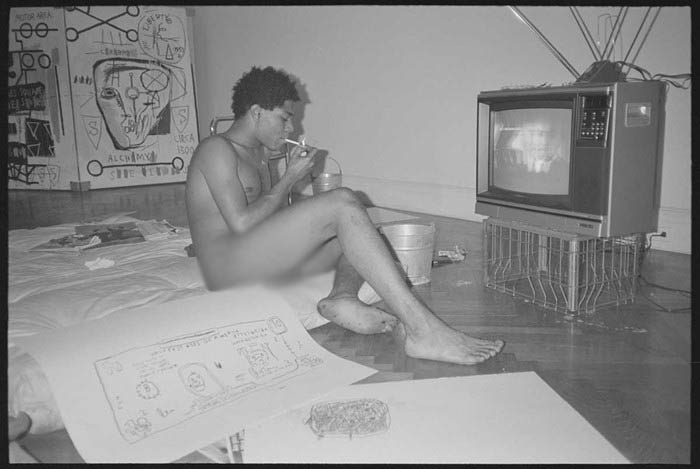 Jean-Michel Basquiat Reclining Nude, by Paige Powell Portlander Paige Powell has a show of her photos of Jean-Michel Basquiat up in NYC now. Interest in Basquiat continues to intensify year after year, perhaps because of all the 80's painters his work is the biggest cipher. Unlike say Schnabel or Clemente... no matter how much we learn or hear of Basquiat, it somehow never seems expended. Some artists simply have a mystique... others make far too many pains to fabricate it. Basquiat is the former. Last year I wrote a little essay about the very unique Basquiat painting Powell has on long term loan to the Portland Art Museum. Posted by Jeff Jahn on January 17, 2014 at 13:29 | Comments (0) PermalinkThursday 01.16.14 Vergne at MOCA MOCA announced Philippe Vergne as its new Director late yesterday. Here is the very short first interview.
A couple of thoughts... this is good, partially because this gets Vergne out of the Dia Foundation. Vergne is a curator at the core but somehow his 5 years at the Dia were somewhat unremarkable and staid. His fundraising resorted to... (more) Posted by Jeff Jahn on January 16, 2014 at 10:26 | Comments (0) PermalinkWednesday 01.15.14 Bridge Names Not Bold Well I am not surprised that the Trimet panel didn't shortlist Rothko for the transit/pedestrian bridge name and a lot of people will be disappointed. Perhaps Rothko as a name was doomed by the need of the panel to be unanimous? No panel can ever be convened that will return a unanimous verdict on Rothko... or any artist of any sort of greatness.
Being Jewish and an immigrant didn't help Rothko either (Portlanders do have a bias, see William Pope L's new show at PSU). Not disappointed though, it brought Portland's allergy to acknowledging greatness (old school arch-regionalist and anti-immigrant bias [read the comments]) in its midst to the fore of people's minds. All great artists are polarizing and unanimous panels don't reward that kind of frisson, despite the fact that Rothko grew up in the Bridge's neighborhood and painted the site repeatedly. These biases cannot be overcome overnight but I will call out anyone who proliferates them. The less navel-gazing, more worldly Portland that has taken hold here isn't playing checkers it is a chess match.  Thoughts on the bridge name options? Cascadia - is incredibly weak consensus building panel process detritus name... (more) Posted by Jeff Jahn on January 15, 2014 at 11:38 | Comments (1) PermalinkMonday 01.13.14 Monday Links Jerry Saltz's open letter to MoMA's board urges a rejection of the current expansion design. It just doesn't measure up to the standards we hold MoMA up to... try again. Also, Michael Kimmelman at the Times was uncharacteristically cutting on the subject as well... we shall see soon if critics mean anything to MoMA?
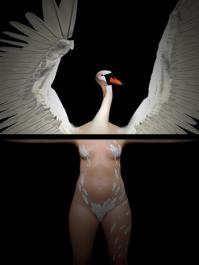 Paul Clay's interactive Leda and the Swan at the Portland Building opens today Randy Gragg chimes in on the fate of the Portland building. I disagree that photos would somehow fill the gaping hole in history a demolished Portland Building would leave. My extensive piece is coming soon but in general (like Randy) I think people are severely undervaluing the place making that the Portland Building brings to the downtown. Also, moving the beloved Portlandia sculpture anywhere else is naive. BTW Paul Clay's video installation at the Portland Building looks promising and it opens today. It is a great reason to visit this embattled and flawed landmark soon. Sculptors and designers, the possibilities of walking 3D printers must be exciting. Private funders and foundations have pledged 330 million+ to save city owned art from auction by Detroit's creditors. Posted by Jeff Jahn on January 13, 2014 at 10:22 | Comments (0) PermalinkWednesday 01.08.14 Architecture Wednesday Well, this Wednesday has dropped a ton of architecture news on us.
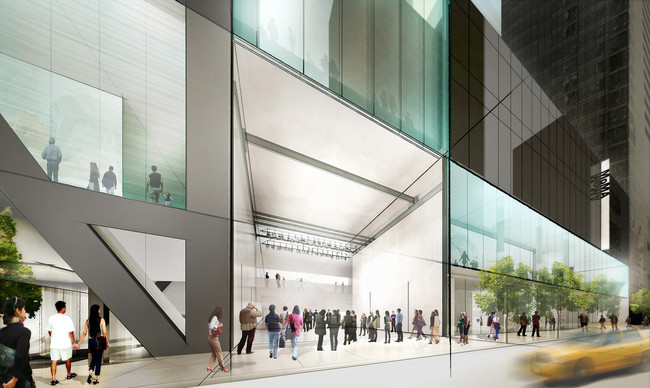 MoMA's new art bay, reminiscent of a garage The biggest story is MoMA's new expansions by Diller Scofidio + Renfro. Jerry Saltz HATES it but I do see the value in the "bays" that open like a garage to the street (they are just very timid descriptions of space considering their aims). The more problematic disappointments are the lack of expansion for the permanent collection and the intensely antiseptic white and glass design schemes that have no idiomatic texture or place making. It is institutional, with all the charm of a pharmaceutical research lab. It speaks of mall-like vernaculars + aspirations. Let's revisit the past. Perhaps, I miss spaces like Louis Kahn's Kimbell Museum of yore? Also, there are better museum architects like Renzo Piano. True, Piano does design too many museums but The Menil is astounding. Those spaces I just listed have intimacy, aspirations and yes personality. The MCA in Chicago has similar vaults to the Kimbell. I love those MCA spaces (curator Bruce Guenther was partly responsible) and its that lack of curatorial nuance that many new extensions have that leaves them unremarkable. Renzo Piano's Art Institute of Chicago wing is ok but I hate what happened to the Ab Ex area where it used to have a big scary room with Clyfford Still, Pollock and de Kooning's excavation all holding court. The "transparency" of the new design kills that mystique and MoMA seems to be another victim of the architectural language of transparency. Museums which offer nothing but generic space miss the point. They should create place, not merely space or worse, square footage. In a Museum the art holds court and staircases are mostly just there like pickled ginger to cleanse and reset the palette. I also keep thinking about how great Steven Holl's design for MoMA was and how the tanking of the Bellview Art Museum in Seattle likely cost him the gig. Holl's proposal was bold but not as radical as Rem Koolhaas' design. There was a vernacular to build upon and it retained an idiomatic aspect that was open, not merely transparent. Holl's Nelson Atkins expansion showed just how well that can work out. Somehow D+S R has lost their edge on this project. It seems very conservative... even moreso than their new Broad museum in LA or the new Whitney building to be finished on the West Side. The fact that the Williams and Tsien's folk art museum wont be saved isn't surprising... I'm certain they wanted to save it but the client's needs overrode anything truly inspired. The fact that William's and Tsien took on the Barnes collection project... essentially looting a national treasure for greater attendance only makes this karmic-ly fitting. There is always a bigger fish... will MoMA eventually swap its digs for a place where it can do it right and the current galleries will become a true mall or sports stadium? Maybe in 100 years? I'm certain it will still be packed until that day comes... but geeze New York, between the Freedom Tower and MoMA you really aren't setting the bar with your designs and places like Denver do seem more progressive. In more local news there is also an international preservationist firestorm brewing over the rightfully maligned Portland building. Now that the city council is openly considering demolition of the Portland building, it has become the single most threatened/high historical value building on the planet... (more) Posted by Jeff Jahn on January 08, 2014 at 17:52 | Comments (0) PermalinkTuesday 01.07.14 Tuesday Links MOCA edition Looks like there will be a new director named at MOCA very soon and the NYT's confirmed that all of the front runners are museum professionals not art dealers like former director Deitch. Toby Kamps would be my first choice, though he is a curator's curator and being a director involves a lot more fundraising so I am not certain he would want the gig. MOCA does need to rebuild its reputation as perhaps the USA's top contemporary art institution... it has degenerated into a salesroom of sorts as of late.
The LA Times reports that MOCA is now financially solid. Posted by Jeff Jahn on January 07, 2014 at 10:46 | Comments (0) PermalinkFriday 01.03.14 First Links 2014 The Village Voice looks at the art world's worst kept secret about the market.
Skylab's just approved tower for the Burnside Bridgehead is a stunner. Edward Winkleman on earning that uppercase "C"... no not critic or curator, that's a different process but "C"ollector. Cornell's newly approved Tech Campus on Roosevelt Island designs are worth a look. Posted by Jeff Jahn on January 03, 2014 at 8:54 | Comments (0) PermalinkMonday 12.30.13 Last Links of 2013 2013 is almost over and before my year end reviews (starting later today) here are some worthy links:
TJ Clark's provocatively excellent review of the Paul Klee show up at Tate Modern is a must read for anyone interested in painting. Klee is perhaps the most influential modernist artist amongst today's contemporary paint slingers yet somehow this never gets properly explored. The way each work is both a poem and a game that plays against itself is so contemporary. It is the perfect time to read Issac Asimov's speculative essay on the 2014 World's Fair. Posted by Jeff Jahn on December 30, 2013 at 12:09 | Comments (0) PermalinkFriday 12.27.13 Friday Links Getting back into the swing of things and some best and worst of 2013 Portland review lists that might make all the others look tame and or incomplete. Till then let's start with some links:
Ken Johnson isn't fully taken with a survey of figurative art drawn from one idiosyncratic collection. A Miro show in Turkey gets pulled because many of the works are fakes. Verifying authenticity is tricky stuff when it comes to minimalist/conceptual works designed to break institutional hang ups. We took a lead on these issues in 2010 by staging a conference and exhibition on Donald Judd's radical form of delegated fabrication. The elephant in the room was Count Panza of course and ironically it was announced that he had died on the day the conference occurred. It is good to see that these ideas are becoming the rule when dealing with these works... market pressures often value aspects antithetical to the spirit in which the art was conducted. Posted by Jeff Jahn on December 27, 2013 at 9:08 | Comments (0) PermalinkMonday 12.23.13 Holiday Links Let's take a breather as we gear up for some critically charged year end posts and other goodies. Till then here are some links:
The Guardian is gathering some famous artist's christmas cards. In case you missed them check out our review of Ben Buswell's current show and my in depth interview with Kengo Kuma. Also, unlike many who have been writing about the Francis Bacon... we at PORT understand visual art and can wrap our heads around its appearance here in Portland succinctly and sanely. It is a great set of paintings that puts the work of favorite local artists like Storm Tharp and David Eckard (think of the colors and architectural articulations around a figure) into greater context. Some writers don't understand visual quality because they are primarily "writers" who find it easier to engage other writers more than the art itself... that's why they come off so bewildered and second hand. Not a bad thing but it is amusing to watch all the flailing. Great art does this to some who don't deal with it frequently and it is why it sets people in tail spin. It reaffirms the power of art as something beyond an academic or community building exercise. In this case just focusing on the paint quality alone is revealing, no oil painter in the Northwest has similar facility and the funny thing is that the technical ability is the most obvious and least interesting part of the work. Posted by Jeff Jahn on December 23, 2013 at 11:53 | Comments (0) PermalinkMonday 12.16.13 Oregon Arts Commission Vis Art Fellowships The Oregon Arts Commission has announced its visual arts fellowships this year(in the sum of 3K each):
Avantika Bawa, Portland (Joan Shipley Fellow) Modou Dieng Portland Laura Fritz, Portland Surabhi Ghosh, Eugene Anna Gray, Portland Sabina Haque, Portland Allison Hyde, Eugene Anya Kivarkis, Eugene Ryan LaBar, Enterprise Ellen Lesperance, Portland Ralph Pugay, Portland Samantha Wall, Portland Terri Warpinski, Eugene Looks like for once more women are receiving awards than dudes (a correction was in order). It is a good list (yes some are close acquaintances but I prefer the fact I don't know all of these people) but one thing that this critic has noticed is that the OAC does not release the names of the panelists making these decisions. Also, the way those panelists are chosen is similarly oblique. RACC by comparison always releases the names of panelists who make the decisions. With recent shake ups at the OAC, this change is required, especially since easy connections to certain groups in the state can be extrapolated from lists like this... the real meat comes from the composition of the panels. As far as the artists chosen... most, if not all of the artists have been more active outside the region than inside Oregon, which is a good thing since Oregon art awards have lately skewed towards parochialism. This is not a parochial white dudes list for once! Congrats to all! Posted by Jeff Jahn on December 16, 2013 at 11:57 | Comments (0) PermalinkMonday Links The latest on Detroit... can the public avoid being looted?
PAM will we showing the record breaking Francis Bacon triptych of Lucian Freud, this Saturday. I could care less about the price but it is nice to compare it with last year's Bacon single painting show. William Kentridge believes South Africa let Mandela down? Posted by Jeff Jahn on December 16, 2013 at 10:38 | Comments (0) PermalinkFriday 12.13.13 Friday Links It is important to have negative reviews... they ask important questions even when the conclusions are wrong. For example, Ken Johnson is about Roni Horn. That "teetering" place between art and design is a very important place and artists like Donald Judd and Dan Flavin exploited it, Roni Horn was the next gen... overall using the term "minimalism" is a bit of a red herring in understanding that type of art. Portland has its own version with; Damien Gilley, Jordan Tull, Ben Buswell, Brenna Murphy, Zachary Davis, Ellen George, OPS, Laura Fritz, Paula Rebsom, Matthew Leavitt and Jesse Hayward etc. Many of whom are now more active outside Portland than in the city limits. Teetering is good for art and Portland is a design/art city.
I'm not certain that a cultural center in Taiwan that looks a little like an amusement park is sending the right message. Is there a global art esthetic? Sadly it comes with the global market... for example, most auto manufacturers make vehicles that are only slightly differentiated from one another. Why should art be any different? (actually it should be) Want more differentiation? differentiate your markets... Posted by Jeff Jahn on December 13, 2013 at 11:42 | Comments (0) PermalinkWednesday 12.11.13 Precipice Fund Grantees Year 1 
Earlier this year we were very excited to break the story that an arts organization was taking on the woeful lack of funding for difficult projects and in particular alternative spaces with $75,000 in grants funded in part by the Andy Warhol Foundation. This Precipice Fund is incredibly well placed since Portland's alternative spaces are perhaps the best cultural incubators and producers we have. It was also especially interesting because PICA (like most arts non profits) is usually scraping for funding themselves. They even have a Kickstarter campaign for next year's TBA festival so devoting energy to this is... well, outlandishly broad minded of them. This year 18 recipients and teams will each receive up to 5k and the list includes many key players in the alternative space scene. I'm especially happy to see 12128, Patrick Rock and False Front who are 3 of the most crucial and accomplished presenters in town. Here's the list: ...(more) Posted by Jeff Jahn on December 11, 2013 at 1:15 | Comments (0) PermalinkMonday 12.09.13 Monday Links Here's an obligatory and half stupid Miami wrap up... we will have pictures for you soon.
As the situation in Detroit develops DIA explores ways to separate works from city ownership to protect them from bankruptcy liquidation (looting). Peter Plagens reviews New Jersey as Non-site at Princeton. Posted by Jeff Jahn on December 09, 2013 at 11:32 | Comments (0) PermalinkFriday 12.06.13 Friday Links PDX, aka Portland's airport is changing its carpet... we design oriented people in Lil Beirut are very interested in this. Honestly PDX should have simply commissioned artist Damien Gilley to do the redesign.
The whole attempt to "monetize" the Detroit Institute of Art's collection is simply wrong and is just a drop in the bucket. Tyler Green digs a little further into why it is such raiding party... turning public assets into private gain. Last but not least, Jerry Saltz discusses the big MFA bubble situation. It is true, there is something about academia that blunts artistic development after a certain point... I'm talking about the professors, not the students. About 95% of the art professors I watch seem to plateau when they start teaching full time (I attribute it to a defensive/careerist attitude they adopt), the other 5% are simply the sorts whose progress cannot be slowed by anything short of an asteroid impact (they also take pains to not be wholly owned by academia). From the student perspective arts education has become a kind of puppy mill situation. Overall, I prefer BFA programs that concentrate on fundamentals like OCAC and Lewis and Clark do. Any MFA program should be considered with a realistic goals and a very sober assessment of the school's true capabilities beyond the hype. Posted by Jeff Jahn on December 06, 2013 at 10:50 | Comments (0) PermalinkThursday 12.05.13 Blake Shell New Director of Art Gym  blake Shell We are thrilled that Blake Shell is the new Director of the Art Gym. She did an excellent job at Clark College and lost that position through Washington state budget chicanery. You can check out her curatorial philosophy in our last curatorial roundup. Frankly, we appreciate her more here across the river... Congrats... this is who I privately hoped for, but it is rare that the right person gets the right job like this. Posted by Jeff Jahn on December 05, 2013 at 10:54 | Comments (0) PermalinkMonday 12.02.13 Monday Links It's true Britain and the USA are very different in the way they produce and consume art talk. Britain is certainly more critical, whereas in the US we tend to have a lot of product placement or "community" attention spotlighting... neither of which is criticism as I've discussed before. I'm still working on a more in depth essay on the subject but I do like how Portland is a little more British than say New York or LA tend to be (where power and money are way more important than ideas).
Bavaria is considering a change to their laws to deal with the stash of Nazi war seizures. It is Art Basel Miami Beach time again, the HuffPo has their list of 20 things not to miss. Then there was the news that YU now owns its building... that's great except without a professional director capable of leading a multimillion dollar fundraising campaign the news is somewhat mitigated. YU was s-l-o-w but has implemented many things we pointed out initially, like a true board of directors and a curatorial team... but since the departure of Sandra Percival they still face a major flaw in their strategy as the director is perhaps the most key position at this point. Will this just be an endless subsistence campaign for a huge building they can't afford to full use? This is the question only a very capable director can address. Posted by Jeff Jahn on December 02, 2013 at 11:25 | Comments (0) PermalinkMonday 11.25.13 Holiday Links We will have an amazing interview for you to digest before and after Turkey Day this week but till then here are some links:
One of my favorite critics Matthew Collings interviews Swedish painter Hilma Af Klint. It is on the spiritual and art... and the interview is... surprisingly, great. At what average age do most great artists start to enter their most productive and influential age.... about 42 according to this. Yet in the US most attention is paid to the very youthful (under 27) and the quite old 69+. That productive mature middle area isn't all that neglected in Oregon, which seems to focus on the same mid career names over and over again (perhaps too much for a place swimming in new talent who are often focusing on showing outside of Portland). Curators Bacigalupi and Alligood have already been through Portland a while ago but they are in LA this week working on the rather ambitious State of the Art exhibition, a survey of contemporary US art. I like the "boots on the ground" approach they are taking because it gets one out of their institutional bubbles. One thing is for sure... it will have to be exceptionally good (ie not fomulaic and predictable) in the way most "toss off" regional art surveys tend to become (cheap blockbusters to draw eyes and attendance). The connection to Walmart only ups the ante here. To be relevant it can't afford to merely ok or capriciously acceptable the way that things like The Whitney Biennial tends to be... ie put a ton of artists in the room and 2-3 stand out. Instead, if this actually produces great work and new names that we will remember 15-50 years from now it will be worth it. Also, depending how rigorous/adventurous it is I might like their approach of teasing out art historical threads using tropes in "American" art (the Whitney is a little like American Idol). If they go bold it will give the project weight and that shock of the new that is often missing in surveys. If it is conservative it will contend with massive indifference or worse. Right now the art world is VERY distracted by the commotion of commerce but I've found that great work, if given a chance and a few resources makes the best case for itself. By using their own curatorial staff this project is putting the institution's fledgling (with huge endowments) reputation on the line... when is the last time any major museum had the guts to do that? Quitting NYC at age 24... Part of what I like best about Portland is that nobody sees this city as an endgame.... its a rebel base that is supportive with a lot of great people that one can manage. Perhaps it is healthier to consider no one place a defining destination? Posted by Jeff Jahn on November 25, 2013 at 10:11 | Comments (0) PermalinkFriday 11.22.13 Weekend Links The LA times considers JFK as arts patron in chief...
Can formalism be political? I love this half invisble shed in the desert... not as wild about the night time lighting but during the day this is just an outstanding project. On KBOO Eva lake conducted a discussion of women in the visual arts... some provocative things here. *Note if you look at PORT over the last 12 articles (what we have on our mainpage: 4 images feature women artists, and 4 feature men. The two major articles are split between 1 man (Sean Healy) and one woman (Anna Craycroft). Gender equality is a complicated issue to be sure... The 2014 Whitney Biennial wont have very many women and Jerry Saltz ruminated on the MoMA problem with women earlier this week. It is a hot topic that opens a local can of worms too. For Hallie ford fellows only 5 out of the 12 awardees have been women (I'd guess about 60% of the active/highly eligible artists in Oregon are women) and the Portland2014 biennial is far lower than that. The CNAA's this year only have 2 women in the 5 person field though last time around 4 out of the 6 were women. For the Betty Bowen awards this year no women were selected. What gives? Well, for one the gallery system favors men and even though most of the galleries around here do not represent many installation and video artists (a majority are women) they seem to be given precedence in determining who gets awards and into surveys (only 1 of the already scarce woman in the Portland2014 survey is unrepresented, whereas many of the men are not). Seemingly every detail and distinction is fraught with peril, for example the premise around the last ladies only survey was, well... annoying to many women as Amy's review made clear (language like swelling bodies in the essay made it seem like motherhood or potential thereof was somehow necessary). It is a complex discussion that involves the art market, questions regarding self promotion, cliques and whether the response to art is simply too sensationalized (around money and dude-style attention stunts) to give the most worthy female artists their due? Clearly Madonna and Lady Gaga do just fine in music but visual art as a field certainly favors men, even when a majority of gate keepers (curators, gallerists, critics) seem to be women (like they are in Portland). Ana Mendieta... did things her way Yet all is not lost... Isa Genzken will have a looooooong overdue survey at MoMA. I prefer her to Gerhard Richter any day. Posted by Jeff Jahn on November 22, 2013 at 17:19 | Comments (0) PermalinkTuesday 11.19.13 Tuesday Links: Museum Building Edition David Chipperfield's new Jumex Museum seems like a cross between Renzo Piano and Louis Kahn, which sounds rather ideal. Still it is yet another white box within a marble box, which also seems a tad backwards thinking just like Moneo's MFAH wing did at the time. Still, it is definitely nice and this interview with Chipperfield with good images seems to lay out the architectural thought space for the project nicely.
Jerry Saltz and Justin Davidson discuss the new Queens Museum in this entertaining exchange... really is Queens the New Brooklyn? The fact that they don't feel like the museum speaks to the youthful energy flooding into Queens is a Problem. Portlanders can relate. Museums have gone through a building boom in the past decade and a half but the best new projects seem to be far more egalitarian and more flexible in program... coupled with strong curatorial voice that is equally flexible. The question is simply, does this building look to a future it cannot predict or is a bunker for the past? Overall, I have a hard time finding a better institutional model than the Des Moines Art Center whose director I interviewed earlier this year. Posted by Jeff Jahn on November 19, 2013 at 10:34 | Comments (0) PermalinkMonday 11.11.13 Monday Links John Yau is right about Karl Wirsum, read his review.
Tyler re-reports that the Dia co-founders are now officially suing the Dia over their plan to auction off Cy Twombly's Poems. As we have discussed before, Poems isn't some redundant piece... it is a crucial Twombly work that any museum would want badly. At the same time I see why Dia Director Phillipe Vergne would want the cash to do more current things at the Dia... but there should be another way. Can't the Dia live in the present and be a steward of its past? Why the last resort move? 50 bits of advice from Wim Wenders. Good for everyone to read, not just filmmakers. Posted by Jeff Jahn on November 11, 2013 at 11:16 | Comments (0) PermalinkThursday 11.07.13 Bridge naming bailiwicks, Rothko? Peter Korn over at the Portland Tribune sure had a great time writing this piece on potential names* for the exciting new pedestrian and transit bridge designed by Donald MacDonald. Everyone seemed to pick someone from their experience, Mayor Hales wanted a politician (seriously?) and I've forwarded Mark Rothko. I have no idea why Steve Novick wants more Simpsons character names associated with Portland (it seems redundant but if pressed I like Lisa better than most other options, though its still a cop out when Portland's most famous son continues to go unheralded).
Rothko, as Portland's most accomplished/famous resident is the most serious bridge naming choice as I've detailed here and you can learn about his relationship to Portland in this important post. You can vote here. 
Trimet used a somewhat older photo, the undeveloped areas have been filling in fast (all the more reason to dig up this history) Overall, I like the idea of an artist who happens to be the the most celebrated person to ever live in Portland... a person that some of old-school Portlanders spend a great deal of energy trying to forget, could get his due in the place he grew up? I have no idea if it will work but I'm all for putting our best case forward and it has traction. Rothko lived to the highest of his ideals and his work showed that commitment. He suffered here in character forming ways, had his first solo show at the Portland Art Museum and lived near, worked under and painted Portland's bridges. It's an appropriate honor considering the possibility of a Rothko Museum in Portland is financially improbable. 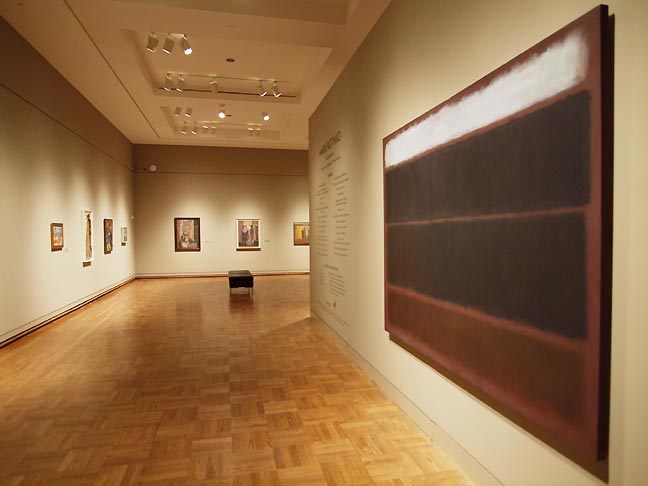 2012 Rothko retrospective at the Portland Art Museum (photo Jeff Jahn) School children should grow up knowing a great painter grew up here and though last years Rothko retrospective at the Portland Art Museum did accomplish those goals for a short time a more lasting acknowledgement, one that could also tell the story of how a young struggling Russian immigrant Jew and outsider who made good is a powerful thing. It is also a simple acknowledgement in a city of artists and designers that doesn't seek to do anything other than understand itself through its most accomplished resident. Portlanders have a hard time with greatness, so this is more a test for Portland than for Rothko. Overall, Rothko always seems to challenge and polarize people and in Portland this bridge has become a new way for us to reassess ourselves and examine what we value. *Note, Rothko was never arrested for public nudity when camping in Washington park... merely rousted by Portland Police for that reason. Posted by Jeff Jahn on November 07, 2013 at 1:00 | Comments (2) PermalinkMonday 11.04.13 Monday Links Billions in Nazi looted "Degenerate Art"... aka modern art has been found.
Arch Daily looks at the top light festivals and the way they activate cityscapes. FBC looks at the Mike Kelley retrospective. Seldom do museums put out internet content as intriguing as what the Tate has done here for Paul Klee. and last but not least here is Mike Rathbun's entertaining talk for his large scale show at the Archer Gallery. Posted by Jeff Jahn on November 04, 2013 at 0:58 | Comments (0) PermalinkFriday 11.01.13 Friday Links I've updated the both very popular and controversial post on the Rothko bridge naming. I see it as cutting a provincial gordian knot... so many (especially those who have been in Portland a long time) put a lot of effort into denying that the city's most famous and accomplished resident ever lived here or had any real connection. The sentiment doesn't hold up to the facts and illustrates why Portland has a hard time acknowledging highly ambitious people (provincialism). It is a good thing to get over.
What the demolition of Bertrand Goldberg's Prentice Women's Hospital in Chicago can teach us for the preservation of historic modernist buildings. ...apparently this Levis artist train non event was such an epic fail, that I'm only just now hearing about it. It is a good study in how not to promise an art extravaganza only to produce a series of video interview stump speeches. In case you haven't heard Chistine D'Arcy is out as head of the Oregon Arts Commission... "something" has been brewing for a while and the question is whether further changes would strengthen or weaken an already strong program? The arts community is very concerned because it doesn't seem to be driven by anything from the arts community (which means it is likely political... hmmm). Posted by Jeff Jahn on November 01, 2013 at 12:24 | Comments (0) PermalinkTuesday 10.29.13 Portland2014 list analysis The Portland2012 Biennial was a failure mostly because nearly everyone was in it except the most exciting group of artists in town (all associated with the alt spaces Appendix, Worksound or both), it didn't discover anyone new, it was in too many locations and was installed incredibly poorly at the two largest spaces (Art Gym and Disjecta).
The list for 2014 by LA curator Amanda Hunt should address some of those problems by including some of the scene's favorite practitioners who were noticeably absent last time but there aren't many women on this list: Zachary Davis (cofounder Appendix) Modou Dieng (founder Worksound) and Devon A. Vanhouten-Maldanado(Worksound) Alex Mackin Dolan (curator Appendix) ...(more) Posted by Jeff Jahn on October 29, 2013 at 13:04 | Comments (0) PermalinkMonday 10.28.13 Monday Links What else is there to write about Renzo Piano? The New York Times tries to
make his choice as the architect for the Whitney seem daring but nobody
can (though he is solid). The real problem is that projects like the Menil and the Beyeler
Foundation are intimate in a way that these larger museum situations will
never be and though always good he peaked a long time ago. Somehow the Whitney seems ok with that kind of statement about the museum's place in the world...?
Banksy has finally done something interesting, critiquing the utter failure of imagination that is the One World Trade Center building in an op ed that the NYT's refused to run (also interesting). True he's an attention whore seeking attention but writing, "That building is a disaster. Well no, disasters are interesting. One World Trade centre [sic British] is a non-event. It’s vanilla. It looks like something they would build in Canada." Deserves to be repeated and passed on. The passing of two giants, Arthur Danto and Anthony Caro continues to gather voices to mark their passing. The Portland Art Museum has a pretty extensive collection of Caro's work from the Greenberg Collection. Posted by Jeff Jahn on October 28, 2013 at 1:18 | Comments (0) PermalinkTuesday 10.22.13 Linkage How not to restore Qing Dynasty frescoes.
Ted talks and the Met lead to a whole lotta ugly. That said how is this any different than the sorts of things that happen all the time at museums? Perhaps it is the participation of the curators... but according to the article they provided the only useful stuff. New study suggest that cognitive ability has even less to do with inherited traits and more to do with intellectually stimulating environments... think culture. This entertaining article proposes that minimalism as a mode of fashion (it certainly isn't an art movement) has lead to a proliferation of antiseptic personal space for the collector class? It is true that whenever I do wince when I hear someone talk about how "minimal" their art, design choices or installation procedures are. I like to refer to it as, "the new fussy." Whatever it is called it does mean that the dead white room is very very dead. Posted by Jeff Jahn on October 22, 2013 at 10:26 | Comments (0) PermalinkThursday 10.17.13 Bridge named after Rothko? 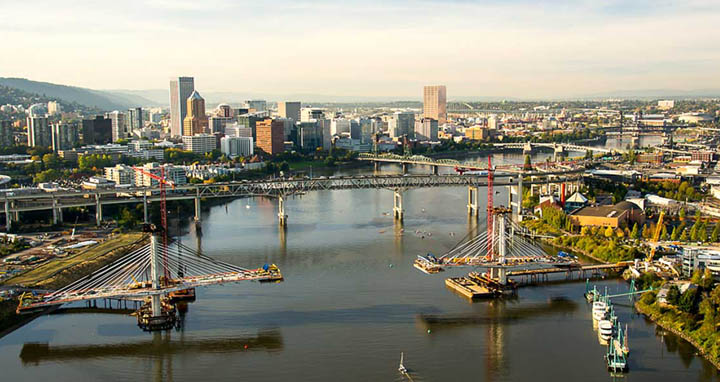
Trimet is taking public input for the naming of the exciting new transit, pedestrian and cycling only bridge over the Willamette. Sure, it could be named after a general or some politician but as I've mentioned before should be named after Mark Rothko, who is Portland's most famous son... and remains unacknowledged in any memorial within the city. The fact that he was a Russian immigrant Jew who rose to become one of the most consequential artists of all time should be enough but Rothko himself had quite a connection to the site as the western side of the bridge was host to numerous Jewish business and homes. He even painted the site and had a special fondness for mass transit... (more) Posted by Jeff Jahn on October 17, 2013 at 13:42 | Comments (1) PermalinkMonday 10.14.13 Monday Link This Monday there is just one link, Jerry Saltz on the problem with mega galleries. Jerry is pretty fair here and the main problem is understandable, the lack of constraints leading to a lack of edge. I liken it to the Frank Herbert Dune model. In that book the Fremen have to make the most of an incredibly inhospitable planet which sharpens them as a force, conversly the mega galleries do seem like foregone conclusions where critical debate doesn't even seem to matter (though this is a problem everywhere). It a done deal and that is the whole shape of the problem (though the case of Matthew Day Jackson does indicate that some shows are not too big to fail).
At the same time mega galleries are too easy a target. To me it seems like the mega collectors (who make mega galleries possible) are less about being patrons who wish to be challenged than simple trophy hunters. It is why I appreciate mega collectors like Eli Broad, the Kramlichs and the Papajohns. There is depth and a cumulative civic program to what they do but ultimately the best art comes when one patron decides to support an artist of infinite ambition, rather than one who already has infinite resources... kinda like when Peggy Guggenheim got behind Jackson Pollock or Gertrude Stein pitted the best of the best in civil competition with one another. Even Judd needed Heiner Freidrich and Philippa de Menil. I wish I could mention them by name (they seem to want to be low key) but I do really like what these collectors are doing with Doug Aitken. Overall, some artists like Richard Serra naturally work on a huge scale. For others it resembles Axl Rose's infinitely overproduced album Chinese Democracy, which was so far removed from what made Gun's n Roses work as a band. Posted by Jeff Jahn on October 14, 2013 at 9:27 | Comments (0) PermalinkTuesday 10.08.13 Kartz Ucci, a force for new media art RIP 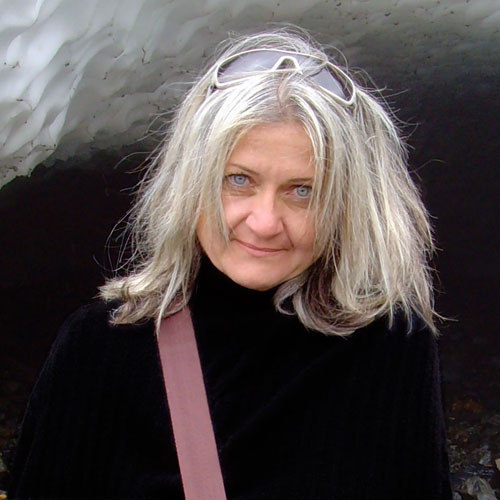 Kartz Ucci Installation artist and popular professor Kartz Ucci passed away Sunday, ending a recent battle with brain cancer. Kartz, wasn't a household name but she was one of the State of Oregon's most influential experiential artists... often using light and space, or the sensuous roll of words made sublime with form and color. I remember fondly every long conversation we had about Neruda or the way artists approach form differently in places like China. She wasn't some guarded regionalist and her overall level of "questioning sass" made her such challenging fun to be around. It showed in her work... ...(more) Posted by Jeff Jahn on October 08, 2013 at 11:54 | Comments (0) PermalinkMonday 10.07.13 Monday Links David Byrne has had it with the 1% stifling creativity. It certainly is true that the quality of patronage has gone down as the popularity of contemporary art has turned more into an investment than an avocation.
The Observer asks if the Frieze art fair is elitist? Short answer = Duh. Look, most things that involve money are elitist but the real question is how does forward the development of art patrons and institutional collections? Since it is a touchstone for London as an international art city it clearly has value. New York Falls back in "Love" with Robert Indiana... without a Love sculpture. Fine, but my all time favorite Robert Indiana is the basketball court for Kareem era Milwaukee Bucks in the old Mecca arena. Still it is interesting how one popular work could so overshadow an excellent body of pop work so thuroughly. Last but not least, check out this review of Matthew Barney's drawings at the Morgan Library. Posted by Jeff Jahn on October 07, 2013 at 6:08 | Comments (0) PermalinkFriday 10.04.13 Friday Links PNCA sells their current HQ building, partially as a way to fund the upcoming 511 project (a major upgrade). This makes sense, though initially the school had planned to operate both (which seemed excessive). Having a nexus of buildings along the North Park blocks is simply better.
Jerry Saltz on radical vulnerability... it ties a bit into an essay on art criticism that I am still editing (here is a bit of an appetizer). Roberta Smith on Chris Burden's retrospective at the New Museum. Posted by Jeff Jahn on October 04, 2013 at 11:36 | Comments (0) PermalinkTuesday 10.01.13 Tuesday Links How conservators saved Chris Burden's A Tale of Two Cities... a piece he wanted to blow up.
MoMA is beginning to explore how they will expand their galleries again. Ultimately though what always seems to draw the most attention is how it will effect the presentation of their canonical collection... something which ultimately puts of lid of conservatism over the boiling contents. Perhaps a non canonical installation is what is needed? Check out this great new time lapse computer rending of how Antonio Gaudi's masterwork the Sagrada Familia will be completed in 2026. What I most enjoy about this feat of architecture is the way it is taking longer than a single human life span to complete. Long range thinking and execution... not to mention jaw-dropping excellence is so rare on large civic scale projects like this. Jen Graves follows up her question in gender equality in Northwest Art Awards... One refinement to her argument though, several women have won a spot in the Contemporary Northwest Art Awards at the Portland Art Museum but no woman has ever won the Arlene Schnitzer Prize associated with it. Crunching numbers, 7 of the 16 CNAA finalists (the exhibitors) have been women. Looking at the Hallie Ford awards 5 of the 12 artists chosen have been women. The Bonnie Bronson awards though not gender specific do tend to go towards mid career females with only 4 male artists out of 22 being recipients. I do feel like there is a slight but pervasive advantage given to male artists in panel driven awards in the region but I feel this is a function of the arcane political nature of art panels (a lot, perhaps a majority of the most influential visual arts personalities in Portland are women). Even the the Couture Series (perhaps the best executed series in Portland history) gave more awards to men than women. Posted by Jeff Jahn on October 01, 2013 at 11:42 | Comments (0) PermalinkFriday 09.27.13 Friday Links Legendary art dealer Virginia Dwan gives 250 works (Smithson, Heizer, Andre etc.) to the National Gallery.
Mass MOCA and the Hall art foundation open a 10,000 sq ft space dedicated to Anselm Kiefer. Carrie Mae Weems (who grew up in Portland and had a great retrospective at PAM this last Spring) gives her current hometown Syracuse NY an indication of what winning a MacArthur will mean to her. A while back I participated in an article discussing why no Portlander had ever won a MacArthur? Technically this might not count but it is a moot point since nobody worthy of the award ever actually aims for winning it (keeping it from the political intrigues of practically all other awards). Portland Architecture discusses the minor miracle of saving a historic Portland home. Posted by Jeff Jahn on September 27, 2013 at 9:33 | Comments (0) PermalinkTuesday 09.24.13 News for Tues The karma wheel is turning as the artists who resigned from MOCA's board (John Baldessari, Barbara Kruger, Catherine Opie and Ed Ruscha) in protest of Jeffrey Deitch's leadership have been added to the committee to select Deitch's replacement. This is a good move but no replacement for similarly high profile artists on the museums governing board. It does however reiterate why MOCA is different than every major contemporary art museum in the country, it was artist initiated. It is a tradition worth upholding.
Sol LeWitt's music collection gets its own show. Jen Graves has noticed that the "Dudes" have been getting all the awards lately... what gives? Jen is putting together a more comprehensive piece on this and I do think there is a bias... but it come from the surprising way these panels work (mostly on personal connections, give me a jurors list and I can be pretty accurate as to who might win an award). Posted by Jeff Jahn on September 24, 2013 at 10:04 | Comments (0) PermalinkSaturday 09.21.13 2013 CNAA's and the winner is 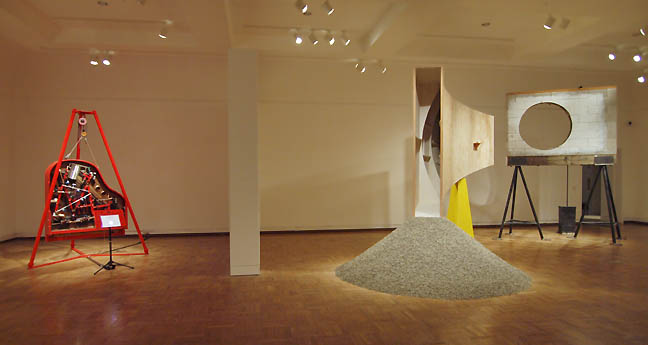 Trimpin (L), Burkheimer (R) at the 2013 CNAA's The winner of the 2013 edition of the Contemporary Northwest Art awards is... Trimpin (officially it is called the Arlene Schnitzer Prize and comes with 10K). It's a bold choice, in that the work is somewhat unremarkable (even compared to his other work) and the rest of the show holds some very solid if safe work overall. I'd say the show is mostly handsome if safe and narrow. 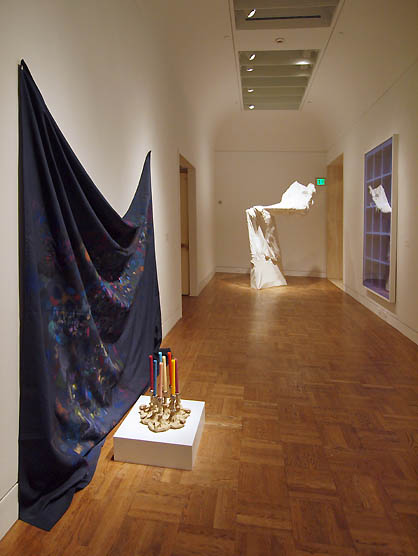 Another view of the 2013 CNAA's, (L to R) Nyland, Miller and Layman I'll have a more formal review out soon but let's just say this is the best CNAA to date (to paraphrase Jim Winkler's accurate statement)... even if it still doesn't feel like a true sampling of what it means to make contemporary art in the Northwest. It is a step in the right direction and very well installed (which no other Northwest survey show seems to be able to pull off). Posted by Jeff Jahn on September 21, 2013 at 20:05 | Comments (0) PermalinkFriday 09.20.13 Friday Links Iranian art is everywhere in the news these days, check out this review Barbad Golshiri's latest show in NYC. Sounds like an interesting show and an interesting role for art in an era with no formal diplomatic ties...
Portland Architecture goes looking at facades for its design symposium. Leo Berk is this year's Betty Bowen Fellow. In the top art non-news of the week, Eli Broad doesn't plan to keep giving 3 million a year to MOCA... which will take him off the top of the list as MOCA's top patron. There is no shock to this as that 3M per year life support was a 5 year arrangement now closing in on its 5th year. It also removes him from his perennial role as puppetmaster in the press... gee why would he not want to continue that??? Broad has his faults but being stupid is not one of them... he saved MOCA and in doing so shouldered responsibility for all of its failings while highlighting his own (not fun and kinda like the USA invading Afghanistan). This marks a new era when perhaps LA can support its best institutions without asking Broad to do more than his fair share? It was a thankless job, but necessary and hopefully everyone has learned from the mistakes. Posted by Jeff Jahn on September 20, 2013 at 11:34 | Comments (0) PermalinkMonday 09.16.13 Monday Links Glafira Rosales, a former art dealer pleads guilty to selling fake Jackson Pollocks and other artists to the formerly ultra respected Knoedler Co. art gallery.
The Dallas Morning News actually ADDS an art critic. A retired museum director no less. Question is whether anyone can actually start their career as an art critic and remain one for decades anymore? Of course Pacific Standard time was flawed... as Christopher Knight points out. It had to be. In many ways all surveys are a portrait of the institutions that put them on (not news but it is worth repeating). I like the idea of a fake archeological dig as art very much. This could be taken a great deal farther. Posted by Jeff Jahn on September 16, 2013 at 16:25 | Comments (0) PermalinkMonday 09.09.13 Monday Links "The system is the work of art; the visual work of art is the proof of the System. The visual aspect can't be understood without understanding the system. It isn't what it looks like but what it is that is of basic importance." -Sol LeWitt
Happy Birthday Sol LeWitt... born this day in 1928 thank you for bucking "the system." BTW 1928 seems to have been a particularly good vintage as other artists like Robert Irwin, Andy Warhol and Donald Judd were also born in that year. Perhaps it was the resourcefulness that comes from growing up in the Great depression as your earliest memories? Chris Burden is going to have a retrospective at the New Museum this Fall. We interviewed Burden a few years ago. Artists grapple with technology and surveillance. Moscow Biennial curator tries to rationalize why Russia should not be culturally boycotted for draconian anti gay laws. I agree there is a danger in isolating a country completely but at the same time I wholeheartedly agree that the international community should hang it like an albatross every time Russia is mentioned. Will it hurt Russia culturally... YES. Not certain how I feel about the curator's description of the 21st Century as not being about provocation... if anything it seems less tolerant of intolerance. Posted by Jeff Jahn on September 09, 2013 at 10:05 | Comments (0) PermalinkMonday 09.02.13 Monday Links Ursula von Rydingsvaard's Ona is installed at the Barclay's Center.
Art takes on capitalism. "Rough-hewn" space (with jet engine and naked man) is the latest addition to British establishment art spaces. A sneak peek at Brenna Murphy's show at YBCA. Posted by Jeff Jahn on September 02, 2013 at 21:42 | Comments (0) PermalinkFriday 08.23.13 Friday Links We will have more Venice coverage later for you Saturday (photo posts take a lot of work) with some epic reviews and interviews next week till then here are some links:
I've long felt that artists of all sorts need to pay more attention to neuroscience... here is a serious read on the nature of consciousness. What to do with DC's old library by Mies? Portland photographer Christopher Rauschenberg is caught up in the difficult task of sorting out his father's estate. Chris, man... don't let it get you down, it is just a distraction of course. To most people's eyes this seems like such a greedy, petty thing (a lot of family's go through this but few end up in the New York Times). Let's not dwell on the negative news... the new Captiva residencies the Rauschenberg Foundation have ushered in are exciting. Check out these larger scale architectural installations made of wood. Posted by Jeff Jahn on August 23, 2013 at 11:31 | Comments (0) PermalinkTuesday 08.20.13 Hirst's Castle 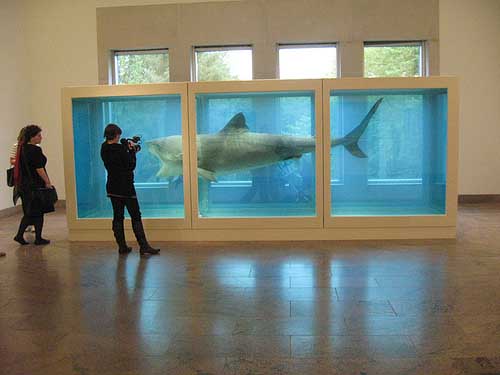 Damien Hirst's Shark at the Met Hyperallergic has a nice bit on Damien Hirst's new studio and gallery called Science. To me the clinical white spaces are almost a caricature of Chelsea gallery spaces and that is what is interesting here (and I suspect that is part of Hirst's lasting importance... his shark is a brilliant caricature of the art presentation experience). Will this be a kind of punctuation point that marks the end of an aesthetic for presentation of art? Possibly... I do expect it will go on for many hundreds of years since so many new museums have been built in the same style. Still, I wonder what else could be on the horizon... earthen huts, goats grazing atop galleries, termite designed museums or that antidote to science... a wizard's tower? Maybe just a pile of money? I'm still a big fan (mostly the early stuff but the diamond skull too) but can Hirst pull a Judd? Posted by Jeff Jahn on August 20, 2013 at 11:39 | Comments (0) PermalinkMonday 08.19.13 Monday Links Brian Libby surveys an exciting new project, Union Way... whose design creates a handy new street between the Ace Hotel and Powells books.
ArtFCity had a great roundup of the Day For Detroit posts last week (I was taking an internet break). Overall, it a deplorable situation where the public could be swindled of their cultural patrimony. Everyone is watching this. RACC is assessing and restoring 3 iconic public sculptures, including Portlandia. Posted by Jeff Jahn on August 19, 2013 at 12:15 | Comments (0) PermalinkTuesday 08.06.13 Linkage Graffiti artists are incensed that their work was taken down to make room for gentrification graffiti for last year's Olympics in London.
A High School in Sandy is being recognized nationally for excellent design. I'm impressed... I gotta see this. Art Critical discusses Orly Genger's art intervention in a Manhattan park. The Brooklyn Rail discusses early Richard Serra and his connection to Bruce Nauman. Bloomberg weighs in on the unethical idea of pillaging Detroit's art treasures (held in public trust) to make token/insignificant dents in the city's debts. A James Turrell comic. It is an slightly older interview but Dan Cameron discusses the Pacific Rim biennial and proffers the idea that unless such a show is international it shouldn't be considered a bienniale. I see the argument for that as shows that don't cross borders (or cover a huge # of cities)tend to reinforce those borders and often fall into a role of using the art to ingratiate the institution upon the art art scene... rather than fostering a broader intellectual sense of investigation or being a prompt for curiosity. Basically, if it is too small... say 1-3 major cities it just becomes a small town affair mired in local tropes and politics (Portland 2012 Biennial, 2011 CNAA's). It stops being about the art and it is important to juggle and question the modalities rather than simply present accepted wisdom. Biennials typically fail when they become a predictable cavalcade of the already over familiar. Posted by Jeff Jahn on August 06, 2013 at 13:16 | Comments (0) PermalinkMonday 07.29.13 Monday Links We will have Part II of our Venice coverage coming shortly but till then here are some good stories:
Not surprisingly, Roberta Smith thinks Robert Irwin's scrim piece at the Whitney is the yardstick to measure all other light and space art. I have to agree on Irwin being the best of the lot. Overall, I've experienced in Irwin's work a kind of art that invites the mind to push its perceptual acuity. It is extremely generous, whereas with Turrell, Wheeler etc... I always get this sense of pageantry in production (which is fine, just not my preference). The pageantry is often there with Flavin as well but at least with his work the use of very mundane light fixtures strips away the focus on production values the closer one gets to it. Overall, it bears repeating that Irwin is also the most intelligent human being I have ever met and the only art world denizen art world that can crack my top 10 (art isn't always about intellect... it is about perception, which sounds a lot like something Irwin would say). Basically, Irwin's work allows the viewers greater room for processing, whereas those like Wheeler and Turrell present a more pre-processed experience that owes more to stagecraft. The unexpected Francis Bacon and Henry Moore connection. Katherina Fritsch gets more than a little "cocky" in London. The New York Times is pretty much making it official... it is the summer of Carol Bove. I've always liked her work but it has always had a slightly "curator art" aspect to it.... ie its strategies directly and indirectly point to the "moves" that curators routinely make when installing work. This turns it into a kind of institutional feedback loop, but the recent installation in the unfinished portion of the Highline seems to turn a corner... call it "developer art." The Highline installation seems to tap the palpable real estate potential inherent on the site... which positions Bove's work as a kind of advance survey party. Still, I'm pretty certain it is not some kind of art world Lewis and Clark expedition. For comparison, decades ago Gordon Matta-Clark with his Fake Estates and activities in Soho and Chelsea seems make Bove's worthwhile project appear like a somewhat quainter "reservations only" preview. Posted by Jeff Jahn on July 29, 2013 at 10:01 | Comments (0) PermalinkFriday 07.26.13 Free Friday Night at Portland Art Museum 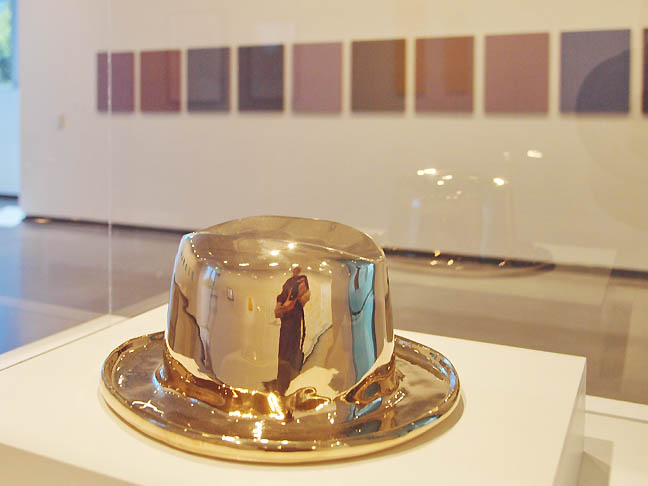 Sherrie Levine at PAM It is the Fourth Friday of the month, which means that the Portland Art Museum will be free from 5:00PM - 8:00PM. It is hot and sunny so what could be nicer than a stroll through the park blocks before or after dinner and a lingering dash into the big art fort? The Sherrie Levine show is gorgeous, the best presented art exhibition in Portland for 2013 to date. An Ed Ruscha exhibition and the wonderfully designed Cyclepedia exhibitions are also must sees. Posted by Jeff Jahn on July 26, 2013 at 13:51 | Comments (0) PermalinkThursday 07.25.13 Walter De Maria 1935 - 2013 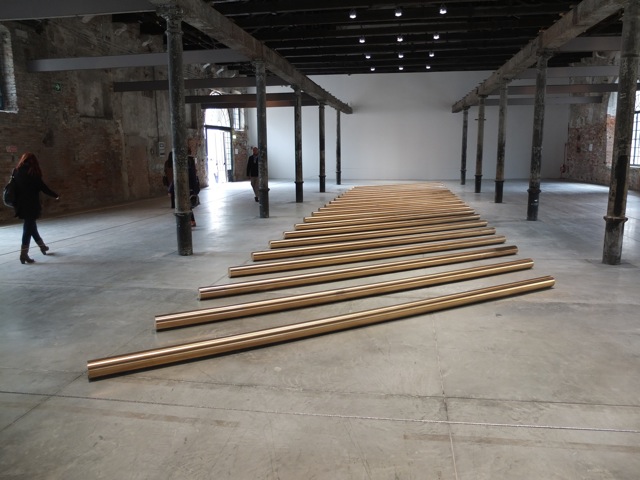
Walter De Maria's work in the 2013 Venice Biennale (photo Mack McFarland) Walter De Maria, one of the great artists of the 20th Century has died. Logically, he will be known for his greatest works such as The Broken Kilometer, The New York Earth Room and The Lightning Field but many who focus on them will miss the intensely deadpan humor you can see in works like High Energy Bar and Certificate in MOMA's collection. In many ways his works operate like games that have no discernible rules for playing them and are prime examples of Post WWII art that sought drain themselves of metaphor. This dislike of metaphor likely sprang from the intense use of it by the Nazis to seize power... and then the adoption of it into cold war schisms. There is a strong thread of Dada in so called minimalist works. Think of it as an oblique objection rather than an object. Also, I've been to several of his land art pieces and the relentless sublime only adds to the existential humor... a bit like getting lost in the wilderness while getting lost in the art. De Maria was also a composer and you can listen to his two best known pieces here. Last week PORT published an interview where Marc Treib and I discuss his work (among other things). I will update this post as info develops. *Update: The Dia Foundation confirms via tweet and here is the official New York Times obit. Posted by Jeff Jahn on July 25, 2013 at 17:50 | Comments (0) PermalinkMonday 07.22.13 Deitch out 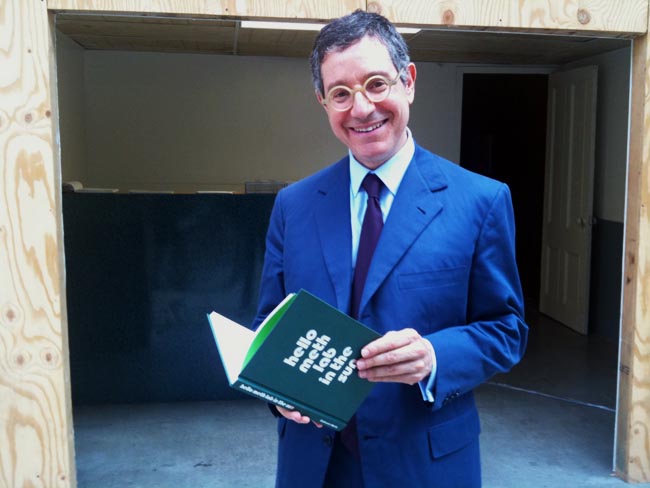
Ex MOCA Director Jeffrey Deitch Apparently Jeffrey Deitch has left MOCA and it looks like I was correct in predicting the embattled director would be out of the museum some around June 30th. It was a common sense prediction when major fundraising initiatives were being met without Deitch delivering the news. An official statement should be coming very soon. Honestly, I admire Deitch as a gadfly who challenged the academic and art world status quo but his skills did not synch up well with MOCA's challenges, which required a healer. Both will be better off without one another and I wouldn't be surprised at all if he quit the job. The art market is Deitch's ultimate stage. Here is a timeline of the MOCA crisis of 2013. *Update, we were one of the earliest to report this, now LA Weekly has confirmed and The LA Times indicates he indeed is choosing to leave the museum as they are about to reach certain key fundraising goals. Posted by Jeff Jahn on July 22, 2013 at 22:24 | Comments (0) PermalinkMonday Links The New York Times was obsessed with outdoor art this weekend with not one but two fine articles. Tis the season.
Is Australia's 2.5 year old art royalties law benefiting indigenous artists.? It sure looks like it. For some reason the USA never ever considers this but as auction prices surge, even for living artists... it makes sense. The Brooklyn Rail does its annual summer reading list. Posted by Jeff Jahn on July 22, 2013 at 14:28 | Comments (0) PermalinkMonday 07.15.13 Monday Links Tyler Green reports that the Dia Foundation's three founding members have now publicly come out against the sale of works to fund expansion in Chelsea. This is very significant as the works that are on the chopping block are not minor pieces but works that would be the star of any collection. True, the Dia needs to remain an active and supple catalytic type of arts organization (one that made the Lightning Field and earth room possible) but auctioning off master works isn't the right way to accomplish this. The Dia, like many art nonprofits with a collection is somewhat a victim of its own successes... but let's take this as a time to reflect upon what is at the core of that success, Dia's respect and ongoing support for the intention of the artist that avoids engaging art as commodity at all costs. Historically, the Dia Foundation was the cultural organ that allowed less commercial forms like Land Art take form in middle-late 20th century. Turning its back on this tradition to have a greater physical presence in Chelsea is simply not a good idea. The Dia should fundraise for such physical plant expansion (if necessary) and look for ways to perpetuate the alternative space practices it pioneered in its golden years... rather than replicate Dia Beacon in Chelsea. New York needs the Dia as a catalyst with a history of integrity rather than yet another museum, forever serving its endowment.
Holland Carter reviews California's "State of Mind" at the Bronx Museum but the title also does something as odd as it is "familiar" by stating it is "Not Laid-Back." Well that is a start (the Paul Kos piece was exhibited in Portland last year at PNCA's Feldman Gallery). On the West Coast we get this all of the time from East Coasters. Look, our weather IS generally better but that doesn't mean we are always sunbathing. Having grown up in LA in the mid 70's to early 80's I can vouch for it having never been laid back. True that's what East Coasters did while vacationing but don't confuse the vacation experience with what the natives are doing (inventing world changing personal computers in their garages, pursuing scientific breakthroughs as well as hustling the next great fitness craze). This applies to Portland too, which is frequently described as very "chill" by East Coast publications. In my Portland Tribune Op Ed last year I laid out pretty clearly how there is an intensely moralistic style hedonism at work here that borders on the epicurean if it weren't also concerned with reinventing big picture way that Americans live. The real issue is the fact that places on the West Coast like LA and Portland are often the trendmakers and New York lost its monopoly status way back in the 60's. West Coasters didn't move to California and Oregon Territories because they were lazy and wanted it easier and more relaxing... they came here for freedom and opportunities and thus we should never be surprised when West Coasters are free thinking and opportunistic. Can we move on now? Carbondale Illinois rediscovers a long lost Frank Lloyd Wright masterpiece. Posted by Jeff Jahn on July 15, 2013 at 10:19 | Comments (0) PermalinkMonday 07.08.13 Monday Links We've still got all of that content that was backed up in June heading your way (PORTsters tend to travel during the J months), just hold tight. Till then here are some links.
Peter Plagens asks if art schools can remember the "Great Unmentionable"... TALENT. He rightly points out where some pedagogy devolves into group therapy and how the old fashioned way doesn't work either. In many ways I see art schools as victims of their own ubiquitous success in the art world... spawning a mandarin, "Im ok, you're ok we are all ok," world that just looks for a cursory justification. It is fine but Ive also noticed how every single artist who has achieved lasting relevance has avoided academic group think. Even Beuys (who arguably set this new academia based on relativistic research in motion with his kind of earnest/sham hagiography) was an outlier by design at the Dusseldorf Academy where he was eventually dismissed. Without that tension of being outside the institutional stamp of approval he would not have mattered. What to do then as an artist...? Don't buy into the idea that an art institution actually defines what you or your work, while simultaneously not believing your own internal monologue or clique dialect of peers. Overall, talent is a bit of a misnomer... instead of describing raw ability, it is a kind of perpetual unease, which in certain individuals/groups leads to deeper understanding and facility. Others just tear themselves apart or embrace a kind of mediocrity... not because they are bad or have no talent but because they are simply too satisfied. I've found that all exceptional artists (Beuys, Judd, Smithson even 90's era Damien Hirst) are also exceptionally talented at critical thinking in their own idiomatic ways and it is why descriptive art writing doesn't get artists over the hump of mediocrity. In short, never believe your own spiel. The Guardian has a review of Hans Ulrich Obrist's never ending Do It series in England. Christopher Knight reviews the Pacific Rim show at OCMA. Noticeably there isn't a single representative from Portland (which has arguably the most active art scene north of San Francisco). I don't blame the curator Dan Cameron that much though, Portland's scene looks bland (or at least redundant to Seattle as far as home grown talent goes) at the institutional and gallery levels and only takes off in the hyperactive alternative spaces (Plagens reported on the alt scene last year). Without a guide one isn't likely to find it. In other words local curators and galleries need to step up their game in presenting relevant artists rather than a bland regurgitation of the idea that Portland art is purely/stereotypically craft and forest obsessed. We can't expect others from outside to see us as we really are if all we do is present unchallenged stereotypes. This may piss some people off but my argument is very sound. Our awards, museum shows and gallery offerings should be challenging accepted ideas rather than pandering to already held beliefs... especially since so many Portlanders merely write off the local infrastructure and jump directly to the more merit based international stage. In short, there a schism that needs addressing locally before those elsewhere can be expected to register it in large scale survey shows. Posted by Jeff Jahn on July 08, 2013 at 10:21 | Comments (0) PermalinkTuesday 06.25.13 Idea links Should all Venice tourists pay $40 to help deal with that sinking problem?
Christopher Knight discusses the merits of lifting the ban on LA murals on private property. Video of James Turrell discussing his show at The Guggenheim. Yeah he's still like a very brainy Wilford Brimley. Jane Harris discusses countermeasures for NYC's gallery tedium. Posted by Jeff Jahn on June 25, 2013 at 9:21 | Comments (0) PermalinkFriday 06.21.13 Frank Lloyd Wright Links Frank Lloyd Wright would have been 145 this month. Also, his fantastic Marin County Civic Center has turned 50 years old as well and you have never seen it like this before (ie a spaceport in the Star Wars Universe):
Here are some classic pictures of Frank Lloyd Wright's Johnson Wax research tower, which is now undergoing a two level restoration. Posted by Jeff Jahn on June 21, 2013 at 11:27 | Comments (0) PermalinkMonday 06.17.13 Monday Links We've got one of our classic June log jams of content for you with no less than four major pieces coming your way in the next two weeks. The first should be here soon (it involved a lot of geological maps etc. to double check). Till then here are some links:
Indoor fracking installation creates debate in London... gotta love how Londoners are willing to debate about fracking themselves indoors. Occupier protesters at Basel are forcibly evicted from an Art Favela installation. How James Turrell knocked the art world off its feet in the Times. Still this re-installation at the Whitney illustrates why I will always choose Robert Irwin over his one time friend Turrell... there's less magician's showmanship and far more content. Posted by Jeff Jahn on June 17, 2013 at 9:07 | Comments (0) PermalinkFriday 06.14.13 Friday links We've got a fantastic major art historical essay for you soon but to tide you over here are some links:
In Basel, artists like Huang Yong Ping are responding to a world of conflict... by recreating Bin Laden's final compound. This is one of Ping's best efforts. I really like how Painting in Place is literally repositioning painting. Obviously this is nothing new (is it ever in painting?) but it seems to be a bit of pushback against the market and the sometimes nagging feeling that the art world has disengaged itself from the rest of the world. We should do this in Portland, bank presidents check your walls... I'll be calling. Michigan's Attorney General opines that Detroit's public art collection held in trust by the museum can't be sold to settle the city's debts. This isn't over yet but this condition of being held as in "charitable trust" for the public is a key argument. I like how the British can give some guff to their visual art world without being threatened... here's a cartoon featuring Jeremy Deller and most of the figures from British history. PORT is actively seeking a cartoonist BTW email me at Jeff (at) Portlandart.net. Posted by Jeff Jahn on June 14, 2013 at 10:06 | Comments (0) PermalinkMonday 06.10.13 Monday Links Jerry Saltz is in LOVE with the Met's new rearrangement of its European painting galleries. To tell the truth I kinda enjoy getting completely lost whenever I go to the Met and I love Jerry's bit about so many museums creating galleries that make you smell the foodcourt.
When an early internet art piece's archaic code no longer works is the piece compromised if it is brought up to the new standards? Since the internet is in many ways an active performance venue whose rules make its inter-netting possible I think it is ok for now. When the internet is repaced by something else I think that update might be a far thornier issue. As it stands there are still people playing Zork on various platforms but it was a game not an art piece. Edward Winkleman and Elizabeth Dee on the place of mid level art dealers in the world of the megadealers. Posted by Jeff Jahn on June 10, 2013 at 2:11 | Comments (0) PermalinkTuesday 06.04.13 Sunny Southern Links Adrain Searle gives his review of the Venice Biennale. I make no secret that I prefer the more unvarnished edge of British arts writing (it IS where I got my start) and there is always something classic about the British take on Venice.
Then there is the huge Miami Convention Center design competition pitting Rem Koolhaas' OMA team vs. BIG. To these eyes it is OMA's stunning integrations of indoor/outdoor park spaces and creative parking/shipping solutions that sets it apart. Art Basel Miami Beach would be so much more enjoyable with such interplay. The current and very old school design makes visitors feel like rats running a maze. Benjamin Sutton kicks off part one of a five part series on light and space art with a look at the current leaders in the field. ... and the Huffington Post wraps up their Venice blogging with some parting remarks. Posted by Jeff Jahn on June 04, 2013 at 13:05 | Comments (0) PermalinkThursday 05.30.13 2013 Hallie Ford Fellows Congratulations to Mike Bray, Cynthia Lahti and D.E. May who are this year's Hallie Ford Fellows. Seems like the Ford Foundation heard some of the criticisms we brought to light this year.
For example, Bray is a multimedia artist and both May and Lahti (in addition to Bray) are actually producing the best work of their careers. I don't think of any of them as being academicians at all though Bray does teach at the U of O (a criticism I and many others noted). One should also note that all three have gallery representation... something the first three fellows did not have but has become typical in the last 3 cycles. Lastly, one could debate Bray being a mid career artist (I sat on his thesis review panel) but that's always an incredibly tricky distinction. Looking at the press release "craft" was once again a major criteria, nothing wrong with that but craft does not define all contemporary art and the little bit about Bray from the jury, "There is fine craft aesthetic underpinning his work, something often underplayed in the digital field." seems like they were trying very hard to justify a multimedia artist who actually uses digital media as craft. My position is that there is craft in practically all good, object based work and digital mediums have a great deal of craft in them as well. Panelists included: Dr. George Baker, Professor of Art History, University of California, Los Angeles (Los Angeles, CA); Lawrence Fong, recently retired as Associate Director & Curator of Regional Art, Jordan Schnitzer Museum of Art / University of Oregon (Eugene, OR); Clara Kim, Senior Curator of Visual Arts, Walker Art Center (Minneapolis, MN); Lawrence Rinder, Director, Berkeley Art Museum and Pacific Film Archive, University of California, Berkeley (Berkeley, CA); and Prudence Roberts, Art History Professor, Portland Community College, and independent curator (Portland, OR). The Lumber Room will showcase a selection of work by the 2013 Hallie Ford Fellows in the Visual Arts. A public viewing of the work will be held one weekend only, June 28 and 29, from 12 - 5pm, located at 419 NW 9th Avenue. Posted by Jeff Jahn on May 30, 2013 at 10:25 | Comments (2) PermalinkTuesday 05.28.13 Tuesday Links Here are some straight forward answers about what can and cannot happen to works that are owned by the Detroit Institute of Arts. Once again, selling works of art held in trust for the public to make token stabs at financial obligations is just a bad idea. Detroit's problems are larger than any art sale could satisfy.
Also in Detroit, MONA is putting on its own Documenta in an attempt to "void" all museums and "prove" them "invalid". Good luck with that, I think most institutions struggle to validate themselves rather than invalidate others. Nice to see some pretty ballzy language from an institution for a change though... Brian Libby interviews Sergio Palleroni on the creation of PSU's groundbreaking Center for Public Interest Design. This sort of advocacy/think-tank program is precisely what Portland had been missing for the past 50 years and it could become incredibly important for the next 50. Jerry Saltz makes a great case for Jeff Koons as an artist. Dont let the success fool you... Koons is for real and that is the part that is worth freaking out about. Christopher Knight on James Turrel's retrospective at LACMA. Don't get me wrong, I think Turrel is a great artist but his woo-woo religious overtones always put me off. It comes off as a salesman's spiel... and not unlike Wilford Brimley talking about oatmeal. Basically, Turell always seems to be selling you something. That and I seriously doubt a crater of a volcano can be improved upon... for those reasons I'll always prefer Irwin and Wheeler. When you talk to Robert Irwin, he isn't trying to sell you a bridge... you've got his full attention. Posted by Jeff Jahn on May 28, 2013 at 10:44 | Comments (0) PermalinkFriday 05.24.13 Friday links Detroit puts everyone on "don't sell the collection to pay city debts" watch. I don't think that is what is happening here but everyone IS on watch.
Tracey Emin on getting older in the NYT's. Her confessional work is JUST as influential as Hirst's and moreso than say Gary Hume. It's largely responsible for the crafty confessional trend in contemporary art since the 90's. Actually, I'm a huge fan, though I don't want to be. You have probably heard that Paul Schimmel joins the mega gallery challenge to the role of non profit museums. That might sound like something new but onetime it was the gallerists like Viginia Dwan, Leo Castelli, Kahnweiler and Betty Parsons whose advocacy created the context that are now the life blood of museum blockbusters. Perhaps mega gallerists are returning to that role? What's more Schimmel is staying in LA too, which is such a win win for that city. Posted by Jeff Jahn on May 24, 2013 at 13:00 | Comments (0) PermalinkMonday 05.20.13 Monday Links Anish Kapoor thinks Britain is "fucked" because it spends so little on Art and education. He also shoots his cannon off in Berlin for his latest show.
Why the market isn't the best judge of Art. This is also why we require art critics who cover a beat and write reviews that are critical, not just better executed restatements of the press release. We do that here at PORT and it is quite rare. Tyler Green has 10 thoughts on the new David Chipperfield addition to the Saint Louis Art Museum. I like Chipperfield's work but Ive never been that impressed with his museums. Somehow they seem to play it a bit too safe (which probably isn't so much a reflection on his firm's work as the boardroom of his clients). However, his library in Des Moines is fantastic and understated while retaining an exciting rawness. Posted by Jeff Jahn on May 20, 2013 at 12:37 | Comments (0) PermalinkWednesday 05.15.13 Congrats to Alex Mackin Dolan 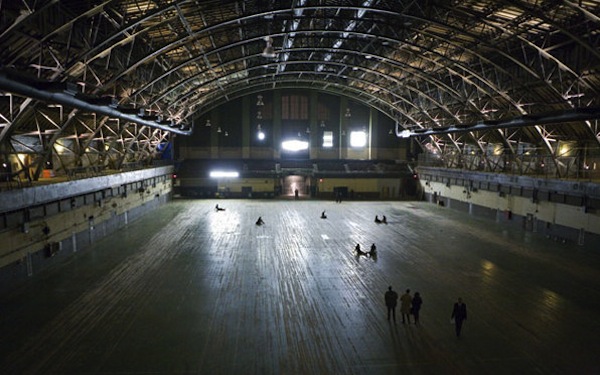
Park Avenue Armory (photo James Ewing) Congrats to Alex Mackin Dolan who was just awarded a residency at New York's immense Park Avenue Armory. In fact, he is the residency's first visual artist... others being mostly performance based. Once again, clear evidence that Portland's art scene is producing sharp new artists that one gets to see develop in very cool, low key alternative spaces... who then completely leap frog the very conservative local-ennials, institutions and awards to end up on the international stage. Dolan has also been curating Appendix, one of Portland's hippest alternative spaces (often Appendix is more experimental than fully realized but I like the risk taking it engenders). Only just recently in the past year or so has Alex really found his voice... harnessing the design language and cognative projections accrued around the idea of purity (which should be a huge challenge to evoke in that space). In other words, local curators who are not going to alt-space shows are hopelessly out of touch with a scene that is among the most dynamic on the planet. Mackin is just one of perhaps 15-20 hard core like-minded artists in perhaps 2-3 interrelated cliques who harness, interrogate and redirect design's cognitive/perceptual implications. All have a very international outlook and Alex is one of the youngest. I keep saying it, use Portland as a rebel base. Posted by Jeff Jahn on May 15, 2013 at 11:00 | Comments (0) PermalinkMonday 05.13.13 Monday Links Paul Goldberger asks if the new World Trade Center construction can fill the void? He's right that none of the buildings being put up are all that noteworthy on their own and it is a shame that Libeskind did not get to do the signature tower. To me the failure to do something truly inspiring was the exact moment that I realized New York had lost its edge over all other cultural cradles. In fact, I think it is harder to be great there now... not that it isn't possible... just harder (which isn't always a bad thing).
Hyperallergic thinks that the NADA art fair has grown up. That sounds like a good thing but is it? That is just a question that I don't have an answer for yet, ask me in a few years. Gavin Brown on why the art and fashion world do and don't "get" each other. My theory is that they are too close... almost like sibling rivals for cultural resources and attention. They often need a cousin like music stars as an intermediary (David Bowie would be THE greatest of them all). Art Info on the success and failure of Gutai. The recently closed exhibition on the mercurial movement was the best thing I saw in New York last month. Why? It had a freedom and willingness to try new things that seemed utterly missing in most of the galleries. Saul Osterow's excellent essay on Tedd Stamm and Alan Uglow's paintings is a good read. His focus on the importance of difference and intuition is key to understanding this sort of work, Stamm's show at Boesky was fantastic and one of the highlights of my recent visit to Chelsea. Posted by Jeff Jahn on May 13, 2013 at 11:56 | Comments (0) PermalinkTuesday 05.07.13 The Henry announces The Brink finalists 2013 The Henry just announced the finalists for The Brink Award, which is "designed as an award for emerging artists 35 and under in Washington, Oregon, and British Columbia on the "brink" of a professional career." Of all the art awards and "spotlight shows" in the region it is the only one that is focused on early career, progressive art in a setting that actually highlights the small # of artists chosen... something other awards seem to eschew for mid career work and a blind eye for new media and installation art (often with a taste for cluttered installations of the work when exhibited).
There are 3 Portland area artists nominated (Saxon-Hill, Halverson and Warren)... far better than the Contemporary Northwest Art Awards, which for the past 2 cycles has focused on mid-career, traditional material Portland artists (which is strange considering that Portland arguably has the most dynamic art scene in Oregon/Washington bringing new names with international reach all of the time. Another plus, The Brink includes British Columbia, acknowledging that Cascadia is an international art zone that crosses borders rather than an insular regional self congratulation society. The 2013 finalists are: Raymond Boisjoly, Vancouver, B.C. Anne Fenton, Seattle, WA Rob Halverson, Portland, OR Sylvain Sailly, Vancouver, B.C. Blair Saxon-Hill, Portland, OR Nell Warren, Washougal, WA "For the 2013 award, 47 nominations were received from a group of art professionals across the Pacific Northwest. The 2013 Jury is comprised of Vancouver artist Althea Thauberger, Pacific Northwest College of Art MFA Program Chair Arnold Kemp, and Henry Deputy Director of Art and Education Luis Croquer. The jury completed the review of artist submissions in early May. Jurors will conduct studio visits with the finalists late this spring. The winner will be announced on June 7, 2013. The Brink Award was established with the generous support of longtime Henry benefactors and Seattle philanthropists John and Shari Behnke. In partnership with the Behnkes, the Henry will confer this biennial prize of $12,500 to one of the above artists. The recipient will also be given a solo exhibition at the Henry, a publication, and a work of his/her art will be acquired for the museum's permanent collection. The Brink is in its third biennial cycle. In 2009, the Brink was awarded to Isabelle Pauwels, Vancouver, B.C. and in 2011, to Andrew Dadson, also of Vancouver, B.C. The Brink Award complements the Henry's role as a catalyst for the creation of new work, while simultaneously demonstrating the museum's commitment to artists working in our region." Posted by Jeff Jahn on May 07, 2013 at 15:13 | Comments (0) PermalinkMonday 05.06.13 Monday Links Artist statements are generally the absolute worst application of written language imaginable and Hyperallergic looks into this linguistic quagmire. Thing is writers are just as guilty of buying into their own words, it is just that their peers will actually read and ridicule them for their crimes against communication. Let's face it writers are like piranha. Not so for artists, even the ones who can write generally find a supportive group of friends who want to applaud their rare linguistically gifted ally. Thus the bar is simply very very low. Hell, even curators seem to have about a 60/40 chance to producing vocabulary in search of insight. Yet, in defense of artists actually making statements, most of the greatest artists and curators were masters of the words they employed. Judging from; Picasso's one liners, Kandinky's aspirations, Judd's specificity, Smithson's slyness and Komar & Melamid's comedy all hold up even if you dislike their art. Generally the biggest problem with artist's statements are they are forced, tortured wraiths of ideas that telegraph their intended targets (hidden behind favorite vocabulary) rather than proffer any insight into what they have presented. (Smokescreens!) Generally it is better to let the statements come from the process and not let a word lead the work... it makes you sound like a recent MFA grad, which is SO art school. Tip, distill a few very short stock epithets you can whip out and develop an essay around them only after using them for a long time in social settings.
Drama over Munch Museum in Norway... of course. Posted by Jeff Jahn on May 06, 2013 at 11:54 | Comments (0) PermalinkFriday 05.03.13 Friday links, California architecture edition PORT has a large backlog of interviews and other articles for you real soon (starting this afternoon) but till then here is a glance to the South.
It looks like A New Sculptualism, a show about recent California Architecture at MOCA is on the verge of cancellation. (check out Thom Mayne's courthouse in Euguene for an example) It also puts Deitch back under the microscope, one which has pretty much paralyzed the past 12 months of his directorship. Sure it looks like MOCA is getting out from under the funding quagmire it has faced for over a decade but it also highlights how reliance on outside curators due to a depleted staff has truly gutted the West Coast's most important contemporary art institution. Put it this way, if a curator isn't tied to the minute internal plumbing of an institution, weird things like this happen... especially if the director has been heavy handed. Though I admire him as a gadfly gallerist, I still expect Deitch to leave MOCA around June 30th. Also, because we are all sick of this I'm calling it Deitchwatch and it is a lot like watching Hasselhof run in slow motion in the sand, only the Hof puts on a better show.  (c) SO-IL, UC Davis Art Museum design In more upbeat news UC Davis has unveiled a truly exciting new art museum design by SO-IL. Where else but the stomping grounds of the light and space movement should there be an art museum that looks more like a garden than a concrete, metal and marble bunker? They have been doing a lot of similar things down in South America but this is the first art museum I've seen with this kind of scheme. I think everyone is pretty sick of the traditional white box that shuts out the world. Posted by Jeff Jahn on May 03, 2013 at 6:22 | Comments (0) PermalinkTuesday 04.30.13 RACC responds to budget cuts 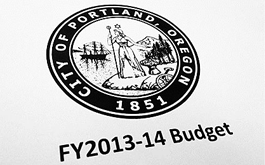 RACC, Portland's regional arts granting organ has published a letter responding to the proposed 10% cuts of funding from the city. In these severe budget shortfall times it does seem appropriate that everyone do some belt tightening. One thing I noticed was RACC is prepared to, "Suspend the under-utilized Opportunity Grants program for one year (a savings of $200,000"... this raises eyebrows. Why are there a disproportionate amount of cuts all from one area? An important one at that? At first I thought these were individual career opportunity grants (vague language clarified after a phone call to the ever helpful Jeff Hawthorne) but instead these are the Special Opportunity Grants available to institutions. These are the grants that funded major special exhibitions like Donald Judd in 2010 and in 2009 were used to keep many art institutions afloat during the depths of the great recession. It is still a bad idea to completely get rid of a program that has yielded such major results, special opportunities are just that and they go away if you cant support them. Second, this raises a serious question of why are these funds under utilized when Portland's art venues are in such desperate need of them? Could it be these grants are not set up properly to fill a huge need that everyone I know discusses? This is of crucial interest to high level independent curators. To put it another way... noteworthy projects are ambassadors for Portland to the rest of the world and for the city to remain attractive to artists it is crucial that the city help them in that capacity. Also, it is a terrible idea to suspend an entire program. To borrow a little logic, I suggest that the cuts in this area be proportionate, and RACC takes a good hard look at why they are under utilized. RACC should reconsider this isolationist and disproportionate budget solution. According to RACC: There are several opportunities for the public to comment on the Mayor's proposed budget before it is ultimately approved: Thursday, May 16th, 6:30pm-8:30pm at City Hall Council Chambers (1221 SW 4th Ave.) Saturday, May 18th, 3:00-5:00pm at Warner Pacific College (2219 SE 68th Ave.) Thursday, May 23rd, 6:30pm-8:30pm at Jackson Middle School (10625 SW 35th Ave.) I encourage everyone who has ever received a Special Opportunity grant or enjoyed a program funded by one attend a meeting and contact RACC about this proposed mistake via this email: jhawthorne AT racc.org (Jeff is a good guy and will want to hear what you have to say). Post comments on PORT if you want to add to the discourse as well. *Update: we should note that a 10% decrease isn't unfair and that with the somewhat flawed but still important Arts Tax RACC actually has significantly more funds to work with than last year. Perhaps, RACC just revealed a huge hole in their thinking...... (more) Posted by Jeff Jahn on April 30, 2013 at 14:30 | Comments (0) PermalinkMonday 04.29.13 Monday Links Dutch artist Florentijn Hofman lays siege to Victoria harbor... with a giant rubber ducky.
Donald Judd's daughter talks Spring Street to W. Portland Architecture talks shop with Tim Eddy. Posted by Jeff Jahn on April 29, 2013 at 15:59 | Comments (0) PermalinkMonday 04.22.13 Monday Links There is no Northwest style art... yet curatorially many institutions keep trying to program within received stereotypes regarding this non entity. Ursula von Rydingsvard simply does whittling + bare wood better than any regional artist, accept it and move on. PAM even has a nice one in their collection and she had a solo show there a few years back. The thing is though an epic amount of hand work goes into her sculpture... she never fetishes the effort or even the material itself. Instead of the effort her work confronts you as a heuristic whole and thus doesn't need a narrative of "monumental labor" or "equisite labor" to prop it up. It is the completeness one encounters, not the tools or even process, which are there but ultimately tertiary to the experiencing the work.
And since we are on the subject of not romanticizing the artist's hand and struggle here are some images of Donald Judd's Spring Street home and studio... set to open in June as a public museum. One will note that though it is unquestionably a monument to Judd it also features several other artists quite prominently. Many will be shocked to learn that at one point it looked like Spring Street was to be sold off to settle Judd's estate debts. Those behind saving the building as a cultural time capsule should all take a bow... NYC needs artists who are bigger than gallerists, collectors and museums. Last but not least, Mike Kelley's final project opens. Posted by Jeff Jahn on April 22, 2013 at 11:07 | Comments (0) PermalinkWednesday 04.17.13 MOCA makes it The LAT's is reporting that MOCA now has secured 75 million in pledges for its endowment building campaign. Curiously not a peep from Deitch... hmmm, seems like he isn't taking any credit (look for him to make a quiet exit on a high note around June 30th). You can follow the whole MOCA drama timeline here and it all makes one wonder why the drama ever occurred in the first place? Next project, rebuild curatorial staff and a long term plan for expansion + more endowment so the superb permanent collection can be displayed more fully.
Posted by Jeff Jahn on April 17, 2013 at 17:32 | Comments (0) PermalinkMonday 04.15.13 Monday Links MoMA edition Everybody in NYC is talking about the Oldenberg show at MoMA (both good and bad). I've seen it and here is the Times coverage. Overall it is very good for an Oldenberg show... which is to say it is mostly just alright.
MoMA is going to be open 7 days a week, starting in May. And everyone was up in arms that a 12 year old building would be demolished to make room for more MoMA. I see it as karmic payback for moving the Barnes Collection to a new space. Posted by Jeff Jahn on April 15, 2013 at 13:15 | Comments (0) PermalinkFriday 04.05.13 Friday links The New York Times ran an interesting if somewhat unsubstantial article on Donald Judd's 101 Spring Street home becoming a public museum. The important idea is the way artists so rarely dictate their own context today, especially in comparison to Judd. When I co-curated a Judd show a few years ago (also in a cast-iron building) I noted some of the specific criterion at work in this essay. What the article doesn't get into enough is the way that Judd isn't about perfection at all... his work is all about the pragmatic reduction of distraction, part of which is the artist creating their own context and not leaving it to others. Spring Street came before Marfa and is every bit as important as the projects in Texas. Being in New York it makes Spring Street even more crucial... is there any place with more distractions to reduce?
Edward Winkleman discusses defections from the art market. A German curator feels like Ai Wewei will distract from the German artists at the Venice Biennial... really? Sounds like Ai Weiei just distracted a German curator! Brian Libby talks about the continuing restoration of Frank Lloyd Wright's Gordon House... the only building by the architect in Oregon. Posted by Jeff Jahn on April 05, 2013 at 10:44 | Comments (0) PermalinkSaturday 03.30.13 Saltz's best writing This essay on the importance and disappearance of gallery exhibitions is Jerry Saltz's best bit of writing ever. A Must Read! The bit about self knowledge is crucial as is the sense that the overall heuristics of an exhibition good or bad is a way to store and share collective intelligence...
All that said there are now more galleries scattered in cities throughout the globe than ever before... perhaps this is just the price of decentralization? Then again, the quality of collectors hasn't necessarily improved. In some respects it is a chicken and the egg situation that probably has a lot to do with the proliferation of art schools and the lack of long term development of artists. That is one of the things I like about Portland... artists are allowed to develop for over a decade before they launch onto the national scene and have their first NYC solo show. Posted by Jeff Jahn on March 30, 2013 at 13:59 | Comments (0) PermalinkFriday 03.29.13 Wynne Greenwood 22nd Bronnie Bronson Fellow 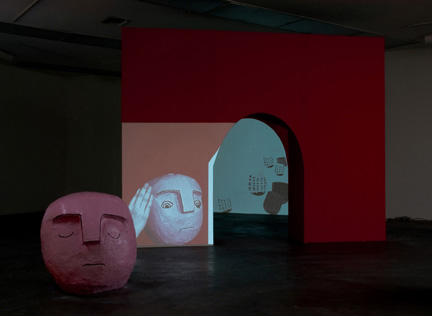
Congratulations to Wynne Greenwood the 22nd annual Bonnie Bronson fellow. A Seattle resident and The Stranger genius award winner, Greenwood describes herself as a, "queer feminist artist who works with video, performance, music and object-making to practice culture-healing." Her work has been featured at the Tate Modern, Whitney Biennial, The Kitchen and On the Boards. The Bronson Fellowship is designed to feature mid career artists with community impact and are more often than not women and or educators. The Award will be conveyed at Reed College April 29th 6:00PM at the Kaul Auditorium Posted by Jeff Jahn on March 29, 2013 at 16:24 | Comments (0) PermalinkFriday links PORT has a # of interviews and reviews in the works but here are some links to hold you over for a few hours.
Yup, NYC screwed up a brilliant initial design for an AIDS memorial. Nice to see the New York Times actually considering something of substance in Portland like the Object Focus, the Bowl show at MOCC, which content wise is excellent and thought provoking... if more than a tad shunted into a corner of the museum for the install. (can someone PLEASE show PNW museums how to install things in a way befitting the content) There is depth in the visual arts here that goes beyond the Times obsession of how "chill" or "odd" we are as the WSJ article last year on the Portland art scene was the first to take a serious look at. My point is, we are being watched closely and should act accordingly. Portland isn't just chill and odd, we are definitely a city of rabid idealists who don't wait for permission to do something with higher ideals. This year my pet ideal is insisting on that shows be installed well.... esp. if the show is really wonderful like Object Focus, The Bowl is. Brian Libby interviews Brad Cloepfil, discussing both the new PNCA 511 building and his exciting winery in Yamhill county. ...and there is is Jeffrey Deitch putting his foot in his mouth again, Im actually a fan of him as a gallerist but his director chops are sorely lacking. It is interesting how the board seems to make all these major press releases about major developments but he doesn't even get name checked... well this is the reason. If MOCA is truly serious about fund raising Deitch should be gone by around the end of June. I don't think his words change anything, sure a LACMA merger is considered a last resort... but that means MOCA needs to be single minded about their stated "preferred" independent and strong option. Once MOCA gets a suitable director, artist board members, a chief curator and raises the 100 million then they should implement a 10 year master plan including a capital campaign to create permanent gallery spaces for the permanent collection. That is going to take a lot of planning and on message PR and a string of low drama years for the museum. Deitch just isn't that kind of person, he is a gadfly. Posted by Jeff Jahn on March 29, 2013 at 11:34 | Comments (0) PermalinkTuesday 03.26.13 MOCA boosts endowment 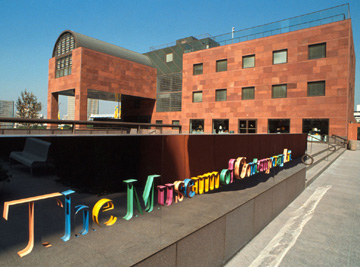
MOCA Today, MOCA announced that they have commitments of 60 million towards a 100 million dollar endowment building campaign (making the now dead LACMA takeover earlier this month seem even stranger in hindsight). MOCA has the most important contemporary art collection on the West Coast (and in many ways IS better than MoMA's from 1960 on) and once this endowment campaign is completed lets hope they finally undertake an expansion to give that stellar permanent collection room to be displayed. The MOCA press release is also the first time we've seen Deitch's name mentioned in a while. Looks like a good time for him to leave on a high note and hire (rehire?) a chief curator + a new director...hmmmmmmmmmmmmm? Notice how Broad was never once mentioned? That's a good thing, even from Broad's position... this way he doesn't seem like a puppet master. Also, let's hope some artists make it back to the board. Posted by Jeff Jahn on March 26, 2013 at 14:04 | Comments (0) PermalinkMonday 03.25.13 Monday Links The Guardian reviews David Bowie Is. Has any rockstar been so worthy of the visual spectacle he has produced?
The NYT's takes a somewhat broader look at abstract expressionism, for example many members of The Irascibles never made it to the Ab Ex cannon... reminds me of the stellar work of Ralph Rosenborg. Artinfo reports that Jcrew is now selling "Collection Curator" pants. A line of chief preparator chappeaus, artist assistant socks (with arch support), chief registrar scarf and mid career retrospective underwear should round out the entire behind the scenes art world line. ...and now the New Yorker gets in on Seattle's big art story of the Year. Look, his work was always weak and part of the problem is accepting of simple/brittle juxtapositions for shock effect. The fact that it involved craft did not make it any better and it was very one dimensional so not worth the closer look that some gave it (they collected it and curated it into shows). The lesson, dig deeper and expect more from art (consider suppleness) and you likely wont get caught supporting a Nazi fan boy. Posted by Jeff Jahn on March 25, 2013 at 10:32 | Comments (0) PermalinkTuesday 03.19.13 MOCA Board Rejects LACMA Offer It looks like MOCA will be staying independent and understands that means a serious endowment building effort. To me that sounds like the idea of merging with LACMA or USC are being rejected outright. Good!
Here is the statement MOCA's board released today: "The Board is in agreement that the best future for MOCA would be as an independent institution. The Board understands that this will require a significant increase in MOCA's endowment to ensure its strong financial standing. We are working quickly toward that goal, while at the same time exploring all strategic options, to honor the best interest of the institution and the artistic community we serve." ... (more analysis) Posted by Jeff Jahn on March 19, 2013 at 16:55 | Comments (0) PermalinkMonday 03.18.13 Monday Links The lineup for the next Venice Biennale's core pavilions is drawing mixed responses from curators... gee who could have predicted that? Isn't that healthy... and wouldn't consensus seem fascist? That said European and US dominated shows seem tired. Even here in Portland we have enough foreign nationals to question why every high profile list, award or group show in the city needs to be extra WASPy.
Turns out what they thought was a later Rembrandt copy depicting the artist in a funny hat is in fact the real thing. No new news in the MOCA drama but Christopher Knight chimes in again. MOCA needs independence and that requires an end to the drama... which will take an effective director and board combo... not simply one man or one savior institution. Reading between all the lines it is curious how nobody is talking about Deitch leaving or staying... seems like there is a done deal out there? Any deal that keeps him in place is the wrong deal, Deitch is better as a gadfly than as a stabilizing agent. Toyo Ito is the latest Pritzker Prize winner (but of course he is). Check out these Iwan Baan photos of one of Toyo Ito's best projects the Tama Art University Library. Frankly, it is one of my favorite buildings completed over the last decade. The PNCA's Cloepfil designed 511 building will make somewhat similar use of form substituting catenaries for arches... especially in the library areas. Ito's design still outclasses Cloepfil but to be fair the PNCA project is a renovation and has a more challenging program to address. I just think Portlanders should be conversant about the properties of both projects. With PAM in a semi-silent planning phase, a new transit bridge over the Willamette and the Japanese Garden working an a super exciting Kengo Kuma expansion Portland is looking up in turns of international caliber architecture. Design excellence does push patrons... but it is a push that needs to happen now that Portland is perhaps the most interesting city in the USA. Posted by Jeff Jahn on March 18, 2013 at 10:51 | Comments (0) PermalinkMonday 03.11.13 Monday Links Well the MOCA news pretty much overshadowed the Armory Show, which is as it should be (though it isn't fashionable in art schools, the idea of Greatness trumping the daily ins and outs of the art market would be refreshing if it weren't so unfortunate).
Still, the Armory Show and related fairs like the Independent happened. Here's more on the Independent, Volta and the Moving Image Art Fair. Artinfo did a 60 second video tour of the main Armory show. It is what you would expect, people watching, "look at me" art etc. Here is an interesting book review of two books on contemporary curating. I love how the reviewer teases out the idea of what I call rhetoric without belief (part of what makes contemporary curating both interesting and and horse shit). There is a mantra of nihilism that is seductive and often pointless that can get old fast... just the same as evangelistic curating. Posted by Jeff Jahn on March 11, 2013 at 10:55 | Comments (0) PermalinkThursday 03.07.13 MOCA takeover by LACMA? Again? 
MOCA This just in, LACMA makes a formal offer to take over MOCA. Yes, this again. To me it is a bit like the consolidation of banks, airlines and cell phone carriers over the years as a way of streamlining operating costs and resetting soured or miasmic investor/donor faith in the management. In this case (like most corporate mergers) I don't like it because it creates a less diversified ecosystem, though it may be the way out I've suspected Deitch has been looking for since the dismissal of Chief Curator Paul Schimmel. The problem is a city like LA needs diversification of institutions on a patronage level for it to become a full fledged art capital like New York or London is now. Besides, LACMA already has a contemporary program that would get confused with the addition of MOCA which is a "contemporary only" program and not a generalist art museum like LACMA. Think of museums as charismatic megafauna in an ecosystem, their presence indicates the health of the entire system. I believe the focus and diversification is crucial as the packs or tribes (patrons) that an institution must cultivate to survive have immense collateral effects that range much farther than the physical plant of each institution. A more monoculture approach might be convenient (at least on paper) but it is ultimately a missed opportunity for diversity... ... (more with updates on any recent developments) Posted by Jeff Jahn on March 07, 2013 at 14:16 | Comments (0) PermalinkMonday 03.04.13 Monday Links Yinka Shonibare makes a normally staid sculpture park into something hilarious and more challenging. Shonibare is perhaps my favorite re-lo-colonial artist.
Today the Oregon Senate is voting on the extremely poorly designed yet multi-billion dollar CRC bridge. Nobody likes this bridge unless you own a freeway construction company or work for a trade union. To reiterate our position, the design is poor because it is too low for river navigation, creates a below decks tunnel of doom between Portland and Vancouver, doesn't maximize seismic safety, doesn't have enough federal funding (it is I-5), is a design with more piers thus more environmental impact and misses a huge opportunity to build to the Northwest ethos celebrating the place and values. In short it doesn't give citizens enough for such a huge outlay of money. Overall, a stronger design process was necessary to justify and avoid this very expensive skimp on the details franken-bridge. Oregonians, look up your representative and give them a call. Holland Cotter is gaga for, "Anything Jay," (DeFeo that is). Why is De Feo such a lightning rod? I have a theory. DeFeo represents absolute integrity (like Judd and Smithson) but isn't part of the simplified art historical lexicon. She represents and confirms the nagging feeling that we haven't been in adequate comprehension of our recent past. Hell I still hear college profs spouting nonsense about Judd being about all about "perfection"... when it is the furthest thing from the truth (which instead was arch-pragmatic with a lot of intellectual rigor). DeFeo by resting her entire reputation on one painting makes an end run around the market in heartening ways. Great art places demands on institutions and collectors... it does not pander. Great patrons and institutions prefer facilitating these demands because they find them valuable and insist on such integrity... pandering is to be avoided. Posted by Jeff Jahn on March 04, 2013 at 11:16 | Comments (1) PermalinkMonday 02.18.13 Monday Links Michael Kimmelman writes about the Netherland's design strategy for selective periodic flooding when water levels rise... clearly hurricane Sandy has had an effect on New York City's interest in the subject.
Christopher Knight does a good job showing how gore and violence in visual images doesn't provoke psychopathic violence from its viewers... his evidence, the Isenheim Altarpiece by Matthias Grunwald. France is returning 7 paintings stolen by the Nazis. New trend, artists signing with agents in lieu of galleries... Posted by Jeff Jahn on February 18, 2013 at 5:53 | Comments (0) PermalinkMonday 02.04.13 Monday Links Jerry Saltz revisits the infamous 1993 Whitney Biennial... the much hated "identity politics" show. This is a fun read.
What can art museums learn from the new Museum of Mathematics? Still, I'm not entirely convinced that touching is the only way to expand the horizons of the young. In Portland, OMSI already has plenty of touchy feel-y exhibitions and I think there is something to be learned by having work that commands a certain "don't touch" respect. PAM's security guards have their hands full with the adults who think they can touch everything already! That said museums are definitely exploring interaction... The Carrie Mae Weems show at PAM includes a table with interactive Iphone apps. In a related news, OPB Interviewed Weems for Think Out Loud. Posted by Jeff Jahn on February 04, 2013 at 10:13 | Comments (0) PermalinkMonday 01.28.13 Seeing the light links Adrian Searle discusses what is profound and what merely entertains at the Hayward Gallery's Light Show. This is a difficult line for light and space artists since they are generally bounded by the conventions of stagecraft and architecture. The difference I feel is the better light and space artists are extremely rigorous thinkers and among the most demanding art practitioners out there. Robert Irwin, the brightest human being I've ever encountered comes immediately to mind (apologies for that pun). He doesn't just show the viewer some pretty lights... he gives the viewer a chance push their perceptual powers to the limit. This makes the work demanding.
In related news, Paul Sutinen... who infamously interviewed Irwin at a Burger King in Portland considers the way that artist's trademark disc piece is displayed at the Portland Art Museum to be a kind of vandalism. It is true, that presentation of one of the best pieces in the collection IS horrendous (a hangover from the still overcrowded Buchanan era install that needs thinning and more sensitivity). Installed correctly (as it once was) it is a stunner. The over-installed nature of most of the museum's collection is a MAJOR drag on the reputation of an otherwise rapidly improving modern/contemporary program at PAM (Rothko, Beuys, Mike Kelley, Sigmar Polke & Bruce Nauman just last year alone). Can we fix this? This sort of thing is what many design professionals in Portland consider a major turn-off at the museum. PAM's Jubitz Center is due for a major reinstall. (Perhaps what's been holding all this up is the fate of Ed Cauduro's collection... which is likely the only chance to fill in major gaps in the collection from the mid 60's to the late 80's ... and to have Ed take his rightful place as the greatest art collector in Portland history.) Portland has grown up a lot in terms of the viewer's expectations and overall sophistication level and everyone is simply demanding a lot more of the way work is presented. Posted by Jeff Jahn on January 28, 2013 at 10:56 | Comments (0) PermalinkTuesday 01.22.13 PICA Launches Precipice Fund Rather famously, Andy Warhol's Factory was the nexus of difficult to categorize cultural activities... catalyzing in one of the greatest nexuses of cultural production ever. The Factory's chaos was frankly stimulating... echoing other great cultural moments like Berlin during the Weimar Era, the New York School or The Surrealists in Paris.
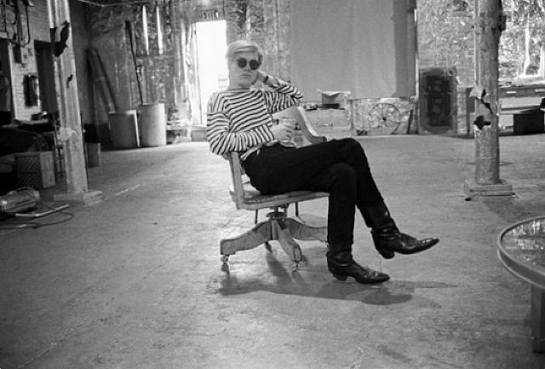
Andy Warhol at The Factory Similarly, In the past decade+ Portland has undergone a renaissance in difficult to categorize (call it boundary pushing) alternative art projects and spaces. This fermenting stew of artist-driven activity IS perhaps the most interesting thing about the Portland scene. Unfortunately, that type of activity (on boats, in garages and warehouses) is incredibly difficult for older style venues and granting agencies to grapple with. Their more old fashioned criteria are preoccupied with; tangible craft, academic resumes and the persistence of their own pristine white walls. This schism has required action for quite some time, and I'm relieved to break this story now that someone has taken a bold new step towards addressing it. Leave it to the Andy Warhol Foundation and PICA to provide much needed movement in the support of what makes Portland such a vital arts city with the Precipice Fund of regifting grants. Consisting of 15-20 small grants for a total of $75,000 per year the fund targets "unincorporated" arts activities like alternative spaces or artist collectives. As an extension of the Warhol Foundation's regional regranting program, already successfully administered by institutions like Diverse Works in Houston and Southern Exposure in San Francisco. In fact, in many ways this funding initiative is in keeping with Warhol's own penchant for creating a catalytic environment for talented people whose process follows the more unpredictable path. Getting one of these regrants will also be morale boosting and a way to vet these often ephemeral projects... giving practitioners a ladder to perhaps step up to the next level. This project is also noteworthy for the altruistic nature of regranting... because institutions who undertake this sort of activity ultimately must designate already scarce resources to the management of these programs, which ultimately do not reflect that institution's specific agenda. No traditional museum (which is organized around a collection) or a school could do this. It is true that these projects sometimes get funding from OAC and RACC but it is on a very ad hoc basis. This funding is tailored to the fact that an interesting art practice doesn't do well with traditional reporting methods and metrics because the projects themselves have ever changing goals and outcomes based on the pragmatioc experience of executing these projects. Here is the Official PR: "PICA is proud to announce The Precipice Fund, a major new granting initiative for Portland based unincorporated visual art collectives, alternative spaces, and collaborative projects. Formed with the support of the Andy Warhol Foundation for the Visual Arts, The Precipice Fund expands Warhol's Regional Regranting Program to the Northwest, creating new channels of support for "vibrant, under-the-radar artistic activity." Rachel Bers, Program Director for the Andy Warhol Foundation for the Visual Arts, explains that, "by partnering with leading cultural institutions in communities across the country, the program allows the [Warhol] Foundation to reach the population of informal artist collectives and to support their alternative gathering spaces, publications, websites, events, and other projects. ... (much more) Posted by Jeff Jahn on January 22, 2013 at 0:17 | Comments (0) PermalinkMonday 01.21.13 Congrats over the weekend It a very busy weekend and PORT has an avalanche of articles for you this week. Here's some great news from the weekend to tide you over.
The Northwest's most accomplished psychgraphic landscape abstractionist, James Lavadour, will be taking part in the 2013 Venice Biennale. It is part of the ongoing Personal Structures series of exhibitions at the Palazzo Bembo. James is simply amazing, congrats. Also, great news Ralph Pugay has been awarded a Joan Mitchell foundation grant. In fact the thread here is that Lavadour is also a Mitchell alum... who knows perhaps he will be in a Venice Biennale as eventually as well. It's a major coupe for such a young artist recently out of art school. Pugay is easily the best purveyor of dark humor in the Northwest. Posted by Jeff Jahn on January 21, 2013 at 0:11 | Comments (0) PermalinkWednesday 01.16.13 Announcing NOW Portland Trienniale 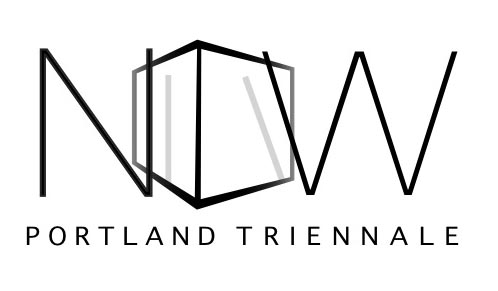
Announcing... NOW Portland Trienniale in 2015 with a kickoff event February 1st 2013 that will give more details and open a conversation on this multi-location event in the city. The team behind this (some with experience doing the Guangzhou Triennial) has formed a strong coalition with major and mid level Portland arts institutions + international contacts. Here's the official PR: "A thematic exhibition dedicated to the promotion and dissemination of contemporary ideas. NOW provides a fresh and critical forum to showcase ..." ...(more) Posted by Jeff Jahn on January 16, 2013 at 10:40 | Comments (3) PermalinkMonday 01.07.13 Monday Links Kurt Schwitters in exile. Is there a modernist who seems more timely than Schwitters?
Portland was listed as one of the top 12 art places in the USA... 'cept they think the Pearl is the center of activity (I'd say it is only about 33% of the Portland art scene, the near southeast and North Portland together probably eclipse it though If you know anything about Portland's art scene (which all PORT readers do). Tyler Green has his weekly weekend roundup... always a good thing to check in on. Posted by Jeff Jahn on January 07, 2013 at 11:04 | Comments (0) PermalinkThursday 01.03.13 Looking at the year ahead The Portland Tribune published my take on 2013 in the visual arts today, along with predictions by a number of other Portlanders you might recognize.
Posted by Jeff Jahn on January 03, 2013 at 10:39 | Comments (2) PermalinkThursday 12.27.12 Top Posts for 2012 I'm still compiling PORT's best and worst of 2012 list but it was a year full of art news, reviews and interviews so here are our top 6 most read posts for 2012:
It is surprising that a review of Vicky Lynn Wilson's Cumulus at PCC Sylvania is our most read post of 2012... until you factor in the effect Hurricane Sandy had upon the American psyche. Every few years I like to do a post introducing some new faces to watch in the scene. Our 2012 edition of fresh faces to the Portland art scene was extremely popular. In many ways it heralded this post commenting on Peter Plagens' article in the Wall Street Journal, in May 2012 (also a popular post but not even in our top 10... which is good because PORT readers already knew plenty about the Portland art scene). After years of trying to be as itinerant as Portland's alternative spaces PICA finally grew up and stopped couch surfing in Weiden + Kennedy's basement... moving a few blocks away to a building that many design conscious Portlanders have come to love. They learned their lesson the hard way and 7 years is a long time to go without a signature space. My review of Mike Kelley at the Portland Art Museum, capped off a wonderful but bittersweet moment in 2012. Kelley will be missed. Paul Middendorf finally scored that interview with Richard Serra we've been waiting for. My review of Heidi Schwegler's The Known World at Chambers was a complicated review of a complicated (some would say turgid) show that purposefully tried to make the viewer feel like a bobble head bouncing along a rough road in some remote part of the world. It is funny how some of the more critical reviews attracted more eyeballs... posts on Rothko, the Mayoral & City Council races, Paul Schimmel/Jeffrey Deitch and my unfinished essay/discussion opener Priming the Cultural Pump were not far behind. Posted by Jeff Jahn on December 27, 2012 at 10:27 | Comments (0) PermalinkTuesday 12.18.12 Making a list? So it is end of the year list time... what were your favorite shows this year? I wasn't that into the various group shows but 2012 with solo shows by major artists like Rothko, Mike Kelley, Kara Walker, two by Bruce Nauman and Gerhard Richter will be very tough to top. I'll have a complete list of my favorite shows (including locals) soon.
Christopher Knight lists his favorite museum shows in LA for 2012. Architizer lists their top 10 architecture controversies for the year. Posted by Jeff Jahn on December 18, 2012 at 11:27 | Comments (0) PermalinkFriday 12.14.12 Friday links We should have a nice long review of a very interesting show posted soon but till then here are some links:
Hyperallergic gives a look at Ann Hamilton's latest. The I-5 Columbia River Crossing will need to be over 20 feet higher clearance than originally designed, begging the question... "how does one miss that kind of design detail?" Had they gone with the better design (seismically, aesthetically, smaller # of ecology changing piers and functionally for boat clearances, bicycles and pedestrians) they would not have had a problem. The whole design process was backwards (leading to ineptitude) and the project should be scrapped or completely redesigned with use, northwest values and seismicity in mind. The funding for this poor design (which creates a below decks dungeon corridor for bikes, pedestrians and criminal activity) hasn't materialized because its design simply isn't well thought out. Besides, not choosing the highest performing seismic design (cable stay) makes it an idiotic use of taxpayer money. What could have been a showcase of northwest problem solving, values and design has become a never ending taxpayer boondoggle nobody seems to like. Confidence in this project is incredibly low, even amongst those like I who see the need for a new bridge (fix snarls, add light rail and seismic survivability when a 8.5+ eventually hits, right now if a 7.0 hits a lot of people could lose their lives). Onetime Oregonian Josh Faught gets a SECA award. Congrats Josh! If only the CNAA's had a similar national level reputation... remember, when it replaced the Oregon Biennial the CNAA's were touted as being patterned after the SECA award. Posted by Jeff Jahn on December 14, 2012 at 10:56 | Comments (0) PermalinkMonday 12.10.12 Monday Links This NYT's story on the New Yale University Museum galleries and director Jock Reynolds is a must read. Sure it starts of as your basic "New Wing Building" article but the way it then focuses on Reynolds is inspiring. Imagine that? ...a museum director with a great eye and extremely tactical use of empathy. Then there is the fact that he seems to take the high road with a big picture approach. I'd call it a low key but pervasive and serious approach. What a fantastic steward. Which, makes me ever so more curious about how the Portland Art Museum's next move will be executed. 2017 is the museum's 125th birthday and plans are somewhat quietly under way. The deciding factor will be how Portland's patrons respond? Every trustee at PAM (or any other art institution) needs to read this article and take it to heart. Quality of intention and display are one and the same, becoming the most self-evident thing a museum can offer.
These offices in Spain are simply gorgeous. The sky and earth seem to be sharing a dream together. What an exceptional design, recalling Mies' Barcelona pavilion and Farnsworth house with a dash of Robert Irwin and Michael Heizer and Judd's 100 Mill Aluminum pieces a as well. Art Basel Miami Beach happened... Artinfo has some images. It doesn't look that different from previous years. Always an important event to be sure but somehow it punctuates how something different seems to be on the horizon. This interview with Todd Levin gives some perspective on the art market's yearly beach party. Posted by Jeff Jahn on December 10, 2012 at 10:12 | Comments (1) PermalinkMonday 12.03.12 Monday Links It is true I was super busy in November getting things ready for exhibitions of Portland artists outside the region but that just means that PORT's backlog will just lead to more in-depth reviews interviews and essays for you in December. First one comes in a day or so but till then here are some links:
Christopher Knight wonders if curators are becoming endangered species? Answer = Yes (it isn't just LA) and I believe it is related to the diminishing # of serious art critics who cover a beat as well. I have been at work on an essay about this trend for a few months so stay tuned. Let's just say if one is trying to quantify the role of dedicated curators and critics in a short term business balance sheet way we lose long term perspective and the civic IQ these jobs represent will be lost. 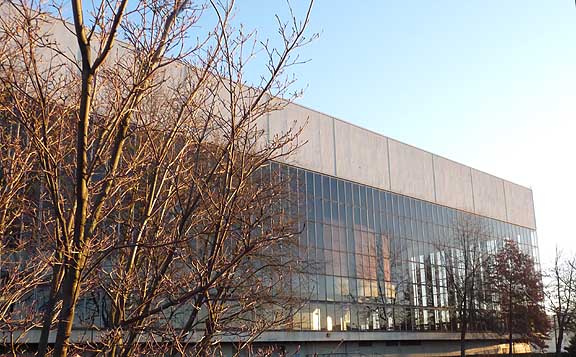 Memorial Coliseum vote looms on Thursday Brian Libby writes about the importance of the Memorial Coliseum and the impending vote on its future this Thursday. Brian is right... the integrity of the design needs to be maintained when updating this mid-century gem. (Though being an architecture critic who takes a stand doesn't in any way adversely effect your role as a journalist. Lets just say journalism and criticism are at odds in some cases and ultimately journalism when effective must take the stand like a critic in order to be valid (if one never takes sides, arts writing becomes meaningless). You did the right thing Brian. Portland as a design city has to respect its special instances of exceptional design and the Coliseum with its bowl in a glass curtain wall is a clear case in point. Did you catch Portland photographer Holly Andres' photos in the New York Times this weekend? And the Turner Prize goes to Elizabeth Price, whom the brits complain is cutting edge but not controversial. Whereas, in Portland our awards like the CNAA's or the Ford Fellows etc... generally are vacillating between the academic and craft in an incredibly staid late mid-career package. Academia, craft and late mid-careerness are all fine, even good things in small worthy doses but the three together are an often recipe for mediocrity that completely misses the dynamicism of the very internationally engaged Portland art scene. Hence, the reason our awards generally do not predict future success despite the fact that Portland artists are turning up in increasingly higher international profile venues. Instead, our awards tend to reward artists with consistent long term institutionally enmeshed/academic careers.... which is fine but we need things like the very successful Couture series again (which has been an interesting, catalytic & risk taking predictor). Posted by Jeff Jahn on December 03, 2012 at 10:44 | Comments (1) PermalinkMonday 11.26.12 Back in the swing links Here are some links to get you back into the swing of things.
The NYT's reviews a show about when Pop Art Turned Moody. Jackie Wullschlager contemplates Dave Hickey's resignation letter. I don't think I can fully agree with either Hickey or Wullschlager but they do have a point. True, there is a dilution syndrome in the art world since collectors/dealers are less demanding than they were in the before the 80's made art a business. But that has been going on to an increasing degree ever since the Hotel Drouot auctions of Kahweiler's cubist works. To me all that weak stuff means there is a potential for artists of substance to separate themselves from the fray. How many artists really stun viewers and leave them questioning the world they knew before they saw the work? In an information age that bar has been raised to an incredibly high degree. Then there is this one... will Canadian artists get more respect (ie market value). Not unless Canada is like China or Brazil with economies on a major uptake. Besides, is market value alone the true mark of success? The Royal Art Lodge was an important moment... I think they are asking this question 12 years too late! Canada produces a great deal of consistently strong artists, that's all a nation can hope for. The process of determining greatness involves capturing the intellectual attention of an age. Currently, Ai Weiwei has been gifted/burdened with that mantle. Posted by Jeff Jahn on November 26, 2012 at 11:01 | Comments (0) PermalinkMonday 11.19.12 Monday Links PORT will have some of our in depth and critically focused content for you after this holiday week but here are some links to start you off and be thankful.
Thieves have stolen an ancient petroglyph in California, Oregon and Washington be on guard. Here's the story on that iconic Iwan Baan photograph of New York City post Sandy. Knoedler's problems with reputedly fake AbEx works only gets worse with this disputed Rothko. Posted by Jeff Jahn on November 19, 2012 at 10:04 | Comments (0) PermalinkTuesday 11.13.12 CNAA's 2013 Announced The Portland Art Museum has announced the 2013 Contemporary Northwest Art Awards to be held in October; Anne Appleby (MT), Karl Burkheimer (OR), Issac Layman (WA), Abbie Miller (WY), Nickolas Nyland (WA), and Trimpin (WA). Congrats to everyone.
Analysis: Well this is isn't the complete train wreck retro-list we saw last time around but if you hunger for a true bleeding edge contemporary look at what is going on in the Northwest art this will still look dated. It is a solid if typical list as all the names here qualify as craft heavy (highlight the object) makers. That isn't a crime but it is like only eating butter and sweets and many expect more variety from a sampler like the CNAA's. Earlier this year the Tacoma Art Museum's 10th NW Biennial had lots of conceptual and experiential work... many of which needed to be plugged in to operate. Facts are, there is a sizable amount of contemporary art that is not about calling attention to the way an object is made even if it happens to be well made. For example, most video and installation art is heavy on ideas and perception over the primacy of the object and form.... (more) Posted by Jeff Jahn on November 13, 2012 at 15:46 | Comments (1) PermalinkMonday 11.12.12 Monday Links Last weekend The NY Times Magazine had a bit of a Portland backlash (though they didn't identify it as Portland) with their $5 Watches vs $5 Coffee piece. The Ace Hotel may have started in Seattle but it was when it absorbed a more Portland ethos (Stumptown Coffee + hanging out with wifi in downtown PDX) that they found their voice. Also, I feel like this rivalry between cheap watches and expensive coffee is just fabricated to stir up a non existent rivalry. In fact, the Ace and Stumptown in NYC become much less cool if the discount wholesalers leave (this isn't a yuppie thing at all, these lobby hipsters like anachronistic pairings). Hipsters love cheap, lame stuff so they can feel ever so slightly... more validated. Kidding aside, the fact is these sorts of caffeinated lobby dwellers are wholesale information merchants that grease the wheels of new ideas (they dont want bock after block of hangout space... they like being an island).
Chelsea lost over 40 million in art due to Hurricane Sandy. And as a nod to Veterans Day check out Portland photographer Jim Lommasson's Soldier's Stories. Posted by Jeff Jahn on November 12, 2012 at 10:28 | Comments (0) PermalinkThursday 11.08.12 Thursday Links The Art Newspaper has a story on the percieved decline in Britain's art schools... once thought to be the best in the world but now in danger of becoming too expensive for any but the wealthiest.
Thankfully this fantastic Frank Lloyd Wright in Arizona has been saved from the wrecking ball. Some great pictures of the interior too. Sadly it doesn't look good for this equally fantastic Bertrand Goldberg in Chicago. Check out the discussion in Art in America with curator Paul Schimmel on his final show at MOCA, Destroy the Picture: Painting the Void 1949-1962. Posted by Jeff Jahn on November 08, 2012 at 11:06 | Comments (0) PermalinkTuesday 10.30.12 Sandy's aftermath, art & design 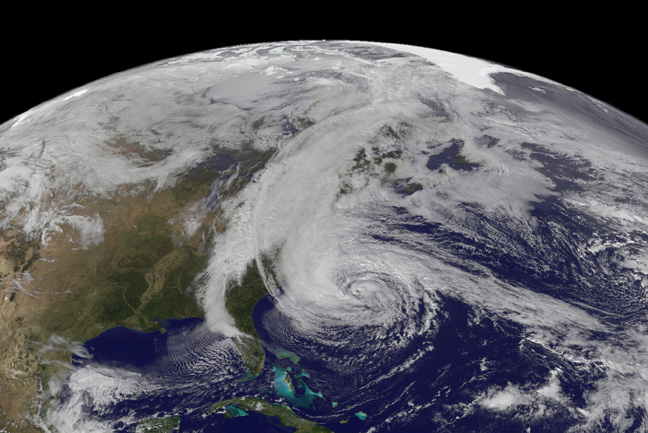 Hurricane Sandy on October 28th Gallerist NY has pictures of Chelsea the day after Sandy in case you are curious... (not by any means that these are the people hardest hit by the storm). What I'm hearing is that Danziger was flooded and it was knee deep on 23rd. East Village looked even worse with at least waist deep water in places. For the LES here is a report from Rivington street on the aftermath. Here are some of the preparations for the storm made by various institutions in NYC. Tyler Green is compiling a Museum damage report list. In DC the Hirschhorn is giving free admission to anyone named Sandy tomorrow....???? Arch Daily asks if Sandy's deluge will get New York to redesign its waterfront? The Times covers the Chelsea damage. Jerry Saltz surveys the devastation. ...then follows up with a more optimistic report. I'll update this as I find more Sandy info related to art and design. Hopefully everyone stays safe. Posted by Jeff Jahn on October 30, 2012 at 10:32 | Comments (2) PermalinkMonday 10.29.12 Monday Links Great, that's exactly what the Venice Biennale has always been in need of... the Vatican!
LACMA's Kubrick show highlights some of the director's art influences, including Diane Arbus. And keeping with the season the Guardian has a list of the 10 scariest paintings. Though I think an etching Goya's, "The Sleep of Reason Produces Monsters," beats most of the paintings on that list. Posted by Jeff Jahn on October 29, 2012 at 4:54 | Comments (0) PermalinkThursday 10.25.12 Dave Dave Dave 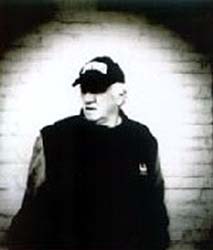 Dave Hickey is retiring, sort of... read the interview because it is pretty much the best art wordsmithing all year. Perhaps this is the final push I need to finish a little essay on art writing and writers I've had in the works? Why is Hickey so important? He is one of the few arts writers (besides Rem Koolhaas and a handful of others) who looks for the unspoken tension around whatever subject he takes up, then exposes it as a fraud. What is special is the way he then asks us as readers to evaluate that fraud on its merits (discredited or not)... testing the readers in a generous way. In other words he tests his subject and audience rather than simply act as a ceremonial standard bearer at some sort of metaphorical coronation. It isn't debased forms like journalism or art cronyism... it is about the process of sharpening one's thinking, which is criticism of the highest order. Hickey also makes his detractors crazy... irritation is a rare gift and one of the most powerful any writer can hope to wield. Posted by Jeff Jahn on October 25, 2012 at 10:42 | Comments (1) PermalinkThursday 10.18.12 Thursday Links It has been a slow art news week but at least there are lots of great shows up in Portland to see (do so). Here are a few links to tide you over, we've got many reviews and essays coming your way in the next few days.
The Nada and Untitled art fairs are sparring... which seems like a brilliant way to promote both fairs. I really like winning Busan Opera House proposal by Snohetta. The way it features the landscape around it and opens itself to the public is interesting... even more democratic than Gehry's Disney Hall in LA. ...When the Portland Art Museum expands again I'd like to see it engage the park blocks and West Hills in philosophically similar way (not visually but as a bridge between all points in the city making it the pivot point of the downtown and park blocks). Hyperallergic noticed that Jeffrey Deitch isn't on the top 100 list anymore. I've said it before, Deitch has to be looking for an exit strategy since he isn't being allowed to be Jeffrey Deitch. Posted by Jeff Jahn on October 18, 2012 at 11:39 | Comments (0) PermalinkMonday 10.08.12 Monday Links The Art News reports a new art space and residency for LA started by Guess Jeans co-founder. If only Phil Knight or Gert Boyle would do something similar in Portland? The thing is it takes passion for the arts so someone like Duane Sorenson is a better bet. Oregon's Sarah Meigs already created The Lumber Room, which has a show opening in November.
The strangest thing out of Britain isn't the recent Rothko vandalism (btw putting the works under glass is another kind of vandalism and would likely void the gift)... it is a mandate against aesthetic use of geometry in school buildings. PORT readers knew last week's Kara Walker lecture would require one to get there early (because we told you)... but for those who didn't get in Reed has posted audio of the talk online here. The city is seeking nominations for Portland's first Creative Laureate. It is a one year position for someone who can promote Portland's creative attributes and assets. Posted by Jeff Jahn on October 08, 2012 at 10:01 | Comments (1) PermalinkFriday 10.05.12 Friday links Paul Schimmel literally @ Destroy the Picture Well, Paul Schimmel's last show as Chief Curator at MOCA, "Destroy the Picture: Painting the Void, 1949-1962" has finally opened in LA. It is a great show, even if it is the martyrdom of a great curatorial program. But focusing back on the art I feel like all the focus on Greenberg from 1949-62 resulted in many of these artists and Non-North Americans like Gutai group being passed over in the history books. Artists like Judd, Flavin and Hesse were doing the related and in dialog things (from 1963 on) without really trying allowing painting to occur... so this is an important way to see how there was so much more depth in that era. Basically, the reason most academics read on Judd and Flavin is so off (undo emphasis on perfection) is because they haven't known much about the things on display in Destroy the Picture... or Judd and Flavin for that matter. Brian Libby looks at Portland's Architecture + Design festival. Ive known about this for a long time but OCAC has just announced that they will have a MFA program next year. This is a crucial move for Portland's most focused art school. Posted by Jeff Jahn on October 05, 2012 at 11:51 | Comments (0) PermalinkTuesday 10.02.12 Tuesday Links Former Portlander and overall excellent person, Mickalene Thomas is having a great run in New York this Fall with articles in the NYT's here and a review here. I interviewed Thomas a few years ago at her studio. Congrats!
The decay of architecture has held human interest since recorded history and Arch Daily looks at its entropic appeal. The Romans were in love with Greek ruins rather than the original condition of their structures. Frank Lloyd Wright would often build his structures in purposefully dangerous proximity to trees and massive grape vines for the same romantic allure. The duality of entropy and vegetative growth has been big for a while but it seem like it is THE topic right now. Portland is getting its own already world famous veg-facade with the Edith Green Federal Building renovation. Posted by Jeff Jahn on October 02, 2012 at 10:41 | Comments (0) PermalinkMonday 09.17.12 Monday Links Oh, not another Portland travel article... but it is good to see that The Guardian doesn't believe the myth of Portland as a place of young retirees. That's BS, in fact the young and old alike work very hard and inventively just to survive here. The Guardian's latest article reports, "Portland didn't become the US capital of cool overnight....If a hipster is a person who wants to seem creative without actually creating anything, there's a serious lack of hipsters in this city. The music and art being made here are world-class." The question is, are Portland's funding and presenting institutions acting in a way that presents that world-class reality? (The survey shows, major awards etc. seem very mid-late career and education career heavy or just plain second rate... and there is widespread annoyance over this.) When artists continually reach out to major institutions and funding sources outside of Portland just to do internationally relevant things it should set off alarms... The artists here are extra resourceful (and simply sidestep the local politics) but I'd like to see Portland's arts infrastructure keep up with the talent and new media/genres.
Get to know a little bit about influential, yet little known Mid-Century Italian designer Bruno Munari. And last but not least the LA Times published this detailed anatomy of why good feelings are so important to cultivate amongst MOCA's board of Trustees. *Update: I've always agreed with the viewpoint that Christopher Knight just published; Eli Broad isn't trying to take over MOCA's collection. He needs a strong MOCA next door to his personal collection museum to give it more Elan. The conspiracy theories just don't add up. The real problem is that Dietch is a gadfly who thrives on controversy when MOCA needs steadying... not troublesome tilting at windmills with a phantom intellectual elite that somehow doesn't get pop culture. Trust me, post graduate education gets subcultures and popsploitation. Oh yes and the clock is ticking, Real Clear Arts wonders where Deitch's promised MAJOR announcements are? Posted by Jeff Jahn on September 17, 2012 at 0:14 | Comments (0) PermalinkMonday 09.10.12 Monday Links There will be a review soon but till then take in some links.
Tyler Green considers how the fact that 60% of MoMA's visitors are from over seas is driving up their very high $25 admissions fee. Photographing a Ken Price retrospective is fascinating. It reminds me how in many ways the images generated for a retrospective are one of the most important components of any survey. They become the perspective of the catalog. Peter Blake chooses his list of 10 best paintings. My list would have some similarities (here's my list in no particular order of importance & off the top of my head): 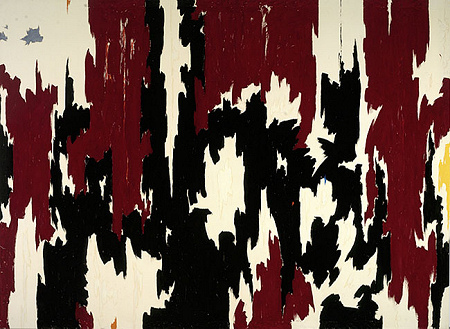
Clyfford Still's, '1957-J-No. 2', 1957 (this is my personal fave if I were forced to pick... it has elements of everything else on the list) Paul Klee's Ad Parnassum Velazquesz's Las Mininas Rembrandt's self portraits... any any of Ellsworth Kelly's curves Goya's Black Paintings Picasso's Les Demoiselles d'Avignon Matisse's The Red Studio Jackson Pollock's Lucifer Andy Warhol's Sixteen Jackies List your own if you'd like... Posted by Jeff Jahn on September 10, 2012 at 10:21 | Comments (0) PermalinkSunday 09.02.12 Last day for impressive Bacon at PAM 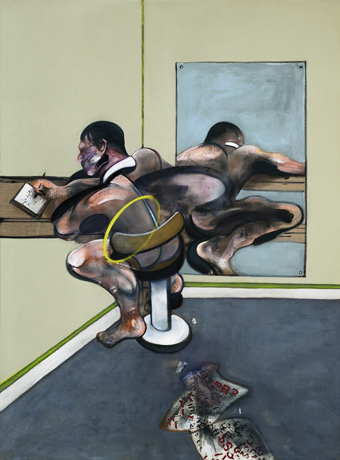
Francis Bacon 1977, Figure Witing Reflected in a Mirror,(c) 2012 Estate of Francis Bacon. All rights reserved. / ARS, New York / DACS, London It is your last day to catch what many (including myself) believe to be the best painting Francis Bacon ever painted, "Figure Writing Reflected in a Mirror," at the Portland Art Museum. I'll have a major essay for you soon to ahem "reflect upon," but to give you short summation why it is so important; 1) The painting depicts George Dyer, Bacon's former lover who committed suicide on the eve of his first major museum retrospective in 1971. 2) Considering the difficult subject matter the paint handling is superbly confident yet conflicted. This gives it a revealing personal quality you don't get with the screaming popes even or even with the self portraits. 3)This painting marks a maturation point in his career. The composition was bolder, more poetic and introspective for an artist who up until his 1978 show prized obfuscation above all else. In many ways this double portrait of his former lover set the stage for Bacon's more more introspective later self portraits. 4)Bacon was a wordsmith of considerable gifts and this is his only painting that actually depicts a figure writing (I'll expand this history considerably in the essay). If you enjoy Storm Tharp's work you will have missed and incredible opportunity in not seeing this painting... so go. Posted by Jeff Jahn on September 02, 2012 at 9:47 | Comments (1) PermalinkMonday 08.27.12 Monday Links Art Info's Adapt or Die article and the recent tax levy around Detroit do relate to MOCA's ongoing situation but it is also quite relevant to Portland's upcoming vote in November. Look, the reason that Portland is suddenly having a jobs surge is directly related to the decade and a half or so of cultural expansion lead by people who have chosen to rebrand Portland as a city of creative activity and action. These firms are following that workforce. Thus, this new surge requires the funding and civic investment for non-profit culture in Portland so the city can consolidate, reinvest and turn even greater profits.
It is equally true that Portland's funding needs to become more nimble at supporting independent curatorial activity and alt spaces (because THAT KIND OF NIMBLE/RADICAL ACTIVITY IS WHAT HAS CHANGED the city for the better into a creative's rebel base). Also, how do Mayoral hopefuls Jefferson Smith and Charlie Hales stand on this crucial topic of not only funding the arts but the crucial discussion of what kind of arts activity gets funded? Right now RACC is not really calibrated to the needs of the nimblest parts of the Portland arts community and I think a plan is required. Ori Gersht gets a retrospective in Boston. Posted by Jeff Jahn on August 27, 2012 at 6:17 | Comments (0) PermalinkThursday 08.23.12 Endangered Architecture Links  Frank Lloyd Wright's David and Gladys Wright house is threatened One of Frank Lloyd Wright's most unique designs (for his son David) is threatened in Phoenix Arizona. Sign this petition to save one of these Frank Lloyd Wright masterpieces from the wrecking ball. Art Info has the story on the tragic (in many ways) modifications to one of Philip Johnson's most interesting designs the Elmer Holmes Bobst Library at NYU. Look there are better ways to save the integrity of this design. The Chicago Architecture Club is looking for ways to save the excellent Bertrand Goldberg that Northwestern University wants to tear down. All three of these structures are very important mid century structures that require much more respectful treatment. Posted by Jeff Jahn on August 23, 2012 at 11:42 | Comments (0) PermalinkMonday 08.20.12 Monday Links and Kusama What? Charles Saatchi can't give away his collection... seriously small minded on the part of British institutions but a clear indication that he is doing the right thing! The stuff from the 90's - to say 2004 is certifiably classic. True, Hirst is perhaps no longer what he once was (that was by design being a YBA) but I can't think of contemporary art today without him and Tracey Emin and the rest of the gang.
Interesting story of a young artist broken by being a Jeff Koons' assistant. Learn about Portland's classic Rummer Homes. 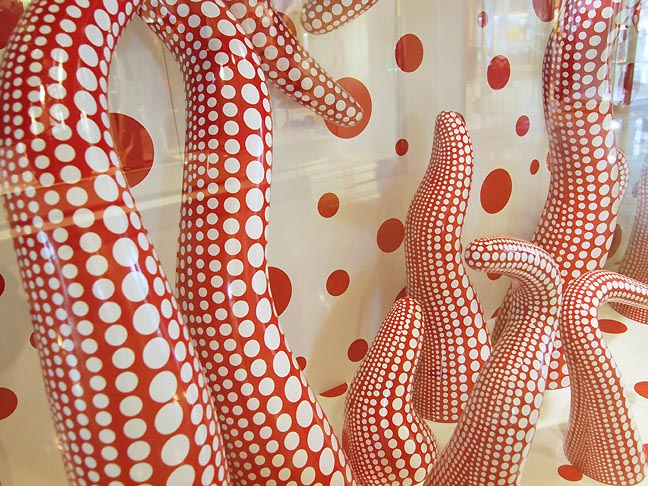 Detail of Yayoi Kusama's window at Louis Vuitton at Pioneer Square Mall And last but not least... perhaps it is just a Louis Vuitton window display to advertise her line of handbags etc. but it is still badass, like Yayoi Kusama tends to be. I don't hang out at the Pioneer Square Mall much but this alone makes it worth the trip. ...(more) Posted by Jeff Jahn on August 20, 2012 at 10:58 | Comments (0) PermalinkMonday 08.13.12 Monday Links The Guardian published a fascinating look at several Edward Hopper locations as they are today.
Slate has noticed how Portland's economy has picked up lately, mostly due to creatives laying the workforce groundwork and the fact that firms tend to follow the talent. This is just another reason we need to rethink how we support the arts on a civic level... i.e. making a point of celebrating and supporting "talent" and excellence for its own sake, instead of waiting for other cities to be better "first big step" advocates for our stand out residents (this means awards and media coverage, perhaps something the mayor's office could do to highlight talent?). Also, Portland is an incubator that attracts the rest of the world, therefore we need to start making innovation more important in our funding decisions. This means less focus on standard genre definitions and long teaching careers for grants/awards and more focus on experimentation including alternative spaces and independent curation. Timberline Lodge is still looking good and the Oregonian did a piece with nice archive photos in preparation for its 75th anniversary next month. The structure is a WPA era crafts masterpiece and one of my favorite places on earth. Posted by Jeff Jahn on August 13, 2012 at 11:27 | Comments (0) PermalinkThursday 08.09.12 Recent developments The end-game picture at MOCA is becoming clearer and man is it a tough one. Bloomberg reports that Eli Broad has been purposefully missing payments to MOCA because the museum has 2.1 million dollars in unspent exhibition grant funds. Also, pledges from other funders are being witheld as well because Broad is perceived as too influential. It also indicates that MOCA will be announcing 2 major new board members. This is all very interesting because it shows how Deitch is in a major catch 22.
Analysis: Many assume that Broad is simply pulling all the stings but it is much more complicated than that, Broad is a former accountant and has strict guidelines. Unlike many I don't believe Broad is the real problem, Deitch is. Broad stepped in because nobody else would, but Deitch is trying to remake a museum without any finesse... Museum directors are all about smoothing things out. Instead, Deitch as a director has been brash yet dead in the water until he can activate the board and grow MOCA beyond Broad's life support. Attendance (which was at an all time high last year) is only part of a 3 legged solution and without the other 2 legs of board involvement and respect a museum cannot stand. It must annoy Broad to no end that the conversation always comes around to him and unless Deitch's major announcement of 2 board members changes that dynamic he is on borrowed time. Deitch has got 2 strikes already, the forced resignation of Paul Schimmel burnt the good faith with serious art patrons (the announcement of an eventual replacement for Chief Curator can't undo this breach of trust and seems diversionary) and the exit of Ed Ruscha, John Baldessari, Catherine Opie and Barbara Kruger struck at the founding principles of MOCA as an adventurous laboratory for artists. This founding principle has been what Deitch has been dismantling and the second it became obvious to everyone it was a big problem (Schimmel was the Deitch firewall). Predictions: If Deitch survives by virtue of these two new board members (only through pumping in cash, i.e. millions in a long term gift) it will change MOCA into something different than it once was and it will be a desperate move (when isn't it with MOCA, Deitch's real job is to keep MOCA from being desperate like this). Yet if I were placing a bet the odds are 10 to 1 against Deitch because these board members will be seen as destroying MOCA instead of saving it by propping up Deitch with $$$. Let's see how this plays out... but I sense Deitch has seen this and has been building an exit strategy. When Deitch announces new board members... it either doesn't bring in enough cash or backfires as being seen as money vs. the founding artist's original intent. Either way Deitch ends up leaving because it is the only way to appease the now galvanized culture aficionados that Deitch has purposefully alienated (an exit strategy by blaming intellectual elites, how American!). Deitch's original plan as director could have worked but losing Schimmel made that impossible because he came to personally embody that contract between artists and the institution. Right now Deitch isn't being allowed to be Jeffrey Deitch in this situation and I see him as trying to save himself with both hands tied behind his back. He's never been an escape artist and the best thing for MOCA would be to bring in 2 new board members who are active and then leave. Those two board members could spearhead a new director search that is not driven by Broad (whom I actually think wants to not be responsible for such things, his appointment of Deitch was an overcorrection). Two Portland grad students step right into the MOCA mess... Does it bode well for Portland's CAN initiative up for a vote in November that suburban voters in Detroit have chosen to support a museum with a tax? If Detroit can do something surely Portland can? For you quantum mechanics nuts out there, spooky action has been caught on camera for the first time. Posted by Jeff Jahn on August 09, 2012 at 10:45 | Comments (1) PermalinkMonday 08.06.12 Monday Links There will be a review for you soon.
Till then, contemplate this "World Class" bit of Deitch damage control? Bertrand Goldberg was a very interesting mid-century architect and his Prentice Women's Hospital in peril. It's the sort of building that could simply serve another purpose... I don't see why it is even being considered for demolition. *Update: Robert Hughes has died at age 74... Often an excellent art writer, I preferred the first edition of his best book, "The Shock of the New," because the original ending was perhaps the best diagnosis of the art ecosystem's nagging issues since it first reached a critical mass of popularity in the early 80's. Here it is, "The signs of that constriction are everywhere today - in the small ambitions of art, in its lack of any effort towards spirituality, in its sense of career rather than vocation,in its frequently bland occupation with semantics at the expense of the deeper passions of the creative self. Perhaps the great energies of modernism are still latent in our culture, like Ulysses' bow in the house of Penelope; but nobody seems able to string and draw it. Yet the Work still speaks to us, in all of its voices, and will continue to do so. Art discovers its true social use, not on the ideological plane, but by opening the passage from feeling to meaning - not for everyone, since that would be impossible, but for those who want to try. This impulse seems to be immortal. Certainly it has existed from the origins off human society, and despite the appalling commercialization of the art world, its flight into corporate ethics and strategies, and its gradual evacuation of the spirit, it exists today." In many ways Hughes was wrong (probably why he revised that paragraph into a long and less pointed screed on art schools) but Modernism wasn't the answer, any more than Postmodernism was. In the 90's and Aughts Art has found a new (still somewhat shallow) fascination with the spiritual impulse... but his railing against the smaller aims of the art world compared to Art itself still has a lot of traction today. Think of the Deitch at MOCA dilemma or the moving of the Barnes Collection? Posted by Jeff Jahn on August 06, 2012 at 9:57 | Comments (0) PermalinkFriday 08.03.12 Friday roundup 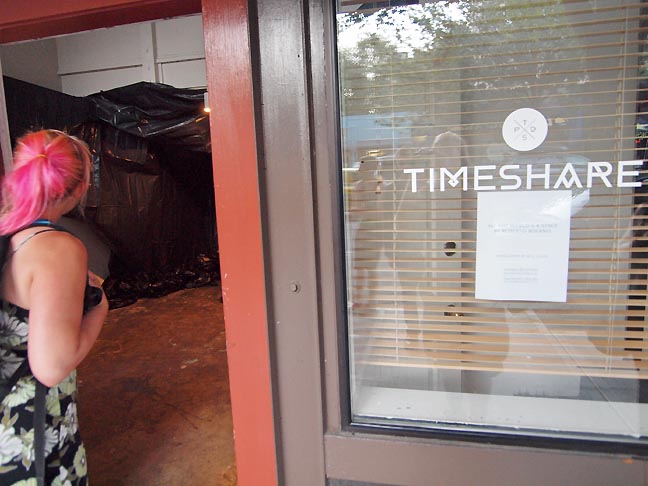
Timeshare at the Everett Station Lofts. Last night I noticed that the Everett Station Lofts (which houses 13+ gallery spaces and has made significant contributions to the Portland art scene) might be taking an upswing with Timeshare Gallery after a few years of disappointing efforts. Sure, Half/Dozen leaving was a blow to the lofts but those spaces traditionally go through high and low tides and 2 years is a long time for any gallery at the ESL to stay open. Historically, Timeshare's unit, #114 has spawned some of Portland's all time best alt-spaces like Nil, Tractor and Field. Breezeblock and now Timeshare give me hope. A few other galleries on NW 6th seemed promising too... look sharp, we are watching. The Portland Japanese Garden receives its largest gift ever putting it 1/3rd of the way to its 3 million dollar expansion goal, endowing a curator (programming is key). The expansion will be designed by one of the planet's very best architects, Kengo Kuma. It will be his first US project. AFC reports that the Utah Art Center is facing eviction/censorship... I went to grad school in Utah (my god mother lives in Park City too) and yeah things like this happen all of the time in that state. Give the UAC a break... the world is starting to pay attention, perhaps that is the problem? It has been a somewhat quiet week on the MOCA front with a few former board members speaking out on Facebook but MOCA Mobilization reached 1500 signatures on its petition for restocking the curatorial program, which was gutted at the end of June. Tyler Green has been following the situation at the Corcoran, with the latest development being the DC DA looking at some of the legal ramifications of trying to move from the nation's capital to the suburbs. Posted by Jeff Jahn on August 03, 2012 at 9:59 | Comments (0) PermalinkTuesday 07.31.12 Jesse Hayward on KBOO 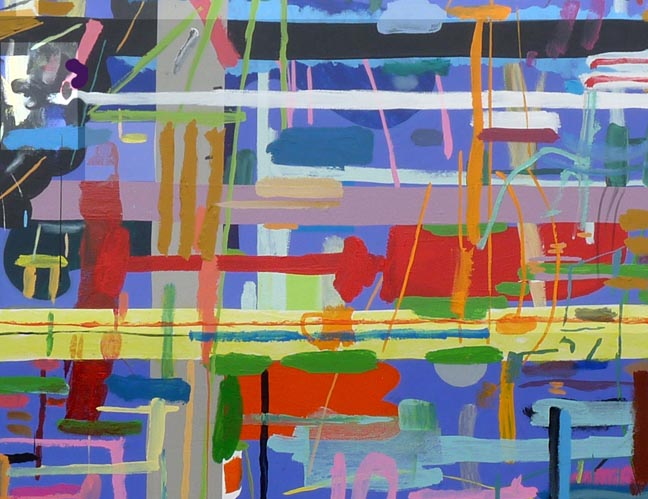 Weather Helm Jesse Hayward is perhaps Portland or even the Pacific Northwest's most radical abstract painter (and a close friend). Today he spoke to Eva Lake on KBOO. It is bittersweet timing as Hayward's show at Gallery Homeland is opening so soon after his mentor, Karl Benjamin... the dean of West Coast abstraction has passed away. Hopefully Eva asked him about his relationship with this central figure in west coast art. Posted by Jeff Jahn on July 31, 2012 at 10:11 | Comments (0) PermalinkFriday 07.27.12 Friday roundup Hyperallergic has a compelling interview regarding the corrosive influence of money on the arts (many Portlanders will find those words highly ironic, but in some ways it's the lack of $$$ that has made Portland so interesting). The fact is there is money in Portland, the question is are we directing it the right ways? It has improved, but we do need to take a good hard look because things are much different than they were 15 years ago.
The former interim director of MOCA asks Eli Broad to have Deitch removed now that this situation has become a, "four alarm fire." Honestly, I think Dietch would want this... he's up a creek without a paddle at this point and a change could galvanize more support for MOCA in the short and long term. Broad can actually save face by admitting a mistake instead of doubling down on a bad bet at this point. At the end of the day it will be Eli Broad who saves Moca... not Deitch and that fact alone means Deitch has failed and needs a replacement. In more icky news, MOCA just announced it was withdrawing from the planned Richard Hamilton show. I fail to see how pulling out of a seminal Pop Art retrospective is anything but political as this was a show created by Moca's former chjief curator Paul Schimmel. What? LA not interested in the roots of Pop Art from they guy who started it all? Finally, some good news to report, the Portland Art Museum has hired a new Director of Education, Michael Murkowski. It is a key role and PAM has become a place where talented individuals want to work (as a good career move) and Murkowski is considered a leading thinker in Museum driven education. Welcome to Portland. BTW it is the 4th Friday so PAM is free tonight. Check out Francis Bacon, Ellsworth Kelly, Bruce Nauman and Mike Kelley. Posted by Jeff Jahn on July 27, 2012 at 10:53 | Comments (0) PermalinkThursday 07.26.12 RIP Franz West 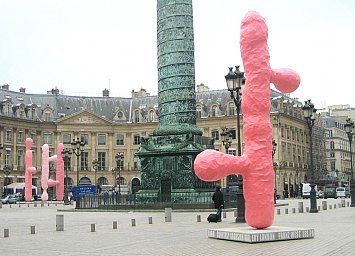
Franz West sculptures disrupting the imperial civic tableaux Honestly, I'm too busted up about Franz West's passing at age 65 to do a detailed obit (of which there are many)... perhaps a more comprehensive historical essay in the near future is the better thing? He was a hero of mine and getting to spend a bit of time with him here and there became crucial to my perception of art's role in the human experience. As a sculptor, his approach to civic space alone was the most successful since Calder. His sculpture leveled the playing field between the real and implied power of real estate and the individuals within a civic space. Just a week or two ago I was chatting with Dan Attoe about his sculptures as hats for skyscrapers. Too good for this Earth. Posted by Jeff Jahn on July 26, 2012 at 11:03 | Comments (0) PermalinkTuesday 07.24.12 Discussion on KBOO 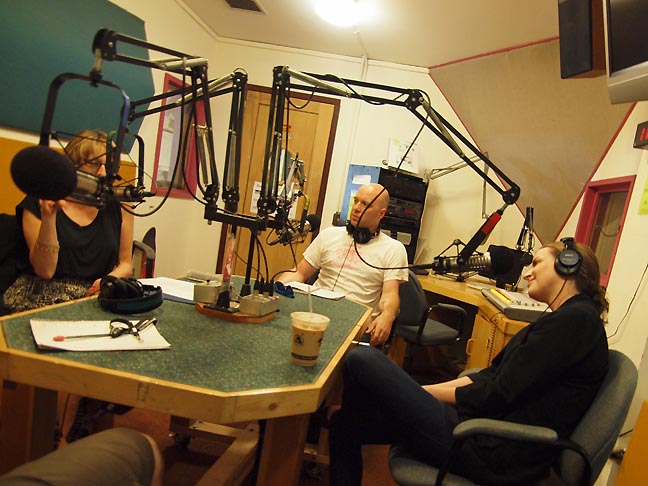
Today I appeared on KBOO's Art Focus with host Eva Lake, Jane Kate Wood and Stephen Slappe. It's a continuation of the Hot Haus discussion and my developing Priming the Cultural Pump essay. It was interesting, similar yet different and a lot shorter... with some new talking points that developed in the wake of the first discussion. I'll be working on the essay for another few days then I plan to put the heuristic discussion to bed... so I can get back to the nitty gritty that is criticism. Overall, a good Summer discussion to have before the second half of the year begins in earnest like it does every year in August. Posted by Jeff Jahn on July 24, 2012 at 11:11 | Comments (0) PermalinkMonday 07.23.12 Monday Links Rest in Peace Herbert Vogel, one of the world's greatest art collectors... and among the most generous too. Mr. Vogel and his wife Dorothy gave the Portland Art Museum 50 works of art in 2009.
Biennials, relevance, backlash... all good topics in the LA Times. The city of Portland has approved the designs for a subtle and stylish new Apple store downtown. The fact that the design commission keeps bringing up the fact that it is different than the surrounding architecture continues to be a problem. Look, new buildings should look new, let the old buildings look old while updating the mechanicals and other systems. That is good urban design, change is good... especially if a design honors its own time. That way the new and old highlight each other and the fact that this has been approved might improve the quality of other projects since most of the new construction in Portland tries to mask the fact that it is new construction (12+ story fake brick buildings anyone?). Now for our weekly dose of MOCA's sad spiral. Jeffrey Deitch has finally responded to his critics basically stating that he has the support of his core board. That's probably true but the problem is he needs to expand the board and diversify it in order to be successful. Instead, most of his leadership activity has been programmatic, and though that is valid... concentrating on programming without fixing the endemic weakness of the board is worrisome. Then there was this fine article on the way institutions approach their public from Buffalo. Then this LA Times interview summarization by Reed Johnson presents a situation where Deitch feels he's being misinterpreted... problem is if people believe the version that Mr. Deitch denies it means he isn't making any progress on digging out of this mess. He will have to try something different if he wants to succeed. Roberta Smith thinks Deitch should do a 180 from what he has been doing, but honestly I think he's building an subtle exit strategy by not doing those things. If he leaves without fully implementing his plans he can claim a kind of lynch mob of scholarly public opinion thwarted a good plan. If Deitch's inevitable departure (the job doesn't let him be Jeffrey Deitch, which he IS good at) can galvanize a backlash leading to a resurgent and more active board with renewed commitment to curatorial rigor I'll be happy. So far no happy ending in sight though. Posted by Jeff Jahn on July 23, 2012 at 11:16 | Comments (0) PermalinkTuesday 07.17.12 2013 Contemportary Northwest Art Awards Finalists Announced The Portland Art Museum has released the list of finalists for the 2013 Contemporary Northwest Art Awards. The list looks solid but on the tame side, though it should avoid the unmitigated disaster that was the 2011 CNAA's (which felt not so contemporary). Although better, it still seems like the process isn't highlighting much in terms of "edge" or very demanding contemporary work and most artists have very strong affiliations to the regional art schools (which is a problem when Portland is full of grads from Columbia, RISD, AISF etc).
... (more for the list and analysis) Posted by Jeff Jahn on July 17, 2012 at 13:58 | Comments (2) PermalinkMonday 07.16.12 Weekend developments The sad spiral that is MoCA's ongoing restructuring (covered by Christopher Knight) saw the resignation of three of it's artist trustees, John Baldessari, Catherine Opie and Barbara Kruger. Only the great Ed Ruscha (the Prince of LA's art world) remains and is reportedly "dismayed." *Update: Ruscha has now left the building... at least as a trustee. Opie and Kruger's letter of resignation IS stunning but in some ways it only reveals how the artists were have been largely figureheads on the board for quite some time. This is notable because it wasn't always like that in the 80's and early 90's. You see, when MOCA was founded artists like Robert Irwin (and Eli Broad for that matter) were very involved and it is what made MOCA special... the museum had a commitment as a laboratory of ideas at its inception (something that MoMA has already lost). There was a sense that MOCA was the new frontier, but as Knight pointed out, the reckless neglect by the trustees in the recent past (using the endowment for operating funds) brought the institution to the brink. Though many onlookers see these artists leaving as a bad sign (and it is) some prominent art dealers are excited about a changing of the guard. I remain skeptical.
Clearly Deitch is not handling this situation well, and I suspect we will hear something from him shortly (he's been very quiet... expect it in the New York Times). As a gallerist Deitch could make very unilateral decisions with very little consequence but by now he's discovered just how different a situation a museum director has it. Director's build coalitions and the main problem is the lack of Deitch building any new coalitions. Right now it is the same old dynamic of Eli Broad, Maria Arena Bell and David G. Johnson calling all the shots. Right now Deitch has the support of Broad (whom I see less as the villain as many do but as a tough love giving yet over-correcting uncle, at least Broad is a man of action and did save MoCA from LACMA etc.) but that support will dwindle if Deitch can't make any of his own weather. That weather would be new blood at the board and a worthy successor to Paul Schimmel as curator (one of the finest on the planet, he's now become THE temporary martyr for quality curation, which is good for the museum industry's own identity crisis). The "Disco show" Deitch is creating is programmatic and therefore looks to be overstepping his bounds and it is no surprise Schimmel stepped down. Yet, truth is a very good disco show could be done, but not with the skeleton curatorial staff Deitch currently has available. Instead, what Deitch needs to do is twofold; 1) install another talented curator capable of backing the flash up with intellectual rigor and 2) add board members capable of balancing Broad's influence. After all this hullabaloo Broad would logically just want to concentrate on his new museums in Michigan and LA (right next door to MOCA) so his patience with the way this has been handled has to be waning (evne if publicly he supports Deitch). Still, I understand Broad's take... he doesn't want to cut MOCA any more big checks, you'd think 30 million would buy you some love in LA... but NO. That has to change if LA's funding dynamic is to become healthier. Overall, I think Deitch has a max of 2 years (or as little as two days) of Museum directorship left in him (because it is more difficult/less profitable than returning to being a dealer) so he needs to form a transition coalition. Best case scenario... appoint a young curator who can help save Deitch's face programmatically as well as build the board into something sustainable and active (not the passive thing that got them into this mess). Whether that board includes artists (as was once the tradition) will probably rest on Ruscha's shoulders, which means the transparency Opie and Kruger called for will need to be in effect. Can MoCA recapture some its core values? Last Week's letter from several other Life Trustees suggests yes. The ball is in Deitch's court and I think he has only got a few good options left, Broad has given the director enough rope to hang himself with or create a rope bridge over this yawning chasm that has developed. A good director will effectively turn all this this drama into an opportunity to normalize this situation. Time to find out if Deitch has the chops?... it is much harder to add new trustees when the place is full of high drama and bad feelings... In much better news, Portland artist/designer/editor Joshua Berger addresses the Portland Community from which he is drawing strength after his harrowing brain injury. This is going to be frustrating and slow, but Josh is showing improvement... he's a smart talented guy and we all wish him the best. We've all got your back. Posted by Jeff Jahn on July 16, 2012 at 9:24 | Comments (0) PermalinkWednesday 07.11.12 Wednesday Links Portland Architecture interviews Skylab's Jeff Kovel. Most of the design savvy people I know in Portland also share a fondness for the Union Bank of California building. Did you know the grey/green slate was quarried from a site nearby where Stonehenge's bluestones originated?
I missed this last weekend but anti BP protestors brought a part of a wind turbine to Turbine Hall to protest BP's sponsorship of Tate Modern. Great protest theater. Has BP reformed? Has the continued pressure on the Tate Modern and BP lead to better behavior? Maybe having BP associated with Tate Modern is a win win (funding and PR stunts) for the Museum? Posted by Jeff Jahn on July 11, 2012 at 17:37 | Comments (0) PermalinkMonday 07.09.12 Museum and Civic Links 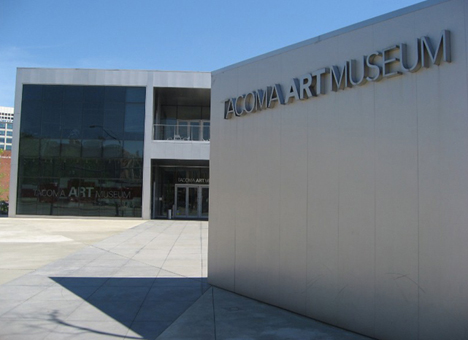 TAM's building by noted architect Antoine Predock, the new wing will compliment it. The big news this weekend was that the Tacoma Art Museum will be expanding with a 15,000 Sq ft. new wing devoted to Western American art. TAM is already the most focused of the area's larger museums (special focus on Northwest Art) so this addition of the Haub collection dovetails nicely with their current mission. I think it is particularly important to think of everything west of the Mississippi as "The West" so it isn't just California, Santa Fe and Texas centric. There is a Northern, big tree-d aspect as well that includes Alaska and Canada as well. I support including Mexico to compliment the international flavor of this vast region's history as well and TAM has always taken this tack. The problem with regionalism is it usually is so narrow, with a touch of inferiority and bitterness. It doesn't have to be as projects like Pacific Standard have shown. I think it is fine that it is just one collection for the wing... it becomes a coherent anchor, similar to the Greenberg collection at PAM did. Nice that much of the Haub's collection is comprised of living artists. (*Note the Haubs are not the only German Billionaires doing high profile things in the Northwest...) Tomorrow on KBOO tradio catch Bobby Abrahamson, Julia Dolan of PAM and Myles Haselhorst talk about North Portland Polaroids, which encompasses 2 exhibitions and a book. There are two exhibitions, one at Blue Sky and Ampersand Vintage. Portland is getting better at telling its own stories and these shows are just part of a groundswell in self awareness and a new valuation of our civic worth. And in the downward spiral that is the discussion of MOCA of late the LA Times has another analysis of how the ouster of one of the world's finest curators is not a good thing when considering the long term health of museums. Eli Broad, whom many want to see as the villain... but I see as more of an over-correcting uncle (an accountant is going to react this way to MOCA's fiscal woes) wrote this not so helpful op-ed. The problem isn't Broad... it is the fact that everything seems to start and end with him. LA needs a few more major players involved to give balance. Then again when your top cultural patron is constantly vilified it doesn't encourage others to join the fray does it? Regardless Schimmel is one of the great living curators and it is more of an indictment of LA's funding climate that they weren't able to support him at MOCA longer. The fact that they did for so long is an indication of important things as well. Deitch himself must be feeling some incredible pressure as too... LA is a hard place to be a museum director... expectations are incredibly high but culturally Hollywood dominates the scene making museums seem like the backdrop to quaint often self-important dinner parties. Overall, on the West Coast distractions and comparative youth make patronage priorities difficult to negotiate. At the same time the institutional chaos is good for artists who are coming up. *Update: Edward Winkleman follows a similar line to my thinking... (more) Posted by Jeff Jahn on July 09, 2012 at 11:39 | Comments (0) PermalinkFriday 07.06.12 Friday links I'm still so jetlagged... but something from my travels is coming soon + lots of other stories from our other writers/interlocutors. Till then:
The Guardian takes a look at a show that explores flight. Sounds like a can't miss curatorial idea, Paul Klee taught at the Bauhaus that his students should master gravity to master composition. That's some incredibly good advice. Boston artist lands Sellwood Bridge gig. Brian Libby explores the new Vestas HQ in the Pearl District. Posted by Jeff Jahn on July 06, 2012 at 17:35 | Comments (0) PermalinkMonday 07.02.12 Monday Links I've been traveling and will have some reports from outside Portland shortly but until then here are some interesting stories over the past few days.
This New York times article on the burden that the recent building expansion boom has put on institutions is fascinating. Chicago's Art Institute expansion seems to be the emblematic case study as well. I visited it last week and I noticed that the article missed one key point about Chicago, that it was a way to tie the museum into Millennium Park... a part of that city's gamble for a Summer Olympics, which failed. Overall, the lesson to be gleaned is never expand without a suitable expansion in endowments... an old lesson that PAM's own arch-prudent Brian Ferriso knew well when he was Deputy Director of the Milwaukee Art Museum. He was ahead of the curve back then and it is interesting how many institutions didn't use MAM's Calatrava expansion as a case study. Tyler Green's take on MoCA's firing of Paul Schimmel. Look, besides it's collection Schimmel was perhaps MOCA's second most valuable asset. Curators, especially great ones... are still persistently under-valued institutional assets. Christopher Knight digs into the MOCA situation. Portland Architecture reports that Portland's GDP has risen more than some might suspect. Overall though it isn't how much money... it is how it is used. For example, Portland has added a lot of excellence to the mix on an individual by individual basis but that has highlighted the difficulty in making consistent excellence a habit at the institutional level. The art schools, RACC, the museums and galleries are often revealed to be a step behind by very active artists (nationally and internationally) though all of them have improved significantly in the past decade or so. Most attempts to survey or award the scene have revealed that a lot of the institutional thinking is still thinking in terms of hierarchies in play in the 1990's. A lot has changed since then and it has lead to a schism between those artists with an international outlook and those who play the Portland game. The lesson is that if you cant adjust to the international game (PNCA and PAM have done this best with lots of room for improvement) then things have trouble remaining relevant and dont translate to the international realities at work in Portland. Posted by Jeff Jahn on July 02, 2012 at 10:24 | Comments (0) PermalinkMonday 06.25.12 Monday Links Michael Heizer debuted his Levitated Mass at LACMA this weekend. He's probably my favorite living artist and I like the way he places incredible demands upon institutions and viewers... there's something about artists being too accommodating/accessible these days that lessens their impact and by staying away from this opening Heizer did the right thing. He seems to be saying, sure this seems like a big deal to viewers in LA but I'm actually up to something much bigger and better in Nevada desert. And he is.
I don't think anyone will be all that surprised that Giacometti sculptures suppressed the appetite for chocolate compared to Mark Rothko's paintings... but it is an interesting/amusing study. Posted by Jeff Jahn on June 25, 2012 at 1:37 | Comments (0) PermalinkMonday 06.18.12 Monday Links The New York Times had an interesting article on Josiah McElheny. Last year it was announced that YU was to do something with him but precious little info has been forthcoming. BTW this is what we are talking about when we say there hasn't been clarity in programming (set a time and a date on the calendar about 6 months out, define what they will be doing and then deliver.... name dropping then no followup isn't the best way to increase confidence, or perhaps Percival's departure effected this).
It's a bit of a tired art world joke these days to farm out work to Chinese painter mills (Ai Wei Wei was there first of course) but Greg Allen had several destroyed Gerhard Richters recreated. It is interesting, though the fakes aren't too convincing. Kink FM did this video interview with Jack Shear, the Director of the Ellsworth Kelly Foundation on the occasion of Kelley's print show at the Portland Art Museum. It is a great summer show for PAM and I did a rather involved interview with Jack and Jordan Schnitzer, which I'll be posting in the near future. Posted by Jeff Jahn on June 18, 2012 at 12:26 | Comments (0) PermalinkTuesday 06.12.12 Catch up links Ralph Rugoff picks his top ten favorite invisible artworks.
Tyler Green reported that the Corcoran may or may not have 22.5 million more in cash to work with, begging the obvious question... do they still have it? Politifact rates Sam Adams' claim that only 18% of Elementary School students in Portland are getting an arts eduction as true. This is startling and a major blemish on Portland's ever increasing international reputation as a progressive leader. The thing is, does that truth move Portland voters towards adopting the CAN initiative in November? I'm not so sure. It is a harsh fact but without a much better economic climate I fear November is not the best time for CAN's $35 a year income tax to be put to a vote. There is something to not putting all of your eggs in one basket and Portland should be adopting a more sophisticated approach to civic funding of the arts even without CAN. For example a city like Houston has an over-arching policy that all arts funding be directed at making that city an "arts hub" on an international level. Portland by comparison has a rather dippy approach, which generally favors process over excellence. It is a comparatively insular approach and causes much frustration amongst an art scene, which is active internationally and thus can compare the realities at home and abroad. There is a schism where Portland doesn't support it's most noteworthy creatives with grants etc... yet the most feel good community art (with little merit beyond that) gets funding. We shouldnt just celebrate community as a blanket term we should be asking "what kind of community?" and "do we reward excellence?" Hyperallergic chooses 9 artists to watch from Bushwick. Posted by Jeff Jahn on June 12, 2012 at 16:24 | Comments (0) PermalinkTuesday 06.05.12 The Corcoran's institutional lessons The post of the day belongs to Tyler Green who assiduously digs through the longstanding institutional malaise that is the Corcoran. It's obvious from reading the piece how the lack of decisive long range planning has hamstrung the institution's ability to even make short term decisions like programming work. It can never be just the building or just one show... it is game of chess and a series of long term strategic moves, not checkers.
It reminds me how the MoCC faced a similar situation and has made a merger with PNCA work by not hamstringing key staff members like Namita Wiggers (disclosure board members are friends and we did talk privately). In that situation I decided to play the skeptic to give that key staff leverage because allowing your curatorial/fundraising staff to plan effectively is essential... they are the captains that pilot the ship away from deadly reefs. Also, having a board that can make tough decisions is equally key in the long term and it is clear from Tyler's piece that there is a complete disconnect between the board and institutional leadership... I fear it wont end well for the Corcoran. Personally, I hope the National Gallery ends up with the building and perhaps even the collection. Suburbia isn't a good place to move to once you've been in the heart of the nation's capital. I see this as a cautionary tale... an institution has to be always moving forward, with a good board. Recently PICA "learned that lesson", though YU should take heed... by having a board and solid programming rather than opportunistic programming and an undeveloped board consiting of the founders who have admitted publicly that they don't have the "credibility" needed. Without those things you simply don't exist as the Corcoran is about to find out. Posted by Jeff Jahn on June 05, 2012 at 11:39 | Comments (0) PermalinkMonday 06.04.12 Monday links and thoughts Artnet has images and some discussion of the Made in LA Biennial. Overall, it doesn't seem like the work is terribly special and definitely not better than what can be seen regularly in Portland's alternative spaces BUT the presentation of it and the overall vibe of the show is infinitely better than what we saw in last year's CNAA's and the recent Portland2012 effort. The difference is the overall intention of the Made in LA's curatorial team to be relevant (both in the city and abroad). There is widespread dissatisfaction amongst Portland's community of sophisticated artists/collectors with our institutions right now. So, if I sound like I'm annoyed with our institutional curators whose job is to attempt to present the local scene... that's because you simply don't get out enough and it really shows. Hint, try curating a show that strays beyond a white, gray and black color scheme or relies on craft as a crutch rather than a ramp from which the viewer is catapulted into the air. Portland is very exciting as a scene but institutionally isn't keeping up with the better artists (who happen to be getting a lot of national/international looks & attention), instead Portland often navel-gazes at artists it has been over-familiar with for 2 decades and don't excite anybody. In other words, step it up (this feeling is widespread and not just my own). BTW, good on Jarl Mohn for upping the ante in LA... for those who are paying attention will recognize his name from the Judd show we did back in 2010.
Holand Carter reviewed Sue Coe, who turns up in Portland from time to time. The Guardian interviews Jenny Holzer on the subject of her early work. And last but not least PNCA released this architectural flythough of the planned renovation of the 511 building by Brad Cloepfil/Allied Works. It's a great fundraising tool methinks. Despite the one person talking on a cellphone in a gallery space! The design itself has come a long way since its earlier more "museumy" iterations. It seems light filled, with numerous multilevel sight lines and very flexible layouts befitting an art school. It reminds me a little of Toyo Ito's Tama Art University library with all of its arc and light elements, which is a good thing (though it just isn't as bold as Ito's design). I like the flying walkways but the thin ceiling mounted movable wall systems always look cheap and wont be good for installation art, just paintings and works on paper a floor based system is more flexible too. This 511 building (which we were the first to see as a game changer)... along with the Kengo Kuma designed Japanese Garden expansion are very exciting architectural projects for Portland. Posted by Jeff Jahn on June 04, 2012 at 14:03 | Comments (0) PermalinkTuesday 05.29.12 Tuesday Links I hope everyone had a great weekend and if you were in Portland did not miss the Rothko show. Here are some links.
Roberta Smith goes on about fun house art. As I wrote last year, I agree that some artists like Carsten Holler and Olafur Elliason do make fun house work that doesn't demand much of the viewer. Then there are artists like Alfredo Jaar, Robert Irwin, Richard Serra who push institutions and viewers to their limits. That isn't a fun house it is to rigorous and demanding for that and the distinction needs to be made. BTW the fun house stuff likely started with Salvatore Dali's World's Fair pavillion. It's all a question of how much pandering the work does towards the viewer's expectations. Here's an article on the "Try-Again-Ennials" from Modern Painters. Posted by Jeff Jahn on May 29, 2012 at 10:24 | Comments (0) PermalinkFriday 05.25.12 Friday News Kanye West has a pyramid designed by OMA dedicated to him for Cannes Film Fest. Sure he believes his pyramid is the greatest of all time but it is in fact a tent... an awesome big-assed tent but a tent none the less. Interesting viewing environment though.
In the least shocking news of the week, longtime Museum of Contemporary Craft curator Namita Wiggers was named director. I've always described Wiggers as MoCC's #1 asset, even above its building and collection so this makes sense and I suppose it took this long to happen because she is such a force as a curator and thinker. She succeeds my friend Jeffrey Thomas, whom was interim director for a year and stepped down a few months ago. My read on this is that his tenure was a way to allow Namita to transition and to get the museum on firmer ground with old Portland and national level funding sources... while she got the programming back on solid ground. Normally, I'd be concerned about the quality of programming with such a shift but shows curated by others like the recent Northwest Modern show were excellent historical efforts. Namita's current Betty Feves retrospective wont be her last effort either. Frankly, she's one my favorite art people in Portland and this is good news. It is the last weekend for the Mark Rothko retrospective at PAM (and it's free tonight from 5-8PM) so catch it. Yes it has been extended through Monday the 28th. I'll have more on this later weekend. And last but not least think about attending this event documenting the history of experimental film making in Portland on Sunday for EFF. Jim Blashfield, Matt McCormick etc... Posted by Jeff Jahn on May 25, 2012 at 12:45 | Comments (0) PermalinkMonday 05.21.12 Art and Real Estate links The New York Times covered the out of the way Maryhill Museum. Interesting comparing the writing on it in the local paper. The O certainly has its work cut out for it when all this local stuff is of national interest... i.e. look sharp and never ever use irrelevant terms like "Big City"... Look, the area has an idiosyncratic appeal so pay attention to those aspects which are making them stand out nationally/internationally. Basically, beware of familiarity breeding contempt. We have natural advantages here but you have to be looking for them to see how special they are to outsiders. Basically don't take the area's pioneering pluck for granted, sometimes it is much more valuable than simple dollar signs.
And speaking of idiosyncratic museums, collections and benefactors Christopher Knight gets right down to it on the whole Barnes Foundation debacle. Oh and with everything else going on I forgot to link to Brian Libby's discussion of PNCA's new residence hall on the North Park Blocks. Posted by Jeff Jahn on May 21, 2012 at 11:07 | Comments (0) PermalinkMonday 05.14.12 Barnes Storming 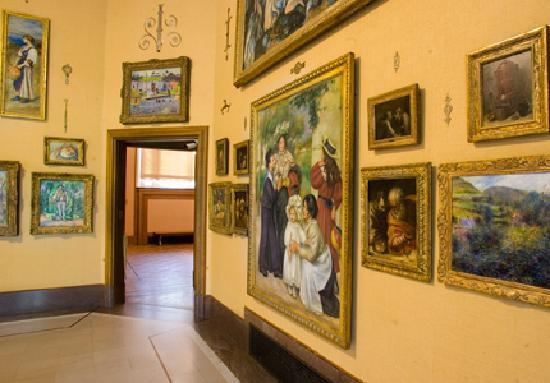 Interior of the original Barnes Foundation I've discussed the Barnes Collection numerous times over the years, and now it is open to the public in a new building in downtown Philly. I haven't seen it yet but on principle I believe it is important to weigh in. Christopher Hawthorne of the LA Times doesn't dig the building. Frankly it was an impossible commission, part of the charm is the destination, the old building smells, creaky floors and less than perfect light. But even more fascinating is this very well written piece by Jerry Saltz that I nearly completely disagree with. Though I generally applaud Jerry's sentiment that no collector should dictate the terms for best viewing the art (especially after they die) in this case I can't agree. Very few collectors deserve equal billing with artists but in this case I believe the incredibly idiosyncratic Barnes did. What is lost by creating a pseudo structure that makes the works more accessible is to lose part of the story of modern art and thus the roots of how we decoupled the power of the image (art, advertising etc.) from the institution and the state... (more) Posted by Jeff Jahn on May 14, 2012 at 12:24 | Comments (0) PermalinkFriday 05.11.12 Friday Links I have expanded my thoughts on Peter Plagens' article in the Wall Street Journal. The repercussions of which should be felt for years because Portland does a lot of great things as an incubator and needs to consolidate those successes with rethinking its support structure and the way institutions calibrate their eye on the scene's often very unrelated strata.
Tyler Green takes a look at some fantastic Rembrandt self portraits. Brian Libby looks at the most exciting new building in Portland's skyline... did I just type those words? Yes, Portland actually has an exciting new addition to its skyline. Posted by Jeff Jahn on May 11, 2012 at 17:02 | Comments (0) PermalinkWednesday 05.02.12 WSJ asks if Portland is America's next art capital? 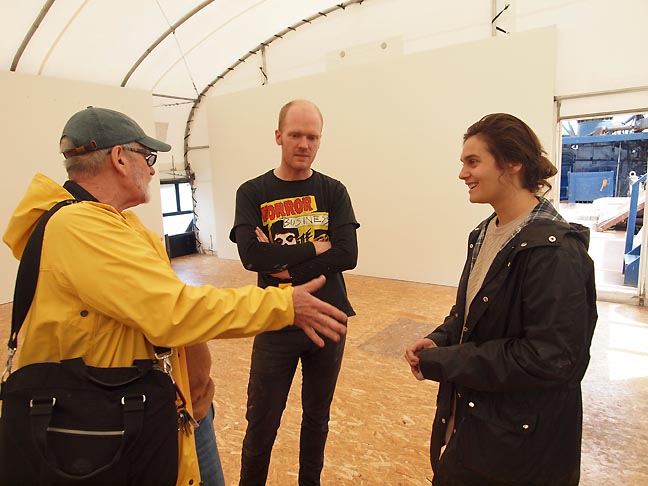 Peter Plagens visiting 12128 2 weeks ago The Wall Street Journal has just published a fascinating report on the Portland art scene by noted art critic Peter Plagens. I was his Sacagawea, er... guide... so yes he's seen infinitely more of Portland's scene than DK Row (or any institutional curator besides Cris Moss and Blake Shell). So yes odds are he probably saw your show if it was up two weeks ago in an established venue. Plagens is a machine and a tough discerning customer who doesn't buy any BS. The first day alone we took in 9 shows scattered throughout the city. There will be some images in the print edition tomorrow but let's just take a quick once over the words right now. Nice that he reiterated the "Capital of Conscience" term that I coined in an Op Ed for the Portland Tribune a few months ago. Because Portland is not a financial capital, NO we wont be a traditional art center like London, New York or Paris of yore. Instead, think of Portland like Weimar during during the Bauhaus years or perhaps Leipzig (the best 25 artists are definitely world class discoveries to be made, maybe only 6 are already known in Chelsea). Overall Portland is full of idealistic people doing idealistic things for the sake of ideals... giving things time to develop before money kicks in and changes things (for good and bad). Portland is a rebel base where art for art's sake is made. We have international art stars who live here too because it is a good environment to work and enjoy the company of other like mindeds. Accurate in that it discussed Portland as a city where creatives work very hard... not just a bunch of slow paced hipsters who are already retired and eat Voodoo Donuts. The truth is most are working very hard to stay afloat and make work... yet some are carrying on an international career. It is true, the alternative spaces are so much more adventurous than the commercial galleries... that could be said of most cities but it's my sense that many retreated quite far in 2008 when the market crashed. Instead of trying to drum up excitement by trying new artists (when nothing was selling anyways) they went for safer stuff. Honestly that makes sense, the gallery business is so difficult but perhaps this article will catalyze a way to narrow the schizm? Collectors might be more involved if they knew what Portland's larger scene was like? As it stands Plagens has seen more of Portland than most Portland collectors, curators and art dealers and he's right the installation art and some video is our strongest suit. He loved Crystal Schenk's Artifacts of Memory (the last show we saw) and Laura Fritz's Entorus (he spent an hour with it... 45 minutes in silence), because frankly they are two superlative exhibitions that outclass everything but the Rothko show at PAM (yeah that good). They would stand out in Chelsea and you can still catch them both, do so. He gives Joe Macca... hell. It's karma time Joey??? PORT's Patrick Collier just reviewed Macca's show too, and didn't go easy on him. He did think Ralph Pugay was hilarious so there you go.... (more) Posted by Jeff Jahn on May 02, 2012 at 14:53 | Comments (2) PermalinkMonday 04.30.12 Last Month for 10th NW Biennial at TAM  It is the last month for the 10th Northwest Biennial at the Tacoma Art Museum, which runs through May 20th. Sure, nearly every institutional attempt at surveying a region's art production tells you more about that institution strengths and weaknesses than the art of that time and place, falling into at least one of several predictable missteps. (Also apologies, despite my best efforts I'm in this exhibition as an artist as well.) So it definitely isn't perfect. In this case the TAM show is too full but it does one thing that none of the recent spate of institutional survey shows have attempted... it has a coherent curatorial criteria, exploring the theme of multi-disciplenary art. Apparently, it helps having a consistent curator who is tasked with making the exercise intellectually viable? Novel idea! So for once this one isn't focused on "whittling" as a Northwest art staple and explores those who explore by crossing different disciplines and strategies. What's more there more artists from Portland in it... (more) Posted by Jeff Jahn on April 30, 2012 at 22:07 | Comments (0) PermalinkMonday 04.23.12 Monday Links and a List In case you missed it:
DK Row actually did a nice job interviewing the three mayoral candidates about the arts in a 4 part series. This is what we expect the Oregonian to be doing, but sadly this sort of eye for relevance is rare and it's generally just gratuitous conservative "shrug pieces". PORT will have something even more targeted and incisive to help you separate these 3 candidates. Eva Lake's first solo show in New York City seems to be going over well. I knew it when I saw this show at Augen... Eva was definitely onto something. Jerry Saltz picks 10 artists to save the art world. He's wrong of course because he didn't pick any Portlanders... we are the "Capital of Conscience" as I penned in the Tribune's Op Ed a few months ago after all. So if I picked 10 Portlanders (who haven't already been in a Whitney Biennial) who would they be? I won't make too big a deal about this list but just off the top of my head these 10 are all ready and doing original, high level work with impressively sustained intelligence: ...(more) Posted by Jeff Jahn on April 23, 2012 at 10:15 | Comments (0) PermalinkMonday 04.16.12 Monday Links Will a refurbished Palais de Tokyo bring French art back into the spotlight?
Finally, an Oregonian article that doesn't make me angry... ironically it is about creative anger. Perhaps anger isn't the right word but a very specific distate for certain things has always been the whetstone for those seeking to sharpen their ideas to a high level of excellence. Argentina builds a new contemporary art district from scartch. Posted by Jeff Jahn on April 16, 2012 at 12:56 | Comments (0) PermalinkFriday 04.13.12 PICA's new headquarters 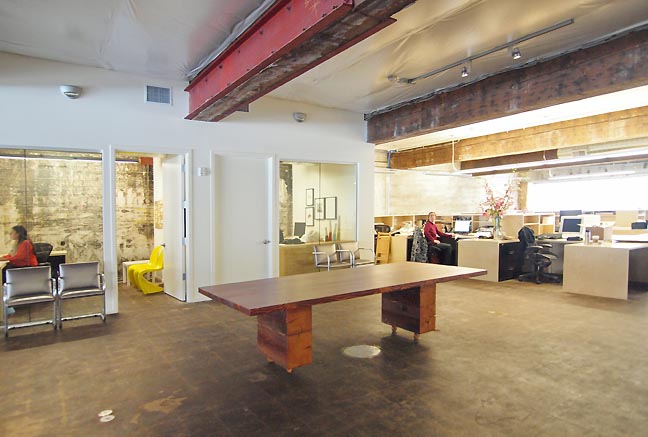 PICA's new headquarters I'm burying the hatchet because this space gives me reason to believe in PICA again but first a little history. In 2004 PICA shuttered its once excellent visual art program, which under curator Stuart Horodner presented the likes of Janine Antoni, William Pope L. Dana Shutz, Melanie Manchot, Jim Hodges, Tony Tasset and Rudolf Stingel... and if that sounds like the most interesting nonprofit exhibition space north of San Francisco it is because it was. What's more the space was large but not unwieldy space designed by Brad Cloepfil, long before... (more) Posted by Jeff Jahn on April 13, 2012 at 13:54 | Comments (2) PermalinkThursday 04.12.12 Arnold Kemp Guggenheim Fellow 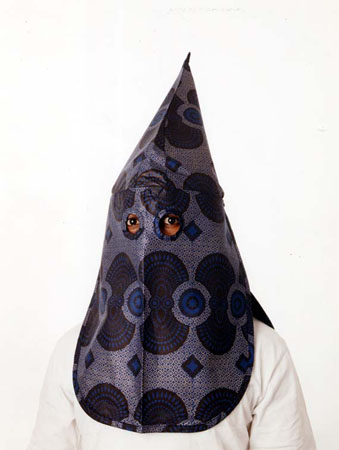 Arnold Kemp's Untitled, (Played Twice) 2011 Congratulations to Arnold Kemp who was just named a 2012 Guggenheim Fellow for the Fine Arts. Kemp's work intrigues me for the way it rehabilitates the rather forced schism between formalism and identity politics. He basically implodes the idea that they exist in separate unrelated universes, which was such a 20th Century way of looking at things. Kemp is represented by PDX Contemporary Art and is Chair of the Master in Fine Arts in Visual Studies Program at Pacific Northwest College of Art. Posted by Jeff Jahn on April 12, 2012 at 11:03 | Comments (0) PermalinkMonday 04.02.12 Monday Links 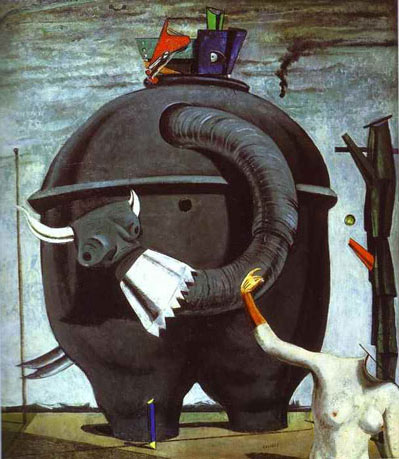 Max Ernst's The Elephant Celebes (1921), Tate Gallery Happy birthday Max Ernst! Somehow I feel like he is now underrated for his contributions to Dada and Surrealism. Perhaps too much focus on his relationships and not the work in art history classes? Adrian Searle reviews Damien Hirst's retrospective at the Tate and doesn't throw the shark out with the bathwater. In case you hadn't heard the Chinese Government is rejecting Ai Weiwei's request for a public trial. Posted by Jeff Jahn on April 02, 2012 at 3:11 | Comments (0) PermalinkThursday 03.29.12 Last Weekend for Marie Watt's Lodge 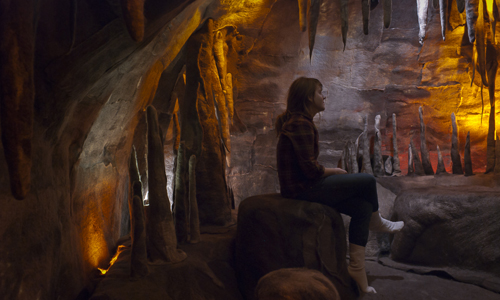
Inside view of Marie Watt's Engine I've been meaning to post on Marie Watt's Lodge but was hoping to catch it first. Well fellow procrastinators (I know it has been a busy) it is now the last weekend for this extensive show at the Hallie Ford Museum, so this is everyone's last chance. The show runs through April 1st so get on down to Salem. "For the past decade, Watt has worked as a mixed media artist whose work explores human stories and the ritual implicit in everyday objects. Organized by anthropology professor and faculty curator Rebecca Dobkins, the exhibition will feature a range of work from the past decade, including stacked blanket sculptures, portrait blankets of Jim Thorpe, Ira Hayes, Susan B. Anthony, and Joseph Beuys, and Engine, a felt cave-like structure that honors the act of storytelling and the storytellers in the artist's life." Posted by Jeff Jahn on March 29, 2012 at 22:37 | Comments (0) PermalinkMonday 03.26.12 Monday Links Today Oregon College of Art
and Craft (OCAC) has announced it is launching a Master of Fine Arts degree
in Craft in the fall of 2013. According to the press release the program, "emphasizes
problem solving through the manipulation of materials and the vigorous exchange
across disciplines and media." Ok, these days Portland art schools seem
to be launching new programs all of the time but this one seems absolutely core
to a school like OCAC. In other words, they needed to do this and do it well.
It should be a signature program for Portland's most focused/specialized art
school.
More details, "With its expansive and versatile approach, the College has designed this MFA as an intellectual investigation of process, purpose, and communication distinguished by its methodology as much as its outcome. The 60 credit program in Advanced Craft Studies combines courses in studio creative practice, interdisciplinary studies, graduate seminars, and electives. 'This new program is the natural outgrowth of OCAC’s long tradition of educating entrepreneurial, critical thinkers and creative makers who innovate through engagement with materials. Craft in the twenty first century, the tradition of what it has been and the innovation of what it will be in the future, is the essential focus of this new degree,' said Denise Mullen, OCAC President. 'The MFA in Craft allows us to grow our programming to a new level, and to enhance our core mission at OCAC of educating professionals at the highest level of object and image making.'" Those interested as MFA candidates should join the contact list at www.ocac.edu/MFA to receive announcements about the new program. There is a new Kieth Haring retrospective at the Brooklyn Museum. I've never been able to decide if he is underrated or overrated so this is probably way overdue. The Brits get things right for a revitalized transportation hub at Kings Cross. Why doesn't Portland pay closer attention to its transporttation nodes as a way to showcase itself? Portland Architecture rounds up a group of recent architectural awards for Portland designers. Posted by Jeff Jahn on March 26, 2012 at 12:09 | Comments (0) PermalinkTuesday 03.20.12 Endowed: Curator of Modern and Contemporary Art at PAM 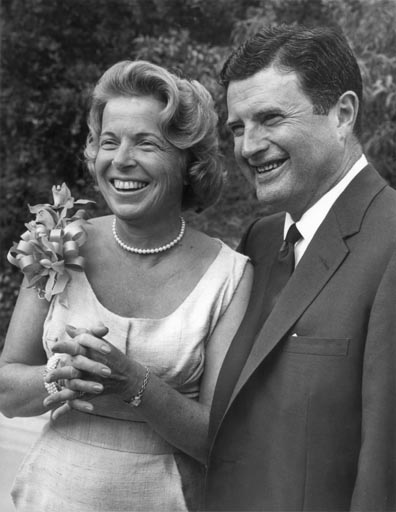
Photo of the endowers, Robert and Mercedes Eichholz at their wedding in 1963 The news of a 2 million dollar endowment for the curator of Modern and Contemporary Art at the Portland Art Museum is an important upgrade for the community in many ways. For example it couples the role of modern and contemporary art while ensuring that the Portland Art Museum should always have the position filled as soon as possible. That's because drawing from the general fund incentivises any museum to let positions sit fallow during times of economic stress. Also, it improves the museum's overall credit rating and financial portfolio. Still, it would be even nicer if Modern and Contemporary art duties were always coupled to the Chief Curator as it is now, and an endowed acquisition fund for contemporary art would also keep things even more contemporary. It also shows how the heirs of important philanthropists choose Portland and change the cultural landscape... in much the same way that artists choosing to call Portland home over the past decade and a half has similarly changed expectations for the city. The convergence on Portland is no accident, money (at least the interesting kind) follows talent. Here is the Press Release: "The Portland Art Museum is pleased to announce that a gift of $2 million was recently pledged by the Robert and Mercedes Eichholz Foundation. The gift from the foundation, headquartered in Santa Barbara, Calif., will endow the curator of modern and contemporary art. The position, currently held by Bruce Guenther , will now be known as The Robert and Mercedes Eichholz Curator of Modern and Contemporary Art. "We are grateful to Mercedes Eichholz and her family's foundation for this generous and important gift,” said Brian Ferriso, The Marilyn H. and Dr. Robert B. Pamplin Jr. Director. "Endowing curatorial positions ensures that the core mission of the Museum is fulfilled." ... (more) Posted by Jeff Jahn on March 20, 2012 at 16:40 | Comments (0) PermalinkMonday 03.19.12 Monday Links The New Criterion asks what is a Museum? There is a definite need for idiosyncrasy with an eye for relevance that makes the authority of such institutions a source of civic pride. Otherwise it's a temple to missed opportunities.
Check out Roberta Smith's critical take down of Adel Abdessemed's well intentioned but hackneyed solo show. This is a problem critics often face when surveying the scene, exhibitions that try so hard to be relevant that they end up being derivative. The Hammer Museum's new regional art prize and awards show for LA makes the Contemporary Northwest Art Awards and Disjecta's ongoing attempt at a biennial seem so tame and non-competitive (collegial familiar names not discoveries) by comparison. It isn't the 100k either, it is the way the Hammer effort is designed to be a taste making show that points out bright new lights just as they flicker onto the scene. This positions LA as being more interested in its cutting edge (Portland's institutions, apparently are not... well except PICA's TBA festival, which can be EVEN less polished than the alt spaces). For example, the CNAA's haven't taken many chances and have felt very safe and so solidly mid career... rather than picking work that spoke the most to our uncertain times. The last CNAA's had zero edge, whereas the current Portland2012 doesn't so much present new names as reconvene a group of artists who have had academic shows in the past few years... with an overall feel that is well, academic. It is often a throwback to the 90's, which is something that happens when you use a guest curator not someone who has been in studios for years before the show. The sad thing is Portland's alt spaces are doing a lot of very interesting work that certainly can give LA a run for their money (if only our institutions could get their heads out of the sand and made a point of doing a show about the times.... one has to take more chances to be relevant as a taste maker). My sense is that Portland's institutions are so busy trying to ingratiate themselves with the constituents they already feel comfortable with that the potential shock of the show itself becomes a foregone conclusion. Rather than lead, they insinuate. The Hammer doesn't have that problem, they lead by taking chances. Then there is this cathedral converted to a bookstore... ahh if only all sacred places could be a place of learning. The cross shaped conference table seems a tad much though... we get it and yeah some ex-catholics will dream of having sex on it. Posted by Jeff Jahn on March 19, 2012 at 18:43 | Comments (1) PermalinkSaturday 03.17.12 Pat Boas 2012 Bonnie Bronson Fellow 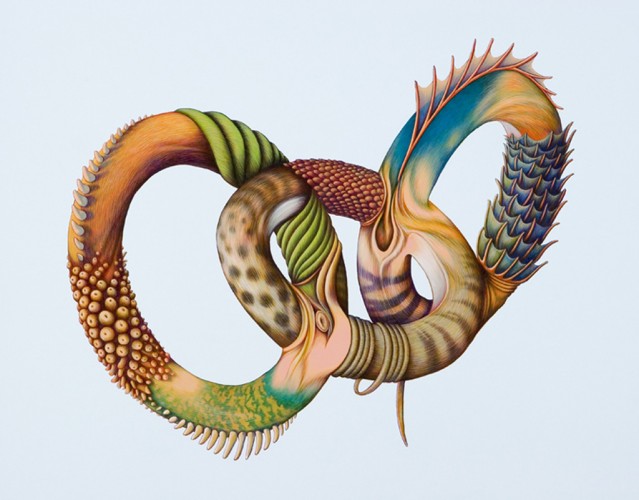 Pat Boas' Against Nature series (2005) Pat Boas has been named the 2012 Bonnie Bronson Fellow. This continues the more conceptual direction of the past 3 years with David Eckard and Nan Curtis (all three are well established educators who have been active since the 90's). Boas' work is fastidious and somewhat obsessive in nature and she usually works in discreet series. My favorite works by Boas are the Against Nature series, which biomorphically shift between various animal skins... as if to summon the specter of genetically engineered food. Congratulations! Award will be presented April 18 6:00 - 7:30 PM at Reed College's Gray Center Lounge Posted by Jeff Jahn on March 17, 2012 at 13:43 | Comments (0) PermalinkMonday 03.12.12 There is always a bigger rock It is often funny when people think they know which artists I'm most obsessed with. Over the years some have thought the AbEx greats or Donald Judd. I understand
why they might think these things but they are wrong. The artist who I've thought most about since a massive
8,000 mile land art road trip is Michael Heizer. Without Heizer we don't have
Smithson or Walter De Maria and I don't even feel like Double Negative is his best work.
As a child Heizer, grew up in archeological digs throughout the vastness of the Western United States and then passed some of that experience onto his art friends at a crucial time.. but he's actually the most interesting of the three. He considers New York's art world kinda soft (because it is if you are used to living in the harshness of the Nevada desert) and will likely only open his masterwork City to the public only when he dies.  a house-sized rock on the rim of Meteor Crater in Arizona, center (photo Jeff Jahn) All of this makes the spectacle around his latest project for LACMA seem like a diminutive sideshow. It does bode well though for how his work will be received once the world can see his main focus. As it stands Levitated Mass is at best medium level work for Heizer but it is good that the city folk are getting worked up. In fact, Heizer once had the jones for even larger rocks, like the house sized one on the rim of Meteor Crater in Arizona. What impresses me most about Heizer is his toughness and the way he thinks in massive geological and anthropological terms. Lots of artists think bigger is better but perhaps only Heizer and Richard Serra have been able to back it up... and what's more Heizer's work seems to step outside time. It is never about the latest technology like Serra can have as a sub plot. Instead the plot is always the same... dealing with the innate basic forces of the planet. In short he mocks human vanity while embracing its innate hubris as an unavoidable consequence of our existence. The fact that he has all of LA watching one medium sized rock must make him chuckle. Good for him, artists should have the last laugh and for once it is nice to see Art grandstanding more than the movie industry in LA. I like the way art places demands on civilization, it is the opposite of entertainment. Posted by Jeff Jahn on March 12, 2012 at 13:40 | Comments (1) PermalinkFriday 03.09.12 Friday Links New Orleans chooses public sculpture as flood evacuation spots.
A stolen Poussin and many other paintings resurface, all in the same neighborhood the were originally stolen from. The Mona Lisa could have been completed a decade later than once thought. Art Info's anatomy of the 2012 Armory Show. Posted by Jeff Jahn on March 09, 2012 at 11:09 | Comments (0) PermalinkTuesday 03.06.12 Candidates and the Arts Last night's Mayoral and City Council, arts and culture Q&A at the Armory (video here) went pretty much as expected, except that Mary Nolan and Jefferson Smith were not able to be present (Smith due to his work in the legislature in Salem). There was a lot of boilerplate and outright dodges but here are some impressions:. Overall, none seemed that terribly different from one another except Brian Parrot, whose constant equation of the sports and the arts fell on deaf ears. Look I'm a fanatical tennis player and his equation of art and tennis makes no sense to me and I wrote the book on it. Also, his call for an Olympics Winter Games bid as a way to heighten the profile of the arts was also a non starter. 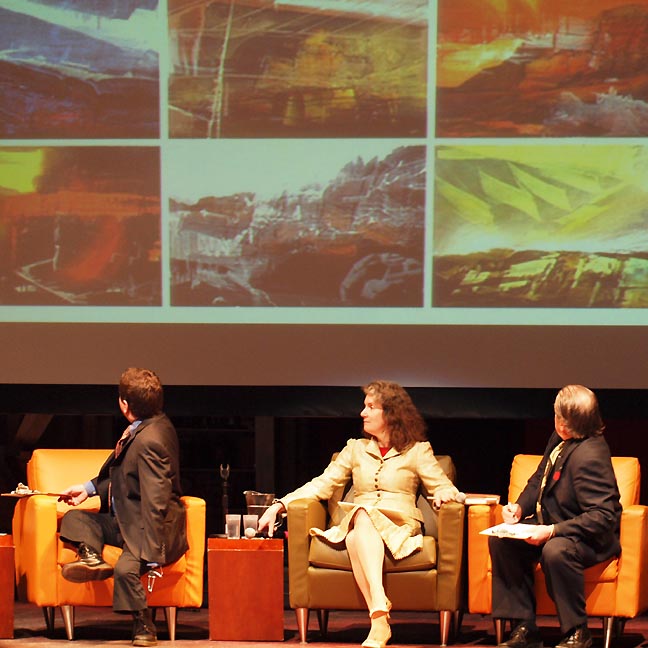
City Council candidates and James Lavadour images Surprsingly none of the city council candidates knew who James Lavadour was (major opportunity to score points lost, though technically he doesn't live in Portland)... I bet they do now. All of the candidates (except Parrot) i.e.; Amanda Fritz, Eileen Brady, Steve Novick and Charlie Hales were staunch advocates of core issues like the planned but potentially delayed 10+ million dollar tax levy for arts and education as well as Mayor Adam's current call for diversity in arts funding. None seemed too eager to put the levy to a vote this Fall so the supposed key issue is a non issue. Surprisingly none of them wanted the be... (more) Posted by Jeff Jahn on March 06, 2012 at 13:13 | Comments (0) PermalinkMonday 03.05.12 Monday Links Hmmm, need any more indications that the Columbia River Crossing's hurried, cheapie design wasn't all that well considered? Well it looks like they designed it too low. I sense this is only the tip of the iceberg and hopefully Washington State's deep funding crisis will kill this thing so it can be begun the right way... not Kitzhaber's rushed, even seismically short-sighted way (cable stay designs are currently superior to all other bridge types in major earthquakes, they also allow for higher clearances... that option was nixed as an option for cost and schedule reasons).
Roberta Smith's take on the 2012 Whitney Biennial... honestly the multi-disciplenary concept doesn't seem new to us here (TAM's current NW Biennial, TBA, Core-Sample in 2003, programming by Worksound, Rocksbox, Gallery Homeland, Recess etc.) but I do like the idea of it not being your typical Biennial where too much work is included with a "throw it and see what sticks" strategy. Here's Jerry Saltz's take too. It seems so quaint to us here in Portland that New York is trying to be non-comercial... when so much here is non-commercial as a default. Not that it's bad... it is just that commercially focused efforts seem novel to us in the way non-commercial seems novel to NYC. And in case you didn't know some of the Appendix crew (Travis Fitzgerald, Daniel Wallace and Josh Pavalacky) are opening a new type of Gallery in New York City called American Medium. Hilariously they are not moving to NYC and I like their focused & too cool for that approach, I'll let them give you details in good time. It's a different type of art gallery for a different type of work. It opens in May. Posted by Jeff Jahn on March 05, 2012 at 12:28 | Comments (0) PermalinkFriday 02.24.12 Kenneth Price dies at age 77 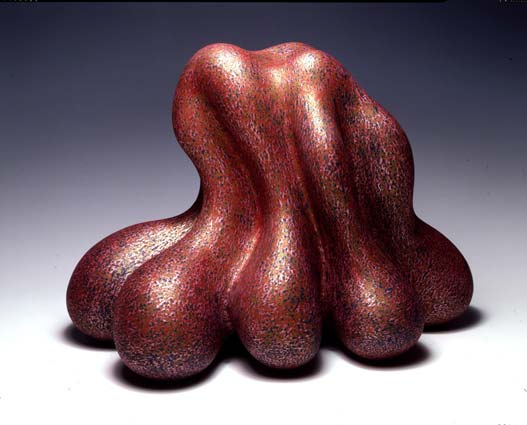 Kabongy Balls (2002) It seems like we lose a great artist every week or so these days. The latest is Kenneth Price at age 77. Perhaps no artist bridged the craft/fine art divide like he did and his jewel like surfaces were a key component in Dave Hickey's paradigm shifting Beau Monde Site Santa Fe biennial in 2001 ending what seemed like a 25+ year unofficial ban on beautiful art. His work was never just pretty though. It was sexy but a little grotesque and by avoiding the self consciousness of a lot of craft based work it transcended that genre's often cloying need to be taken seriously by simply stealing the show every single time they were shown (that's telling). Price's works were so outstanding, with forms so self assured and relaxed in their own perfect skin that they transcended the technical geekery of the craft world, putting all of their considerable aesthetic weight into the viewers mind and response. Thus, how it was made was always tertiary but integral to the encounter, similar to a lot of non western art. I always found them compelling, as if Price gave unlikely life to a pile of puke while imbuing it with the moves and curves of Cyd Charisse. In fact, Dave Hickey's Site Santa Fe install could have easily been likened to a dance between Charisse and Fred Astaire, it was just that good. He will be missed, but not forgotten... a 50 year retrospective will begin at LACMA in the Fall. *Update: Roberta Smith of the NYT's fascinating obituary . I found these quotes quite interesting, "crafts-dogma hell," and, "'I can't prove my art's any good,' he added, 'or that it means what I say it means. And nothing I say can improve the way it looks.'" Indeed... Posted by Jeff Jahn on February 24, 2012 at 10:12 | Comments (0) PermalinkTuesday 02.21.12 Preserving Washington State's Public Art Washington State's most famous bit of public art, Barnett Newman's Broken Obelisk (1963)technically not at risk but it is a slippery slope The idea to sell off works in Washington State's public art collection is such a bad idea. Also, the wolf in sheep's clothing tactic of using sales to fund scholarships and more art acquisitions doesn't make it any better. Weve been down this road before with both the Rose Art Museum and the Oregon Cultural Trust. Both of which ended up getting support from conservatives and non arts people... here's why: 1)Public collections are kept in trust for the public. The thing about trusts is that you don't go radically altering (in this case selling) the asset kept in trust. If you treat a trust as a rainy day fund it simply ceases to exist. 2) This is particularly short sighted since the elements of the collection are acquired for the way they engage and complete specific sites and buildings. That context building is a sort of running civic commentary and selling said works becomes tantamount to book burning of civic memory. Often the artwork outlives the original buildings and provides a thread through the past. 3) Selling works when you think they are worth a lot of money is foolhardy. For example, though... (more) Posted by Jeff Jahn on February 21, 2012 at 10:48 | Comments (1) PermalinkMonday 02.20.12 Presidents Day Links Ok it was an epic visual art weekend in Portland with Rothko and Nauman events and exhibitions (more to come on those). Till then, here are some Presidents Day Links:
A hilarious project and article on the world Google didn't intend to show you with its electronic 9 eyed panopticon? Is there a neurological link between fear and the appreciation of the sublime or abstract art? Holland Carter looks at the New Museum's latest more international triennial The Ungovernables. Reminds me a bit of my Fresh Trouble show in 2005 (probably the stick by which Portland measures group shows) but with an update from the Arab Spring, etc. Fact is the world has seemed much more restless since the WTO demonstrations in 1999 where new electronic media allowed faster and more global disseminations of information and dissent. The Getty gets a new Director but has some of the same old problems. Posted by Jeff Jahn on February 20, 2012 at 10:36 | Comments (1) PermalinkMonday 02.13.12 Monday Links Michael Kimmelman's best writing in ages on the civic importance and humiliation of Penn Station. He's wrong about Calatrava's PATH station though, it's the only architecture at the WTC site that actually lives up to the challenge of the site and it costs 4 billion because of the complications of building there and the fact that Calatrava is NEVER on budget... it will be fantastic though, everything he wishes Penn Station could be, just without the immense foot traffic. It may set the bar higher for Penn Station? Is the Columbia River Crossing going to be a civic/design failure similar to the destruction of and burial of Penn Station? If this humiliation in concrete is constructed it will be.
To prepare for the Rothko retrospective/homecoming at the end of the week at the Portland Art Museum. Re-read Arcy's crucial post from 2009 on the artist's history in Portland and perhaps this letter to the NY Times from Rothko and Gottlieb. Overall, I hope people take this seriously and don't go overboard on the distasteful marketing of Rothko, which he would have hated. No Rothko face painting, no Rothko snuggies and NO Rothko toast art please! I shouldn't have to say this (but I think I have to say this esp with the Red marketing). Simmer down, with greatness comes the responsibility to respect his legacy and Rothko was one of the least commercially oriented artists of all time. Check out these early photographs that a young Stanley Kubrick did for Life Magazine. Posted by Jeff Jahn on February 13, 2012 at 10:32 | Comments (0) PermalinkFriday 02.10.12 Indispensable Replica Links Did you catch this interesting article by Christopher Knight about replicas being used for exhibitions?
I feel it very much depends on the artist and the work. For example there was Kurt Schwitters' Merzbau that recently went on tour, where everyone was very up front about... (more) Posted by Jeff Jahn on February 10, 2012 at 12:49 | Comments (0) PermalinkTuesday 02.07.12 New Faces of the Portland Art Scene 2012 Edition The Portland art scene is ever shifting with new artists arriving every day but it is the often thankless role of being a facilitator (as curator or programming director) that greases the wheels of the machine. For example, if I want to point out an artist I simply write a review but admins are a different story. Also, the level of artistic development of these individuals varies a great deal and is perhaps secondary to the contributions they represent (for now). Also, some new admins like Jeffrey Thomas (Director MoCC) and Bonnie Liang-Malcolmson (Curator of NW Art PAM) have been around for over a decade and have only just recently switched roles (not prominence), so I'll skip over them. I also vet the list for people making an impact beyond expectations (so I don't always pick new hires at PAM, they have to earn it). Also to make my list one has to curate or work on several shows, do more than draw attention to a few of your friends or throw a hipster party... so without further ado here are 9 newish faces you should get to know before they take your job:
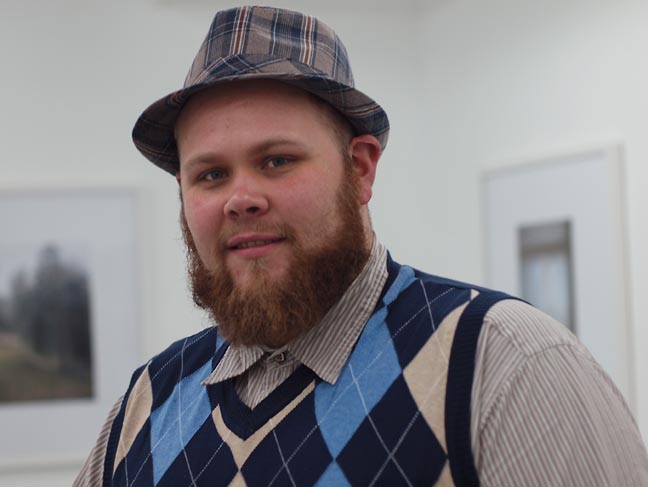 Jason Brown @ Half/Dozen If you can find Half/Dozen then Jason Brown's face is already familiar to you and your gallery hopping skills are well developed. In his time as assistant at Half/Dozen ... (more) Posted by Jeff Jahn on February 07, 2012 at 16:40 | Comments (0) PermalinkWednesday 02.01.12 Mike Kelley 1954-2012 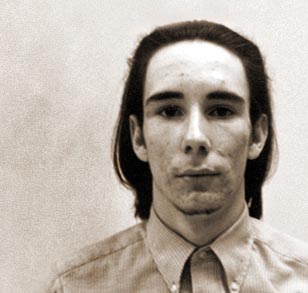 Mike Kelley Sad news, conceptual provocateur Mike Kelly has passed away due to an apparent suicide. I reviewed Kelley's fantastic collaborative show at Sculpture Center a few years ago. Few artists could make such an intelligent spectacle indulging in the juvenile and supposedly profane, but Kelley did so by laying bare the adult ruse as a kind of tribute to the wonder/ridiculousness of that awkward age through which all must pass and perhaps never leave. In Portland artists like Bruce Conkle, Matt "Troll" Green and Patrick Rock bear the greatest stamp of his influence. Our thoughts are with Kelley's family and loved ones, a hugely influential artist has left the building. *Update: must read Christopher Knight's epigraph on Kelley the game changer. Posted by Jeff Jahn on February 01, 2012 at 12:20 | Comments (0) PermalinkFriday 01.27.12 Edge of Vision at L & C  Bill Armstrong, Mandala #450, 2003 Cameras are more common now than in any time in history, which should = more experimentation right? So what happens when the subject is no longer bound to documentation? To help answer that question twenty international photographers have been gathered for, The Edge of Vision: Abstraction in Contemporary Photography at Lewis and Clark College's Hoffman Gallery. The exhibition is curated by Lyle Rexer and presented by the Aperture Foundation. "The works explore diverse aspects of the photographic experience, including the chemistry of traditional photography, the direct capture of light without a camera, temporal extensions, digital sampling of found images, radical cropping, and various deliberate destabilizations of photographic reference. This abstract use of photography often combines other mediums such as painting, sculpture, drawing and video. All artists join a broad contemporary trend to look critically and freshly at a medium commonly considered transparent." Edge of Vision features photographs by; Bill Armstrong, Carel Balth, Ellen Carey, Roland Fischer, Michael Flomen, Manuel Geerinck, Shirine Gill, Barbara Kasten, Seth Lambert, Charles Lindsay, Irene Mamiye, Chris McCaw, Edward Mapplethorpe, Roger Newton, Jack Sal, Penelope Umbrico, Randy West, Silvio Wolf, and Ilan Wolff. The Hoffman Gallery January 19 - March 18 2012 Hours Tuesday through Sunday, 11 AM to 4 PM (Free) Lewis & Clark, 0615 SW Palatine Hill Rd. Parking on campus is free on weekends. (503-768-7687) Posted by Jeff Jahn on January 27, 2012 at 13:54 | Comments (0) PermalinkMonday 01.23.12 Monday links OHSU has gotten approval for it's latest South Waterfront expansion by CO Architects and SERA. Interesting, it reminds me a bit of Thom Mayne on the south end but the 12 story tower seems underwhelming in comparison. Still it should blend in with other nearby buildings.
Curator sharing between Detroit and Kansas City? It is common in the orchestral world but I think it is problematic in the museum world. Why? because curators don't just plan and execute shows, they are the public face of the institution and interface with the interests of the community. Half the face time? ....half the interface! Overall, I'm not a fan of half time curators at major museums. As Kodak files for bankruptcy the Guardian takes a look at the role of women in their identity. Posted by Jeff Jahn on January 23, 2012 at 13:53 | Comments (0) PermalinkThursday 01.19.12 Sandra Percival leaves YU 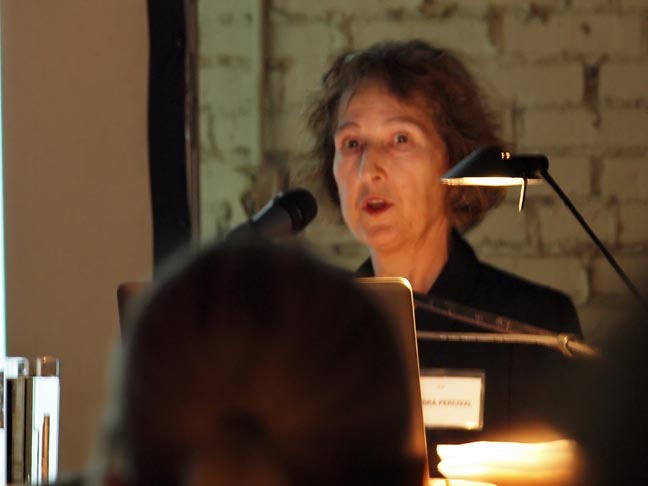 former YU Director, Sandra Percival Last Fall I raised questions about Sandra Percival's role and basic questions of board oversight, which was a reiteration of what I was first to point out a year before. Now YU just announced that, "We, Curtis Knapp and Flint Jamison, Co-founders, announce that Director Sandra Percival will leave YU. Curtis Knapp will become Acting Director, effective January 20. There will be complete continuity in the day-to-day functioning of YU and in the assumption of strategic and programmatic planning imperatives at the director level, some of which we will discuss below....(more) Posted by Jeff Jahn on January 19, 2012 at 13:25 | Comments (0) PermalinkWednesday 01.18.12 Tina to Williams 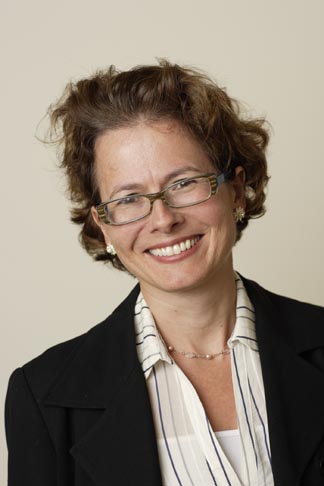 Christina Olson It would be sad news if it weren't something we hadn't seen coming the moment she took the Director of Education job at PAM but Christina Olson is leaving her post in Portland to become the "Class of 1956 Director of the Williams College Museum of Art" (WCMA for short). During her tenure in Portland she was THE point woman for Brian Ferriso's very successful revamp of PAM's education department and her accomplishments go far beyond the annual Shine a Light events. With Tina the museum took what was a very hit or miss program and made education a part of every single museum activity. The busloads of kids I see at PAM every week are a testament to her but so is the greater community/interpretive involvement... like the fantastic Artist Talks series (of which I've taken part). She leaves PAM as one of the most successful employees the museum has ever hired. ... (more) Posted by Jeff Jahn on January 18, 2012 at 14:37 | Comments (0) PermalinkMonday 01.16.12 Monday Links Nice article on seminal Light and Space artistDoug Wheeler in the New York Times.
Should a Keith Haring mural be conserved or simply repainted as Haring wanted it to be? I'm with Haring on this. Tyler Green points out a pretty cool Luis Tomasello installation at the Nelson-Atkins Museum. Roberta Smith gives Damien Hirst's polka dot paintings a fair shake. For me he is a bit too prolific but he's still one of my favorite artists of all time. That said I've always found the dot paintings much less interesting than his installations and I think he knows it. The thing with Hirst is he finds a way to make people form an opinion by pushing buttons... that is a tremendous ability, without which contemporary art dies. She's absolutely right about it being a lot better than the Christos' The Gates project. Posted by Jeff Jahn on January 16, 2012 at 1:25 | Comments (2) PermalinkThursday 01.12.12 Op Ed Here's my Op Ed in the Portland Tribune. I've mentioned these things time and again... most recently in my 2011 year end wrap-up and a detailed look at regional survey shows. This one was for a more general audience but also places the discussion of excellence and relevance in a wider civic context.
It is true that our art universities and museums have come a long way but it is time to finish the job, not become complacent. Here's a relevant passage from Ibsen's An Enemy of the People that I couldn't fit: Dr. Stockmann: "They [the young] are the people who are going to stir up the fermenting forces of the future, Peter." Mayor Peter Stockmann: "May I ask what they will find here to 'stir up. . . ." Dr. Stockmann: "Ah, you must ask the young people that" Posted by Jeff Jahn on January 12, 2012 at 0:48 | Comments (0) PermalinkMonday 01.09.12 Monday Links You saw it here first, the Portland Art Museum has finally gone live with a new website after undergoing a comprehensive identity makeover last September. Once again it is much more contemporary and a cleaner overall design. There is even an enhanced online search option for the collection.
Michael Kimmelman writes on the prominence of parking lots in the built environment. Surely in Portland we are already taking this quite seriously but much more could be done. Brian Libby posts a riposte to the Washington Post about Portland's already long streak of prominence in the national media. The Art Newspaper reports on Nicolas Berggruen's plan to create an on loan collection for LACMA, similar to what Eli Broad has already done. There is a local tie in here as Berggruen owns Chris Burden's Three Ghost Ships (1991) that have been on display at PAM for the last few months. Places like Portland, which do not have mega collectors... yet are filled with an viewers hungry for contemporary art definitely gain from this type of lending collection arrangement. Posted by Jeff Jahn on January 09, 2012 at 0:32 | Comments (0) PermalinkSaturday 12.31.11 2011 Wrap-up 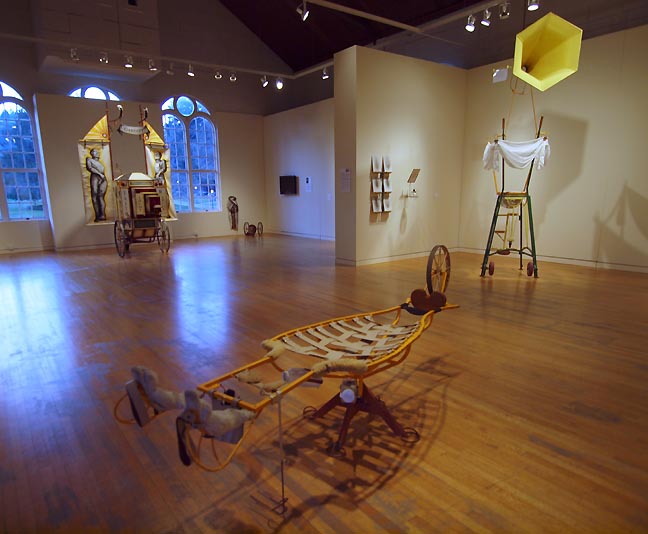 David Eckard's Deployment at The Art Gym I regret that I made the trek to Portland galleries and museums a little more than a dozen times this year due to the untimely death of my truck. (Readers may not know or care that I make a 120-mile round-trip.) I know I missed a lot. However, I'm happy with the essays I wrote, and must win the Most Comments Award, just with my 2010 wrap-up and the piece on Social Engagement. That said, I do have a few quick thoughts I can share:... (more) Posted by Patrick Collier on December 31, 2011 at 20:19 | Comments (0) PermalinkJohn Buchanan 1953-2011 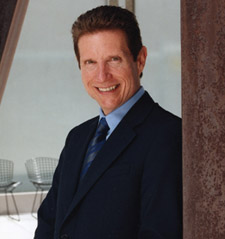
John Buchanan, the former director of the Portland Art Museum at a crucial time (1994-2005) has died at age 58 of cancer. It is a great tribute to his legacy that he can be credited with complicating Portland in the best way possible, leaving us questions the city still seeks to explore fully. Under his tenure from 1994-2005 the once flagging Portland Art Museum (like many of the city's institutions) was faced with the daunting task of reinvigorating its connection to its patrons at all levels. A devout populist and francophile John was the kind of director that took a hands on approach to programming. That programming often carried a flashy theatrical flair with imported exhibitions like; Imperial Tombs of China (1996), Let's Entertain: Life's Guilty Pleasures (2000 featuring Damien Hirst, Richard Prince, Murakami etc), Stroganoff: The Palace and Collections of a Russian Noble Family (2000), The Triumph of French Paining (2003) and Hesse: A Princely Collection (2005). From 1994-2000 he and his wife stunned the city by turning PAM into an attendance powerhouse, all while making its patron parties the premier social events in the city. This was a powerful thing that made him perhaps the most loved and reviled personality in the city. John relished the job energetically and always knew exactly to whom he was talking to (a great skill)... I remember one time he crossed the street just to shake my hand and say hello after finishing a power lunch at Paley's. The man had hustle, yet at that precise moment in 2000 he helped engineer two very serious acquisitions, the Clement Greenberg Collection and the hiring of Chief Curator Bruce Guenther. By 2005... (more) Posted by Jeff Jahn on December 31, 2011 at 12:03 | Comments (0) PermalinkFriday 12.30.11 A generation fades, is it a call to action? 
Roberta Smith gives some more context regarding the loss of Helen Frankenthaler and John Chamberlain. But that is only the tip of a rapidly melting iceberg... we lost Cy Twombly + John McCracken too... and with as conservative as the galleries of 2011 seemed to be overall the question has to be what are we replacing them with? These were all very bright artists driven by perceptive and compelling ideals, not merely a series of calculated art world/market differentiation moves. These were artists with beliefs and this brings us back to Alex's Bringing Barr essay published earlier this week. May 2012 be the year of art manifestos... or at least an a year of art that has ideals? One of the reasons 2010's Judd conference and exhibition were important was the way it presented the seriousness of an artist like Judd. The Rothko Retrospective in February at PAM should be another call to action. After the continuing Occupy Movement this past Fall I see a larger interest in simply finding a new and better way to invigorate the discussions that comprise human civilization, which most of us take part in... this is simply what artists do (at certain times they do it better than others). Posted by Jeff Jahn on December 30, 2011 at 12:57 | Comments (1) PermalinkWednesday 12.28.11 End of year lists Well it is that time of the year (PORT's will come out on the 31st)... and because the world doesn't revolve around just one city here is are 2 lists that are not New York or Portland centric.
Christopher Knight's 2011 list for Southern California certainly confirms how different an art region it is than the NYC scene. ... and just because people forget how good the Midwest is for museums check out this year end list for Kansas City. Posted by Jeff Jahn on December 28, 2011 at 12:40 | Comments (0) PermalinkTuesday 12.27.11 Helen Frankenthaler 1928-2011  Helen Frankenthaler's Spaced Out Orbit (1973) on display at the Portland Art Museum Helen Frankenthaler, one of the most important painters of the Twentieth Century has died at age 83. I consider her be the most important artist of what her onetime paramour Clement Greenberg dubbed, "Post Painterly Abstraction." She was the inventor of the stained canvas technique that other artists like Morris Louis and Kenneth Noland used to remove any separation between color and the canvas (for which they received more attention as Formalists). Crucially, she differed from those who followed her because she continuously used a poetic approach to abstraction that was often lyrically rooted to experiences or places. I see this as a strength since she makes the otherwise VERY MACHO movement much more varied than it is given credit. Arguably, her influence goes far beyond painting and it always exceeded gender. As Frankenthaler once told it, "I was trying to get at something - I didn't know what until it was manifest." She prioritized intuitive experiences rather than a formal objective, exonerating her from the fate of ideologically brittle schools of painting that persisted throughout most of the second half of the Twentieth Century. Initially, a student of Hans Hofmann and perhaps the only painter to successfully build upon Jackson Pollock's language it was Frankenthaler's poetic and experiential qualities that gave her works a sense of place rather than the "Formalists" who co-opted her stain technique for different results. In a way this makes her work more esoteric and singular than her male peers, yet still she persisted as they painted themselves into a corner with more narrow objectives. Somehow, being poetic was seen as a negative in her work when it was seen as a positive for her onetime husband Robert Motherwell. Arguably, she was the better lyrical poet, when he was more an illustrator of philosophies. I've considered her work the in the top tier of lyrical modern artists including Matisse, Kandinsky and Pollock... notably working with nature rather than a defiance of it that was common with male artists. You can see the descendants of Frankenthaler's approach in the works of Katharina Grosse's painted installations, Lynda Benglis' sculpture and Pipilotti Rist or Jennifer Steinkamp's immersive video works... all of whom treat the experience of the body as a kind of thought (it's hardly the province of female artists but its different from James Turrell, Richard Sera or Robert Irwin's which is more monogenic). Experience of the body's senses as thought is idea that took a while to come around to and is still somewhat underdeveloped. Deeper in history, as a couple from 1950-1955 Frankenthaler and Greenberg would tour the latest New York School exhibitions all the while debating the merits of the work. In 1955 Greenberg published his essay Amerian-Type Painting, which laid out his fully formed ideas on flatness, all over compositions and material as tastemaker on the ACCF. In some ways Greenberg wanted to be like her, a highborn Jewish intellectual... (more) Posted by Jeff Jahn on December 27, 2011 at 16:15 | Comments (0) PermalinkThursday 12.22.11 Portland2012 Biennial announced 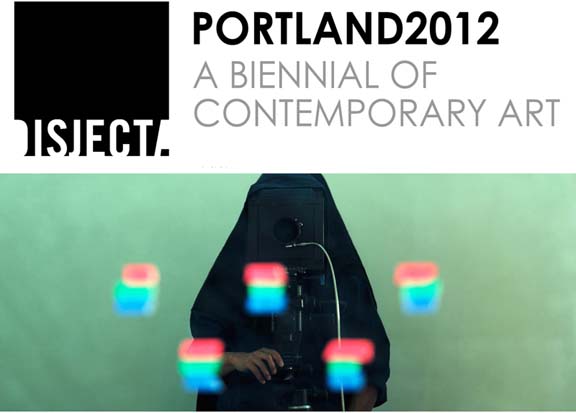 Detail from Ahihiko Miyoshi's Abstract Photograph 2011 Disjecta has announced the list for their Portland2012 Biennial (curated by Prudence Roberts and opens February 26) with lots of artists that have already established their reputations in town and a few names like Ahihiko Miyoshi who haven't. The list: Ben Buswell Hand2Mouth Theater Akihiko Miyoshi Vanessa Calvert Grant Hottle Wendy Red Star ... (more) Posted by Jeff Jahn on December 22, 2011 at 16:41 | Comments (0) PermalinkWednesday 12.21.11 2012 Whitney Biennial Announced 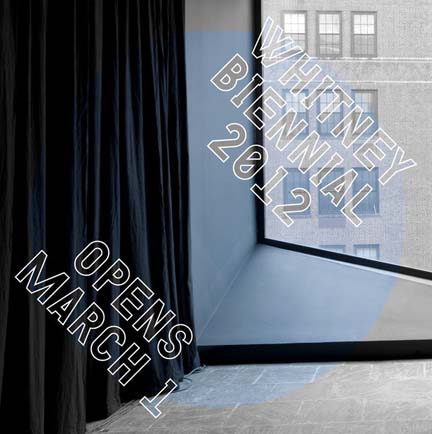
The Whitney has announced its 2012 Biennial and for once a New York institution isn't trying to get a piece of Portland's cool... there are no Portlanders in it this time. (Though it does feature Charles Atlas whom we saw at TBA in 2010) In fact, over the past decade 6 Portlanders have taken part so we are a little ambivalent to the whole thing.... call us when you give a Portlander a solo show or do a show about how Americans are re-evaluating what American values are (which is what Portland excels at). Before Occupy Wall Street, artists started occupying Portland in the late 90's. Posted by Jeff Jahn on December 21, 2011 at 18:41 | Comments (0) PermalinkTuesday 12.20.11 Mayor's 2011 Progress Report 
Mayor Sam Adams has released his 2011 progress report for the arts in Portland. For high points there are the increases in TV and movie production as well as the increases in funds for arts education are both huge moves in a long term strategy but the increase in the Work For Art (workplace giving) to $764,830 2010-2011 for RACC is a major and unexpected victory in this bad economy. It says a lot about how Portlanders respect the arts. Overall, this report highlights an obviously very arts friendly administration and yes the arts platform will likely determine who the next mayor is. Still, to date there is still one HUGE gaping hole in how the city funds both alternative spaces that don't have a 501.c3 and independent curators... both of whom are the backbone of the art scene. It is an area where just a little money would go very far. Posted by Jeff Jahn on December 20, 2011 at 19:10 | Comments (0) PermalinkMonday 12.19.11 Monday Links It is end of the year wrap up time and Holland
Cotter felt like the NYC Museums delivered, while the galleries were complacent.
I mostly agree with his assessment.
Mack McFarland interviews the gang over at Appendix in Bomb. Appendix does the alternative project space thing right. Here at PORT we always pay attention to what they are doing because they are important as a self-selecting group of talented and very intellectually engaged individuals. RACC awards a record sum for Project Grants. It is important to note that they convened some multidisciplinary panels to evaluate projects like Ben Young's... a clear step in the right direction. Sure, some of the grants went to embarrassingly dippy projects to people who repeatedly get some of the larger project grants but the new names like Young and Bund are encouraging. Honestly, I've never bothered applying for a project grant because it seemed like a waste of my time (I am a critic/curator and thus infinitely capable of pissing off panels of my so-called peers even when I'm not trying to alienate people... it comes with the territory if you call a spade a spade). Yet with these special multidisciplinary panels I'm reevaluating my opinions of RACC's project grants now... perhaps now can they handle high level independent curatorial projects? Venues like Rock's Box, Appendix, Worksound, Gallery Homeland and Recess are the backbones of the scene but dont get support except when individual artists get a grant. That said congrats to those who did and don't suck! Im hard on RACC but if any of the projects they funded are excellent I'll be sure to give them the props they deserve. The new federal budget plan cuts the NEA and NEH. On Friday artist Robert Hanson died at age 75 and PNCA covered it best. I don't want to attempt a eulogy (I only do that for those I knew well) but I what noticed most about Robert is that unlike many others of his generation you'd see him out and about taking in the new shows each and every month... usually with his wife Judy Cooke (always such a wonderful couple). That curiosity speaks volumes about the man. Our thoughts are with Judy and his family as he will be missed. Hanson's work will be the subject of the next Apex show at the Portland Art Museum. Posted by Jeff Jahn on December 19, 2011 at 13:44 | Comments (0) PermalinkFriday 12.16.11 Mark Rothko Retrospective at PAM 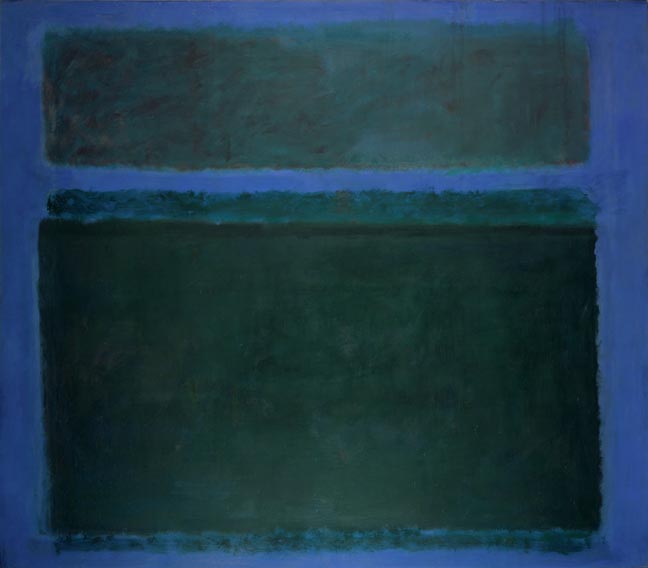 Mark Rothko, Untitled, 1957, oil on canvas, (c) 2011 Kate Rothko Prizel and Christopher Rothko In 2009 PORT gave you a head's up that it was coming but now the Portland Art Museum has released the dates and some details about its Mark Rothko Retrospective in February 2012. Spanning Rothko's entire career, the 45 works in the exhibition may constitute the single most important exhibition of the 21st Century for the Portland Art Museum and all eyes will be on this show. It is sure to be a watershed moment and the exhibition will not travel. For background, Rothko from age 10-18 grew up in Portland and had his first solo exhibition at the Museum in 1933-34. In 2009 Arcy published this very important post on PORT detailing the city's most famous son's relationship to Portland. Also, it illustrated how overdue such a retrospective was. In fact, even today many Portlanders (and some artists) aren't even aware of Rothko's connection to Portland. In short this retrospective simply had to be done and I personally feel the new transit bridge over the Willamette currently under construction should be dedicated to Rothko as well (he often painted the spot). Then there is my ultimate hope, that the Portland Art Museum creates a special Rothko gallery according to the artist's preference for low level natural light, low ceilings and his works alone when they next expand their campus in the next decade. If Denver can have a Clyfford Still Museum I think Portland (a city overrun with artists) should be a venue for seeing Rothkos the way he intended. PAM's retrospective is made possible through key loans from the Rothko family, the National Gallery and private collections. This exhibition was a lifelong dream for the recently departed Harold Schnitzer and though he didn't get to see it that dream was crucial in making this happen. Mark Rothko Retrospective • February 17 - May 27th 2012 Portland Art Museum • 1219 SW Park Ave Posted by Jeff Jahn on December 16, 2011 at 1:28 | Comments (0) PermalinkMonday 12.12.11 Monday musings David Lynch (who was partially raised in the Northwest) has published a book of his sketches, take a look at them in the Guardian.
German forgeries in the market detailed in the Art Newspaper. ...(more) Posted by Jeff Jahn on December 12, 2011 at 12:40 | Comments (0) PermalinkFriday 12.09.11 Friday links Well, the art world's still in the predictable post ABMB entertainment/money
confluence backlash mode but as I pointed out just before the East
Coast/Saatchi started publishing screeds... it really does
matter how the artist and institutions lay the ground rules (Alfredo Jaar requires
carte blanche). Here's the latest:
Anselm Kiefer (sometimes one of my favorite artists) believes art is, "not entertainment." Well he's right when it comes to his art, but there is certainly room for entertainment in art... for example Paul McCarthy's and Richard Serra's sheer audacity is entertaining. By simply suspending the humdrum of the everyday an artist can create big A "Art". In Kiefer's case he's working within an exceedingly serious historical discussion and his show at Tate Modern along with the New Clifford Still Museum are foregrounding a much needed counterpoint to the sometimes grating follies of art. I like to think of it as very responsible "older brother art". Maybe I'm just projecting... I am the oldest in my family so; Still, Judd, Newman, Serra, Martin and Kiefer all appeal to my "seriousness" fetish. Which isnt to say I don't enjoy classic Damien Hirst, Murakami, Tracey Emin and Jason Rhoades as art brats who fulfilled the need to laugh a little bit at how we fetish seriousness/higher aspirations. Linda Yablonsky addresses the Miami hangover directly. Edward Winkleman addresses Yablonsky and does a nice job of discussing the 99% and the influence of money. Though I think he's wrong about the naming rights superseding the work that director's do in the history books. For example if the Menil's can't overshadow Walter Hopps legacy in the history books... then no one can! At the Portland Art Museum both the current... (more) Posted by Jeff Jahn on December 09, 2011 at 12:09 | Comments (0) PermalinkMonday 12.05.11 Monday Links Well it was ABMB
weekend and refreshingly instead of the obligatory and inane pieces on how
art is a hot investment there were numerous substantial opinion pieces on the
state of the art world. Art, no matter how much it costs is simply a way to
understand that which resists understanding... it should be as much if not more
of a personal existential investment as it is a monetary expenditure. That is
the one thing I really like about collectors in Portland, nobody... no matter
how much they spend is doing it just for show.
Jerry Saltz takes on the Carsten Holler (AKA art as playground) show. On a similar note I discussed and compared Holler and Alfredo Jaar at length last week. The sense is that this type of show is designed to draw in audiences rather than hit the right notes... ie be challenging rather than diversionary entertainment put on by the 1%. Let's not throw the baby out with the bathwater though, sometimes a carnival show can shake up the status quo. Charles Saatchi blasted art oligarchs who collect and inflate the blue chip art market rather than develop a deeper relationship. This typical art rant means something only because Charles Saatchi is saying it and therefore has the weight of a man who has been wrongly accused of much the same thing. The difference is he has taste, faith in the difficulties of Art and has catalyzed not just careers but entire art movements; YBA, Leipzig etc. There is a learning curve and serious collectors like Saatchi and Broad are special. They have done it for a long time and it is obvious they keep their own counsel as patrons... they aren't simply acting on the tips of advisers, they developed a certain personal biography through the art they collect and present. To get at the issue from a different angle, how about a look at the crossroads of art and neuroscience. I'm always shocked at how much the art world doesn't look at or exploit scientific approaches. Also, it is Turner Prize time... if only Northwest shows at major museums like the CNAA's had similar ability to generate discussion? Too often they are a cavalcade of already past their prime names or a bouillabaisse of so many artists that an actual curatorial thesis is impossible to form... making the institution's intrigue the defacto subject rather than the host of avenues for new understanding. Posted by Jeff Jahn on December 05, 2011 at 12:06 | Comments (0) PermalinkMonday 11.28.11 Monday Links I'll publish an essay/review Tuesday but for now here are some links to get you started;
Tyler Green parses a Washington Post story on Hide/Seek and corrects the false assumption that the show is about same sex intimacy. BTW Hide/Seek is coming to the Tacoma Art Museum in March 2012. Brian Libby reports that Jefferson Smith is the only Portland mayoral candidate to question the Columbia River Crossing's boondoggle. The Guardian looks at the gaggle of Posted by Jeff Jahn on November 28, 2011 at 10:36 | Comments (0) Permalink Thursday 11.24.11 Turkey links As is our tradition PORT is taking a little break for the holiday but Ill have a big piece for you to read after this holiday weekend. Till then check out these very popular recent articles and links.
Our 1 year checkup on YU Gary's interview with Chris Burden ... (more) Posted by Jeff Jahn on November 24, 2011 at 16:44 | Comments (0) PermalinkSunday 11.20.11 Clyfford Still Muesum opens 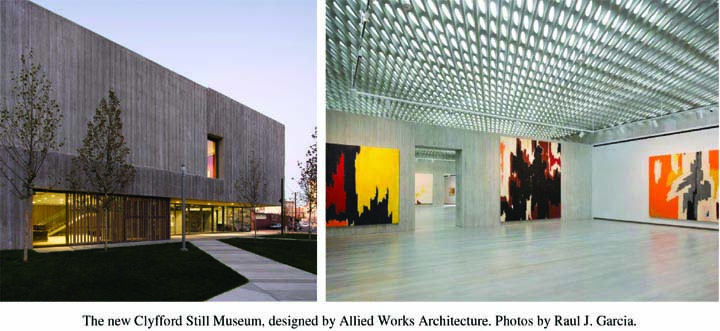
The Clyfford Still Museum opened to the public this weekend with a positive review from the LA times already. I've make no secret that Still is one of my favorite artists and in the past I've pointed how his Northwest roots run very deep. Here Arcy and I interviewed architect Brad Cloepfil about the design of this project... which appears to be his best work since the W+K HQ. ... (more) Posted by Jeff Jahn on November 20, 2011 at 18:12 | Comments (0) PermalinkFriday 11.18.11 Kippenberger at PAM 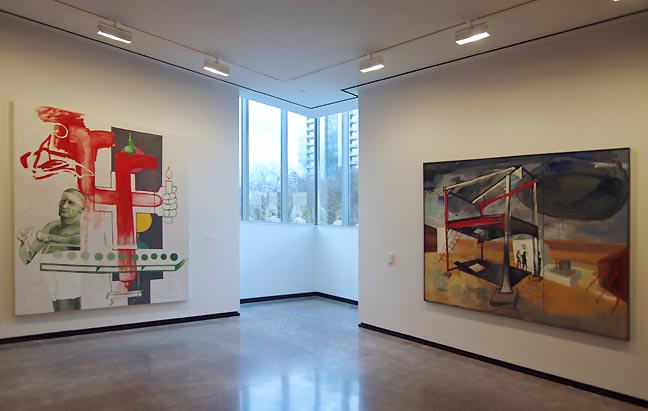 Martin Kippenberger at PAM I've been very busy lately doing other things on Portland's South Park Blocks so it has really been irking me that I haven't had time to check out the Martin Kippenberger show at the Portland Art Museum. Looks like I finally get the chance today. All of this is interesting because I don't dig Kippenberger all that much (saw his retrospective at MoMA and liked about 5% of it). Still he's influential, so influential that most MFA programs look like tribute cover bands devoted to Kippenberger. Generally, if I don't like something I try to revisit it as much as possible to understand why the work does or doesn't work... if I come back several times it means it is successful in some way that deserves scrutiny. The fact that it is here though is a good enough reason to visit PAM, which also has a Chris Burden show up. Here's what Chief Curator Bruce Guenther says about the Kipster, "Dissuaded of art's power to reveal truth or the possibility of producing original work, he nonetheless produced new important work with a strong political and social content, revealing, as John Lane observed, 'a moralist in despair.' The exhibition features a selection of paintings from the last decade of the artist's life and fourteen 'Hotel Drawings,' intimate works created on hotel stationary gathered on his peripatetic travels from 1987 until 1997. The works present an irreverent and ferocious humor that cumulatively accentuate the late artist's acute sense of moral responsibility to humanity and the history of art." Look I'll say this, if you like Rock's Box at all... this is a show you have to see if you live in Portland . Through February 19th, but don't wait that long. Posted by Jeff Jahn on November 18, 2011 at 10:41 | Comments (3) PermalinkMonday 11.14.11 Monday Links Yesterday Roberta Smith took on the sprawling Pacific Standard Time complex... aside from the idea that LA is the only west coast hotbed for art it's interesting to read how the east coast is discovering the depth of the West Coast. The truth is there is a Mexico to British Columbia thing that has been in force for at least 3 decades now. Hopefully all this talk of region will evolve the way we discuss San Diego, LA, San Fran, Las Vegas, Eugene, Portland, Tacoma, Seattle and Vancouver BC.
Brian Libby discusses CoLab's newest design. The Guardian discusses the importance of design to a country's economic well being. Jerry Saltz softens up to Maurizio Cattelan. I find Cattelan mostly dull except a few standouts like Him and La Nona Ora. He's the Carrot Top of the art world for me... worthy of respect in that he has survived so long but ultimately not doing his best work anymore, mostly because the method wasn't that rich with material to begin with. Posted by Jeff Jahn on November 14, 2011 at 15:22 | Comments (0) PermalinkWednesday 11.09.11 YU 2, what are they up to? Tonight the YU Contemporary
Art Center project held its second annual state of the YU address.
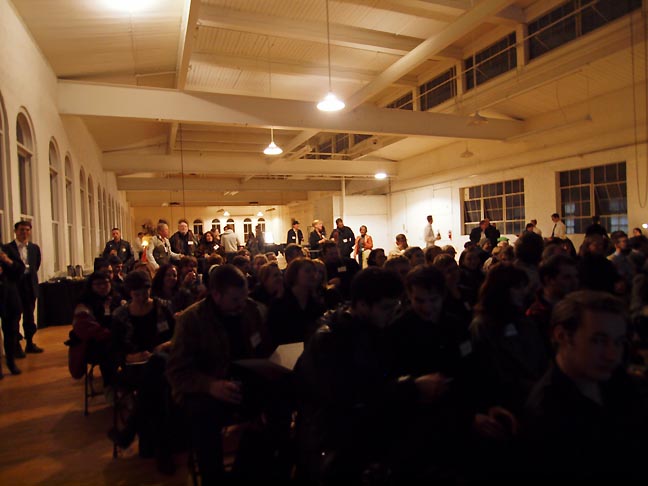 Crowd of movers and supporters at YU, November 8 2011 Last year PORT was the first to break the ambitious new YU project to the public but this year the bigger concern is whether they have really made any progress. The answer is a definite yes but it remains true that some absolutely crucial elements (a robust board) have yet to materialize... (more) Posted by Jeff Jahn on November 09, 2011 at 1:16 | Comments (0) PermalinkMonday 11.07.11 PICA's new HQ When PICA announced last summer that they had received a $200,000 ArtPlace Grant I was cautiously skeptical they would fully leverage the opportunity of
a medium sized, not huge grant. 200k does go fast when you get involved in civic buildings.
I felt like they might just float between a couple moldering properties on the
East Side of Portland, rather than take the responsibility of a full time presence
in Portland more seriously. I love PICA but as a "burned" past supporter I'm hard on them. Think of me as the grumpy old uncle who loved them
as a cute kid and beamed as they grew into adulthood (with their Pearl District
gallery) but was publicly
heartbroken when they decided to throw it all away and shirk responsibility
back in 2004 when they stopped being a major full-time vis arts institution and became
a festival with a vis art component. Ultimately in the intervening 7 years their vis arts program became less focused, with its series
of provisional/compromised spaces and scattered attention during TBA festivals.
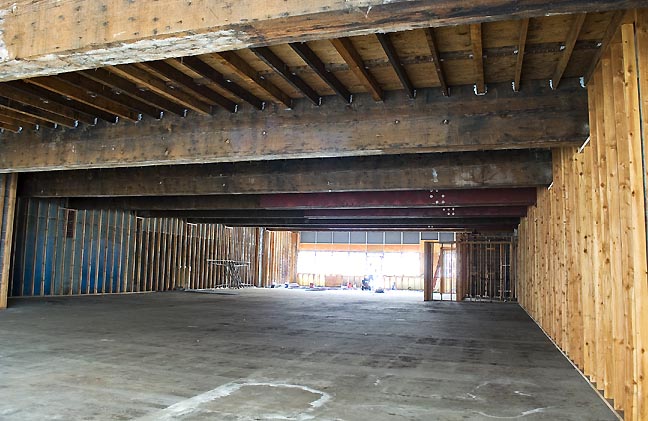 Unfinished space that is to be the new PICA HQ (photo Andrew Billing) Well today, I'm less skeptical with announcement that they will indeed have a nice headquarters space at 415 SW 10th Ave. It is just down the street from Powell's and is described as a hub office, not merely a series of ever changing off site encampments (which they will also undertake). The permanent space does make PICA suddenly a lot more exciting. There is something more grown up... (more) Posted by Jeff Jahn on November 07, 2011 at 22:23 | Comments (1) PermalinkWednesday 11.02.11 10th Northwest Biennial artists announced  TAM's building by noted architect Antoine Predock The list for the 10th Northwest Biennial at the Tacoma Art Museum has been announced. For the first time it will include our Canadian friends in British Columbia, something I've criticized all so called Northwest surveys for not doing. This year the survey focuses on "interdisciplinary art practices." Of the 30 artists, 13 are Portlanders, list after the jump... (more) Posted by Jeff Jahn on November 02, 2011 at 20:26 | Comments (1) PermalinkMonday 10.24.11 Give us your links Ok it has been too long since PORT has updated its links page. We are looking for art and design sites both inside and outside of Portland. Email your links to me at Jeff (at) Portlandart.net. It is a "curated" list so I can't promise we will use them but I'll definitely check them out.
Posted by Jeff Jahn on October 24, 2011 at 16:04 | Comments (0) PermalinkMonday 10.17.11 Monday links Linda Yablonsky discusses the always loaded "Mid Career Survey."
The Guardian reviews the 2011 Frieze art fair here is Adrian Searle's account as well. The New York Times had a nice article on Patti Smith's Memento Mori photos. Posted by Jeff Jahn on October 17, 2011 at 16:31 | Comments (0) PermalinkWednesday 10.12.11 Clyfford Still in the Northwest 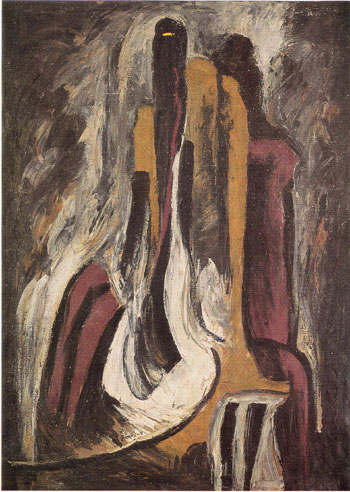
Clyfford Still's 1937 8A (painted in 1937, Pullman Washington) I'm very excited about the opening of the Clyfford Still Museum next month in Denver (designed by Portland's Brad Cloepfil and co-curated by PORT reader/art historian David Anfam). Still (who grew up in Spokane) is perhaps my favorite ab-ex painter because he was such a cantankerous stickler, very physical and insistent upon preserving the integrity of his work. Still set the stage for Donald Judd and I feel like most of today's top artists have become too accommodating of institutions and collectors by comparison. I'm not the only one excited here and Tyler Green is pretty amped about Still too. He has done a great two part preview; Part I and Part II. One not so minor omission in Green's account is Still's time as a Professor at Washington State University in Pullman 1935-41 not (Spokane) and though Green is right to suggest that his work at steel yards in the Bay Area may have lead to Still's quite recognizable abstractions (and growing scale after 1941), Still was already doing abstractions during the Pullman years as 8A from 1937 demonstrates. Thus, the assertion that Still, "broke through to abstraction," in the Bay Area as Green suggests isn't precisely true... instead he solidified himself as an abstract painter there after a process begun in Pullman Washington (when he was married to his first wife, his second wife tended to disavow paintings from that era... hmmm). Instead, the truth is abstraction and figuration were modes Still vacillated between while at Pullman and more research needs to be undertaken on those years. An era of such vacillations is sure to be revealing, it's usually where the crucial decisions (in hind sight) are first identified. In fact, a Portland collector owns a very interesting... (more) Posted by Jeff Jahn on October 12, 2011 at 14:46 | Comments (0) PermalinkMonday 10.10.11 Bovee in Dwell 
Just in case you hadn't heard, Katherine Bovee... who crucially helped design/develop PORT and wrote many fine reviews for us is featured along with her home in Dwell this month. It is available on newsstands now and fine periodical stores as well. Congrats! We can hardly wait for the cutting captioning on Unhappy Hipsters to begin... Katherine has a wicked sense of humor of her own too. Harpoon House was featured in Portland Monthly last year for those who just want to click and read. Posted by Jeff Jahn on October 10, 2011 at 22:41 | Comments (0) PermalinkThursday 09.29.11 Chicago links On Friday I'll post the massive and long awaited comparison/travelogue discussing Portland and Houston. Till then here are some Chicago related links.
Artnet takes a look at Chicago's Gallery Weekend. The New York Times interviews MacArthur Fellow and architect Jeanne Gang. Her Aqua tower is both beloved and disliked intensely, but it does show that Chicago still does skyscrapers that people respond to... it isn't just a height thing. Posted by Jeff Jahn on September 29, 2011 at 10:22 | Comments (0) PermalinkMonday 09.26.11 Link Hijinks Jerry Saltz, discusses what has become of Matthew Barney... it reminds me why I find Jesse Sugarmann's work a kind of lower rent version of Barney's car spectacles, it is fine... but it's quite clear who his daddy is right now.
Peter Plagens' puts his foot down and discusses his seminal book "Sunshine Muse" and the current Pacific Standard Time catalog, which criticizes his 37 year old work on West Coast Art. Plagens is straight up about it being a period piece and pretty much POWNS the academics criticizing his primary source narrative. Even closer to home, where Plagens' states, "Mark Tobey and Morris Graves 'have possessed Pacific Northwest art to the point of suffocation.'" is right on. Reading that I realized a lot of what I've done up here (with the help of 10,000+ others) on the Northern Coast is break that suffocation... in Portland at least. The thing about writing the first draft of history is you are allowed to bruise egos, make omissions and upset people's apple carts with a clear conscience... a pair of steel balls doesn't hurt either and Plagens' definitely has a pair. Brian Libby discusses the CRC's ummmm progress... and continued obfuscation/rubber stamp process. Still, the funding is so shaky on this poorly designed project that I welcome it's not so improbable demise at the hands of the Oregon and Washington State legislatures. Don't get me wrong I think the bridge is needed but the rushed and bass-ackwards way it has gone down means the current and very poor design should be scrapped and restarted with some truly innovative bridge solutions to justify the high price tag. Governor Kitzhaber (who received a lot of campaign funding from CRC interests) is mostly to blame for this an it is perhaps his biggest mistake in an otherwise decent political career. And in case you live under a rock you saw the NYT's article on PICA's 2011 TBA festival. Sincere congratulations, now I'll do my yearly dead-on critical assessment because what was new to the Times isn't new to us. TBA's visual component's biggest flaw... is a certain let's throw stuff at the walls and see what sticks method (sometimes literally) and is also its strongest card. To me TBA makes the visual arts component (what we cover) seem a bit token and scattered compared to the excellent permanent gallery space program they had from 2001-2004 and this year was no exception. It's a festival so I can't fault it for feeling fleeting... but ...(more) Posted by Jeff Jahn on September 26, 2011 at 11:42 | Comments (0) PermalinkMonday 09.19.11 Monday Links The Art Newspaper reports on single painting blockbuster shows, yes the Portland Art Museum's upcoming Titian show is mentioned. I much prefer these types of shows to filling a room full of gilded heirlooms and besides it is great that a single painting can command such attention. Anyways, it is not like West Coast museums are swimming in Titians the rest of the time.
I must have missed it with all of the travel but Portland Architecture reported on the design team chosen to renovate the Coliseum. 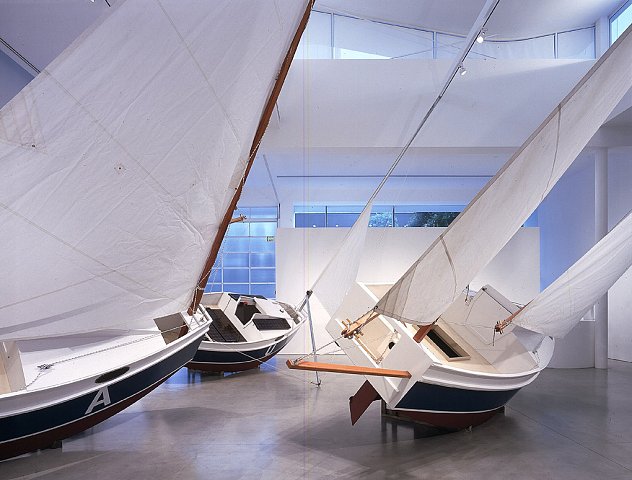
Chris Burden, Three Ghost Ships, 1991 Installation at Gagosian Gallery, Beverly Hills 1996 (Photo: Douglas M. Parker Studio) Also, in case you missed it in PORT's big article on PAM's new identity last week but at the end of October we are going to be treated to a pretty major Chris Burden installation at PAM. Burden's Ghost Ships are one of my very favorite works of all time (with interesting political overtones today) and it opens October 22nd. This is the sort of solo show that PORT readers are hungry for from Portland's major art institutions. Posted by Jeff Jahn on September 19, 2011 at 10:59 | Comments (0) PermalinkThursday 09.15.11 National looks Holland Cotter takes on the new de Kooning retrospective at MoMA.
Jerry Saltz is excited about this book of Robert Rauschenberg's early photography. Several years ago PORT covered Rauschenberg's final series of photographs (and work) at Bluesky. Obviously, there is an enormous story yet to tell. The NYT's has an interesting article on corporate funding in the arts as a kind of economic stimulus to Detroit. Portland takes the omnipresence of arts activity more for granted (i.e. little direct support for alt spaces) despite the fact it is the engine of growth for our city. Posted by Jeff Jahn on September 15, 2011 at 12:36 | Comments (0) PermalinkTuesday 09.13.11 Milestone links 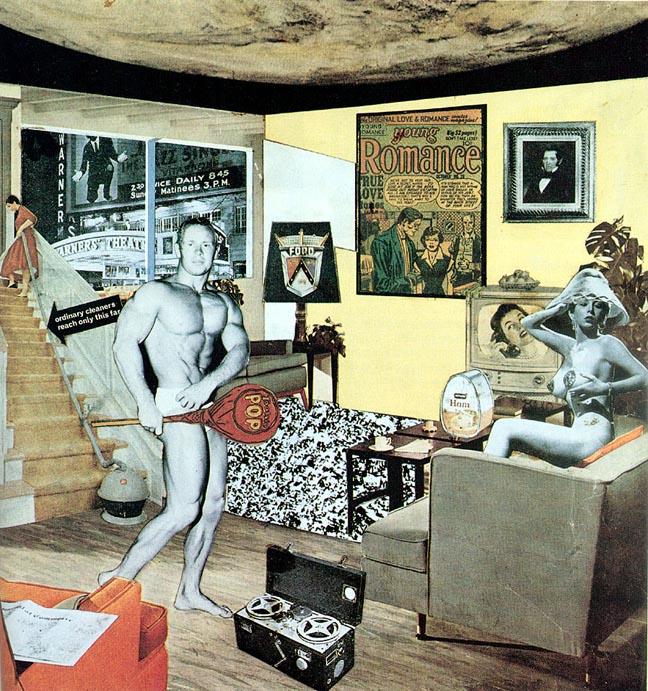
Richard Hamilton's Just what is it that makes today's homes different, so appealing? (1956) where the term Pop was first coined The original Pop artist, Richard Hamilton has died. Hamilton's brainier brand of Pop Art began as a form of social commentary inextricably tied to Duchampian existential absurdism but it ended up becoming the dominant mode for understanding the man made environment in the second half of the 20th Century. Tyler Green's Modern Art Notes has logged its 10th anniversary. Congratulations on a landmark in arts writing on the internet. The NY Times had an interesting article on Postmodern design and how some that were responsible aren't that proud of certain milestone elements. It might not have been the most successful of styles (as the Portland Building reminds us) but it helped break from the autocratic monolithic aspects that had made Modernist design a bit hard to stomach as well. Posted by Jeff Jahn on September 13, 2011 at 11:07 | Comments (0) PermalinkTuesday 08.30.11 Linker Ok, August is always an intense month of travel for me, so the Houston report will come later tonight or tomorrow... till then here are some links:
The Guardian interviews Gillian Wearing... whose confessional videos happen to be some of my favorites. An Egyptian art collector founds a political party. Posted by Jeff Jahn on August 30, 2011 at 11:41 | Comments (0) PermalinkTuesday 08.23.11 Defending Beauty? 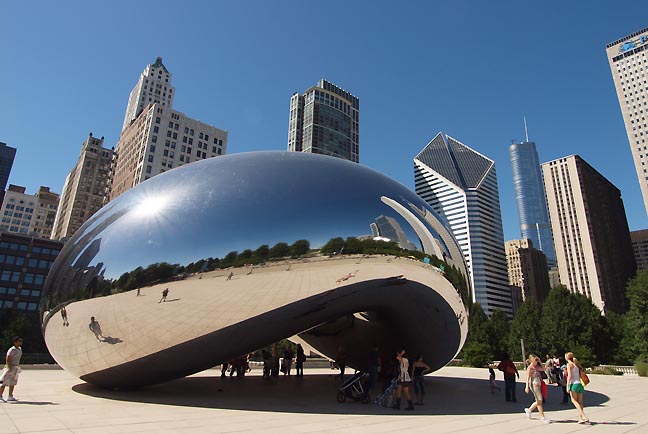 Anish Kapoor's Cloud Gate in Chicago (photo Jeff Jahn) Tomorrow at Place the latest Praxis salon discussion presents Jason Brown's Paper "In the Defense of Beauty: The Guise and The Intangible." Grant Hottle's paintings will be on display as well. Beauty was a hot topic in the mid 90's when Dave Hickey challenged the decades long bias against it in contemporary art with his essay, The Invisible Dragon: Four Essays on Beauty. It was essentially an all out and ultimately successful attack on a lot of French postmodernism theory that had metastasized into a kind of academic koan, one which treated visual pleasure as a kind of intellectual failing. What Hickey most effectively assaulted was the academic conceit rather than the theoreticians themselves and suddenly it was fine to make beautiful things again and craft suddenly stopped being a dirty word... not that Anish Kapoor and Jeff Koons weren't already doing it and artists like Murakami, Hirst, Andreas Gursky, Josiah McElheny and Olafur Elliason eventually removed all doubt. Likewise, the resurgent interest in Ed Ruscha, Ellsworth Kelly, Richard Serra, Robert Irwin and Judd ultimately solidified the argument that beautiful (or relentlessly visual/kinesthetic) work could be intellectually rigorous. Overall, I'm interested in seeing where this discussion around Brown's paper hinges on and diverges from the art history of the past 20 years and hopefully some discussion of local examples will ensue (Storm Tharp, Jacqueline Ehlis (who studied with Hickey), Eva Speer, Arcy Douglass, Laura Highes, Jordan Tull, Laura Fritz, Midori Hirose, Adam Sorenson, the Appendix crew and James Lavadour are all germane). Lastly, does beauty still require defending and from whom? Perhaps reading Arcy's essay from 2008 On Form (or from Polykleitos to Janine Antoni) might be helpful? Place @ Pioneer Place 700 Sw Fith Ave. Third floor at settlement August 24th 5:30 - 8:30PM Posted by Jeff Jahn on August 23, 2011 at 21:27 | Comments (5) PermalinkMonday 08.22.11 Two Worlds = Same Universe Th Guardian looks at what happens when artists and scientists work together... a long time ago Da Vinci was at the top of both fields.
This just in, the small but increasingly impressive Oregon College of Art and Craft has just announced a partnership with Nike. This is significant as Nike designers will be in residence on campus and highlights the hands on Craft based design process the college has become known for. It's a great opportunity for students to see how things are done outside the art school bubble and great for Nike to do some woodshedding so to speak. Posted by Jeff Jahn on August 22, 2011 at 10:30 | Comments (0) PermalinkFriday 08.19.11 Joan Shipley PADA Visual Arts Award recipient 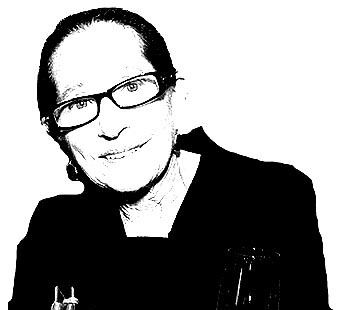
Joan Shipley The Portland Art Dealers Association Award for Service to the Visual Arts has been awarded to Joan Shipley. Congrats are due to Shipley, an often behind the scenes arts force who along with her husband John is can frequently be seen out and amongst the galleries. I like the idea of the award as most awards are targeted towards artists who make a very public splash. On a civic level there is little recognition of less sexy things like; arts leaders, curatorial initiative, alt space management or fundraising activity in Portland (RACC, OAC, Mayor's office, Ford Foundation this is something to work on). Good on PADA to undertake this initiative. Joan was a founding member of PICA, chaired the board during the capital campaign and is on the leadership council today. She is also active with The Bonnie Bronson Award and many, many other cultural institutions in Portland. In 2004-2005 she and her husband were recipients of the Governor's Arts Award. The Portland Art Dealers Association Award for Service to the Visual Arts is given on occasion, but not necessarily on an annual basis. The recipient is chosen by vote of the members of PADA. Julie Bernard and Laura Russo were the first and second recipients of The Portland Art Dealers Association Award for Service to the Visual Arts. Joan Shipley is the third recipient. Posted by Jeff Jahn on August 19, 2011 at 18:49 | Comments (0) PermalinkMonday 08.15.11 Monday Links The Guardian has
images of the 9/11 memorial fountains... unfortunately the piecemeal design
of the site including the forgettable Freedom Tower is just another reminder
of how New York and possibly America can't get it right when the chips a really
down. They are very big and very wet but somehow they leave me underwhelmed.
This book of wall photographs is extra cool. Here are some photos of SOUTHERN/PACIFIC down in Houston (lots of Portland artists on a cultural rail riding show that travels). Ai Weiwei debriefs the NYT's on his incarceration. Posted by Jeff Jahn on August 15, 2011 at 11:07 | Comments (0) PermalinkTuesday 08.09.11 Links The New York Observer has obtained the
revised plans for the MoMA tower by Jean Nouvel (it will add a lot more
gallery space to the museum). Though the NYO doesn't like it I actually think
this shard building looks better after the changes after complaints about its
height. Before it seemed mechanical, now it is more crystalline (like the
Libeskind Freedom tower that never got greenlighted, leaving us with the Childs
fiasco instead).
Todd Eberle shoots pictures of a new John Pawson home. I'll be reviewing his Empire of Space retrospective in book form shortly. The Guardian reports on a suspected Robert Motherwell forgery. Posted by Jeff Jahn on August 09, 2011 at 12:57 | Comments (0) PermalinkMonday 08.01.11 Monday Links A new article suggests
that the traditional gallery model is "structurally weak" and
that a series of fairs and Internet based modes are supplanting the old walk-in
model. This is partially correct, I can see galleries choosing smaller downtown
spaces and cheaper/larger and less finished project spaces in the future. The
trick is keeping collectors engaged and interested and simply scaling back (+ showing
more conservative work) without coherent, large scale or adventurous shows won't
create more excitement. You have to put collectors in the mood by impressing them and setting their minds at work. Fairs are so overwhelming it promotes buying but that doesn't work for
everyone. I think there is a balanced approach that makes more sense by creating
destination programming. Unless you are selling blue chip work a large downtown
gallery doesn't make sense anymore.
The George Ohr Museum took a beating from Katrina, then the BP oilspill... now it is demographics on the so called "Redneck Riviera"? Honestly, I want this to survive, Im a big fan and at some point it is up to patrons to step up to protect culture... charging admission (now $25 at MoMA) isn't really viable in out of the way places with lower museum attendance. The have's must protect what is worth protecting so the have not's can enjoy culture as well. Culture isn't just for the rich who can buy up George Ohr's pottery. Jean Nouvel's granite and vegetation monolith at the world's busiest fishing port is a new twist on harbor lighthouses? Posted by Jeff Jahn on August 01, 2011 at 15:20 | Comments (0) PermalinkMonday 07.25.11 New York links Architizer has announced its
pop up chapel winners.
Don't tell Michael Heizer about this (ie DO tell him) but there is a giant drill being left under Manhattan. Jules Verne meets Michael Heizer! And here is an interview with Lee Ufan who has an excellent retrospective at the Guggenheim right now: Posted by Jeff Jahn on July 25, 2011 at 11:12 | Comments (0) PermalinkMonday 07.18.11 Dorothea Rockburne Dorothea Rockburne's Saqqarah (1979) at The Portland Art Museum One of my favorite slightly under the radar but still having relevant shows at MoMA etc. artists is Dorothea Rockburne. Here is an interview with her in the Brooklyn Rail. The Portland Art Museum actually has an excellent Rockburne "Saqqarah." The title is direct reference to the Saqqara necropolis in Egypt, which is home to many pyramids including the very first one, the step pyramid by Djoser. In particular, I appreciate the drawn plum lines (on the canvas and wall) which bring up the conflation of surface and support within the work... which in a way mirrors the way the ancient Egyptians lived for the afterlife (life as the staging ground for the afterlife). As a formal exercise is is a highly satisfying study in triangular devices, with hints of planning and execution that remind me a little of Agnes Martin but a lot more dynamic. Though it is primarily made of canvas it is more related to dance, drawing, architecture and installation art. Posted by Jeff Jahn on July 18, 2011 at 14:46 | Comments (0) PermalinkMonday 07.11.11 Monday Links 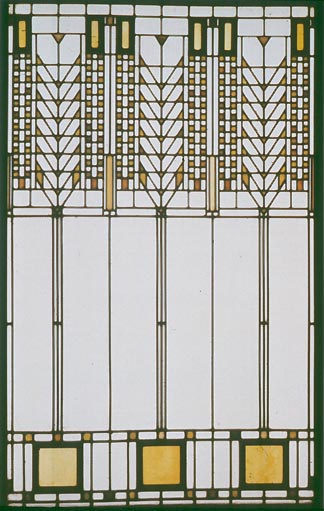 Light Screen, Darwin D. Martin House, Buffalo, NY, 1903. Leaded glass. Dimensions: 44 3/4 x 29 5/8 (Courtesy of Chazen Museum, University of Wisconsin-Madison, Art Collections Fund and Alta Gudsos) Looking for some lost Frank Lloyd Wright windows. I actually grew up copying some of his stained glass designs when I was 7-9 years old. PORT's own Alex Rauch is cycling to grad school in Chicago from Portland. It has already been an eventful trip. Edward Winkleman discusses the unseemly numerical quantification of a great artist. Yes PORT has a new calendar person, Kelly Kutchko, keep sending your press releases to the same old place: calendar(at)portlandart.net at least 2 weeks in advance for consideration. Posted by Jeff Jahn on July 11, 2011 at 13:03 | Comments (0) PermalinkFriday 07.08.11 ...and thanks for all the fish As you may have noticed, I'll soon be leaving the lovely PNW for sunnier pastures. I'm heading down to UCLA for graduate school this fall, so it's time for me to pass the torch along to a new faithful calendar-keeper for PORT.
Thank you for four(!) years of the irrepressible community & creativity that makes the Portland art scene so alive. ~megan Posted by Megan Driscoll on July 08, 2011 at 13:45 | Comments (1) PermalinkThursday 07.07.11 Spiral Jetty lease land grab? 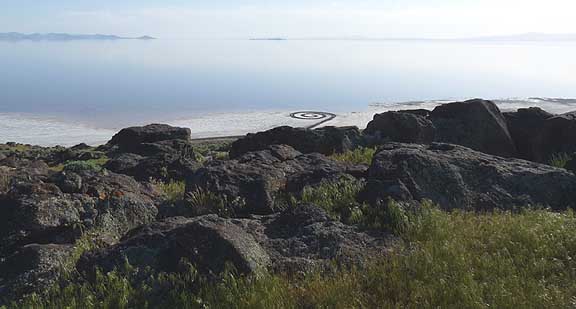 Spiral Jetty and environs (photo Jeff Jahn) When The Dia was somehow not allowed to renew the lease last month on the land that one uses to access the Spiral Jetty things got weird. Now things are getting more complicated and Tyler Green has the story. Here's my take. It is true that water levels do effect the iconic earthwork and yes Smithson built entropy into the work's design. Entropy is part of the piece, but I don't think the Dia Foundation's stewardship of the work should be allowed to enter a similar entropic spiral. I'm unsure if any other organization would understand just how... (more) Posted by Jeff Jahn on July 07, 2011 at 14:27 | Comments (0) PermalinkTuesday 07.05.11 Cy Tombly dies at age 83 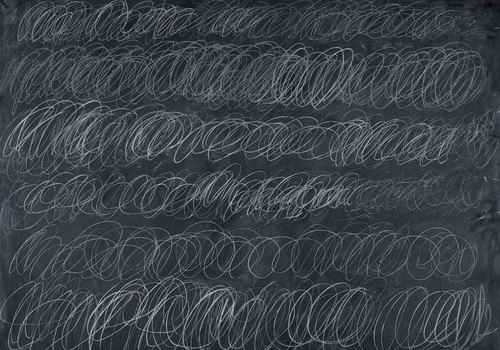 Cy Twombly" Cold Stream", White wax pencil on canvas (1966) Cy Twombly has died at age 83 in Rome. Portlanders were lucky enough to enjoy this major artist's work a year ago at the Portland Art Museum. “A pinnacle of the post–abstract expressionist generation, Cy Twombly redefined the parameters of painting. Fascinated by the immediacy of history and ancient myth, he created works rich with reference—Homeric myth, place, and intimate emotions. Twombly developed a vocabulary of signs and marks intended to be read metaphorically a world unto itself of picaresque scribbles, agitated sgraffito, and clotted, scatological impasto that ultimately defines a vast Elysian field of pleasure. I am forever seduced by the pull of gravity, the unpredictability of emotion, and the fluidity of his line as it conflates time—then is now, present is past. “ -Bruce Guenther Chief Curator, Portland Art Museum New York Times obit LA Times obit My feelings for Twombly are very personal. Twombly was the bridge between Paul Klee's poetic yet controlled automatism, Jackson Pollock and the next generation personified by Jasper Johns and Robert Rauschenberg, then onto Basquiat, Carroll Dunham, Terry Winters, Philip Taffe and even Ryan McGginnis or Julie Mehretu. For a Portland connection there is Jessica Jackson Hutchins. Overall, Twombly's work was a revelation to me, like uncovering a lost city. Twombly has always been an artist's artist, pervasive in his influence rather than the signal of a new paradigm. In fact, Twombly was there... (more) Posted by Jeff Jahn on July 05, 2011 at 16:06 | Comments (0) PermalinkThursday 06.30.11 Rose Art Museum collection survives assault  a sample of the Rose Art Museum's collection Some really great news, The Boston Globe reports that the Rose Art Museum's collection will not be liquidated to augment Brandeis University's budgetary situation. The Rose Art Museum is one of the better university museums in the country and has a fabulous collection of postwar art. We have been following this story for a very long time as Brandies' now former president sent a chill through all university museums... suddenly museums were seen as a source of revenue rather than a collection held in trust for the students and community. I love University art museums since they are a little more nimble than larger generalist art museums. Now if only alums like Peter Norton and Steve Jobs will push for a University museum at Reed College? Reed does have an interesting collection but it will take some major alumni muscle to make it happen. Also, the Museum of Contemporary Craft has certainly stepped up after merging with PNCA, though University museums are nearly always challenged financially unless they have a decent endowment... that wasn't the issue with the Rose Art Museum. Instead, Brandeis University (of which it is part) sought to remedy its own larger financial difficulties by selling off the collection, which went against the wishes of many Rose Art Museum/Brandeis donors. It was essentially a financial/cultural civil war within Brandeis University. Posted by Jeff Jahn on June 30, 2011 at 17:04 | Comments (0) PermalinkFriday 06.24.11 Friday news and links 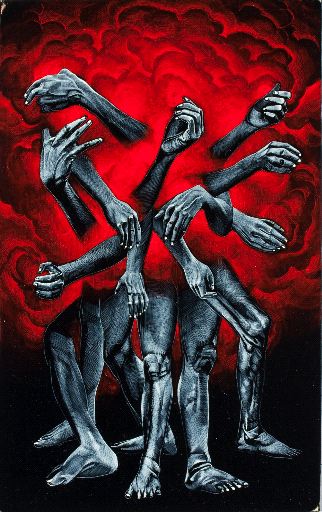 Eric Stotik's Untitled LR181 (arms, legs emerging from red smoke) 2010 The winner of RACC's top Fellowship in Visual Arts for 2011 is Eric Stotik, which conveys 20k and only comes around every 4 years. Congratulations Eric! I particularity like it when artists doing their very best work win awards (like Bruce Conkle for the Hallie Ford and now Eric). When artists who are past their prime win such awards it brings down the entire arts ecosystem... not so in this case. Just do good things and that justifies itself. Awards are a bonus and sometimes a curse. On Sunday, The Henry will host a public forum on The Brink Awards in Seattle at 1:00. I'm tempted to go partly because the CNAA's at PAM were so dissatisfying. The Brink is a different award, focusing on young artists from Oregon, Washington and British Columbia within 5 years of their terminal degree. Nominees were Grant Barnhart, Debra Baxter, Dawn Cerny, Tannaz Farsi, Allison Hrabluik, Anna Gray & Ryan Wilson Paulsen and the winner Andrew Dadson. Seattler's have a somewhat undeserved, yet tremendous inferiority complex and the fact the Brink Award has gone to B.C.-ers the two times the awards has been held has em a little worked up. In Portland we don't care, we have a world class art scene with numerous rising stars and a system that pretty much focuses on export rather than the often smallish local politics one finds in any city. It is a fact you can count on, artists are always taken for granted in any city they live in (hell I've NEVER even received a grant I've personally applied for in Oregon despite being paid to sit on national and local grant panels... there is a moral about being a hammer rather than a nail in there). In fact, Awards matter little unless the institution is a kind of international bellwether but the process is revealing about the structure and assumptions of a place and perhaps this discussion will shed some light on the way the sausage gets made. Here are some other questions, will the Tacoma Art Museum's NW biennial happen again? If so will it be another overfull grab for big sister Seattle's attention (bad idea but predictable). Why was PAM's show sooooo retarde? In Portland the artists are more sophisticated than any of its institutions so we simply ignore our institutions when they don't make the bar set on the street and in the studios. In the Seattle's case... not so much, especially the case of the Henry (my favorite NW Art institution). Suck it up Seattle you are fine, right now Portland and Vancouver BC are a bit better (art production wise) with a lot better attitude. On the bright side at least you don't have me living there and bringing you down? Jen Graves of The Stranger had a similar reaction to the CNAA's as I did... Neither of us are giving it a formal review... it's the kind of snub seasoned critics with a long history can get away with. There are other types of critics (career flatters?) who fear reprisals from a snub and not being invited but I hate the polite death such things consign our visual artists to. Institutions get stronger through avid engaged critique. Posted by Jeff Jahn on June 24, 2011 at 17:33 | Comments (0) PermalinkWednesday 06.22.11 Ai Weiwei is free! 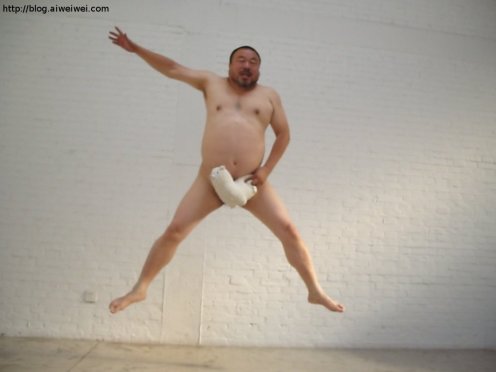 Apparently Ai Weiwei is now free on bail. The LA Times also has a report and an up to date photo. The offical story is he confessed to tax evasion but that seems dubious. Being a fan of Mr. Ai who had an exhibition in Portland last year at MOCC, PORT has followed the story from the beginning. Honestly, all we could do is hope to keep up any pressure we could and I'm glad Ai Weiwei has been freed and perhaps this is a good thing for China (sadly, it doesn't effect the art world much other than provide a moral rallying post and hasn't freed other captives). Ultimately, the Chinese Government overreacted to the toppling of dictatorial governments in the Middle East... (more) Posted by Jeff Jahn on June 22, 2011 at 13:00 | Comments (0) PermalinkMonday 06.20.11 Why are new grads so lame? It's an annual occurrence... the
lament against the derivative nature of recent grads and this year Jerry Saltz
does the honors. He often does it best too... though Robert Hughes' original
ending for The Shock of the New lamenting how art has become a "vocation"
not an "avocation" is the all time best (he later wussed out and took
the teeth out his argument by writing an amended ending for the second and subsequent
editions).
Overall, I agree with Jerry's assertions, but I want to get at the real issue, why is the thinking behind new art so derivative? Yes it is the academy (which promotes a clubby group think) and the system (which is subject to trends more than intellectual curiosity)... and it's partly why Portland keeps churning out interesting international level artists like Storm Tharp, Jessica Jackson Hutchins, Matt McCormick, MK Guth etc. They all pretty much were allowed to develop on their own according to their own idiosyncrasies for a decade plus. Portland lets you do that (other places do too but Portland has that magical combo of being off the beaten path and being a hot place where international curators will find you). San Fran artists like Harrell Fletcher and Chris Johanson came to Portland to do their own thing and the place still attracts and develops artists. Id say there are 30-50 artists (young and not so young) who make work worthy of serious international attention and maybe 200-400 with potential to join their ranks (17,000+ artists active in the city). So if you are looking for a lost world of excellent artists you didn't quite know existed, check out Portland's busy studios. BTW, many of the best ones do not have gallery representation since they are installation and video artists and yes many show outside the city. For an information gathering resource, PORT's reviews and interviews are the best collection of who to watch. Posted by Jeff Jahn on June 20, 2011 at 15:26 | Comments (0) PermalinkSaturday 06.18.11 John Grade wins Schnitzer Prize 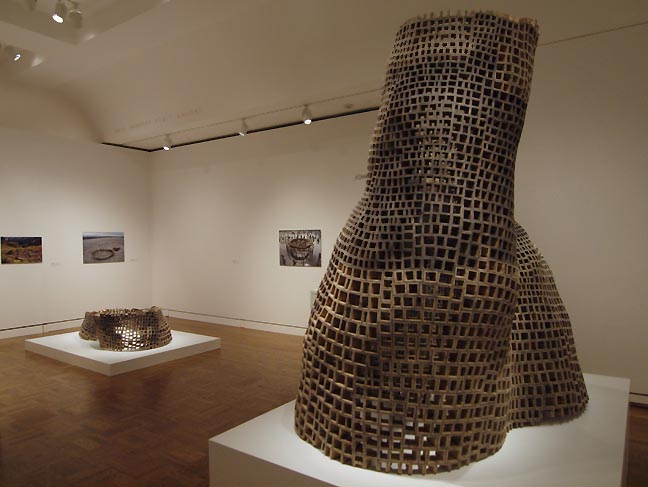
John Grade's work at The Portland Art Museum's 2011 CNAAs Congratulations to Seattle based John Grade. I was happy that he received the nod for the Arlene Schnitzer Prize, which comes with $10,000 and even greater exposure within the CNAA's purview. Though, as I mentioned earlier this week I found this second iteration of the Contemporary Northwest Art Awards an even bigger (and ghettoizing) restatement of Northwest stereotypes (whittling, smudges, gray haze, fussy handmade craft, politeness and some nature)than the first one. Quite simply we are more than that... the silicon forest and a region which leads in so many international fields like design, green technology, communications and aircraft etc. Still Grade's work is handsome, engaged and excellent (especially his very large indoor installation pieces). ...(more) Posted by Jeff Jahn on June 18, 2011 at 22:03 | Comments (0) PermalinkThursday 06.16.11 Some Links Brad
Cloepfil's firm Allied Works is a
finalist for yet another Museum, this time in Lausanne Switzerland. His
design is a bold sculptural effort with more than a little bit of Louis Kahn
in it. It is a more porous design that builds on his Clyfford
Still Museum, which is starting to take shape. Cloepfil, whom I've described
as having a heavy and an airy side seems to be reaching a point where his designs
are capable of juggling both. Locally he is doing the renovation of PNCA's 511
building.
Anyone remember the Vorticists? I bet some PORT reader's know who they are and they have a retrospective up in Britain... bully! Jerry Saltz's Venice adventure. YU responds to DK Row's article, which we discussed on June 3rd. Honestly, the best response will be forming a decent board to vet this ongoing process and get some buy in for all of this planning they have planned and planned for years now. The founders need to have accountable input in forming/alter-ing that plan to create buy in for their project. In the letter George Thorn described YU as, "unlike any organization I have worked with and is the most complex organization I have ever worked on." That complexity isn't necessarily a good thing and a little more focus will help them sell their plan to others. Also, the founders still seem to be phobic of basic things like curatorial staff (wanting a multimillion dollar artist-committee run space), but a curator is necessary for programming a demanding 8,000 sq ft main gallery coherently. An example why a curator is necessary... they still have the Carl Andre's inappropriately installed as if they have no idea what Carl Andre is about (hint anything but an artifact). For example it's made of humble materials to avoid the preciousness a glass case imparts and placing it next to archival ephemera simply disrespects the work. We wish them well (unlike the O which continually heckles the art scene) but at some point the founders need to share the planning responsibility with knowledgeable board members who ultimately will make this happen. Right now it's just spending seed money which is ok for now but in say 6-7 months will just seem like the staff is on some extended vacation provided by one donor who doesn't appear to exercise any oversight. YU needs to avoid that at all costs but Row's article was too busy being sensational to make that point. Posted by Jeff Jahn on June 16, 2011 at 11:12 | Comments (0) PermalinkFriday 06.10.11 Venice links So it's been Venice Biennial time again, here are some links if you want to
keep tabs (It's ok I'm just not stunned):
Here is a photoblog with a lot of good images. Jerry Saltz's best and worsts photo essay. Artnet's guide and images. Perhaps it's the fact that Ai Weiei is still in prison? Here are his zodiac heads, currently installed in New York... I'd rather have seen them in Venice. Posted by Jeff Jahn on June 10, 2011 at 17:08 | Comments (1) PermalinkWednesday 06.08.11 Wrong way to address the Ai Weiwei situation Tyler Green isn't someone who is easy to shock, but the
Director of the Milwaukee Art Museum has done just that, with impressively
arrogant statements about the effectiveness of protesting Ai
Weiei's now 2 month imprisonment. It is one of the biggest PR blunders ever
for a museum director and no it wont go away.
An artist shaves his head as the director of the Milwaukee Art Museum redefines ineffectual with his statements about Ai Weiwei protests. Posted by Jeff Jahn on June 08, 2011 at 15:13 | Comments (2) PermalinkTuesday 06.07.11 Architecture on the radio 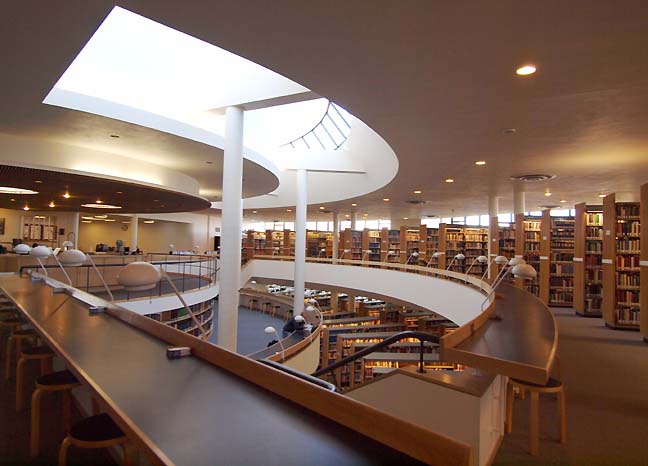 Mt Angel Abbey Library by Alvar Aalto (photo Jeff Jahn) I'll be discussing architecture with Tom Cramer today on KBOO's Art Focus program at 11:30 am PST (a link to the archived audio will appear on that link after the show). Portland has undergone a bit of a resurgence in architecture after decades of atrophy as my recent articles on the; Bud Clark Commons, OCAC's new buildings, Ziba HQ, Willamette Transit Bridge, Brad Cloepfil and the Aerial Tram can all attest. Posted by Jeff Jahn on June 07, 2011 at 1:27 | Comments (0) PermalinkFriday 06.03.11 Friday Links The Oregonian for
once is asking basic questions about the YU project. Welcome to the world
of competent analysis. PORT asked these questions 8
months ago when we were the first to write about YU Contemporary Art Center),
better late than never and it's always ironic as hell when DK uses quotes from
others to editorialize (that's not a slam, it is genuinely entertaining passive
aggressive writing that often reveals a lot about the quotee's). Still, his analysis is a little wrong headed. To be more
precise, "secrecy" isn't an issue, it's accountability. Instead of
spending so much time on innuendo DK only grazed part of the biggest problem,
the lack of a board of directors who are not staff. Board members are the best
indication of a project's potential and as I
mentioned again last month, I do not understand how or why YU thought it
was OK to go public without at least a proto board (say 3+ respected members
of the community with contacts and deep pockets), some lead gifts and a detailed
plan that satisfies those board members. It's art institution 101 and it's partly
why the Portland
Art Center failed (well that and not realizing they were out of the league/institutional
expertise or able to take good advice). Last month I also noted a completely
inappropriate
installation of Carl Andre pieces at YU's inaugural exhibition as well *Update: on KBOO this week Curtis Knapp stated the Andre's are archival but he's wrong, other similar pieces from the PCVA show are in MOCA and the Guggenheim's permanent collections.
At least YU has some seed money and a general art world sophistication several
tiers above Disjecta
and the Portland
Art Center (who always talked a better game than they could ever deliver,
that's not a slam just a reality check. They were never true contenders for anything
other than large alt-spaces of local shows with eager artists that cut them slack). Analysis: YU has now reached a
point where they need to shape up, and it is not like they weren't given this
same friendly advice a long time ago. Let's hope they can turn it around.
For the WSJ, Terry Teachout blasts museums like The Milwaukee Art Museum (my old hometown haunt) for being complicit with the Chinese Government who continues to hold Ai Weiwei, NOW their most famous contemporary artist. Last month I vowed to mention Mr. Ai in any article regarding China until he is freed. Jerry Saltz takes a swing at some embarrassingly weak American art at the Venice Biennial. There were 2 major new "white box" Museum designs for SFMOMA and The Whitney last week. Of the two the SFMOMA is better, the Whitney's design isn't even as good as Renzo Piano's recent addition in Chicago. Why? Because it just luxuriates in its "whiteness of the whale" rather than engaging or at least a few idiomatic floorplans and ideas that integrate surprising sight-lines within the city around it. IE it is too generic. Overall, I'm tired of this white box thing, in fact it is why I like the current Breuer designed Whitney with it brutalist slate floors and dark gridded ceilings is so endearing to me. Posted by Jeff Jahn on June 03, 2011 at 14:49 | Comments (3) PermalinkWednesday 06.01.11 PORT's 6th Anniversary 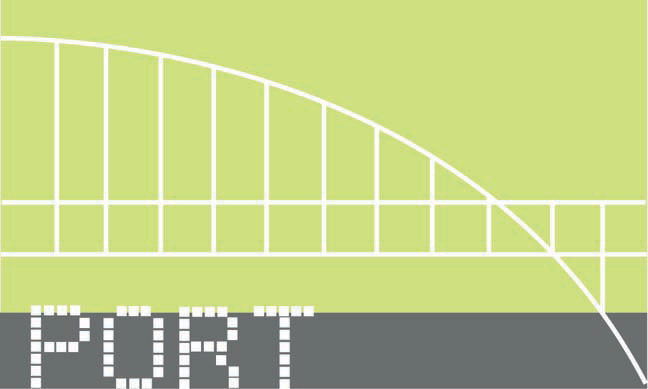
Today is PORT's 6th anniversary and I like to use these annual occasions to draw attention to all of the excellent writers who have helped make this ground breaking publication what it is. PORT is much less a business (barely a business) and more of a community service as a venue for cogent, decisive information and critical discussion. With 1,000,000+ unique readers in 2010 alone the site is infinitely more popular than we ever imagined it would be when Jennifer Armbrust, Katherine Bovee and I started it back in 2005. With notice from Art in America, The Walker, Andy Warhol Foundation and The Whitney... PORT is arguably the most influential art publication in the history of the Pacific Northwest. Just yesterday Amy and I were chatting about how strongly we feel about this (though we seldom dwell on it, anniversaries give us pause to do such) ...but with the demise of full-time art and design criticism in newspapers it is obvious. Also, PORT does things that traditional journalism has always struggled with, namely levy relevant criticism, rather than mere glad-handing praise or disinterested heckling. For example, in 2010 PORT published the major and timely review of OCAC's fantastic new arts buildings and delved into what it might mean for the school. It was a milestone in that school's historic development and Portland's design ecology but the newspaper was MIA. Fact is, when you don't have staff critics and just rely on freelancers you miss major developments. At PORT we can't miss such things because they are central to our lives as citizens of the area's arts ecosystem. Our often in depth interviews have no equal in the region: Catherine Opie interviewed by Megan Driscoll Charles Atlas interviewed by Gary Wiseman Alison Saar interviewed by Gabe Flores Deborah Kass and Jessica Jackson Hutchins interviewed By Amy Bernstein Robert Storr and Ai Weiwei interviewed By Alex Rauch Mark Grotjahn interviewed by Arcy Douglass Our reviews probe more of the Portland art scene with depth, going beyond exposition and influences to do truly critical reviews like: My reviews of Collect Four, Hung Keung and Dan May (I felt he had never received an adequate review). Then there was a trio of architectural art shows that exemplify a major school of artists in Portland Matt McCormick's Great Northwest by Megan Driscoll Patrick Collier's thoughts on No Painting Left Behind, Vanessa Renwick and Open Engagement We even do more complicated/experimental reviews where the curator is involved in the show as an artist sch as Amy's You'll Never Walk Alone or my review of Reader on a Black Background... not everything needs to be unpacked, simple or even fully digested to have value and that is where a publication that caters to a visual arts savvy audience is important. Sometimes we like it when things are recursive, frayed and elliptical. PORT is about the art and our world, not about writers using art as an excuse to effuse... (more) Posted by Jeff Jahn on June 01, 2011 at 12:11 | Comments (0) PermalinkMonday 05.16.11 Monday Links Tracey Emin is having her mid career retrospective at the Hayward
Gallery. She's an artist I want to hate, but find really interesting...
perhaps the most influential of any living artist amongst anyone with an MFA
in the last 15 years. In her typically counter-intuitive fashion she's
advocating for Britain's conservative party as good for the arts. She hasn't
had a major show in the Northwest ever but if she does... it may give PORT the
excuse weve needed to do a really great interview.
There was a nice, respectful expose on Rene Rickabaugh in the O! this weekend. On Portland Architecture the Oregon Sustainability Center is looking for design imput. To me this new schematic doesn't seem cohesive and doesn't scream "Im the greenest office building on the planet" like it needs to. Jerry Saltz thinks that, "Architecture killed the American Folk Art Museum"... which has had lackluster attendance despite being right next to MoMA. I've always felt that it was simply too subtle and unwelcoming a facade and a good example of an architect getting too close to an artistic statement that has nothing to do with the institution's needs. MoMA is buying the building. Update: apparently the architecture critics are fighting back... they are dead wrong, for the reasons Jerry and I have already stated. Museums should serve the art and roll out the red carpet for visitors, especially when they are the little guy next to the 800 lb gorilla on the block. It was a tactical error and therefore a fatally flawed design. Posted by Jeff Jahn on May 16, 2011 at 10:53 | Comments (0) PermalinkFriday 05.13.11 China redefines farce 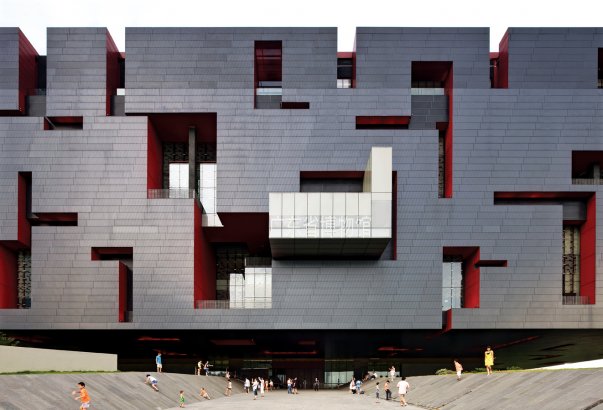
Human rights are meaningless, you will be assimilated? Here's a contemporary art museum So check out this wonderful Borg cube style contemporary art museum in Guangdong China. Neat eh, except that erecting huge contemporary museums while still holding and apparently torturing Ai Weiwei makes the entire idea of contemporary art in China incredibly farcical. It essentially undoes the entire effort of the 2008 Olympic games. That's right, every time something Chinese blips up on the press radar I'm going to use it as an excuse to bring up Ai Weiwei's incarceration and I think everybody else should do it too. Overall, the Chinese government has painted themselves into a corner and I fear it wont end well for anyone involved. Thankfully Secretary of State Hillary Clinton isn't glossing over this issue and has been heaping on the pressure this week. Posted by Jeff Jahn on May 13, 2011 at 14:52 | Comments (1) PermalinkMonday 05.02.11 TBA Visual Arts 2011 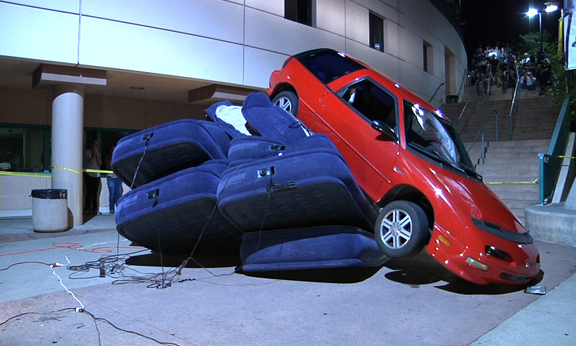 Jesse Sugarmann's Red Storm Rising PICA has just announced its TBA ON SIGHT visual arts lineup for 2011. The theme seems to be a broad institutional critique with the title, "Evidence of Bricks: The building up, but mostly tearing down, of institutions, societies, structures and ideas." Highlights will probably be Oregonians Patrick Rock and Jesse Sugarmann, both of whom use giant inflatables few curators in Portland have the Cajones to use (Rock's gender-bending Hermaphrodite Simulacra shown here in 2005 is simply the baddest inflatable art piece I've ever encountered). Last year's TBA offerings (with the theme "Human Beings")were both excellent (Charles Atlas, John Smith etc) and somewhat inconsistent in the way that festival art tends to be and the sheer number of artists this year indicates another ambitious lineup. PICA's press release list: TBA ON SIGHT is a collection of installations, exhibitions, projections, and gatherings by visual artists, curated and organized by Kristan Kennedy, Visual Art Curator for PICA. ... (more) Posted by Jeff Jahn on May 02, 2011 at 15:31 | Comments (0) PermalinkMonday 04.11.11 Monday links  John McCracken's, Vision, 2004 Pioneering light, space and surface artist John McCracken has died at age 76. Here is Christopher Knight's full obituary. The Portland Art Museum has two of his works on display, a classic leaning "plank" piece like the one above (on loan from the Miller-Meigs Collection) and a beautiful little black cube given to the museum by the Groths. Ai Weiwei is still incarcerated, here is the international petition. The Guardian publishes a few prescient quotes from Ai Weiwei's last interview before he was arrested. Posted by Jeff Jahn on April 11, 2011 at 10:58 | Comments (0) PermalinkFriday 04.08.11 Friday Links The Art Newspaper sheds light on the race to save
Buddhist sculptures from a Chinese mining company in a former Bin Laden
camp.
The Gaurdian interviews architect Amanda Levete. Edward Winkleman discusses the "economic crimes" of Ai Weiwei, who continues to be incarcerated since last Sunday. Posted by Jeff Jahn on April 08, 2011 at 17:06 | Comments (0) PermalinkSunday 04.03.11 Ai Weiwei arrested Ai Weiwei has been arrested, along with many other writers and bloggers critical of the Chinese government. PORT interviewed Ai Wewei last fall for his show at MoCC. This arrest seems like a more full scale government crackdown on activists rather than their typical loosening and tightening cycle. We will post updates as they occur.
Overall, art requires peace and protected freedoms... it's the canary in the coalmine. Indeed Ai has chosen to be that canary...and in doing so has made the Chinese Govenment choose whether he is an artist or a political dissident. If he can't be both it is the Chinese government, which is then judged accordingly. It is a brilliant and very dangerous game. Update: Missing for 36 hours France and Germany lead call for Wei Wei's immediate release. In response to an ominous move by the Chinese Govenment Slate asks if Ai Weiwei is being charged as a criminal for committing "economic crimes." The development of such a strange and suspicious charge suggests that Mr. Ai's incarceration by the Chinese Government is intended to be long term. Likewise, international outcry has been increasing daily. 
Tate Modern's exterior now reads, "REALEASE AI WEIWEI."  Leung Chi-wo's T-Shirt slogan Ai Lai Wei (Love the Future) for the march since Ai Weiwei's name is banned. Honk Kong artists to march in support of Ai Weiwei's release. In Particular the slogan "Ai Lai Wei" (Love The Future) shows that Mr. Ai has become a bigger idea and when a man become an idea, holding that man prisoner becomes infinitely more problematic. Posted by Jeff Jahn on April 03, 2011 at 18:02 | Comments (2) PermalinkFriday 03.25.11 Friday Links An excellent look at one of the most excellent things on the planet, the
Maison de Verre in Paris with excellent photos by Todd Eberle. I use the
word Love sparingly... I Love this building, definitely check out Eberle's
slideshow.
Joe Thurston wins a Pollock Krasner Grant, congrats. Portland's Bürgermeister Sam Adams presents Berlin's Bürgermeister with works by Damien Gilley... who is having a hell of a month. Posted by Jeff Jahn on March 25, 2011 at 8:28 | Comments (0) PermalinkMonday 03.21.11 Disaster Links Jessica Lack looks at contemporary
art that makes massive natural disasters its subject matter.
Los Angeles has a new Museum to the Holocaust. I like how the bone/plant like structure is built into the landscape. In case you haven't heard already, Richard Prince has lost the first round of his claim of fair use in appropriating the images of others. There will be an appeal. Overall, I'm against the idea that someone could take a body of artwork by another artist and through minor levels of defacement claim it as their own artwork. In my mind advertising is different. It had a different intended use, whereas art thrives on the ambiguities it calls forth. Any art made from it would rely on those same ambiguities to varying degrees. In Prince's case he relied on the other artist's work far too much, essentially pantomiming the original photos. It just isnt enough to call it new work. Lastly, Prince is essentially an artistic vampire... that's fine but why prey on another fine artist? Sure Picasso did this all of the time but he didn't lift photographs, mildly deface them and call them his own. Photography is easy to appropriate so I believe using them in such a way invites a legal decision if one isn't careful. I also believe Prince knew this was the likely outcome and saw it as a way to keep what I call his "relevant pirate" reputation up to date. Posted by Jeff Jahn on March 21, 2011 at 12:46 | Comments (0) PermalinkFriday 03.18.11 Friday links Lots of interesting developments to link to this week:
Last night Mayor Sam Adams (in an open letter to Governor Kitzhaber) proposes a closer look at the cable stayed design for the CRC. Notably in 2008 Adams singled an early article I wrote in one of his own blog posts regarding the need for good design and perhaps an iconic one (this letter suggests he's holding to that goal). The process has been backwards but there is a reason the cable stay is a popular design option... not the cheapest or the most expensive but perhaps the smartest (seismic, environmental and iconic) bang for the buck. As I mentioned earlier this week the cable stay design keeps gathering momentum (the deck truss design is abysmal and wont get local support). Another thing to consider is the need for a good designer to make certain the details of this hugely expensive project are developed and executed well. This isnt a luxury folks, simply a way to ensure that we and those who live here after us get the most for the inherently expensive price of such a project. Extra profit taking by skimping on details for transit projects is hardly a new or rare thing, a designer brings a certain quality control. Still, with seismic concerns and the overall rickety design of the current bridges (which lack max trains) I believe we need a new bridge. It will bring jobs and I feel the Federal Government needs to become a more major funder in this I-5 project. This isn't just a bridge between Portland and Vancouver, it is a bottleneck on I-5 that is dangerous in a major seismic event, and clogged during normal operation conditions. It could transform the way Portland and Vancouver interract if done well. Pulitzer Prize winning photographer Brian Lanker died in Eugene last Sunday at age 63. Known for his portraits of civil rights leaders and poignant on the scene snaps, he gets a nod from the New York Times. The Gaurdian discusses a fascinating historical exhibition about filth, called Dirt. Even Europe is making cuts on contemporary art and Daniel Buren speaks out. Le Corbusier's Chandigarh is threatened, help protect it. Artists and curators boycott Guggenheim Abu Dhabi. Posted by Jeff Jahn on March 18, 2011 at 13:52 | Comments (0) PermalinkMonday 03.14.11 CRC: the Cable Stay design gains momentum 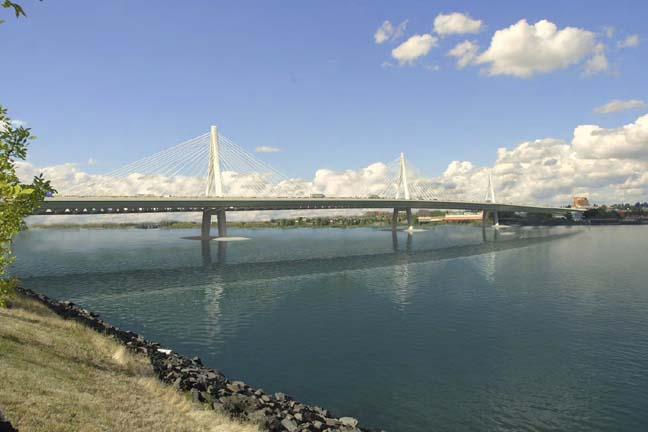 Cable Stay Design There were a lot of discussions about the Columbia River Crossing this weekend as things come to a head (again). New developments include the information that Pearson Airfield doesn't really pose much of an issue to building a taller/superior cable stay bridge. It is superior because that bridge type performs better in earthquakes, has a smaller # piers in the water and thus less environmental impact, plus becomes an icon spurring development for both sides of the river. Some characterize it as a merely aesthetic choice but seismic and environmental superiority plus the fact that the design is more pleasant for pedestrians and cyclists makes is a superior design which costs less than than the initially proposed bridge design (which was awful). This whole process has been backwards as PORT was the first to point out. Last weekend: Jeff Stuhr and Mark Masciarotte gave a guest opinion in the Oregonian Brian Libby at Portland Architecture responds to a specious article in the Portland Business Journal Ethan Seltzer penned a guest article for the Oregonian (which tragically lacks an architecture critic). Hell even Vancouver's city council likes the cable stayed design. This process has been tremendously flawed (putting off the shelf bridge types above a true design discussion), but let's build the right bridge... we don't need the wrong one and building a horrible legacy for those who will have to suffer such a monstrosity in the future misses a great opportunity to re-imagine Portland and Vancouver's relationship to the mighty Columbia (and each other). Right now the only bridge that can bring everyone together is the cable stay design because it adds to the region rather than merely puts a transit band-aid upon it. Kitzhaber should listen to his base in Multnomah county, which has growing public support for the better performing cable stay design. And while he is at the project should hire a good architect to make certain the key design details are executed well, rather than in a perfunctory manner. Posted by Jeff Jahn on March 14, 2011 at 12:08 | Comments (0) PermalinkWednesday 03.02.11 Regional Links CNAA curator Bonnie Laing-Malcomson
was interviewed by Eva Lake on Kboo yesterday. She's obviously still transitioning
as she speaks in third person about "curatorial" as if it is a different department... look it's a steep
learning curve, which we saw in February with the CNAA lineup. The question
is if and how she can grow? The region is simply more engaged, challenging and
diverse in its art production strategies... especially Portland (whom PAM needs to stay
relevant to... especially when Tate Modern, The Whitney and MoMA have arguably
played a bigger role locally).
Seattle's Ambach and Rice gallery is moving to LA. There is definitely room for a new serious gallery in Seattle but there is a lot of competition with Portland galleries also showing Seattle based artists. The Oregon and Washington Governors have chosen a terrible design for the CRC (like the Marquam bridge, which many Portlanders want to demolish) and I urge everyone to check out this link and write their elected officials about the need for better design thinking rather than simple off the shelf engineering options. Portland's progressive thinking population will probably rise up in protest over this very ill considered choice. The CRC's own Design Advisory Group had much the same to say with this open letter. Posted by Jeff Jahn on March 02, 2011 at 12:29 | Comments (1) PermalinkMonday 02.21.11 2011 CNAA's whittled down Well PAM has whittled
down their hand crafted list of artist for the 2011 Contemporary Northwest
Art Awards
Chris Antemann John Buck John Grade Jerry Iverson Suzy Lee Megan Murphy Michelle Ross This is an overtly politically motivated list including someone from every state in the award's territory and therein lies the problem. It is a all very approachable, even soft stuff and really reiterates a ton of Northwest stereotypes... (more) Posted by Jeff Jahn on February 21, 2011 at 8:17 | Comments (4) PermalinkTuesday 02.15.11 Talking Criticism Today at 11:30 AM on KBOO
Ill be joining Brian Libby, Barry Johnson, Lisa Radon and host Eva Lake to discuss
art criticism... since DK
Row's role at the Oregonian seems to have changed. It will be interesting
if they will make an official announcement and or actually replace him with another
critic in the role.
For example Randy Gragg as architecture critic was not replaced, essentially crippling the O's voice in architecture and urban planning... (more) Posted by Jeff Jahn on February 15, 2011 at 0:49 | Comments (3) PermalinkWednesday 01.19.11 Judd Conference still making waves The
Judd Conference in Portland from last April is still making waves and The
Art Newspaper has a brief article about the importance of Portland's kick
off and the next two installments.
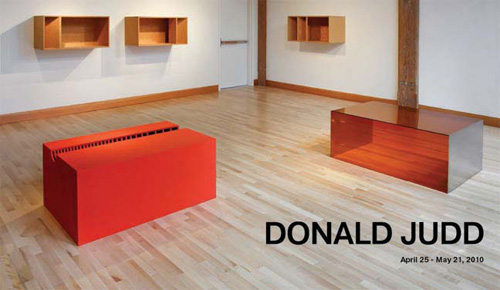 Judd Art ©Judd Foundation. Licensed by VAGA, NYC. By putting on the conference and exhibition I felt we foregrounded the issue of integrity in a way which has been in atrophy around Judd's work for quite some time. In fact, the issue of integrity of display of any artist's work has become muted in the last 30 years with the increased focus on blockbusters. Perhaps no artist before or since was as specific as Judd was about what does and does not constitute proper presentation... and I hope this helps bring the word back into the contemporary art vernacular. (you can pick up catalogs for the exhibition at The White Box Gallery and Monograph Bookwerks). Posted by Jeff Jahn on January 19, 2011 at 13:00 | Comments (0) PermalinkTuesday 01.18.11 New Gallery: Black Box Longtime Portland art scenester Todd Johnson is launching his new photographic
gallery Black Box,
adding something new to the Lower Burnside enclave across from the Doug Fir.

Johnson has been one of Portland's most talented independent curators (he may possess the scene's dryest and darkest wit) and as a photographer himself has shown... (more) Posted by Jeff Jahn on January 18, 2011 at 15:56 | Comments (0) PermalinkMonday 01.17.11 Kengo Kuma to design expansion of Portland's Japanese Garden 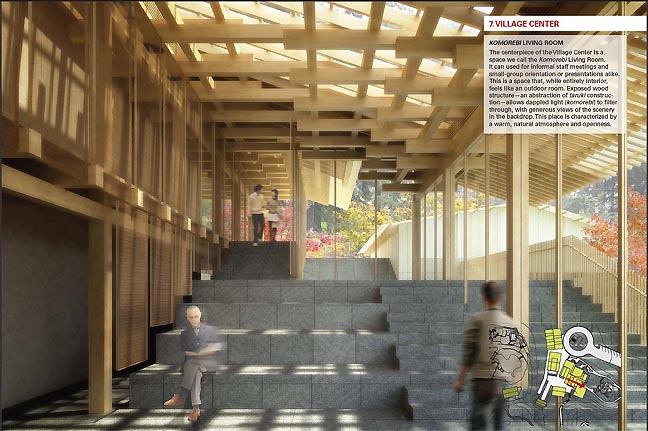 Kengo Kuma's very preliminary design proposal for Portland's Japanese Garden (area before entering the garden) After a two year search the Portland Japanese Garden has announced the selection of Kengo Kuma to lead the Garden’s future expansion project. This is just the latest in a series of major game changing architectural commissions starting with Brad Cloepfil's W+K HQ, The Portland Aerial Tram and most recently Charles Rose's new buildings for OCAC. Still, this is something different. Rather than an up and comer Kuma is a major name talent and already considered by many one of the world's very best architects. I particularly like his Chokkura Plaza and Great (Bamboo) Wall House. Perhaps more than any architect alive today he is sensitive to local materials and nature so he is an... (more) Posted by Jeff Jahn on January 17, 2011 at 13:55 | Comments (2) PermalinkMonday 01.10.11 Broad isn't the issue 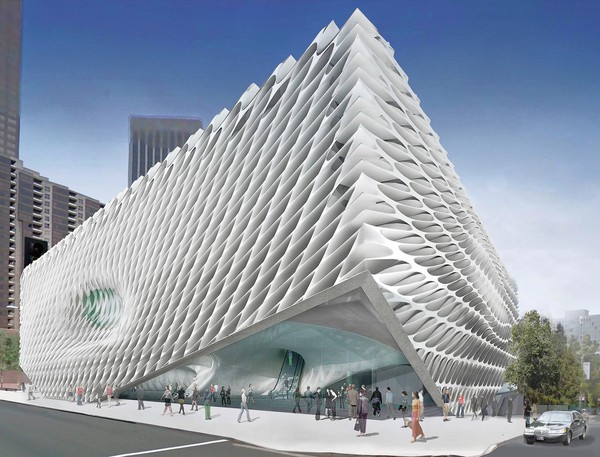
The New Broad Museum design by DS+R So there has been a lot of discussion of Eli Broad's new Contemporary Museum designs by Diller Scoffidio + Renfro. Honestly, I can't see what all the fuss is about... it looks good. All the dithering seems to be over the fact that... (more) Posted by Jeff Jahn on January 10, 2011 at 10:43 | Comments (3) PermalinkThursday 01.06.11 Jeffrey Thomas named MoCC's acting director PNCA/MoCC announced today that my longtime friend Jeffrey Thomas will be the new Acting Director of the rebounding Museum of Contemporary Craft. It is a 6 month appointment, which can be renewed.
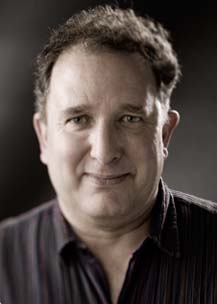
What about Jeff? As Tom Cramer once so succinctly put it, "He's a genius level level marketer." He's also a former Soho gallerist (he was the Thomas of the Jamison/Thomas gallery) and his mother was part of Warhol's factory scene. Thomas is also very opinionated with a sharp eye for detail... (more) Posted by Jeff Jahn on January 06, 2011 at 12:55 | Comments (1) PermalinkWednesday 01.05.11 PORT's 2010 readers poll awards Time for the results of PORT's annual readers poll (aka the popularity contest).
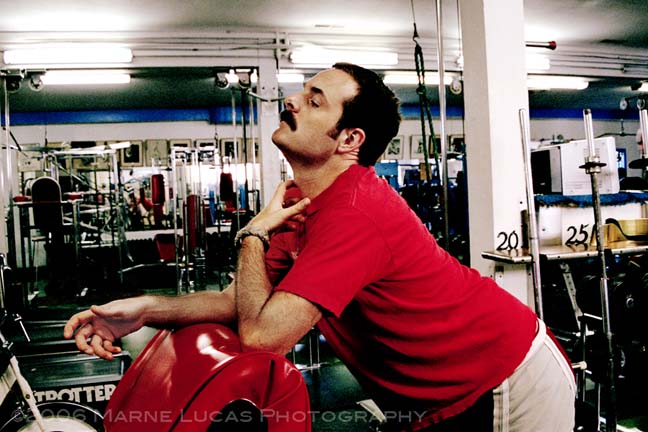 Storm Tharp (photo Marne Lucas) 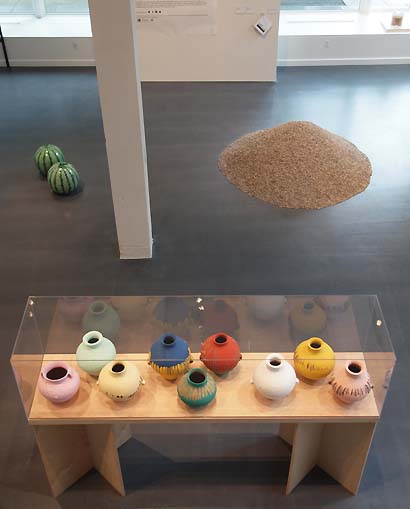 Ai Weiwei's Dropping the Urn at the Museum of Contemporary Craft ...(more) Posted by Jeff Jahn on January 05, 2011 at 17:40 | Comments (0) PermalinkMonday 01.03.11 Monday links Roberta Smith seems to think that MoMA has been revitalized. She has a point but MoMA's atrium space isn't quite as attention getting as the Tate's Turbine Hall and more importantly MoMA hasn't been setting the bar in curatorial excellence and prescience as of late.
Tomorrow at midnight is your last chance to vote on our annual reader's poll. Currently it's a shootout between Bruce Guenther and Patrick Rock for MVP. Frankly its an absurd contest, anyone in their right mind would have to hand it to Guenther for show quality but the simple fact that Patrick opens his own home to do always interesting/challenging shows that we would never see at PAM gives him the underdog's edge. For the most overshown artist it's a near dead heat between Calvin Ross Carl and OPS. Storm Tharp is also a clear favorite in every category he appears in so far. Posted by Jeff Jahn on January 03, 2011 at 14:07 | Comments (5) PermalinkSaturday 01.01.11 Time to Vote: Portland Art Scene 2010 Readers Poll 2010 is done, time for PORT's readers to evaluate with our annual popularity contest. Just click on the full version of this post to take it.
Posted by Jeff Jahn on January 01, 2011 at 13:39 | Comments (0) PermalinkMonday 12.27.10 Last day for nominations, 2010 art scene MVP etc. It is that time of year again... that's right it's time for the annual popularity contest, so let's nominate
2010's best and worst. In particular who do you think was 2010's MVP?
Feel free to nominate multiple artists/curators and suggest categories like; MVP, best solo show 2010, best group show 2010, alternative art space of the year, University gallery of the year, favorite museum show, tightest show, most overhung show, most overexposed, most disappointing solo show, most disappointing group show, curator of the year, best conceptualist, best installation, best abstract painter, best figurative painter, best light and space installation, best video piece, funniest art scene moment, best institutional decision, most perplexing institutional decision, most promising new talent, most exciting development and least exciting development. Email your nominations to me: jeff (at) portlandart.net Posted by Jeff Jahn on December 27, 2010 at 2:05 | Comments (2) PermalinkMonday 12.20.10 Monday Links Brian Libby has published Part
2 of his decade in review of Portland's architecture. This installment focuses
on the condos. Maybe no single project or neighborhood has redefined the city
but collectively the greater density and overall upward thrust certainly makes
Portland look and feel much larger than it was a decade ago.
Christopher Knight ponders 2010 as an art year. Tyler Green reports on the latest in the Smithsonian "integrity scandal" as AA Bronson asserts he has the legal right to remove his work from a compromised show. Posted by Jeff Jahn on December 20, 2010 at 12:39 | Comments (0) PermalinkFriday 12.17.10 Taking nominations for 2010 Portland art scene awards It is that time of year again... that's right it's time for the annual popularity contest, so let's nominate
2010's best and worst. Feel free to nominate multiple artists and suggest categories
like; best solo show 2010, best group show 2010, alternative art space of the
year, University gallery of the year, favorite museum show, tightest show, most
overhung show, most overexposed, most disappointing solo show, most disappointing
group show, curator of the year, best conceptualist, best installation, best abstract
painter, best figurative painter, best light and space installation, best video
piece, funniest art scene moment, best institutional decision, most perplexing
institutional decision, most promising talent, most exciting development and least exciting development.
Email your nominations to me: jeff (at) portlandart.net Posted by Jeff Jahn on December 17, 2010 at 12:23 | Comments (0) PermalinkTuesday 12.14.10 Ed Cauduro, Oregon's greatest art collector passes away Perhaps the greatest collector of modern and contemporary art in the Pacific
Northwest, Ed Cauduro, died last Saturday in Palm Springs at the age of 83.
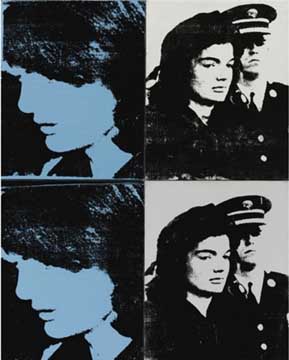 Warhol: Four Jackies (formerly part of Cauduro's collection, exhibited at PAM in 2004) What differentiated the reclusive collector was his prescient eye as he was among the first to collect artists like Donald Judd, Jasper Johns, Andy Warhol, Jean Michel Basquiat, Terry Winters and Jeff Koons. He even collected John Chamberlain's first car crush sculpture, Shortstop. Besides donating works like the orange Alexander Liberman sculpture Contact II in Jamison Square Park... (more) Posted by Jeff Jahn on December 14, 2010 at 0:25 | Comments (0) PermalinkThursday 12.09.10 ABMB hangover 2010 Todd Eberle chronicles the annual Art
Basel Miami Beach people watching hangover... in Vegas.
Here are some photo's of some of the art at the main ABMB fair on ArtInfo. I'd categorize them as Vegas meets the morgue. ...and more photos. Posted by Jeff Jahn on December 09, 2010 at 12:41 | Comments (0) PermalinkMonday 11.29.10 Linkage Steve Martin a has a new book about the art world... I hope it stays a book and doesn't become a movie. But it will.
Just when I was thinking that Zaha Hadid had lost her magic touch found in earlier projects like the Strasbourg Car Park, her Stone Towers project looks awfully good. I like festivals, especially when they are focused, and this bucolic outdoor installation art festival in Russian looks interesting. Posted by Jeff Jahn on November 29, 2010 at 12:29 | Comments (0) PermalinkMonday 11.22.10 Monday Links Jerry Saltz takes on lil
Bush's official portrait here.
Roberta Smith gives her estimation of Anselm Kiefer's return to NYC after an 8 year hiatus. Posted by Jeff Jahn on November 22, 2010 at 16:01 | Comments (0) PermalinkMonday 11.15.10 Turner Prize and CNAA's Art21 has
a nice summary judgment of this year's Turner Prize candidates. Im definitely
for Otilith
Group too (I'm a sucker for extra geeky snappy-looking shows), which means
they probably won't win.
As we have seen with the Contemporary Northwest Art Awards these types of show rarely pick the strongest artist in that iteration's show... it's kind of an institutional hallmark to pick something blander... the bigger the institution the less willing they are to make consequential decisions about taste (instead they follow). BTW The CNAA's are underway again and will take place in June 2011. Will they prove consequential like the Turner Prize was in the 90's (less so now but still major) or just another navel gazing exercise in things we already know about the region? The last one wasn't bad but it wasn't terribly influential either and didn't really pose a challenge to the NW identity. Also, there wont be an outside curator this time to winnow down the nominees like last time, just a panel of PAM's photography Northwest and contemporary curators and the director... yes a panel. Only time will tell if they need to remind everyone that... (more) Posted by Jeff Jahn on November 15, 2010 at 15:10 | Comments (0) PermalinkWednesday 11.10.10 Artitecture lecture at AiA 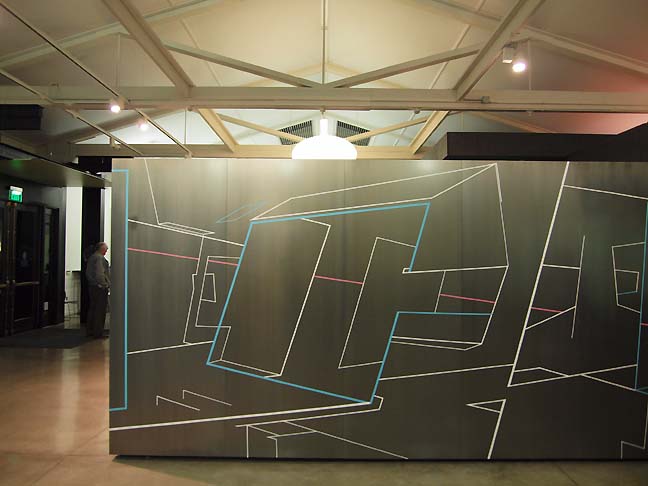 AiA with Infradraft installation by Damien Gilley With all of its changes in the past 10 years it's no surprise that Portland's art scene is particularly interested in architecture, construction and the design of space. Tomorrow, in conjunction with his exhibition Infradraft at AIA Portland Damien Gilley has put together The Artist Constructor, an evening lecture series in which 6 artist/critic/creatives will speak about select topics under the umbrella of architecture and space. Each 15 minute lecture by Salvatore Reda, Laura Hughes, myself, Victor Maldonado, Randy Rapaport, Damien Gilley should present a variety of approaches and philosophies at work in the city before a concluding discussion about the ramifications of these approaches. November 11th | doors 6pm | Lectures 6:30pm Refreshments provided by Widmer Brewing AiA Center for Architecture 403 NW 11th Avenue Posted by Jeff Jahn on November 10, 2010 at 13:16 | Comments (1) PermalinkMonday 11.08.10 Monday Links Ai
Weiwei's supporters "celebrate" the demolition of his studio. The
artist says he is to be released from house arrest Sunday.
In case you didn't catch it, PORT expanded our analysis of the YU contemporary art center project significantly last week. YU itself has updated its website with more info. Artist Tony Fitzpatrick discusses his moths and why New Orleans is special on Artnet. Posted by Jeff Jahn on November 08, 2010 at 12:08 | Comments (0) PermalinkFriday 10.29.10 Scary links Portland Architecture has the AiA
Oregon design awards for this year, ZGF takes top honors while the very
deserving Holst is denied top prize for the
new Ziba HQ's. Frightening!
In keeping with the Halloween holiday The Guardian has a look at the the photography of paranormal investigator William Hope. Posted by Jeff Jahn on October 29, 2010 at 13:13 | Comments (0) PermalinkMonday 10.18.10 Monday Links Interesting article on Roxy
Paine in the NYT's yesterday. what I like about Roxy and his work is that
there is a very idiomatic and autodidactic method to what he does. He considers
systems and finds a place between the natural and unnatural and there is something
refreshing about an artist of his stature who is both original and without
an MFA... although there is nothing wrong with art schools I do think it is important to note there are "other ways" . Here's PORT's review of Paine's
show in Portland many years ago.
The Menil has Kurt Schwitters Merzbau on display. It is Schwitters first US solo show in 25 years. Check out Jean Nouvel on the CBS morning show. Kinda sad how New York tends to stunt major architectural statements like the MoMA tower or create terrible things like the Freedom Tower. Besides, cutting off 200 feet from the Nouvel tower seems a tad arbitrary in Midtown. Tyler Green considers a rather unexciting apocalypse... where Miami Beach comes to Palm Beach. The real story is how uninteresting the whole concept seems on a curatorial level. Posted by Jeff Jahn on October 18, 2010 at 10:32 | Comments (0) PermalinkFriday 10.08.10 Culture culture Nice to read Barry Johnson taking a
swipe at the idea of the arts as being Elitist. A bit ago there was
a flap over this with Bob Hicks in the PORT comments but somehow I think
we both came to a better understanding between us. The point being generalist
news sources should really get over the idea as culture as some kind of pet
of the rich. Fact is, providing cultural offerings is an essentially egalitarian
and often thankless form of enhancing a diversified civic outlook that is its
most healthy when it is cosmopolitan in nature. The Greeks called the inherent
contention over such things Eris. Basically, in the visual arts a few
artists, art dealers, curators and yes patrons work and often sacrifice to make
art available to anyone who might appreciate it. It's a true case of a few serving
the many something that is otherwise out of reach. It's just another form of
education and I arts providers deserve the same respect as teachers. The thing
with the arts is you don't stop being called a charlatan of some sort until
you've done it for maybe 20+ years.
Herzog and de Meuron's Hamburg Concert Hall now has a fascinating video mixing it's current state and the computer renderings... probably a good fundraising tool! Posted by Jeff Jahn on October 08, 2010 at 14:52 | Comments (1) PermalinkThursday 09.23.10 Checking in with art writers Jerry Saltz answers some basic but sticky questions about careerism,
cronyism and elitism in the art world. These questions never go away but
Jerry is doing a good thing by giving extremely practical and positive insight here. All art students should read this as Jerry's attitude is pretty healthy.
Tyler Green reports on an endangered Richard Serra in Canada , will it finally be protected? PORT's Arcy Douglass has published a more personal essay on Robert Irwin. It's a followup to this PORT post but we felt it was a bit to personal for here. That said, if you follow Arcy and Robert Irwin you might want to check it out. Posted by Jeff Jahn on September 23, 2010 at 11:15 | Comments (3) PermalinkFriday 09.17.10 Ellen Lesperance wins Betty Bowen and analysis
Portland's Ellen Lesperance is the 32nd winner of the Annual Betty Bowen Award and will have a solo show at the Seattle Art Museum beginning October 21st. Congratulations. Absolutely well deserved and a choice nobody saw coming (which is very good).
Analysis: an unexpected and very good choice but I sense a backlash is about to manifest itself begging the question, "must every regional art award in the Pacific Northwest genuflect in some way towards overtly craft oriented or hand made work?" Not to be provocative, just articulating an observable trend that hasn't really kept up with new media. Obviously, craft is a valid and important part of contemporary art but it's not the whole picture, frankly its representation at the awards level is misleading. So I ask, when will video, photography and installation art that isn't fetishing craft outright be given its due at the Contemporary Northwest Art Awards, Betty Bowen (which did award photographer Isaac Layman a few years ago), Bonnie Bronson, Ford Fellowships? ie can any of these awards move beyond a predominantly laborious hand made (looking) world? This is the silicon forest after all, Portland and Seattle's economies are very tech-driven. In short, it's a question of accuracy in recognition since many of our non craft artists are internationally established. The Pacific Northwest needs to be more conscious of ruts at the awards level. Posted by Jeff Jahn on September 17, 2010 at 13:55 | Comments (3) PermalinkThursday 09.02.10 Opinion Links Architecture Daily considers the reaction to the curtain wall for Jean
Nouvel's now iconic Vision Machine in Chelsea. I think it's brilliant to
design an exterior first and foremost from the ideas that form the interior.
It will hold up very well, like the Marina City apartments in Chicago.
Tyler Green asks who you would like to see make a new public art piece in your city? We have Kenny Scharf and a pretty crappy Judy Pfaff here in Portland... who would you like? The tops of my list are Anish Kapoor, Robert Irwin and an outdoor Jennifer Steinkamp video projection. Posted by Jeff Jahn on September 02, 2010 at 10:07 | Comments (3) PermalinkSaturday 08.07.10 PAM announces Laing-Malcolmson as new Curator of NW Art 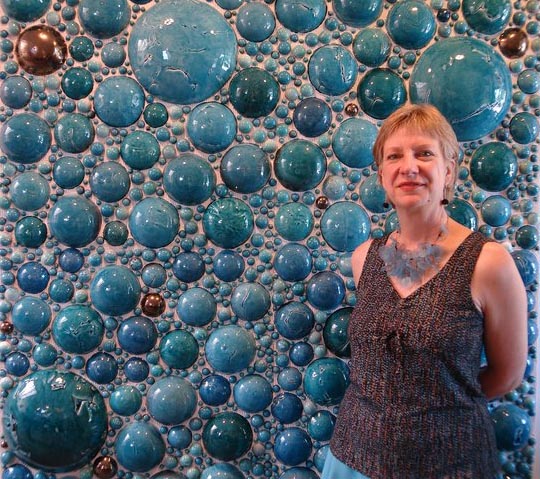 In case you haven't heard the Portland Art Museum announced today that Bonnie Laing-Malcolmson has been appointed as the new Arlene and Harold Schnitzer Curator of Northwest Art. She's considered by most in town to be sharp, fair, caretaker type with strong people skills. The position does need stability, as another short term appointee like her predecessor would reflect very poorly on the whole program, which is endowed by the Arlene and Harold Schnitzer. The position is necessary as she will be the museum's main interface with the arts community... one where the artists themselves are frequently of higher international profile than any of our institutions. Congratulations, you are much needed. Still, Laing-Malcolmson is a curious choice as she is better known to the region as an administrator, having just retired as the President of The Oregon College of Arts and Crafts. She apparently has some curatorial experience (in Montana) but nothing as contemporary as her predecessor Jennifer Gately (who stepped down after less than two years) in what would have to be considered a politically difficult post. It is one poised both historically and yet succeeds or fails in the very active present. For example, for the past 10 years + video and installation art have formed a huge part of the Northwest scene, with very little representation in PAM's collection. This is especially true of the popular hybrid, video installation. The point being, we expect a lot of this curator and there is a lot of backlog. The scene will expect excellence both historically and on the contemporary front. Let's just say... (more) Posted by Jeff Jahn on August 07, 2010 at 1:38 | Comments (3) PermalinkThursday 08.05.10 Thursday linkage Via Portland Architecture,
Randy Leonard, continues to threaten the Memorial Coliseum. Look, tearing
down a perfectly good major league venue with serious architectural significance
for a minor league baseball team reaffirms City Commissioner Randy Leonard's
drive to turn cutting edge Portland into a bustling minor leauge backwater.
No Offense but isn't this exactly what Beaverton and Troutdale are for? I support
the MLS in PGE park idea but minor league baseball cmon? Look, if we say... turn Weiden + Kennedy HQ's into an old time soft serve ice cream parlor etc. we aren't really living up to our potential. We need bigger ideas not smaller FFA,4H level ones RL.
Looks like Denver is getting a new Calatrava airport extension. Check out this Cy Twombly time lapse install. Posted by Jeff Jahn on August 05, 2010 at 14:18 | Comments (0) PermalinkTuesday 07.27.10 Tuesday Links Check out architect Moshe
Safdie's Marina Bay Sands project on ArchDaily. Hello Coruscant!
Artnet looks back at the Tim Griffin years as editor at Art Forum. Posted by Jeff Jahn on July 27, 2010 at 9:41 | Comments (0) PermalinkMonday 07.05.10 Big Question Marks The Guardian asks if the Tate
Modern can afford BP's sponsorship?
Randy Kennedy at the NYT's writes a gushing piece on Deitch as a museum director. The real question is if Deitch can finally motivate LA to support something other than Hollywood? Posted by Jeff Jahn on July 05, 2010 at 13:19 | Comments (0) PermalinkWednesday 06.30.10 Opening a new book on OCAC 
One of Denise Mullen's books Opening the book on a new era, OCAC hasn't wasted any time in finding outgoing president Bonnie Laing-Malcolmson's successor. Their choice, Denise Mullen signals some very important directions. As a practicing artist and collector it insures that the school will continue to have a very close to the art approach... so it looks as if concerns that they would go in a more corporate mass-enrollment driven approach have been effectively quashed. Yet, the school needs to grow and expand its national profile. This is incredibly important as the school is in the midst of an ambitious 15 year campus building program kicked off by the soon to open the architecturally significant, Charles Rose designed Drawing Painting and Photography + Studios building. OCAC is already Portland's most focused art school but that's a tricky balance to maintain while growing the way OCAC has planned. Mullen's decisions will prove crucial to the success of that plan. It's a very competitive environment and all of Portland's art schools have been experiencing record enrollments in recent years as the city has become so popular as an art center (built primarily through the initiative of those artists). At the same time, I can't think of a better way for an art school to distinguish itself than being focused. Here's the press release: Randy O’Connor, Chairman of the Board of Trustees of Oregon College of Art and Craft (OCAC) today announces the appointment of Denise Mullen as president at OCAC. Her position will begin effective August 23, 2010. “As a practicing artist, gifted college administrator, highly respected professor... (more) Posted by Jeff Jahn on June 30, 2010 at 10:17 | Comments (0) PermalinkFriday 06.25.10 Getting it across Here's the latest on the Columbia River Crossing from the
Mercury. It's a step in the right direction... i.e. asking intelligent questions
but it's too limited a discussion (how many lanes) and still doesn't tackle
the need for a much more radical
rethink using the best design and engineering minds the world has to offer.
For perspective, saving 50 million on a 4 billion dollar project isn't any kind
of real shift. What it does mean is Portland's mayor is looking to create traction
amongst the two state governors who really control this wayward project. My
initial take on the Columbia River Crossing still stands. We should also
figure out how to get more than a half billion in federal funds for what could
be a showcase project for a new energy relationship.
What I'd almost like to see happen is something similar to... (more) Posted by Jeff Jahn on June 25, 2010 at 16:52 | Comments (0) PermalinkThursday 06.24.10 Weekly reader Though they are probably mortal enemies (and certainly rivals), I like the fact that Portland has
two alternative weeklies that regularly practice art criticism. In support, read these reviews
so their publishers know people care about art criticism.
Matt Stangel at the Mercury takes on Storm Tharp's latest. Richard Speer at the WWeek reviews PORT's own Jascha Owens. I also love the fact that the WWeek went to a series of recurring micro reviews rather than simply trying to list all of the shows in Portland, which is impossible. Posted by Jeff Jahn on June 24, 2010 at 12:57 | Comments (0) PermalinkMonday 06.14.10 Weekend links: Polke, Olsen, Ford Fellowships We have a great many in-depth pieces for you this week but before we get to those let's catch up with the weekend:
Sigmar Polke has passed, Roberta Smith has the obit. During the 90's he was undoubtedly the most copied artist in art schools but I noticed how he had somehow fallen off the map lately... accept no imitations, though it is a sign of his success. Here is the website for his 1999 works on paper show at MoMA. Expect a major retrospective. Then there's this long piece on PAM's excellent education director Tina Olsen in the Oregonian. It's worth reading despite the cringe inducing line, "Olsen seems like a mother gently chiding her children..." Now Tina is a lot of things but just because she's the only woman in the room doesn't make her motherly. Few mothers use the word "agenda" when being motherly. Frankly, that just sounds like someone who means business simply getting down to business. I mention this because several women were a bit incensed by this and have always felt a kind of lurking sexism in David's writing (though more benignly he's really just pandering to the O's demographics). To give him some credit though... he's right, Tina will be a museum director some time in the future (if she wants to be) and Portland is very lucky to have her for now... PORT singled her out last year in our new faces to watch list. Last but not least The Hallie Ford Foundation has announced their first visual arts fellowship recipients; David Eckard, Daniel Duford and Heidi Schwegler. Each receives 25,000 and those three are surprisingly "not stuffy" choices... each being in the prime of their careers. Also, none of them has representation despite the fact that Eckard and Schwegler have produced some of the most adept show's in recent history. Eckard recently won the 19th Bonnie Bronson fellowship and Schwegler was THE biggest breakout star of the Portland changing 1999 Oregon Biennial (nothing like 11 years for overdue recognition). Duford is a darling amongst a few curators (he's bright) but his work hasn't really gone to the same levels of originality that Schwegler and Eckard's work has. I characterize them as a series of ok attempts at comic books and graphic novels transposed to the art world (a subculture that curators are anxious to tap). They don't stand up that well against the world class comic book talent in Portland but maybe this award will help him reach his potential? Posted by Jeff Jahn on June 14, 2010 at 10:05 | Comments (4) PermalinkMonday 06.07.10 Unfinished business Now there is a coherent video Columbia Crossing: What does it mean?, which makes the case for renewed design phase for the Columbia River Crossing from March's PDXplore symposia and exhibition at PNCA. This new so called independent review panel for this co-governor "time-out" on the project has no design professionals on it... only transit insiders (which isn't a good thing). I'm thinking the design and developer communities need to organize a concerted response. There is a need for the bridge but we should only build a good solution. The main point of the PDXplore think tank being that the process up to now has explored one way of thinking (traditional transit) to it's breaking point and we simply need to restart by building on what we have learned wont work with some new ideas... that mean's new design ideas. Design isn't a dirty or even expensive word here, it means fresh thinking that can actually seek to address the complex problems and opportunities of the project in a way people will get behind. Ramming it down the voters throats won't work in this economy. The voters must be convinced. Design can bring people together just as surely a lack of it has been divisive up to this point. Jerry Saltz Remembers Louise Bougeois's Salons along with others. Posted by Jeff Jahn on June 07, 2010 at 12:13 | Comments (0) PermalinkTuesday 06.01.10 Today PORT is 5 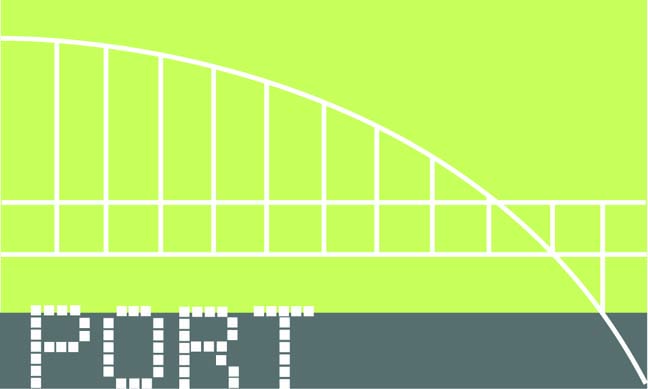
Today is the 5th anniversary of PORT: portlandart.net and I'd like to use the occasion to draw attention to all of the excellent writers who have helped make this ground breaking publication what it is. PORT is much less a business (barely a business) and more of a community service as a venue for cogent, decisive information and critical discussion. With over 135,000 unique readers in April alone the site is infinitely more popular than we ever imagined it would be when Jennifer Armbrust, Katherine Bovee and I started it back in 2005. With notice from Art in America, The Walker, Andy Warhol Foundation and The Whitney... PORT is arguably the most influential art publication in the history of the Pacific Northwest. It's been pivotal in the discussion of the I-5 and Willamette Bridges, new art groups that suddenly end up at the Tate Modern and even the recent Donald Judd conference/exhibition. Like any publication PORT's success puts demands on everyone, asking our institutions, other publications and galleries to step it up a notch or two... (why I shut down Organism as its mission was more narrow than PORT and my own curatorial scope had become). Somehow PORT evolves fast enough to stay at the bleeding edge of where Portland's art scene and the international art world mix (kind of like the treacherous Columbia bar). Maybe PORT stays supple because each writer is encouraged to pursue their own particular interests rather than a series of assignments? It's an approach that engenders a core-level of integrity and passionate interest since it's hardly a lucrative endeavor. Overall, we all try our best and everyone involved makes sacrifices to make it happen, so feel free to give an attaboy to any of our writers in the comments (though arts writing is inherently thankless). Check out some of what I consider to be our best posts: Arcy's groundbreaking essay on Mark Rothko's formative years in Portland Amy's Okwui Enwezor interview Jasha's review of Leon Golub's show currently on view at PAM Alex's two part interview with Inigo Manglano Ovalle, Part II is probably the best interview ever done with that artist Megan's review of Dinh Q. Le's last show Gary's recent interview with Oregon's own Adam Stennett for Disquieted Sarah's stunning photos for China Design Now Isaac's essay on the Holbein Madonna And my own Taking Full Stock of the Portland Art Scene post (yes Ill post part II this summer, as time allows). Overall, it's career defining reviews that I enjoy the most though... PORT isn't about ingratiating ourselves to the scene or heckling it from outside, we simply care about relevance, critical ideas and how the entire arts ecosystem can thrive through excellence. To put it bluntly, if there's a problem worth fixing we will do our best to point it out and if there is a moment of real excellence we will be there too... thank you readers and sponsors for counting on us. We do our best to earn that trust, without pandering (something rare in the art world). Posted by Jeff Jahn on June 01, 2010 at 12:35 | Comments (1) PermalinkFriday 05.28.10 Friday Museum Links I'll have an avalanche of reviews for you later today but till then:
The Portland Art Museum has posted some edited highlights of my talk on Anne Truitt and Dan Flavin here. Of course it doesn't get into all the details I discussed about Judd, Greenberg, Panza and Truitt herself as a kind of competing but complementary discourse but it's a nice art historical faceoff. In particular the way Truitt channeled emotional content into a so called cold style is telling. Fact was after growing up in the depression and making sacrifices as children during WWII artists like Truitt, Flavin and Judd had a keen interest in a more up front, less drama-filled contemplation of art. 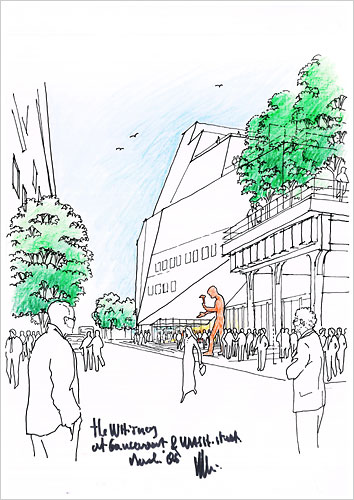 Meat Packing District Whitney Museum by Renzo Piano Well, in case you haven't heard... it's official The Whitney is moving to the Meat Packing District... so what will become of their fantastic but too small Breuer building? Looks like the Met will rent it so the can finally renovate their modern and contemporary galleries but after that? My bet is the Guggenheim or possibly some non-art museum will rent or purchase it. It is really only good for museums. The new Renzo Piano designed museum for the Whitney will put a premium on column-free space allowing a New York museum to compete or at least accommodate similar work as Tate Modern's enormous Turbine Hall. Is bigger better? Also... (more) Posted by Jeff Jahn on May 28, 2010 at 10:52 | Comments (0) PermalinkMonday 05.24.10 Monday Links Roberta Smith discusses Philippe
Halsman's technique of having his photographic subjects jump.
Walter Robinson discusses the latest Greater New York show... not an impressive show but that's to be expected. Jerry Saltz discusses Abromovic at MoMA. I've noticed that women like Abromovic and Rist are the only artists to tackle the atrium successfully... I've got a theory but I want to see a few more success stories to test it. Anyone else have a theory? Posted by Jeff Jahn on May 24, 2010 at 11:35 | Comments (0) PermalinkThursday 05.20.10 Thursday Links The Portland
Mercury's cover story on an artist's residency in a foreclosed mansion shows
the resourceful and supportive spirit of Portland's arts scene.
A photo or two of Oregon Painting Society at Tate Modern in Vogue. (scroll through) Brian Libby discusses the Rubber Stamp panel for the CRC comprised of transit insiders. Look "no design" means no bridge and I'm a longtime supporter of a bridge option. At the new MAN, Tyler reports on the Walker Art Center's cutbacks... Just goes to show that non profit endowments have not recovered. Reminds me how out front Ferriso was since PAM made its first cuts even before the recession was official (senior staff at PAM took pay cuts etc last year too). Posted by Jeff Jahn on May 20, 2010 at 10:27 | Comments (0) PermalinkTuesday 05.11.10 on art & the arts 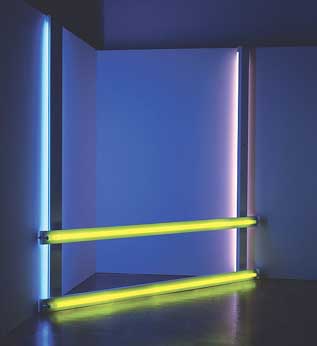 Don Flavin, "Untitled (To Donna) II," 1971 PORTstar and founder Jeff Jahn will be giving this month's artist talk at PAM. He'll be speaking on Dan Flavin's Untitled (To Donna) II and Anne Truitt's Bonne. As usual, the talk meets in the Hoffman Lobby at 6pm, then will be toured by the works by Jahn, then back in the Lobby for "happy hour" after the talk. Artist talk • 6-8pm • May 13 Portland Art Museum • 1219 SW Park • 503.226.2811  Michael Kaiser Michael Kaiser, president of the Kennedy Center, is bringing his "Arts in Crisis" tour to Portland at the Gerding Theater. In this "community conversation," Kaiser will discuss the challenges facing non-profit performing arts organizations today, including fundraising, budgeting, marketing and building effective boards. The event is free, but requires registration (here). Community conversation • 10am-12pm • May 13 Gerding Theater @ the Armory • 128 NW 11th Posted by Megan Driscoll on May 11, 2010 at 10:28 | Comments (0) PermalinkTyler Green moves to Art Info After 8.5 years Tyler
Green is moving Modern Art Notes to Art Info. Yes yes, I know Tyler drives
some people crazy with his moralizing which can border on the shrill but what I appreciate most about him is
how seriously he takes arts journalism (which is a mostly debased profession
these days). By "seriously" I mean he compartmentalizes his love of the arts and
the integrity of such, holding it on par or above journalism's pettier exploits
(i.e. careerism, petty inter-critic bitch slapping etc). If we had more Tyler's
the Barnes foundation, Rose Art Museum etc. would not be going in the integrity
shy directions they have undertaken. Frankly we need more critics in the mainstream
press, espc. ones who care about the end product as much as their careers.
What this means is I finally have to update PORT's links page for Monday (so send me your links and I'll get on it). Overall, I'm a historian (another dubious prof that's important when done well) so I'm coming at it from another angle but I think the important thing is that people like Tyler can find umbrella organizations that can pay the bills and keep serious arts writing alive. Good on yah sir. Posted by Jeff Jahn on May 11, 2010 at 10:04 | Comments (0) PermalinkMonday 05.10.10 Kimmelman plays with marbles, loses the high ground 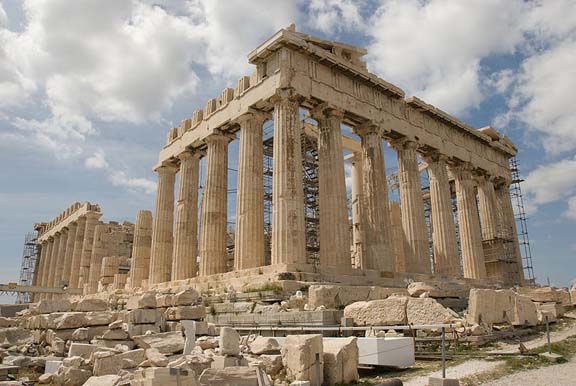 Photo: Kallistos On Sunday Michael Kimmelman penned a strange article on the disputed rights over the so called Elgin Marbles, a series of marble sculptures taken from the Parthenon to reside in the British Museum. Greece wants them back and with that country suddenly in the news it is clear this was an opportunistic story. Fine, except it's an obscuring move and a bit clubby in its complicitness with the status quo (whether it is relevant to today's shifting context or not). What's wrong with his conveniently relativistic article isn't the relativism (par for the course in museum ethics today)... it's the "convenience" of his non arguments. By hedging both sides as a kind of relativistic stalemate he's not really reporting on the issue or critiquing it for that matter (as chief art critic of the NYT's I hold him to a high standard). The comments pretty much hand it to him. My issue with the article is that the British Museum's claim on the marbles (the old "that's the way we did it then" argument) isn't gaining any additional moral strength with time, while Greece's certainly is (their history is their economy and their political glue... and quite simply they care more). Thus, barring some unforeseen prosperity for Greece in the next 100 years it's the equivalent of refusing to help ones parent's with some symbolic request. What's more the argument that since repatriating the marbles will not fully heal the wound is ridiculous... nobody makes such claims for... (more) Posted by Jeff Jahn on May 10, 2010 at 13:24 | Comments (1) PermalinkTuesday 05.04.10 Walt Curtis fire fund 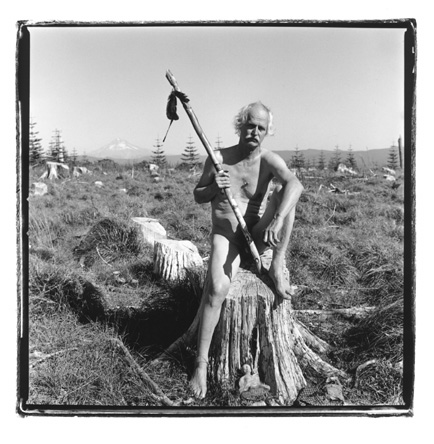 Walt Curtis According to his friend and former art dealer Mark Woolley, "Walt Curtis lost most everything Sunday in the big fire at Great NW Bookstore. Walt lost his apartment, studio, manuscripts, photos, paintings and much more. One thing he escaped with was a small painting he was working on when the fire broke out on Sunday. Other than that, he needs our help for basic necessities, housing, art supplies, some living expenses while he rebuilds some of what he lost. His spirits are pretty good and he is sporting a bit of a 'Grecian Formula' look in his beautiful hair from the smoke. Friends and supporters can help Walt by giving generously to the Walt Curtis Fund at any Wells Fargo bank.' In case you are new to Portland Walt Curtis is a fixture as a poet, painter and the author of Mala Noche. Well wishers can send notes of encouragement to: Walt Curtis, c/o Mark Woolley, 2644 NE Cesar E. Chavez Blvd., Portland, OR 97212 Posted by Jeff Jahn on May 04, 2010 at 11:28 | Comments (1) PermalinkFriday 04.30.10 Friday links and reminders Holland Cotter discusses how the Met's
weakish holdings in Picasso are actually an asset.
Portland Architecture looks at a project performing acupuncture on Portland's lil volcano Mt. Tabor. Do we really want to unblock it's chi? 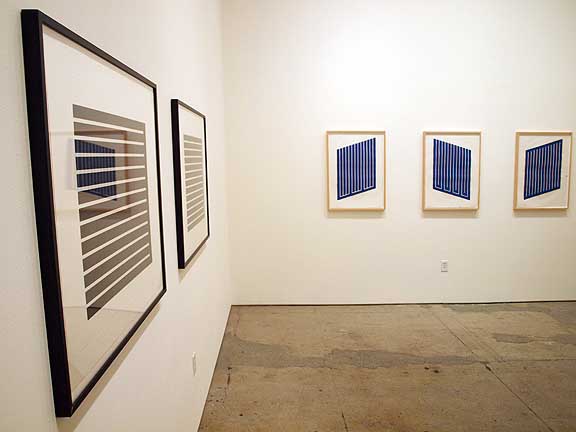
Also, tomorrow is the last day to see both Elizabeth Leach Gallery's Select Prints by Donald Judd, including some of the rare early ones the artist executed with his father along with the Judd show at the U of O in Chinatown. The Donald Judd show at the U of O's White Stag building is open till May 21st (Tues-Saturday 12-6)but Judd is one of those artists who gains additional perspective and appreciation through seeing multiple solo shows. Take advantage of the confluence. Posted by Jeff Jahn on April 30, 2010 at 10:06 | Comments (0) PermalinkTuesday 04.27.10 David Eckard: 19th Bonnie Bronson Fellow Last night David
Eckard was awarded the 19th Bonnie Bronson Award, an incredibly well deserved
choice.
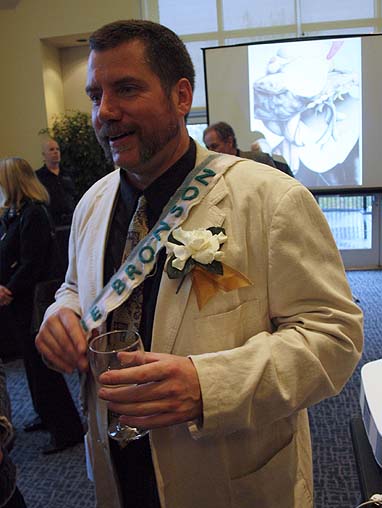
But to speak of things people seldom state publicly, somehow his choice seemed different... (more) Posted by Jeff Jahn on April 27, 2010 at 11:15 | Comments (0) PermalinkMonday 04.26.10 Discussing Panza 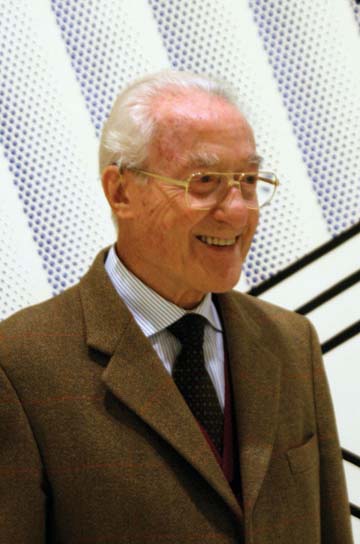
Sadly, one of the world's greatest art collectors Count Guiseppe Panza died this past weekend and Christopher Knight discusses this event from the best vantage point. As the elephant in the room, for yesterday's conference, Donald Judd Delegated Fabrication: history, practice, issues and implications the news gave Peter Ballantine a chance to speak on the rift between Judd and one of his greatest collectors. Famously Panza had some of Judd's work fabricated by his own people, Judd didn't approve of the workmanship, Panza didn't acquiesce and Judd declared it destroyed. On Sunday Ballantine was once again was caught in the middle and said that it was one of those unfortunate situations where two very strong willed individuals ran afoul of each other. Judd had gone to Italy hoping to... (more) Posted by Jeff Jahn on April 26, 2010 at 12:28 | Comments (0) PermalinkMonday 04.19.10 Catching up on Judd things Ok catching up on Judd stuff. The Donald
Judd: Delegated Fabrication Conference is this next Sunday and with Robert
Storr, Arata Isozaki, Peter Ballantine and Portland's own Bruce Guenther it
should be very exciting. It isn't just a world class event, it's a bleeding
edge discussion. Judd's fabrication has never been formally discussed like this
and with such detail. There are still a few seats available.
Today, Brian Libby interviews me in Portland Architecture about Judd's relationship to designers and architects. Also, Thursday there was a nice full page, section lead story in the Portland Tribune. . I can't think of the last time a scholarly conference got such top billing in a generalist publication? Last but not least there was the Judd Related artist panel discussion which I lead last Saturday at PNCA. It was probably the single most useful artist panel discussion Ive ever had the pleasure to take in. It was long and I feel like everyone got something usesful out of it. Here is a link to an experiential video/podcast of the event. If you just can't sit through the difficult production values here is a summary: Storm Tharp's next show is basically about his experience last year in Marfa. Judd is new to his "top ten" of favorites and he has an interesting love hate relationship to Judd's auteur-like achievement. Storm is attracted to high levels of aesthetic achievement and celebrates his hero's while expressing his own anxieties and insights into their achievement. Storm's account was very personal. Victor Maldonado, took a sociological stance on Judd. For Victor he's part of this received American history to be contended with and called him a Coyote... an operator who is both wise and dangerous. Judd's decision to locate himself in Marfa near the Mexican border became a somewhat politicized choice. Laura Fritz, in a dry, somewhat Juddian delivery (that's just her) simply described elements of her work and a key Judd work at the Des Moines Art Center that introduced her to installation art. Interestingly, she felt her the video element of Evident related to Judd's way of straining the perceivable world through manifold space like Judd. She also emphasized the importance of rigorous editing rather than simplicity for its own sake. Arcy, discussed Judd and the problem of choice and has done a post on his talk last Saturday on the Judd Conference blog. Essentially, Douglass is a systems artist and shares that with Judd, though I believe he's more influenced by Carl Andre than Judd. Anna Gray and Ryan Paulsen, discussed the way Judd inserted himself into the discourse and the artistic violence of contending with Judd. They are primarily influenced by Judd's writings rather than his systems, aesthetics, sociology or achievement. This somewhat retraces what the next generation of conceptual artists after Judd did but its really interesting that these young artists are still dealing with the the same issues in an updated current way... (more) Posted by Jeff Jahn on April 19, 2010 at 12:06 | Comments (0) PermalinkTuesday 04.13.10 Judd Conference announces Arata Isozaki 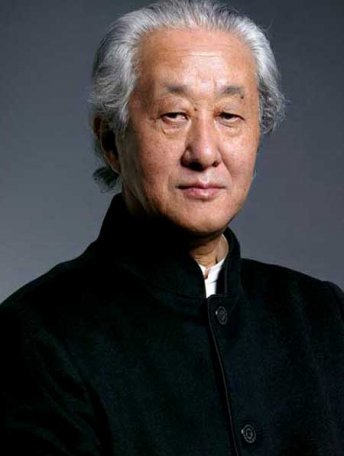
We are honored and pleased to announce that renowned Japanese Master Architect and philosopherArata Isozaki will join the distinguished panel speaking at the Donald Judd Conference: Donald Judd Delegated Fabrication at UO in Portland on April 25! Arata Isozaki is recognized internationally as a significant, avant garde architect and has designed notable buildings in Asia, Europe and the United States. His work includes Gumma Prefectural Museum of Modern Art in Takasaki City, Japan, the Museum of Contemporary Art (MOCA) in Los Angeles, and the Olympic Stadium in Barcelona, Spain and more recently the Weil Medical clinic in Quatar. Along with Isozaki, the other panelists include:... (more) Posted by Jeff Jahn on April 13, 2010 at 21:00 | Comments (0) PermalinkPAM announces new photography curator Julia Dolan, formerly Horace W. Goldsmith Curatorial Fellow in Photography at the Philadelphia Museum of Art, will join the Portland Art Museum this June as curator of photography.
Posted by Megan Driscoll on April 13, 2010 at 12:38 | Comments (0) PermalinkTuesday 03.30.10 OPS goes to London to celebrate the Tate's 10th Anniversary 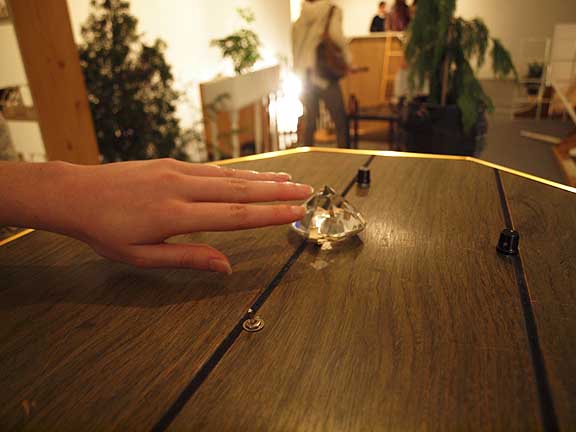 OPS installation at PSU Autzen Gallery December 2009 (photo Jeff Jahn) Here is news of an exciting development for the Oregon Painting Society, which got PORT's attention in 2008. Then they brought it all together OPS hit it out of the park in one of 2009's best shows. Now they are going to Tate Modern's immense Turbine Hall. Which is to say, game on and well done, told yah they were onto something (despite being a bit overexposed in Portland recently). This is one dynamic art scene. According to the press release "OPS have been invited by NYC based curator Cecilia Alemani to participate in No Soul for Sale: A Festival of Independents as part of the museum’s 10th anniversary celebration. The three-day festival of art collectives and innovative arts organizations will draw 50 participants from around the globe including Portland’s very own OPS. The group will create an interactive installation on the floor of the Tate’s Turbine Hall and will present a new performance on the hall’s main stage. The festival is expected to draw 50,000 visitors." No Soul for Sale: A Festival of Independents will take place May 14th-16th, 2010 Posted by Jeff Jahn on March 30, 2010 at 19:42 | Comments (0) PermalinkTuesday Links Over at Artnet Ben Davis discusses Jessica
Jackson Hutchins breakout at the Whitney Biennial. I like Hutchins
work of course but feel she has a ways to go before growing beyond her current
Kienholtz meets Franz West filtered through Voulkos and George Ohr charm and
really hits on something major and completely her own. The thing is, from our
talks I definitely feel she has it in her and I particularly like the fact she
isn't terribly self-satisfied (a disease amongst young artists today).
Lisa Radon catches Richard Flood talking about something he knows nothing about, blogs, facebook etc. Personally, I avoided the talk because I feared he might say something like this (Portland is one of the most tech and word savvy cities on earth so I figured it was covered and I could do something productive). Honestly, I hope the New Museum can turn things around because right now it seems to be undergoing death by a thousand cuts in the court of critical opinion. No institution with new in its name and mission statement can afford such repeated stumbling. I disagree with the muckraking critiques too... instead, the real issue is the lack of curatorial compass the institution seems to have (not the less than pretty sausage making process that trustees and museum's must undergo). I could care less about the collector and Koons involvement other than they seem so poorly tuned to the times. So far the NuMu has had one critical slam dunk, Unmonumental. They need a few more so they can outflank the Whitney and other institutions by doing serious and eye opening solo shows that nobody else has done (or seen coming). Right now the NuMu looks like a lone figure swatting at a swarm of bees. Jerry Saltz answers Flood here. And Seattle chimes in too, I love the fact that Seattle is the most sarcastic city in the USA and the Stranger is ground zero. Posted by Jeff Jahn on March 30, 2010 at 11:02 | Comments (0) PermalinkWednesday 03.24.10 Wednesday Links The New York Times reports on an innovative homeless
shelter in Portland designed by Holst Architecture (who most notably completed
the new Ziba
World Headquarters).
A lil bit ago Jerry Saltz remembered the Dia in Chelsea... can this new version really recapture Dia's role as a "key ally" or patron for challenging art? Even the the Mayor's office is blogging about the Judd Conference in Portland next month... registration has been strong these first 2 weeks. BTW the exhibition's open reception will take place in the middle of the conference on the 25th. The Guardian looks at Jean Nouvel, who for the last few years has been the hottest architect on Earth (deservedly so, but I like Toyo Ito even better). Posted by Jeff Jahn on March 24, 2010 at 10:39 | Comments (0) PermalinkSunday 03.21.10 Last chance for Judd Conference early registration 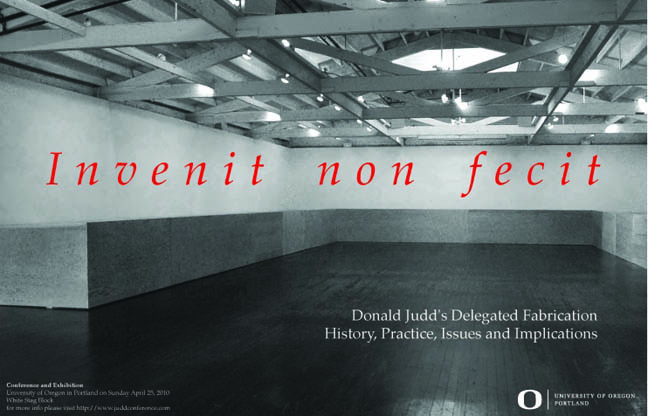 Poster for Judd Conference featuring image of Judd's 1974 piece at the PCVA (photo Maryanne Caruthers) Just a reminder you still have a little over 24 hours to take advantage of the Judd Conference's early registration discount (by the end of Monday March 22nd). This isn't some dull lecture but an opportunity to take part in an important and inspiring historic discussion. Instead, it will be an intensive, hyperfocused and scholarly discussion of one of Judd's most important contributions to contemporary art his delegated fabrication (which is intimately tied into and expresses the philosophical underpinnings of Judd's art). Arcy discusses these issues a little more here on the Judd Conference blog. Overall, it is a great time to come to Portland, with 2 Judd exhibitions up (in conjunction with the conference I'm curating one at the U of O's White Stag building and Elizabeth Leach Gallery is presenting a Judd print show) the ongoing Disquieted, Cy Twombly and Leon Golub shows at PAM, Scarecrow at Reed (featuring documentation video of many famous performance art pieces) and many other Judd related shows + PICA's TADA party ... the weekend of April 25th will be an excellent weekend to visit Portland's ever-active art scene. Posted by Jeff Jahn on March 21, 2010 at 18:50 | Comments (0) PermalinkThursday 03.11.10 Suggested reading The Judd
Conference now has its
own blog and Arcy has laid out a very
helpful reading list with links. Remember to register early, the cost goes
up after March 22nd and space is limited. If you are an installation artist,
designer or architect this event will be of capital interest.
Todd Eberle is doing some fine blogging and always great photos on Marina Abramovic's latest. Nicolai Ouroussoff's fascinating article on Claude Parent is definitely worth a read, contextualizing the architect who has influenced younger designers like Jean Nouvel and Rem Koolhaas. Call him the father of the current strain of counterintuitive (yet good) architecture. Tyler Green contemplates the ethical legacy of curator Edward Fry in the Gugg's new Contemplating the Void exhibition. The WWeek reviews the Blakely Dadsen show at Chambers. Posted by Jeff Jahn on March 11, 2010 at 11:20 | Comments (0) PermalinkFriday 03.05.10 NYC roundup Roberta Smith lays it all out in a matter of fact way regarding the
Koons curated New Museum show, Skin Fruit. To me it seems like a show calibrated
for 2007 and people are going to hold the New Museum to higher standards because
of the mission statement and presence of "New" in its name. The problem isn't
Koons or the collector, it's the fact that the New Museum can't really afford
to be behind the curve the way other New York Museums are... or even behind the those other
institutions for that matter. Everyone wants the New Museum to be bleeding edge,
but it isn't. Perhaps large group shows are simply the wrong way.
It's part of the reason PORT didn't get all Whitney-excited (even if several Portland friends are in it and the Museum linked to several of our articles). To me its like a cliff notes version of the art world and this iteration's focus on being conveniently self-conscious felt dated (anyone remember 2002?). Also,why must they always have a car or other wheeled vehicle in each version? Overall, the Whitney can get away with being a little behind the curve, in fact I think that is part of being a venerated museum and its a valuable way to intersect with those who are not 100% art world creatures. Honestly, Id like to see Museums put on more small group shows 3-5 artists... politically that's a rats nest to navigate as a curator but that is what these times require. Will the Portland Art Museum's CNAA's be up to that challenge regionally? Balancing politics and freshness is difficult for large institutions. The NYT's also did a piece on the Armory, a confab which in my mind has somewhat overshadowed the Whitney Biennial.... even in this diminished economic climate. PORT's award winning Amy Bernstein will have a report soon. Posted by Jeff Jahn on March 05, 2010 at 14:46 | Comments (0) PermalinkThursday 03.04.10 Major Annoucement, Judd Conference and Exhibition in Portland  Poster for Judd Conference featuring image of Judd's 1974 piece at the PCVA (photo Maryanne Caruthers) The University of Oregon School of Architecture and Allied Arts and PORT are pleased to announce what promises to be a major highlight of Portland's 2010 cultural calendar; a scholarly conference and exhibition, "Donald Judd: Delegated Fabrication; history, practices, issues and implications" on April 25th 2010. With keynote speaker Robert Storr and other notables like Peter Ballantine, this promises to be a conference where Judd's most radical artistic contributions are examined and discussed. Space will be limited to encourage discussion so this wont be one of those static lecture and listen style events. Furthermore, I'll be curating the exhibition Donald Judd, which will support and encourage the conferences discussion, it opens on conference day and runs through May 21st at the U of O's White Box gallery in Portland. The event is sponsored by the University of Oregon's School of Architecture and Allied Arts, PORT and through the generous patron support of Bonnie Serkin and Will Emery. Official Website for registration $65 early registration (through March 22) $35 students Sunday, April 25, 2010 University of Oregon in Portland White Stag Block 70 NW Couch Street, Portland, OR 97209 ...(more) Posted by Jeff Jahn on March 04, 2010 at 13:35 | Comments (1) PermalinkFriday 02.12.10 Laura Russo Portland Gallerist 1944-2010 Before I moved to Portland, just over a decade ago I was most familiar with one
gallery, Laura Russo's… mostly through
her association with Mel Katz, Robert Colescott and Gregory Grenon. They were
the only Portland connected artists I was aware of from Midwest.

A lot has already been said about her sad passing too soon... a process that will continue for a long time to come, but as I type this (several thousand miles from Portland) I feel certain of her influence. She mattered so much to so many, but I'd like to state something specific and personal on why... and maybe how we can all be better when we discuss art in Portland as a large part of her legacy. ...(more) Posted by Jeff Jahn on February 12, 2010 at 22:49 | Comments (1) PermalinkWednesday 02.03.10 Portland2010 Biennial artists announced Eighteen Oregon visual and performance-based artists have been selected to present a series of one-person exhibitions at for the Portland2010 biennial at; The Art Gym, Disjecta, Rock's Box, Alpern Gallery, IFCC and The Elizabeth Leach Gallery starting March 13th.
It's a solid list... maybe too solid since many will complain the majority are already well known, omnipresent or alumni from the now discontinued Oregon Biennials at PAM. The well deserved Crystal Schenk and Ditch Projects are the only riskier new names in the list, the other inclusions just gives us an opportunity to revisit some of our favorite artists. Question is, is that enough? Portland currently is in the midst of a strong new wave of new talent that can't be found here. Curator (and PORT pal) Cris Moss considered 300 artists and will include the following in Portland2010: ...(more) Posted by Jeff Jahn on February 03, 2010 at 14:12 | Comments (6) PermalinkMonday 02.01.10 Sharing the New York Times for now It's only a matter of time before the New York Times makes unlimited content available
only to subscribers, so enjoy it while it lasts. (I consider this a bad idea, it's why
all of PORT's content is Creative
Commons)
Holland Cotter reviews the choreography of Tino Sehgal at the Guggenheim. Nocolai Ouroussoff reviews three classic films about recent starchitecture. Then there is their art in review section with reviews of John McLauchlan, Joel Shapiro and Christian Holstad. I tend to read The Times in newsprint at coffee shops, partially because I don't ever want a hard-copy newspaper subscription again... which constantly reminds me just how much paper recycling such a choice results in. At the same time pay to play subscriptions ultimately keep newspaper content more cloistered and won't be shared as much. Overall, the competition for our attention and sharing of content was what made newspapers work. Granted most newspapers now are filled with such drivel we don't read them, even when free... but the times is still worthwhile. I get 95% of my information off the web and from links emailed to me and taking the New York Times from that mix seems short sighted. Information is ultimately only valuable if it can be shared. People will simply turn someplace else and I'm not certain that a deal with Apple for their devices will solve the problem either. Posted by Jeff Jahn on February 01, 2010 at 12:17 | Comments (1) PermalinkThursday 01.28.10 Destroy your art British artist Michael Landy has created a project where
artists can destroy their unwanted art called, "Art Bin." Damien
Hirst and Tracey Emin have already contributed. It reminds me that Picasso once famously stated, "All acts of creation are acts of destruction."
Posted by Jeff Jahn on January 28, 2010 at 11:09 | Comments (2) PermalinkWednesday 01.27.10 Cy Twombly at PAM 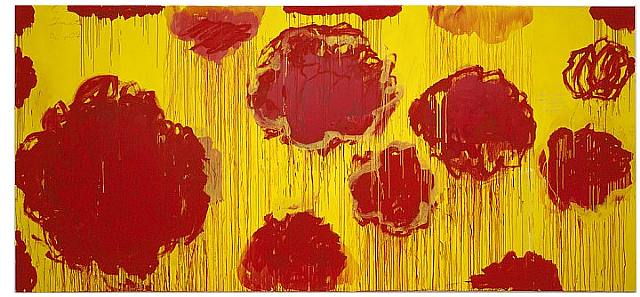
Cy Twombly's Untitled (from his recent Blossoming series) Lately, I have been concerned because the Miller-Meigs series space at the Portland Art Museum has not been programmed with one of its typically excellent solo shows... but all that has changed. On February 6th Cy Twombly will fill the space with two massive paintings and one of his sculptures. Twombly is one of the world's greatest living painters and curator Bruce Guenther has once again outdone himself bringing these recent works here. February 6 - May 16 2010 Portland Art Museum 4th floor, Jubitz Center for Modern and Contemporary Art Posted by Jeff Jahn on January 27, 2010 at 9:55 | Comments (0) PermalinkMonday 01.18.10 Farewell Fontanelle 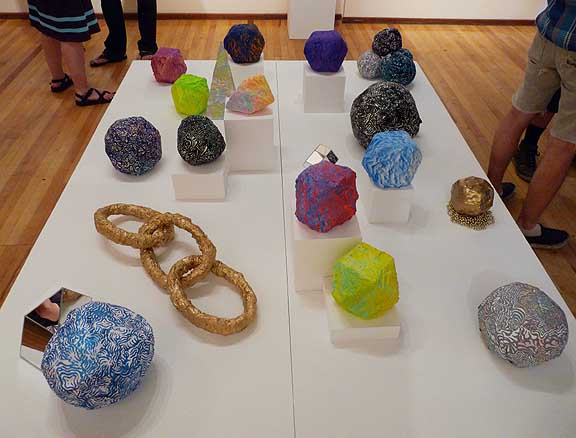 Joshua Orion Kermiet and Midori Hirose Sadly, Fontanelle, one of Portland's most beloved semi-alternative spaces, is closing. They've gotten a lot of love here at PORT in the brief year and a half they've been open: The Joshua Orion Kermiet and Midori Hirosi show was reviewed this summer, and then won Best Group Show of 2009 in our readers' poll. The exhibition Queer Gaze got noted this fall. The Oregon Painting Society at Fontanelle was reviewed a year ago. Not to mention all the calendar notes and picks lists. Thanks Leslie & Jess for some great programming and a wonderful use of that space, which has formerly housed Elizabeth Leach and Chambers. (So who's next?) Fontanelle will be hosting a closing party this weekend featuring DJ Party Martyr and the sale of the Fontanelle: Year One book. It'll also be your last chance to see Julianna Bright's Our Songs of Experience (you can also contact the gallery to make an appointment to see it this week). Farewell party • 7-9pm • January 22 Fontanelle • 205 SW Pine • 503.274.7668 Posted by Megan Driscoll on January 18, 2010 at 9:58 | Comments (1) PermalinkFriday 01.15.10 Friday links PORT will have several reviews and our exhaustive 2009 roundup next week.
Till then NY1 has a nice article and great video on MK Guth's latest show in New York City. Sometime guest PORT contributor Bean Gilsdorf has an interview with Storm Tharp on Daily Serving. Posted by Jeff Jahn on January 15, 2010 at 13:11 | Comments (0) PermalinkTuesday 01.12.10 More Deitching 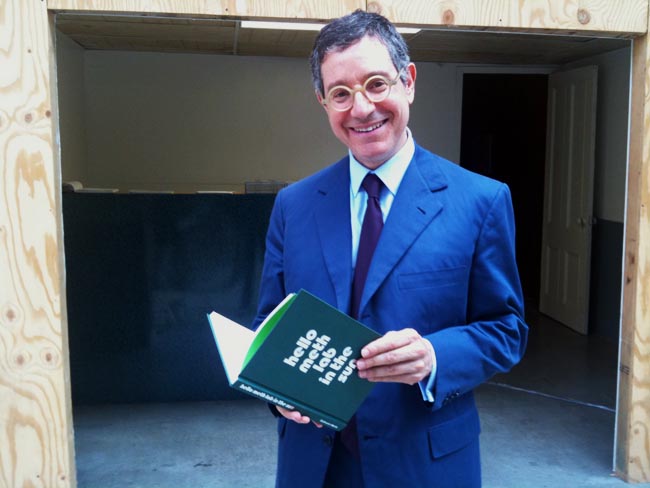 Jeffrey Deitch, MOCA's new Director In case you've missed it, you definitely need to read Tyler Green's 3 part interview with Jeffrey Deitch, MOCA's new director. Tyler does a good job of renewing my faith in "journalism" here and Deitch certainly sounds like your typical museum director so I'm not certain why some people find the choice so strange. Look, if JD lets Jeff Koons start to curate I'll certainly do my best to fricassee him but till then I ain't gonna go all Yosemite Sam... like some are till he actually does something. Tyler asks the right questions, Deitch gave the right answers... a totally predictable art world moment where everyone does as they should. Christopher Knight's article today also shows a higher level of skepticism. It's a good reminder that Deitch has to earn his way in LA... that's actually a good thing for Deitch since LACMA's Govan came with such a great reputation, which has been somewhat tarnished in his time in LA. LA isn't like anywhere else and Deitch really needs to build a stronger foundation for the institution. I did find Roberta Smith's article weird though... with its focus not so much that LA is gaining a new director it's that New York is losing one of its best dealers??? sheeesh... (more) Posted by Jeff Jahn on January 12, 2010 at 11:43 | Comments (0) PermalinkMonday 01.11.10 Rumors confirmed: MOCA names Deitch 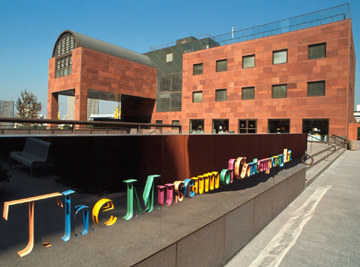
In case you haven't heard, Jeffrey Deitch was named the new Director of MOCA today and I think Jerry Saltz had the best summation of the news. Some will find it odd that a former art dealer will cross the imaginary line between the dealer and director worlds but frankly I think this is a very isolated incident (there just aren't many Jeffrey Deitches out there). MOCA already has the best programming of any major contemporary/modern art museum but what it needs is better support. Deitch got the job because (on paper) he can deliver... maybe even redirect a tiny bit of Hollywood's money away from the development of extremely stupid films towards one of LA's most important cultural contributions. This "support" has been LA's biggest cultural problem and recruiting a serious, very intelligent ultra-insider like Deitch will only work if his fund raising efforts to "make it rain" in LA are successful (just a little). *Update: Tyler Green just published some his responses to the responses... all valid points of course. This wait and see approach is... (more) Posted by Jeff Jahn on January 11, 2010 at 11:58 | Comments (0) PermalinkTuesday 01.05.10 Kenneth Noland 1924-2010 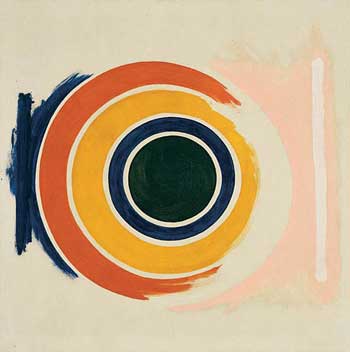
Kenneth Noland's No 1, 1958 (Clement Greenberg Collection Portland Art Museum) "A major artist has died. Kenneth Noland was a central figure in the Color Field movement and an artist who inherited the mantle of Josef Albers as America's reigning colorist. A Greenbergian formalist who made color a physical thing as well as a fleeting optical experience. The Museum is fortunate to have his first Target painting on view and some twenty-five works in its permanent collection." -Bruce Guenther, Chief Curator Portland Art Museum Also,Roberta Smith writes about the passing of Kenneth Noland at age 85. Portland has a particular connection to the preeminent color field painter... (more) Posted by Jeff Jahn on January 05, 2010 at 13:33 | Comments (0) PermalinkListing lists as redundantly as possible PORT always takes its time with our official "best of" list and because we kicking
off this our 5th year with a staff exhibition in the Pearl District (Re: PORT) we aren't going to break any records.
Here's Tyler Green's best of list for 2009 you can compare it to Christopher Knight's list published last month. Jerry Saltz has picked his shows of the decade. If I wanted to make a similar list, Robert Irwin's Primaries and Secondaries would top the charts and Matthew Barney wouldn't come close. My favorite non-Portland shows of 2009 would be: Mike Kelley and Michael Smith at Sculpture Center and Kandinsky at the Guggenheim. If I had seen Francis Bacon at the Met I'm certain that would make the list too. What is notable is show's I wouldn't include... like Martin Kippenberger at MoMA. Fact is, most of my favorite viewing experiences of 2009 were in Marfa and land art scattered throughout the Desert Southwest or a about 3-5 shows in Portland that were easily better than most of the solo shows elsewhere. This isn't favoritism I just feel like some of the shows from Portland in 2009 were that good. I'll have that list done ASAP (hopefully Wednesday). Posted by Jeff Jahn on January 05, 2010 at 13:02 | Comments (0) PermalinkWednesday 12.30.09 2009 PORT Readers Survey The results of our first ever Portland art scene reader's poll are in and it
definitely confirms that 2009 was an extremely interesting and active year.
Overall, these things tend to favor young emerging artists whose social networks
(formed in art school) tend to rally round popularity contests like this. Still,
it's a worthwhile exercise and the results do reflect quality as well as popularity.
In some cases the margins were so overwhelming that it forms a kind of art scene
consensus.
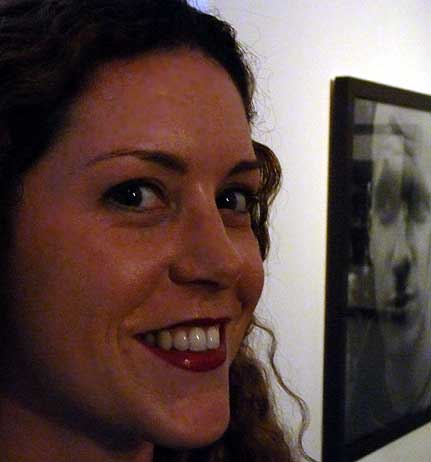 Ruth Ann Brown Art Scene MVP 2009: With a commanding majority of 68.2% of the votes Ruth Ann Brown ran away with this category. Her successful Couture Series at NAAU channeled and funded one of the scene's biggest strengths, installation art. I guessed this would be the result but the voting margins were even more heavily stacked than expected. Sure there were lots of write ins and grumblings about this category but facts were 2009 was RAB's year. ...(more) Posted by Jeff Jahn on December 30, 2009 at 19:32 | Comments (0) PermalinkTuesday 12.29.09 Last 24 hours for PORT's 2009 readers survey Ok, I'll shut down the polls and tally the results at noon tomorrow so you have less than 24 hours to get in your final votes. It is an entertaining series of horse races now.
Will it be Jordan Tull or Midori Hirosi? Can Hirosi and Kermiet beat out PAM's China Design Now? Will it be Ethan Rose or Oregon Painting Society? What is wrong with a world where Tim Dalbow trails Patrick Rock for fashion? (neither is currently in the lead) Then there is the race between Rock's Box and Gallery Homeland. Lastly, the Portland Art Museum, Art Gym and Cooley Gallery are all currently in a three way tie for third place. There is still time for a big come from behind victory. Posted by Jeff Jahn on December 29, 2009 at 12:14 | Comments (0) PermalinkMonday 12.28.09 Looking back at PORT posts in 2009 I think 2009 was PORT's most in-depth year to date and though traffic isn't
our primary concern our most detailed and critical articles tended to be our most popular...
it is why PORT is less like a typical blog or newspaper (which favor; money, scandal and generally ingratiating oneself to the scene) and more like a critical journal
or ongoing symposia. In other words, we are primarily interested in comparing ideas, execution and history.
By far, Amy's April interview with Okwui Enwezor was the most popular piece on PORT in 2009. Even now it gets over 1000 readers a day. Other consistently high traffic posts from 2009 were (in no particular order): Arcy's excellent research into Mark Rothko's crucial Portland years was an important post, gathering scholarly interest at the very highest levels. In April, I posed a piquant question regarding which discipline is working with the most interesting spatial ideas, installation art or architecture? Alex's excellent interview with the V&A's Glen Adamason even featured some nice iphone images of Adamson's personal collection. Ziba gave us an early tour of their new HQ, and we gave the world their first look at the Holst designed space. You saw it on PORT first. ...(much more) Posted by Jeff Jahn on December 28, 2009 at 12:06 | Comments (0) PermalinkSaturday 12.26.09 Major exhibition announcements from PAM 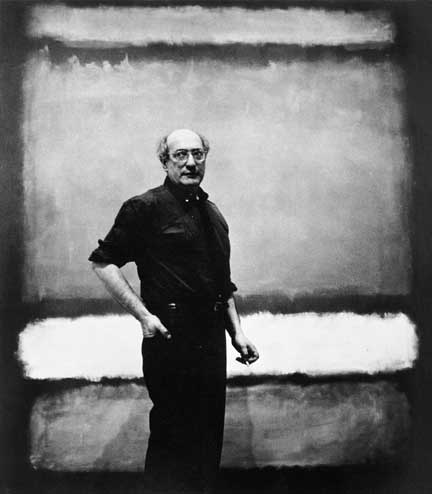 Mark Rothko, 1961 © 1998 Kate Rothko Prizel & Christopher Rothko / VG Bild Kunst, Bonn 2008 The Portland Art Museum has just announced their major exhibitions for the next two years. The most important announcements are the second Contemporary Northwest Art awards in 2011 and Rothko in 2012. Finally, Portland hosts a homecoming for its most famous son, Mark Rothko. It is a critical acknowledgment that is LONG overdue. As part of Portland's cultural contribution to world history it is arguably the most important show to hit PAM since the Armory (or Rothko's own solo show in 1933)... (more details) Posted by Jeff Jahn on December 26, 2009 at 12:25 | Comments (0) PermalinkTuesday 12.22.09 2009 survey update PORT's 2009 Portland art scene survey has been popular and still has over a week to go. Honestly, these things are in large part popularity contests and tend to be busiest amongst emerging artists whose social networks get activated... yet there is quality apparent here.
For instance both Oregon Painting Society's Radiant Dream Face at PSU and Joshua Orion Kermiet & Midori Hirosi are both currently in the leads for solo and group show of the year, respectively. It might seem trite but having relatively new names like Ethan Rose, OPS, Midori Hirosi, Jordan Tull and Damien Gilley all vying for leads in their respective categories bespeaks just how interesting a year 2009 was and how active the scene is. PORT will also do our much less democratic critic's picks before the end of the year. Posted by Jeff Jahn on December 22, 2009 at 11:54 | Comments (0) PermalinkFriday 12.18.09 What a pair! Roberta Smith discusses Bruce
Nauman's latest installations in Philadelphia.
Glass Tire discusses the "kinetics" of Susan Rothenberg... I believe this interest in what I call "existential kinesthetics" is part of this couple's connection. Posted by Jeff Jahn on December 18, 2009 at 12:26 | Comments (0) PermalinkWednesday 12.16.09 PORT 2009 reader's survey 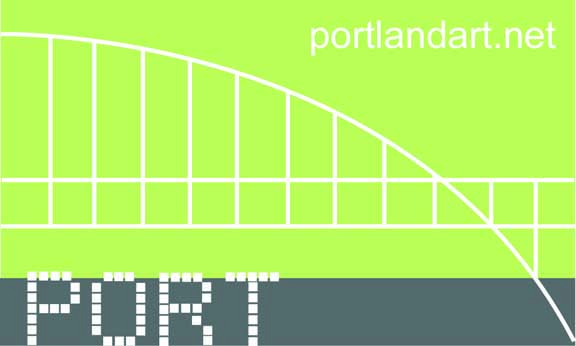
Well, the year is almost at a close and for 2009 we thought it would be nice to create a reader's survey for their favorite Portland shows and personalities". Results will be tallied on December 30th and I've set up most of the categories so you can make multiple selections and write in anything I didn't already include. Posted by Jeff Jahn on December 16, 2009 at 15:13 | Comments (2) PermalinkMuseum hairdos & don'ts 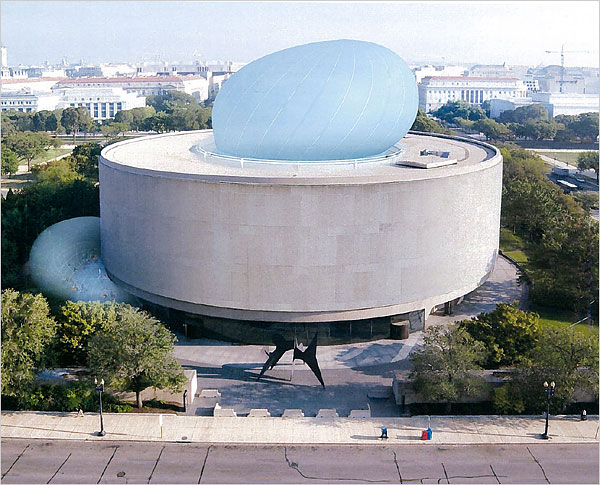
The proposed Diller Scofidio + Renfro addition to the Hirschhorn is an interesting move but some of the rhetoric around it like needing "a dome" to be taken serious in DC is intentionally hilarious (is that a good idea?). Tyler Green has a lot to say about this bulbous addition that reminds me of Olive Oyl's hair. It is interesting and it's temporary but is that really the best move? Promoting dialog through defacto public sculpture is fine but this temporary structure seems noncommittal in relation to it's proclaimed goals. (BTW, I really regret not being able to see this Truitt show at the Hirschhorn. In a related story last week the NYT's did this story on bigger not necessarily being better for museums. It's true, a museum is judged mostly by the quality of its collection and its program. The trick is to meet the needs of the community in terms of making top quality work outside of private collections and activating discussion around it. Generally Portland institutions like PAM and PNCA are not guilty of grandstanding via their physical space. Instead, expansions at PAM , OCAC and PNCA have been programmatically driven... mostly by the fact that artists and arts minded people continue to find Portland an attractive place to live. That said, Portland is generally still underserved by institutions. Posted by Jeff Jahn on December 16, 2009 at 11:58 | Comments (0) PermalinkThursday 12.10.09 Tharp and Hutchins in the Whitney Congratulations to both Storm Tharp and Jessica Jackson Hutchins who will take part in the 2010 Whitney Biennial curated by Francesco Bonami and Gary Carrion-Murayari.
For more information check out PORT's in depth interview with Storm Tharp and my review of his breakout show in 2007. For Jessica Jackson Hutchins check out my review of her show in 2008. After having Portland artists represented in 4 of the last 5 biennials it is telling that new top level talent can be found here whenever people look. Yes, there is that much going on here. Posted by Jeff Jahn on December 10, 2009 at 19:38 | Comments (0) PermalinkMonday 12.07.09 Monday Links The NYT's has found a new darling from which to lens the art world, William
Powhida. This month's article looks at the Art Basel Miami Beach art fair.
On Artnet Donald Kuspit looks at the Bauhaus. In the Gaurdian Adrian Searle takes a look at the last decade and grimaces. Christopher Knight takes yet another look at the continuing Barnes "disembowelment". Posted by Jeff Jahn on December 07, 2009 at 9:54 | Comments (0) PermalinkTuesday 12.01.09 Andy thanks Amy, congratulations! 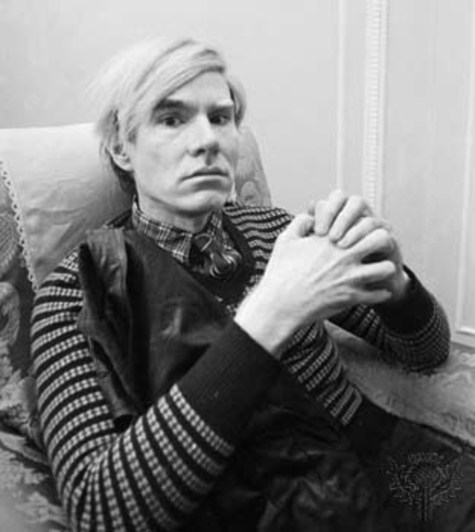
Congratulations to PORT's Amy Bernstein, one of this years' Warhol Foundation Arts Writer's Grant program winners. Amy always brings incredible depth, poetic sensitivity and an admirable sense of responsibility to her reviews and interviews, which you can check out here. To get a sense of her work, here is her impressive interview with Okwui Enwezor and her most recent review of Broadcast at Lewis and Clark College. She could have transcribed just a couple thousand words of the Enwezor interview but I remember discussing it with her and she felt very strongly that he really had something to say and should be able to say it in full detail. That's what Amy brings. It is amusing though that PORT doesn't qualify as a blog ...but it's telling too. Congratulations also to two other area writers, John Motley and the Stranger's Jen Graves... arts writing is often difficult, thankless and rarely pays much. I know about a third of the grantees and it is an impressive group, looks like Creative Time has made adjustment from the experience of previous cycles. Posted by Jeff Jahn on December 01, 2009 at 21:03 | Comments (2) PermalinkWednesday 11.25.09 Wednesday Links I'll have a series of reviews for you later today but for now:
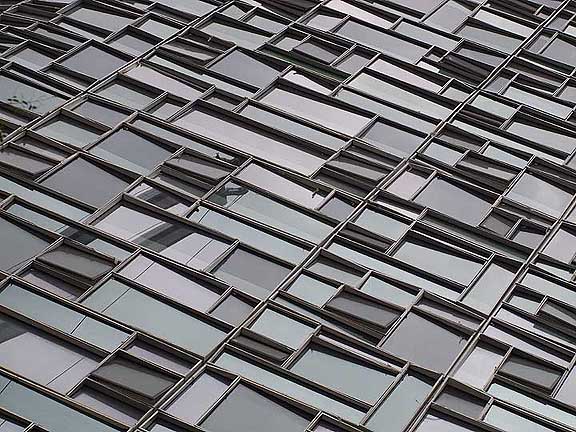 detail of Jean Nouvel's Vision Machine photo: Jeff Jahn The New Yorker's Paul Goldberger takes a look at architect Jean Nouvel's career. I like his work as it often has a harsh beauty. Randy Kennedy reports on the impact of the recession on artists in the NYT's. Ahh and in anticipation of Miami (remember when it was all important?) here's artnet's pictorial on Art Toronto. In a strange way it is reassuring that these art fairs still exist... many Portland galleries still participate (though not as many as before but the ones who do have moved up in the fair hierarchy). Posted by Jeff Jahn on November 25, 2009 at 9:55 | Comments (0) PermalinkMonday 11.16.09 Strange bedfellows these days: legitimacy and money Jerry
Saltz has written his response to the whole New Museum debacle (which strangely
became legitimized last week with the New York Times Article, though it was
Tyler
Green and William Powhida who really started the debate, Green was cited
as being, "notoriously self righteous," by the Times). More like notoriously
ten steps ahead of the New York Times. Anyhow, I see both Jerry and Tyler's
arguments but in this case Tyler is notoriously right and scrupulous.
The problem isn't the fact that this is going on in an economic freefall, it is that this looks like pre-crash business as usual when everyone wants the New Museum to do something legitimately new. Whereas, Koons and Urs Fischer are poster children for the excesses of the past 9 years in the art world, frankly it's anything but New. I like both artists but when the word NEW is in your name you need to be careful you deliver what the name promises. The art world has been looking for a lightning rod for change, a signpost that something fresh was coming and when the New Museum foisted their petard up the flagpole they got zapped. How about a post boom artist or someone the post boom artists can look to? An Iza Genzken or Lynda Benglis curated show would have gone over much better than Koons and followed through on Unmonumental's success as an opener (so far nothing has equaled their opening show... that's a problem). I believe artist curated shows might be the answer for the New Museum but the trick is they have to be by someone who isn't synonymous with lucre when things are being stripped back to basics. The New Museum is being held to new standards because everyone wants them to be successful in revitalizing New York's art scene (in a qualitative not the same old quantitative $$$ way)... hopefully that haven't completely jumped the shark and can contrast Koons/Fischer with something much fresher after this bit of shortsightedness. 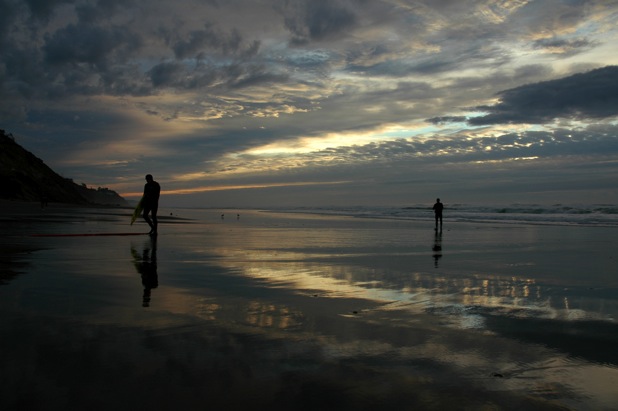 Photo by Sarah Henderson The Find, Claiming Nelscott Reef is an independent film opening this week about Oregon big wave surfing and the absurdities surrounding ownership of said wave. Not your typical surf porn it looks fascinating and you can catch the premier at the Hollywood theater on Wednesday at 7:00 PM. PORTstar Sarah Henderson is the co-producer. For more info here is an interview with the director Erich Lyttle from last night. Posted by Jeff Jahn on November 16, 2009 at 10:59 | Comments (0) PermalinkMonday 11.09.09 Catching up with last week Last week Modou
Dieng interviewed me on Radio PNCA... you can listen to the archive here if you
missed it. We discuss Portland, curation, PORT and follow-through. Sounds like
the mp3 file was ripped a little too hot so there is slight distortion but it's
listenable.
Jerry Saltz takes on Urs Fischer at the New Museum here... frankly I'm underwhelmed. He's decent but too much of a stunt artist. Besides, the more I look at his work the less intelligent and more spectacle driven it seems. Fischer seems aware of this flaw in his work as he tried to downplay that aspect for this retrospective so its not as "showy" as his solo shows have frequently been. Let's just say there demand for Kippenberger-ish art and grand gestures and Fischer attempts to fill that void... but can't help but fail (really it is the Rauschenberg void). Posted by Jeff Jahn on November 09, 2009 at 14:45 | Comments (0) PermalinkFriday 11.06.09 The Dia that refuses to die links The Big news today is that the Dia
is returning to Chelsea, the NYT's Carol Vogel has the story. Looks like
the Dia is trying to recapture it's legendary role as institutional patron of
difficult, inconvenient art. I.E. the best kind of art. In the past year I've
visited Dia Beacon, Spiral Jetty, the Earth Room, and the Lightning Field etc. None of these would have been possible without the Dia but
when they left Chelsea they abandoned experimentation in New York City... which
was unacceptable.
I love the fact that new director Philippe Vergne is going to focus on programming, not museum style bling. At that we have to ask, "how great will that programming be?" It's a tall order. Dia's legacy would make anybody except maybe Walter Hopps a little shy about comparisons with the past. Can they actually back truly great artists like they did in the past or is it going to be another checklist of international art stars weve already seen and mostly found wanting when compared to Serra's Torqued Ellipses and Walter De Maria's Lightning Field? It's a huge gamble but like days of yore they need to back a few wildly original artists who have been too inconvenient for proper attention during the mostly market driven decade. Note Vogel's article also mentions that a long awaited Donald Judd catalogue raisonné is officially under way... the previous catalog stops in 1974. Just before Judd's very interesting show at Portland's PCVA. Overall, Judd scholarship has languished since the artists death and like everyone who has used the rather incomplete an imperfect existing one ... this is a necessary wish come true. Over at the Mercury Matt Stangel reviews Ben Young's latest... quiet dia-esque Tyler Green points to William Powhida's hilarious takedown of the New Museum. This is exactly what the Dia needs to avoid. Posted by Jeff Jahn on November 06, 2009 at 14:01 | Comments (0) PermalinkFriday 10.23.09 Portland art scene in National Geographic Traveler Ok, the good news is its not yet another NY/LA times travel story on Portland
but the November/December
issue of National Geographic Traveler does a similar tour. Not really a big deal and none of
this is new to anyone who lives here, but it was nice that they discussed the
Pearl District, PNCA and the Everett Station Lofts. Congrats to ON gallery and
Portland's Susan
Seubert who got to do the photos. Art is turning into a major industry in
this city. Most interesting it discusses Portland as a "model city"
... something we need to take much more seriously here. Always interesting to see how the world views Portland and compare it to how Portlanders see themselves.
Posted by Jeff Jahn on October 23, 2009 at 11:11 | Comments (5) PermalinkThursday 10.22.09 Thursday links In case you missed it yesterday on Radio PNCA Modou Dieng interviewed Arnold Kemp, discussing how to make Portland a better art city. I'll be on next November 4th.
Tyler Green talks with MoMA's Connie Butler about Nacy Spero... rest in peace. Remember art fairs and how they were ruining/saving the art world? Well Artnet reports on the latest Frieze over in London. Breaking into the boy's club: In the Guardian Jeanne Gang's new Aqua tower in Chicago is the tallest skyscraper ever designed by a woman (to be built thus far). Not certain if taller is better but in Chicago it's a tradition worth upholding. Posted by Jeff Jahn on October 22, 2009 at 12:02 | Comments (0) PermalinkTuesday 10.20.09 Tuesday ponderings In the NYT's
Karen Rosenberg considers cut paper as art (Tom Friedman, Olafur Elliason
and an absent Yuken Teruya) at the Brad
Cloepfil designed Museum of Art and Design
If Terry Toedtemeier and John Laursen don't win the Frances Fuller Victor Award for General Nonfiction in the Oregon Book Awards for Wild Beauty I'd be very surprised. Even without the award the book is a legacy that cannot be underestimated. It's simply the most important book to be published in the state in over a decade! Brian Libby discusses this year's AiA Design Awards. Suddenly, architecture in Portland doesn't seem so staid... responsible maybe but not staid no longer. Oh and since the Oregonian still does not have an architecture critic I'm going to declare the obvious, Libby is the architecture critic of record in the state and has been since Randy Gragg left. Posted by Jeff Jahn on October 20, 2009 at 11:27 | Comments (0) PermalinkWednesday 10.14.09 Ugly links Brian Libby goes to "The
Couv" and checks out Maya Lin.
Mighty Toy Cannon considers Portland's Ugly... Is the Portland Building the world's ugliest as some suggest? No, but It is probably the most dated edifice to the 80's I can imagine. On the plus side it has an installation art program with a stipend. I've never seen an installation that actually played off the 80's nostalgia, but someone should. Posted by Jeff Jahn on October 14, 2009 at 10:27 | Comments (1) PermalinkTuesday 10.13.09 Tuesday Links RACC has a brand spanking new
website... the old one was oh so 2001.
The Whitney Museum is moving ahead with their expansion near the High Line. I suppose the recession is over, is Chelsea too? Tyler Green asks the AAMD the tough question about the recent rash of private collector shows in major museums and gets dodged. Can the Barnes really be improved upon... doesn't look like it. Private art collections create special context for themselves and something IS lost irrevocably by trying to popularize something this important. In the case of the Barnes it's context on a level that has no equal. Posted by Jeff Jahn on October 13, 2009 at 11:31 | Comments (2) PermalinkTuesday 09.29.09 Cloepfil scores 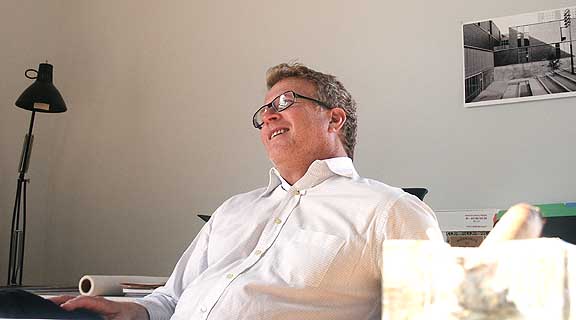 Brad Cloepfil in his SW Portland office (photo Jeff Jahn) It was announced today that Brad Cloepfil has won the competition to design the new National Music Center in Calgary Canada. The design is exciting and somewhat reminiscent of Kahn's National Assembly building in Bangladesh (probably one of the 5 greatest buildings ever built)... Cloepfil is a U of O grad who studied and apprenticed under several of Kahn's acolytes. You can read part I and II of our very extensive interview with Cloepfil for more info on his background. 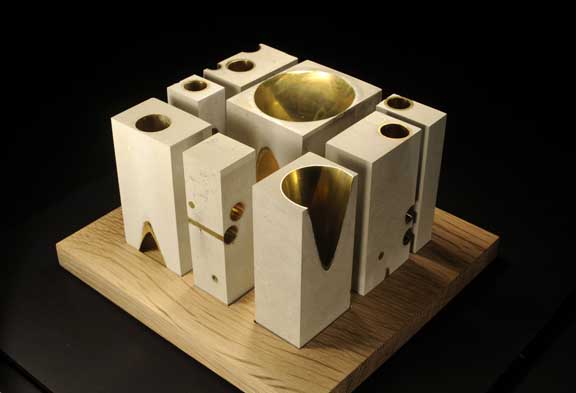
Model of the National Music Center What's more this announcement shines a light on Portland's own Memorial Coliseum... (more) Posted by Jeff Jahn on September 29, 2009 at 10:37 | Comments (0) PermalinkMonday 09.28.09 Monday links The Angels
of Anarchy show in Manchester England charts the contributions of the Surrealists
who happened to be women. Would love to see this on the West Coast of the USA.
Roberta Smith seconds my opinion about a sort of unconvincing minimalism and equally unconvincing dumpster art in NYC galleries these days. The Portland Art Museum has launched a community website for China Design Now, which opens October 10th Tilt Export and Clark College are hosting a new series of art talks, the first is U of O professor Kartz Ucci on October 7th. There are images of Gallery Homeland's first East/West opening in Berlin on their blog now too. Posted by Jeff Jahn on September 28, 2009 at 13:05 | Comments (1) PermalinkFriday 09.18.09 Friday appetizer I'll have several things for PORT from my recent trip to New York (monday). Till then, here are some links:
Roberta Smith is excited about Kandinsky in the Times... (overall there is a renewed interest in the mysteries of abstraction in NYC these days and the big K is a good place to start) The Memorial Coliseum has been granted a spot on the historical register. How about a real arts and entertainment renovating that isn't driven by corporate sameness. Let's see, the TBA festival will need a home some day and something akin to Gehry's Walt Disney Concert hall with Redcat gallery and and other active and large scale cultural space for this city are sorely needed. One of Sol LeWitt's last commission has been completed in the subway system. The pathetically sub par design for the I-5 bridge is about to lose Mayor Sam Adams' support, KGW has the developing story here. I've said this repeatedly but the design requires a very good world class architect to justify itself, something that has not been present and if Portland (via its mayor) doesn't supportthe project it's dead. Message to Oregon and Washington governors, design competition. Mayor Adams is right to oppose this badly needed project if it is going to be some half-assed monstrosity. Here is Adams' statement, this is an opportunity to stop wasting money on bad design and restart this project (with tolls) so it can be done right. Eugene's Josh Faught just won the 31st annual Betty Bowen Award. You can see his work in MoCC's Call and Response show reviewed by Amy last week. Posted by Jeff Jahn on September 18, 2009 at 9:53 | Comments (0) PermalinkThursday 09.10.09 Thursday Links : Cranky Critic's Edition Newish Mercury critic Matt Stangel has a
review of Bobbi Woods at Fourteen 30, a show I'll definitely check out before
the end of the month. Nice to see the Merc is still committed to criticism in
a time when all publishing is facing serious business challenges.
NYT's architecture critic Nicolai Ouroussoff discusses the newly unveiled Net's stadium design by none other than SHoP architects, one of the four teams that competed to do Portland's now iconic aerial tram. We absolutely require another such competition to produce an acceptable design for the new I-5 Columbia River Crossing. Current design is a farce, lacking the world class thinking such a complicated project requires. For once, the O just sticks to the facts in their reportage poll results (70% in favor) for CAN's plan to raise 15-20 million in a new tax levy for the arts. Seriously, I enjoy not having to bitch about his conservative-reactionary O'Reilly Factor style reportage and it is nice when Row doesn't editorialize or hyperfocus on money as if it is the only thing that matters in the arts. Quality matters more than anything and it's the quality here that has an international reach, relevance and growing acclaim. In short, money is a trailing not a leading indicator in Portland, and the quality of artists living and... (more) Posted by Jeff Jahn on September 10, 2009 at 14:02 | Comments (0) PermalinkSunday 09.06.09 Art and tennis? 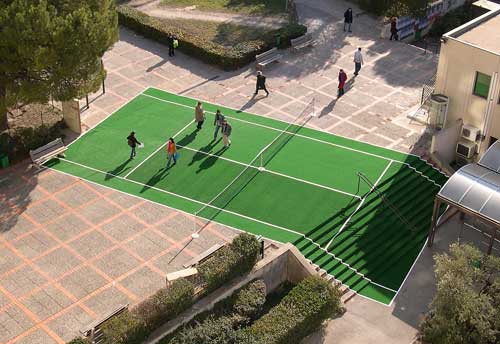 Laurent Perbos, Aire 2005 It is US Open time and I'm watching Nadal play Alamagro right now... just for fun please indulge this as Art and tennis have an incredibly long history together considering Caravaggio etc. In fact it's probably where I developed a kinesthetic sense of schematic space, which then made understanding abstract art much easier in High School when I became interested in more avant-garde art. Over the years, I've even noticed that art aware tennis players often love Agnes Martin and Sol LeWitt. Makes sense. Then there is the fact that the art world loves to play tennis. Michael Kimmelman blogs about it, Tyler Green tweets about it and I've heard even Marizio Cattelan plays a little. Locally, tennis is very popular in the art scene... (more) Posted by Jeff Jahn on September 06, 2009 at 11:31 | Comments (2) PermalinkWednesday 08.26.09 Betty Bowen Finalists 2009 Betty Bowen (on the right) The Betty Bowen Award selection committee has selected 5 finalists this year, who will now compete for the prize. The 2 Oregonians are Jovencio de la Paz and Josh Faught. The three others are Jenny Heishman, Sean Johnson, and Matthew Offenbacher. Though I'm a little suspicious of regional art awards (usually driven by politics instead of pure artistic strength) I think this list at least does a good job of highlighting lesser known artists in the region instead of well known critical/institutional favorites, which was something Bowen wanted. I predict... (more) Posted by Jeff Jahn on August 26, 2009 at 16:58 | Comments (2) PermalinkTuesday 08.25.09 Tuesday Links The New York Times considers
why New York is not producing the best architectural minds anymore and blames
suburbanization + high rents.
It looks like Portland will be getting the world's greenest large building. Here is a hilarous review of a critique of the art industrial complex. Posted by Jeff Jahn on August 25, 2009 at 9:08 | Comments (0) PermalinkMonday 08.24.09 Chris Johanson and Jo Jackson mural in North Portland 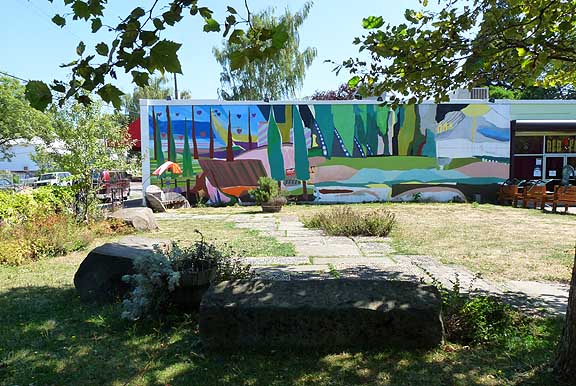
Unfinished mural by Jo Jackson and Chris Johanson in North Portland Maybe the new mural at Albina Green at the corner of N Albina and Sumner has caught your eye already. If it hasn't it should, it's a 14' x 53' work by Portland's Chris Johanson and Jo Jackson. According to RACC: "The mural relates to the building, its surrounding neighborhood and the community in its theme of the contemporary natural environment. Chris and Jo work with imageries that relate to nature and the city often in their work. In this project they intend to combine a colorful abstract landscape including both native and exotic species, coexisting together in nature. Using symbols of ...(more) Posted by Jeff Jahn on August 24, 2009 at 10:48 | Comments (0) PermalinkWednesday 08.19.09 PAM acquires two Sanford Biggers works 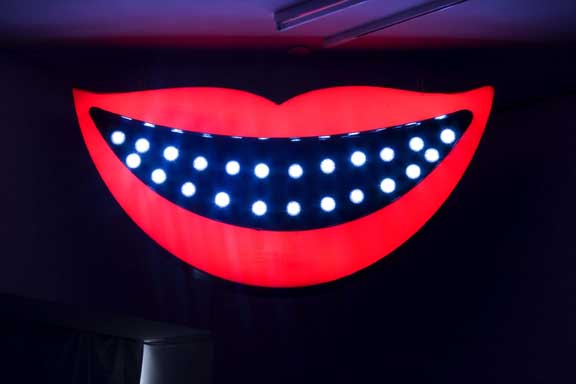 Biggers' Cheshire (2008) The latest additions to the Portland Art Museum's contemporary collection are two of Sanford Biggers' "Cheshire" works; a video piece and a newly installed wall/floor sculpture with a LED light show. Both purchases were made possible through fund's provided by the Contemporary Art Council. They will both be on display through August 30th as part of Biggers' show in the ongoing Miller-Meigs series. The Cheshire sculpture acts both as as a sign and light show performance, with its teeth approximating the Cheshire cat's winking but toothy smile. Like most of Biggers' more recent work its tough to categorize because... (more) Posted by Jeff Jahn on August 19, 2009 at 13:20 | Comments (0) PermalinkMonday 08.17.09 More Monday Links Tyler Green discussed one of my favorite artists, Fred
Sandback, as a recent acquisition at the NGA.
Any large scale naval reenactment gets my thumbs up and this project in Queens is no exception Brian Libby's excellent post on Portland's bid for the 1968 Olympics is extremely interesting. Gallery Homeland was on OPB's Morning edition at 6:50 Am today discussing their upcoming East/West exchange exhibitions in Berlin and the importance of import/export for the visual art scene (pssst update the GH website with an East/West page). Analysis: showing outside Portland, even Berlin isn't a new thing for Portland artists... but an entire exhibition series in Berlin is cool. Artists are always taken for granted in their home cities and it is important to stir things up by showing outside of town... there really isn't a "locals only" art scene anywhere anymore. Group shows like the East/West project are hardly ever definitive but they do open up new contacts and connections and that's the thing about Portland's new (but decade old) scene... we just aren't limited to the immediate environs anymore. We don't think or act in isolated ways... nice hustle Gallery Homeland. Posted by Jeff Jahn on August 17, 2009 at 10:55 | Comments (0) PermalinkWednesday 08.12.09 Wednesday Links Edward Winkleman has some
great advice for anyone that wants to achieve anything. If any project is
truly worthwhile it's worth letting it develop on its own time table, rather
than merely calibrating for the moment.
Zaha Hadid's pavilion in Millennium Park (Chicago) looks great. Kenneth Johnson at the NYT's looks at what happens when a museum tries to reflect assumed sociological content in its collection instead of being cutting edge. It's sometimes a problem in our part of the country when institutions hedge on so callled Northwest Art (usually with some overwhelming nod to craft and nature). I'd counter that it's much broader than that (especially in Portland, Seattle and Vancouver BC) it's just easier to perpetuate the stereotype on an institutional and critical level than to challenge it. Posted by Jeff Jahn on August 12, 2009 at 10:27 | Comments (0) PermalinkMonday 08.03.09 Monday links Roberta Smith's review
of Ron Arad's retrospective explores the exhibition's conceits. Sure there
are ideas but are there enough to support such a sustained look? Is Arad suddenly
looking more dated?
Just one of the conversations sparked in part by PORT's suggestion that the new Willamette transit bridge be dedicated to Mark Rothko (the city's most famous yet locally unheralded son). The Rose Museum's board officially sues to halt the shameful closure of the museum by Brandeis University. Ben Davis takes a swim in the muddy waters between Deleuze and Francis Bacon. Posted by Jeff Jahn on August 03, 2009 at 9:45 | Comments (0) PermalinkMonday 07.27.09 Monday Links On
Artnet Elizabeth Kley has a tour of the seemingly endless series of summer
shows in New York, many of them of the group variety.
The Blog of Innocence considers appropriation in art. The LAT's reports some major LA galleries are expanding. Last Friday the Oregonian pointed to the growing bills over the Columbia River Crossing. The Oregonian's coverage of this and other major design and planning projects is hobbled because they lack an architecture/design critic. For example, the biggest problem with the CRC so far is that this current design is "design by committee" and it is clear the complicated design is just beyond their abilities. To be frank the the current design is an embarrassment. Because this is a super complex project it requires a major architect who can innovate. Instead of focusing on "innovation" committees tend to study and spend money money on more studies. Right now there is a lot of 3rd rate thinking and design assosciated with the CRC and it's costing way more than getting somebody truly talented would. Questions: Why are all the designs for this thing coming out of Washington State? Why are they so gawd-awful? I'll keep harping on it but we need a major architect to save this badly needed and sadly mismanaged CRC project. Posted by Jeff Jahn on July 27, 2009 at 13:34 | Comments (1) PermalinkFriday 07.24.09 Willamette transit bridge design update Today's mixed-use
Willamette Transit Bridge design review was similar to July 2nd's event
with a great many refinements mostly focused on tower designs (more images as
they become available).
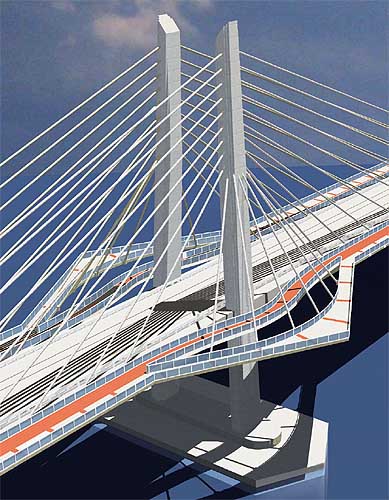
Concept 2 tower design with separate paths for bikes and pedestrians The biggest refinement was the separation of the bicycle and pedestrian lanes at the tower belvederes. It's a good idea if in fact these belvedere's come to pass. ...(more) Posted by Jeff Jahn on July 24, 2009 at 17:28 | Comments (0) PermalinkThursday 07.23.09 The Rothko Bridge? Tomorrow, Willamette Transit Bridge architect Donald MacDonald will address
Portland's design community at a sold out (i.e. capacity) crowd at AiA's Portland
Office. A few weeks ago PORT
broke the story on the new"A" bridge and it was further expanded
on by Bike
Portland and Portland
Architecture... given the massive traffic we got I suspect there will be
more media types at the meeting tomorrow.
 Mark Rothko, 1961 © 1998 Kate Rothko Prizel &Christopher Rothko / VG Bild Kunst, Bonn 2008 But before that I'd like to propose something that PORT staffers have been talking about for years, the City of Portland needs to acknowledge its most famous and noteworthy resident, Mark Rothko, in a major way. Ironically, Rothko's place in history is assured as one of the twentieth century's greatest artists but he is generally unknown or unacknowledged by the city he grew up in . (A city which now boasts a strong international level art and design scene). It is an embarrassing omission, which demands attention. I believe the new Multi-Use Willamette River Transit Bridge is an ideal candidate to be named after Rothko. This is especially fitting since the artist spent considerable time crossing back and forth across the Willamette and frequently painted the very location of the new bridge. For more information, Rothko's time in Portland was assiduously studied by our own Arcy Douglass here. ...(more) Posted by Jeff Jahn on July 23, 2009 at 13:31 | Comments (2) PermalinkTuesday 07.21.09 Spiral Jetty threatened (again)  What if most of this water were land? Tyler Green has the latest on the new threat to the Spiral Jetty, a fertilizer production operation that could lower the Great Salt Lake's levels permanently and turn Smithson's masterpiece into a permanently landlocked work... which would be sad, Smithson's work is all about changing land water and sky interactions. Not to mention the gigantic fertilizer operation would significantly alter the Great Salt Lake's shoreline and ecosystem. I find it interesting how art has become a water rights/environmental lightning rod here... would Mono lake's levels have been more protected if it had a Smithson earthwork (which was considered)? Posted by Jeff Jahn on July 21, 2009 at 8:42 | Comments (0) PermalinkThursday 07.16.09 Matt is back 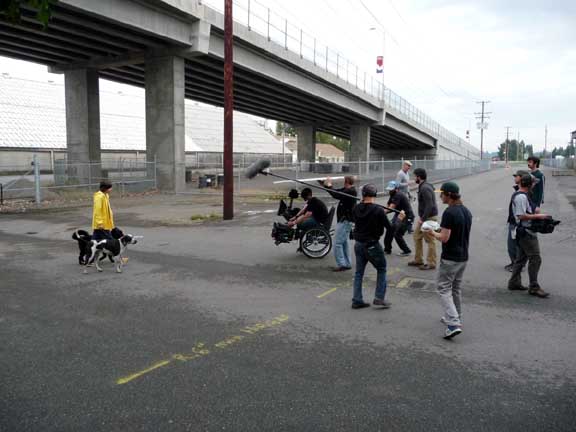
The website for Matt McCormick's first feature film Some Days are Better Than Others has been launched. Matt's pretty much the best-liked person in Portland ,which is special considering how good a filmmaker, and video/installation artist he is (ability usually breeds contempt). Here is PORT's review of Matt McCormick's last gallery show. Posted by Jeff Jahn on July 16, 2009 at 13:17 | Comments (2) PermalinkWednesday 07.15.09 Big Targets Brian Libby has the
scoop but the Memorial Coliseum continues to come under pressure from those
like Randy Leonard and Steve Duin at the O... these are people who just
dont understand that it is the most significant piece of mid century modern
architecture in the city and therefore deserves some TLC and a new plan that
respects its unique contribution to our civic fabric. Lets think about the city's
needs and repuropose the building. Put it this way, we have major league arts,
farmers markets, cycling and music needs and a minor league baseball team simply
doesn't come close to the kind of progressive thinking Portland prides itself
on. Let's think about what the city needs and how the coliseum can better serve
those needs as a historic structure which can do more (though it already does
a lot).
Jen Graves has an interesting review of the Seattle Art Museum's Target Practice show but does anything really make Jackson Pollock look merely "academic" ... c'mon seriously? Posted by Jeff Jahn on July 15, 2009 at 10:00 | Comments (0) PermalinkTuesday 07.14.09 Links for old Times sake Generally I find newsprint to be wasteful, mostly because what is printed on
it is a bit of a waste (not that most blogs aren't tripe either). Frankly though, I'm not certain if most newspapers are worth saving
in their current, rather diminished state. Still, I and a lot of my generation like reading the New York Times, especially online... here are a few bits:
Shepard Fairley gets probation. Roberta Smith critiques the Guggenheim's collecting practices. Ken Johnson feels some young artists need more time to develop. It reminds me what is so good about Portland, artists get to develop more fully (esp. those who have the discipline) than a place like New York which often rushes them to market. Maybe, Portland is the slow food of art scenes? Still, it is amazing how many of our local artists do get galleries elsewhere when they are ready (though there are always more that deserve it). Being undervalued beats being overrated. Posted by Jeff Jahn on July 14, 2009 at 9:09 | Comments (0) PermalinkSaturday 07.11.09 Raphael's La Donna Velata comes to PAM 
Renaissance masterpiece, Raphael's Woman with a Veil is coming to Portland in October, in a one painting show. October is going to be one great month at PAM because that is also when the updated China Design Now opens for its only West Coast appearance. It is a very direct reminder how strong art has a way of transcending both booming and busted economies, focusing us on excellence and contemplation instead of dollar signs. Frankly, I've always liked the way the Portland Art Museum has responded to challenges under Brian Ferriso, a strategy which can be summed up simply as, "High quality art justifies itself "... and bringing this Raphael is no exception. We also like the fact that museum members will not be charged extra to have a viewing and it is nice that the exhibition will have a certain amount of crowd control (limiting 25 viewers at a time) to allow for less congested viewing (it isn't ideal but better than fighting hundreds for a sightline). In the past decade two other major old master paintings have vistited Portland, The Holbein Madonna and Rembrandt's Self Portrait as the Apostle Paul. Opening October 24, the show was organized by the Portland Art Museum and made possible by the Foundation for Italian Art and Culture and brings one of the most important paintings of the High Renaissance to Oregon for the first time. The oil on canvas painting will be on loan from the Medici collection of the Palatine Gallery, Palazzo Pitti, Florence... (more) Posted by Jeff Jahn on July 11, 2009 at 16:49 | Comments (5) PermalinkTuesday 07.07.09 Linkage: Spiral Jetty, Women at MoMA, Abromovic 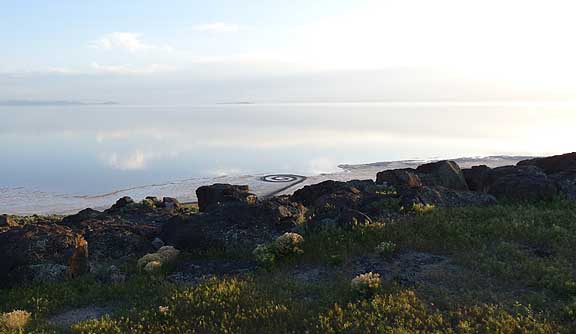 Spiral Jetty and environs Are the Spiral Jetty's environs being threatened yet again? via MAN. The Jetty is more than just a disconnected finger of land with little context (as a lot of photos portray it)... it is actually wonderfully connected to its spectacular environs. Also, Tyler Green's analysis of Jerry Saltz vs. MoMA is pretty much spot on. Every time I visit I find myself wondering about the ossification of MoMA's permanent collection on view. For some reason I'm always treated to way more of Robert Morris' 3rd tier postminimalism (post original idea?) art while finding the refreshingly original Lynda Benglis and Anne Truitt is often impossible. But I think the issue with MoMA goes way beyond gender... the museum is a victim of its own success and has trouble being anything more than a tomb of influence for anything over 20 years old. Though MoMA's special exhibitions do address the issue by having Dorothea Rockburne etc. This is one area PAM competes a little better than some museums, Judy Chicago, Hilla von Rebay, Louise Nevelson, Dorothea Rockburn, a small Eva Hesse, Agnes Martin and Anne Truitt are nearly always on display. Critic Adriane Searle gets scared by Marina Abromovic. Posted by Jeff Jahn on July 07, 2009 at 10:12 | Comments (0) PermalinkMonday 06.29.09 Links of perception The NYT's
takes on the Walker/MOCA developed Dan Graham show now that it has hit eastern shores.
Sanford Wurmfeld's very interesting painting/installation. Eva Rothschild's work reminds me of this months show at Tractor. Needless to say perceptual/kinesthetic experience art is everywhere again. Arguably, the three artists mostly responsible for this renewed interest are Robert Irwin, James Turrell and Olafur Elliason. A lot of interest in Portland for this kind of work as well. Posted by Jeff Jahn on June 29, 2009 at 10:21 | Comments (0) PermalinkWednesday 06.24.09 Linked I really liked Michael
Kimmelman's piece on the Elgin Marbles in the Times... for once having New
York's supposedly chief art critic in Europe pays off. What's more the writing
is sharp, with the kinds of critical angles he seems to soften when writing
at home.
Lisa Radon's excellent review of Anna Gray and Ryan Wilson Paulson's Pearl District debut speaks volumes to Portland's sizable booklovers crowd. Jerry Saltz describes a Portland-esque art experiment... 'cept we've been developing this way for years. Here it isn't a single site, it's the way our scene operates and it is different if the art develops this way instead of an episodic situation. MoCC's Call and Response website gives everyone a chance to respond to the changes we've seen in the Portland art scene over the past decade. I'll be making a presentation on this at another museum this summer as well, so my response was quite brief. Posted by Jeff Jahn on June 24, 2009 at 10:28 | Comments (2) PermalinkTuesday 06.23.09 Entropy is good for art links Things are tough for art galleries and The New York Times chronicles the shift
to a
market that favors collectors vs speculators. When I was in New York last
March I noticed a vulnerability I've not noticed before... frankly this might
be a good thing because though the art market boomed during the past 7 years
it has produced little art of consequence. At least Portland galleries have
lower rents and aren't used to selling unknown artists for 10K+.
Edward Winkleman discussed the NYT's gallery woes article from his own very personal angle. In Venice Bruce Nauman surprised no one by being top of the heap. Jerry Saltz discusses how a phase of art that is dying in Venice might be a good thing. Posted by Jeff Jahn on June 23, 2009 at 11:36 | Comments (0) PermalinkThursday 06.18.09 Links of renown The Tribune has a nice piece on MoCC's
Call and Response... with a lot of smart stuff quoted from curator Namita
Wiggers. But, define renowned? ...in my book only Chris
Johanson qualifies, though many more international artists are getting set
to move here... (being international isn't enough either, we have lots of internationally
active artists in Portland now, for me it's the probability of a solo show at
MoMA some day that is the litmus test).
Jessica Stockholder's park installation shows just how good she is. Local artists like Jenene Nagy, Stephanie Robison and Jacqueline Ehlis are all quite influenced by her... and she's actually from the Northwest... so will we ever get a solo show of hers here in Portland? If there is a critic in Portland who is more interested in sexualized identity politics than... (more) Posted by Jeff Jahn on June 18, 2009 at 11:43 | Comments (1) PermalinkWednesday 06.17.09 PNCA names new chair of MFA program At PORT we've all known for a while that our pal MK Guth was stepping down as PNCA's MFA chair, especially after being in the last Whitney Biennial. What wasn't clear is if they could get some similar star power to replace her, yet they needed it. Now with noted curator (SF's Yerba Buena) and artist Arnold Kemp, it looks like they have the star hire they needed. In fact, Portland's professional portfolio of leaders just continues to improve... here's PNCA's release:
Pacific Northwest College of Art (PNCA) announces the appointment of Arnold J. Kemp as Chair of the Master's of Fine Arts in Visual Studies program. "We are so pleased to appoint Arnold Kemp, with his great strengths in so many spheres of the art world," said Greg Ware, Provost, PNCA. "We feel confident that he will bring diversity, richness and depth of experience not only to our MFA students, but to Portland's art community... (more) Posted by Jeff Jahn on June 17, 2009 at 13:03 | Comments (0) PermalinkMonday 06.15.09 Archer Gallery anounces new director Over the years, the Archer Gallery has become one of the more daring college
spaces in the metro area and I was saddened last year when Marjorie Hirsch made
it clear it would be her last year as director. Her efforts like Ellen
George's impressive solo show and the recent Considered
Space put the Archer Gallery on the map... but there's always more room for a risk-taking and professional curatorial program as Portland's institutions continue to catch up to all the very worldly artists who have moved here in the past decade or so. I also wondered, what would the Archer be like without her?
We are about to find out, since Clark College has announced that the new Director for the Archer Gallery is Blake Shell.... (more) Posted by Jeff Jahn on June 15, 2009 at 15:10 | Comments (1) PermalinkTuesday 06.09.09 The deal with John Wesley 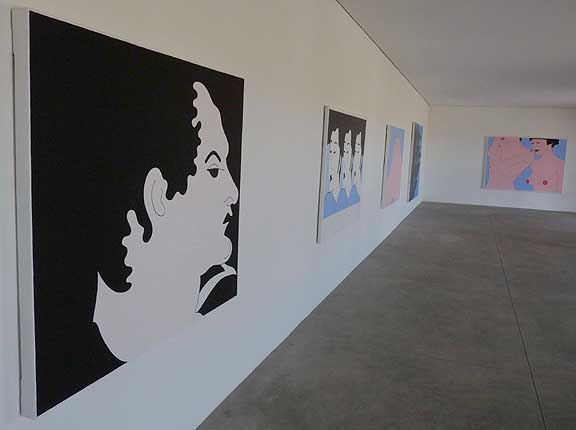 John Wesley at Chinati 2009 John Wesley confuses the hell out of people but I really like his work, the Times has a piece on him here today. Of course Donald Judd liked his work too and upon a recent viewing of his installation at Chinati I could see why. He was also an excellent addition to Robert Storr's 2004 Site Santa Fe Biennial on the grotesque, fitting right in with R. Crumb, Carroll Dunham, Robert Gober and Tony Oursler. Wesley's work certainly does create a kind of "Soul Dizzyness" Storr described in the biennial's text. So what is it about Wesley that keeps him an insider's favorite? For me its his clean clear fugal forms of composition, his blurring between the private things we all notice but don't speak about and bland things we always seem to discuss... (more) Posted by Jeff Jahn on June 09, 2009 at 11:41 | Comments (3) PermalinkFriday 05.29.09 RACC, CAN and does emerge in 2010 with a strong budget Even in these tough times Portland is beginning to make arts funding a priority by
announcing yesterday that the:
Portland City Council approved the FY10 city budget with a $4,325,300 allocation to the Regional Arts and Culture Council (RACC), including whole funding for most RACC programs. The budget, which was approved 5-0, also includes additional one-time funds for the Creative Advocacy Network to deliver a regional, sustainable dedicated funding solution for arts and culture funding as well as The Right Brain Initiative to support integrated arts education programs. Yes PORT can be hard on RACC for not being challenging enough sometimes (for public art and individual project grants), still this is a major victory for them in these difficult times. They have been making steady progress in the past few years and this only consolidates their gains. Congratulations are in order as this allows them to continue the momentum. If you want to count more beans there is more info from RACC here. Posted by Jeff Jahn on May 29, 2009 at 0:00 | Comments (0) PermalinkTuesday 05.26.09 Wrong-headed linking Is the Hybrid Bridge dead? It better not be! Portland Architecture reports there is a rising possibility of an all out war
between Portland's design community and Trimet, which many suspect has rigged
the Hybrid Bridge over the Willamette to fail
while negotiating Trimet's rather design-blind decision making criteria.
Seriously, something is very wrong in Portland's civic process if good design
isn't given serious attention for its bridges like the new Willamette
Span or the Columbia
River Crossing. If Portland is to continue being the international design
hub it has increasingly become, we must walk the walk. Besides, in "bridge city"
we need especially well-designed bridges not just functional eyesores. Seriously,
this simply cannot stand and the design/arts community needs to pool all of
their networks and fight for good civic design. (aka the Rosales designed Hybrid
Bridge and a design
competition for the CRC). The process is broken, fix it! Tell Trimet what you think here.
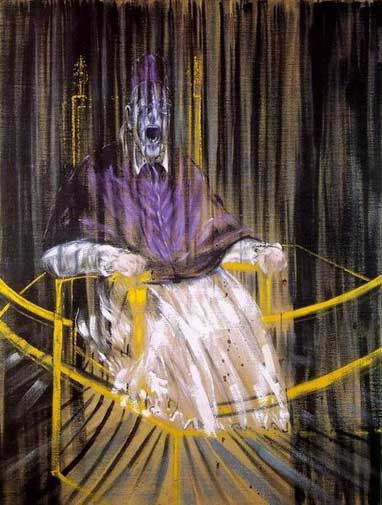 Francis Bacon's "Study after Velazquez's Portrait of Pope Innocent X" 1953, Des Moines Art Center, Iowa Roberta Smith takes on the Francis Bacon retrospective at the Met and massively oversimplifies the painter. Though it's an important feature of the work, the male on male aspect isn't Bacon's only claim to preeminence... remember post WWII Europe was an open sore of burnt out cities...(more) Posted by Jeff Jahn on May 26, 2009 at 10:39 | Comments (6) PermalinkThursday 05.21.09 mary henry 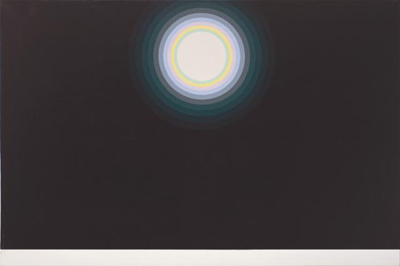 Mary Henry, "Full Moon Over the Mendocino Headlands," 1971 Sadly, PORT has just learned that painter Mary Henry passed away yesterday. Read Arcy's interview with her on PORT. Then go see an installation of her works from various periods @ PDX across the hall. Posted by Megan Driscoll on May 21, 2009 at 9:09 | Comments (0) PermalinkMonday 05.04.09 Monday Links Brandeis' The
Future of The Rose Committee is not inspiring confidence and drawing comparison's
to Stalin's committees even. How can the Rose be a functioning museum without
a director and curators? How can this committee be anything more than a desensitizing
tool if it doesn't have suggested members from outgoing Rose staff? To answer
one question... would it be a permanent black list... yes almost certainly!
This will be remembered as one of the most foul museum raids by caretakers in
recent memory.
PORT pal Tom Webb opines on a better use for the memorial coliseum... and better design of the concrete wasteland aka the grounds is key. David Adjaye will designing the new National Museum of African American History and Culture. Surprise surprise, it's based on sculpture... and though the design is decent it's hardly mind blowing... maybe that is the point, the building will have to stand on its programming ultimately. Portland Architecture has joined PORT in calling for a design competition for the Columbia River Crossing and gives the Governor a lesson in the difference between aesthetics and design to boot. Design Competition Now... right now the process has been driven by very unimaginative, extremely orthodox... even rigid thinking and we won't get an actionable design until some serious architectural talent is brought to bear. This job is beyond the capabilities of all but the best architects working in conjunction with innovative engineers. Right now it is being driven by standard engineers and nominal architectural talent. A design competition will bring some real solutions quickly for quite a bit less than millions that have been wasted already in this false design process. C-Monster digs Huang Yong Ping's snake tower... we do too. I wish more Chinese art had Ping's thing, but alas... Posted by Jeff Jahn on May 04, 2009 at 9:39 | Comments (0) PermalinkSunday 05.03.09 Gauguin for Portland Art Museum 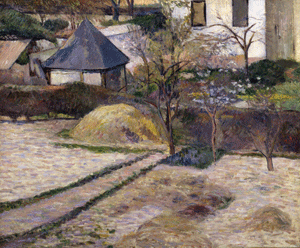 Gauguin's Vue d’un jardin, Rouen (1884) Longtime Portland arts patron Melvin Mark has given the Portland Art Museum an early Gauguin,Vue d’un jardin, Rouen (Garden View, Rouen) in memory of his recently departed wife, Mary. It's an important impressionist acquisition for Oregon's art going public, which has had limited access to any Gauguin works. The painting was exhibited in 2003 at the Portland to Paris exhibition (which also sported another later Brittany era Gauguin, also from a private collection). The work went on display Sunday on the 1st floor of the Jubitz Center for Contemporary art (Mark Building). Gauguin is one of my favorite artists and interestingly ambitious before he so famously found his way to the south pacific and his most iconic works. In 1884 (same year as PAM's Van Gogh) he was busy trying to ingratiate himself amongst the impressionists (having collected their works etc), then the most vanguard artists at the time (until Gauguin, Van Gogh and Cezanne took that title as the top post impressionists). In 1883 Gauguin had decided to become a professional painter, before that having been a stockbroker with a real talent for art...so considering this is a pretty good painting from that early makes it a bit of a catch. You can see how Gauguin makes even a winter scene look exotic. Thanks to the Marks for making it possible to finally see a Gauguin on a regular basis at the Portland Art Museum (completing the trinity of early works by the major post-impressionists). Posted by Jeff Jahn on May 03, 2009 at 16:07 | Comments (0) PermalinkTuesday 04.28.09 Tuesday Links The Art Newspaper discusses why social
networking is important to museums. In a related tangent you can follow
PORT on twitter
here.
The Guardian considers why "schlocky", "teutonic" self portraitist Martin Kippenberger goes over well with women? It is an odd question. Honestly, my take on him has nothing to do with gender; he's a good artist but not terribly original... he's a kind of permissive force for lesser artists following in his wake. After seeing his retrospective at MoMA recently I feel even more strongly now that his importance (or self-imposed unimportance) seems to rest on his follower's somewhat dubious merit more than his own. Also, I agree the Simpsons have really lost their edge... even if a majority of the characters are named after Portland streets. Archidose takes apart their architectural ponderings here. I kinda wish it would stop before it gets worse. Posted by Jeff Jahn on April 28, 2009 at 10:10 | Comments (0) PermalinkThursday 04.23.09 Portland and Place My second response to the meeting last night about the integration of the Museum of Contemporary Craft and Pacific Northwest College Craft (PNCA) was that art institutions should consider becoming more specific rather than more general in regards to their programming. It might seem counter-intuitive but there is a term used in retailing called "death in the middle". The term suggests that the way that most people shop for things today is very selective and generally at either the top end or the low end with rarely anything in the middle. The result is that one might see a $500 hand bag being carried by a person wearing a $5 shirt. Either someone really wants something and is willing to invest in it or they need it but are not really emotionally attached to it and therefore it should be as cheap as possible. In other words this is a good market for stores that sells things at the upper end that might be expensive and at the very low end where things are inexpensive, but for the stores in the middle, like department stores that try to be everything to everybody, it is a very difficult time. Just to be clear, these analogies are about the relative price of goods, and maybe the emotional attachments to some products, not indicator of friendliness or approachability. These stores are equally accessible to anyone. It is a good example that we all live in extremes, and that a general audience does not even really exist.
More...
Posted by Arcy Douglass on April 23, 2009 at 15:48 | Comments (0) PermalinkWednesday 04.22.09 Design Competition for I-5 crossing... Now 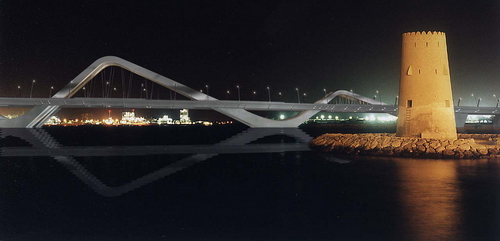
Zaha Hadid's Shiekh Zayed Bridge... it is still time to up the ante on the new I-5 Columbia River crossing So the Oregonian has continued to report on Sam Adams and the Columbia River Crossing without much critical authority here (because they don't have an architecture critic and need one desperately). For example they fail to note that major architects have built better and quite iconic bridges without tall features like the Hadid designed one above. Basically, the proposed design is laughably bad (I've called it a casino in the past) and proves the design process is broken and backwards... overall requiring a fix. Why? because the architects involved are clearly out of their league, designing an inelegant and patronizing monstrosity that resembles the car Homer Simpson designed (The Homer).... essentially decoupling aesthetic form from function. Major architects know better, hell even minor ones do... (more) Posted by Jeff Jahn on April 22, 2009 at 13:00 | Comments (2) PermalinkTuesday 04.21.09 Rose City still watching The Rose Richard Lacayo has the
latest updates on the sad sad situation over at Brandeis University's Rose Art
Museum.
What this looks like to me is Brandeis is still attempting to let the museum's public connections wither (with no director, curator, or education department) so as to bolster their case. The State's Attorney General is on them though. The question is, will those who have donated artwork in trust to the museum take a hard legal approach to Brandeis if the university attempts to liquidate the work for the benefit of Brandeis in general and not the Rose specifically? To me that's a massive breach of trust and something tells me the donors and their representatives have some fight in them if it comes to that. Posted by Jeff Jahn on April 21, 2009 at 10:56 | Comments (0) PermalinkThursday 04.16.09 Favorite small painter: Paul Klee Tyler Green has been making links to tweets about people's favorite small paintings, here, here and here.
Though I don't have a favorite small painting per se, I do have a favorite small scale painter, Paul Klee. He's ultra influential these days with his lyrical pre-minimalist and fairytale theatrics, which relate to artists like Chris Johanson, Mark Grotjahn and Tomma Abts etc. Even architects like Steven Holl with his perforations, Rem Koolhaas's irrationally rationalized materials, Zaha Hadid's fugal curves and Herzog & de Meuron etc. They all owe him a great deal. 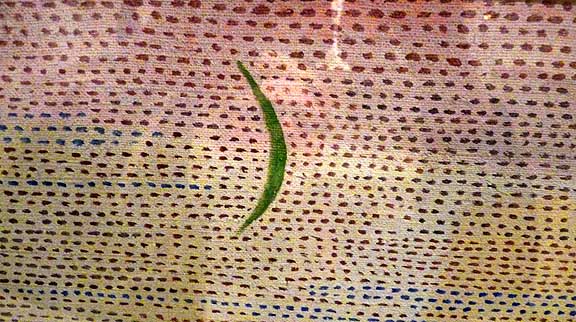 detail Clarification, Paul Klee (1932) Berggruen Collection at the Metropolitan Museum Right now I currently have a crush on Klee's...(more) Posted by Jeff Jahn on April 16, 2009 at 12:10 | Comments (0) PermalinkMonday 04.13.09 Monday links and good advice 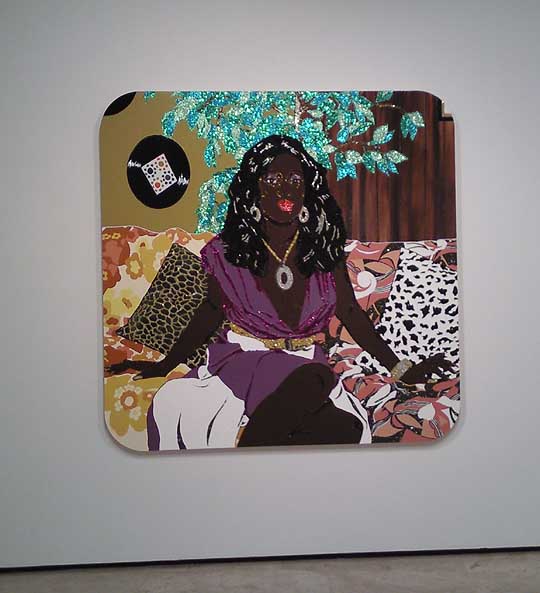 Mickalene Thomas at Lehmann Maupin's Glamour Project One-time (before grad school at Yale) Portlander Mickalene Thomas had a whole page in the times last week, look for PORT's in depth interview with her in the coming days. Jen Graves put the smack down on Seattle's art scene. Frankly, I think... (more) Posted by Jeff Jahn on April 13, 2009 at 10:00 | Comments (0) PermalinkFriday 04.10.09 Talkin bout the next Jesus? 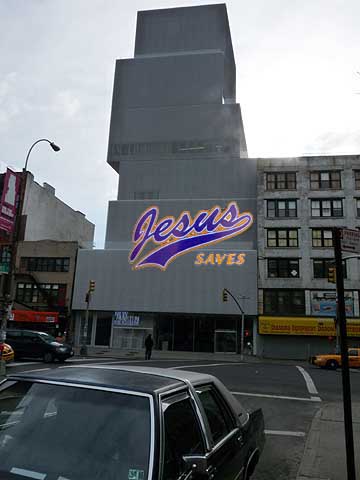 New Museum, new show, new sign art? Jerry Saltz takes on the Younger Than Jesus show at the New Museum and particularly liked Ryan Trecartin, whom weve seen a couple of times at Igloo and TBA. He also explains why postmodern theorists look just as hypocritical as modernist idealogues. Frankly, in many ways it looks like the same old thing weve seen for years and something tells me no institutionally sanctioned "ennial" will define the next really big thing, we need a cleaner break. For the Times Holland Cotter seemed to have the same feeling all critics always have when seeing a survey of young art, they look for energy and trends. Just a note, PORT will have a trio of big interviews this next week so keep your eyes peeled. Posted by Jeff Jahn on April 10, 2009 at 9:58 | Comments (0) PermalinkThursday 04.09.09 Mark Woolley Gallery to close The WWeek has the scoop, another sad day... Mark Woolley Gallery to close after 15 years in business. (Yes close is the right word this time, galleries often reinvent themselves but that isn't the case here.)
PORT reviewed the gallery's excellent 15 year anniversary show in December 2008 and hoped the recently relocated space had found its footings again after losing most of its top artists to other galleries as of late... (more) Posted by Jeff Jahn on April 09, 2009 at 17:49 | Comments (4) PermalinkWillamette bridge follow up  Pedestrian view from proposed "Hybrid" bridge, courtesy Rosales + Partners/Schlaich Bergermann and Partner LP Brian Libby at Portland Architecture has a great follow up on the hybrid bridge unveiling. I couldn't make it but this more detailed design is much better and Rosales is correct in that this hybrid cablestay/suspension design is more transparent experience for users (see above) than the wave design. My overall concern centers around how this future Portland icon is getting less aesthetic attention things like former Mayor Potter's beard or Randy Leonard's bass-akwards fixation on a neon sign. Aesthetics matter and it seems like design is trying to be snuck in through the back door of the discussion. This is the same problem with the I-5 bridge, which needs a top tier architect to pull off with any kind of hope for success. Barry Johnson over at the Oregonian, is also discussing Willamette bridge appropriateness with some good thoughts. Still, his focus on height is a bit of a red herring, it's about a design that stands up to context rather than pandering to it. A more tailored cable stay design could be even more elegant and appropriate than the wave or hybrid design and declare that pedestrians/bikes and mass transit are the most celebrated modes of locomotion in the city. In my mind this bridge was considered an engineering and budget driven project above all else. The aesthetics are being added at the end... a kind of hail mary attempt by the architect to save the process from itself . That strategy is appropriate for the architect but frankly it's bad for a "city planning"... ironically what the bridge will come to symbolize. All things considered this "hybrid" design should be Trimet's first choice (let's see). All that that said this Willamette span issue clears the path for stronger discussion of the I-5 bridge, which is currently a blind man's elephant in dire need of an architectural competition to gain clarity. Also, the Oregonian still requires a real architecture critic to take the lead in this discussion, healthy civics require major and experienced critical framing. Art criticism is more of an insiders game and PORT is just offering an aesthetic assessment on a larger issue... our focus makes us more limited in major civic discussions. Important yes, but we are just voices from the vis art community. Posted by Jeff Jahn on April 09, 2009 at 9:30 | Comments (0) PermalinkWednesday 04.08.09 Wednesday Links Portland Architecture has weighed
in on the Hybrid
Bridge model for the Willamette we gave you a peek at last weekend. It seems
like the consensus is the Trimet process hasn't taken design seriously enough,
even though that bridge over the Willamette is likely to become a major symbol
for the city. I can say PORT has gotten image requests for the seemingly out
of the running wave design and none for the other options.
If you want some cultural blood sport, Tyler Green's play by play over deacessioning between Christopher Knight and Donn Zaretsky. My feelings about this are that museum deacessioning should only occur if it if the work is unrelated or secondary to the Museum's primary focus and or the museum already has significant holdings of that artist rendering the work a second class citizen. Deacessioning should be rare and done to support the museum's mission... which is not the case with The Rose, which is just a money grab.... pure and simple. Richard Speer reviews Matt King's Science Diet at Fourteen30 with panache. It is one of the best shows in Portland right now. And filed under "why repeat the effort": C-Monster has a great list of links to check out today. Posted by Jeff Jahn on April 08, 2009 at 10:52 | Comments (0) PermalinkSaturday 04.04.09 New Bridge Model Unveiling -updated  advance look at "Hybrid Bridge" model courtesy Rosales + Partners/Schlaich Bergermann and Partner LP On April 7th at City Hall, architect Miguel Rosales will unveil his latest bridge design, the first new span over the Willamette in over 35 years. There will be a scale model unveiling at 6:00 and a lecture by the architect at 7:00. PORT has followed this design closely and I liked how the most recent hybrid cable stay/suspension bridge cut an elegant European profile across the Willamette... though it felt unfinished from an on bridge perspective, lacking enough monumental verticality (something that can be resolved hopefully). *Update below the model views look more resolved ...(more) Posted by Jeff Jahn on April 04, 2009 at 10:38 | Comments (0) PermalinkTuesday 03.31.09 Greener bridge over the Columbia? 
Image of the New St, Andrews bridge, an uninspired design but interesting eco-concrete (seen in bad sculpture) has potential The New York Times has a fascinating article on green minded, pollution scrubbing cement being used on the St. Andrews Bridge in Minneapolis. Yes it's the replacement for the one that collapsed...but might it have an application for our Columbia River Crossing on I-5? Mayor Adams has made a promise of A Better Bridge and his political future rests on delivering it. The St. Andrews project only uses the cement on sculptures but a Portland bridge design could possibly incorporate it more fully? This Columbia River Crossing is still a vague blind man's elephant and as I've mentioned numerous times it is going to take an architect to really bring this project some coherency and make a truly better bridge. How about a design competition? Right now the two mayors are the leading voices on the design issues and frankly that's just wrong. What the politicians need is an architect whom they can torment into being on time and on budget while the architect can create designs that do more than simply speak to one issue or group. A design competition gives people a visual, till then the discussion is about lanes, dollars, concrete, wind turbines, bridge heights, where people live and other red herrings that only see part of the picture. A good design has to address all of those things and much more, a politician can duck or steamroller issues but a bridge embodies them and I think the two mayors should avoid their current situation. Let the designs embody the discussion so the politicians can politic. Posted by Jeff Jahn on March 31, 2009 at 9:38 | Comments (0) PermalinkMonday 03.30.09 More links Tyler Green indicates that the Hirschhorn has undertaken a series of rolling
gallery closures because of a lack
of security gaurds.
Jerry Saltz discusses who is looking a bit dated or artificially enhanced as the less buoyant art market casts their recent work in a more sober light. Posted by Jeff Jahn on March 30, 2009 at 10:59 | Comments (0) PermalinkFriday 03.27.09 Correction: Pulliam Deffenbaugh, reinventing itself Correction: Ok never trust the Oregonian (I should know better) Pulliam
Deffenbaugh Gallery is not closing just adjusting its current form. Basically they are leasing out some space during slower months to PDX comtemporary, next door. I've been out of town but have known about the restructing for a few weeks.
What should be noted is that Pulliam Deffenbaugh is an essential core gallery and founding PADA member, but of all the main Portland galleries, I've been most concerned about them. For the past year the gallery has been doing mostly group shows (some stellar but red dot sales have been noticeable slower than many other PADA galleries). It's been a long time since they had a blockbuster solo show sales-wise too. *Disclosure I showed in one of the better selling group exhibitions last year. For more background, a few weeks ago MaryAnn Deffenbaugh announced she would be leaving the daily operations of the gallery to work in development for OCAC. Like a lot of Portland galleries, a large portion of their sales in recent years have came from outside the city (now likely effected by the economy) and yes some key local collectors have been hit hard in the financial crisis. *Update Rod Pulliam and MaryAnn Deffenbaugh have yet to figure out what the new business arrangement will be... so basically this whole story broken by the Oregonian's doom patrol seems a tad premature. Posted by Jeff Jahn on March 27, 2009 at 13:22 | Comments (1) PermalinkThursday 03.26.09 Rothko in Portland Today is the 95th anniversary of the passing of Mark Rothko's father Jacob Rothkowitz on May 27, 1914. Rothko was 11 at the time and had only been in Portland 7 months before his father passed. The house that they lived in at the time was in 834 Front Street in Southwest Portland. I have been rereading James Breslin's excellent biography of Rothko and found this quote on page 34: Rothko spent "his youth in front of the endless space of the landscape of Oregon lying covered by the wintry snows, in front of the monumental emptiness that is nothingness and and at the same time part of it 'all'". Posted by Arcy Douglass on March 26, 2009 at 20:19 | Comments (0) PermalinkLinks of DOOM It looks like the horrible Atlantic
Yards development is dead, according to Frank Gehry. That's good news, for
once!
The Guardian reports on Berlin's art market downturn. AFN reports that Bergamot Station is in potential danger. Honestly, I can't believe that would really happen. Posted by Jeff Jahn on March 26, 2009 at 9:57 | Comments (0) PermalinkMonday 03.23.09 Escaping to and from New York + links Well, I'm back from New York and now catching up on all the better coffee and
significantly less polluted and overall greener environs of Portland.
But New York does have great architecture and museums. I'll have lots of interviews, reviews and pictures for you later but below is a di-opical summary of my trip: 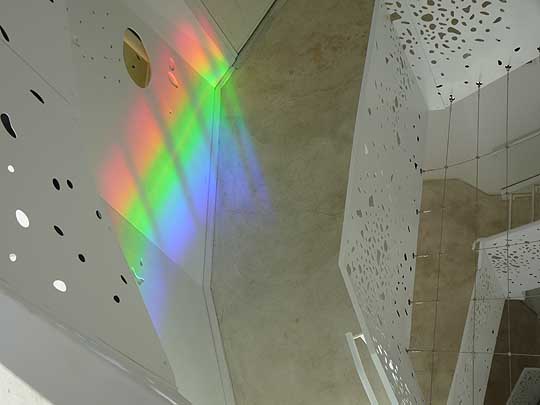
Steven Holl's psychology building staircase at NYU 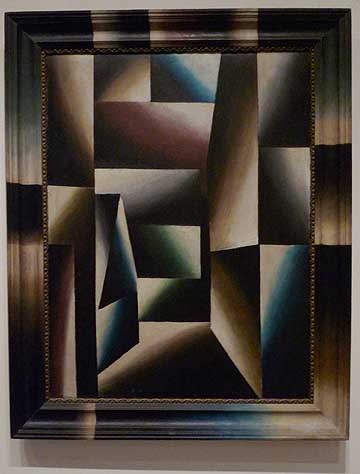
Arthur Segal's wonderful and still fresh Strasse auf Helgoland II (1924) at the Met. Also, here are a few links that caught my eye while away...(more) Posted by Jeff Jahn on March 23, 2009 at 11:51 | Comments (0) PermalinkSaturday 03.07.09 speak and(in) sign(s) 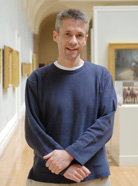 Alexander Nemerov Yale professor of art history Alexander Nemerov is speaking and leading two workshops on the practice of art history at Reed College this week, all free and open to the public. On Monday, he'll lead a workshop based on his essay Seeing Ghosts: The Turn of the Screw and Art History, from Michael Ann Holly and Marquand Smith, eds. What is Research in the Visual Arts: Obsession, Archive, Encounter (2008). On Tuesday he'll present the lecture Helen Keller: Making Contact, asking "What is the relation of Helen Keller to the visual arts in America? Which artists from her time perceived the world in the way she did? What would their work look like if they did share her views, and why would this matter to us now?" And finally, on Wednesday he'll present another workshop, this one guided by his essay Fragments of the Home Front, from of Icons of Grief: Val Lewton's Home Front Pictures. Monday workshop • 4:45pm • March 9 • Vollum 110 Tuesday lecture • 7pm • March 10 • Vollum lecture hall Wednesday workshop • 4:45pm • March 11 • Library 41 Reed College • 3203 SE Woodstock Blvd. (More: Kathleen Dean Moore at PNCA, Book signing for MoCC at Powell's, J. Morgan Puett for PMMNLS.) Posted by Megan Driscoll on March 07, 2009 at 13:15 | Comments (0) PermalinkTuesday 03.03.09 Linkage: Zombies, Creatives and Science Frenchy but Chic, gives his hilarious
report on the College Art Association's annual zombie conference in LA last weekend.
Chris Burden is having some trouble getting his gold. Barry Johnson discusses Portland's Coraline economy. One correction... Portland's is the same as the Warhol economy, only Portland has less cocaine and better coffee than New York version (ie more supportive than inherently status driven). Essentially, Portland is analogous in the global creative economy... there is no one center but there are popular centers. During the last few recessions Portland has typically gained a lot of new talent fleeing San Francisco, the Midwest and Seattle. PDX is also appealing to those New Yorkers who want to concentrate more on the work than the rat race. You can definitely network here but it's even better if you already have a network. Also, with creative efforts following the New York or LA style "quick buck" style of project development doesn't always lead one to something lasting and new... as we hope Laika will be. Lastly, Coraline economy doesnt work as a term... because they are hardly the only game in town, Portland's creative economy is actually more centered around small businesses, but Laika is a welcome change. Ziba, W+K, Nike, Addidas etc. are at least on par with Liaka if not moreso so lets not act like this is a new thing with only one major player. Tyler Green uses Brought to Light to refute one of Brandeis' biggest and most faulty assumptions. PORT's in depth review of Brought to Light, by Bean Gilsdorf makes it doubly clear. Arcy's review of the big Olafur Eliasson show a while back is also a case in point, though Eliasson can be a bit more of a funhouse. For historical examples we should point out that Robert Oppenheimer was a collector of Robert Motherwell and Da Vinci was in many ways the first scientist, utilizing Bacon's New Organum way before Bacon was born. Posted by Jeff Jahn on March 03, 2009 at 10:51 | Comments (0) PermalinkThursday 02.26.09 Save the Oregon Cultural Trust from political raiders  Oregon Cultural Trust license plate, a program that has raised 1.3 million of the 1.8 in jeopardy Notice, if you gave funds to the Oregon Cultural Trust that money is in danger of being reappropriated for things other than culture, RACC has the info here. What's even mindbogglingly worse the 1.8 million dollar war chest the trust has already built up over the years is in danger of being "recaptured." This would effectively kill the program's credibility with donors for all time by breaking their trust. This is the same sort of short sightedness that constantly puts cultural funding at risk, but it's far worse because it decimates a successful program that is trying to pull Oregon out of the bottom 5 for funding of the arts. Time to dig in, sharpen your teeth and definitely click here and let the politicians know what you think. Posted by Jeff Jahn on February 26, 2009 at 11:25 | Comments (0) PermalinkTuesday 02.24.09 More institutional linking One of my favorite art writers, Adrian Searle, has some
issues with how a Picasso show has been presented.
The New York Times reports on how some very successful artists are using their art as collateral for loans in these troubling times. Ok it's another newspaper schadenfreude story but it reminds me why museums should act differently than artists do towards their own work. It's the artist's right to gamble with their work, a museum like The Rose isn't an asset to be liquidated. It is a museum holding work for the public in trust. Jerry Saltz discusses White Column's contributions and mission on their anniversary. Posted by Jeff Jahn on February 24, 2009 at 10:00 | Comments (3) PermalinkSunday 02.22.09 New PNCA and MoCC integration details and analysis Here's a follow up on the PNCA/MoCC
merger. In the past week I've spoken with both Tom Manley, President of the Pacific
Northwest College of Art and Kathy Abraham Chairman of the Museum of Contemporary
Craft's Board... so PORT has some important details for you now. I apologize for
this having taken me so long but I've got some major projects of my own at the
moment.
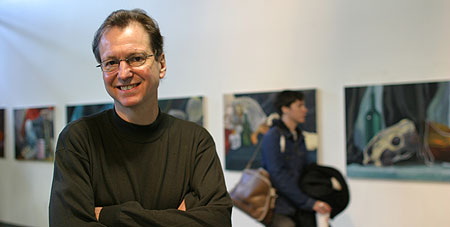 PNCA President, optimist and soon to be craft/design Museum President Tom Manley Despite all I've heard, I'm still just as cautious as before... though I feel PNCA is less in danger of jumping the shark and damaging itself. The school also develops an opportunity to launch its curatorial studies program much faster. That's important since I consider PNCA's fate to be nearly analogous to Portland's goals as a serious art city. Some of the new information: Museum retains separate 501.c3 status and governing board PNCA undertakes fundraising campaign and slightly alters 5 year plan to address museum's financial situation and lack of endowment. ...(more details) Posted by Jeff Jahn on February 22, 2009 at 21:39 | Comments (0) PermalinkWednesday 02.18.09 Julie Bernard 1st recipient of PADA service to art award 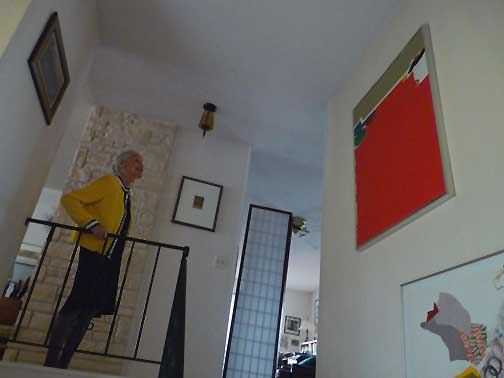 Julie Bernard at her home surrounded by art by Cliffird Gleason (the large red painting) and others The Portland Art Dealers Association has announced its inaugural recipient of its Award for Service to the Visual Arts, Julie Bernard. Julie has been a fixture in the arts community supporting various arts organizations and with her radio program Art Focus on KBOO radio, which she hosted for a staggering 25 years, (it continues on with other hosts). Frankly, I can't even remember how many times Ive been on it but the half hour show was always a blast, focusing on local and national art figures alike. She has a subtle wry wit and knew how to push peoples buttons. Bernard stepped down in 2008 and it is wonderful that PADA is acknowledging her contributions. Here is Joseph Gallivan's interview with Julie Bernard in the Tribune. Posted by Jeff Jahn on February 18, 2009 at 18:49 | Comments (1) PermalinkMaking the best of a bad situation links Once again Tyler Green has some great analysis, this time on how the so called
victory
of a 50 million dollar arts stimulus inclusion... isn't one. The US is going
to need a new cultural plan to help us gain a new competitive edge in a world
economy where new ideas will determine who is on top. We can't beat China for
workforce or manufacturing but we can innovate. That takes supple minds, a majority
of which need culture to develop.
In Britain there is a slack space movement. This has been happening in Portland for at least a decade but the city could encourage it more. Zach Feuer is downsizing his gallery stable. Frankly Tal R was one of his best artists (and very influential on all of the others), so this might be a good thing for him to step into a bigger spotlight. As ever, Edward Winkleman does a great job discussing the ways gallerists are digging in to hang on. It isn't solid doom but nobody should be underestimating the current situation. The active gallerists will create their own luck. Posted by Jeff Jahn on February 18, 2009 at 10:10 | Comments (0) PermalinkTuesday 02.10.09 Links and leadership First off, Tyler Green's two part interview with Rose Museum board chair Jonathan Lee is a must read for anyone on a non-profit board. Christopher Knight's historical addendum to Tyler's posts also brings the situation into greater focus. It is an incredibly cautionary tale and if this museum is as they say "monetized" it could set off a flashflood of short sighted anti-cultural profiteering. Long standing institutions keep things in trust for the public and its the public that loses when museums are destroyed for convenience. Leadership means looking at the heuristics of the situation, not simply some cause an effect and if Brandeis does move forward I suspect the lawsuits from those who donated to the Rose will make them wish they hadn't. Second, frequent PORT reader and our favorite writer over at the Mercury Matt Davis has a report on the I-5 Bridge. It's good that Sam is taking his measure of this thing and not moving too quickly. Still one major issue remains, the project will need a major architect. An engineer simply cant juggle the competing desires, politics and functions of a project like this and PORT was one of the first to really make this case a long long time ago... pre scandal Sam heard it too. Hopefully our beleaguered mayor can show some leadership on this very important issue and bring more intelligent discussion, but something tells me he needs an architect to take that role over from him. Here's a start: a major bridge design competition will allow architects to help the public understand the bridge in ways this project hasn't manifested yet. A bridge is functional philosophy and the architect takes on the role of whipping boy (freeing politicians to do other things like torment the architect the hired). Last but not least PORT is still thinking about the MoCC/PNCA merger and PNCA has even thanked us for forwarding a more intelligent discussion on the subject (see O we aren't slagging, we know what we are talking about and we were criticizing the plan to make it better, now if that only worked everywhere else). I'm simply cautious about this situation and combining a museum with an art school is tricky business, it can be done right but I don't want PNCA to inadvertently hurt itself and Portland in turn. Here are some more thoughts:... (more) Posted by Jeff Jahn on February 10, 2009 at 23:07 | Comments (0) PermalinkSunday 02.08.09 Better late than never on the MoCC PNCA merger Looks like at least
someone at the Oregonian is finally willing to start asking more questions
about the PNCA/MoCC merger. Good, but is it too little too late? (PORT asked these questions and more on the 1st day)... and essentially
Row is reversing his earlier
rather wishy washy approach with a slightly harder line? (something I've
been grousing
about and wish I didn't have to, these are basic questions that should have
been asked weeks ago by everyone, not
just PORT).
OK so let's now look at how the University of Wisconsin, University of Washington and Univeristy of California Berkeley all got their top notch university museums and collections too. These university museums somewhat define the schools they exist within, and it would be doubly true for an art school. Depending on the choices made, PNCA could really enhance or screw itself up... but without a separate endowment and serious autonomy for the museum it is definitely even more difficult to get it right. ... (more) Posted by Jeff Jahn on February 08, 2009 at 18:35 | Comments (1) PermalinkFriday 02.06.09 Fontanelle gets NADA Congratulations to Fontanelle who was just accepted into the prestigious NADA (New Art Dealers Alliance) gallery club. PORT reviewed their last show here. It's associations like this which will help young galleries survive. See it isn't all bad news in Portland gallery world (Tom Cramer is still selling too btw).
Posted by Jeff Jahn on February 06, 2009 at 1:32 | Comments (0) PermalinkMonday 02.02.09 Linked up Tyler Green has a
great recap of the whole Brandeis situation as well as a pointing out Harvard
Art Museum Director Tom Lentz's interesting
interview in the Boston Globe. Seems like Harvard isn't trying to get all
LACMA and try to collect the Rose's collection, obviously Tom Lentz is a class
act.
Yes the Brandeis story has hit the New York Times and Roberta Smith comes out swinging. To corroborate her condemnation... I'm a direct product of universities who had nice art galleries and museums like UW Madison's Elviehjem (now the Chasen), ISU's galleries (which exposed me to serious contemporary art), IWU's Merwin & Wakeley galleries, Eccles Museum at USU (where I learned to love H.C. Westerman). Smith is right to point out Brandeis' myopia towards the teaching value of such an institution at a liberal arts university. Oh and its isn't merely fear that has tongues wagging about the planned PNCA/MoCC merger as Barry Johnson at the O claims, it's very real "institutional culture" head scratcher. PORT pointed out some very real best practices issues over separation of institutions, autonomy and the differences between Museums and Universities... all now highlighted further by the Brandeis' decision. At least the O is now raising some questions, but to date PORT is the only place that has really looked at the organizational delicacy of the situation and like any merger the devil is in the details. C'mon, if Christopher Knight worked at the O he'd be all over this and it's part of the reason Portland institutions have problems... our arts coverage of institutional intricacies is weak (mostly it is just some reporting and little analysis... even when there is research, it isn't contextualized or given simple cautionary case study comparisons... cough, Brandeis, cough). Paul Goldberger looks at Diller Scofidio + Renfro renovation of Pietro Belluschi's Alice Tully Hall. Belluschi, who lived in Portland during his early-mid career ...(more) Posted by Jeff Jahn on February 02, 2009 at 14:06 | Comments (2) PermalinkWednesday 01.28.09 Arts Management Links Tyler Green has a superb and timely
interview with the Rose Art Museum's director, Michael Rush. It's a must
read for those following Brandeis' reprehensible decision to liquidate the Rose's
collection and dissolution of the museum. What becomes clear from the interview
is that this decision has nothing to do with the Rose's own financial standing
and everything to do with Brandeis' situation. The Rose even has its own healthy
endowment. Of course this is extremely relevant to Portland as PNCA
and The Museum of Contemporary Craft are pursuing a merger, for which I
urge extreme caution (Arcy's outright against it).... and this is partly why.
Look, even established gallery programs like Reed's Cooley and Lewis and Clark's
Hoffman gallery face ambivalence from important sections of their university
so visual arts programming is always a tricky balance, even without a formalized collection.
Art Scatter has a relevant article on arts management everyone should read too. Posted by Jeff Jahn on January 28, 2009 at 11:01 | Comments (0) PermalinkTuesday 01.27.09 Economic and Cultural Crisis Links By now everyone has heard that Brandeis
University is planning to sell off its art collection. (I've had tons of
emails about this since last night and Tyler
is definitely on it). In short, this is reprehensible... just like the idea
of selling off the University
of Iowa's super important Guggenheim Mural by Jackson Pollock was. It also
underscores my concerns about a PNCA/MoCC merger. Institutions are defined by
their priorities and a University has to be very stable to consider having a
formalized collection under its care. Also, I believe that is where Obama's
stimulus package needs to think beyond financial institutions. Museums and Universities
are just as much the job creating entities that the automakers and lending institutions
are, in fact they will likely outlive them.
Here's what one recent museum world layoff recipient has been up to. AKA, if the model is broken, make a new model. Jerry Saltz discussed this interesting strategy for museums trying to deal with the current economic crisis, while still providing new programming. Posted by Jeff Jahn on January 27, 2009 at 15:10 | Comments (2) PermalinkSunday 01.25.09 Sammy Stays 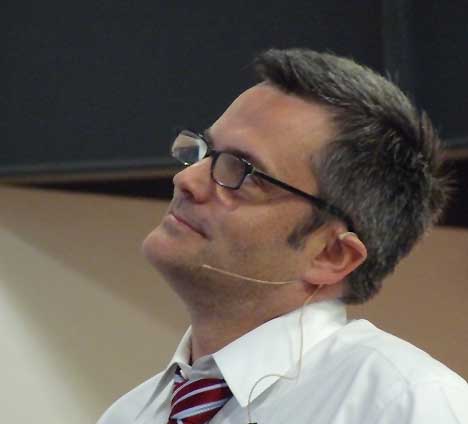
The AP is reporting that Sam Adams, our newly elected mayor is staying put amid some sex scandal I have barely any interest in other than I like living in a US city where sex scandals are kinda passé. Good for him and good for Portland. No, Adams isn't popular with all of PORT's staff or sponsors for the lies and a perception that he can be a bit "phoney" but I think this is a good development for Portland because there is work to do. Adams got elected in part because of his commitment to the arts as key to Portland's identity. Though his savvy in such things as artist live/work space and arts organizations is sometimes questionable, at least he is interested and any earlier pre-mayoral mistakes are educational opportunities. At least he has shown he is interested in listening to good and very obvious advice regarding 4.3 billion dollar bridges from PORT. Here's how we see it, PORT just doesn't care about sex scandals. We do care about art, design and aesthetics and we will evaluate him on those matters alone. Who knows, maybe a slightly humbler Adams will be a more effective mayor. Clearly he's going to have to regain confidence from a lot of people and some head scratching pet projects like the convention hotel are probably dead for now. Also, what does the mayor think about a 70 year old Portland art institution merging with a 100 year old one? LA's mayor definitely wasn't for MOCA merging with LACMA a few months ago. Also, note to the New York Times. The map you ran on Saturday is incorrect, that dot is near San Francisco, not Portland. Please make note of the correct dot in blue below. 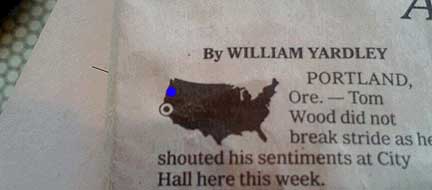
Posted by Jeff Jahn on January 25, 2009 at 23:17 | Comments (3) PermalinkThursday 01.22.09 PNCA and Museum of Contemporary Craft become one? 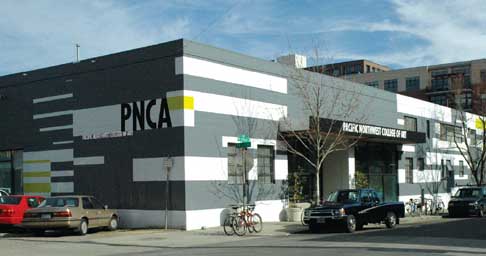
PNCA's Goodman building, one of 2008's two real estate acquisitions Isn't 2009 dynamic? maybe too dynamic. Still, Portland really can't let one of its major institutions, the Museum of Contemporary Craft, fail and PNCA still isn't quite whole yet after splitting from the Portland Art Museum in 1994 (disclosure PNCA is a PORT sponsor and I had a solo show there last April). Now this merger solution is being seriously considered by the boards of both MoCC and PNCA. My cautionary stance is thus: this proposal puts a lot of eggs in one basket and requires a lot of discipline to pull off. Put it this way, Portland loves to collaborate but it isn't great at creating well-defined (and thus fundable) institutions. Only PAM under Ferriso's tenure has really gotten things right in the institutional discipline sense and that example goes back only 2 years. 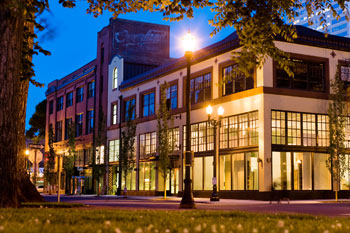 The Museum Of Contemporary Craft (photo Basil Childers) The idea of PNCA merging with (ie absorbing) the troubled Museum of Contemporary Craft has been kicking around for a few weeks and I feel cautious about this elegant solution of necessity becoming the mother of invention. For example, nobody wants PNCA to get overextended in juggling such a multinodal approach as they are already dealing with growing pains. There is a reason Reed, PSU, OCAC, PAM, PICA, L&C and PNCA don't combine into one silly Voltron like multi-robot, multi-acronym cultural monstrosity. Autonomy has advantages too, but in this case that might mean MoCC's demise and a continued hole in PNCA's progam. ...(more) Posted by Jeff Jahn on January 22, 2009 at 0:05 | Comments (6) PermalinkTuesday 01.20.09 Linking to History 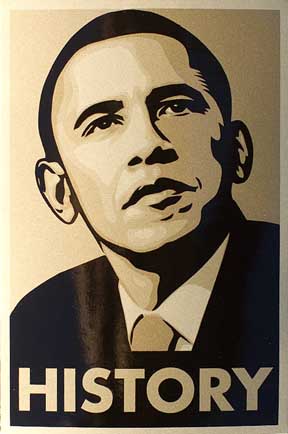 A Shepard Fairey sticker The Art of Obama blog ran the inaugural address through wordle today. It probably isn't great art and definitely pales in comparison to the actual swearing in of Barak Obama but it's interesting how Presidential words get fetished. Americans only elect extremely strong leaders when we really need them like; Washington, Lincoln, the Rooseveldts and now Obama. As a historian I've felt weve been in need of our own Marshall Plan level reprioritization of our civic, cultural and individual values. Not since FDR have we had a President that is both willing and charged with such a task by his election mandate. In a cultural context, art does best when humans reconsider their priorities and instead of the straw man and rather deserved scapegoating of Bush the art world will need to truly investigate our options more fully than the past 8 years or so have given us. Art also needs peace and a certain stability to fully flourish, may the next four years provide it... (more) Posted by Jeff Jahn on January 20, 2009 at 11:30 | Comments (0) PermalinkSunday 01.18.09 Quality Pictures Closing-definitvely  It is official, one of Portland's newest and best art galleries, Quality Pictures, will close this coming Saturday (*Update to Update - it's going to take a bit of time before anything definitive can be stated. It definitely seems like business partnership restructuring drama and the gallery is currently closed with a contact on the door). It's best to just let this play out. ...(more) Posted by Jeff Jahn on January 18, 2009 at 21:01 | Comments (0) PermalinkThursday 01.15.09 Distinguished Guests in Oregon Museums 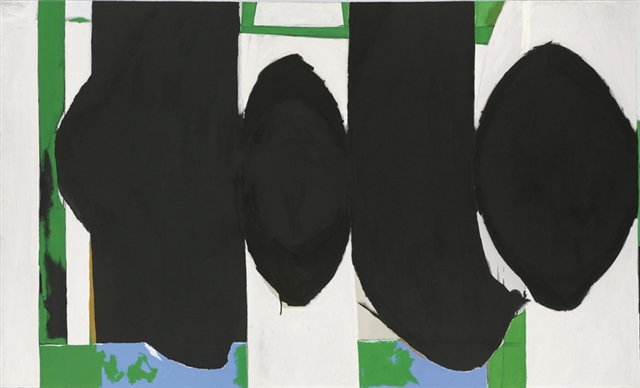
Robert Motherwell, Elegy to the Spanish Republic (Basque Elegy), 1967 Oil on canvas 82 ¼ x 138 inches, Private Collection. Location: 2nd floor, JCMCA Portland Art Museum It has been a a year or two since we've seen a nice Robert Motherwell "Elegy" at the Portland Art Museum, but this latest guest is by far the nicest one I've seen in Portland in the near decade I've been living here. In case you are unfamiliar, Motherwell... (more) Posted by Jeff Jahn on January 15, 2009 at 12:02 | Comments (2) PermalinkTuesday 01.13.09 Vogels give 50 works to Portland Art Museum 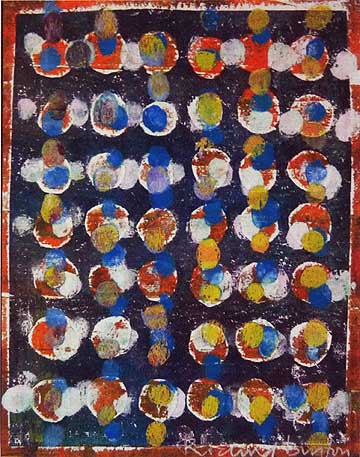 Richmond Burton, Untitled 1997, The Dorothy and Herbert Vogel Collection: 50 works for 50 States The Portland Art Museum has been given a generous gift of 50 works from super collectors Dorothy and Herbert Vogel. The Vogels, known for championing cutting edge minimalist and conceptual work are dispersing their 2500 work collection to 50 museums in 50 states. If you are unfamiliar with their story, it's worth checking out here and here. 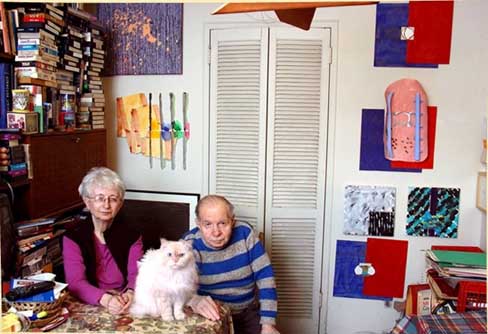 Dorothy and Herbert Vogel living within their collection The Vogels weren't wealthy and lived in a small New York City apartment, yet managed to be some of the best collectors of artists like Richard Tuttle and Robert Mangold. Among the 50 works going to the Portland Art museum is Richmond Burton's "Untitled" from 1997, it's one of his best known works (probably because of the Vogels) and dovetails nicely with the Clement Greenberg Collection, acquired in 2000. Other artists included are John Hultberg and Dike Blair. PAM's Northwest Film center will screen Sasaki's documentary Herb and Dorothy on March 28th and 29th. Thank you Herbert and Dorothy Vogel for generously sharing your personal obsession with us, may you inspire others to follow your incredible example. (PS I always love it when PORT gets a scoop simply by reading the museum's membership magazine. Posted by Jeff Jahn on January 13, 2009 at 11:41 | Comments (1) PermalinkThursday 01.08.09 Think Links Tyler Green's wonderful
remembrance of Betty Freeman illustrates the all important difference between
being a just a collector/donor and being a true patron. It's a deep... quantum level of involvement and personal investment in the artists and cultural organizations that makes a huge difference. I'm working on a historical
post that looks at influential patrons (a hot topic in Portland these days).
Randy Gragg interviewed Miguel Rosales about the two possible Willamette river bridge options. Man I miss Randy's contributions to the O, whose architecture coverage since his departure has flagged (though this piece by Brian Libby is a start... there really is no replacement for an architecture and design critic, except a full-time architecture and design critic... especially in a city where design is a major industry). Here's what PORT had to say on the new bridge designs a while back. We want new pictures of the wave design so we can more fully assess it... maybe there will be new images at Rosales upcoming talk on Monday night at Jimmy Mak's (door opens at 5)? Jerry Saltz ponders MoMA's recent sex change Yes, Ill have PORT's 2008 roundup posted by Saturday night (now that the show I've been assisting on had its wonderful opening last night... it is always art first). Here's Richard Speer's take on 2008. Posted by Jeff Jahn on January 08, 2009 at 12:25 | Comments (0) PermalinkFriday 01.02.09 First Links of 2009 Roberta Smith looks
at an artist who turned obscurity into art. What this says to me is the
art world is looking to challenge the current cannon of noteworthy names...
again (I think this recent spate started with the rediscovering of Lee
Bontecou and James
Lee Byars).
Artnet had a good overview for the art world in 2008 here. The O has posted their 2008 roundup... I'll have PORT's very detailed, multifaceted roundup posted soon (I'm helping install a very technically demanding show). PORT's analysis should give everyone something meaty to chew on. Posted by Jeff Jahn on January 02, 2009 at 10:06 | Comments (6) PermalinkThursday 01.01.09 Last Weekend Ok it's 2009, but it is also the last weekend for these four interesting shows
held over from 2008.
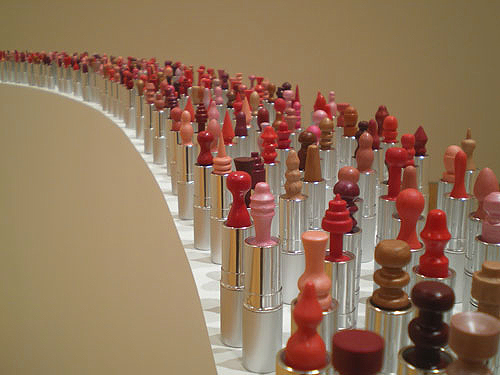
Livia Marin, Form Follows Variation The Museum of Contemporary Craft's Manufractured. There are a lot of highlights in this massive group show, including Regis Mayot and Jason Rogenes (a personal favorite). Show runs through January 4th (it's free too but consider becoming a member) ...(more) Posted by Jeff Jahn on January 01, 2009 at 17:11 | Comments (1) PermalinkTuesday 12.30.08 Looking back at 2008 on PORT 2008 may be the year that most everyone I know can't wait to leave behind but
it was easily PORT's best year ever. Tomorrow I'll post PORT's annual year in
review.
Till then, here's a list of just a few of our standouts from 2008: Arcy and I interviewing Brad Cloepfil in a marathon 2-part art and architecture geek fest... we kinda good cop/bad cop'd him but the man is a aesthetics machine Arcy's interview with Ed Ruscha, AKA the world's greatest living painter Ryan's interview with Storm Tharp, ending with the most intriguing hamburger discussion of the year Amy's critical takedown of Ethan Jackson's Couture show at NAAU My review of Paul Sutinen at 9 Gallery Arcy's historical piece on Donald Judd at the PCVA... uncovering an important show in Judd's development. Arcy's review of Robert Rauschenberg's final works at Bluesky My review of the Contemporary Northwest Art Awards Megan's heartfelt review of Jim Lommason's Exit Wounds at NAAU Arcy's digestion of Shiro Nakane's lecture at PNCA My interview with Fritz Haeg at Reed College Alex's interview with Garth Clark Amy's review of Video Gentlemen at NAAU (see a trend here, the Couture series has been a critical favorite) My review of Keith Boadwee at Rock's Box My review of Jacqueline Ehlis at NAAU Arcy's essay on Barnett Newman's 18 Cantos Megan's tough but fair analysis of Disjecta with some very constructive advice... which happily seems to have gotten through My analysis of PAM's new direction with Brian Ferriso My review of Gertrude and Otto Natzler at MoCC Amy's interview with Jonathan Lasker.... this is a clinic on how to do a smart, informed interview for an art audience. My analysis of the I-5 Columbia River Crossing, AKA the 4+ billion dollar bridge Ryan's interview with MK Guth Arcy's interview with Vito Acconci So please bear with me, it's time for me to be "The Publisher" and toot our own horn: ...(more) Posted by Jeff Jahn on December 30, 2008 at 13:53 | Comments (3) PermalinkTuesday 12.23.08 Yes Virginia there is a MOCA in 2009 Great news,
MOCA will survive as an autonomous institution... when it is Govan vs. Broad,
Broad
always wins. Also, why is there even a Govan vs. Broad dynamic? It isn't just
that Broad has the money, it is that he is a smart donor who forces institutions
to do the right thing. It takes involved and principled donors, not just people
who write checks. I can also add that it's way easier to deal with the Broad
Foundation's press office than MOCA's.
I think Tyler's analysis is spot-on. No need to duplicate it... here's what we had to say earlier. Posted by Jeff Jahn on December 23, 2008 at 8:59 | Comments (0) PermalinkFriday 12.19.08 Snowy Hopes 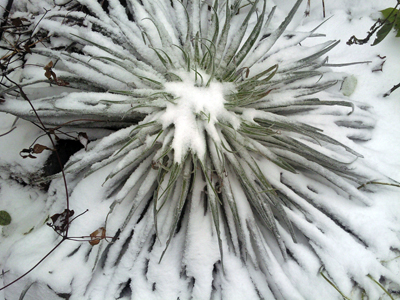 Snowy Portland 2008 Before the calendar takes a break for the holidays, I wanted to share a little good news from the RACC. They have collected record funds to award in grants in 2009 to artists, nonprofits, and arts education. Eloise Damrosch, executive director of the RACC, reminds us that supporting the arts is essential to the health of the community in difficult times: "Without question, artists and arts organizations make our community a better place to live, and they need our support now more than ever. Just imagine what it would be like if we didn't have the arts to get us through this difficult time; the arts bring us together, to challenge and entertain us. The arts give us hope." Enjoy the snow, I'll be back December 29. (PORT will still be updated but have more sporadic posts during the holiday week) Posted by Megan Driscoll on December 19, 2008 at 11:30 | Comments (0) PermalinkYour morning MOCA It looks like MOCA is going to be saved (in the most culturally responsible
way), here's the LA
Times report. It looks like director Jeremy Strick might be out.
Here's Tyler Green's take. PORT had this to say initially about the whole situation. 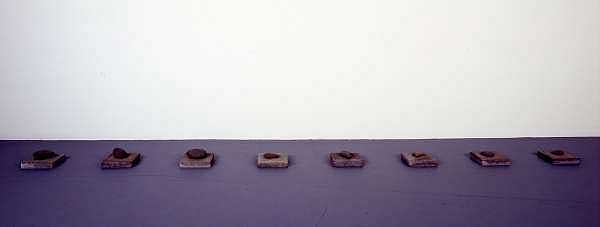 Carl Andre, 8 Blocks and Stones, 1973 Concrete blocks and river stones (from Portland), Each: 11 1/2 x 11 3/4 x 3 1/2 in. (29.2 x 29.8 x 8.9 cm) The Museum of Contemporary Art, Los Angeles The Barry Lowen Collection 85.36 Later, we visited Michael Heizer's iconic Double Negative, part of MOCA's awe inspiring collection... which also includes a portion of the piece Carl Andre did for Portland's equally awesome PCVA back in the 70's. May MOCA avoid the PCVA's fate... this is encouraging. Posted by Jeff Jahn on December 19, 2008 at 11:08 | Comments (0) PermalinkFriday 12.12.08 Thank You Terry Posted by Jeff Jahn on December 12, 2008 at 10:05 PermalinkThursday 12.11.08 Terry Toedtemeier passes away 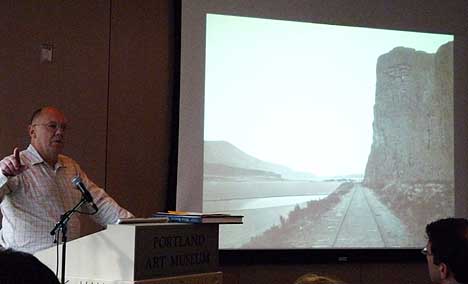 Terry Toedtemeier speaking at the Wild Beauty press conference PORT is extremely saddened to report that Terry Toedtemeier, the Portland Art Museum's indispensable curator of photography has passed away. More details to come but his life's work can be seen in what I consider to be the year's most important show, Wild Beauty. He died last night and collapsed while speaking in Hood River about the Wild Beauty show. Also, he had a recent history of heart problems. It is a terrible and tragic loss, he had such a sweet presence that was coupled with an utterly contageous passion for photography, geology and life. We will all miss him and our thoughts are with his family and loved ones. The community has lost a giant but we gained immeasurably through his efforts. ...(more) Posted by Jeff Jahn on December 11, 2008 at 10:03 | Comments (5) PermalinkTuesday 12.09.08 Tweet & more Miami photos Yes, PORT has been twittering for a bit... alerting you to our more substantial posts and other more behind the scenes things.
...and it makes sense that a text artist like Jenny Holzer would really make good tweets. and I just updated our 2008 Miami art fair photoblog Posted by Jeff Jahn on December 09, 2008 at 10:29 | Comments (0) PermalinkMonday 12.08.08 Overreacting and Underreacting Last night I really enjoyed Morley
Safer's interview with Julian Schnabel on 60 minutes... mostly for the artists
hilarious meltdown over what Robert Hughes wrote years ago. First Schnabel was
offended that Safer even brought his nemesis up. Then Schnabel wouldn't drop Hughes as the subject.
(tsk tsk, overreacting to a critic is a telling sign of massive insecurities and
a more self aware artist knows how to take a punch...). As far as press goes Safer
is a pretty pleasant interviewer... why get all Khan vs Kirk with him, why attack
Safer so personally as a proxy for Kirk (erm I mean Hughes)? Still, I admire Schnabel
as a film director (though all the footage which was lost then resurfaced in
Downtown 81 certainly
laid the groundwork for Schnabel's own Basquiat
film) but as a painter he's a second or 3rd rate practitioner compared to his
contemporaries Basquiat and Anselm Kiefer. Still I need to see his latest film The
Diving Bell and The Butterfly.
Yes, the calls to action for saving MOCA (and calls for new leadership) as an autonomous institution keep growing. Here is the new non-facebook mobilization page. Posted by Jeff Jahn on December 08, 2008 at 11:52 | Comments (2) PermalinkThursday 11.27.08 Infiltrating the holiday 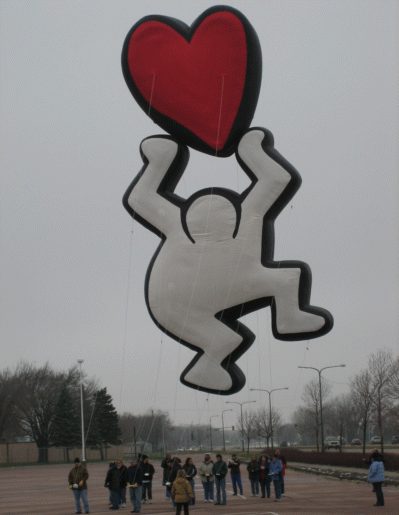
I always enjoy it when an artist sucessfully finds a way to infiltrate more mainstream events and Keith Haring's balloon, (Untitled) Figure with Heart, in today's Macy's Thanksgiving Day Parade gave me reason to watch a little bit of the otherwise very top 40 spectacle. It continues Macy's Blue Sky Gallery Series of contemporary balloons, you can watch it here. Often, I find post-mortem work like this problematic but Haring had expressed an interest in this before his untimely demise. Also, someone like Paul McCarthy would make it a parade to remember for sure! Posted by Jeff Jahn on November 27, 2008 at 14:49 | Comments (0) PermalinkWednesday 11.26.08 Saving MOCA Tonight Tyler reports that MOCA's board is gonna gather tonight with the purpose solidifying MOCA's vulnerable position. They may dine together as a group, but the whole affair is about not eating crow.
Here is an online petition so you can voice your support for MOCA. Posted by Jeff Jahn on November 26, 2008 at 9:50 | Comments (0) PermalinkTuesday 11.25.08 Linkage Dave
Hickey amusingly addresses the excesses of 2007's Freize and Art Basel Miami
Beach art fairs in Vanity Fair.
Jerry Saltz discusses the latest from Cindy Sherman. The recently unveiled Powell's redesign isnt that good. cmon... a building housing that many architecture and design books just can't look like a suburban strip mall in Northbrook Illinois! Posted by Jeff Jahn on November 25, 2008 at 13:40 | Comments (1) PermalinkMonday 11.24.08 MOCA & Broad recap In case you missed it Eli
Broad tabled an offer to save MOCA, frankly the LACMA
idea just never made any sense.
Tyler digested Broad's offer here. Eli broad takes a lot of heat but he has done a lot of good for LA and for that matter Portland too. It is interesting that board members of a very important institution are being held to task.... also a heads up, PORT's Arcy Douglass was out at Double Negative (part of MOCA's collection) a few weeks ago and his post on it will be up in an hour. Posted by Jeff Jahn on November 24, 2008 at 9:57 | Comments (0) PermalinkFriday 11.21.08 Before the weekend 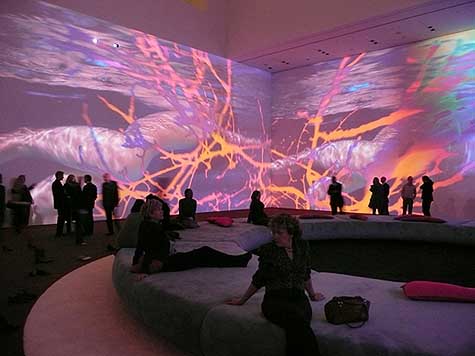 Pipilotti Rist's Pour Your Body Out (7,354 Cubic Meters) @ MOMA It looks like Pipilotti Rist is the first artist to fully make use of MOMA's newish atrium's scale. That figures, it isn't a major step forward for her in scale but it is an exciting step for MOMA... whose atrium has dominated formerly enormous Monets etc. Tyler is focusing on the singularity of MOCA's superb collection and he also points out there is now a facebook page for the saving of MOCA. Here is Artnet's coverage of MOCA's excellent Kippenberger show. Posted by Jeff Jahn on November 21, 2008 at 10:37 | Comments (0) PermalinkWednesday 11.19.08 MOCA's troubles & uncertain fate  MOCA Tyler's post on MOCA's fate is the must read art news post of the month. He's right, in my mind MOCA has supplanted The Walker, The Guggenheim and The Whitney as the world's most cutting-edge art museum programmatically. Speaking of cultural mergers, I don't think the Guggenheim is in any position to merge with them as their LA satellite. Overall, with a dwindling endowment and no recent expansion or capital campaigns one wonders at the strange lack of ambition in LA (a place with no shortages of such). Here's the LA Times on the subject. I might add more to this later today, but it is uber-odd that such a major institution would be facing such last ditch decisions... of course cultural institutions should raise alarms when they are in trouble but if they look confused it doesn't help. It does help that MOCA's progamming warrants saving. *Update: Christopher Knight's "seething" open letter says quite a bit of what needs to be said, earlier this year PORT's look at PAM showed the alternative strategy. The lesson.... endowments protect museums and more specifically, the nature of the endowment (not merely its size) often defines an institution. The talks of a merger between LACMA and MOCA also seem terribly strained to me... MOCA losing its excellent collection also clips its wings for any future growth, branding it as a failed experiment. Like Knight stated, the first steps are a staff reduction as a good faith move then they need a bridge loan and a smart capaital campaign. Punting on MOCA is bad for LA, and the entire US... how about a bridge loan from the city rather than a weakened (merged) MOCA? *Updated reactions: FBC Jeremy Strick's initial response Posted by Jeff Jahn on November 19, 2008 at 10:17 | Comments (0) PermalinkTuesday 11.18.08 Long Term Thinking Finally, there will be a new Sol
LeWitt wall drawing retrospective... which will be on display for 25 years.
PNCA has a new Vice President for College Advancement (fundraising), Deborah Hopkinson. With 20 years of experience with OSU etc. she is a smart move. In 2 years PNCA takes over the 511 building from the government and their 32 million dollar centennial campaign will need a very steady hand using long range planning for major gifts during these difficult financial times. The campaign should be in overdrive by the time the economy is crawling out of the anticipated slump for the next year or so. 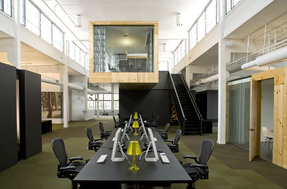
Skylab's Root Award's winner (office space) for North Portland Architecture discusses Portland Spaces Root Awards for design. Sorry, but I can't help making some weak pun about how design has been putting down ever deeper roots in Portland. See the first Root Awards here. Overall, I'm still mulling over my reaction to the awards... they were a lot like the first Contemporary Northwest Art Awards, not bad... but not a revelation either. The important thing is that awards enhance a sense of achievement by spotlighting it, that is what cities do... they give talent a platform. Awards are a type of recurring platform. Now if only the O would stop turning editors into writers and hire an achitecture and design critic... the single most important writing job in the city can't be left to freelancers because follow-through is key! Posted by Jeff Jahn on November 18, 2008 at 10:50 | Comments (0) PermalinkTuesday 11.11.08 Linking and thinking The similarities between Michael
Heizer's Rift and Daniel Libeskind's Jewish Museum in Berlin are striking...
though it is a somewhat fractal form and the commonalties shouldn't surprise
us, fractals repeat even when we think its human creativity at work.
Peter Schjeldahl looks at both Franz West and Mary Heilmann. I'm continually impressed with West but Heilmann (whose show I saw at OCMA) is frankly pretty uneven and not that surprising. Throw in Chris Johanson, Rachel Harrison and Carol Bove and there is a real case for a Paul Klee fanclub revival going on as of late. The Oregonian gives more details on the downsizing at the Museum of Contemporary Craft (a PORT sponsor). All of this just seems like prudent preparation much like the direction the Portland Art Museum undertook last year (another PORT sponsor). One big problem though is the lack of an endowment, it's tough to be a true museum without an endowment. Only once they have an adequate endowment can the MOCC transition fully from a sales gallery with an exhibition program into a full museum. It is also worth reminding everyone that the MOCC's supporters still have significant means and the museum shouldn't water down great programming like the Natzler show or the more contemporary lexicon in Manufractured. Still, MoCC needs both types of shows (classic and experimental) to remain valid... Our Garth Clark interview makes that necessity as plain as can be.... and it is also why curator Namita Wiggers is the most necessary person at the institution. She brings their programming to the museum level, now they need an endowment that matches the curatorial seriousness. Wiggers is simply one of the best curators in her field and key. Ill have something on Portland's creative economy soon, there are sobering facts that everyone already seems prepared for as well as some serious opportunities. In general, Portland typically gains a lot of entrepreneurial talent during recessions. The Portland Art Museum finally has a new website. It might not win awards but it is a step up from the vintage 1998 look. Posted by Jeff Jahn on November 11, 2008 at 11:09 | Comments (2) PermalinkFriday 10.31.08 Friday Links Roberta Smith has an interesting piece on theanyspacewhatsoever
show at the Guggenheim, rightly questioning why it is comprised of, "a
group of the usual suspects," who seem to show up in blockbuster contemporary
museum shows frequently. Looks like a fine show that we've seen many times before
in London
and even Portland
way back in 2000. Maybe with "Change" being the active term in
this election cycle the art world will be forced to find some new names in the
Post-Bush era?
Also in the NYT's Holland Carter calls Miro an artistic "serial murder"... I don't buy that, he seems more like a satirist of human ideologies and habits... kind of the Steve Martin of Spanish modernists, it's definitely physical comedy with a flair for the philosophical. Miro's work could have easily said, "Wellllllll EXC-ccc-CCC-UUUUUSE MEEEEEEEEEEEE!" while wearing an arrow through the head hat while playing the banjo. A lot of so called "balanced" journalists try to make it seem like the sky is falling (panic is good for selling dead trees... hmm?) so it's good that Tyler Green pops a few of the WSJ's doom balloons in his discussion of museum economics in these erratic financial times today. (I'll discuss local economics next week) To be sure some institutions are going to be challenged (especially SAM which partnered with Washington Mutual) but institutions like the Portland Art Museum saw this coming (and likewise so did most of their major patrons). Posted by Jeff Jahn on October 31, 2008 at 10:10 | Comments (0) PermalinkTuesday 10.28.08 Reading between the bridges 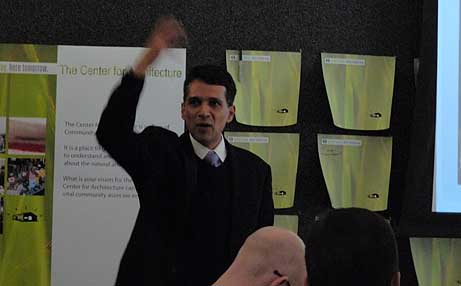 Bridge architect Miguel Rosales @ AiA Portland Architect Miguel Rosales Urban Design Board presentation at AIA's Portland HQ's today was interesting... and it should be, it was about the new light rail and pedestrian bridge across the Willamette weve been following. The meeting wasn't about revealing anything new about the design or process, it was more of a "read between the lines" moment and getting a measure of the architect and project. Here's a PDF that details where we are now and covers most of the presentation today. What came out "between the lines" was this: 1st priority is following all of the federal guidelines... (more) Posted by Jeff Jahn on October 28, 2008 at 21:52 | Comments (1) PermalinkTuesday 10.21.08 Tuesday Links In a kind of victory for serious blogging, Christies
just used PORT's interview with Ed Ruscha as reference material for a lot. You can read Arcy's Ruscha
interview that was sourced, here.
Roberta Smith reported that the Frieze art fair has chilled, but the international art market hasn't been frozen solid yet. Best Of in Seattle has a mighty fine art blog and likes pointy murals. And this is just completely awesome. Posted by Jeff Jahn on October 21, 2008 at 17:06 | Comments (0) PermalinkFriday 10.10.08 Market Schmarket Links 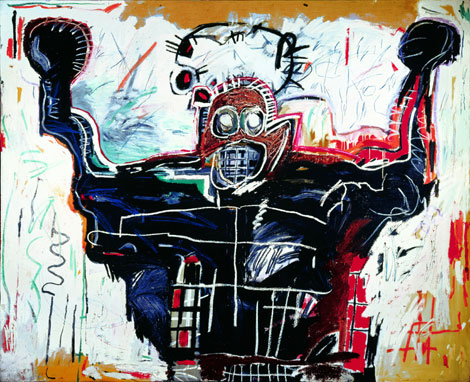 Basquiat's Boxer Metallica drummer Lars Ulrich is selling his excellent Basquiat "Boxer." My favorite part of this NYT's piece is Lar's quote, "It’s perhaps the last frontier where the best of the best will not go the way of the rest of the economy.” Is it possible that improbable quality and artistic dedication are recession proof? ...well I think it only holds true for "Basquiats", not lighter weights like Matthew Day Jackson. Sure he's sincere but he isn't that perceptive or poetic. My take is that Basquiat is on another level and his values will probably only improve. Other proven, transcendent artists (Justine Kurland, Chris Johanson) will transcend this financial crisis and those that follow art market trends will follow broader financial market trends. Also, in the NYT's Roberta Smith explains why Elizabeth Peyton matters. I concur, seriously at what time were beauty and youth not worthy of our attention? Peyton transcends the stupider tabloid stuff in the media and exemplifies why we find young and beautiful people perpetually fascinating. At Peyton's best, she gives her subjects a grace and existential fragility they never really had but for a moment. Some think this is slight but it's like arguing against flowers, you can do it... but at the cost of acknowledging you might have a dead black heart. Frankly I find viewing a Peyton painting more satifying than TMZ's celeb gawking. Finally, Tyler and I disagree about Peyton. It seriously freaks me out that we both like so many of the same artists like Clifford Still, enjoy tennis, blogging and kick ass architecture etc. Maybe it's our Midwestern/West Coast roots? Also, check out Jen Graves WACK post. Though I find the ads at the left that state, "find your inner slut," a bit incongruous with the post. Posted by Jeff Jahn on October 10, 2008 at 10:41 | Comments (0) PermalinkMonday 10.06.08 Monday Links C-Monster says cruise ships are, "Like
Lautner. Only blingier."
Dracula Vs Eisenstein points out a nifty advertisement for Wario Land on Youtube. Nice shake up of spatial configurations. Salvatore Reda has started a new blog, "Always, Forever, Now" anthologizing art related stories in the press. Jerry Saltz thinks Martha Rosler is stuck in the 60's. A lot of collage art has this problem. Listen to PAM curator Terry Toedtemeier talk about Wild Beauty on OPB with a link here, a great interview. Wild Beauty is THE must see show for anyone who loves photography or nature on the west coast. Posted by Jeff Jahn on October 06, 2008 at 11:36 | Comments (0) PermalinkThursday 10.02.08 Primer and welcoming committee for Reversed Reality As Megan mentioned earlier Reversed
Reality opens tomorrow and Worksound plays Portland host to 5 of the 6 artists.
Here's a little primer on the artists from Hong Kong and Senegal. I'm certain youve seen some of these artists at recent Portland openings but let's give them a big Portland welcome tomorrow.
When I spoke to them today, the four artists from Hong Kong, all thought Portland had a young art scene with a more relaxed attitude than Hong Kong... focusing more on the work rather than purely career driven pursuits: 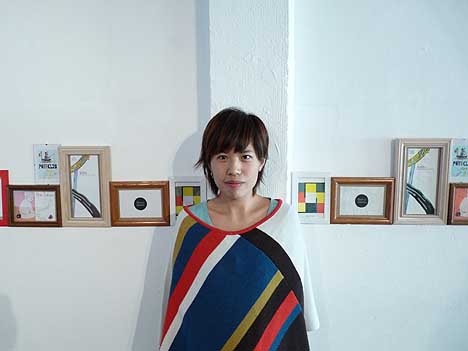
For this piece, Doris Wong collected postcards from Portland art events and assiduously copied each of them. Wong's copies are on the right, the originals are displayed on... (more) Posted by Jeff Jahn on October 02, 2008 at 16:16 | Comments (0) PermalinkFriday 09.26.08 Cloepfil's 2 Columbus Circle 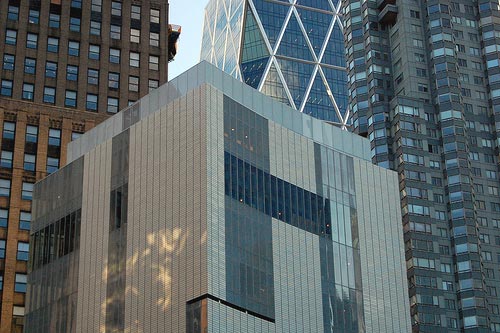 Cloepfil's MAD @ 2 Columbus Circle amongst its neighbors. Photo Michael Paul Oman-Reagan Brad Cloepfil's incredibly contentious 2 Columbus Circle opens tomorrow and the NYT's gives it some pretty faint praise along with a fair amount of criticism. Personally, I feel the project flies in the face of all these highly performative and histrionic buildings architects have been putting up lately and that is bold in a different way. The real question is how does it reframe the Columbus Circle and how well do its galleries work? It just seems like everyone wanted this thing to do a jig but what Brad has done is create a more useable and subtle building. I think there is room for subtle in New York. The architect aquits himself well in this interview from Architectural Record at Business Week's site. Also, check out part 1of PORT's interview with Brad Cloepfil and get ready for the super massive part 2, it's the longest interview we've ever done and I hope to have it up very soon so check back. Posted by Jeff Jahn on September 26, 2008 at 10:43 | Comments (0) PermalinkWednesday 09.24.08 The Henry announces The Brink art award The Henry in Seattle has announced The Brink,
a biennial art award (funded by the Behnke's) that will go to a single deserving
artist from Oregon, Washington or British Columbia. Similar to the CNAA's
it will take nominations from local art worlders. Check out the details at The
Stranger. I'm particularly tickled that they are including Canada in the mix.
Art awards galvanize a more civic discussion over an artists work as well as the
region's overall support for interesting new art, so you can never really have
too many art awards.
Posted by Jeff Jahn on September 24, 2008 at 14:28 | Comments (0) PermalinkTuesday 09.16.08 Jennifer Gately Resigns Word has it PAM's first Arlene Schnitzer Curator of Northwest Art, Jennifer
Gately has quit. She certainly has had a challenging role to fulfill (bridging
historical and contemporary concerns) and PORT thinks her record of mostly positive
reviews here says it all... it certainly gives an accurate picture of what kind
of curator she is. Also her recent re-install of the Hoffman galleries is spacious and uncluttered (if only the rest of the collection were the same... I hear a re-install is coming). Her eventual replacement will inherit an exciting and
challenging situation in one of the country's most active art scenes.
Here are our reviews and other posts in chronologically descending order: 2008 Contemporary Northwest Art Awards Jenene Nagy Marcus Rothkowitz ...a painting that should be in the collection Wes Mills Chris Johanson Roy McMakin 2006 Oregon Biennial Posted by Jeff Jahn on September 16, 2008 at 17:30 | Comments (1) PermalinkMonday 09.15.08 Crap art, condos, wind towers and green art Donald Kuspit considers the history
of shit in art.
Despite the crashing stock market today there will be new condos by HdeM and OMA in NYC... both have already broken ground and something tells me the people who already bought their penthouses will still be able to afford these. Funny how NYC can get cool condos by HdeM and Koolhaas but hasn't been capable of realizing museums designed by these two topnotch talents. Architecture is always defined by the client and though I'm sure the condos will be nice... no high density residential design can hope to take very many chances... and certainly not as many as a museum project could conceivably afford. Portland Architecture discusses a potential 600 foot observation tower in Portland's city's center (it is also a wind power generator). I want to see pics ASAP... this could be great if the design is up to snuff (an icon of Portland's new and bolder commitment to a better way of living) or tragic if it isn't. *Update Brian Libby has published the images and weighs in. Also, Randy Gragg of Portland Spaces has interviewed the developer. In a related post Edward Winkleman explores the effect of global warming on art and design. Posted by Jeff Jahn on September 15, 2008 at 10:54 | Comments (0) PermalinkFriday 09.12.08 Hirst's Castle Yes, I'm still on the road but we will have a great review for you saturday. Plus I have reviews of Jeff Koons at the MCA, an interview with one of the most exciting young artists today, then there's part II of PORT's interview with Brad Cloepfil (here's part I) and a round robin of exciting museum shows in the Midwest. Dang that is a lot of stuff... Plus PORT's other writers are covering Portland.
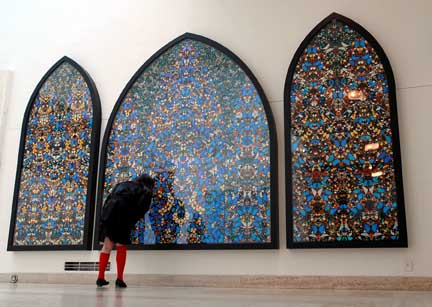 Damien Hirst's The Kingdom of The Father at PAM last Fall To tide you over Tyler Green considers some of the latest Hirst coverage in Time. My take, "journalists" are primarily a knee jerk reaction in the written record and they are probably pretty sick of having Hirst jerking them every month for the past 15 years. They are kind of addicted to him but nothing they say about him changes anything anymore... so it feels like everyone is on automatic pilot and everyone feels a little used. I'm a historian so I don't have the twitchy fingers of a journalist... so I'll make this historical prediction, Hirst is going to be THE artist of the 90's and likely the aughts as well. Sure not all of his work is great but a great deal of it is very good compared to the rest of Chelsea's best fare. My favorite stuff was in the 90's (way better than Matthew Barney in the aughts) but I still think he turns out enough good work to take seriously now... just like Koons he's in it for the long haul and has entered that point where he's competing only with himself. Hirst is still the artist who best exemplifies our age. Life, death, Pop, minimalism, media tweaking/manipulation etc... he has it all. Including a penchant for avoiding museums. For more Hirsting here is Arcy's review of Hirst's show last year at PAM and my review of a then newly unveiled Hirst in a group show at PAM. Posted by Jeff Jahn on September 12, 2008 at 9:56 | Comments (2) PermalinkTuesday 09.09.08 Tuesday links I'm in beautiful Des Moines Iowa, home of the fantastic Des Moines Art Center and Ill have some things for you later today and tomorrow. Till then here are some links.
Jerry Saltz takes a look at the somewhat indecisive curatorial directions of MoMA and the Guggenheim... with some analysis on how it might change with new leadership situations. The Capital A art blog from Glass Tire has a pie graph of geographical distributions for the Texas Biennial. Ahhh some things never change, like the statistical analysis of survey shows. Posted by Jeff Jahn on September 09, 2008 at 9:13 | Comments (2) PermalinkFriday 09.05.08 Friday links I'm traveling right now but I'll have several posts for you in the next two days, including a review this weekend. I've already seen an incredible show called Sensory Overload in Milwaukee and I've yet to make my way through Chicago etc. Till then check out:
Holland Cotter's take on official Chinese propaganda art Time's interview with Ann Temkin, MoMA's new chief curator of painting and sculpture It's nice to see the WWeek doing artist interviews again and the recent interview with Sean Healy is hopefully the sign of more to come. Here's PORT's review of Healy's last solo show for comparison's sake. Posted by Jeff Jahn on September 05, 2008 at 9:30 | Comments (0) PermalinkMonday 09.01.08 A lil reading The Guardian got
ambushed at the Rothko Chapel.
The NYT's reviews Looking at Music at MoMA... does anybody question Bowie's influence musically or visually? ...or is that something only his kid's might be able to do? Peter Plagens has published first two installments of his on line novel The Art Critic on Artnet. Posted by Jeff Jahn on September 01, 2008 at 19:01 | Comments (2) PermalinkThursday 08.21.08 Do The Gallery Shuffle For those who thought it was all gloom and doom when Motel and Small A galleries closed they didn't know that two new galleries run by two of Portland's smartest redheads were opening:
Fontanelle gallery and Fourteen30 (which we mentioned last week) both open in September Fontanelle is run by Leslie Miller, a former Artforum staffer who has been helping Stephanie Synder out at Reed. We are happy to see that her first show, which opens September 4th features one of Motel's best artists Meg Peterson and one of my personal faves Shanon Schollian. It's in Chambers old space. Chambers is moving across town. Fourteen30 is opening September 26th in the old Savage/Small A space. Posted by Jeff Jahn on August 21, 2008 at 19:02 | Comments (0) PermalinkWednesday 08.20.08 Make links not war Zaha
Hadid's design for a house in Moscow reminds me of her ski
jump in Innsbruck in addition to Olympic platform diving. It also seems a tad silly like Robotech in real life.
OpenwidePDX is a new photoblog focusing on Portland art scene openings. Steve Ditko was in the NYT's book review... nothing could be more deserved both for its praise and damnation. Peripheral Vision discusses honesty and fakery and their tenuously negotiated relationship to visual media. Posted by Jeff Jahn on August 20, 2008 at 13:07 | Comments (3) PermalinkFriday 08.08.08 Friday News The big review is coming saturday morning (what a beast to write... it's basically a checkup on the state of abstract art). Till then:
The Guardian has a slideshow of Richard Serra's latest exhibition in London. David Cohen discusses the Cy Twombly Retrospective, also in London. Douglas McLennan has a great article on why newspapers are failing. Tyler reported that Richard Diebenkorn (who was born in Portland but moved at age 2) will finally have an Ocean Park series retrospective. New Gallery news: Jeanine Jablonski (who has been working for Elizabeth Leach and created GLARE quarterly) is opening a new gallery fourteen30 in the old Small A/Savage space (watch this site). First show in September will feature the work of Los Angeles based artist, Devon Oder, Breaking Light. Besides national, local and international artists (is there a difference anymore?) she will focus on art publications. Posted by Jeff Jahn on August 08, 2008 at 10:30 | Comments (0) PermalinkMonday 08.04.08 Must Read and OPB Peter Schjeldahl's latest
piece is a Must Read. It's one of those rare occasions where the critic's
analysis of the show is more worth while and telling than the exhibition
itself. The long and short of it is, the second artists start making gestures
at becoming very serious again we suddenly expect the work to transcend all
of the museum blockbusters and art fairs that have lowered the level of expectations
for art during the past decade. Finally, PS has taken on younger artists instead
of his typically brilliant laurel wreaths for the likes of Bruce Nauman and
Ed
Ruscha. We know those guys are good, what we want now is a new crop with
a similar level of rigor and achievement.
On a more regional level (but not strictly so), I'll be on Oregon Public Broadcasting's Think Out Loud tomorrow at 9:00 AM with curator Jennifer Gately, Dan Attoe and Richard Speer to discuss the Contemporary Northwest Art Awards and their impact on the regional art scene (though artists like Attoe have pretty bitch'n international careers already so it opens some complicated and impossible to categorize discussions of regionalism in an internationally decentralized art world). Posted by Jeff Jahn on August 04, 2008 at 17:01 | Comments (0) PermalinkMonday 07.28.08 Monday Links: Artvergnugen? The New York Times Sunday Book Review did
its thing on Erin Hogan's book, "SPIRAL JETTA A Road Trip Through
the Land Art of the American West. " It is a cute title that in its own
irreverence reifies a certain reverence for these often not so roadside attractions.
I got a kick out of Vanderbilt's review and the book itself is probably targeted
for the overeducated who haven't spent much time alone in a car and suspect
they are missing something of the American experience (they are).... it's no
wonder the Jetty is replaced by the Jetta. Artvergugen?
Holland Cotter takes on the expected onslaught of summer group shows. The funny thing about Portland is we have a lot of good solo shows in the summer. We get a lot of Bay Area and New York tourists during July and August so it's worth putting on good solo shows. BS Houston has had it with Red Bull. How does this compare to BMW's art cars? Posted by Jeff Jahn on July 28, 2008 at 10:43 | Comments (1) PermalinkFriday 07.25.08 Growth? 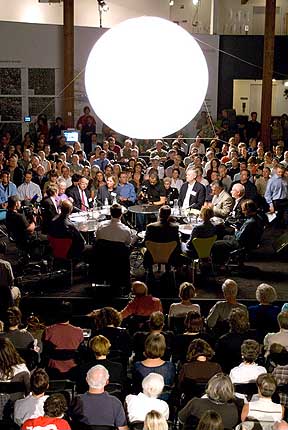 PNCA's PDXplore#2 on July 22nd 2008 In case you missed it like me, here is a transcription of last Tuesday's PDXplore discussion at PNCA. Ahh the question is... will Portland grow a pair or simply take a prophylactic approach to the coming population surge? Eunuch is eunuch... no more complacency ok? Portland isn't defined by Portland's past... it can only direct those redefining outside forces. Posted by Jeff Jahn on July 25, 2008 at 13:25 | Comments (2) PermalinkMonday 07.21.08 Monday Links Guernica
suffered a lot of wear and tear during it's travels... but this time the
condition report has a political angle. IMHO, Guernica and Jimi Hendrix's Star
Spangled Banner are the two most successful pieces of political art ever.
Powerslice enjoys some cool things. Edward Winkleman is clamping down on his comments... in the past his site has had some of the most lively debates about art in his comment section, but lately its gone south. It's true, moderating comments is a drain on time but there is an interesting dynamic to having reader feedback; it often reveals more facets to the story. About this time last year I was seriously considering removing comments altogether from PORT but after a period of clamping down I think people have gotten the gist... strong opinions are fine but no personal attacks. Last but not least mayor elect and current transpo comish Sam Adam's liked my post on a better bridge design. A lot of other people did too. My post was simple common sense from an aesthetictician, with the added power of some decent pictures. Even the Oregonian's editorial board has started to play catch up (Calatrava is good but we need something more radical like Hadid, UN Studio etc., Calatrava has already peaked and less likely to reinvent the bridge for the 21st century... he already reinvented it for the late 20th.). Actually what the O really needs is an architecture critic. Hire Brian Libby, simply using him freelance isn't enough, it's the difference between a personal body guard and a rent a cop... for the O to do it's job during this major design upheaval in Portland it needs someone who would take a bullet. Randy Gragg did heroic things like insist on a design competition for the Tram. BTW that's exactly what we need for the I-5 bridge, scrape together a couple of hundred grand and invite Hadid, UN Studio, Foster, Cloepfil, Toyo Ito and Monolab etc. The ideas and buzz it will generate will be more than worth it, giving the finalist and all of us a much better bridge. If an architect from outside the area is chosen no big deal, most big jobs have a local firm partnered as well. Posted by Jeff Jahn on July 21, 2008 at 10:59 | Comments (12) PermalinkSaturday 07.19.08 Rearranging at PAM: Newman, Murakami, Dunham etc. 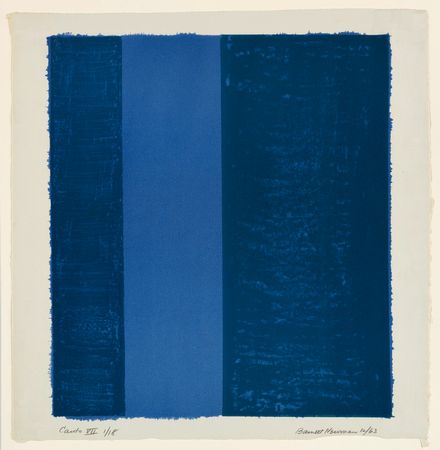 Barnett Newman's Canto #7, full set on display now The Portland Art Museum has shuffled more than a little bit around with some very distinguished guests including Barnett Newman and Andy Warhol (a more sweeping rehang of the nearly 3 year old Jubitz Center for Contemporary Art should be expected an a year or two). Also, There's the new Marc Dombrosky show at Apex (I found it underwhelming; crafty sewing + human desperation has been done with more legitimacy and personal investment by Tracey Emin). Check it out though, it's kinda fun to sharpen one's teeth on (BTW what's with all the attention paid to weak examples of Seattle art at PAM lately?). That said the Contemporary Northwest Art Awards and the awesome Ed Ruscha show are absolutely worth a trip, even from out of state. Besides the programming you gotta check out: A complete set of Barnett Newman's 18 Cantos 1963-64. These are no ordinary prints, this is a complete set of the most important prints in the last 108 years. Simply sublime, they are fittingly are on display in the Greenberg room of the Jubitz Center beneath the Calder. Ursula Von Rydingsvard's P's and Q's is a compelling addition to PAM's strong sculpture collection (nice that PAM has made a point of collecting from artists in its two solo show exhibition series). There is also a tiny Andy Warhol shadow painting on the third floor of the Jubitz center. Other things worth ferreting out:...(much more) Posted by Jeff Jahn on July 19, 2008 at 14:20 | Comments (0) PermalinkFriday 07.18.08 Disjecta: Rematerializing? 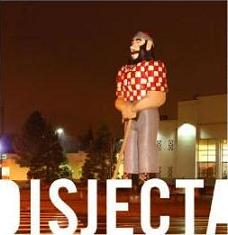 It's Disjecta, again... and again... and again. Long time Portlanders are probably pretty familiar with this promotional routine, and have already formed their opinions. For those of you who don't know the history, PORT takes a look back and a look forward after the jump. (More.) Posted by Megan Driscoll on July 18, 2008 at 8:45 | Comments (15) PermalinkTuesday 07.15.08 Public art + publicity I'll have a pretty complicated review for you later today (*I lied, but its coming soon). Till then here are
some links:
Tyler Green is excited about Fritz Haeg, we are too and he will be showing at Reed this Fall. His talk at PSU was one of the highlights year last year, he's a major artist. (Aside) during undergrad I had a nasty habit of planting delicious swiss chard in my alma mater's many flower beds... let's just say the food service on campus did not provide a lot of things I found edible! Jerry Saltz is Jeff Koon's greatest advocate (besides Koons himself). Jerry takes a look at his retrospective here. Ill be seeing this show for myself in a bit. The Expanded Field discusses Public Art in LA. We have 2% for art up here... but we are a long way from being Chicago, which IMHO has the best collection of recent public art on earth. How good? the last time I was there my more vocally inspiring GF and I spontaneously broke into a version of the Everly Brothers "All I have to do is Dream" replacing that lyric with "Bean"... the nickname for Anish Kapoor's incredible Cloud Gate sculpture. No other public art has even a remote chance of provoking public song! (thankfully)... Posted by Jeff Jahn on July 15, 2008 at 10:31 | Comments (6) PermalinkWednesday 07.09.08 Portland City Council insists on building the right bridge for I-5 Mayor elect and current transpo commish, Sam Adams, has just released a statement
on the I-5 bridge that calls for much of what
I called for several weeks ago here by insisting that the bridge;
"Inspire a green, 'postcard-worthy' design. This should be the world's most environmentally friendly bridge in design, construction, and operations. Any bridge is an icon, and this one must aesthetically enhance the world-class grandeur of the Columbia River and Mount Hood. And it must be sensitive to its neighbors by helping knit together the two halves of Hayden Island and downtown Vancouver." Right on! As I wrote a few weeks ago there is only one way to achieve those goals, hire a world class architect to design the I-5 bridge. Design competition anyone? A competition and successful design would go a long way in convincing more world class design, technology and green industries that Portland isn't all talk... resulting in more jobs and a healthier planet strategy we can export. Sam's office also states, "The approval today only moves the bridge project proposal from one phase of evaluation to the next. It establishes the assumption for the next phase of study that the existing bridge will be replaced with no more travel lanes than exist today and that it must include an expansion of lightrail." Read more on Sam's blog. It's time for bridge city to show the world a new kind of bridge. Isolationists who would do nothing (aka turn Oregon into a fortress) miss the fact that this is a golden opportunity to do the right thing for once (with major federal $$ prioritized as one of 6 corridors of the future, meaning it doesn't keep us from getting other funding for other projects). Time to be progressive about the challenges ahead folks, not provincially anachronistic. Cars and more people will be around in 100 years (hopefully running on cold fusion, hydrogen or the hot air generated by art critics)... so underbuilding something that will outlive us isn't an intelligent option. Posted by Jeff Jahn on July 09, 2008 at 12:29 | Comments (0) PermalinkTuesday 07.08.08 A few bits Ok Im finishing up a review y'all are gonna enjoy (or at least enjoy hating)...
till then:
Jerry Saltz on Eliasson's waterfalls, still Portland as a city has probably the best collection of waterfalls in the US (30 minutes away on I 84). Regina Hackett had a nice lil interview with Christopher Rauschenberg. I particularly liked the question about dance... because for those who are paying attention, Chris is absolutely the most awesome dancer in Portland. At Elizabeth Leach's 25th anniversary party I remember him just opening a massive can of dance whupass as a crowd of artists and curators stood watching from the shadows contemplating just how terribly unfunky we were by comparison. Yeah, that's right he dances like Travolta and sounds just like his dad. Archidose visits an awesome garden design, with a nice nod to beehives. John Buchanan continues to astound San Francisco critics , in the worst way. Tyler Green has caught the scent as well. Posted by Jeff Jahn on July 08, 2008 at 11:03 | Comments (0) PermalinkMonday 07.07.08 Duty bound links Edward Winkleman took on the question
of beauty, craft and its "antipode of convenience" in the constellation of artistic intent, conceptualism.
There is no right answer and for my money the best possible outcome is the one
where the philosophy and execution are capable of simultaneously undermining
and reinforcing one another. When something leans too heavilly on craft or conceptual
formula it is just dead to me, a spent force. Something has to be at risk for it to be intellectually/experientially
salient. Simply putting a marble in some cream cheese in the center of a room
or a giant gold dildo that shines like the sun isn't enough.... I want an aesthetic
and intellectual program to be presented in a way that I can both come back
to and or forget when I'm viewing. Still, the end result can't be too didactic or controlling of the viewer in making its gestalt. Perhaps, the follow through is the most important
part of visual art and at a certain point the artist fades as the work remains?
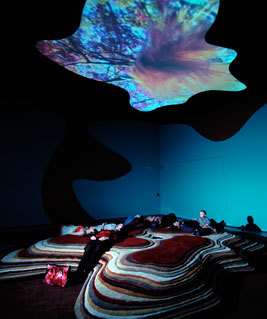 Pipilotti Rist at FACT Adrian Searle's podcast on Pipilotti Rist's Gravity Be My Friend at FACT (Liverpool) shows just why she does video installation art and sound better than almost everyone... though this is kinda Verner Panton-y. Also, yes I am hard on the schlub... so when DK Row writes a nice piece on Robert Rauschenberg's final works (on view at Bluesky) I feel duty bound to point it out. If you are gonna be tough it helps to be fair too. I actually like defending him... (more) Posted by Jeff Jahn on July 07, 2008 at 11:57 | Comments (6) PermalinkThursday 07.03.08 Swan Song for Tilt 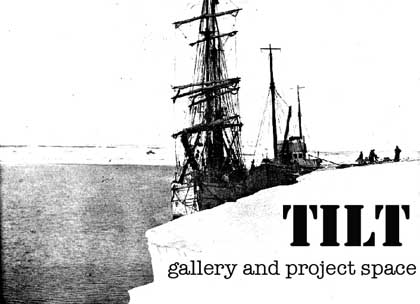
Today, Tennessee, by 2006 Oregon Biennial artist Benjamin Buswell opens as the final exhibition at the Tilt gallery in the Everett Station Lofts. PORT was the first to tell you this would be a place to watch 2.5 years ago and it has really held up. Regardless whether any particular show was a success or fell flat, the trek to Tilt was always rewarding because of the surprise and professionalism that could be counted on. Tilt has had a comparatively long run at "the lofts" for the husband and wife team of Jenene Nagy and Josh Smith who have another project, TILT Export, which will do independent curation while focusing more on their personal studio time. Jenene is also curator for PSU's Autzen gallery and was PORT's business manager for 2007. Typically these alt space live/work Everett Station Loft galleries last only a year and at 2.5 years it's a good run for Tilt...(more) Posted by Jeff Jahn on July 03, 2008 at 11:00 | Comments (1) PermalinkMonday 06.30.08 Monday Links Power Slice (Portland)
and Peripheral
Vision (Seattle) are two very intelligent non-vanity additions to NW blogosphere.
Louise Bourgeois at the Guggenheim looks great in the NYT's... check out their slideshow. The Guggenheim does amazing things to sculpture shows, yet this reminds me of how lame Matthew Barney's show there was by comparison. Tyler Green is right about these Gertrude Stein's twins, makes me wonder what a whole show of Gertrude Stein portraits would be like? Kind of like an intellectually superior night of the living dead?! Posted by Jeff Jahn on June 30, 2008 at 10:23 | Comments (0) PermalinkTuesday 06.17.08 For your consideration First off, irony has ebbed now that the Art
in America art blogging roundtable from last November by Peter
Plagens... (which PORT participated in) is now
on-line.
Second, we don't usually plug fundraisers on PORT but PSU's online auction provides scholarships for their students. Some of the artist's included are Chris Johanson, Robert Pruitt, Fritz Haeg, Jim Drain, James Lavadour, Storm Tharp, Bruce Conkle, Dan Attoe, Mads Lynnerup, Harrell Fletcher and Rigo 23 etc. It's a great opportunity to help PSU art students and score some good pieces. Also, we hear Harrell's "The American War" was recently added to MoMA's collection. Peter Schjeldahl has a nice piece on the Jeff Koons retrospective (which I intend to see). Lastly, this interview in the O simply wasn't fit to print. Apparently the editors over there either don't care that they have a credibility problem or simply want to heckle Portland's art scene. Either way it's shamefully passive aggressive and a wasted hatchet job effort. Soliciting JV level questions to ask the curator was a cop out too. Note, Jen Graves of the Stranger is more respected in the area arts community and got a much better interview. Posted by Jeff Jahn on June 17, 2008 at 12:05 | Comments (0) PermalinkFriday 05.30.08 Friday links In the
New York Times Roberta Smith gave a nod to Portland's Jessica Jackson Hutchins (scroll down),
bringing up many of the same things I pointed out in PORT's
review of her show at Small A Projects last February. Her show at Derek
Eller looks a lot more filled in than the Portland show, but that makes
sense... experiment at home and tune the idea for the New York showcase. The
homey subject matter definitely isn't your typical NYC fare.
Adrian Searle loves "Psycho Buildings" at the Hayward Gallery in London. This is a definitely a show I'd love to catch. Posted by Jeff Jahn on May 30, 2008 at 10:43 | Comments (0) PermalinkWednesday 05.28.08 Who's the big bad wolf now? Sorry we've been a little quiet, don't worry PORT is about to unleash a deluge of interesting content as we approach our 3rd year (June 1st). As a calm before the PORT in a storm here are two fine things from the New Yorker: Peter Schjeldahl's take on Action Painting and abstraction show at the Jewish Museum discusses the how writers got mixed up in all of that paint. Greenberg, being the most important has a Portland tie in of course... his personal collection forms the cornerstone of the Portland Art Museum's modern holdings. Yet there are gaps, we dont have a major Pollock, Still or most naggingly a major Rothko... despite the fact that Rothko grew up here and had hist first solo show at PAM. I love the fact that we have a very good Krasner and Richard Pousette-Dart on view though. PAM's current display doesn't exactly follow Greenberg's dictums but an expanded worldview. It is interesting that Greenberg is no longer considered the big bad wolf of modernism, the art museum world is no longer made of straw. Paul Goldberger looks at Chinese architecture and the message it sends. Note the China Design Now show will come to PAM October 2009. Posted by Jeff Jahn on May 28, 2008 at 8:09 | Comments (0) PermalinkFriday 05.23.08 Friday links Stay tuned, Ill have an exhaustive Sam Adams/Portland zeitgeist post coming
soon.
Till then here's: Zaha Hadid's new skyscraper for Warsaw Poland it was just announced that her design is the winner. A very well written review of TJ Norris' Infinitus show at NAAU by Richard Speer. BTW the WWeek is starting to have more art coverage again and I think ditching the listings for a few short reviews is better... it's about time, what about some features? Posted by Jeff Jahn on May 23, 2008 at 14:05 | Comments (0) PermalinkMonday 05.19.08 Connecting excellence 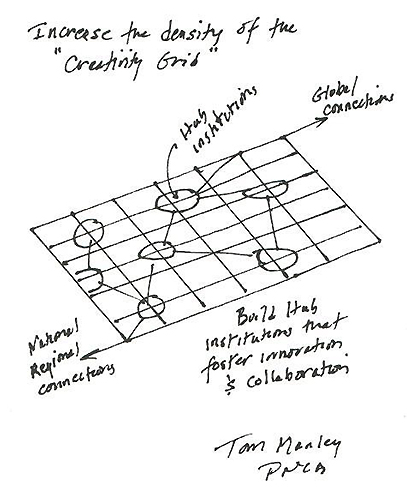 Last Friday the City Club hosted Tom Manley with Brad Cloepfil and Sohrab Vossoughi of Ziba Design to discuss Portland's "Creative Grid". Basically it was about networking Portland's creative institutions, firms and individuals. You can listen to it here. Overall this is an important shift in Portland's strategic future as the city is networking the hell out of itself in a way that lets creative types get in on the ground floor. I liked several things about this rather 19th century style public forum at the City Club. First the word "excellence" was used frequently (if only both of our Mayoral candidates did the same, whoever gets the job needs to take their cues from these 3 Portlanders and a few others...). Second, Brad Cloepfil made a great point about being honest about our goals and instead of trying to do it all (like some arts institutions attempt) we need to focus on what we can do that is truly excellent. Finally, the best bit was when Cloepfil responded to a the question about money and funding (a red herring) by stating that Portland needs to "Get Over It" and should focus on doing things at a high level instead (I suspect that will bring more money in 5-10 years). The trick is to not get self satified or think that spending lots of money leads to excellence. I've been saying the same thing for years, the actual amount of money matters less than how it is used. We simply need to ask better questions like my favorite gripe, "are the projects and institutions we are funding raising the level or of discussion, ideas and execution rather than simply existing to create communities of mediocrity. Communities are good but they matter most when they challenge themselves to be better rather than self-congratulatory. Roberta Smith looked at a show of artistic mash-ups. Sounds like people are looking for something new and trying to see what happens when 2 artists are artificially put together. Of course when its not artificial as in Jasper Johns and Robert Rauschenberg (rivals, lovers etc.) that's when art gets radicalized in exciting ways. I don't think those days are gone. Last but not least Art Blogging LA has unleashed its redesigned site. Posted by Jeff Jahn on May 19, 2008 at 10:28 | Comments (0) PermalinkThursday 05.15.08 Windows on many world views 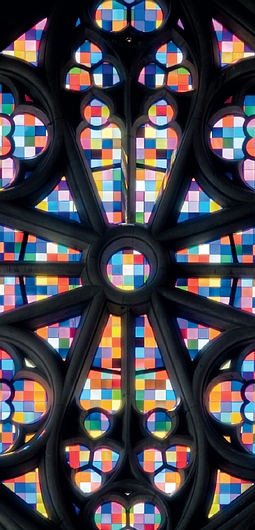 Photo: © Gerhard Richter, Koln / Dombauarchiv Koln, Matz and Schenk Recently, Peter Schjeldahl took a fascinating look at two stained glass window projects by Sigmar Polke and Gerhard Richter. Here's the Koln Cathedral's webpage for the Richter project. Personally, I've always loved stained glass and learned how to execute art deco designs when I was 8 because my Mother was doing the same. Later, I was near contentiously exposed to Frank Lloyd Wright's work and eventually boned up on historical examples like Chartres, La Sainte-Chapelle and Matisse's project in Vence. As for the sacred/secular debate, I don't think it matters much... many Christian artists were pretty heretical while pursuing their work. I also think there is an odd double standard, nobody cares if an architect of a church like Philip Johnson, Moneo or Frank Lloyd Wright were religiously compatible with the congregation's beliefs. I always appreciate it when churches choose to employ top talent, it is a civic responsibility and the poetics of talent producing tolerance are undeniable. Brian Libby over at Portland Architecture gave a welcome recap of Brad Cloepfil's chat at Jimmy Mak's. Interesting how he appreciated the Pearl District as a decent effort that sets the stage for some possibly superb buildings in the future. Right now the only above average architecture is his W+K headquarters, a couple of galleries and the Holst architects projects of PNCA (with a stellar paintjob by Randy Higgins) and Rivertek. With the 511 building and Holst's Ziba Design HQ's there is a sense that some exiciting work is about to be built. Also, what is Powells gonna do with their remodel/addition? The Portland art scene can always use more interesting exhibition spaces and even the new condo's have interesting lobby installation opportunities. The Mercury reviewed the Jess show. After the Cornell retrospective at SFMOMA last year and an unrelenting string of lesser shows in Portland I'm gonna have trouble taking in more collage art. Still, this sounds promisingly obsessive. With collage art I remain wary... "more" seldom is MORE, with Cornell being the benchmark for how to do it right. After Rauschenberg's death I'm feeling even more picky, though Anna Fidler is really starting to take off. Come to think of it collage is a lot like making a stained glass window. Posted by Jeff Jahn on May 15, 2008 at 11:45 | Comments (0) PermalinkTuesday 05.13.08 Remembering Robert Rauschenberg  Canyon, 1959, Combine on canvas, 81 3/4 x 70 x 24 in. Robert Rauschenberg has passed away at age 82 of heart failure, here is the New York Times obit. A great artist and massively influential, PORT's thoughts are with his friends and family. With his ultra influential combines and even moreso silk-screens, Rauschenberg's place in history is secure as one of art's great alchemists. Without Rauschenbergs's mental muscle and protean reinvention you wouldn't have Warhol (silk-screen), Johns or even Sigmar Polke (silk-screen), Anselm Kiefer (combines) and Jean Michel Basquiat whose cypher-like pictorial organization owed much to seminal works like Factum I and II. My favorite Rauschenberg would have to be Canyon, a work so loaded of with rich associative properties it may be the most telling American representative of Post WWII... it's simply all there; ironic nationalism, stylistic conflicts, poetic hypocrisy, personal asides etc. Hilariously, the fact that Rauchenberg used a bald eagle insures that the work cannot be bought and sold (a protected animal). Also, turning that eagle into a magpie.. a predator turned into imposter... a symbol becomes a chameleon etc.. is simply unbeatable when discussing art and American politics/life. I think the best recent piece of writing on him was Jerry Saltz's Our Picasso? review of the combine show. >Feel free to leave your thoughts on the man and his art here... (more Posted by Jeff Jahn on May 13, 2008 at 10:58 | Comments (6) PermalinkFriday 05.09.08 Something to chew on for the weekend Portland Architecture has a great post on PSU's Social
Practice classroom on Alberta. An innovative project, the structure will
be designed to be moved from site to site, interracting with the various neighborhoods
that Portland is famous for.
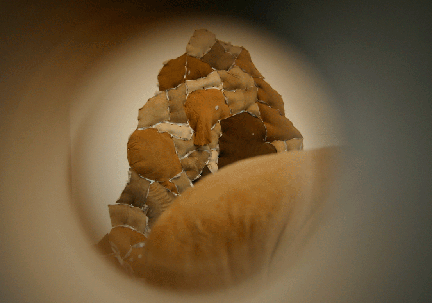 Nan Curtis at Linfield (detail) It's that last weekend for The Dancer at PAM (an excellent scholarly effort) and Saturday is the last day for Nan Curtis' show at Linfield College, always worth the drive and extra fun if you work in some wine tasting in the area. Roberta Smith chimes in on the 55th Carnegie International... her complaint is its lack of teeth. Tyler Green seems to have seen a different show, partly because the Vija Celmins did something for him. (Celmins usually delivers but what about the newer names?) The elephant in the room is this question, "are all these international shows the same uninspired show created through a preapproved list of familiar names and or ideas? Has brand, inclusivity of various practices and global ubiquity trumped the shock of the new?" Look, it's a change election year and similarly I suspect many people simply want a different art world... the Carnegie is proabbly allright but when they went to Mars it looks like they brought the same old artists. All of the biennials are suffering from a fatigue of the overly familiar (brought on by a smaller world and a lot of shows). Artblog also has some nice coverage. Oh and in case you missed it Jerry Saltz wrote about a restaging of a seminal Dan Flavin show... back when real ground was being broken. Posted by Jeff Jahn on May 09, 2008 at 17:04 | Comments (0) PermalinkMonday 05.05.08 Looking around Andrew Goldstein wonders what
P.S.1 will be like without Alanna Heiss? As of late the institution has been
morphing into more of an establishment venue with the Greater New York shows
etc. and a connection to MoMA... it's the way things tend to go. Really anything
that isn't a fusty musty academic institution will tend
to fall victim to its own successes (see MoMA, Dia, Guggenheim) and it's why
Judd took to Marfa and even that outpost has become a fetish of remoteness.
Look, if Walter Hopps could somehow mellow and take on an old sage-like patina in his last
years anyone and any institution can...it's just part of the metabolism of culture.
Speaking of Judd, Tyler Green is still in the running for Judd head of the month, both bits are interesting, especially the bits on why Smithson was more favored in the academy. Kim Davenport of Rice University has 10 bits of sound advice regarding installation art. You definitely have to take a greater leap of faith and trust the atrist more for site specific projects... (more) Posted by Jeff Jahn on May 05, 2008 at 11:38 | Comments (0) PermalinkSunday 04.27.08 Exciting TBA festival visual arts lineup announced Last night PICA announced their "On Sight" visual arts lineup for
the TBA festival September 5-14. Overall,
a much stronger and more rebellious visual arts lineup than last year (there
were grumbles and bad installs) with a real vis art festival feel than just some appended element
to primarily performance oriented TBA lineup. For the first time since they
canned their year round visual arts exhibition program I'm truly excited. Overall the curatorial
arc has lots of recent Whitney Bi approved names.
Mike Kelley Day is Done ... Kelley's aesthetic can be found in a lot of the other artists here. The Yes Men Co-presented with Pacific Northwest College of Art Fritz Haeg Co-presented with Reed College... hmmm a rebel gardener in Portland, frankly I'm most excited about this. Haeg's talk last year was a highlight. Ryan Trecartin I-Be Area... seen last year at Igloo in the Everett Station Lofts. It needed more attention, so good to see again... a fantastic video artist Lizzy Fitch Residency / Commission of new work / Installation + Performance... (more) Posted by Jeff Jahn on April 27, 2008 at 13:41 | Comments (2) PermalinkThursday 04.24.08 9 years & last chance for an impressive April gallery junket 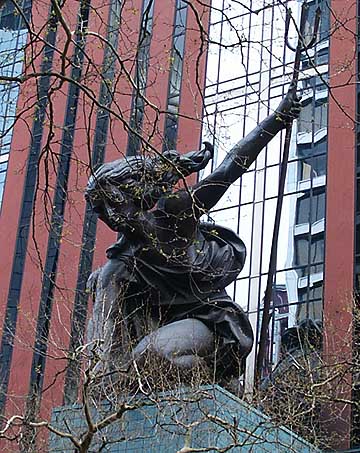
April marks my ninth year in Portland and it is really satisfying to say that this was probably the single best month of shows I've seen since moving here. What's more there were strong offerings in every genre imaginable.(list of strong shows ending this weekend below). A lot has changed since 1999, now there really are several scenes not just one... ... (more) Posted by Jeff Jahn on April 24, 2008 at 16:36 | Comments (0) PermalinkMonday 04.21.08 Weekend developments  The West Side Railyards Project with pink cultural mystery box (lower right corner) Nicolai Ouroussoff of the NYT's had an interesting dissection of developer renderings on Sunday. In this case he was taking it to Helmut Jahn's renderings of the recently awarded West Side Rail Yards project in New York. I particularly liked the Ourousoff's "Cultural Mystery" description where, "neither the developer nor the government have any idea who would occupy the so-called cultural building." Apparently the developer Tishman Speyer has an art collection too... though it isn't like New York needs another corporate art museum. (mmm and yes HJ and I are cousins) This railyard redevelopment reminds me a bit of the South Waterfront project in Portland, which is actually bigger and more expensive than this New York Project... though SOWA doesn't even have a cultural mystery box, though to be fair they do have Linda K Johnson's AIR residencies. Of the AIR projects I think Horatio Law's "China on the Willamette" in May is gonna be a real treat because it draws a correlation between Portland's mega-development which is tiny compared to China's mega-developments (not that bigger is necessarily better from a human use standpoint). Tyler Green had a nice bit on intellectually supercilious museum shows that support contemporary gallery markets. I nominate the Paul Klee/Devendra Banhart travesty at SFMOMA as the single worst example of this "museum becomes hipster" malaise... (more) Posted by Jeff Jahn on April 21, 2008 at 0:00 | Comments (0) PermalinkSunday 04.13.08 PNCA seeks to purchase its currrent home as well 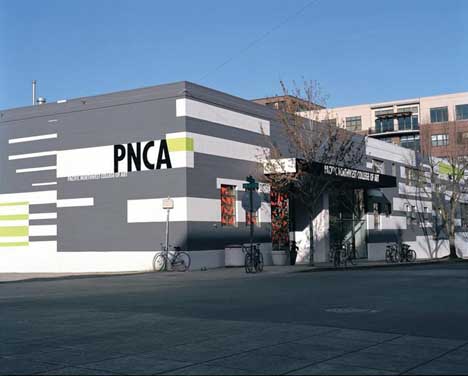
PNCA's current main building PNCA has always wanted to buy its current home in the Pearl district, even before plans were announced to acquire the 511 building. Now the college has announced they plan to acquire the current building for an undisclosed sum (read about the details here). I'm guessing it's an undisclosed amount because air rights are valuable and real-estate valuations are currently in complicated flux. Also, Brad Cloepfil of Allied Works (the schools master planner and architect of the 511 building) will oversee some light architectural modifications. Needless to say this positions art as a major industry for Portland, one of my pet subjects. Yes, all of this capital campaign activity is great but here are a few suggestions:<br> Modify the Feldman Gallery space to make it a more coherent for showing larger scale work (it's a bit tight and the wainscoting's gotta go), also endow its sometimes awesome exhibition program with at least 2 million with fully endowed curatorial position (PSU should do similar things for its galleries). Endow department chair positions and have more full time positions with salaries in line with national standards. Overall though PNCA has become the most ambitious business/cultural enterprise in the entire state of Oregon... it makes me wonder how many places can claim that their flagship art school sits at such a pole position? Yet this makes sense Portland's high profile employers like Nike, Adidas, Ziba Design, W+K etc... all need a very serious art school. Posted by Jeff Jahn on April 13, 2008 at 21:21 | Comments (0) PermalinkThursday 04.10.08 A comprehensive Robert Irwin retrospective at MOCA and MOMA? it's about time 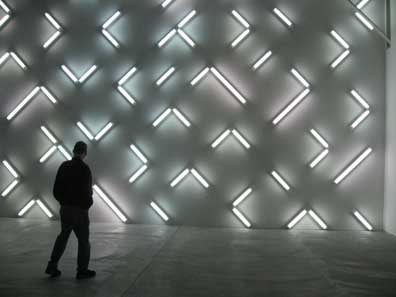
Light and Space (2007) being looked over for the first time by Robert Irwin at MCASD Tyler Green and Jen Graves are still talking about Robert Irwin's awesome Primaries and Secondaries retrospective at MCASD last year. I called it the best show of the year and the fact that people are still pouring over it is a good indication of why...(more) Posted by Jeff Jahn on April 10, 2008 at 14:37 | Comments (1) PermalinkMonday 03.31.08 Cauduro scholarship for PNCA, Portland invests in the future but loses a Warhol 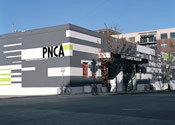
Oregon's single best art collector, Ed Cauduro... and arguably the best eye north of San Francisco has given PNCA a 1 million dollar scholarship endowment. When he was active he tended to collect early and presciently and his collection has included the likes of Warhol, Judd, Schnabel, Terry Winters, Jasper Johns, Jeff Koons and Basquiat (who even did a portrait of the elusive collector). Cauduro has given many important works to PAM (like the Peter Young etc.) but none of the listed heavy hitters are currently in PAM's gap-filled collection. Cauduro also owns Short Stop, John Chamberlain's first crushed car sculpture... something every art museum on the planet is interested in (Cauduro is 81 and must be slightly annoyed with the dynamic sets up). In response he's been setting up a lot of charities, including this incredibly generous scholarship endowment for PNCA. I've known about this for a while and it's a major benefit for the college and the art community. PNCA is on a roll with its 511 building, Hallie Ford gift (FIVE program) and MK Guth in the 2008 Whitney Biennial. The Ed Cauduro Fund for Pacific Northwest College of Art of The Oregon Community Foundation (OCF) will provide up to four $10,000 annual scholarships, beginning with two scholarships for the 2008-2009 school year and one in each of the following two years. The endowment will also provide approximately $5,000 annually for students to use in purchasing art supplies and materials they would otherwise be unable to afford. Having a scholarship like this helps PNCA compete with other schools for particularly promising students... many might not realize this but it is a competitive advantage they have been lacking....(more) Posted by Jeff Jahn on March 31, 2008 at 11:49 | Comments (12) PermalinkWednesday 03.26.08 PAM acquisition: Tom LaDuke 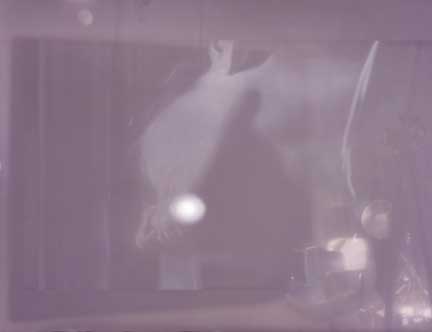
The latest contemporary addition to the Portland Art Museum, Tom LaDuke's Private Islands (2007), is now on display on the 4th floor of the Jubitz Center for Contemporary Art, nearby the recent Tanya Batura acquisition. LaDuke has been getting a lot of attention lately from Tyler Green and other museums and his work first appeared in Portland in PAM's New In Town exhibition back in 2002. The thing that has always struck me about LaDuke's work is how there is always a phantom presence... (more) Posted by Jeff Jahn on March 26, 2008 at 13:35 | Comments (0) PermalinkTuesday 03.25.08 It's how one lives not "in what" that is defining 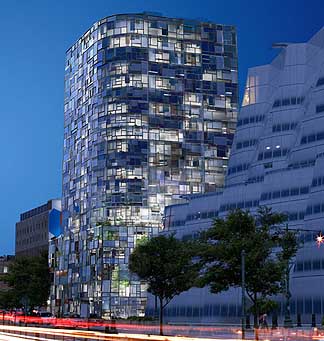 Jean Nouvel's 100 11th Ave. in Chelsea Last weekend Nicolai Ouroussoff opined about the rash of preening new condos in New York. One telltale problem is how the interiors are extremely conventional... there was a time when ground breaking design actually pushed those who lived inside to reconsider how they lived (whereas this is just a surface form of avant-garde). The only project that seems truly inspired is Jean Nouvel's 100 11th ave project which sets up a generous visual rhythm externally that actually carries into the interior spaces. In contrast to most of these "surface" projects I've been photographing the Belmont Lofts building by Holst Architects in Portland a lot lately and it strikes me that that condo building doesn't turn its back to Belmont street, it is semi-permiable and urban ... it isn't a barrier, fortress or some status symbol, it's emblematic of an engaged civic lifestyle and very Portland. Also, the recent Casey project in Portland is more notable for its platinum LEED rating than its novel but slightly dull exterior. Also last week, More Ways to Waste Time did her own art tour of Portland, and managed to find way more nooks and crannies in the art scene here than say the New York times has in their frequent stalkings of Portland. She ate a lot of stuff too... (more) Posted by Jeff Jahn on March 25, 2008 at 12:13 | Comments (0) PermalinkFriday 03.21.08 Congratulations Michael Patterson-Carver 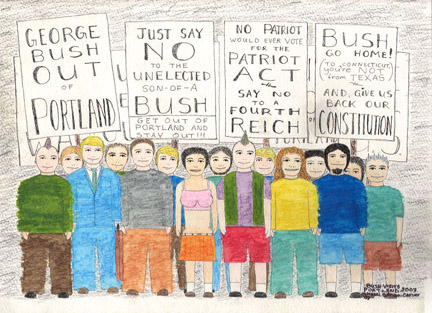
Bush visits Portland, 2007 Congratulations to Portlander Michael Patterson-Carver who is one of the recipients of the 2008 Altoids art prize, he gets 25,000 and a joint show at the New Museum. Previous recipient Harrell Fletcher was one of the *nominators. The award is somewhat unique in contemporary art as artists select other artists for the award, hence the reason the award doesn't have the musty and necrotic smell that most art world prizes have... that and Altoids sponsors it. Carver is represented by Small A where you can see more of his work. *clarification Posted by Jeff Jahn on March 21, 2008 at 10:48 | Comments (4) PermalinkThursday 03.20.08 PAM's latest contemporary acquisition: Batura + some guests 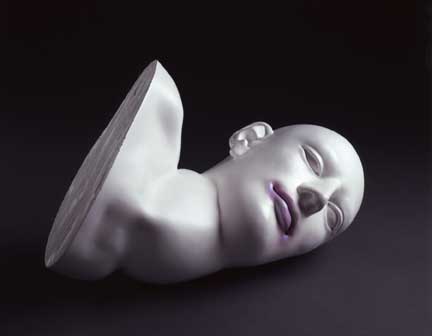 Tanya Batura, Sourire en Bois, 2007. Clay and acrylic. 10 in x 17 in x 10 in. Portland Art Museum. The Portland Art Museum's latest contemporary acquisition, Tanya Batura's Sourire en Bois is on now display on the 4th floor of the Jubitz Center for Contemporary Art. The title translates as, "to smile out of wood." The double entendre is probably intended, but it also references how the sculpture has a wooden texture where the torso normally would start... (more) Posted by Jeff Jahn on March 20, 2008 at 17:29 | Comments (0) PermalinkWednesday 03.12.08 Rothko in Portland 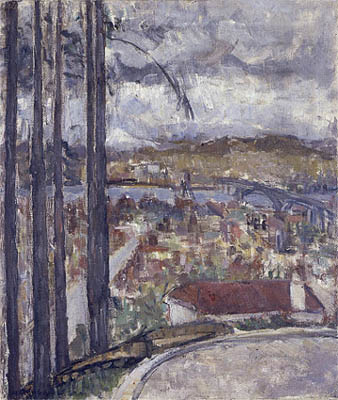
Marcus Rothkowitz, Landscape (View of Portland), ca. 1928 courtesy Michael Rosenfeld Gallery The Portland Art Museum is host to yet another distinguished guest, in fact it's a work painted in Portland by our most famous local artist, Marcus Rothkowitz (aka Mark Rothko). The painting is currently on display in the third floor of the Schnitzer Center for Northwest Art. The ca. 1928 oil painting "Landscape (View of Portland)" was made long before his signature style of the late 40's and depicts the then new Ross Island Bridge from Pill Hill, a moody grey sky and Mt Hood. Overall, it is most strongly influenced by Cezanne... (more) Posted by Jeff Jahn on March 12, 2008 at 12:08 | Comments (3) PermalinkTuesday 03.11.08 PNCA gets the 511 building 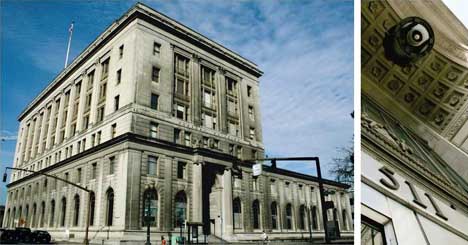
In what will probably be the biggest Portland art news of 2008, PNCA has announced they have been given the green light to acquire the historic 511 building by the GSA and Department of Education. PORT reported in detail on this last fall (and were the first to recognize the importance of it to the local art world). PNCA is tied to both Portland's hot new design economy (Ziba, Allied Works, W+K etc)and the West Hills money that recently funded PAM's 100,000,000+ expansion and continuing endowment campaign... so yes they can do it. This is a major investment in Portland's future not just an art school realestate opportunity. What this likely means: -Big new Brad Cloepfil project in the architect's home town... we were just discussing his Clyfford Still Museum last week. Im about 99.9999999% certain Cloepfil will get the job, he's the campus' master planner. Hell his office even overlooks the 511 building a lil. -More public galleries on the North Park Blocks giving Portland an opportunity to extend the Park Plocks in the future into a world class cultural enclave.... (more) Posted by Jeff Jahn on March 11, 2008 at 10:05 | Comments (1) PermalinkWhitney Biennial Backlog 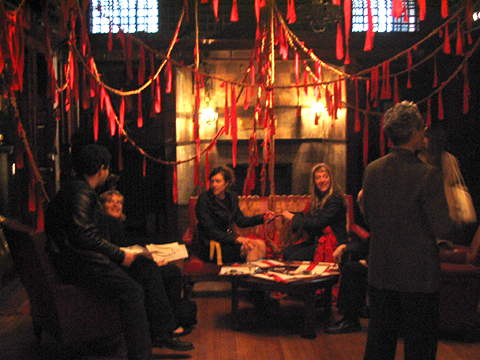
Ok, the typical Whitney rigmarole has given New York something to talk about again (though it seems quieter and less engaging than usual, the Whitney needs to radically change the show to increase its relevance). Frankly it doesn't excite me at all, but so far Ben Davis on Artnet has done the best job of capturing the issue at hand. His best summary, "the whole thing does seem to represent an interest in homeopathic medicine! That is, it offers to simulate a negative effect to cure the larger disease; as if to fend off harsh critical attacks, the show embraces a defensive self-abasement. It is willfully half-baked." Though his Neo-Hippie tag isn't quite news...truth be told the last 4 (including 2008) have all been Neo-Hippie late 60's and early 70's fests. One could point to the adoption of Devendra Banhart into the art world as making it rather official (and therefore dead). That nostalgia also underscores why people aren't that whipped up over this Biennial show, there is no real shift at work here. Despite that, Portland's own MK Guth is racking up all sorts of critical notice doing the important thing in any group show, standing out (Davis and the New York Times single her out as a favorite). Though Holland Cotter's Times piece labeling of her work as "new agey" seems like a New Yorker projecting funny expectations on a Portlander. Truth is MK pisses a lot of Portlanders off because she isn't very dippy-hippy newagey, she's often hard core but romantic with an eye for entropy and not new agey at all.... (more) Posted by Jeff Jahn on March 11, 2008 at 9:30 | Comments (0) PermalinkWednesday 03.05.08 More Cloepfil/Still and More of everything else 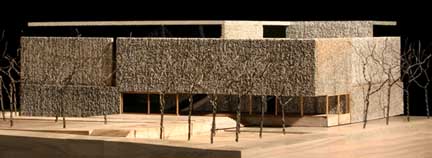 Brad Cloepfil's latest Clifford Still Museum design Portland's top starchitect Brad Cloepfil has unveiled a more finalized design of his Clyfford Still Museum. We saw an early model of it here and it looks like the heavy basalt-like look has been retained. There are two Cloepfil's, heavy Brad (Weiden + Kennedy HQ) and dematerializing light Brad (1 Columbus Circle). Heavy Cloepfil is way better and after spending some time at Kahn's Salk Institute last Fall... I understand why... (more) Posted by Jeff Jahn on March 05, 2008 at 8:14 | Comments (3) PermalinkMonday 03.03.08 Whitney Time - Yawn, Guth Time - Yeah! It's Whitney
Biennial time again... and Portland has had someone in 3 of the last 4.
The 2008 show opens Thursday and even PNCA is doing an event in New York.
This year the Portlander is MK Guth, whom PORT interviewed in depth earlier this year. Joseph Gallivan just did a nice piece on Guth for the Tribune...we will surely miss Gallivan's contributions to that paper. His accessible but engaging arts writing made most of the other newsprint in town look tragic. It's true some worship the WB as some sort of art career Deus ex Machina while the show's overall importance has waned as of late. Still, some 2-5 artists seem to emerge from each iteration and artists like David Altmejd, Forcefield, Chris Johanson and Harrell Fletcher have all gone on to make more serious contributions after the show. My point is the Whitney B in itself isn't as important as the follow through after. In many ways Portlanders are simply over being excited about The Whitney but we love the fact that MK gets to do her thing. I also keep thinking that a west of the Mississippi Biennial might be in order some day as well. Posted by Jeff Jahn on March 03, 2008 at 12:30 | Comments (1) PermalinkThursday 02.21.08 Jupiter Hotel Fair, resurrected? 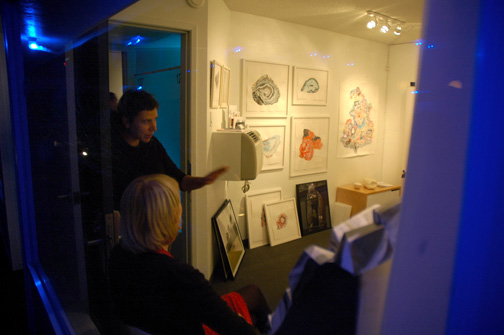 Ok, I knew this wasnt going to just die, Portland is just too ambitious and organized. Besides the fair itself was solid, one senses the organizers themselves just ran out of steam for a big side project. According to Jupiter hotel owners The AFFAIR @ the Jupiter Hotel art fair may not retain the same organizers, name or look, but there is a momentum in the Portland art community for continuing the popular art fair headquartered at the Jupiter Hotel since 2004. According to Jupiter Hotel co-owner Kelsey Bunker, "While it is true that Stuart Horodner and Laurel Gitlen will not be running the AFFAIR @ the Jupiter Hotel, we are excited about the new opportunities this allows us to support the art communities both locally and nationally... (more) Posted by Jeff Jahn on February 21, 2008 at 9:44 | Comments (36) PermalinkWednesday 02.20.08 Considering Johns in Gray 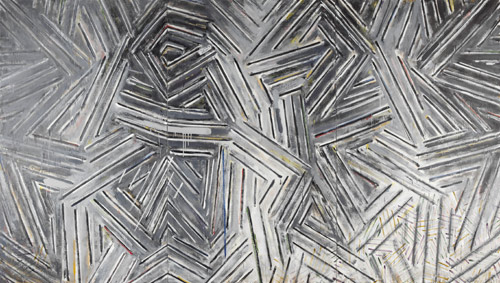 Jasper Johns Between the Clock and the Bed, 1982-83 Encaustic on canvas (three panels) Virginia Museum of Fine Arts, Richmond © Jasper Johns/Licensed by VAGA, New York, NY Photo: Jamie M. Stukenberg/Professional Graphics Inc., Rockford, Illinois Jasper Johns is one of my all-time favorite artists and unlike Richard Prince he tells jokes so great they become poetry before they become punchlines (Prince starts with the punchline and then tries to reverse engineer them). Sadly, Im not all that convinced by Johns' later work but I consider paintings like "Between the Clock and the Bed" to be great art. It is a cypher of space and a semipermiable abstraction... like the sea it doesnt give up its secrets or it's dead. Im not afraid to utter the dreaded term "great" in the presence of a body of work like this. In Portland we are intimately acquainted with the color gray so the Jasper Johns: Gray show at the Met is of special interest... that and we still have tons of encaustic painters here. Jerry Saltz has a wonderful wonderful take on the Met's current Johns show. Donald Kuspit's take is dense and possibly a tad turgid on Artnet (with some great show photos worth checking out). Roberta Smith's take on Johns is worthwhile too (as always) . PORT's own Arcy Douglass wrote on Johns last year here. Carol Vogel generally leaves me disappointed and her personal look at Johns is no exception... where is Kimmelman (the Times chief hagiographer) when you need him?... Europe! Hagiography has its place (though it isn't a replacement for critique). Posted by Jeff Jahn on February 20, 2008 at 10:59 | Comments (0) PermalinkMonday 02.18.08 Affair at the Jupiter Hotel, RIP 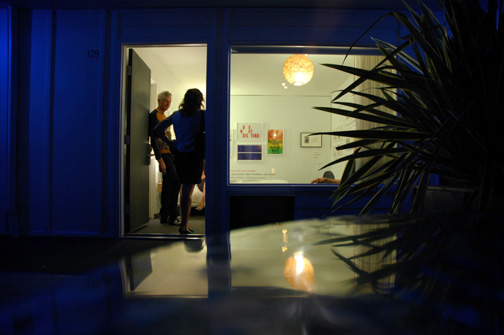 White Columns @ Affair at the Jupiter Hotel 2007, Photo by Sarah Henderson Well, everybody on the inside of the Portland art scene has known for months that there wasn't going to be an Affair at the Jupiter Hotel Art Fair in 2008. I could have pressed the organizers on this but hoped it might be given over to other hands. Now it is officially over. Most dealers were upset with 2007, which seemed to be an afterthought compared to 2006 and many key players simply weren't going to... (more) Posted by Jeff Jahn on February 18, 2008 at 18:19 | Comments (12) PermalinkFriday 02.15.08 Weekendings 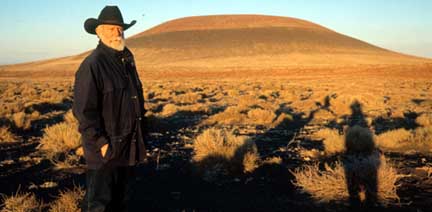 Turrell @ Roden crater, photo Florian Holzherr Tomorrow (Feb 16th), James Turrell will speak at PNCA's huge Swigert Commons space to kick off their Idea Studio talks. Reservations are sold out but a limited # of standing room only slots will be available, doors open at 3:00 first come first served. Talk is at 4:00 (reservation holders need to be seated by 3:50 to retain their seats). While you are at it read PORT's in-depth review of James Turrell's Pomona College show to prepare. Also, it's the general opening of the BCAM at LACMA and the New York Times smells blood. Neither Ouroussoff nor Roberta Smith were that impressed and one senses that an unmitigated triumph at LACMA would have forced New York Museums to step up...(more) Posted by Jeff Jahn on February 15, 2008 at 11:51 | Comments (6) PermalinkThursday 02.07.08 Some New Hypocrisy, same as it ever was The Mercury has penned a story about Rererato's
zoning problems and looming closure by the city. I notified Sam Adam's office
of this last week (Commissioner Sam show us your your arts muscle? You wanna be Mayor...
as Mayor Vera saved a fake horse on NW 23rd, as Arts Comissioner why not save a good art venue?)... look
something needs to be done. This is the type of scrappy art venue that makes
Portland great and they have been doing good things. Don't let the letter of
the law usurp the intent. As an arts city its hypocritical for the city of Portland
to shut down Rererato. So readers please email: chamberlainj@ci.portland.or.us and let the city know what you think.
*Update: PORT has assurances from Comissioner Sam's office, "We're working on it. Promise." 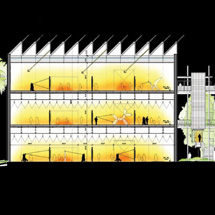 BCAM Gallery Section, © Renzo Piano Building Workshop As Tyler notes it's definitely LACMA's Broad Contemporary Art Museum day, and the LA Times piece is an interesting exercise in revealing the greatness and faults of three of my favorite things on the West Coast; LACMA's crazy (with its own woolly mammoth engulfing tar pit) campus , super collector Eli Broad and critic Christopher Knight. All three are forgivably contradictory in ways only the truly talented are... (more) Posted by Jeff Jahn on February 07, 2008 at 11:41 | Comments (3) PermalinkWednesday 02.06.08 Loosely related links 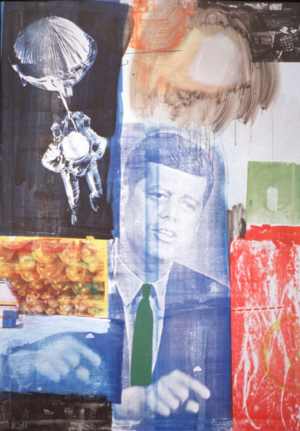
Robert Rauschenberg (American, b. 1925), Retroactive I, 1963, oil on canvas, 83 7/8 x 59 7/8 inches, Wadsworth Atheneum Museum of Art, © Robert Rauschenberg Art and politics link up more often than I find interesting but Artnet's list of Obama, McCain and Clinton contributors is interesting (though totally irrelevant to anybody but art geeks). Sure, artists like Cecily Brown and Chuck Close might support Obama and Matthew Marks might have supported Clinton but ultimately it says more about the donors than the candidates...(more) Posted by Jeff Jahn on February 06, 2008 at 13:20 | Comments (0) PermalinkFriday 02.01.08 News bits 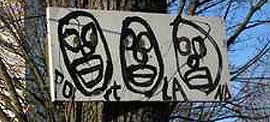 Unimpressive street art creates impressive waste of tax dollars A portland artist, Ryan Birkland, has been arrested for putting up guerilla style art on telephone poles. It seems pretty ridiculous.... how about taking on the meth pushers that ride the NoPo max lines instead? This could have a chilling effect on street art like Scott Wayne Indiana's horses and this selective enforcement seems poorly defined. Jerry Saltz has reviewed Guy Ben-Ner's latest "Ikea based" video Reed's latest show Working History is now definitely open, go see it. Laura Fritz's Caseworks 13 (in the same building) has been extended to Feb 17th. Last but not least there are (solidly sourced *update confirmed) rumors that the Portland Art Museum has recieved a pledge from Gordon D. Sondland and Katherine J. Durant for a 1 million dollar gift to allow Children 17 and under to visit the museum for free. It is part of a larger endowment campaign to provide free days for everyone. Mayor Potter may have avoided funding those free days but the museum is moving forward with results. See, Portland's patrons do write checks but it is tied to the seriousness and focus of the organization's mission. If you are just showing your friends in a big warehouse (and if they aren't very good) don't expect to be entitled to that much. Seriousness + focus = funding. Posted by Jeff Jahn on February 01, 2008 at 10:59 | Comments (5) PermalinkWednesday 01.30.08 Spiral Jetty Threatened 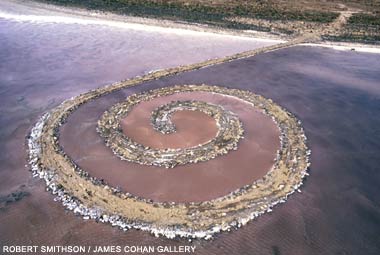
Important, Robert Smithson's Spiral Jetty is threatened by an oil development. Check out Tyler Green's post to contact the people in Utah doing this TODAY before 7:00 PM ET. I went to grad school in Logan a couple of hundred miles away and as anyone who has ever visited the site knows the isolation of the place is important. People in Utah often don't appreciate this and plunk flame spewing oil refineries in some of the most scenic areas imaginable so this is a very real threat. Hell, I even got Chas Bowie this show at Chambers a few years ago because I though his photos of the site were important. Definitely stay tuned... Ill have PORT's 2008 curatorial roundup posted later today. Also, yes I'll post the results of PORT's bridge design contest early next week. Sorry about the backlog, Ive been very busy. Posted by Jeff Jahn on January 30, 2008 at 10:45 | Comments (1) PermalinkMonday 01.28.08 Brian Ferriso checkup: 1 year as director of the Portland Art Museum 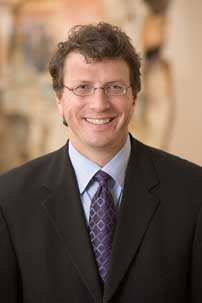 PAM's Executive Director Brian Ferriso This January marks the one year anniversary for the Portland Art Museum's new director, Brian Ferriso. As arguably holding the most important cultural position in Oregon, Ferriso's actions have far reaching implications and set expectations both within the museum and the rest of the state's philanthropic/artistic community. It is time for an annual checkup. (disclosure: Im VP of the Contemporary Art Council at PAM and PAM is a PORT sponsor) The Ferriso effect: For contrast, John Buchannan, Ferriso's predecessor was a successful and aggressive entrepreneurial promoter (but questionable as a connoisseur), and for years many other organizations followed his lead, putting hype ahead of content. Lately, Portlanders have grown tired of the "constant PR" type leaders as purveyors of empty cultural calories. [*Note to our so-called journalists, coverage should focus on qualifications of leaders and the quality of shows (aka the only results that matter) not grandiose promises and PR glosses over inferior programming simply designed to produce attendance.] In fact, the first thing Ferriso did was cool down the board who wanted to build on the new property PAM had acquired so he could focus on solidifying the museum's fundamentals like its; endowment, collections and programming tuned to Portland's needs (more contemporary with a bustling arts scene). He's also empowered his curators and that's good for deeping PAM's intellectual relevance... (more) Posted by Jeff Jahn on January 28, 2008 at 16:26 | Comments (4) PermalinkThursday 01.24.08 Comprehension The Guardian covers a much touted show of paintings
from Russian collections at the Royal Academy (some of the Matisses are
among the most important in art history), there is even a slide show.
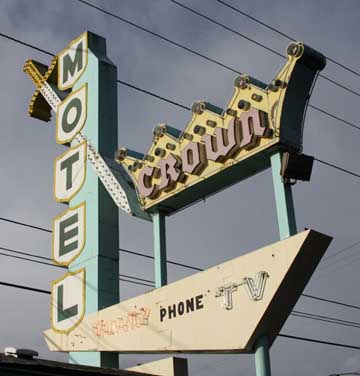
A group called the Atomic Age Alliance has come forward to save the wonderful Crown Motel sign. Even the TV news is tracking the story. Hopefully (if it is saved) it will stay on Interstate... (more) Posted by Jeff Jahn on January 24, 2008 at 10:47 | Comments (0) PermalinkSunday 01.20.08 What the Portland Art Center Closing Means to Me 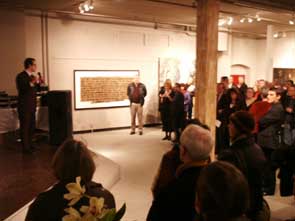 Director Gavin Shettler in 2005 at the Portland Art Center's then new home in Chinatown For the two readers that have not heard, Gavin Shettler sent out an email yesterday announcing that the Portland Art Center is closing. D.K. Row wrote an article about it here. As an artist who showed at the Portland Art Center as they were transitioning from their old space on Belmont to their new space in the Pearl, I was happy that an institution like PAC existed in Portland... (more) Posted by Arcy Douglass on January 20, 2008 at 14:31 | Comments (4) PermalinkFriday 01.18.08 Hadid gets a university museum... so where is Portland's university museum? 
Hadid's winning entry for the Broad Art Museum I'm certain a lot of you already know Zaha Hadid has won the commission for Eli Broad's art museum at his alma mater, Michigan State University. It's a gutsy choice and I like its italicized character a lot more than her Cincinnati CAC project or any of the other contestants like Coop Himmelb(l)au and Morphosis etc. Still it seems pretty tame for Hadid, despite the fact it uses lots of triangular forms (a personal obsession). She also recently completed this interesting transit project the Hungerburgbahn (don't you just love German). It also brings up the issue of university art museum's and Portland is really underdeveloped in that department. Seattle has the Henry, the University of Wisconsin Madison has the Chazen (nee Elvejehm), Berkeley Art Museum, Eccles (Logan Utah), Jordan Schnitzer Museum in Eugene, Hallie Ford Museum in Salem etc... (more) Posted by Jeff Jahn on January 18, 2008 at 10:56 | Comments (2) PermalinkTuesday 01.15.08 PNCA Launches FIVE Idea Studios 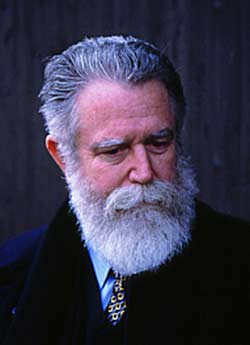 James Turrell will speak at PNCA Feb 16 PNCA has launched a new visiting luminary series called FIVE Idea Studios. The first two visitors being: MacArthur Fellow James Turrell on Feb 16th, (PORT's Arcy Douglass reviewed Turrell's latest Pomona College project here in depth just last week) and French philosopher Jacques Rancière on Feb 29th... (he's the art world's favorite rockstar theoretician these days and between these two the college is hitting exemplars of the twin poles in art today, aesthetic experience [Turrell] and the search for new forms of social dynamic theory [Rancière]. According to PNCA (a PORT sponsor): "Idea Studios will be an ongoing and portable series of conversations, lectures and performances on the inner workings of the creative process. The series will feature internationally acclaimed practitioners from a range of fields and cultures as part of a broader PNCA + FIVE effort to highlight the importance of creativity in fostering innovation and civic imagination. Venues for Idea Studios will at times shift from the PNCA Portland campus to other locales across Oregon, the U.S. and the globe...(more) Posted by Jeff Jahn on January 15, 2008 at 0:00 | Comments (1) PermalinkThursday 01.10.08 Portland Spaces magazine unveiled Randy Gragg and I have a long history but his history with the city of Portland's
aesthetics goes back much farther than that. Though he wasn't the first to write
about me here, he was the first to pen a review on a show I put together way back in 2001. I remember he asked me, "so who is the ringleader?" My half-idiotic
response was, "I suppose that would be me?" Undoubtedly he thought
I was a yutz but wrote the review anyway (bet he wishes he could have that one
back eh?). Still, some of the art was good and that's all he cared about. Now after
leaving the Oregonian Gragg's the ring leader of the brand new Portland
Spaces magazine a kind of Dwell magazine for Portland. Fist Gragg was an
art critic, then an architecture critic and now he's an editor in a city that
is rapidly reimagining itself. If there was ever a time for such a thing it's
now.
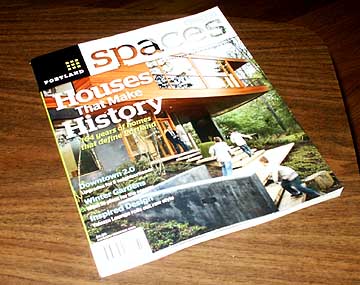
Sure Gragg's departure from the O did prompt some major civic leaders to query if the O will just abdicate architectural and design criticism altogether but I suspect they will need to do something to compete with Portland Spaces for relevance sake. Though Randy and I don't always see eye to eye (mostly because we differ on important minutiae) I've always respected the guy and like the fact we offer eachother the opportunity to disagree (critics live for this). Also, Randy has an excellent nose for news and always seems to know where the action is... which makes his new Portland Spaces magazine tantalizing. The inaugural issue of the bimonthly has an interesting modern home by rising architect Jeff Kovel built for Karen and John Hoke (Nike VP) on the cover...(more) Posted by Jeff Jahn on January 10, 2008 at 23:01 | Comments (0) PermalinkWednesday 01.09.08 More on Broad and the Portland connection  Eli Broad's big news in the New York Times yesterday still has everybody talking. Is forming an independent art lending institution a form of Teddy Roosevelt style cultural trust-busting (museum as monopolizer) or does it short circuit the opportunities and dialog of the works joining a larger collection? For example, curators build museum collections around acquisitions, not available loans. Also, loans aren't likely to become museum favorites that people can visit for 10+ year stretches of time (my favorite part of museum going). Still LACMA's new Broad building will have a strong presence of Broad Art Foundation loans. Interestingly enough, Portland has a stake in this story as Broad has been very active with the Portland Art Museum and by not giving the collection wholesale to LACMA it leaves the door open for further engagement with Portland's art starved but rapidly developing cultural ecosystem. Portland has been the beneficiary of the Broad Foundation quite regularly including the Damien Hirst and Camouflage shows at the Portland Art Museum in 2007. Sure we have some good collectors in the Northwest but no collection North of California on the West Coast can compete with Broad's, it really helps as a resource. By creating a lending institution and not mothballing... (more) Posted by Jeff Jahn on January 09, 2008 at 14:30 | Comments (2) PermalinkMonday 01.07.08 Think links PORT has a ton of thought provoking interviews and reviews this week but let's
kick things off with some fresh links:
Portland's Daniel Peterson posts his first image of 2008 and it is fantastic. This guy needs a solo show, best new photographer I've seen in years. Also, the New York Times had nice things about video art and snow globes. Art Ltd. a newish West Coast art mag did a nice bit on Julius Shulman. Posted by Jeff Jahn on January 07, 2008 at 12:43 | Comments (0) PermalinkFriday 01.04.08 David Lynch at Northwest Film Center this weekend  DAVID LYNCH IN DIRECTOR blackANDwhite'S LYNCH. COURTESY ABSURDA. JAN 4, 5, 6 FRI 7 PM, SAT 7 PM, SUN 5:30 PM LYNCH US/DENMARK 2007 DIRECTOR: BLACKANDWHITE This fascinating, indeed "Lynchian," portrait offers a rare glimpse into the enigmatic mind and creative process of the famed director of ERASERHEAD, THE ELEPHANT MAN, BLUE VELVET, and MULHOLLAND DRIVE, to name just a few of his surreal and seminal works. Filmed over a period of two years (by mysterious producers) it follows David Lynch at home and at work on the set of his recent INLAND EMPIRE with Laura Dern and Jeremy Irons... (more) Posted by Jeff Jahn on January 04, 2008 at 12:35 | Comments (0) PermalinkThursday 01.03.08 Last day for Yeon architecture exhibition 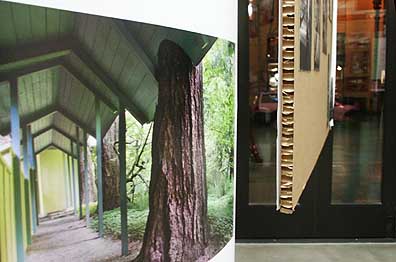
Please forgive me (and the bum rush of the holidays + Miami) for not posting on this earlier but today is the last day to see the inaugural exhibit at the American Institute of Architects new Portland HQ's in the Pearl District (the old SK Josephsberg Gallery building). The show is John Yeon: in the land of influence, curated by Randy Gragg (whose Portland Spaces magazine launches next week). Brian Libby at Portland Architecture had a nice post on Yeon's Swan house a while back too. To me Yeon looks a lot like a more practical Frank Lloyd Wright without all the hubris... and his work remind's me of my parent's house in Wisconsin. Posted by Jeff Jahn on January 03, 2008 at 10:29 | Comments (0) PermalinkTuesday 01.01.08 Best of 2007 It's done now but 2007 was a big year and here is how PORT's Ryan Pierce, ex-PORTer
and new Beaverton Arts Comission board member Melia Donovan, Matt McCormick, Micah Malone, Jesse
Hayward and my own dull self rated the year... (more)
Posted by Jeff Jahn on January 01, 2008 at 13:26 | Comments (5) PermalinkFriday 12.28.07 2007 Recap PORT and Portland's art scene had a particularly good year in 2007 with a general
expansion of interesting new venues, artists and greater national exposure all around.
In fact, weve had so much exposure outside of the city that Portlander's have
begun to refer the national media as stalkers. Even PORT
ended up in Art in America.
PORT Scoops.. here are just some major stories where we were the first Portland publication to break the news: The New American Art Union's stipend shows, which were later dubbed Couture when the final selectee's were announced PNCA makes it's bid for the 511 building, possibly the most important growth opportunity for art in Portland in the past 60 years. Other media have been playing catch up to what could be the biggest story of 2008 as well. MK Guth selected for the 2008 Whitney Biennial Portland Art Museum acquired several nice contemporary objects including a fine Judy Chicago and a really nice Gene Davis (we were the only Portland publication to mention these... but then again we are focused purely on art... so there you have it) Here are some of my favorite articles from the past year:... (more) Posted by Jeff Jahn on December 28, 2007 at 10:39 | Comments (4) PermalinkMonday 12.24.07 Holiday reading Most of PORT's staff have the week off so posts will be somewhat sporadic,
so here are some things to yule-tide you over (I know, I know, both the pagans
and the baby Jesus would disapprove of that pun):
Yesterday Roberta Smith took a shot at the word "Practice" as over-used by contemporary artists in 2007. I'm with her on this one, one has to have a receptionist and a lobby to have a practice... maybe it's all the college loans that drive artists to consider it a practice? It's probably just a nonsensical shortening of the term studio practice that gets all frothy with other pretensions (most artists are not particularly good wordsmiths so it is Roberta's job to point this sort of silliness out). It all reminds me of the original ending of Robert Hughes The Shock Of The New where he complained that art had become a vocation not an avocation... later Hughes wussed out and changed that ending. Still, he had it right the first time, even if he was wrong as could be about Basquiat (right about Schnabel though). My greatest annoyance is with the art world's meaningless use of the word "Authentic." To me its like the yuppie approved packaging on overpriced ethnic dishes one can find at high end grocery stores. It almost guarantees it isn't the real thing but it's overpriced status intends to mitigate guilt while giving it a patina of legitimacy. To use Greenberg's term it's very middlebrow. Portland Public art has a hilarious post on what won't save hipsters(?) in Portland... great stuff. Posted by Jeff Jahn on December 24, 2007 at 17:00 | Comments (2) PermalinkWednesday 12.19.07 Space is the place (externalizing the internal & its inverse) 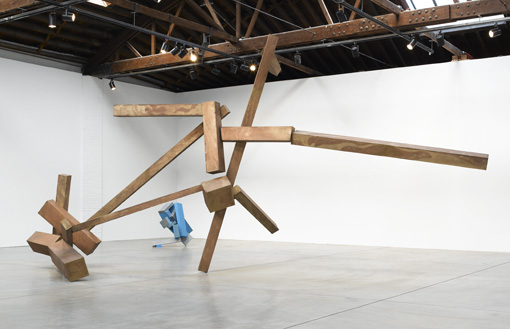
Joel Shapiro's current show at Pace Wildenstein Art Info has a nice interview with Joel Shapiro, whose work seems to becoming increasingly relevant and central to the age old (some would say pointless) distinction between representation and abstraction in sculpture. I love how his later work seems to activate space through inhabitation. This has always been a key element of his work but in the last few years he's developed that Picasso-like sureness and energy about his efforts. I like it much better than David Smith's Cubi series which I feel were a bit forced (though important). There is nothing forced about this work, Shapiro is the new Giacometti (as our leading existential sculptor). The New York Times had a bit on starchitects... Is it just me or are the architects today way more progressive and experimental than the artists? Theoretically, artists aren't saddled with the same kinds of compromises and restrictions... so why does someone like Julie Mehretu seem like a side dish compared to the main courses in Gehry, Koolhaas, Hadid, HdM and Libeskind's work? ...(more) Posted by Jeff Jahn on December 19, 2007 at 9:48 | Comments (0) PermalinkMonday 12.17.07 Report: A NW Thang at Gallery Homeland 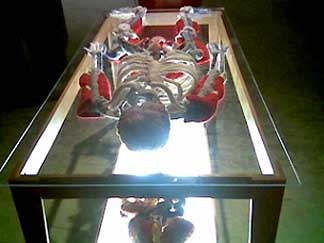 a knitted cadavar stood out So how was Gallery Homeland's A NW Thang opening at the Ford Building on Friday night? Maybe the more important question is how was the art? Answer: pretty solid. Sure, spatially it was a ramble of large finished hallway spaces and an enormous unfinished commercial space but the art itself was what I've been hoping for over the last few years when I've gone to locally focused upstart institutional shows. Most everything I saw was well done, post MFA quality work. Of particular note was Cynthia Starr's group project where an entire human cadaver was created out of knit elements, guts and all. Yes, it's absolutely stereotypical of Portland and our surplus of knitters (and group activities) but it had an intellectual reflexiveness I often don't see in other group projects which seem to invite a lot of participants so a large crowd will show up. Karl Lind's video selections were... (more) Posted by Jeff Jahn on December 17, 2007 at 11:33 | Comments (0) PermalinkFriday 12.14.07 More thoughts on last week: Motel & the art fairs Overall, the art production for Miami 2007 seemed less fresh and daring than I remember it in 2005 (going to Miami every year isn't necessary) and maybe the art world is too sated. So why not ask... was 2007 in general a lackluster vintage or is it just a fair problem? Also, Jen Graves (who sat this one out) had a good "just that facts" take on Miami
this year from a Seattle perspective. Portland galleries mostly avoided
Aqua and did ok to great this year. Also, after talking to a few Portland gallerists the fairs most of them want to be in are Pulse
or Art Miami.
Overall, Art fair experiences really vary, for example Pulliam Deffenbaugh was at the somewhat lackluster Red Dot fair and yet did really well so it's difficult to characterize. The Aquas have some really good elements but need to up the ante the way Pulse and Nada have since theyve first appeared. Schwanky events, more diverse galleries and something that differentiates and makes the fair a destination. Portland's own Affair at the Jupiter Hotel needs to do the same things just to bring people to Portland. Which brings us to the question, will there be another affair?... OK I know more than Ill discuss here but many Portland dealers really want them to step up and make the event more of a destination or have a completely different fair under different management. Pairing with TBA doesn't really work, two different crowds. If it were paired with a vis-arts festival that would be more effective. 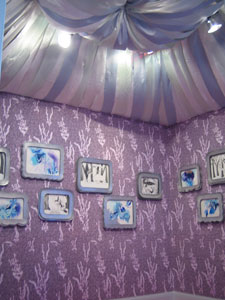
a Motel installtion from July 2005 On the news of Motel's closing last week... Im sad of course, but this wasn't a surprise for me as Jenn and I have a rapport (As PORT's co-founder and former buisiness partner she's like the sister I never had). She wanted to concentrate purely on the gallery when her planned exodus from PORT happened earlier this year (in the works for about a year actually). There are some things Portland needs to learn from this... (more) Posted by Jeff Jahn on December 14, 2007 at 12:17 | Comments (5) PermalinkWednesday 12.12.07 It had to be done Tyler
Green has pointed out a great charitable giving vehicle that funds
art projects in schools, check it out. Portland's art programs are woefully
underfunded so here is an opportunity for our teachers. PORT generally avoids
posts on charities but here are some of the worthy Portland projects you can help fund.
Art Critical has a nice look at the Miami fairs including the two I never got around to seeing, Art Miami and Pulse. Art Miami looks like a serious contender for ABMB's top spot. Artblog.net takes a look at how the fairs have effected the indigenous art scene in Miami... reminds me of the Sundance film festival and how it turns Park City a bit upside down. 
DK Row continues to expound upon his seriously flawed understanding of non profits and Portland's current situation and this time out he's heckling Gallery Homeland. In a city where arts patronage is underdeveloped it takes an armada of small scrappy, completely underfunded institutions to lay the difficult groundwork for better patronage. It isn't about the money stupid, it's making headway in the education department. Spaces don't educate, personalities dont educate, fundraising tallies dont educate... the only thing that educates is doing good shows for over 3 years (which is the minimum amount of time it takes to develop a true track record). So with all due respect, give Gallery Homeland a break from the hackneyed misdirected analysis and pay attention to the critical worth of their efforts, that is the measure that matters (and part of why Row's coverage is hurting the development of a better patronage base). Also, Row's desire for one institution to be "the place" is totally misguided and too convenient. Portland is too busy an art city to have one central hub, you only get that in smaller scenes or when giant city governments undertake something like Yerba Buena. Portland's government and patrons just aren't there yet, it's still in the hands of scrappy individuals and volunteers. It's actually a good thing and more interesting than having everyone suck up to 5-10 extremely wealthy patrons with dubious taste. It's actually a magic moment of art organization experimentation in Portland. David, your fundamental assumptions are seriously flawed, smaller more specialized institutions dont seek to dominate, this isnt sports (want to duke it out in a game of ping pong, tennis or dodgeball, Ill whup yer ass there too). Personally, I'd rather see 10 150k a year art organizations than one stale bureaucracy with a budget of 1.5 million... so to that end I suggest everyone go out and see what Paul and Gallery Homeland can do at their opening on Dec 14. Posted by Jeff Jahn on December 12, 2007 at 10:43 | Comments (2) PermalinkTuesday 12.04.07 Guide to Portland In Miami 2007  Vanessa Renwick's Trojan #2 at ABMB Portland's art scene will be well represented during this week's Miami Art Fair madness with greater visibility than ever before. Portland galleries and artists are seeminly everwhere this time. Sure, Portland artists, curators and galleries are already veterans of such fairs but after years being stalked by the media in the New York Times, Wall Street Journal, CNN, Art Forum, Modern Painters and Art in America etc. it now seems Portland has buzz for being different and it shows in the art. In fact, art is central to Portland, no other large metropolitan West Coast city can claim that... (more) Posted by Jeff Jahn on December 04, 2007 at 13:34 | Comments (0) PermalinkFriday 11.30.07 Dave Time Ok you probably read the transcript last month but here's a
podcast of Dave Hickey's keynote address for the Frieze art fair. Good to
take in just before the massive Miami clusterf%#@ that will be happening next
week.
Posted by Jeff Jahn on November 30, 2007 at 12:05 | Comments (0) PermalinkFor your consideration Tyler
Green has been doing some great posts on one of my favorite artists Martin Puryear,
a sculptor who has done as much with a curved line as anyone in art history.
The O indicates the Portland Art Center might have found a way out of its current financial crisis if they can sell enough panels. Also, the word "restructuring" has been used... time will tell what that means but it's a time to really address some of the concerns already raised on PORT in the past. The Guardian has an intriguing review of Hans-Peter Feldman's latest show in Bristol. Portland Architecture takes on possible Sellwood bridge designs and the U of O's White Stag block in Oldtown Portland. Also, this organic extension of a building seems like something that might be great for Portland. The WWeek ran a story on Milepost 5, an innovative new creative colony for Portland's ambitions to take root in. Lastly, The New Museum of Contemporary Art in New York has a new building and the New York Times takes a look. As always I found Ouroussoff's critique of culture in New York important and healthy but will the contents of the museum live up to the box? Roberta Smith has her say on that issue here too, it's a must read (partly for all of its paradoxes, which befits the show). Posted by Jeff Jahn on November 30, 2007 at 10:40 | Comments (0) PermalinkTuesday 11.20.07 More parlor games and MoMA 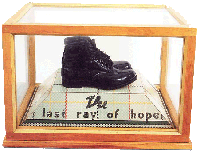
H.C. Westerman Tyler Green has been playing a parlor game centered around reimagining MoMA's galleries. My take is that Americans pretty much needed Alfred Barr to simplify the polyglot that was avant-garde art for Yankee consumption. Barr's brilliant solution was Picasso and since he had helped MoMA to acquire Les Demoiselles d' Avignon the museum was in a good position to make that case. Following curators like Rubin and Varnadoe picked a different hero artist to key the installation to; Jackson Pollock. The thing is I believe Americans are now ready for a more complex worldview and MoMA needs to accept that challenge to avoid becoming not only just a museum of 20th century art but a museum of 20th century ideology. Personally I agree that Pollock is a lynch pin argument but I also agree with Tyler that by foregrounding another giant like Clyfford Still and lesser lights like John McLaughlin it could really shake things up. Hell, I'd throw in an Andrew Wyeth and lots of H.C. Westerman's just to flay the monogenic discussion away from just one artist. Westerman isn't talked about enough, he's actually way more influential than is typically recognized. I'm all for an allout assault on monogenic thought in America... (more) Posted by Jeff Jahn on November 20, 2007 at 11:44 | Comments (0) PermalinkMonday 11.19.07 Building... with balls? The print media in Portland is finally starting to catch up with PORT on the very
exciting 511 building project for PNCA. Here's our initial take, and a tiny
bit from the
O this past Saturday (they've lost a lot by not having full-time architecture
columnist like Randy Gragg). To reiterate, the 511 project effectively creates a high profile arts
boulevard on Portland's North Park blocks (consolidating gains with the Desoto
Building and the Everett
Station Lofts) and if the Post Office moves out by the airport as expected
the additional 13 acres could be developed into an urban cultural boulevard...
a little bit like the Benjamin
Franklin Parkway but with the park blocks instead of the old imperial style.
Also, Brad Cloepfil did the campus' master plan and would almost certainly be
the top choice as architect for this building. Net result, a world-class art
institution effort in the Pearl District. I was at the PDC meeting (there was really no contest between the market and PNCA, the Federal Government controls the building
not PDC and thus only PNCA qualifies to apply). Hopefully, the GSA will see the wisdom
in giving PNCA the building and Portland a boost... let's just say PNCA is pulling out all the stops,
they really want this and it's the biggest news for Portland's cultural
community since I've lived here (8.5 years).
UPDATE* DK Row has chimed in as well now with a pleasantly matter of fact piece... the recent vacation must have quelled his typical need for snark, or maybe it's because this is such an important issue. Still this article doesnt really convey how this is a potentially paradigm changing opportunity. 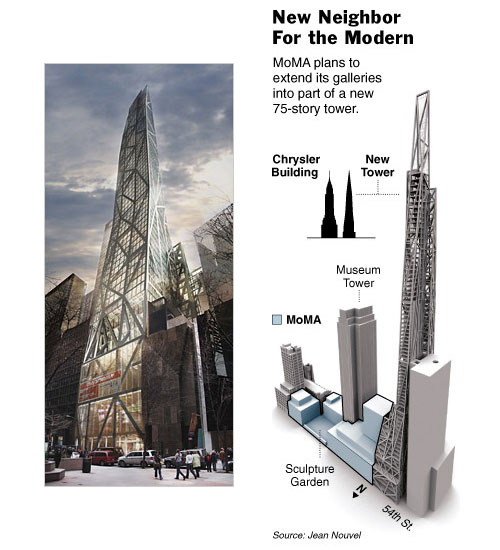
Nouvel's proposed tower next to MoMA Jean Nouvel is designing a new tower next to MoMA. Actually, it will give a much needed expansion to MoMA's exhibition space by devoting 3 floors to the museum. This question from the Times' Ouroussoff is key, "Yet the building raises a question: How did a profit-driven developer become more adventurous architecturally than MoMA, which has tended to make cautious choices in recent years?" The Museum of Contemporary Art San Diego has acquired 6 of the works it did not already own from their superb Robert Irwin retrospective (aka the best show of 2007)... this show has balls and their aquisitions do too. Last but not least Jerry Saltz is asking important questions about MoMA's lack of female artists. The Portland Art Museum actually does a good job of this currently highlighting Lee Krasner, Judy Chicago, Agnes Martin, Helen Frankenthaler, Lynda Benglis, Hilla Von Rebay, Dorothea Rockburn, Anne Truitt, Kiki Smith and Suen Wong, etc. For once PAM can claim bragging rights over MoMA (and it's something MoMA can easilly correct). Also, when will MoMA do a long overdue Benglis retro? Needless to say balls aren't everything... Posted by Jeff Jahn on November 19, 2007 at 10:37 | Comments (4) PermalinkFriday 11.16.07 MK in the WiBi 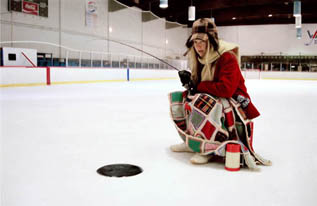 MK's portrait by Marne Lucas Congratulations to MK Guth who made the cut for the upcoming 2008 Whitney Biennial. MK is the director of PNCA's brand spank'n new MFA program and a longtime stalwart of the Portland art scene. Here's a short but recent PORT review of MK's work. Posted by Jeff Jahn on November 16, 2007 at 10:58 | Comments (0) PermalinkTuesday 11.13.07 Contemporary Northwest Art Awards: 5 finalists announced (PORT Scoop) Today, the Portland Art Museum announced the 2008 Contemporary Northwest Art Awards exhibition recipients:
Dan Attoe Cat Clifford Jeffry Mitchell Whiting Tennis Marie Watt My general reaction to this list is it's... solid, somewhat conservative (except for Clifford whom I was rooting for as an underdog) and very Northwest art-ish (aka lots of wood, craft, animals and tree references). For context, more agressively contemporary and less regionally placeable artists like Alex Schweder, Sean Healy, Jack Daws and Chandra Bocci (list goes on forever) were not of the 28 finalists from which these 5 were chosen so this list isn't really a surprise and curator Jennifer Gately has a very tricky balancing act to do. Her statement that she decided on, "works that resonate on distinctively regional yet universal levels," explains things rather well... to me that means a show which big time donor/collectors can be both challenged by and yet find familiar. A completely respectable list, but not bleeding edge... (more) Posted by Jeff Jahn on November 13, 2007 at 16:30 | Comments (2) PermalinkMore-akami 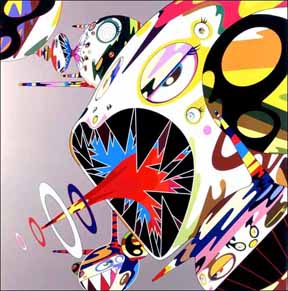 Takeshi Murakami, Homage to Francis Bacon (Study of Isabel ...), 2002 © 2006 Takashi Murakami/Kaikai Kiki Co. Ltd. All Rights Reserved. Private collection. On Artnet, Hunter Drohojowska-Philp has taken on the Murkami show at MOCA with lots of nice pictures. I'm a big fan but it is odd how Ive seen most of this work in other places (I first saw My Lonesome Cowboy and Hiropon at The Portland Art Museum in 2000 even). Murakami still matters but somehow I wanted him to do something more radical than a museum show, maybe something in a mall instead of moving the mall into the museum? My favorites will always be the Francis Bacon works, DOB inflatables, toothed mushroom paintings and the wallpapers. Also,Christopher Knight of the LA times also gives his take on Murakami ...all this is well and good but the best museum show of 2007 is Robert Irwin's retrospective in San Diego. Sure Serra was real good too but there is always something problematic about Richard Serra in a museum retro. Posted by Jeff Jahn on November 13, 2007 at 9:51 | Comments (1) PermalinkTuesday 11.06.07 Establishing an anti-establishment, comparing Rinder and Hickey 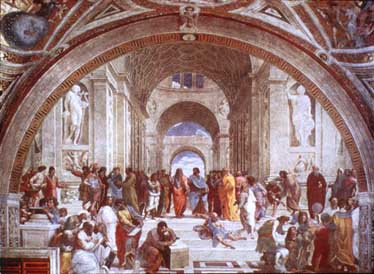 So far, the two most influential art shows of the 21st century have been the2002 Whitney Biennial curated by Larry Rinder and Beau Monde: towards a redeemed cosmopolitianism curated by Dave Hickey in 2001. The art-insider-unpopular WB was a fetished kind of amatuerism that was quickly co-opted by the arts system as a style (yet ironically got Rinder exiled), whereas conversely Beau Monde was simply too perfect as an ideal, hyper intelligent yet entertaining art show that sported grafitti art and foregrounded experience (most of the art was also big ticket). Together they signified the death knell of postmodernism (which was all about disassociation and alienation) and the reassertion of both craft and street culture as more important than the academy. Yet, it is funny how both Hickey and Rinder are anti-establishment and yet so firmly of it. Though considering the fact that Rinder is now a Dean at CCA is more of a true institutionalist, whereas Hickey seems to enjoy the material for writing that the paradox generates. Rinder has a former CCA student show at Liz Leach right now and Hickey has a similar but bigger production show about his UNLV days at the LVAM. At one time they seemed like polar opposites but now they seem like omnipresent sides of the same coin. For example, Paul Schimmel's Ecstacy show at MOCA seemed like a followup to both Beau Monde and the 2002 Whitney Bi. Now, there is more from Hickey and Rinder as they look back: Tyler Green pointed out that Dave Hickey's interview in The Believer is a great read, including some provocative gems like... (more) Posted by Jeff Jahn on November 06, 2007 at 10:16 | Comments (3) PermalinkThursday 11.01.07 Portland Art Center at a crossroads  Director Gavin Shettler in 2005 at the Portland Art Center's then new home in Chinatown The Portland Art Center has been attempting to fill an important role in the Portland arts community over the past five years, as a non-profit supporting the development of young artists while bridging the worlds of galleries, museums, and educational institutions. Now they're looking back to the community for support to cover a $40,000 budget shortfall. Although PAC has achieved some success with grants (a $50,000 grant from the Meyer Memorial Trust and $25,000 from the Lehmann Foundation) they have been unable to meet their sustaining private fund raising goals in Portland's difficult philanthropic environment. They're currently inhabiting an ambitious 10,000 square foot space, but the rent, although below market value, has become a heavy financial burden at $5,000 per month. As the Goldsmith building's lead tenant, it creates market pressures for developer David Gold and his bank, requiring PAC to scale up financially. PAC currently needs to raise $27,000 for back rent and $13,000 to cover salaries for its two staff members by December 1st. That isn't a lot of money considering the Portland Art Museum raised 40 million dollars back in 2005, but those people have been completely absent as major patrons ($2,000+) for PAC. Shettler describes the situation as, "at a critical point." For more information, please contact executive director Gavin Shettler at gavin.shettler@portlandart.org. Posted by Megan Driscoll on November 01, 2007 at 12:32 | Comments (7) PermalinkFriday 10.26.07 Last Chance Shows There are a large # of good shows that have gotten reviews that will be coming
down soon.
Here's a list and most (except where noted) end Saturday October 27th; 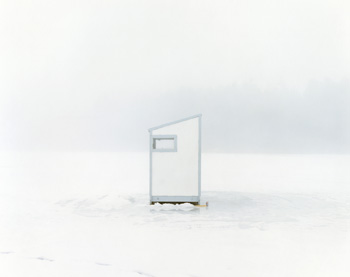 Scott Peterman, Fryes Leap (2002) C-print Charles A. Hartmann Fine Art though new is probably the tightest curated gallery space in Portland and his show of Scott Peterman's ice houses is a stunner. A very well received exhibition Brian Libby wrote on it for the O as did Chas Bowie at the Mercury. The work is haunting, desolate, funny, perfectly executed and sublime. Just blocks away Jesse Rose Vala's show at Motel is a similarly ultra tight effort. PORT's Amy Bernstein reviewed it here... (more) Posted by Jeff Jahn on October 26, 2007 at 13:42 | Comments (0) PermalinkWednesday 10.24.07 Wearing different hats and Portland hype? 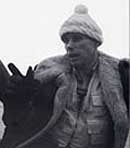
Here's an interesting article about Wilhelm Schurmann on Art Facts (Salvatore Reda pointed it out to me). In particular I like how Schurmann confounds those who try to categorize his activities and it reminds me of all those shortsighted people who seem to complain about how disciplines like curator, artist, collector, critic, historian, gallerist, philanthropists or board member are blurred together. We live in a true era of pluralism so all of this boundary blurring shouldn't come as...(more) Posted by Jeff Jahn on October 24, 2007 at 16:53 | Comments (16) PermalinkTuesday 10.23.07 PNCA and Portland an opportunity for growth 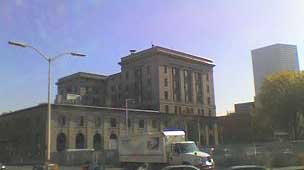 Potential site for PNCA After almost a week in California I'm back in Portland and I've been putting a lot of thought into PNCA potentially moving onto the North Park Blocks at 511 NW Broadway. Clearly the Pacific Northwest College of Art is very interested in the property as they currently rent their space, which does nothing for their financial stability. Being denied the opportunity to build equity they are subjected to the market forces of condo development in the Pearl and the situation needs to be addressed soon...(more) Posted by Jeff Jahn on October 23, 2007 at 12:44 | Comments (3) PermalinkMonday 10.22.07 PORT in Art in America November 2007 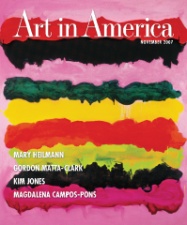 Finally, an art magazine has addressed the varied world of art blogging and PORT was lucky enough to be included in a wide-ranging roundatable discussion put together by Peter Plagens. Besides myself, the cogent voices of gallerist Edward Winkleman, Seattle PI critic Regina Hackett, Libby Rosof and Roberta Fallon of Philly as well as that art blogging machine Tyler Green are present (who once again had the scoop). It is a great article and I'm pretty proud of everyone involved as it presents a whole new world of cultural coverage to some who might not already be aware. I think it also dispells a lot of myths and persues the potential of the format. Most of the panelists seemed to go out of their way to point out other worthy sites as well... (more) Posted by Jeff Jahn on October 22, 2007 at 12:59 | Comments (1) PermalinkRobert Irwin's Primaries and Secondaries in San Diego  Robert Irwin's Primaries and Secondaries retrospective, which opened yesterday at the San Diego Museum of Contemporary Art may very well be the best show of 2007. More substance than flash, each of the mature works is a pragmatically transcendent experience and everything is nearly perfectly installed, he did after all have something to do with the development of the spaces he's using. Instead of the problems even a successful retrospective often produces, it seems as if no aesthetic and ideological compromises were made and no museum hype or baggage been put in front of the art. In fact, part of the reason Irwin is so good is because his work is not merely being accommodated by MCASD. Instead, he has developed an ethical, aesthetic, philosophical and spatial rapport with the institution. This connection spans decades and it makes both he and the institution look better. It also underscores how radical Irwin is... institutions don't merely take his work into account, they evolve to establish a more meaningful sonority, which is completely different than focusing on ticket sales. Arcy Douglass will have an in depth review of the show shortly, till then enjoy these images: ...(more) Posted by Jeff Jahn on October 22, 2007 at 9:02 | Comments (0) PermalinkMonday 10.15.07 Van Gogh for PAM 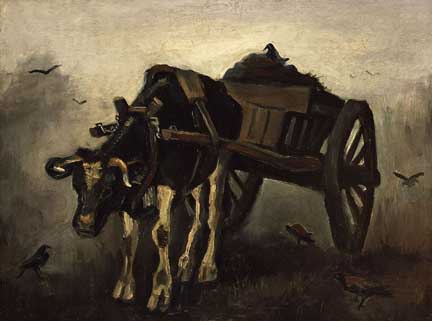
Allright, by now most everyone should know the Portland Art Museum has received a major gift of a Vincent van Gogh painting, The Ox-Cart (1884) from Roseburg's Fred and Frances Sohn. Frankly, such a generous gift is the only way such a painting by van Gogh could enter the museum's collection and it's worth many millions (in today's market 5-10 is my conservative guess, but that's rational thinking, at auction it maybe could have hit approached 15 or more). The Rijksmuseum has the other version of this work, which features a red ox instead of the black one here. Basically the money doesn't matter, it is the fact that its an important piece for the premier public collection in the state... (more) Posted by Jeff Jahn on October 15, 2007 at 17:48 | Comments (0) PermalinkThursday 10.11.07 Striving to be fresh and radical? Jerry Saltz is the kind of critic who cares about his art scene, he doesn't
just exploit it and his latest piece on the
health of New York's scene is an interesting read. He doesn't just present
the situation as pure doom though, he points out some bright spots and simply seems tired of the lack of radical
ideas.... hardly a problem exclusive to New York. The piece also seems to wish
for many of the things that Portland has (yet the Oregonian's coverage is a
tad over obsessed with our liberating lack of money without pointing out its benefits... there is a middle ground of course). No New York's scene isn't
dead and no Portland isn't the center of the universe but there are lessons
to be learned from both. The secret is simply how to be fresh or even innovative,
then get the credit for it? The words are so simple but the task is daunting.
 Proposed pedestrian and light rail bridge as designed by ZGF Also, what does everyone think of the ZGF design proposal for a new bridge over the Willamette that was in the Oregonian a bit ago? I think it is a decent design but top heavy, slightly unoriginal and a little inelegant, besides the nearby Marquam Bridge is a terrible design and the reason the Fremont Bridge is so good. The Marquam's bad design almost begs for something so good that that it is rendered invisible. Besides is "decent" really good enough for something that bridges OMSI with the South Waterfront and the Aerial Tram?... we have a design reputation to uphold and there needs to be a serious design competition. Why not invite Calatrava, Denton Corker Marshall, shop, and maybe Norman Foster to take a shot at this? Besides we have one of the best bridge collections in the the world, but it needs the highest quality addition. This just doesn't cut it. Posted by Jeff Jahn on October 11, 2007 at 12:11 | Comments (6) PermalinkTuesday 10.09.07 NAAU is the time for Couture Back in June PORT brought you the
scoop by announcing the New American Art Union's series of stipend shows,
where each artist gets $7,000 for producing a show that transforms the gallery
space and $1,000 for materials. Now called Couture,
the plan was an unheard of act of bravura, laying a direct challenge to The
Portland art Museum's Contemporary Northwest Art Awards (which should announce
its 3-5 finalists in November). It also allowed a commercial gallery to behave
more like a non commercial space. The
Oregonian (probably not wanting to be so scooped again) has the list and
promises a full article tomorrow.
The recipients are: Rose McCormick (whose current show at NAAU is a bit of breakthrough, her Wolf in the Henhouse is superb) Ty Ennis Jim Lommasson Jacqueline Ehlis TJ Norris Stephen Slappe Vanessa Renwick Laura Fritz Ethan Jackson The Video Gentlemen: Carl Diehl, Jesse England and Mack McFarland Overall, the list is heavy with perceptual experience artists like Ehlis, Jackson, Fritz, McFarland and Diehl. While Renwick and Slappe tend to create narrative tableaus with their video installation work. McCormick, Ennis and Lommasson are more traditional to their medias which are painting, drawing and photography respectively. Norris, McCormick and Lommasson are represented by NAAU but if this last year's group shows and this list are any indication, the gallery wont look anything like a sales gallery. Now all that matters is how the actual shows deliver. *Update: The Oregonian has published their digestion of the decisions and I'll refrain from discussing too many of their factual distortions but one has to be challenged... Renwick, Lommasson, Fritz and Ehlis are hardly the greenhorns David Row portrays them as. When Row states...(more) Posted by Jeff Jahn on October 09, 2007 at 11:56 | Comments (0) PermalinkSaturday 10.06.07 Last Weekend for Wes Mills 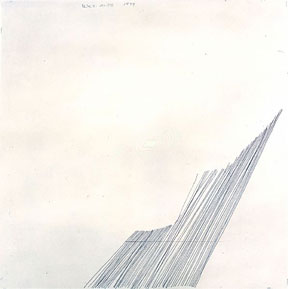 Wes Mill's Duchamp (1999) Just a remider to everyone, it's the last weekend for Wes Mills' Apex show at PAM. Here is Arcy's excellent review. A subtle show but one of the most rewarding exhibitions Ive seen since moving here 8.5 years ago...you just shouldn't miss it. It even plays well with the Ursula von Rydingsvard show. Yeah, there is a new Chuck Close print show at PAM too that I'm not very excited about.... he was Mr. early 90's and by that time was pretty much coasting on a reputation he had cemented in the late 70's. Still, if you are there why not see it too? Posted by Jeff Jahn on October 06, 2007 at 9:42 | Comments (6) PermalinkThursday 10.04.07 Around the web, now with more feedback On
The Cusp (from Indianapolis) gives Portland some feedback regardig my
follow-up post regarding the Tribune's big arts special section last week.
Yes, scene-wise I think OTC is right about us being ahead but Midwestern cities
always seem to have better museums and more established non-profits. I'm glad
he picked up on my "focus" argument it is crucial. I hope it catches
on here more.... (more)
Posted by Jeff Jahn on October 04, 2007 at 11:13 | Comments (0) PermalinkTuesday 10.02.07 Las Vegas Diaspora & Dave Hickey's Homecoming Dance 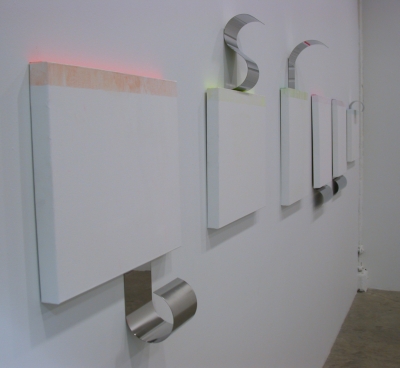 work by Jacqueline Ehlis on view @ Las Vegas Diaspora This past weekend, Las Vegas Diaspora: The Emergence of Contemporary Art from the Neon Homeland opened at the Las Vegas Art Museum. Curated by Dave Hickey. It is pretty much the first show he's curated since the groundbreaking Beau Monde: Towards a Redeemed Cosmopolitanism Site Santa Fe Biennial in 2001 and a follow-up on some of his top students like Yek, Tim Bavington, Rev Ethan Acres, Curtis Fairman and Portland's own Jacqueline Ehlis. All of whom are personal favs and many of whom Ive curated into shows over the years. Ehlis is one of the few girls in a guy heavy group and may be the Agnes Martin ascetic wth a wierd almost Martha Graham physicality of the group. She routinely does work that makes LA's best related attempts look soft (she's up at 5:00 AM in the studio). Bavington and Philip Argent are in MOMA's collection., Acres, Yek and Fairman etc. have been widely shown. Hickey's students are only part of his legacy. Beau Monde's basic premise was that visual pleasure (and the viewer's experience) was still important to art, DUH... but back then POMO theorists had their heads so far up their council-of-trent-like asses, somebody had to remind them. Hickey's ideas though widely debated at the time have been pretty much adopted and run with by in shows like, Paul Schimmel's Ecstacy show at MOCA, Olafur Eliasson at the Tate...(more) Posted by Jeff Jahn on October 02, 2007 at 11:56 | Comments (1) PermalinkWednesday 09.26.07 What Portland Needs to do to become a world-class arts city? The Portland Tribune did a "Re Thinking Portland" special section
yesterday on "What
do we need to become a world-class arts city?" Much of it smart and
features a fun and sometimes telling series
of napkin sketches of what Portland needs to achieve that world-class arts city
status. Though I dislike the term world-class.
Also, it isn't news that right now we are institutionally underdeveloped while having a massive influx of serious talent that has continued unabated for at least 10 years. The deluge has even increased and others have noticed. I like it that the author Joseph Gallivan compared Portland to Leipzig. One thing I've noticed is that people now seem to know the money to do serious things exists here but hasn't been fully marshaled yet. I also like how the artists take the burden of educating collectors and donors on as well. A city built by artists (some world-class) rather than a few patrons simply importing culture is a very special thing...(more) Posted by Jeff Jahn on September 26, 2007 at 9:10 | Comments (10) PermalinkMonday 09.24.07 Brophy Studio Fire 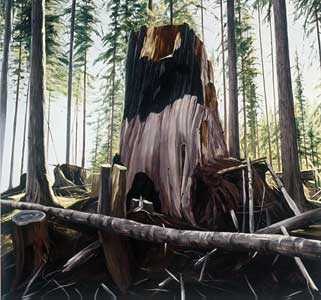 Slope Sadly last weekend the studio of noted Portland painter Michael Brophy burned. Katu news has the story and blog sans artifice has more details and pictures. Michael is too nice a guy to have such terrible luck and another artist Michael Wilson was also affected by this terrible fire. Brophy was to have had 2 consecutive solo shows in December and January at Laura Russo Gallery and according to Vanessa Renwick at least some of the paintings survived. The new works were often radically different than his previous work and were some of the strongest he done to date. If any are destroyed (which seems likely) it will be a terrible loss. We hope everyone's health and work were spared. Michael and Holly are said to be ok but shaken and staying with relatives. Brophy's studio itself was probably spared the flames but the real question is water damage as the space above was innundated first (oil paintings can survive deluge but there's all the falling debris). One cat survived and two others are presumed dead. Long time friend Paul Green described the scene as "horrible." I'll post more details as they develop, including where people can send their support and well wishes. Our thoughts are with everyone during this difficult time. *Updates: I took at look at the site yesterday and the damage is pretty extensive and certaily a lot of ireplacable things have been lost. It is eerie how it looks like one of Mike's paintings, which have all been transferred elsewhere to assess their condition and for safer storage. Another cat has turned up so only 1 remains missing and Holly's computer, according to Randy Gragg is, "being dried out professionally." If it is just water damage a lot of the hard drive's contents should be recoverable (let's hope). A tax deductable fund through RACC has been set up to defray some of the rebuiding costs as insurance probably won't completely cover the costs. Checks should be made payable to: Regional Arts & Culture Council Memo: for Michael Brophy studio rebuilding fund 108 NW 9th Avenue, Suite 300 Portland, OR 97209-3318 Also, more than one artist's studio was effected by this fire and the WWeek did a piece on Michael Wilson here. Posted by Jeff Jahn on September 24, 2007 at 10:56 | Comments (2) PermalinkThursday 09.20.07 The Guggernaught, GLARE and Barney vs. Hirst 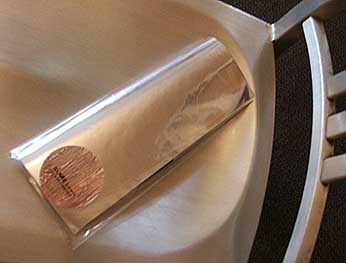 GLARE, a new international cultural publication out of Portland Now that we have recovered from the orgy of art activity in Portland last weekend we can look elsewhere again: For example, Jonathan Jones takes a gander at Matthew Barney and decides he is no Damien Hirst in The Guardian. I agree with that. Barney's objects are definitely props and don't hold up as well as the films.... and the films themselves are a bit like Salvador Dali's late work...(more) Posted by Jeff Jahn on September 20, 2007 at 13:23 | Comments (9) PermalinkMonday 09.17.07 Art hullabaloo weekend thoughts & pics  White Columns @ Affair at the Jupiter Hotel 2007, Photo by Sarah Henderson Well the big Portland vis art weekend has come and gone. Though it needed a name (Critical Mass, Too Much Art etc.) the scene was combination of The Affair at the Jupiter Art Fair, last weekend of Rembrandt at PAM, Ursula von Rydingsvard at PAM, last weekend of PICA's TBA visual arts, a bunch of openings, last weekend of Hap Tivey and a confluence of lot of other shows that are up all month. I've already reported on the Affair some here. It was a better fair for art this year and instead... (more) Posted by Jeff Jahn on September 17, 2007 at 11:26 | Comments (3) PermalinkWednesday 09.12.07 Suggestions for art visitors to Portland this weekend 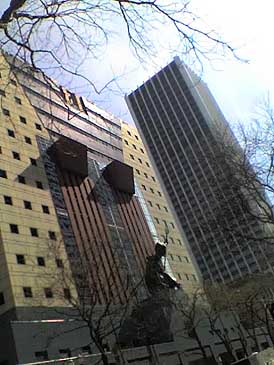 Obligatory photo of Portland Building Yes, there are lots of out of towners in Portland's galleries this this week and there will probably be many more by Friday. We even have Jetblue service so why not visit on a whim? In keeping with that theme some have asked for a Portland art guide so here it is: I humbly suggest using PORT's artist's guide to Portland as a way to find food, bars, coffee etc. The main art bars on the eastside will be The Doug Fir, Plan B, Rontoms and the Rocket due to their location. On the westside (by most of the galleries) Le Happy is where the in the know go but there is also the Lowbrow Lounge, Bluehour, 23 Hoyt, Portland City Grill and the Brazen Bean etc. Friday: The Affair @ the Jupiter Hotel Art Fair. Friday's opening festivities should be THE thing on your list. Saturday: If you missed the opening for the art fair do that, there is lecture at 2:00 too. What's more there are also a ton of good gallery shows open in the Pearl District and on the eastside. Those are links are pretty good guides. I think Motel's show and Mack Mcfarland's video room at PAC are also well done in Chinatown (PAC needs to execute a show as well as Mcfarland has every month) Small A will have an opening on Saturday night as well, of course there are lots of other more private parties too. For TBA's installation art shows I'd recommend, Sincerely John Head, Melia Donovan and The Lulic/Kreider show at Reed... some of the other stuff seems underdeveloped this year. The performance stuff is kinda out of PORT's focus but check it out if performance is your thing. If you want to do a winetour on Saturday hit Jenene Nagy's show in McMinneville and be sure to hit Panther Creek, probably the best winery north of Napa (burgers at Calamity Jane's is an experience you may need a doctor's note for). Sunday: I'd hit the Portland Art Museum (with Rembrandt in its last week, von Rydingsvard [who is lecturing Sunday too], Camouflage and Rock/Paper/Scissors it's an entitre afternoon you can't possibly regret and still like art. Other great Sunday options are Lewis and Clark College's really great Darren Waterston Show (a stunning campus on Palatine Hill if you want to see how grand/natural Portland can be), The Model Behavior show I curated for Organism and Reed's Lulic/Kreider show. Also, the Chinese garden is open for free this day too, that means a huge crowd though. Posted by Jeff Jahn on September 12, 2007 at 16:36 | Comments (1) PermalinkThursday 09.06.07 Director's chair We have been expecting Tyler
Green's interview with PAM's new director Brian Ferriso for a week now and it
doesn't disappoint. Nice to see press from outside of Portland give their
take on a guy we like very much and I think some of the candor Brian reveals
is a just a part of the very open, accessible civic/ethical dialog in the Rose
City. PAM's new drector has got a lot of work to do but he's making great headway. (disclosure I am VP of PAM's Contemporary Art Council)
There have been a ton of Ferriso interviews here in the last 8 months and PORT will probably do a formal sit-down with him and maybe some senior staff in the future but we really want things to be settled in more before we ask those nitty gritty and probably unique to Portland questions. I can say I know literally hundreds of people who have worked with him in Milwaukee and Portland and it is almost unanimously enthusiastic about his thoughtful dedication to the important role of museums. In short Portland has almost Roman civics and Ferriso seems to fit right in here. Museums should lead and challenge not pander to some statistical lowest common denominator audience. That strategy ultimately cheats everyone, while looking great on paper. Posted by Jeff Jahn on September 06, 2007 at 9:55 | Comments (0) PermalinkTuesday 09.04.07 We left our museum director in San Francisco It looks like San
Francisco is questioning John Buchanan in the same way we Portlander's were
for years before
he left. The problem is that museum directors shouldn't be preempting their
curators, they are two very different jobs and from our experience in Portland
most would say that John was very hand's on. To quote the late Gordon Gilkey
a curator who predated but passed away before Buchanan's term finished at PAM,
"he's a damn micromanager." I like the idea of Gordon having the last
word.
Tyler Green has been all over this and I remember our first phone conversation about John distinctly... let's just say everything I mentioned about JB's style has come to pass. It is no secret that the serious contemporary art community in Portland really had a bone to pick with him. Still to John's credit he did create the current Rembrandt show (which isn't fluff at all), the transformative Greenberg Collection aquisition, and allowed the Miller-Meigs series of contemporaty shows at PAM to happen. Maybe John can turn it around? Still, it is a fact... by the time he had left for San Francisco Portland had outgrown him. Posted by Jeff Jahn on September 04, 2007 at 9:52 | Comments (1) PermalinkThursday 08.30.07 Up at the PAMtation: Portland Art Museum continues to redirect itself  The Portland Art Museum has leaked a smidgen of their major programming for the coming years but the best stuff isn't on the list. There are lots of gaps and omissions, including a major contemporary retrospective (it is too early to be discussed yet, curated by Bruce Guenther)... so calling this lineup a more "regional" focus as the O does misses the mark. Especially considering recent acquisitions they failed to note and the lineup for the ongoing Miller-Meigs series which are not listed (other question is why does the O seem to want PAM to become so regional or isolationist?). Don't worry that isn't happening, the museum is easilly becoming more internationally relevant, while still being more serious about addressing the regional. *Update here's a quote from Ferriso: "Our goal in developing this series has been to harness the intellectual and physical assets of the Museum and community to stimulate interest and dialogue around key global issues: past, present, and future. ....This series includes large-scale international exhibitions, some conceived at other institutions, but the majority developed through the scholarship of our own curators." From outside Portland Tyler Green is loving this anti-bombastic, non-Krensian turn at the museum and let's hope this Portland trend will sweep the nation. The list below came out from...(more) Posted by Jeff Jahn on August 30, 2007 at 18:42 | Comments (5) PermalinkTuesday 08.28.07 Contradictions The Guardian
talks to Rem Koolhaas who is suddenly getting all nostalgic for older housing
options... interesting, it sounds very Portlandish. We like our neighborhoods
but are also starting to add some interesting architecture like the Aerial
Tram. Still it is the interesting residential projects like the Lair
Condominiums that are also proving to be very compelling here. We aren't
reinventing Brasilia,
LA or Manhattan in Portland. New projects by Skylab
could further demonstrate how Portland can have the best of both worlds, vibrant
non-homogenized neighborhoods and interesting design. Um... and how about Calatrava
doing the new
pedestrian, bicycle and light rail bridge across the Willamette river?
Koolhaas provides somewhat of an example for Portland, which has to own it's contradictions without resolving them in a tidy way. On Artnet Ben Davis dives headlong into the question of whether the art market(s) need a new form or forms of critique. I agree the Marxist critique does seem terribly inadequate. Art markets are places where contradictions find consummations. I suspect the high prices of key AbEx artists wont fall much even if there is a correction... they are too historically important, rare and central to understanding America to be effected much. Living artists selling for millions will have a different story. Posted by Jeff Jahn on August 28, 2007 at 11:26 | Comments (0) PermalinkThursday 08.23.07 Some things to check out Eva Lake did an interview with Barbara
Takenaga, listen to it.
Brittany Powell went art camping last weekend. Portland isn't like New York or LA, when we reference the woods and camping it's more legitimate we are litterally 30 minutes from jaw-dropping wilderness landscapes. Brian Libby asks SoWhat? when he visits the new John Ross tower. Libby continues to win cool-points for conflating JR Ewing with architecture (we gotta be about the same age, some 22 year old is not gonna get why Larry Hackman matters. Posted by Jeff Jahn on August 23, 2007 at 11:24 | Comments (1) PermalinkMonday 08.20.07 Art, Architecture and California 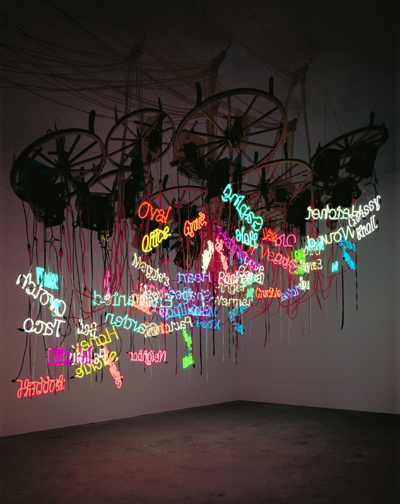 Jason Rhoades' Twelve-Wheel Waggon Wheel Chandelier (2004) After several days in LA and San Francisco I'm blogging from beautiful Ashland Oregon on my way back to Portland, where I will be installing this show in the Pearl District. It was a trip evenly split between art and architecture, including Neutra (ugh did Demi Moore and Ashton Kutcher put that monstrosity up next to the Lovell Health House?). I also saw great examples by Koolhaas, Mayne, Gehry, Frank Lloyd Wright, Herzog & de Meuron etc. The must see shows are... (more) Posted by Jeff Jahn on August 20, 2007 at 8:33 | Comments (0) PermalinkWednesday 08.15.07 Art market thoughts and unsolicited design advice Todd Gibson, who is sitting in for Tyler Green has chimed in on
the inevitable art market correction. I agree Doig as a living artist is
not worth 11 million and may not even be worth that much 30 years from now but
it's quite possible the 72 million dollar Rothko won't lose that much value. It may have been the ridiculously high prices that made that painting available
on the market in the first place. Sadly 72M is clearly out of range for the
Portland Art Museum, yet as the first place to give Rothko a solo show (and
the city where he grew up) it's a shame.. maybe someone will want a 60 million
dollar tax write-off?
How a correction might effect younger artsts who sell for reasonable amounts between 5-$50,000 remains yet to be seen. There isn't one art market now, there are several and I suspect the new popularity of art has created a legion of new collectors who will continue to collect even if they have less $$$ to collect. That would translate to a weeding out of galleries in New York and a shrinking of art fairs at Art Basel Miami Beach... but I don't think it will collapse the sane parts of the market. In fact it might support it. Portland's art economy isn't driven by hedge funds either, it is real estate, the fact that we don't have sales tax and old fashioned interested in art for rts sake collectors. If collectors get scared of manipulated markets Portland will look more attractive as a more genuine art ecosystem too. Sure a large scale correction hurts most everybody but it wont be fatal for Portland. Christies and Sotheby's might have some rough seas ahead though. Also, Portland Architecture's Brian Libby is soliciting some unsolicited design advice for Portland's developers. How about David Chipperfield for Multnomah County's new $150 million dollar project just north of the Ross Island Bridge hmmm? Posted by Jeff Jahn on August 15, 2007 at 10:29 | Comments (0) PermalinkMonday 08.13.07 Further developments? & the role of culture in real estate Seattle's very corporate style real estate development has acted like a mirror for Portland's rising skyline and rents for years (with some very important differences). Now Faith Ramos, Andy Royer and Arash Shiva have produced a telling look at Seattles South Lake Union with a documentary about development and gentrification in what was once Seattle's arts cradle. It should be of interest to any art scene in any rapidly developing city as a warning. It already seems too late for Seattle (i hope not but its why I moved here 8.5 years ago). After watching Heart & Sold, I noted how different most high profile developers in Portland are... (more) Posted by Jeff Jahn on August 13, 2007 at 9:50 | Comments (3) PermalinkWednesday 08.08.07 Developers & Art: what about an Amenity Bonus Program? 
Add Brian Wannamaker to the list of Portland developers who add to the art community here, and now the Tribune has covered his new Falcon Art Community project. The list of conscientious players here is long and very important; Al Solheim, Jim Winkler, Ken Unkeles, Brad Malsin, Randy Rapaport, David Gold and a while back Homer Williams was involved in the Pearl Arts Foundation, which brought us the Kenny Scharf Tiki totems and William Wegman dog bowl. These developers are partially why Portland is so unlike San Diego and Phoenix. Still, I believe it is essential that the city find a way to further incentivise development of live/work and exhibition spaces. Ive mentioned this many times before but in Vancouver BC the CAG (Contemporary Art Gallery) found a new home beneath a new condo tower because the developer received allowances for incorporating that crucial nonprofit as the anchor tenant (using VBC's Amenity Bonus Program). It's the difference between a Starbucks and serious exhibition spaces... (more) Posted by Jeff Jahn on August 08, 2007 at 9:30 | Comments (0) PermalinkTuesday 08.07.07 Taking stock 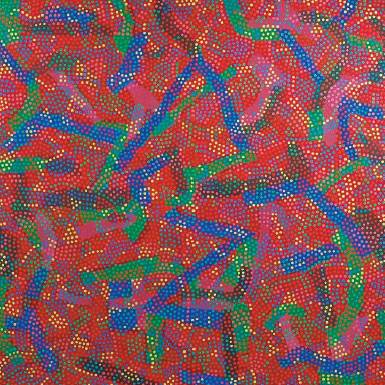 Untitled (1972) by Peter Young In case you missed it in the NYT's Roberta Smith took on the long overlooked Peter Young who has a show at PS.1. It seems fitting that with all the focus on psychedelia after Dave Hickey's Site Santa Fe show & the 2002 Whitney Biennial that some artists from the 60's and 70's might get a revival. Yayoi Kusama has already gone through the roof as have Jessica Steincamp, Chris Johanson, Karin Davie, Tim Bavington and Katarina Grosse. There is a younger group of artists like Takeshi Murata and Portlander Shawna Ferreira too. The Portland Art Museum even has an excellent Peter Young on display (fittingly in the big Greenberg room). The painting was given by the exceedingly sharp-eyed Ed Cauduro... the quality of his Warhols, Basquiats, Schnabels, Christopher Wools etc. establish him as the sharpest eyed collector in the Pacific Northwest. He even collected John Chamberlain's first crushed car sculpture, "Short Stop." Also, the projects shortlisted for the Stirling Prize in Architecture (for British architects doing great projects abroad) have been announced... (more) Posted by Jeff Jahn on August 07, 2007 at 11:00 | Comments (0) PermalinkFriday 08.03.07 Camouflage opens at PAM on August 4th with debut of a new Hirst 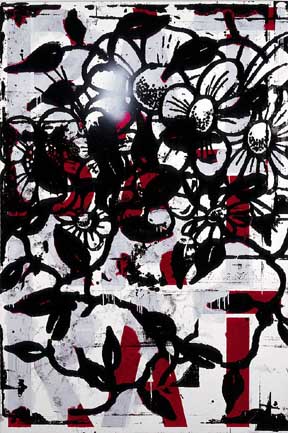 Christopher Wool, I Smell a Rat, 1989-94. Alkyd and acrylic on aluminum. 72 x 48 inches. The Broad Art Foundation, Santa Monica. I'm very excited about Camouflage at the Portland Art Museum, which opens this weekend...(more) Posted by Jeff Jahn on August 03, 2007 at 12:50 | Comments (0) PermalinkWednesday 08.01.07 Participating galleries for Affair @ the Jupiter Hotel Art Fair 2007 Portland's September 14-16th art fair has announced its participating galleries.
Posted by Jeff Jahn on August 01, 2007 at 13:05 | Comments (0) PermalinkBe sarcastic, or not? If you are in the mood for art world satire, this
bit skewers international biennial culture without mercy.
The PDXpipeline site outlines the tried and true formula for writing travel articles on Portland. But it should include some cursory mention of art (it is omnipresent here afterall, and the articles always seem to fit it into their formula). For something less sarcastic... the Guardian interviews Oscar Niermeyer. Though with all the gushing over Castro and the fawning over Brasilia's exceptional architecture (while avoiding its exceptionally iffy civic design) maybe some serious sarcasm is warranted. It's the sort of power meets buildings problem that often gets architects into trouble with historians and the people who have to live in their creations. Regina Hackett is discussing animals in Northwest art. Nothing sarcstic there, animals have been a big deal in the art world since the 90's. Posted by Jeff Jahn on August 01, 2007 at 9:53 | Comments (0) PermalinkMonday 07.30.07 Mark Rothko gets the Schama treatment tonight at 10:00PM Pacific on OPB 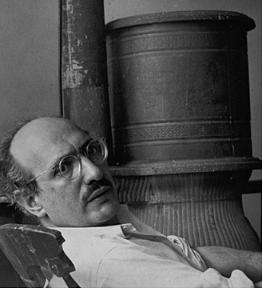 Simon Schama's Power of Art series winds up today on OPB with Portland's most famous art world personage, Mark Rothko. Rothko attended Lincoln highschool (as did Matt Groening, Mel Blanc and Elliott Smith... a pretty sarcastic bunch) and had his first solo show at the Portland Art Museum in 1933. Schama's other programs have been a mixed bag; Van Gogh was a sad dry run for a made for TV movie and Picasso was a boring basic art historical regurgitation but his episode on Bernini was brilliant. His episodes on Rembrandt, Turner and David all offered great scenery and compelling stories that I found inspiring despite the requisite dramatizations. Rothko is a fitting end to the series and I have no idea whether the program will acknowledge that Rothko grew up in Portland. The effect of Portland's dramatic skies on his sense of color and use of grey are pretty undeniable, yet sadly the biggest gap in PAM's collection is indeed a major Rothko (he is depicted in a Milton Avery in the collection though). We do get see some major loaner Rothkos here from time to time though (like his Homage to Matisse last year). The city was beginning as a sad kind of cultural coma when Rothko left so nobody today questions his decision to leave. Back then you hd to go to New York, these days New Yorkers tend to want to move here. It's very different today and it always strikes me how much Rothko's writings remind me of certain Reed alumni I run into at Portland coffee houses. HDTV people can see it at 7:00 PM everone else has to wait until 10:00 PM. I know a lot of Portlanders who dont even bother to own TVs so maybe we can all meet at a Pearl District sports bar and do the unthinkable, subject the monday night crowd to cultural programming! Posted by Jeff Jahn on July 30, 2007 at 9:00 | Comments (7) PermalinkFriday 07.27.07 Contemporary Northwest Art Awards list shortened Well the list of 28 artists for the 2008 Contemporary Northwest Art Awards
is out and 3 to 5 of them will make up the exhibition next June. One will be
awarded the $10,000 Arlene Schnitzer Prize...(more)
Posted by Jeff Jahn on July 27, 2007 at 10:01 | Comments (0) PermalinkWednesday 07.25.07 Perspectives on Desoto project and history lesson 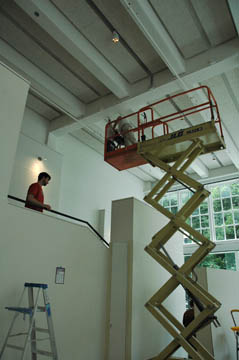 Museum of Contemporary Craft exhibition space photo by Sarah Henderson Ok now that the big opening weekend has ended let's give the Desoto project some more sober analysis beyond the not underserved fawning weve already experienced...(much more) Posted by Jeff Jahn on July 25, 2007 at 13:35 | Comments (6) PermalinkThursday 07.19.07 Cook'n with PAM (and a look at the latest acquisitions) 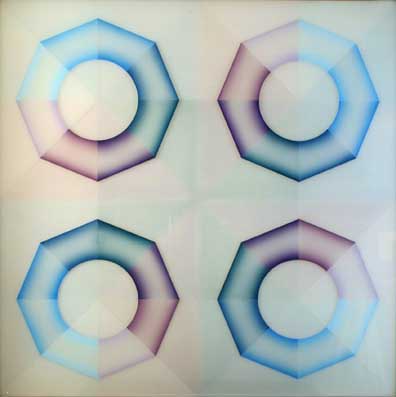
One of PAM's latest acquisitions: Judy Chicago's Pasadena Lifesaver, Blue Series #4(1969-70) Acrylic lacquer on acrylic It is pretty clear now that the Portland Art Museum is a very different institution than it was in 2005. PAM has taken a decidedly more intellectually engaged turn since Brian Ferriso took over. Here are some scoops and other info nuggets regarding PAM's new Director, CNAA, programming and latest acquisitions.... (more) Posted by Jeff Jahn on July 19, 2007 at 14:50 | Comments (2) PermalinkTuesday 07.17.07 Interesting combinations & feedback The Guardian reports that Saatchi has teamed up with an auction house to provide free admissions.
Steven Holl's new Nelson-Atkins Museum expansion has people raving, be it from Paul Goldberger to Tyler Green. I keep thinking somehow that the failure of the Bellvue Art Museum in Seattle cost Steven Holl the MoMA gig and we all lost out with a rather conservative museum. Hell, even the new Seattle Art Museum (which is basically a lil MoMA) seemed to be created in the shadow of BAM's sad sad failure. The very best living museum architects are (in no particular order): Herzog & de Meuron, Tadao Ando and Renzo Piano because they all seem to be able to create iconic architecture that is also ideal for viewing art (Koolhaas, Libeskind and Gehry are way more idiomatic). Is Holl about to crack into the top tier by being both fresh and subtle? PORT pals Ultra PDX do what we don't do here, focus on PORT staff outside of art making or relevant art opinions. Their latest Ultra Q focuses on PORT business manager Jenene Nagy. In the past they've asked some blond PORT people a few questions as well. Also, I Dont Know (an excellent site I just became aware of) found what I had to say about Bryan Shellinger useful for discussing Tomma Abts. I definitely had her in mind as well but I had to draw the line somewhere in that orgy of abstract painter namedropping. Always exciting when there is a little intellectual feedback, thanks... (more) Posted by Jeff Jahn on July 17, 2007 at 17:10 | Comments (2) PermalinkMonday 07.09.07 Milepost 5 I toured the Milepost 5 facilities few months ago and this could be great, yes there are rental units as well.
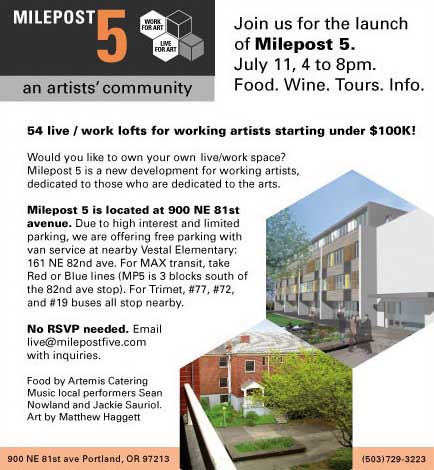
By providing both affordable condos and afforable live/work space this could be a model development. What is nice is they have opted to not over define what all of the common spaces will be used for. Of course the real trick will be how they determine who gets in. Bad gatekeeping (aka petty and tasteless cronyism) would be disasterous and good gatekeeping (smart people with open minds, good taste and not much pointless drama) could make this a model development. ...(more) Posted by Jeff Jahn on July 09, 2007 at 15:37 | Comments (0) PermalinkFriday 07.06.07 Transformation Ok we are nearing the end of the conceptual phase of PORT's redesign and moving into the actual site redevelopment. The funny thing is it won't look that different when it is done but the refinements and flexibility it will offer us will be quantum.
You should see it by the end of summer and yes we will have bash as an unveiling
+ a somewhat belated celebration of our 2 year anniversary.
Till then check out these interesting bits: This VIP garden in Slovenia is frankly awesome, something about plants and architecture really works. A restaurant or lounge like this would go over really well in Portland. Ok so the Hanging Gardens of Babylon provide a pretty good template for this type symbiotecture. This New Yorker review of the must miss but must discuss Transformers movie is most certainly a better use of your time than the actual movie. I want Wes Anderson to do a Gobots movie with David Bowie as Leader1 and Lyle Lovett as Cy-kill. Um, yes... a musical, does it deserve any less? Lastly Jerry Saltz did a good thing by avoiding the opening hooplah of the Venice Biennale and his take points out a new direction for him, having the last word rather than the first. Also, Saltz's recent take on Biennial culture is almost as funny as the whole transforming robot obsession. Jerry how about a your first broadway musical?.. call it "Biennial." Kelsey Grammar, William Shattner, Courney Love and maybe Nicholas Cage would all be good people to play curators. Allright, I've abused the whole lets turn it into a musical meme enough now. Posted by Jeff Jahn on July 06, 2007 at 10:38 | Comments (0) PermalinkWednesday 06.27.07 WSJ way off base on Robert Storr Tyler Green is 100% right
about this. When the Wall
Street Journal questions Robert Storr's curatorial understanding as possibly anti-Semitic it comes
off as one of the most flippant, unsupported swipes I've ever seen in a major newspaper.
Look, PORT doesn't have an editor but there is no way I'd let that serious a charge pass without some hefty case building. We have a saying on the internet:
PPOR!
Plus Storr is one of the most open-minded, impossible to fathom as anti-anybody people I've ever met. Storr is a class act. Posted by Jeff Jahn on June 27, 2007 at 15:37 | Comments (5) PermalinkTuesday 06.26.07 Press A reminder to artists, galleries, and event organizers: If you want your opening, event, lecture, etc. to be posted at PORT, it needs to make it to my inbox! driscollm at gmail dot com.
Posted by Megan Driscoll on June 26, 2007 at 8:27 | Comments (0) PermalinkMonday 06.25.07 Great to be back Thanks for bearing with our server outages Saturday night and Sunday. BIG thanks to Philippe, Jenn and Katherine.
Here are some recent things in local publications: ... (more) Posted by Jeff Jahn on June 25, 2007 at 10:51 | Comments (13) PermalinkWednesday 06.20.07 Dates for the Affair at the Jupiter Hotel Art Fair 2007 
Simply put The Affair at the Jupiter Hotel is just one of the nicest feeling art fairs I've been to. It's also becoming more of an attractive destination each year for those outside the region. According to the Portland Art Focus web page the event is supposed to take place September 14-16th, which is during the tail end of PICA's TBA festival. That is a few weeks earlier than last year and resolves a few conflict with other events internationally while doubling up on TBA's draw. We will let you know about the gallery lineup as soon as it is available. Posted by Jeff Jahn on June 20, 2007 at 17:38 | Comments (2) PermalinkTuesday 06.19.07 An artist's guide to Portland 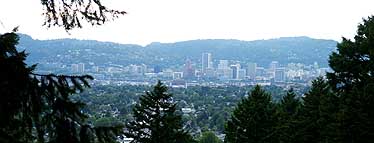 With a relentlessness seen in very few places, Portland's citizenry love to discuss and attempt to define Portland. It is an impossible pastime. Still, as part of our two year anniversary PORT asked 7 artists to take a shot at picking what is good and or "definitely Portland" about Portland... Also, it is a good time to visit Portland with Rembrandt and a lot of other good shows too. ...(much more) Posted by Jeff Jahn on June 19, 2007 at 11:09 | Comments (3) PermalinkMonday 06.18.07 Venice Biennale 2007: Aftermath Reactions to the 52nd Venice Biennal in the wake of the initial frenzy.
(more) Posted by Megan Driscoll on June 18, 2007 at 9:07 | Comments (2) PermalinkThursday 06.14.07 Around the Web: Venice Biennal 2007 Edition 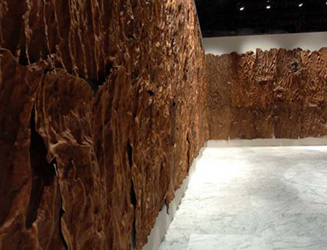
Penone, 52nd Venice Biennale "Think With the Senses - Feel with the Mind. Art in the Present Tense." The 52nd Venice Biennale commenced last week, and everybody's talking about it. (more) Posted by Megan Driscoll on June 14, 2007 at 11:16 | Comments (3) PermalinkWednesday 06.13.07 Sammy say's get organized 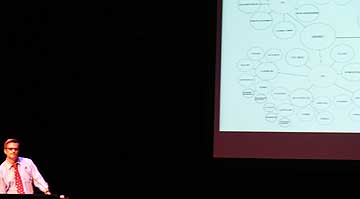 Sam Adam's wears a polka-dotted tie and addresses the creative community Ok last night's well attended town hall was about what I expected, taking several hours to state what can be summed up in 5 minutes: 1) The arts are a huge...(more) Posted by Jeff Jahn on June 13, 2007 at 17:41 | Comments (3) PermalinkMonday 06.11.07 Keep your pants on I'm going to save my "routine physical" article on the Portland art
and design ecosystem till after Commissioner
Sam's shindig tomorrow night. Till then check in on Winkleman's
Venice compendium. I know a lot of Portlanders that are doing the big European
art junket this year.
Posted by Jeff Jahn on June 11, 2007 at 23:45 | Comments (0) PermalinkGravitating towards Serra 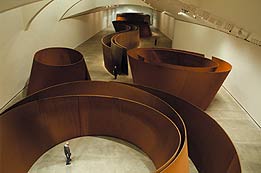 Serra's permanent installation "The Matter of Time" at Guggenheim Bilbao Peter Scheldjahl has chimed in on Richard Serra's survey at MoMA in The New Yorker here (love their new very linkable site). Jerry Saltz, Scheldjahl's gutsier, less poetic antipode says much the same but focuses better on the intimate (for Serra) work here. Like Saltz, I'm especially fond of Delineator, nothing by Serra before or since does as much with elemental gravity, if I were creating a dream collecton it would be a must have. I've had a lot of really interesting conversations about Serra recently and...(more) Posted by Jeff Jahn on June 11, 2007 at 10:18 | Comments (1) PermalinkThursday 06.07.07 Arts = Prosperity? RACC just released its latest Arts
and Economic Prosperity report yesterday here. This is the third in the
series, the second one took place in 2001.
Some interesting bits: Arts organizations are seen as key for tourism and therefore aren't so "dependent" on the larger economic climate, instead they take an active driving role in the overall economic health of the city. I realize this is preaching to the choir but studies like this might get the Portland business community more behind arts funding. Things like TBA, The Affair at the Jupiter Hotel, the Portland Art Museum and all of the exhibitions that regularly take place here do have an effect, The latest report puts the total economic contributions of arts activity at 318.26 million dollars, that is up from 262 million in 2001. That said, support for the arts is hardly keeping up with the massive increases in activity in Portland and in general the artists are completely under supported... there isn't even a decent suitcase fund for artists who wish to show elsewhere. Portland is doing well as a cultural incubator in spite of bass-akwards arts funding approaches... which plays into Comissioner Sam's talk tuesday... Im apparently jamming some guitar with Adams Saturday night for the the Bus Project "Wheelies" VIP event so this is all interesting. I'll have a very comprehensive article on the Portland art and architectural climate/ecosystem on Monday, probably the most important piece of writing I've ever done. Posted by Jeff Jahn on June 07, 2007 at 16:28 | Comments (10) PermalinkMonday 06.04.07 Sam the creative politician man?  Commissioner Sam Adams (is he running for Mayor?) The creative community in Portland is supposed to be a front burner political issue so Commissioner Sam Adam's wants your input on, "how to reach Portland's full creative capacity?" Hopefully this wont be your basic, "let's listen very closely and do nothing," approach that politicians have perfected over the years. I'll be there and yes I suspect whoever comes up with the most intelligent creative sector plan will be the next Mayor. Arts & Culture Townhall. RSVP to Polly Birge. Tuesday, June 12, 2007 6:00 to 8:00 p.m. (Doors open at 5:30) Portland Center Stage, 128 NW Eleventh Ave at Davis St. Hosted by: Sam Adams, Portland’s Commissioner of Arts and Culture; Portland Development Commission; Regional Arts and Cultural Council; and Northwest Business for Culture & the Arts Beverages and light snacks will be served. Wine, beer and alcohol available. What is Creative Capacity? Checkout Sam's website This townhall is free and open to the public but space is limited so please RSVP by Friday, June 8, 2007 RSVP to Polly Birge. If you've already RSVP'd, no need to do so again. Posted by Jeff Jahn on June 04, 2007 at 1:11 | Comments (0) PermalinkFriday 06.01.07 PORT turns 2 Today is PORT's second anniversary. It's still a labor of love but being the top
ranked google site for "Portland Art" plus a large readership that doubles
every 3 to 5 months is definitely rewarding. Our goal has been to provide an intelligent,
internationally relevant and critical
voice for the Portland Art Scene. Since the visual arts are one of the key
forces transforming Portland, PORT's role makes it no ordinary blog. It's exciting
how many international readers find the site worthwhile too and being influential
at home doesn't hurt either. (Stay tuned, I'll have Rembrandt post later on today)
Actually, we don't get enough chances to thank you PORT readers and sponsors. Take a bow... (more) Posted by Jeff Jahn on June 01, 2007 at 0:26 | Comments (3) PermalinkWednesday 05.23.07 Withering Criticism Ahhh, David Row over at the O blogs has yet
another insecurity filled diatribe on criticism and bloggers... which is
generally spot on in theory, though needlessly reactionary towards democratic
expression. Look, people with little worth as critics don't attract audiences
and have little opinion shaping authority. Yes, newspapers are full of near
useless critics, they also have some good ones (the O's Shawn Levy is good and
Randy Gragg recently left).... elsewhere The LA Times Christopher Knight is
superb as are Roberta Smith and Regina Hackett at the Seattle PI (who should
be lured to Portland... it will take more than breadcrumbs).
Sure, everyone is capable of being critical but a critic is someone who develops a critical practice with an awareness and responsiblity to the relevance of the words (even when the critic is just wrong, real critics risk it). I'm trained as a critic/historian and I remember the 600 level writing course in grad school as a kind of relentless hypercritical boot camp, but the truth was I was always thinking, "what does this mean?" Having been raised Lutheran didn't hurt either, but I ultimately liked the critical part more than the religious elements. It is true, good critics are really hard to find and when PORT hires someone I usually end up with these strange moments where I try to look at the gestalt of the potential critic and I think, "do they have it in them to do this month in month out?" The secret is they always have to care about the subject deeply, then back it up with knowledge... not just a reaction. There is a place for tour guide wordsmiths but they arent as influential as the critics with teeth. A critic who isn't into their subject isn't an effective critic. I'm amadant that PORT's critics have strong art backgrounds but that is just the starting criteria.  Gursky at Matthew Marks this month For example of the real deal, read Jerry Saltz's latest here. I think he's wrong about Gursky's post 9/11 importance, but I can see how this show looks out of touch. Is Gursky just whistling past the graveyard? Well maybe, but it reflects the way power and amnesia inducing commerce do act these days. Did 9/11 change consumer's appetite for Soma? No. For example there are the Global Warming Ready Diesel ads, a kind of reverse psychology ad campaign aimed at youth's ability to ignore the obvious while not being ignorant. One that Ive seen in Rolling Stone etc. sports a young, good looking couple cavorting atop a skyscraper. Below them it appears the ocean has covered the cityscape in a kind of Neroesque catastrophe (have the polar ice caps melted?) One can clearly make out that the rich have survived the deluge in party yachts sailing the ruined civilization. Is Gursky out of touch? not so much as he is in touch with the out of touch. Saltz is right that it might be getting old and watered down, but when does a lie that tells the truth really get old? As a true critic Saltz gets it wrong for the right reasons. As a fan I would like Gurksy to kick it up a notch because he's gotten a little too close to the Diesel ads so Jerry's kinda right. Posted by Jeff Jahn on May 23, 2007 at 13:23 | Comments (11) PermalinkTuesday 05.22.07 PNCA Benefactor To Lead a Major Cultural Breakthrough for Portland PNCA just received a major gift that will provide the final push in transforming it from a small, struggling school to a major force in the art world. Hallie E. Ford and the Ford Foundation will donate $15 million, twice the school's annual budget and the largest single donation to an Oregon arts institution ever. $10 million will go to building a new artist residency program, which will not only allow PNCA students to work closely with internationally renowned visual artists, it will also bring a network of innovators into Portland. The Portland art scene stands to benefit immensely both from the establishment of PNCA as an important arts institution within and beyond the region, and from the influx of artists and ideas that the residency program will contribute to the community. Read more about the donation, as well as all the recent improvements at PNCA, on OregonLive.
Posted by Megan Driscoll on May 22, 2007 at 12:13 | Comments (2) PermalinkMonday 05.21.07 Oregon Biennial, not so dead? The Oregonian has a bit on the
newest iteration of the Oregon Biennial today, it has resurfaced at the Portland
Art Center. Good move, It is a turning point for PAC because they are known
more for good intentions than authoritative programming and this forces that
issue (Gavin's honest about it and understands this as a growth opportunity).
I'm endorsing it and suggested this obvious move (with some cautionary caveats).
Yes, I've been in on this, which is why I haven't said anything till now (sometimes
scoops matter less than letting things catalyze and develop)...(more)
Posted by Jeff Jahn on May 21, 2007 at 10:25 | Comments (17) PermalinkFriday 05.18.07 Rosalind Krauss and Miranda July separated at birth? 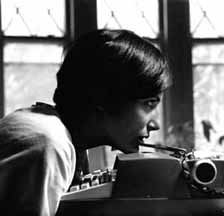 
In my somewhat differently kiltered mind Rosalind Krauss and Miranda July are twins separated at birth... as both explore different aspects of alienation with piquant clarity. Ok so Krauss is a touch more academic… Krauss is one of the most important Modern and Postmodern critics having written, "The Originality of the Avant-Garde and Other Modernist Myths." It will be interesting to see how she's reacting to these relatively anti-theory driven (but career oriented) art times. Catch her at the Portland Art Museum Sunday May 20th at 2:00 PM. $5 members, $10 for everyone else. July is Western Civilization's 21st century postergal for the early aughts (look it just can't be Paris Hilton). Of course she's a former Portlander and yes she is speaking tonight for PICA at the First Congregational Church from 7-8PM on her new book "No One Belongs Here More Than You." Amazingly tickets are still available at the door. $10 for members, $13 for everyone else (so get em early today) Posted by Jeff Jahn on May 18, 2007 at 12:04 | Comments (0) PermalinkWednesday 05.16.07 Complicated Complications  Mark Rothko Mark Rothko (who grew up and trained as an artist here in Portland) just shattered the auction record for contemporary work... he would have hated this. Some day Portland will have a major Rothko of its own on display, dammit! Oh well, if his works keep setting records I half expect Rothko's ghost to show up and get all "Raiders of the Lost Ark ending" on the auction houses. At the same time it's probably worth the price paid. Back onto the art, I really enjoyed Peter Schjeldahl's take on Chris Burden. I like how he highlights how Burden was taking pains to be taken seriously as an artist. Most artists who admire Burden don't do the same thing, they just reference his work and do something much easier to do. The difference between Burden and Burden-lite is a sense of earning the attention by truly polarizing people rather than just trying to use the conceptual as a form of insinuation or secret handshake of initiation. Just hanging out or referencing Burden isn't in the same league. Burden put the viewer on the spot so well you don't have to have seen it to feel uncomfortable. Successful art is often complicated, great art simly is complicating... a radical agitator like Burden is a great example. Also, Schjeldahl's take on Hopper pinpoints why he's such a useful writer (at least on completely established, major artists), he's an accessible but challenging wordsmith. Schjeldahl complicates very strong work with equally deserving words. The only wordsmith better is Hickey, whose just scary even when he's not convincing (which has it's own curse). Tyler Green is probably right, the Hirshhorn is perfect for Wolfgang Tillmans. But is it a crutch? Is the installation the selling point or just packaging for the blockbuster? Now I dont think Tillmans is fluff he's real good. His more abstract stuff is consistently dazzling as are some of the portraits and still lives, but is the entertainer/installer upstaging the photographer from time to time? Does that matter?...maybe not, since the installations are often so good. Here's what I wrote on the show last year at the MCA. Posted by Jeff Jahn on May 16, 2007 at 14:13 | Comments (6) PermalinkThursday 05.10.07 Bore me with the details? It's been ridiculous for several years but the auction house madness continues.
Here is some auction house reading that tends to bore me in interesting ways:
Artnet has a nice report on Sotheby's 278.5 million dollar art-o-rama... completely boring except for the fact that Lyonel Feininger is getting some respect (he's my Mom's 3rd favorite artist, but she only likes the cityscapes, her fave is Pierre Soulages... which impresses me for it's flat out obscurity). Then there were the Christies sales, which Artnet saw as a sobering of the market. Also on Artnet is Charlie Finch (who usually annoys me), he does some number crunching on the hedge funders. Sure, doom is coming but probably in the Fall at the earliest... (it might be years from now though, egad) Today in the NYT's Carol Vogel, whom I also find really tiresome, took in some European bargain hunting. Maybe it's only a matter of time before some artist creates their own sarcastic auction house where sculptures of Tobias Meyer etc. will be sold at inflated bargain prices to Europeans taking advantage of the weak US dollar? Years ago Edward Winkleman took on the doit de suite issue, would it help artists and their heirs by cutting them in on the action? A lot of the cooler major collectors I've met hate auctions and I can see why... and yes lot of the stuff offered just isn't that good (yet goes for a premium). Auctions aren't about patronage and it distracts from the pursuit of new work and ideas. The money part bores me and isn't any more surprising than other silly crowd-feuled behavior like the Macarana. Posted by Jeff Jahn on May 10, 2007 at 10:37 | Comments (0) PermalinkTuesday 05.08.07 Around the Web Sun Blindness? On Friday, the LA Times covered one Southern Californian's trek through Portland...
A Vision of Voyeurism: The New York Times recently covered the photography of Ryan McGinley... Paris Meets the 21st Century: An American ex-pat once told me that Paris is a dead city... Keeping His Cool: The Boston Globe this week detailed the rise of Zach Feuer... (more) Posted by Megan Driscoll on May 08, 2007 at 17:37 | Comments (0) PermalinkSunday 05.06.07 PNCA Launches MFA Program Ok most insiders have known about this forever but the Pacific
Northwest College of Art has now officially launched its MFA program, giving
Portland a much needed second MFA. Previously only PSU produced MFA's but PNCA's
program is unique in the region because it is mentor based, which a little similar
to what Goldsmiths
college's does. The 15 MFA candidates have already been selected and will
start in the Fall. Notably, 75% of the candidates aren't from Portland (which
is just about in keeping with the general population of Portland's art scene
these days). The competition should also highlight the need for PSU to get more
serious about its program (which has improved tremendously with little support).
Here's what PNCA says via MK Guth, the new MFA program's chair: ... (more) Posted by Jeff Jahn on May 06, 2007 at 18:36 | Comments (3) PermalinkFriday 05.04.07 Weekly Reader I'll have the First Friday post up for you a little later, till then here are some art good reads:
Robert Storr discusses the upcoming Venice Biennale. Storr's take on mixing the politics of the conceptual and perceptual are right on and I hope his show is extra influential. Paul Goldberger discusses a new Steven Holl Museum addition. Roberta Smith takes on Frank Stella's continuing slide into glorified mall art. I'm a fan of the pre 90's stuff, somebody stop him... he's become the art world analog of late Vegas era Elvis. Having the Met join in doesn't help. Also, Brian Libby has 2 cool bits. #1 is a post on AIA's new HQ's in the Pearl and #2 is on a dormant building with a cool facade that Brian, myself and Philip Iosca (among others) just love. Posted by Jeff Jahn on May 04, 2007 at 10:45 | Comments (0) PermalinkTuesday 05.01.07 New Seattle Art Museum opens, designed by Portland architect 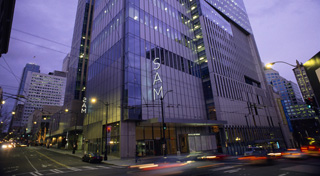 Most of you know the Seattle Art Museum is opening its new wing this week, designed by Portland's own Allied Works Architects. It opens to the public next Saturday and to members today. The building itself is pretty conservative and won't dethrone Rem Koolhaas' library as the most awesome structure in Seattle but in some ways that's good, Ive grown weary of stunt architecture for museums. Seattle is a city that collects architects and it is nice that this building is designed to deflect attention to what kind of art Seattle collects. I toured the new facilities a few weeks ago with SAM's new contemporary curator...(more) Posted by Jeff Jahn on May 01, 2007 at 22:07 | Comments (3) PermalinkThursday 04.26.07 Just what Miami needed Tyler has the scoop on the Aqua Art Miami art fair this year. It's the fair where one has traditionally found the most Portland and Seattle galleries and in general I always liked the feel, which was originally patterned on Portland's Affair at the Jupiter Hotel fair.
Now it looks Aqua is upgrading and I sense an art fair arms race, or is it a space race? It is true we here in the Northwest have a thing about space. Nice Dirk, you found a way to make Miami more competitive... sheesh Posted by Jeff Jahn on April 26, 2007 at 20:38 | Comments (2) PermalinkTuesday 04.24.07 Some things to chew on A review of
Ellsworth Kelly works in the Guardian. So abstraction isn't a big enough
crowd pleaser at the Tate Modern? egad.
Roberta Smith spins a wonderful web of words on Sol LeWitt. Brian Libby recaps the Street of Eames in Portland (aka design obsessed city rapidly trying to end years of bleh design... related: see new tram review). Normally I'm annoyed with focusing on the party and not the art... and I hate Pabst (because I'm from Milwaukee Wisconsin and Pabst is the beer that made Milwaukee famous... and it's no longer made in Milwaukee etc) but I just plain feel like linking to ths PDXFF blog. Posted by Jeff Jahn on April 24, 2007 at 22:45 | Comments (2) PermalinkFriday 04.20.07 Around the web Jerry Saltz's latest
article for NY Magazine proves why he's the most important art critic on
the planet. That alone should be enough for you to check it out, but if you
need more; he deals with the pacification of ideas and intent in the art world
right now. Now don't get me wrong, all of the art of today isn't just some liberal
guilt pressure valve for trustfunders but a lot of it is. Why?...because it lacks a
radical impulse. Instead, a lot of today's art is based on ingratiating itself. When other critics simply ignore this problem Jerry gets at the issue, calling PS1's bluff.
Yes, I know I've been giving him a hard time lately but DK Row has picked up one of my old saws... why isn't PSU more serious about its art department? Right now, it's the only MFA program in the city and doesn't have a full time curator despite having several nice gallery spaces. PNCA will have a MFA starting this fall and there are (unconfirmed) rumblings that Reed is looking to start one as well. This puts pressure on PSU to become serious. Also, not to nag but the Oregonian should do more of this, PORT can't do everything and we really try to limit ourselves to art criticism instead of investigative art journalism. The Willamette Week reviews a show at city hall. Note how mixing with artists has become a political move in Portland? Still, I've yet to see a single politician present anything convincing in regards to the city truly bettering the arts? Why not be like Vancouver BC which allowed the CAG to move to a new space by providing incentives to condo developers? The Mercury reviewed Motel's latest show too. Yes, someone on the forums at Artdish has noticed that there is a ton of photography in Portland with Photolucida this month. It's a nice overview that we dont do here. (PORT's focus is more on in depth reviews for individual shows). Also, Ive added yet another update to the Contemporary Northwest Art Awards news as a followup. Posted by Jeff Jahn on April 20, 2007 at 12:49 | Comments (15) PermalinkMonday 04.16.07 Goodbye Oregon Biennial, Hello CNAA 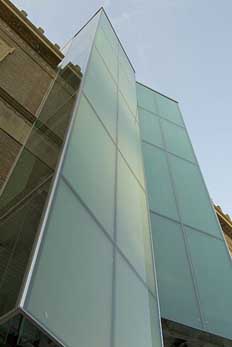
As I mentioned earlier, the Portland Art Museum has ended the Oregon Biennial and yes they are evolving it to cover more of the Pacific Northwest in keeping with its Arlene and Harold Schnitzer Center for Northwest Art. Last year, curator Jennifer Gately inaugurated the Apex program which has already produced nice if small shows by Roy McMakin and Chris Johanson. Though respectable, the final Oregon Biennial (also curated by Gately) seemed to be more of a recap or bookreport of a living scene that is simply too dynamic for any museum to handle en masse. Instead of leading, it was following with a fine "museum seal of approval" which is more of a kind of community tokenism that perpetuates a glass ceiling for artists here. As a reflection of higher standards in Portland it seemed like something had to change to really make the Museum relevant to the important discussions in contemporary art going on here. For those who saw the Oregon Biennial as their one hope, I hate to say it but it wasn't. Many who have been in them before saw the biennials as nice diversions but not central to their goals. Whereas something like a Turner Prize gives outsiders something they can really latch onto. Why not let some less authoritative organization take on the messy task of putting up a Portland Biennial? Basically, less focused regional shows like Greater New York or the Oregon Biennial just became tools for galleries as a way to spotlight and accentuate a mass of artists thrown at a wall and waiting to see who sticks (There are reasons MoMA doesn't host GNY and PS1 does). In New York that's fine but in the Pacific Northwest (where we have many artists who are superior to similar East Coast or even California fare) it has resulted in missed opportunities, a lack of clear routes to national exposure and seen as an overall lack of cultural conviction. The new format is way more focused and has evolved into something resembling the Turner Prize and SECA awards. Its called the Contemporary Northwest Art Awards or CNAA (phonetically it sounds like "nah" which I think is funny since this is a great deal more focused and hence exclusionary take on the show). Get used to it people. Note that the first word is "Contemporary" and the last is "Awards". To me that implies points will be given for contemporary relevance and excellence... it's infinitely more competitive, as it should be. It will effect how artists work in the studio as many will work on more ambitious projects that don't necessarily pay off in the galleries or many of the more rambling ad hoc group shows here. It encourages major statements. Here are the important details: ...(more) Posted by Jeff Jahn on April 16, 2007 at 14:01 | Comments (14) PermalinkSaturday 04.14.07 The end of the Oregon Biennial and the beginning of something else The Portland Art Museum is revamping its Biennial program and it looks like
it will expand beyond Oregon. As luck would have it I'm in Vancouver BC right
now and one thing is for certain, no Northwest Biennial could be taken seriously
without inviting them too (Portland and Vancouver have the two most distinctive
and bustling scenes but Seattle has something to offer too).
Ill have details on this development Monday but I've already brought up the need to make the Oregon Biennial more relevant and influential here... and since the Pacific Northwest is an international zone (Cascadia) with some impressive art, this just makes sense. Will it be some sort of fawning craft-driven art glass filled yard sale type show or something more focused, relevant and contemporary? Ill let you know on Monday when PAM gives details. Posted by Jeff Jahn on April 14, 2007 at 10:55 | Comments (0) PermalinkMonday 04.09.07 Sol LeWitt Remembered 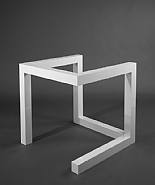 Incomplete Open Cube (1974) As many already know, Sol LeWitt (one of my very favorite artists) died yesterday. Michael Kimmelman's LeWitt obit in the NYT's says something about the man who would rather be about his work and Tyler Green has been keeping the flame as well. *Update Jerry Saltz does the best job though. Thankfully, there are many opportunities to see LeWitt's work in Portland too. There is a wide array of his print works on display at the Portland Art Museum for Jordan Schnitzer's Minimalism/Postminimalism prints show (it's gorgeous BTW). Also there is a really nice open cube (one of my favorite series of works ever, on display at the Jubitz Center. The Liz Leach Gallery already had a selection of his prints up before the sad news too. Instead of blathering on about how I love his baroque process driven reductive art (his conceptualism wasn't so full of conceptual baggage... so it was more a form of systemic premeditation, which is more akin to engineering). I'll give you a bit from local artist Jesse Hayward, whose life was changed while working on a LeWitt project: "Sol LeWitt brought to focus a process-driven abstraction with conceptual underpinning and installation sensibility. His work, minimalist and luxurious, collaborative and depersonalized, demonstrates the depths of abstract thinking as made real through the heights of public display. Helping execute LeWitt's WALL DRAWING #214 back in 1991 changed me as an artist. Many young artists worked on his projects. Many young artists were changed. This drawing was to be made of "unstraight" lines. As a highschooler, I felt I needed a little more direction and asked the artist to clarify what kind of "unstraight" line he had in mind. Was he thinking wildly frenetic or just plane wobbly? I chuckle thinking now of that situation. He gave me nothing. An "unstraight" line is an "unstraight" line. For me, it was a moment of tremendous possibility, the horizons of my life explained through the generous conceits of a master artist. LeWitt's lineage is strong and his influence deceptively pervasive. His ideas live on in Bernard Freize's predetermined process, Sue Williams' abstract logic and, to make the largest leap, the muralistic sensibility of Assume Astro Vivid Focus." -Jesse Hayward Posted by Jeff Jahn on April 09, 2007 at 19:55 | Comments (4) PermalinkWednesday 04.04.07 PAM logo banished to the aybss of bad design  The New PAM logo... experiences the power of dissatisfaction Savvy people are applauding Brian Ferriso's decision to can the gawd awful new logo for the museum. I was the first to write about the issue but it wasn't a big secret, several trustees of the museum were not happy with it either and we had some funny kvetching sessions about it. Thankfully, Ferriso has a very sophisticated sense of design (among other things) and it's a good thing too because Portland's design industry is huge and we've been waiting for some up to date design action at Portland's top tier institutions, including the museum. Posted by Jeff Jahn on April 04, 2007 at 11:38 | Comments (2) PermalinkTuesday 04.03.07 Catching up I'm remarkably recovered from last night's incredible event toasting Portland
artists (what great vibes and turnout, thank you!), here is some stuff to catch up on:
Reed has announced the 2007 Bonnie Bronson Fellowship winner: Laura Ross Paul, congratulations! The award's ceremony is April 25 at Reed College. Edward Winkleman has a post on the "Painting Deathwatch." Hilarious... personally, I like how Tal R. once described painting as a "zombie medium" that keeps marching on... of course it's dead. You can't kill it because it is already dead and the discussion is moot because the zombies are coming to get you! Oh you can try to fight them but that puts you into a B grade horror movie with a bunch of brain eating zombies. PORT will have an interview with one of the very best painters (a master zombie maker?) alive today, stay tuned. Richard Polsky has a nice bit on the art market's evolution and the changing nature of dealer/client relationships. Jerry Saltz is leaving The Village Voice, after two nominations for the Pulitzer with no bouquet of flowers... was he being taken for granted in the newsprint world? His new gig is at New York Magazine. Jerry is the most relevant art critic on the planet because he takes risks, is willing to get it wrong in order to get it right and he's relentless. Sure, he's said nice things about me but I suspect he was trying to get a lot of Portlanders goats as well...he was trying to out do Hickey and Schjeldhal and it's a mark of distinction that he really gets into the mechanics of the cities outside of New York when he visits them. His lecture in January 2004 for PICA (Stuart Horodner's last bit of programming) was the single best lecture weve had in the 8 years I've lived here. It emphasized one thing, to be a good critic you have to be decisive and driven in addition to being a comparative aesthetics ninja. Hats off Jerry, there are two types of critics, good ones that constantly engage/challenge the process and burnouts who use a lot of crutches. 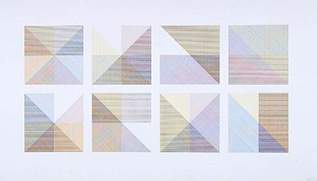 Sol LeWitt Eight Squares c. 1980. Sol LeWitt, Eight Squares, c. 1980, Color screenprint, trial proof 8/10. Collection of Jordan D. Schnitzer. © 2007 Sol LeWitt/Artists Rights Society (ARS), New York. On Friday the O had a lot of coverage on Jordan Schnitzer's minimalist and postminimalist print show at the Portland Art Museum (Of course minimalism is a misnomer and fosters a lot of lazy rhetoric but eh it serves a starting point for discussing; hedonism, Epicurean ideals, material, systemic production and rules before the home computer became a reality, context and asceticism). The cover article on the show was fine, it's unrealistic to expect the O to be the New York Times and it is an OK primer for newbies. PORT readers might be bored with it though (treating minimalism is if isnt the omnipresent source of a lot of yuppie aesthetic porn [come on, you know which design mags] and treats it like some sort of underdog still proving itself). It's true a book and tour would have been nice, but it is not like that couldn't still happen (the timeline for a book by the opening would have been too tight though... also I wonder why no mention of the 6 page color publication???). The better bit is DK Row's interview with Jordan Schnitzer, his blog version of the story has expanded content. Maybe some of my grousing might have had an effect??? though one article doesn't reverse a trend that has most of the Portland art world writing off our largest daily newspaper's coverage. At least it's a good step. Posted by Jeff Jahn on April 03, 2007 at 11:21 | Comments (1) PermalinkThursday 03.29.07 Two things that never change: money and more change Ditto on Tyler
Green's boredom with lazy art writing that is mostly focused on money. It's
the ideas and cultural shifts that legitimize art, museums, interesting cities and the writing
about them... not so much the transaction fees (those fade). Saatchi said it best, "The rich will always be with us."
Once that is accepted (the French and Bolshevik revolutions proved it) then
the real work of, "what ideas are being explored, what are the tough questions
of the age, etc." can be tackled. Sure, one has to be a little nuts to
go against the flow, but one also has to be more than bright and talented to
change the flow of that stream.
Also, I felt Holland Cotter's piece which spurred Tyler Green's words did bring up the most important point, where is the cultural leadership? Is that kind of leadership a thing any civilization can entrust to museums? Isn't that the domain of driven individuals who want to change the world? I loved Cotter's take on cynicism as "exhausting and pacifying." Portland from 2001-2003 went through a war between cynics and optimists. The optimists won (or at least the knee jerk cynics stopped freaking out long enough to become begrudging optimists who freak out less and ask better questions). Slowly but surely the city's other organs of culture have been catching up in with the continuing growth spurt. I'm pretty sure this ride wont be smooth so don't expect anything good to come from mildness or mere good intentions. To survive in the rapidly developing arts ecosystem here, cultural productions in Portland have to foreground an informed passion and a real esoteric depth (there are no accidents in these departments). Yes, I'm still working on my piece about Portland now (on Sunday it will be 8 years) and the main tasks at hand. Posted by Jeff Jahn on March 29, 2007 at 17:26 | Comments (2) PermalinkTuesday 03.27.07 Pandering to indie filmmakers 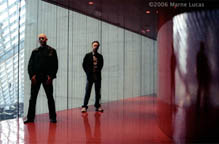
Jacob & Arnold Pander by Marne Lucas Yup, Portland is a hotbed for indie filmmaking, check out the latest with Joseph Gallivan's article on the Pander Brother's new movie in the Tribune. Note how the look of Portland is of such importance. The Pander brothers, Arnold and Jacob are artists as well and I had drinks Sunday night at Thatch a newish Tiki bar festooned with Arnold's awesome velvet paintings along with a bunch of former Trader Vic's statuary. Posted by Jeff Jahn on March 27, 2007 at 8:49 | Comments (0) PermalinkSunday 03.25.07 O! brother where Art thou? Surprise surprise, the Oregonian
doesn't get Chris Johanson. It's the kind of regionalist reactionary coverage
we have come to expect from the O (ok they do a good job with voyeuristic photography like Crewdson etc.).
For a more balanced take this is what PORT wrote last month. I think the installation part of the APEX show is one of the better ones Ive seen him do. Johanson at his best is a brilliant poet and not so much an outsider as an inside leader of an international trend in valuing indie cred sincerity (always a difficult thing to gage). It is related to the WTO riots. What is sad is that the O failed to explore why Portland is appealing to Johanson and thousands of other artists... the city is one giant conscientious objection to the second half of the 20th century. 100 years from now Johanson (along with Basquiat) will be seen as a voice to contend with in a sea of meganational and yuppie aesthetic slickness. (I'm coming up on my 8th anniversary in Portland and I'll be publishing a big picture piece this week discussing that very thing). The Mercury's review of the Johanson show also makes some nice points but I felt the childlike angle infantilized the work in a way that leads to readings like that in the O. Johanson's less a child and more like someone who shuns refinement for refinement's sake. Posted by Jeff Jahn on March 25, 2007 at 13:58 | Comments (0) PermalinkWednesday 03.21.07 So much for a crisis in art criticism 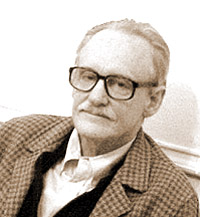 Still relevant: Mr. Peter Schjeldahl The best bit of art writing published this March was Peter Schjeldahl's awe inspiring take on Robert Ryman and Franz West etc. He's great, even brilliant with Ryman but gets Murakami wrong of course. Murakami is uber-whoring the drama in a very professional/insidious way that makes the drama very nihilistic. He's basically outflanking the idea starved art world along with Schjeldahl in the process. Why? because he has gotten a lot of credit for the last great idea (the complete flattening of consumption and culture, best showcased at art fairs). Also, I'm enjoying their new website design too, much better and more linkable. *Update: Holland Carter of the New York Times points out the Locally Organized Gravity show along with Portland's own Red 76...(more) Posted by Jeff Jahn on March 21, 2007 at 11:05 | Comments (0) PermalinkFriday 03.16.07 Thinking Big and Building Better Bridges I'm curious about how people in the art community will react to the front page
story in the Oregonian about
some creatives being edged out? Clearly gentrification is a double edged
sword, combining higher rents with an opportunity for better arts patronage. The devil is in the details on this issue.
I'd call it a cultural distillation process and the city's character is at stake, the weird part of Portland needs to get distilled and weirder as well. The real corner to turn here is patronage and that means the word sophistication needs to come into play amongst developers, politicians, RACC, collectors and the press (especially the O). Art for populism's sake (which panders to an assumed audience rather than challenging it) isn't enough, it takes challenging art programming, which is frankly a lot weirder than work that merely gestures at populism while hoping it will somehow to help creatives. Sophisticated artists aren't just a little different, they are extremely idiosyncratic. Portland is blessed with a lot of very serious artists and the city government has made a lot of noise about this. Still, little has been done. In fact the Everett Station Lofts (circa 1989) are still the best hotbed for emerging visual arts culture in town. Here's a prediction, whoever wins the next mayoral election will do so because they actually have a truly sophisticated arts plan that goes beyond minor gestures. 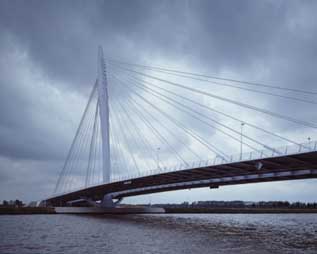 Prince Claus bridge by UN Studio Also, the I-5 bridge is too important to nickle and dime or second guess like this story in the Tribune. We need a design competition (Calatrava, Foster, UN Studio etc.) federal funds and an attitude that this will shape the region for the next 70 years. Why not plan on spening 8 billion plus and do it right. This requires big thinking not hunting for a bargain, it will cost us sorely in the long run if we don't. Posted by Jeff Jahn on March 16, 2007 at 16:11 | Comments (2) PermalinkThursday 03.15.07 Portland art scene gets around in 2007 I've updated the list of Portland
art scenesters showing outside of the region with info on Sincerely John Head, Vanessa Renwick,
Patrick Rock and Brenden Clenaghen.
Posted by Jeff Jahn on March 15, 2007 at 10:51 | Comments (0) PermalinkMonday 03.12.07 Why not? Steve McQueen does the ultimate
political mailart piece, read about it in the Guardian.
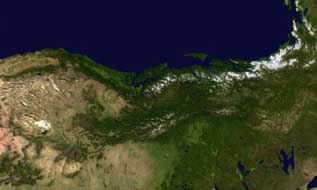
the Pacific Northwest from a different angle Also, there is a discussion about the Tacoma Art Museum's art critic panel on regionalism last Saturday on Art Dish. My opinion on such discussions is short and sweet, those who wallow in the regionalism thing beget more wallowing regionalism, it's a defensive self-perpetuating cycle that becomes brittle and trite. I've said it a lot, "on the Internet everything is local." The art wold has never been so regionally level and one's focus determines their trajectory (not to say you wont have to work hard if you are in Portland or Seattle). Also, the Northwest and Portland in particular are indicative of a different kind of America and people are flocking here to find it, it isn't regionalism it's a kind of lightning rod and a conscious decision to find a new way. Really, it's a leadership thing now and the TAM biennial missed the mark there, once again giving Seattle reason to mock Tacoma. I hate being right about these things. Was the show just a ploy to get Seattle to pay attention? Also, though the Portland selections are fair it definitely doesn't give one any idea of the scope of things that are going on down here, if anything it sidesteps the most active art scene in the two states. I think the show could be important but the cramped potpourri curatorial model didn't make that case. To be fair, TAM has been doing the best job of collecting PNW artists of any museum in the area. They have even been giving them coherent solo shows, which is partly why this show has sparked so much dissapointment...(more) Posted by Jeff Jahn on March 12, 2007 at 18:25 | Comments (2) PermalinkFriday 03.09.07 Sneak peek at the new Museum of Contemporary Craft 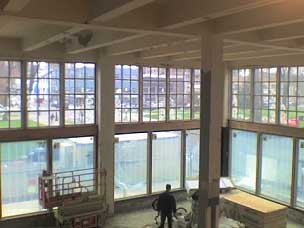 Main gallery, Museum of Contemporary Craft Yesterday, director David Cohen gave the press and other culturalists a tour of the Museum of Contemporary Craft's still unfinished 15,000 sg ft. facilities on Portland's North Park Blocks. The main gallery will have soaring 22 foot ceilings and an impressive overlook. The other galleries are more intimate but no less refined. I'm thrilled that they are keeping the old glass as its irregularities produce cool visual distortions of the outside world activating the viewers perceptual acuity, which can then be trained on the exhibitions. The museum will also have a climate controlled archive and preparation space. The renamed DeSoto building is a commercial condo so the museum and other tenants will own their spaces. Other features include a community room for meetings and a 3,000 sq foot outside "events" deck for all of the tenants. With other tenants like Bluesky, Augen & Foelick galleries as well as a new photography gallery by Charles Hartman it should further solidify Portland's core of easy to walk art spaces on the west side. Another plus, most of these gallery spaces have soaring ceilings with lots of light, something sorely missed since the demise of the original Savage Gallery whose space was better than most in Chelsea. The new Museum space will open July 22nd and their last shows in their old space run through March 11th, so last chance. Posted by Jeff Jahn on March 09, 2007 at 14:36 | Comments (1) PermalinkThursday 03.08.07 Ethical Bruhaha in Seattle 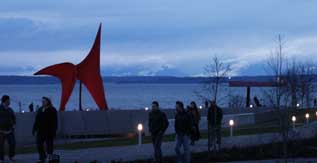 Seattle's new Olympic Sculpture Park at dusk It's been an interesting week up in Seattle with critic Matthew Kangas coming under a full scale ethics probe on the Stranger's Blog (the SLOG) for requesting artwork from artists he reviewed. I find this practice very distasteful. I even dislike the constant use of art auctions and other situations where artists give up work for fundraisers. It's predatory and Im not just speaking for myself here, a lot of dealers and artists in Portland have absolutely had it. Good cause or not it's promoting a culture of pressuring and leaching off of artists (in a developing art economy like Portland it undermines markets unfairly). Now, The Stranger's Jen Graves has the full story on Kangas and names names ... It's the paper's lead story this week and it's a fascinating read, some thought it was wrong to blog first but I think it flushed the story out...(more) Posted by Jeff Jahn on March 08, 2007 at 12:34 | Comments (0) PermalinkWednesday 03.07.07 School of hard Knox Portlander's pay close attention to Tyler's
take on the the Albright-Knox Gallery in Buffalo. It is the exact opposite
situation of the Portland Art Museum, which needs to reach out to the ever increasing
young/savvy art conscious workforce that Portland continues to attract (we are
gaining rather than than losing to larger cities like New York and LA). My sense
from our jam packed lunch a while back is that PAM's
new director Brian Ferriso is well aware of this situation and plans to act
in the near future...it has been years since a major contemporary show at the
museum (Though Roxy Paine, Hirst
and Kehinde Wiley are more than just hors d'oeuvres, call em brunch?).
Also, stay tuned for my review of one of those transplanted upstate New Yorkers today. Posted by Jeff Jahn on March 07, 2007 at 10:49 | Comments (0) PermalinkTuesday 03.06.07 Rick Steves, Chief Art Critic of the New York Times? 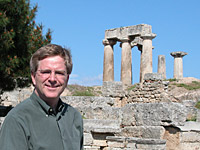
Tyler Green once again has the scoop... Kimmelman is leaving New York but not the New York Times. Kimmelman just spoke to a packed house in Portland both delighting the crowd with his charm and somewhat annoying myself and others with his light travelogue style (look to the comments). Looks like there will be more travelogues, not a bad thing but does the chief art critic of the NYT's have to be the art world's Rick Steves? Yes, in my mind Roberta Smith is already the chief art critic and Ive been annoyed with newspaper art criticism that isn't art criticism for some time. I read Kimmelman to revisit an excellent writer's craft but in terms of content I end up feeling like I just read the brochure not the review. I do think Kimmelman could do excellent television shows on art travel, just don't call it criticism. Posted by Jeff Jahn on March 06, 2007 at 11:33 | Comments (2) PermalinkMonday 03.05.07 Round the web It has been a while since PORT's done a round the web.
Both The New Yorker and NYT's have covered the Jeff Wall show. The Portland Tribune reported last week on a smaller supplementary I-5 replacement bridge. I dislike this idea intensely as a cost saving measure. Ive heard figures like, "20% of US trade passes over the I-5 bridge each year," so skimping doesnt make any sense. Look, for such a project the fed's should be on board, especially since with light rail it would have such an effect on interstate traffic/commerce. Underbuilding is flat out stupid. I live on N. Interstate and I see the traffic snarls daily and it hasn't even gotten as bad as it will get. It's also the most major public works project to hit the Northwest in decades. Time for a design competition; Foster, Calatrava, UN Studios etc...(more) Posted by Jeff Jahn on March 05, 2007 at 19:01 | Comments (0) PermalinkThursday 03.01.07 Marching Curatorial Madness Oh a curatorial
final four, although a lot of interesting curators are missing; Robert Storr,
Phillipe Vergne (who missed the boat by not visiting Portland for the last Whitney
Biennial show) and Michael Darling?... why not add in Tobias Meyer for sheer
lunacy?
I pick: Lynne Cooke, Paul Schimmel, Thelma Golden (Whitney Biennial coming up, maybe it will be a relevant one) and Hans Ulrich Obrist (who openly acknowledges that artist curated clusters easily out pace curatorially defined constructs... which is what you find in Portland but you just cant ask one curator who to see) Tyler Green has picks too (dude no way can Higgs take Bonami ... sorry Matthew you are too much of a "dry" specialist to win this corrupt bourgeois competition) Posted by Jeff Jahn on March 01, 2007 at 10:01 | Comments (0) PermalinkSunday 02.25.07 New York new work? Maybe you weren't in New York this weekend for the Armory show, maybe you were?
PORT's Amy Bernstein was there on assignment and we will have something from
her "too much art" weekend shortly.
Till then check out Artists Unite's coverage of Scope and Edward Winkleman's Pulse coverage. Posted by Jeff Jahn on February 25, 2007 at 17:08 | Comments (0) PermalinkSaturday 02.24.07 Congratualtions PICA!
You may already know about this, since it’s been announced elsewhere,
however, in case you haven’t heard, PICA has received 3 major grants totaling
$225,000 from The Andy
Warhol Foundation for the Visual Arts of New York, The
Paul G. Allen Family Foundation of Seattle, and The
Collins Foundation of Portland, all of which points to the local, regional
and national need that PICA satisfies....(more)
Posted by Melia Donovan on February 24, 2007 at 8:49 | Comments (0) PermalinkThursday 02.22.07 Globetrotting Portland Artists in 2007 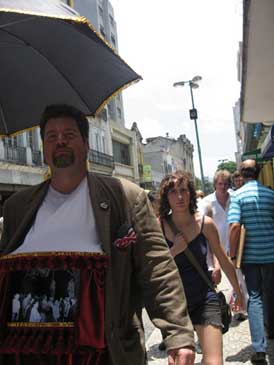 David Eckard on the streets of Rio Despite the increasing real estate development and institutional maturation (for example Small A Projects was just accepted into NADA) Portland is still unique for being mostly defined by its people and I'm happy to report they have a rapidly increasing international reach. The artists are still the most influential and controversial force at work here and it will probably be that way for the next decade as...(much more) Posted by Jeff Jahn on February 22, 2007 at 16:18 | Comments (1) PermalinkA little butterfly told me, Damien Hirst has a new show There is a convenient scandal brewing, did
Damien Hirst rip off artist Lori Precious?... uh no but check it out here. Let's
just say, ideas, butterflies and even PR stunts get recycled all the time. Kinda
neat how Hirst isn't having this show in New York this Armory weekend huh? I'm a huge fan and though
I doubt this was orchestrated directly it's a testament to the guy that people think he's capable
of it (well he is, but why try when this kind of stuff can be almost counted on). The title of the show is "Superstition."
It is a show title I wanted to use someday... arrgh, but it's totally appropriate. Also, PORT's own rather involved Damien
Hirst review will be up tomorrow.
Posted by Jeff Jahn on February 22, 2007 at 14:54 | Comments (4) PermalinkWednesday 02.21.07 TAMpering with the Northwest Biennial? 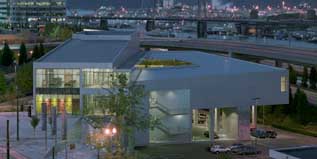 Jen Graves at the Stranger has reviewed the Northwest Biennial at the Tacoma Art Museum. I saw the show this past weekend and I pretty much agree with her assessment, except the Schweder had kinda disintegrated by the time I saw it. Ive seen most of it before in...(more) Posted by Jeff Jahn on February 21, 2007 at 16:39 | Comments (0) PermalinkIs Liverpool the next Portland? I'll be posting that list of Portland artists with shows outside of town in 2007
that Ive promised (maybe later today). Till then:
The Guardian is claiming that Liverpool is like San Francisco with greyer weather? Ha, that doesn't sound anything like Portland at all does it? Actually we don't want that kind of title here and the fact is Portland is kinda the anti San Francisco. Which is why in 2005 the Norton collection's curator remarked to me, "All of San Francisco's best artists are moving to Portland." It isn't just Harrell Fletcher and Chris Johanson... there are a pile of others like Patrick Rock, Jesse Hayward, Brittany Powell, Emily Counts, Todd Johnson and even Brenden Clenaghen ...etc. (it's a huge list) who all have done stints in SF only to settle here. Sure, Portland has similarities to an older San Fransisco but it's different, we arent a financial center and we are more of an alternative to the mistakes of the second half of the 20th century. Ideologically the PDX thing is something completely different. Add in over 10,000 artists to the mix of a city this size and see what happens. The city is a rebel base and I think it's increasingly dfficult to talk accurately about Portland art without looking outside of Portland. To that end, PORT's Amy Berstein will be covering The Armory etc. this week in New York. *Update: Matt McCormick just jogged my memory, he was in the Liverpool Biennial... see why the Portlanders outside of Portland post has taken so long to come out! (PDX-ers feel free to email me with updates before I publish the list tonight) Posted by Jeff Jahn on February 21, 2007 at 11:15 | Comments (4) PermalinkMonday 02.19.07 What would LBJ do? Nicolai Ouroussoff of the NTY's has denounced
the so-called Freedom Tower in his strongest words yet. I absolutely agree
and have stated many
times before how it is a massive failure of imagination. The only thing that
can do real justice to the site, city and nation is a much better design. A clumsy
restatement of the empire state building with a blast shield doesn't cut it. I
know it's probably too much to ask of the current President but if the state and
local governments can't get a developer of a national historical site to do it
right it's time for the national government to step in. (then again could they
do better? ....uggh it's times like these that I actually yearn for LBJ...
yes that is what it has come to)
On a more local public art front Portland Public Art, The Portland Tribune and the Mercury have been on top of the evolving failure of the dragon sculptures in Portland's Chinatown from early on... (more) Posted by Jeff Jahn on February 19, 2007 at 10:18 | Comments (2) PermalinkThursday 02.15.07 Aloha: the surf is up at PORT By now PORT readers, you have read Jenn's announcement that she is leaving the
publication to focus on her excellent gallery, Motel.
This is no surprise between the two of us and we have been implementing a slow
phase out of her essential role for over a year. No drama here, just change…
PORT isn't where either of us spends the majority of our time. Others who can
devote more time to this small scale but successful and innovative publication
will be stepping in to help take it to the next level. I will continue in my role. It's just a natural growth situation that we saw
coming a long time ago.
PORT itself is more successful than ever with over 25,000 unique individual readers per month and is the top ranked site when you Google "Portland" & "Art." Recently, the Walker Art Center's blog singled us out as one of the 10 best art blogs on the planet… wow. Many of you come back daily and we are grateful for your eyes. With those numbers and reputation weve looked at how to grow the operation from its current small (but influential) scale to a slightly larger one. To those ends we are going to be hiring at least 1 new critic + adding some new sponsors, both big and small. In other words, weve both been doing PORT on the side and its business now demands some attention and fresh management divisions. What wont change is our focus on presenting critical content and information about art both locally and internationally. Thank you Jenn, you've been a dream to work with and that has been a large part of the site's success, take a bow. Posted by Jeff Jahn on February 15, 2007 at 18:45 | Comments (0) PermalinkAu Revoir, Mes Amis Dear PORT readers,
You may have noticed my online absence over the past few months. In the past year, my presence with PORT has become primarily behind-the-scenes; site moderation, accounting, and design. When Jeff and I initially conceived of PORT, we envisioned it as a fairly casual endeavor to promote visual arts in Portland to both a local and national community. However, it became clear that the project was going to be much more demanding and grandiose than either of us ever imagined. We quickly grew a staff of critics and writers and made swift strides to offer daily content on the site. What was initially conceived as a "from the hip" kind of endeavor soon begged for a higher level of seriousness and professionalism. Clearly, the community was hungry for a dedicated arts publication and we stepped up to the challenge. However, due to my vocation as a gallery owner, it quickly became clear that it would not be prudent for me to publicly air my opinions on art and art politics. So, I became the announcements editor. As the demands of Motel increased, I then abandoned all posting responsibilities to take care of PORT's administrative matters. Although I have not been a visible force on PORT as of late, I have been plugging away behind the scenes. In March, Motel will turn four years old. After housing over 40 exhibitions featuring over 150 artists and participating in a number of national gallery fairs, Motel has become a successful and reputable gallery. However, with this growth and development, the demands of the gallery have grown too. Out of a commitment to my artists and my vision and to the sustainability of the gallery, I have decided to end my tenure at PORT. I am excited to have more time to commit to the gallery and hope that PORT will continue to remain a vibrant and essential voice for Portland's arts community. I am proud of what Jeff and I conceived of and executed and believe PORT to be an important player in the promotion of Portland to a international audience. I am grateful for the opportunity to work with a great crew of writers, all of whom have impressive talents and ambitions in their own right. Although I will be absent from the PORT roster, you can expect to see more of me around town and as always, I can still be found behind the front desk at Motel. Thank you for supporting me, Jeff and the rest of the staff in our contributions to putting Portland on the map. All best, Jenn Posted by Jennifer Armbrust on February 15, 2007 at 18:44 | Comments (0) PermalinkJohn Buchanan and the curse of King Tut Tyler
Green has the scoop on former PAM director John Buchanan. It's the curse
of King Tut!
I recently spoke at length with his replacement Brian Ferriso and the one huge difference is that Ferriso is clearly all about the importance of important art (just like the curatorial staff). That is what Portland really needs/wants anyways. Currently Ferriso is in his listening/learning period at the museum so it makes sense to let him go about that important process without asking questions he can't answer yet. I can say he's already on top of the "obvious to anyone" concerns I laid out in October, but it's too soon to expect action. Ok one tidbit, I do like the fact that he's an architectural design buff, something Buchanan certainly wasn't. Posted by Jeff Jahn on February 15, 2007 at 18:01 | Comments (0) PermalinkTuesday 02.13.07 American Architectural Valentine Buildings need love too and since Tyler Green's doing a
collective intelligence experiment on the 5 best bits of American architecture, why not?
Here's my list and as usual it is tinged with personal affinities, besides 5 is too few for a historical sample:
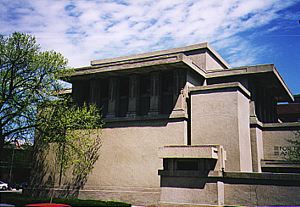
1) Frank Lloyd Wright's Unity Temple (1907), Oak Park Illinois. The approach to the temple is exactly that, its sets the pace, mood and expectations on a level with Mayan or Egyptian structures, then raises the bar (yeah scary). It was one of Wright's favorite buildings and highly innovative for its use of concrete at the time. The central hall is just dumbfoundingly good, debatably the best room ever designed by any architect. Pictures consistently fail it. Wright called it a, "jewell box." It is both massively uplifting and contemplative as an incredibly democratic yet enlightened community space. I wonder if Donald Judd ever experienced this space? There aren't many rooms similar to this, only Brad Cloepfil's Weiden and Kennedy building strikes any comparison, which is very good but Wright's is a class or two above that effort. Also, Unity Temple requires restoration, so please click here to help, it's a national treasure... 2,3 & photo credit: Jeff Jahn 4) Rem Koolhaas: Seattle Central Library, (2004) One of the best things he's ever done... 5.... (more) Posted by Jeff Jahn on February 13, 2007 at 19:56 | Comments (3) PermalinkMonday 02.12.07 See this Every once and a while we have to post a link to Daniel Peterson's awesome photoblog because we keep forgetting to add it to the blogroll. Here is the most memorable photo of the year so far. Im so glad that snow is gone. I seldom single out one artist like this but Daniel Peterson is the single best photo chronicler of what its like to be young artist (or young at heart) in Portland these days.
Posted by Jeff Jahn on February 12, 2007 at 20:28 | Comments (2) PermalinkSaturday 02.10.07 More PAM Aquisitions 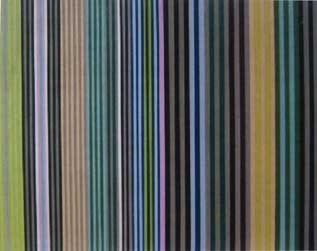 Gene Davis, Angel Fish (1970) The Portland Art Museum has announced yet another acquisition... actually it's a total of 350 acquisitions. The estate of Elvin Duerst has bequested 350 art objects, from an important early Gene Davis, "Angel Fish"... to Spanish colonial, Asian and contemporary Latin American works. Duerst, a McMinnville Oregon native lived in Washington D.C. for the last 65 years having worked for the United Nations, and the State Department. Duerst was intimately connected to the Washington Colorfield school and dovetails nicely with the museum's acquisition of the Greenberg Collection in 2001 (which had many important holes like Morris Louis, Barnett Newman and Gene Davis). Many have remarked that the Greenberg Collection should have ended up in the DC area and now they've got to be wondering how Portland has become such a magnet for 60's and 70's formalism. Let's just say we like abstraction, many of the best selling artists in town deal with formal abstraction and then there is the fact that Mark Rothko grew up here. Posted by Jeff Jahn on February 10, 2007 at 14:12 | Comments (2) PermalinkThursday 02.08.07 Below the radar no more Here are two architecturally involved exhibitions that have flown below the
radar:
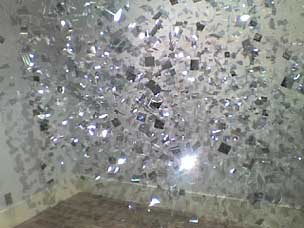
Carolina Aragon's "A Portland Cloud" at the Portland Building's gallery space may not be very original because it reminds me a lot of Cornelia Parker. Then again, I love Cornelia Parker and this atmospheric piece certainly holds my attention. Aragon is a Harvard educated landscape architect for Walker Macy. Show ends tomorrow February 9th, see it if you can during the building's very limited hours till 6:00 PM 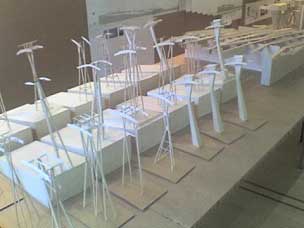
The Portland chapter of The American Institute of Architects has a show on the construction of the Aerial Tram ...(more) Posted by Jeff Jahn on February 08, 2007 at 20:04 | Comments (0) PermalinkWednesday 02.07.07 Bohemian Rhapsody, like you? Here is an wonderful article about Man
Ray's debauched bohemian muse from The Guardian.
Up in Seattle Jen Graves puts in a fine article on another bohemian moment, Cologne from the 80's till about 1995. Yes, bohemian lifestyles and art are a hot subject right now and in case you missed it, PORT's own Jessica Bromer took on the Met's Glitter and Doom show last month. There is no shortage of bohemian activity in Portland these days... I wouldn't know where to start. However, I do think Joe Thurston has stopped drinking absinthe though. Posted by Jeff Jahn on February 07, 2007 at 21:09 | Comments (9) PermalinkTuesday 02.06.07 Not everyone is a critic Interested in reaching an international audience with excellent art writing? Brave enough to broadcast your informed subjective opinion? PORT is trying its best to keep up with the changes in the Portland art scene so we are looking for one more paid art critic for its staff (possible but not mandatory First Thursday and Friday listings position as well). We place a premium on critical knowledge and insightful opinions as well as an eye for relevant details and context. Email your vitae or resume and letter of intent here.
We tend to hire those who can think for themselves with academic credentials but an informed poet ala Schjeldahl is also a possibility.
Deadline Feb 15th 2007 Posted by Jeff Jahn on February 06, 2007 at 20:10 | Comments (0) PermalinkThursday 02.01.07 A 21 @ sign salute for Visual Codec, RIP @@@@@@@@@@@@@@@@@@@@@
Sad news, Visual Codec was an online journal devoted to connecting the three Cascadian art scenes of Vancouver, Seattle and Portland. It has announced a permanent vacation. Here is M the editor's statement. Tellingly it wasn't lack of interest, its the massive amount of work that success can bring. The only way weve managed it here at PORT is an empowered, passionate, intelligent and highly capable staff. The VC news reminds me of the early days of the Organ back in 2003, I warned Camela not to grow it too much (content wise) because it will consume a superhuman level of attention. Alas, it has happened again. Posted by Jeff Jahn on February 01, 2007 at 17:26 | Comments (7) PermalinkTuesday 01.30.07 Rose vs Cloepfil, Plagens vs. Green: who owns whose e-ass? Ahhh there is nothing better than one
architect (Charles Rose) talking smack about another one (Brad Cloepfil), while
name dropping Kanye West ...and when the commenters on Portland Architecture start
bringing electricity, sidewalks, straight A students in NYC and whether Portlanders are qualified to identify
a cow or not it's like the smell of napalm in the morning!
Oh and the oft reactionary Peter Plagens attempts to besmirch Tyler Green and other art bloggers with some lazy blanket rhetoric and gets utterly "pwned" (look it up Peter, it is already passe). At PORT we make pretensions of serious art criticism and back it up, along with first on PORT news and important clarifications when rank disinformation is being published as fact. *Update: Peter Plagens responds to Tyler Green's response... sounds like writers like to focus on other writers like artists focus on other artists, they look closely at the parts they like and leave the rest. Not surprising really but in grad school my profs spent a lot of time and energy to break us of those habits. If anything it just seems like non blogger art writers envy the freedom of blogging. I can say there is a tremendous exercise in self restraint that one has to engage in if you are going to blog much. Ive seen some rather talented traditional writers use a blog in very ill advised ways (from a legal standpoint even). *Update Update (thanks to Jessica's web surfing): Discussion producing blogger Edward Winkleman takes on the subject of what a blog is and 50+ comments ensue. PORT isn't a typical blog, we are intentionally stretching the format. Why?... partially because Portland needs more thoughtful critcal art writing and the scene's rapid changes in sophistication require much more dynamic, internationally-relevant publishing. Posted by Jeff Jahn on January 30, 2007 at 8:54 | Comments (2) PermalinkFriday 01.26.07 The O counts to 10 It's great the Oregonian did its 10 most influential movers and shapers articles
here
and here,
I wouldn't dispute any of the choices but at 10 it is too few and one-dimensional for a town in the grips of such activity and change. Still, these are the sorts of
discussions the Oregonian should be inciting, though doing it by an
poll insured a strong bias weighted towards those whose influence is less controversial or so longstanding it cannot be questioned like Liz Leach or Arlene Schnitzer. Of the 10 only Leach is controversial and even then she's now mostly just controversial for having been successful (thank you Liz). All selection methods have flaws and
Portland's scene has about 30 people who really are influential in important ways, maybe the WWeek or Portland Monthly can outdo this, but for most Port readers the list is not news and kinda like one of Rolling Stone's frequent lists of the greatest songs of all time.
The non-controversial bias is why no artists were named. All artists of any relevance are controversial to the point of being "political factions" in some way, even if they are only controversial because of their relevance. The omission of all artists is a major problem, as the hyperactivity and increasing international reach of Portland artists has been the engine driving the changes in town (as first pointed out by Randy Gragg in the Oregonian years ago)...(much more) Posted by Jeff Jahn on January 26, 2007 at 17:09 | Comments (7) PermalinkTuesday 01.23.07 East Side live/work space & funding cuts? The Tribune had a short but interesting article today about possible live work spaces for artists on the East Side. It's true the East Side hasn't seen many city initiated steps for arts spaces and as usual commissioner Sam Adams appears to be in the thick of it all. The arts are becoming more and more of a political issue here but we hadn't seen much movement yet. Here's a no brainer, create a suitcase travel fund for Portland artists. They are ambassadors and it's odd that I can bring artists here using the funds of other cities but can't send Portland artists elsewhere with similar programs. Have a small oversight committee of 3 well versed and active curators to determine who gets the nod.
*Update: Also, the WWeek had this piece on funding cuts which effect the IFCC and the Multnomah Arts Center. Every major neighborhood in the city should have an neighborhood arts space. Posted by Jeff Jahn on January 23, 2007 at 20:11 | Comments (4) PermalinkImpending Doom? Ahhh it's a gloomy time of year (except it's sunny in Portland right now). We
will have our own Glitter and Doom review up soon but till then Jerry
Saltz has his take on two shows of doom in NYC.
Speaking of too much money as a way to doom the direction of nonprofits, last week Edward Winkleman had this awesome post on Triple Candie's controversial show. Money doesnt solve all problems, it creates new ones by quantifying everything which is ok but at a certain point it hijacks the art ecosystem. The interesting thing about Portland right now is how managable and open it is, while having some serious money beginning to go around. There is still room for art that is difficult to quantify as a commercial exchange... at least here it is difficult to quantify, giving it a different feeling which in itself is becoming attractive to places that can quantify it. Posted by Jeff Jahn on January 23, 2007 at 10:32 | Comments (0) PermalinkMonday 01.22.07 Art Talk Radio on KPSU Tonight on Eva Lake's Art Star program on KPSU radio (5-6:00 PM) some of PORT's critics including Katherine Bovee and myself will be on the air and talking about art criticism. An interesting
exercise to be sure since it is like talking about tap-dancing about architecture.
You can stream it here and
I'll provide a link when the archive is up. For the local and oldschool it's 1450
AM in the Portland, OR/Vancouver, WA metro area, tune into 98.3 FM on the PSU
campus.
Posted by Jeff Jahn on January 22, 2007 at 11:08 | Comments (1) PermalinkFriday 01.19.07 Rauschenberg acquisition for PAM 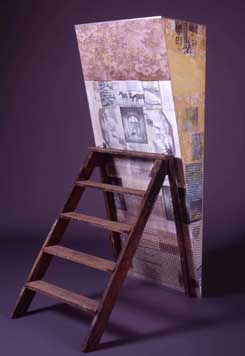 The Portland Art Museum has announced the purchase of a major assemblage sculpture by Robert Rauschenberg, "Patrician Barnacle (Scale)." The deal was originally conceived to bring 1 million dollars to the Blue Sky photography gallery, which boasts board member Christopher Rauschenberg (the artist's son). It's a very nice work, a steal at that price and a cultural momentum building exercise for both sides. The deal is noteworthy as this fundraiser for Blue Sky could have raised more on the open market or at auction, but Portlanders understand money isn't the only thing... just a tricky thing! Major kudo's to the thoughtful donor Carol S. Hampton and chief curator Bruce Guenther, he's sweated this one out for over a year. It is to be installed in the Jubitz Center for Modern and Contemporary Art...(more) Posted by Jeff Jahn on January 19, 2007 at 10:19 | Comments (3) PermalinkOSP in Seattle: prompts looking at public art in Portand? 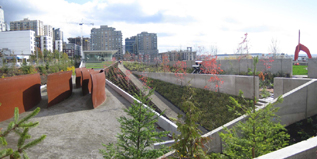
The Olympic Sculpture Park opens this Saturday in Seattle and at a time when many Portland citizens question whether our public art is both too insensitive and not sophisticated enough. Many Seattlites complain it's just trophy-ism, showcasing Microsoft money that doesn't really invest in the people of Seattle... a kind of high end art ghetto? One thing is for sure with public art, it's practically impossible to please everyone. *Update Jen Graves at the Stranger, Regina Hackett at the PI and Shiela Farr at the Seattle Times review it. Also, It's your typical Seattle public project (expensive as hell and slick), just with art.... but it is exciting on paper because I like Serra, Roxy Paine and Calder but how does it all gel? I'm curious how all the very disparate art works together? Is it just another blue chip art park? To date my favorite bit of Seattle public art is Barnett Newman's Broken Obelisk in Red Square. Weve been a little distracted because Portland's aerial tram opens on the 27th, it is public art, weirder, only slightly less expensive and a lot more useful. Still one has to say Seattle takes public art more seriously than Portland does. There are lessons to be learned by both cities from one another. Posted by Jeff Jahn on January 19, 2007 at 9:50 | Comments (0) PermalinkWednesday 01.17.07 Julie Orser returns to PNCA 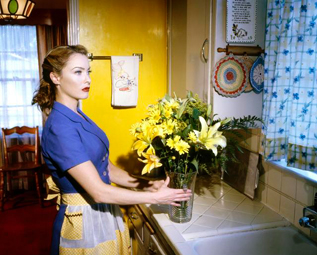 The snow has been keeping most everyone from traveling much beyond their neighborhood but if you are near the downtown check out Julie Orser's latest multi-channel video installation "Anna Moore" at PNCA's Feldman Gallery in the Pearl. A 99 PNCA alum with an MFA from the California Institute of the Arts in 2005, Julie's one of the hotter new video artists in LA. I've been looking forward to this show for months and it's a shame there was no opening on the 16th. She will be back in PDX for a free talk on January 31st. See it @ 1241 NW Johnson. Posted by Jeff Jahn on January 17, 2007 at 9:56 | Comments (1) PermalinkMonday 01.15.07 Fear and Loathing in Philadelphia After heading to sleepier parts of Pennsylvania for the winter holidays, I had the chance to visit two of America's premier East coast cities--New York and Philadelphia. My New York coverage will be posted in the near future.
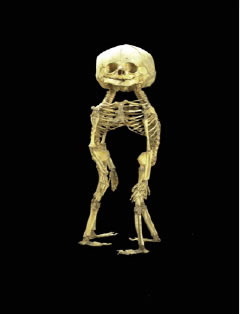 Co-joined twins from the Mütter Museum, Philadelphia Former resident David Lynch has described the City of Brotherly Love as "a very sick, twisted, violent, fear-ridden, decadent, decaying place," "filled with violence, hate and filth" and, "the sickest, most corrupt, decaying, fear-ridden city imaginable." Lynchian hyperbole aside, I have to agree that Philadelphia is a mad, gritty city. Nonetheless, it's filled with of cultural treasures. While pretty much everything was closed during my New Year's visit, I've cobbled together a mini-tour of my former home's artistic offerings based on memory, research and rumor....................(more) Posted by Jessica Bromer on January 15, 2007 at 12:23 | Comments (0) PermalinkTuesday 01.09.07 In Agreement About Some Things Artnet
has a nice weekend update from New York. I also agree, Brice Marden's work
seems to have been made to fill museums rather than inhabit them like Ellsworth
Kelly's paintings do. Marden makes the kind of stuff you fall in like with.
Portland Architecture chimes in on Randy Gragg's interesting POVIC article last Friday. I agree a museum is the right thing to do but what kind of museum? Regina Hackett wrote about the crisis of confidence in newspaper art writing. Don't get me started but I see a huge difference between most journalists and effective cultural discussion. In Portland a lot of people don't bother to read visual arts coverage in some printed publications anymore and Portlanders L O V E to read! Note to Portland editors, PORT's readership is going through the roof and Regina Hackett herself is consistently read by most serious Seattlites (and more than a few Portlanders). I love how she is publishing letters on her blog too. Posted by Jeff Jahn on January 09, 2007 at 11:34 | Comments (0) PermalinkTuesday 01.02.07 From The Walker With Love 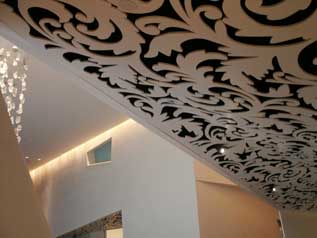 Walker Art Center, photo Jeff Jahn PORT was just listed as one of the top 10 art blogs on the Walker Art Center's off center blog and declared, "The undisputed champ of the regional art blogs." That is some serious competition. Thanks Tyler, it is time for all of PORT's staffers, sponsors, and readers to take a bow! We realized we were trying to do something new and evolve the personal art blog but the sheer quality and amount of activity in Portland warranted the effort. At the same time there is a lot of work to do in terms of presenting the rest of the world to Portland. It is a two-way street and Ive said it before, "everything is local on the internet." Posted by Jeff Jahn on January 02, 2007 at 14:15 | Comments (1) PermalinkSunday 12.31.06 PORT Staffer's Picks For 2006 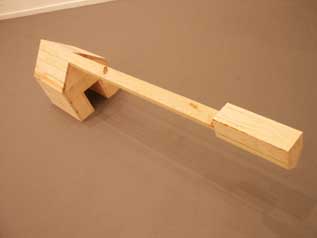 Melia Donovan picks Paul Sutinen at 9 Gallery 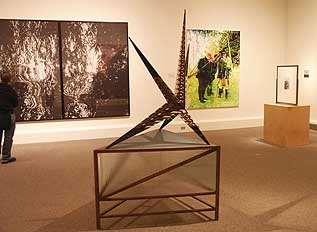 Jeff Jahn picks New Trajectories I at Reed College: L to R works by: Stephan Thiel, David Thorpe, Eric Schmidt, Richard Prince and Tim Eitel The Best Group show? Most improved artist? Artist of the year? Curator of the year? The lists go on and on... (much more) Posted by Jeff Jahn on December 31, 2006 at 13:48 | Comments (3) PermalinkTuesday 12.26.06 Making the most of predictable end of year stories Probably just to prove that he's still consistently the best art wordsmith out
there, Peter Schjeldahl penned this wonderful bit on the
most over exposed and obvious story of the last 3 years, art fairs & markets.
(OK Dave Hickey can lick him at will but this "festivalism" subject
is just too boring and too much of a weak F. Scott Fitzgerald impersonation
to require very serious literary treatment). Being ahead of the fairs is tough but the only
thing that separates someone with an intuitive eye and someone who looks at
art through its effects on the fair swarm.
Still, Schjeldahl has done it best with this nugget: "The typical contemporary-art object, judging from Miami Basel, is well crafted, attractive, interesting enough, and portable. It may be figurative or abstract and in any conceivable medium: a pleasantly ungainly painting by Peter Doig, a tiny sculpture by Tom Friedman, a video stunt by Tony Oursler. Not only is there no leading style; there is no noticeable friction between one style and another. These impressions might fade if you focussed on any particular work, but fairs destroy focus. Thousands of works coexisted cozily in Miami, sharing a pluralism of the salable. Talent counts; ideas are immaterial. Exactly one work drew raves from art people who still crave audacity: the New York dealer Gavin Brown left his large space almost bare but for a crumpled cigarette pack (Camels, perhaps to evoke the Middle East), which, attached by a fishing line to an apparatus high overhead, slowly and hypnotically flew above or skittered along the floor. Conceived by the Swiss artist Urs Fischer, this squandering of prime showroom real estate on the trashed container of an addictive product was a smart insult to the occasion, though an awfully mild one. (The piece sold for a hundred and sixty thousand dollars.) A decade ago, much new art was eyebrow-deep in critical theory. Now it seems as carefree as a summertime school-boy, while far better dressed..." He didn't even give the 2006 Whitney Biennial a real review, dismissing most artists effectively with only a few words. I think there is something to all this lack of friction and the very convenient shape of contemporary art at fairs. Also, Tyler Green has started the end of the year top 10 list frenzy. I'd add Nick Cave's Sound Suits at the Chicago Cultural Centerand Richard Tuttle at the Des Moines Art Center. Posted by Jeff Jahn on December 26, 2006 at 13:40 | Comments (0) PermalinkWednesday 12.20.06 Public Art, Public Smart Portland Public Art has a
great post or two
on the new Chinese Dragon debacle down in Chinatown. Yes it's an attempt
at yuppifying the street but a lot of the write-in comments going on over at the Portland Tribune are just wrong headed. Yes,
it's a bad design by committee and that will happen when the process doesn't
have sensitivity to excellence built into it but that is hardly a reason to
damn all public art. Except for Chicago, I rarely have very high expectations
for public art but I think the debate produced by the incident is very important. RACC has done its share of great things along with a few duds. The trick is to produce more great outcomes. The duds will linger and remind us of what not to do and boldness often becomes endearing even if it isn't someone's cup of tea. To remove public art from a city is to make the cityscape less open
to questioning. "Why this, why here?" are good questions raised by
good and bad art alike. Anything is better than apathy and neglect and Portland at its best abhors apathy and neglect.
My favorite public art pieces in Portland are the Kenny Scharf Tiki Totems (they seem to mock the Pearl in a hilariously reflexive way) and the super traditional statue of Lincoln in the South Park Blocks (there is an identical one in my home city of Milwaukee Wisconsin). Posted by Jeff Jahn on December 20, 2006 at 10:58 | Comments (4) PermalinkTuesday 12.19.06 Truitt things have never been said Michael Kimmelman had this fascinating article about an artist
in Houston who literally build's community in The New York Times. Kimmelman will be in Portland on February 18th at the Portland Art Museum.
Also, in the NYT's there is an article on Thom Mayne's softer side. Port brought you that side a few weeks ago in this review of his new courthouse in Eugene. Tyler Green reports that Anne Truitt is finally getting her retrospective, might I gently suggest that the Portland Art Museum as the home of the Clement Greenberg collection and (with at least 1 great Truitt) be one of the tour stops? Yeah, I'm officially freaked out that we like too many of the same artists; Bavington, Still, Smithson, Judd, Ruscha, Ernst Ludwig Kirchner and Truitt. My love of Damien Hirst, Sue DeBeer, Karen Kilimnik, Elizabeth Peyton, Basquiat, Fischli & Weiss and Richard Tuttle might be divergent points though... at least I hope. Last, but hardly least, Jerry Saltz has an excellent review of both John Currin and Gregory Crewdson on Artnet. Two artists who have been becoming overly tame, crowd-pleasing entertainers as of late. It's good to see them address the problem but are their solutions enough? Instead of statement shows these are shows designed to reposition them before the assumed statement shows come. Posted by Jeff Jahn on December 19, 2006 at 11:49 | Comments (0) PermalinkMonday 12.18.06 Required Reading Last summer a certain local art journalist and I discussed how being at smaller
Miami art fairs (like Aqua) would be important for Portland and Seattle galleries.
Being the snarky and cynical sort he is (almost a requisite for being any kind of writer) he snorted, "but art fairs are a dime a dozen." But being
in Miami last year I countered that Aqua was a hit last year and this year would
cash in. Fairs broaden collector bases and short circuit regional collecting
ruts and Jen
Graves piece in the Stranger explains why.
Artnet has also chimed in with an art fair cattle call. Hell, PORT cofounder Jenn Armbrust's gallery, Motel, managed to sell a Jesse Rose Vala installation to a European collector (how many local collectors dare buy installation art despite the fact that it is the most dominant and interesting part of the scene?.. I know of only 5). Other Portland artists were picked up by galleries in larger cities etc. If you aren't familiar with big international art fairs it is impossible to write informed articles about what is happening to the Portland art scene. The good news is your editors need to put Miami, London or New York in the budget. The Graves article is required reading for all Portland art press, yes there will be a quiz. Posted by Jeff Jahn on December 18, 2006 at 0:00 | Comments (2) PermalinkFriday 12.15.06 check em out If you havn't checked out the Flog on our blogroll, do so now. Chris Tallon and Barry McGee are worth the click alone.
PORT will have our review of Quality Pictures fantastic POW show soon. Also, check out this interesting article in the O on the new face in affluence in Portland. This comes as no surprise but the # of people making $100,000-$500,000 a year has doubled in the last 10 years. So has the 500,000+ bracket. Not news if you pay close attention, but it's why people have gotten more and more ambitious here. Posted by Jeff Jahn on December 15, 2006 at 9:45 | Comments (0) PermalinkWednesday 12.13.06 I blab about art on KBOO Just a quick note, I'll be on Julie Bernard's Art Focus radio program on KBOO (90.7 FM Portland, 91.9 FM Hood River, 100.7 FM Willamette Valley) Thursday at 10:30 AM Pacific. You can stream
it here. Ill be discussing this
show primarily. Also, I'm trying to get Julie to bake me some toll house cookies like she used to for guests.... oh so Portland.
Posted by Jeff Jahn on December 13, 2006 at 20:40 | Comments (0) PermalinkTuesday 12.12.06 Processing it all Here is some more Miami to process, including Tyler
Green's initial take, sounds like the superflat paradigm to me.
PORT's coverage of Miami art fairs looked like this. Portland boasts 10-20 artists every curator looking for new artists should consider: Sean Healy, Storm Tharp, Ellen George, Matthew Picton, Jacqueline Ehlis, Chandra Bocci, Bruce Conkle, James Lavadour, Vanessa Renwick, Laura Fritz (yeah my GF but others say this), Michael Knutson, Matt McCormick, Michael Brophy, Tom Cramer, David Eckard, Brenden Clenaghen, Red 76 and Patrick Rock are just the tip of the iceberg. People like Jesse Hayward, Brad Adkins, Carson Ellis, PORT's own Katherine Bovee & Philippe Blanc, TJ Norris, Marne Lucas and Daniel Peterson are all up and comers who might excite national audiences too (I can go on and on with more, Jesse Rose Vala, Paul Green, Daniel Fagereng, Joe Macca, Sincerely John Head etc.). On Point.Flux.Broadcast the lovely Natasha Snellman blogged Miami as well. ...and as congratulations to Jerry Saltz, may he win the damn Pulitzer some time soon, has any art critic in recent memory deserved it more? Posted by Jeff Jahn on December 12, 2006 at 11:43 | Comments (2) PermalinkThursday 12.07.06 Portland in Miami guide  a Bruce Conkle Snowman @ Jack The Pelican Presents So, where can you find Portland galleries and artists in Miami? Art Basel Miami Beach: The SF based Jack Hanley Gallery represents mr. Harrell Fletcher and Chris Johanson Aqua: Elizabeth Leach Gallery, Small A Projects and Motel (run by PORT's co-founder/owner Jennifer Armbrust)...(more) Posted by Jeff Jahn on December 07, 2006 at 12:29 | Comments (0) PermalinkTuesday 12.05.06 Sponsoring Better Art Writing Regular PORT reader may recognize a few new sponsors to the right, Quality Pictures, Pushdot Studios, The Bullseye Gallery and Organism. In fact, let's
take a break to thank all of our sponsors, you make all this possible. Our, monthly
readership has nearly doubled since June (our 1 year anniversary) and it is really
gratifying that so many readers from around the world have found us useful. When
Jennifer, Katherine and I (along with Phillipe Blanc's software customizations)
were originally trying to get one another to do this alone we had no idea where
it would lead… all we wanted was better art writing and better art scene
information blogged with an international perspective. This art macroblog was
an experiment and a kind of labor of love public service. With so much art press
in Portland being rather persona and tabloid-ish rather than content/context driven
Im really proud of all of our writers, you really make PORT a unique online community... (more)
Posted by Jeff Jahn on December 05, 2006 at 22:40 | Comments (0) PermalinkSaturday 12.02.06 Round Up
Did you know that a flower coming out of a pizza pie represents the destruction
of New Orleans? Wondering what our local galleries have in store when they hit
Miami? Which color for corduroy will be hot this winter? Get all of those answers
and more from this enlightening article.
I love these kinds of articles in the NYTimes. Usually they predict the end of
a career that’s just beginning. Warning: if you’re young and on the
verge of breaking out don’t answer the call for an interview with the Times…no
matter how nice they seem on the phone....(more)
Posted by Melia Donovan on December 02, 2006 at 15:53 | Comments (0) PermalinkWednesday 11.29.06 Damien Hirst at The Portland Art Museum 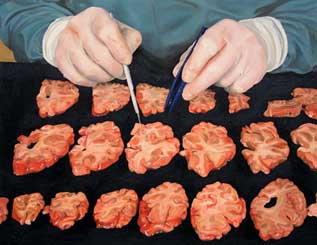 Damien Hirst Autopsy with Sliced Human Brain 2004 So what is the next show after the current Pierre Huyghe video at the Portland Art Museum's Miller-Meigs endowed room in the Jubtiz Center? You may have heard of him, it is Damien Hirst (one of my all-time favorite artists and probably one of the most loved/hated people in the history of art). He's obsessed with death, was generous enough to help an entire group of Young Britsih Artists become successful and is the master of presentation, having worked as an gallery installer before he became famous. Hirst is also notable as the first major artist since Picasso to control his own market. In a time where the market controls everything, this is yet another example of how perceptive Hirst is. This is a rare solo US museum show for Hirst, who has avoided the museum blockbuster machine, preferring to make his own weather in out of the way places. Show opens January 13. Posted by Jeff Jahn on November 29, 2006 at 11:25 | Comments (2) PermalinkMonday 11.27.06 Cloepfil has it Still Tyler at MAN
reports that Portland's "starchitect" Brad Cloepfil will be designing
the new Clyfford
Still Museum in Denver. Cloepfil has his light and airy side (new Seattle
Art Museum, PDX Contemporary Art) and a heavier side that does wonders with concrete
(Weiden + Kennedy headquarters). Still, like a lot of AbEx painters liked to present
a kind of life and death drama in his work so Cloepfil's earthy/heavy and airy light should
complement the artist's dichotomies well.
Posted by Jeff Jahn on November 27, 2006 at 12:31 | Comments (0) PermalinkFriday 11.24.06 Weimar Litmus Test & Figurative Art 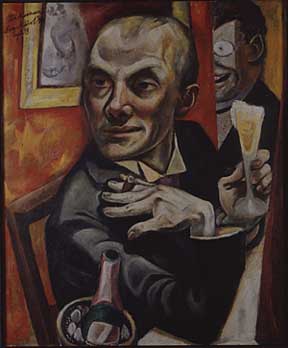
Self-Portrait with Champagne Glass, 1919 Max Beckmann (German, 1884-1950) Oil on canvas; 25 9/16 x 21 7/8 in. (65 x 55.5 cm) Private collection, courtesy W. Wittrock, Berlin In the NYT's Roberta Smith had a timely review of the "Glitter and Doom" show at the Metropolitan Museum. The focus on the anxiety present in the New Objectivity movement's artists like Otto Dix and Max Beckmann is absolutely in step with the mood of today. Still, one would have to stifle a chuckle in order to compare the anxieties found in Cecily Brown and Dana Schutz to that of Dix and Beckmann (and I like Brown and Schutz). The difference, Weimar Germany had just come off of WWI and the US's war in Iraq doesn't have the same urgency, though we are in a time of decadence and wealth while a smaller scale war of attrition rages. Good that the Metropolitan put this on, with the Miami Art fairs coming up this seems like a kind of cultural litmus test. Where is our version of brutal honesty? It definitely isn't Pierre Huyghe, who has a purosefully theatrical slight of hand that's been big ever since Matthew Barney. Sure Beckmann is theatrical too, but it is infinitely more honest than nearly everything Ive seen lately. Today good intentions and entertainment seem to be a substitute for difficult critiques and self-reflexive questioning? On to someone who could use a huge dose of Otto Dix's depth, Portlander Ty Ennis (who was reviewed on PORT a few weeks ago) has spawned a hilarious unauthorized biography and a flux 7 out on the PDX blogosphere. Catch the show tomorrow on its last day to gauge the fuss (correction Dec 10th is the last day). Ennis is a talented artist in search of stronger subject matter, though according to the flux 7 he stands by it. Good on him, let's see if he gets something from the response he's received for this show, the criticism has been valid. Posted by Jeff Jahn on November 24, 2006 at 17:16 | Comments (18) PermalinkTuesday 11.21.06 Existentialism, Advertising and Toast? I noticed this
same thing and I enjoyed how the Nissan ad defanged "Breadface"
by making it a leisurely piece of toast in a chair. Let's face it (oh endless puns?), an endpiece for a loaf of bread by itself is more existential than toast... but I
never would have thought about that except for Nissan's approximation of Matt Johnson's
art. Also, Tyler cracks me up with his, "How hipster! How clever! Because
gosh, who wouldn't want to live out of a mid-level Japanese car?" The hipster
cars in Portland tend to be old biodiesel ready Mercedes, any Volvo but a brand
new one, Ford Festivas and the ever popular "no
car" ride a bike/Max train option. So, unless Nissan can make an old European automobile they ain't gonna hit this demographic.
Posted by Jeff Jahn on November 21, 2006 at 11:22 | Comments (5) PermalinkMonday 11.20.06 Tom Cramer at Laura Russo 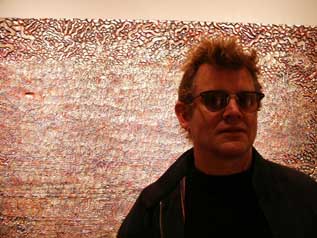 By now many collectors have received announcements that Tom Cramer, arguably the city's artist laureate, has joined forces with the venerable Laura Russo Gallery, the now (as ever) undisputed leader in historical Northwest artists. This makes a lot of sense. Tom (a good friend who left his previous gallery over 8 months ago) is probably the best selling artist in Portland and I've known about this for a very long time. Tom is particularity important since he is the link between the pre-90's art scene in Portland and the current one... I see it as one contiguous cloth and Cramer's take no prisoners approach to the sublime, kitsch and the ancient art of woodcarving make him pretty unique. This is the first major artist shift for the Laura Russo Gallery since Henk Pander joined the stable a few years ago and an exciting development. It is a great thing as the Russo gallery just celebrated its impressive 20th anniversary (Liz Leach just celebrated her 25th on the 11th) and what I like about Russo's gallery is their no-nonsense seriousness. What other gallery in the Pacific Northwest represents the estates of so many artists? In art the follow-through is very important. Now with Mel Katz, Francis Celentano, Lucinda Parker, Gregory Grenon, Robert Colescott, Henk Pander and Michael Brophy, Cramer only adds to the most mature stable of artists in Portland while adding a dash of flash. The announcement card indicates that he has a one-person show scheduled for October 2007 (Ive seen some of the work, he just keeps getting better). Posted by Jeff Jahn on November 20, 2006 at 11:04 | Comments (1) PermalinkTuesday 11.14.06 Developing Culture Tyler Green pointed
out this nice story about the connections
between non-profits and developers in the Boston Globe. The most obvious
example of this in Portland is the Armory (the Gerding Theater). Other projects
like Jim Winkler's development of the the Daisy
Kingdom building and PAC's arrangement with David Gold also come to mind.
Another favorite blogger Edward Winkleman had a nice post on the pressures of success upon artistic (mass) production here. It's true much of the revolutionary art of the last century was birthed in complete market obscurity, that simply doesn't exist now. When I was in Miami last year I couldn't believe how many people knew about what was going on in Portland. This year our presence will be even better with more galleries etc., plus Bruce Conkle will have one of his show-stopping snowman in a freezer at Nada this year (his work makes Marc Swanson look so lightweight with its cartoony darkness, and he's been at the game much longer too). Posted by Jeff Jahn on November 14, 2006 at 11:27 | Comments (0) PermalinkSunday 11.12.06 James Chasse Jr., artist and model  James 'Jim Jim' Chasse by Randy Moe courtesy of Chambers Gallery At this point, most Portland residents are familiar with the story of James Chasse's tragic, unconscionable death in police custody. Out-of-towners and those who are a little hazy on the details can read about the incident here. As a teenager in the late 70's and early 80's, Chasse was a friend of several longtime members of the local art scene, including Eva Lake and Randy Moe. In his late teens, Chasse changed dramatically after developing schizophrenia, which he struggled with until his death on September 17th, 2006. When Moe and Lake learned that Chasse had been killed, they were already preparing for an exhibition of Moe's portraits at Chambers Gallery, which Lake manages. Presciently entitled, It's a Sad, Sad, Sad, Sad World, the show has been expanded to include a portrait of Chasse and a binder filled with photocopies of The Oregon Organism, a zine Chasse created while in his early teens. Moe used an old polaroid photograph of a 14-year old Chasse, affectionately known as 'Jim Jim,' as the source for his memorial portrait...............(more) Posted by Jessica Bromer on November 12, 2006 at 9:13 | Comments (2) PermalinkFriday 11.10.06 Exhibition space not rental space The Portland Art Museum has just announced that the
rental sales gallery is finally leaving the Goodman Gallery space on the
main floor of the museum's Belluschi wing. Hot Damn! I've known about this for
a long time and you gotta know the curatorial department had to be thrilled
when one of the best gallery spaces in the museum became a shop. Museum stores
should not occupy exhibition spaces and this stay tarried too long after the
completion of the Mark building.
That said it will be used as an orientation space for group tours in the short term. Grumble, grumble... still all will be forgiven though if a nice (long overdue) large-scale contemporary exhibition follows this short term situation. The rental sales gallery will have its new home in the nearby Elliot tower and will have a special grand reopening on Dec 1st. Posted by Jeff Jahn on November 10, 2006 at 14:31 | Comments (0) PermalinkThursday 11.09.06 Bubble wrapped bubble cars Today marked the first trip for Portland's aerial tram's still
unnamed cars. KATU
had some nice footage of the bubble wrapped/bubble shaped cars first voyage here. If all goes well we can ride in them in January. Artists like Ellen George and Eva Lake will have work at the top of the hill even.
Posted by Jeff Jahn on November 09, 2006 at 21:01 | Comments (2) PermalinkWednesday 11.08.06 Round Up  YouTube!!! YouTube!!! Can you believe what you can find on YouTube? Posted by Melia Donovan on November 08, 2006 at 22:04 | Comments (1) PermalinkName the aerial tram cars?  Commissioner Sam is giving us till the end of the month to name the new aerial tram cars, which are due to start tramming away any day now. Note, if they are named Lewis and Clark I'm gonna gag. The aerial tram is the most important structure to go up in Portland since Big Pink in terms of it being a lightning rod of civic symbolism and it's relationship to the kind of city that Portland is becoming should not be underestimated. Here are some not so serious ideas: Peanut butter & Jelly Paige & Plant Bud & Vera Ned & Homer Necessary & Evil Luke & Laura Sue Ellen & J.R Yin & Yang John and Kristy My absolute worst idea = Enterprise & Galactica (Millennium Falcon just doesn't work) You can email Sam Adams with your ideas here and have until 5:00 PM November 30th. Posted by Jeff Jahn on November 08, 2006 at 9:45 | Comments (2) PermalinkFriday 11.03.06 If you can't beat the blogsphere, join it Two major Northwest daily newspaper art critics have taken up blogging.
First there is Regina Hackett at the Seattle PI. Her style of reviews and often subjective viewpoint oriented writing is perfectly suited to art blogging. Then there is David Row's recent turn as a blogger. Yes, I like to refer to him as Death Row (because it's cool) and I am a little disappointed it isn't called the "Death Blog." Once again an unbeatable name... let's compare, my personal blog would have to be called the "Yawn Blog" after the correct pronunciation of my last name, so dull. Oh well, the "DKlog" should allow him to continue pressuring the museum for a free day (note they need a lot more guard on free days). My solution, simply make one Thursday night a month free instead of a whole day, easier sell and easier to get sponsors eased into the idea. The interesting development is both David and Regina have plastered their photo's on the web and allow for comments.... I'm blond, I can't disappear (even in a large crowd) but it is sometimes nice to be unrecognized as a critic. I wonder if David and Regina will feel a pang at giving their respective art scenes a target? All that said, welcome aboard... it's definitely different out on the blogosphere and it often comes down to one's wits. I think arts writing and blogging are probably perfectly suited for one another. Posted by Jeff Jahn on November 03, 2006 at 15:02 | Comments (1) PermalinkArtist's studio spaces don't have funerals, they have sales 333 Studios Warehouse/Garage Sale
Saturday, November 4 from 10am to 4pm 333 NE Hancock (at MLK) - Portland 10,000 square feet and 15 years of stuff, including: - furniture - tables - desks - wood - metal - tools - shelving - cabinets/bookcases - odds and ends - free stuff - art supplies - and of course art Posted by Jeff Jahn on November 03, 2006 at 11:37 | Comments (0) PermalinkWednesday 11.01.06 Round Up 
Brice Marden, bad architecture, Matthew Barney and Joseph Bueys and a benefit. Posted by Melia Donovan on November 01, 2006 at 10:00 | Comments (0) PermalinkTuesday 10.31.06 Please allow me to introduce myself... Hi, I'm Jessica. I've worked with several regional art organizations over the past two years, most intensively with Posted by Jessica Bromer on October 31, 2006 at 16:23 | Comments (0) PermalinkRolling Out The Welcome Wagon Some of PORT's very attentive readers have noticed there is a new name in the
contributor's list, it has been a busy time and once again the site has shattered
it's readership records. Thank you readers!
So yes, later today Jessica Bromer will be making her first posts as PORT's new 1st Thursday and Friday "listings" poster as well as our newest critic. She knows the Portland scene well having worked as exhibition coordinator for Portland Modern. While cutting her teeth blogging for PICA during TBA I was impressed with her handling of Matthew Day Jackson's show calling it, "a bit Kountry Kosy." (From Schjeldahl to myself a lot of critics find his work a bit too cursory considering his source iconography.) Jessica rightly called him on it.... only to go a couple of rounds with the artist (successfully) in the comments. Needlesss to say, like all of PORT's staffers she is unafraid to present her opinions and true to our mission she has a lot of free reign to explore that critical stance. Welcome Posted by Jeff Jahn on October 31, 2006 at 11:36 | Comments (0) PermalinkSunday 10.29.06 All of tomorrow's art-y's, W's first art issue 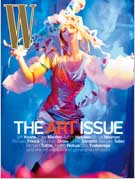 W magazine's first ever art issue is out with a feature spread involving Richard Tuttle, whom I admire a lot and reviewed a few months ago here. Let's just say the Eden photoshoot is mostly window dressing and its saturated glossyness seems more typical of Pipilotti Rist than Tuttle's earthier and dryer sense of humor. His work demands a simple, more elemental aesthetic in order to be successful and I don't see that here. True, the fashion world and art have a lot in common, especially these days but one has to ask, does anything stimulating come of it? In Tuttle's case...maybe not. Better than the magazine spread, here is a video documenting the production. Then there is the whole issue of the diluting popularity of the art world.... which I'm on a fence or two about. Will popular mechanics have an art issue next? Posted by Jeff Jahn on October 29, 2006 at 19:02 | Comments (0) PermalinkWednesday 10.25.06 PICA Artist in Residence to Lecture Tonight 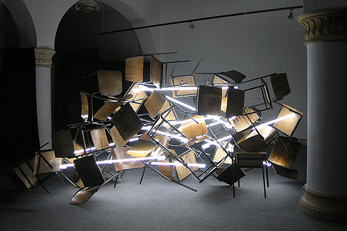
Current PICA artist in residence Viktor Popovic will lecture on his work tonight in PICA’s Resource Room. From Croatia, Mr. Popovic creates temporal, glowing installations using light, found and industrial materials....(more) Posted by Melia Donovan on October 25, 2006 at 13:31 | Comments (0) PermalinkFavorite Buildings in Portland? 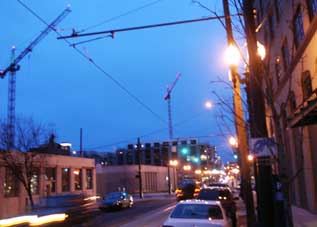
The Portland Tribune suddenly has a lot of stories on architecture and the quality of buildings in town this week. Strange, yes we have Graves' Portland Building but generally the city is more interested in people, books, food, music, art and complaining about the lack of architecture rather than architectural excellence itself. Still there has been a shift in the last 2 years. One sign of the change in attitude is this Trib piece on local architects picking their favorite buildings in Portland (yes it's a quiet bunch of buildings, wait till the aerial tram is done for big a paradigm shift in the outward profile of architecture in Portland). Not surprisingly, the Sacks house on NW Glisan by Brad Cloepfil took top honors. What would PORT's readers pick? My pick is the Adidas campus by BOORA or the Fox Tower (the lobby is really superb) by Thompson Vaivoda and Associates... maybe the train station even. At the Organism's Gertrude salon last night many thought the Union Bank of California Tower deserved the nod, I agree it's an under-recognized gem. Let us know what your pick; Belmont Lofts, PNCA's interior, the Doug Fir, the St. Johns Theater & Pub? The aerial tram isn't completed yet and yes I wish the giant World's Fair log cabin (Oregon State Forestry Center 1905) still existed. Then the Trib had this piece on the Frank Gehry that never happened. Good to remind people of that and overall it seems like Portlander's are demanding more quality from the architecture. I've been working on a series of atypical architectural photographs for the last 5 years so I have my own selfish reasons for this, 9/10ths of the photos are of buildings outside of Portland. Design-wise the city does seem to be wide awake now, let's see what comes of it in terms of buildings. Also worth a look, the Portland Architecture blog had this nice post on a couple of interesting new fire stations a while back. Posted by Jeff Jahn on October 25, 2006 at 11:32 | Comments (10) PermalinkMonday 10.23.06 Welcoming PAM's new chief 
Today, Brian Ferriso started his new job as director of the Portland Art Museum, the big kahuna on Oregon's cultural scene. The O had an interview yesterday, with a lot of thoughtfully measured answers by Ferriso. There was also the paper's general attempt at creating a huge hullabaloo over the cost of the Mark building's renovation. Let's just say Ferriso has worked (with grace) under much more difficult financial situations. Although he wasn't the man in charge, the Milwaukee Art Museum's gorgeous but hugely expensive 100 million dollar +??? Santiago Calatrava expansion caused them to take truly drastic actions. Under that kind of difficult situation he was eventually promoted from senior director of curatorial affairs to deputy director. The message, this is a talented guy who can make lemonade with lemons. PAM's situation is much better. Here are some long and short term things to consider...(more) Posted by Jeff Jahn on October 23, 2006 at 21:55 | Comments (6) PermalinkThursday 10.12.06 Amy Berstein's Bio After spending the past year painting in Berlin, Germany, Amy
Bernstein moved to Portland to become a part of the burgeoning
Northwest art community. Originally from Atlanta, Amy recieved her
B.F.A. from the Rhode Island School of Design where she studied
painting. Amy enjoys making art, the strongest of coffees, and
haggling over the interpretations of riddles. She looks forward to the testing Portland will bring to all of her philosophies and how it will thus alter her art practice.
You will find her listening enraptured in the midst of odd local circles, amazed to suddenly find herself where she is. Posted by Amy Bernstein on October 12, 2006 at 20:11 | Comments (0) PermalinkPORT's latest addition Just a quick note, later today PORT will be introducing our newest critic, Amy Bernstein. She's a firecracker with international experience whose opinionated
nature seemed perfectly suited for art criticism. Since Port's audience and Portland's scene
continues to expand quickly, we felt that another voice would allow the four of us to better devote ourselves to in-depth reviews.
Posted by Jeff Jahn on October 12, 2006 at 11:30 | Comments (0) PermalinkMonday 10.09.06 Affair followup It is good to hear what outsiders say about events in Portland and Carrie Scott took on the Affair at the Jupiter Hotel in the latest Visual Codec. Alice
Wheeler also photoblogged it, as did Eva Lake. Interesting how they differed from our photoblog coverage.
One notable sentiment, the idea that there is some sort of inherent gulf in quality between Portland art and New York, LA etc., has pretty much died (it's more a question of frequency, specific artists discussed and the venues now). As to the event itself, obviously there are many improvements that can be made (some sort of major draw artist etc.) speak up if you have any ideas. Posted by Jeff Jahn on October 09, 2006 at 10:25 | Comments (1) PermalinkFriday 10.06.06 Do Something Nice Start you weekend off right and feel good about yourself by helping others. The Children's Heart Foundation is holding their 2nd annual fundraiser, PULSE. Watch as 40 artists work for eight hours to make a piece that will later be available to bid on at a live auction. The impressive list of artists include Mark Andres, Troy Briggs, Rebecca Scheer, and Andi Kovel to name a few. $100 will get you into the preview party that features food by local favs clarklewis and Andina as well as an opportunity for secure bidding. $45 will get you into the Pulse party at 7pm. Pulse • Children's Heart Foundation fundraiser Saturday October 7 Preview Party • $100 • 5p Pulse Party • $45 • 7p 2537 NW 29th • Portland, Or Posted by Jenene Nagy on October 06, 2006 at 22:11 | Comments (0) PermalinkNorth Mississippi growing pains 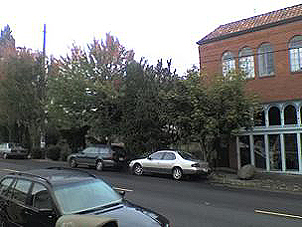 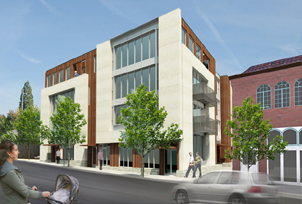 Brian Libby at Portland Architecture has a great post on the fate of Holst's new building on North Mississippi. Both sides have good points this time but cant they work things out? Will this BDS decision have a withering effect on good design in the city and lead to a bunch of crummy, designer outlet store approved faux historic travesties? Or can the anarchists and design gurus make nice by realizing that modern design can actually highlight the funkier historic buildings in a kind of anachronistic-modern tango? The middle of the road way leads to homogenized aesthetics and Brian is right to be concerned. What is at stake here is what I call Portland's "Freak Factor" and I think everyone needs to stop thinking purely in terms of, "what fits?" That kind of thinking leads to self-parody and the apple store decision on NW 23rd was simply sad. Instead, decisions should emphasize what stands out. A modern building coexisting next to an anachronist collective just slays me, it should happen and would be sooo Portland. Holst architecture does very sharp yet inviting work and previous projects like the Belmont lofts look great on that funky street in the SE... so why not in NoPo with a few possible changes? Look, change is coming it can either celebrate excellence or mediocrity. As Brian pointed out: the Portland Landmarks Commission will hear an appeal of the BDS rejection on Monday at 1:30pm (1900 SW Fourth Avenue, 4th floor - be there.) Posted by Jeff Jahn on October 06, 2006 at 16:02 | Comments (0) PermalinkRound Up 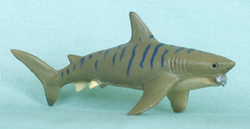
Randomly Random A bit ago, there was mention of Damien Hirst not exactly following directions resulting in the need to replace the shark in “The Physical Impossibility of Death in the Mind of Someone Living”. On the Time’s website there’s a video of the removal of the shark, which is somewhat fascinating....(more) Posted by Melia Donovan on October 06, 2006 at 10:05 | Comments (0) PermalinkWednesday 10.04.06 PSU’s MFA Monday Night Lecture Series Begins Robert
A. Pruitt to open the series October 9th
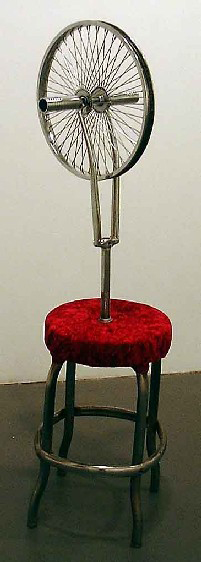 Low Rider Art, 2004 stool, crushed velvet, bicycle wheel, chrome 57 1/2" x 16 1/4" x 9" Posted by Melia Donovan on October 04, 2006 at 20:18 | Comments (2) PermalinkTuesday 10.03.06 Last Chance  Biswas at Reed There are several important shows closing this weekend so make certain to catch any of these that you may have missed: The Portland Art Museum's 2006 Oregon Biennial. A good, if elegantly tame show by Portland's new standards. Yes, that is a good development on the elegance factor and the tame problem stems from the too abbreviated installations (Brittany Powell is the biggest victim, girl needs more than one wall) and an overabundance of works under glass. Portland has one of the most spatially activated scene's out there and we normally only see this much glass at the Affair Art Fair. Next time everyone will expect major installation "environments" and video art that isn't ghettoized in the back. Still, it's a good show especially if you arent an avid art scene aficionado, a good bit of catch up. Just know that installation art in Portland isn't normally so limited space wise. The show succeeds as the dignified museum show everyone had been asking for. Next time the museum needs to challenge expectations not just meet them. Ends Sunday October 8th. Sutapa Biswas: Birdsong at Reed College's Cooley Gallery. I really enjoyed the first video "Magnesium Bird"... it is perfection, and although the new dual channel video "Birdsong" has its moments it feels a bit overcooked. The purposefully out of synch video images in Birdsong work particularly well when zoomed in close to the child's face but by actually showing the horse it spoils the mystery and uneasy mood, more Bruckheimer than Hitchcock. The narrative seems to have imbedded imperatives that are choking the art. It is worth seeing though, I loved the green room with bird paintings as one enters the gallery as well. Ends Sunday October 8th. Also, don't miss the PICA TBA holdovers. If you miss Harrell Fletcher's The American War, you've missed one of the best contemporary art shows on the planet. Maria Abramovic's Balkan Erotic Epic may be the weakest art she has ever produced (by turning director, the performance artist is branching out) which gives you some idea of how great she is because this rates well as good festival fodder (still more tolerable than anything Bill Viola has done). Theo Angell, Red 76, PORT's own Katherine Bovee and Philippe Blanc and Matthew Day Jackson's work are on display through this week as well. Ends Friday October 6th except Blanc and Bovee on Saturday October 7th. Posted by Jeff Jahn on October 03, 2006 at 10:47 | Comments (1) PermalinkMonday 10.02.06 Because brilliance still matters 
Drawing by Leonardo da Vinci (image © Queen Elizabeth II/V&A) Here are a few things that rise above the current (but ever popular) cult of mediocrity: Walter Robinson points out out why Murakami kicks just so much ass on ArtNet, the secret to his talent is his G E N E R O S I T Y. He doesn't put on airs of passive aggressive shyness and gives others a chance to shine. One can be great and generous, no other living artist on the planet comes close to this kind of effect and Ill be there for his mid career retrospective at MOCA a year from now. Where Americans got all soft when adopting the kawaii (cute) culture, Murakami (and the original Japanese version) had teeth. Also, Artinfo had an interview with John McCracken a while back, a brilliant artist of the asymptote (lines that reference infinity). And last but not least Leonardo's (no not the Ninja Turtle) show at the V & A gives Adrain Searle a mental workout. Somehow da Vinci makes others raise the bar for themselves and Searle's quick phrase of "knight'-move thinker" has me smiling. In these times when people consider mere sincerity an adequate stand in for intellectual acuity this does my heart some good. Posted by Jeff Jahn on October 02, 2006 at 10:28 | Comments (0) PermalinkFriday 09.29.06 Have an affair or be square 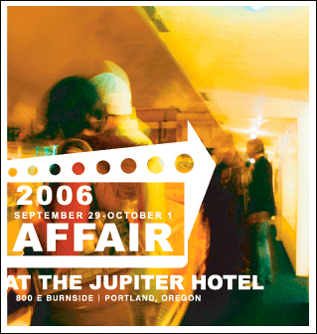 The Affair at the Jupiter Hotel Art Fair starts tonight. Be there or be square. The quibblers and naysayers said it would never last but here it is. Will it be be overfull of massively derivative, follow like sheep, self-conscious doodle works on paper that aren't even good enough to be on the cover of the Mercury? Sure, it wouldn't be an art fair if it didn't but it can't possibly have as many as last year. There are much better things on hand as well. $100 gets you into the posh 6-9 PM opening but $10 gets you in at 9:00 PM tonight (PORT will be covering). Saturday and Sunday are nice if you want to browse and schmooze more casually...(more) Posted by Jeff Jahn on September 29, 2006 at 0:12 | Comments (0) PermalinkWednesday 09.27.06 Round Up 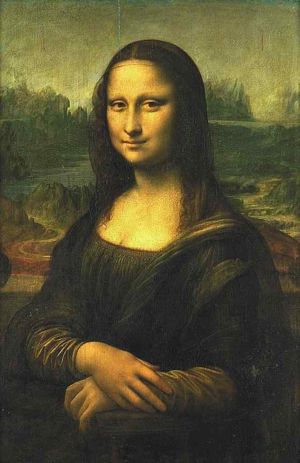 Mona Lisa Leonardo da Vinci, circa 1503–1507 oil on poplar, 30 x 21 in Musée du Louvre I keep thinking about that small, tiny conversation that took place a couple of months ago here about gender equality in the local Art world and wonder, since it’s in the air in bloglandia, if it might be time to bring it up again. Posted by Melia Donovan on September 27, 2006 at 22:34 | Comments (19) PermalinkTuesday 09.26.06 Some-thing for everyone? 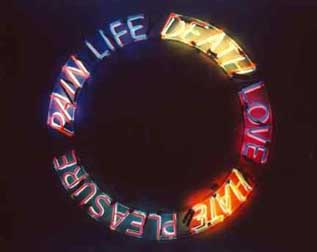 Bruce Nauman, Life, Death, Love, Hate, Pleasure, Pain (1983), Collection Museum of Contemporary Art, Chicago, Gerald S. Elliott Collection Here are some things to take in: Richard Polsky discusses being an art broker and knowing where the bodies are on Artnet. Although he thinks Murakami's prices are out of whack he misses the point that Murakami is probably the most important artist of the last 15 years and his importance goes deeply into graphic design in a way a pure art market person might not get. Matt McCormick loves Portland, nice to have you back MM. I think a lot of us have similar moments after traveling a lot. Brian Libby looks at Brad Cloepfil's design for UMMA here. I think Cloepfil is great but his museums and gallery spaces often annoy me a little in their floaty non-corporeal use of natural light (it can and does work but it requires intervention to keep the space from muting a show's thunder). I prefer Ando's galleries... maybe SAM's addition will turn that view around. I also really enjoyed David Cohen's take on Bruce Nauman and the other artists who use neon words (with diminished effect). I agree, Ive seen a lot of prank art with neon and most of it is forgettable. Only Joseph Kosuth and Jason Rhoades seem to do it with any worthwhile effect, for most others it's an easy way to make C+ grade hack conceptual art (every city has 2 or 3 of em and they are interchangable). Rhoades' solution works because his scenic route style absurdity rivals Nauman's anti-scenery. Kosuth makes it work because of its incredible bluntness rivals Nauman's blunt obfuscation. Still, Nauman is the man because of his relentless, pitiless existentialism and I can't wait for his travelling neon show at the Henry in 2007. Posted by Jeff Jahn on September 26, 2006 at 12:04 | Comments (3) PermalinkMonday 09.25.06 What's with that big new gallery at 916 NW Hoyt? That new (yet unopened) gallery at 916 NW Hoyt, Quality Pictures, just went live with their website. It will be months before the
space opens but they are having a room at the Affair
at the Jupiter Hotel, which opens on Friday. The weather is looking divine this year so this would be a good time to hop on jet blue if you aren't fortunate enough to live nearby.
Posted by Jeff Jahn on September 25, 2006 at 9:52 | Comments (2) PermalinkWednesday 09.20.06 Round Up 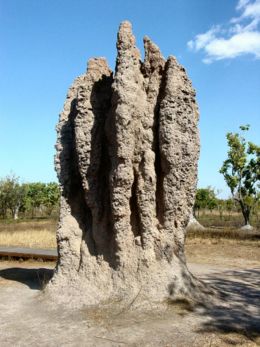
Image of a termite mound courtesy of the Collective or other Institution Emergence as found on Wikipedia continued from last week……. Posted by Melia Donovan on September 20, 2006 at 22:03 | Comments (0) PermalinkA resurgence in the Everett Station Lofts 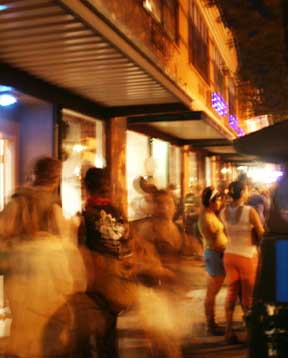 With so many artists and a lot of new spaces popping up in unexpected locales there is a wild-westness and an equally pervasive camaraderie to the Portland art scene. Over the years the Everett Station Lofts have been the most important breeding ground and networking... (more) Posted by Jeff Jahn on September 20, 2006 at 12:08 | Comments (5) PermalinkMonday 09.18.06 Warhol Documentary 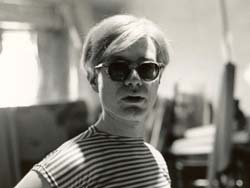
The NW Film center is screening Ric Burns' Andy Warhol Documentary tomorrow night. It clocks in at 4 hours with Laurie Anderson as the narrator and then there is the wry casting of Jeff Koons as the voice of Andy Warhol... kinda like casting one of the members of Oasis in a Beatles documentary. Should be interesting in a tragic Warholian sort of way. Here is a link to what the Village Voice said. 6:30 PM, September 19th Northwest Film Center's Whitsell Auditorium at the Portland Art Museum: 1219 SW Park Ave. Admission Prices: $7.00 General, $6.00 Members, Students, Seniors Posted by Jeff Jahn on September 18, 2006 at 15:18 | Comments (5) PermalinkFriday 09.15.06 Reviewing the week It has been a good week of reviews. More than occasionally, both random and
not so random people stop me and unload a rant about the state of art criticism
in Portland and the world in general. Agreed, art criticism isn't in some golden
age but I dont think it is in the same imminent crisis others ascribe to it either.
This week, besides my own abomination (blithely doing things that would have made my 600 level, critical writing prof get "all paperchase and Housemanesque" on me 13 years ago) we had some nice reviews. Instead of focusing on personalities or being reactionary towards the success, fame or "newfangledness"of an artist they took subject matter and the overall effect into account. An exciting development considering that and the fact there were 4 serious reviews published this week. Too bad I count about 25 shows worthy of reviews this hyperactive month. First off was Richard Speer's review of Brendan Clenaghen's show. Short, eloquent, on topic and yes it's a great show that definitely shows that sometimes Portland artists are superior to anything similar nationally. Pulliam Deffenbaugh has really improved as a gallery since moving into the new space and with the addition of Matthew Picton (just this week) alongside Clenaghen, Linda Hutchins and Laurie Reid there is a reason they might just be the most reviewed gallery in Portland. Then John Motely (whose role seems to be one of the last bastions of non-tabloid twaddle at the Mercury) penned this evocative bit on Sutapa Biswas at Reed. Reading it, I was reminded how frequently video shows receive one-dimensional reviews that simply provide a travelogue account of the experience or simply a one line description. Instead, this was a layered and at length. Last but not least, David "Death" Row published this relevant thing on Tad Savinar. True, if I were to go "Snark hunting" with any local writer DK would have to be at the top of the guest list but I agree with his focus on gentrification as a major civic issue in Portland and Tad's show. Besides, it makes sense that the pithy Savinar would get the attention of a purveyor of snark. Dont misconstrue this, snark can be a good thing, obsequious pleasantness is so dull and generally favors mediocrity. Posted by Jeff Jahn on September 15, 2006 at 11:00 | Comments (4) PermalinkWednesday 09.13.06 Round Up 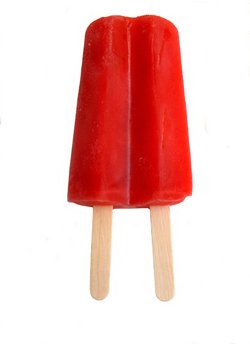 Here and there Portland artists are donating their work to fund organizations that benefit the arts communities in Portland and beyond. There’s a conundrum in that, which is neither here nor there, but the beneficiary in this case is you. Where else would you have the opportunity to buy a t-shirt designed by Miranda July with a picture of you both against the word PEACE? Or have the opportunity to buy a work from a current Oregon Biennial artist for 100 smackers? Posted by Melia Donovan on September 13, 2006 at 22:26 | Comments (4) PermalinkTuesday 09.12.06 Two must reads As Melia pointed out in the comments earlier, Jerry
Saltz does his version of a reality check regarding art (probably as a work
up to his next Babylon article, due out soon). Does art change the world? Well
any action creates some change of course but leadership matters more of course.
Thus a better question is...(more)
Posted by Jeff Jahn on September 12, 2006 at 0:54 | Comments (0) PermalinkSaturday 09.02.06 Free Day at Portland Art Museum 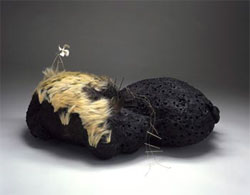 Marcy Adzich's "The Divide" from the Oregon Biennial Top your holiday weekend off with a free trip to the Portland Art Museum. The museum will be open free of charge Monday September 4, from 10-5pm. Still not sure what to think of the Jesse Hayward piece? Well here's your chance to give it another look. Along with the Oregon Biennial, exhibits include Through Rustling Grasses: Nature in the Japanese Print and the must see Richard Rezac work. Throughout the day museum docents will be leading free tours of several of the exhibits. Free Day • Portland Art Museum Monday September 4 • 10a-5p 1219 SW Park Ave • Portland, OR Posted by Jenene Nagy on September 02, 2006 at 10:12 | Comments (0) PermalinkFriday 09.01.06 Weekly Web Roundup  Summer is ending and everyone’s excited about the coming Fall exhibitions. Opportunities abound throughout September for thoughtful and intelligent visual and performative culture in Portland. With everyone’s eyes to the immediate future, here are some tidbits from around the web pertinent to the roundup....(more) Posted by Melia Donovan on September 01, 2006 at 21:34 | Comments (0) PermalinkFirst Friday September 2006 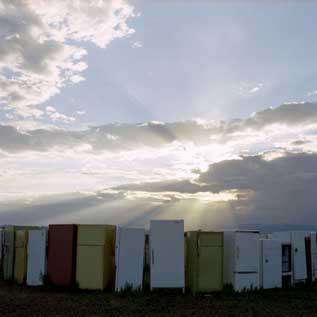 Greg Turco at Newspace Yes it's one of those wierd inversions when First Friday comes before First Thursday. Of course it isn't the end of the world, it's just the beginning of September Rachel Shapiro & Greg Turco • The View From here Newspace is the most consistent 1st Friday stop and this duo of photographers only adds to the tradition. Newspace Photography • 1632 se 10th portland, or 97214, 503 963-1935...(more) Posted by Jeff Jahn on September 01, 2006 at 13:56 | Comments (0) PermalinkWednesday 08.30.06 Huyghe the entertainer? Read this op-bit about Pierre
Huyghe on the Contemporary London Art blog because he will be having a show
at the Portland Art Museum starting on September 23rd. It reminds me of the
debate
about entertainment art started when"Let's
Entertain" rolled through the Portland Art Museum in 2000.
Posted by Jeff Jahn on August 30, 2006 at 12:16 | Comments (1) PermalinkMonday 08.28.06 The effect? Yes, Ill have that review of the Oregon Biennial soon but it's really involved
and I want to hammer a few more details, mostly because it's the kind of feedback
I like to get when I curate a large group show. It's funny but only after the
show's been up for a week or two do all the unforeseen emergent properties of
a show become apparent to the person who put it together. Curators are a bit
like surfers except they choose the elements and shape of the wave.... only
after they have ridden the complex thing does a more full understanding come.
In many ways it's the best part of the curatorial practice, there is this expansive
feeling that you've really learned something. That's what happens when thousands
of minds in a city explore a show, the combined civic intelligence (as opposed
to mass idiocy) is something we often take for granted but is revealed when you survey
a bunch of artists. It's a massive study in civic behavior and I think some of the artists deserve a more in-depth look too.
Till then check out Tyler Green's take on LA version of the traveling Rauschenberg combine show. Of course it's better in LA, the Smithson show a few years ago certainly was too. Also, the Portland's Future Awesome blog has a lot of worthy recent posts... green buildings, Portland voted the only "most successful city" in the US by the Europeans etc. Those Europeans are always flattering us as a way to critique the rest of the US. Can't fault em. Elsewhere,Edward Winkleman takes on the Stuckists. Ive been thinking about them a lot recently and maybe it's how reactionary they seemed right at the height of the YBA's dominance, like the YBA's were the boat and they were part of the wake? If artists can't produce their own effect without reacting to a more protean artist or group then aren't they essentially a sideshow? A spent force? Supporting actors? Not that it's a bad thing but in the end it becomes important to determine who the leaders are. Posted by Jeff Jahn on August 28, 2006 at 10:46 | Comments (1) PermalinkFriday 08.25.06 What to see? 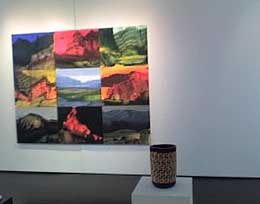 James and Joey Lavadour at PDX Contemporary Art What should you absolutely see this weekend? If you haven't caught James and Joey Lavadour's show at PDX gallery, do so. If you've seen it already, go and see it again, it's James' best to date. Look for a full on review next week from another PORT staffer (I've already called him the best abstract landscape painter alive today, what else can I say?... OK maybe that Joey's baskets work perfectly with this show too and should be reviewed together). D.K. "Death" Row reviews him favorably in the O's A&E... but some of the artists he compares him to seem more than a bit forced, there is nobody like Lavadour. Also, what's up with the Arthurian comparisons? The Columbia River Gorge etc. looks nothing like England or the north of France... (oh well) Also, make a point to check out the multi-channel video piece by Dan and Bean Gilsdorf at Portland Modern's tiny but excellent corporate headquarters at 1715 NW Lovejoy....(more) Posted by Jeff Jahn on August 25, 2006 at 10:26 | Comments (3) PermalinkThursday 08.24.06 Weekly Web Roundup 
This week’s roundup is short and sweet. A couple of items that are curiously linked made their way across the information super highway to the sprawling offices of PORT. First, an article in the New York Times on Saturday got me thinking about politically/socially engaged art as a catalyst for change and how that change doesn’t always equal the artist’s enthusiasm for the cause. Though the man in the article, Duraid Lahham, is an actor his sentiments cross genres. In context with the announcement, at the end of the Roundup, that PICA sent out, it seems a perfect opportunity to engage in a dialogue about political art and the expectations that artists have for their work...(more) Posted by Melia Donovan on August 24, 2006 at 7:41 | Comments (1) PermalinkTuesday 08.22.06 New Director of the Portland Art Museum is Brian Ferriso The new director of the Portland Art Museum is Brian Ferriso.
Joseph Gallivan at the Tribune has a long article and a picture. Earlier, DK Row at the Oregonian had a heads up article and broke the story. Thankfully this ends months of sometimes ridiculous speculation and I like a lot of things about this guy already: He's young and ambitious and gathering from Gallivan's article he is coming here because Portland is dynamic, smart man. He used to be at the deputy director of the Milwaukee Art Museum, the place were I cut my teeth in the visual arts (their collection is suprising and superb btw). He was director of curatorial affairs before that and I think many will like the fact that he has more than just administrative knowledge. He was most recently the director of Tulsa's Philbrook Museum, which has upgraded its contemporary collections and seems to know what a God Josiah McElheny is.... just bring McElheny here and watch attendance levels beat the dead French art shows we have been innundated with. Welcome to Portland, its a testament to Portland's strength that the position was filled this quickly. Posted by Jeff Jahn on August 22, 2006 at 16:02 | Comments (0) Permalink2006 Oregon Biennial Awards Announced From the museum's press release
"The Portland Art Museum has announced the 2006 Oregon Biennial Juror Awards. The winners were selected by the Museum's curators based on the quality, intention, and presentation of the artists' work currently showing in the Biennial exhibition. The awards include cash prizes to encourage the continued creation of art and to help sustain the artists' careers. Matthew Picton of Ashland, Ore., who received a prize of $1,000. Picton's large to-scale drawing and intricate cut-out of the cracks found in a Medford alleyway reflect the tension between man and nature and their effect on each other. Pat Boas of Beaverton, Ore., received a prize of $500. The Biennial includes a series of Boas's highly detailed drawings of imaginary reptilian forms. Her work revolves around observation of signs and means of communication. David Eckard of Portland, Ore., received a prize of $500. Eckard is known for his welded-metal sculptural forms and recent engagement with performance art. Eckard's latest sculptural performance can be seen as part of PICA's TBA festival. About the Biennial Juried and curated by Jennifer A. Gately, the Arlene & Harold Schnitzer Curator of Northwest Art, the Biennial surveys trends and directions in contemporary art in Oregon. This year's exhibition showcases a spectrum of contemporary artwork including painting, photography, video, digital media, installation, performance, sculpture, and drawing. The exhibition runs through October 8." All good picks who were way overdue for recognition...(PS Jesse Hayward and I will be on KBOO radio Thursday at 10:30 AM to discuss the biennial) Posted by Jeff Jahn on August 22, 2006 at 15:11 | Comments (0) PermalinkBlogging the process Biennial artist David Eckard is blogging his
latest project "Float", which will be part of the upcoming TBA
festival. The thing looks like a collision between a Survivor set piece
and a county fair ride... It might need a more formal PT
Barnum-esque feel to come off properly.
Anyways, blogs are a great way to publicly disseminate the process part of being an artist and it's also rather savvy of PNCA to have their profs blogging. I hear PNCA's enrollment is way way up too. Portland's higher profile in the blogosphere can't be hurting. Posted by Jeff Jahn on August 22, 2006 at 10:11 | Comments (0) PermalinkMonday 08.21.06 Surf's up on charisma? Here are some of the better recent art bits involving charisma out there:
The sarcastically charismatic Joe Queenan writes about Ron English in the Guardian. Donald Kuspit's Girodet piece on Art Net raised my appreciation for the artist and his use of "charisma" but I'll still take David any day. This kind of pandering still makes me queezy. This thread on Art Dish about Portland's proliferation of art radio and its various cults of personality is interesting for its discussion of things that Portlanders' take for granted (and sometime bemoan). Cults of personality only have meaning when serious ideas are behind them, then act as advertised or better yet, exceed expectations... (more) Posted by Jeff Jahn on August 21, 2006 at 11:40 | Comments (0) PermalinkWednesday 08.16.06 Gragg's Slag Dangerous Chunky responds to the infinitely curmudgeonly Randy
Gragg pretending to be Portland here. It was started by this, Randy's
latest stab at labeling Portland a village in the Stranger.
Let's get this straight Randy, Portland is a city. It just isnt one with an imperial sensibility and besides a city is defined more by its people than its skyline (I said something similar to this in my interview in Sunday's Oregonian, I wish they had printed that quote). Cities exist to do one thing and that is nurture, coordinate and expose talented individuals in close proximity to one another, the more active the better. Portland does that, so does Seattle and it's a ridiculous debate to indicate either one isn't a valid metropolis (Florence though less grand than Rome certainly was a city too, duh). But in the spirit of countering retrograde, practically moot ridiculousness Ill debate it, any time, any place... despite the fact that horse was dead years ago! Update: Obviously Gragg's piece in the Stranger is a kind of double-edged series of backhanded compliments for both Seattle and Portland but that very odd article does make slightly more sense in light of his piece in the Oregonian today. Still, denyng Portland as a city is an outmoded crutch, besides the Oregonian's own Spencer Heinz argument about duck-transportation makes a rather hilarious case here with this quote,"Any speculation that Portland is not a major-league town collapses now that duck-themed rides have arrived." Nothing better than a silly assertion to counter another silly statement. Brian Libby over at Portland Architecture has picked up a much more productive argument. Words like affordable and experimental should be used in Portland much more often... "Jean" & "Nouvel" aren't bad either. Posted by Jeff Jahn on August 16, 2006 at 17:43 | Comments (1) PermalinkWeekly Web Roundup  There are a lot of great resources for researching art and ideas online and around town. Academic, as well as public libraries hold an incredible supply of information in the greater Portland area. In addition, online resources grow daily and the ability to peruse through a catalog in New York or LA is incredibly easy. Please feel free share the resources that you know of by adding them to the list below in the comments that follow this entry...(more) Posted by Melia Donovan on August 16, 2006 at 8:00 | Comments (0) PermalinkTuesday 08.15.06 Last Chance 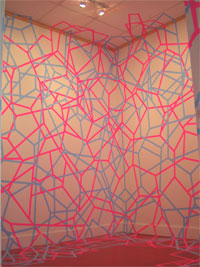 This week is your last chance to head down to Chinatown and see Wind Inside by Liz Harris at Motel. The gallery space proper is taken over by a pink and blue tape web, shifting the perception of the space. Accompanying the installation is a series of really nice works on paper where marks accumulate forming mass and structure. Hard fine lines of black pen intersect, jump and intertwine with gently ominous and organic spills of black iridescent ink. The black and white pieces play with optical perception where the close proximity of the multitudinous lines causes the drawings to “move” of their own accord. Originally hailing from Northern California, Harris is a recent PDX transplant that I am sure we will see much more of. Liz Harris, Wind Inside • Motel Through August 19, 2006 19 NW 5th Avenue, Suite C • Portland, Oregon 97209 Located on NW Couch Street, between 5th & 6th Avenues Posted by Jenene Nagy on August 15, 2006 at 15:11 | Comments (2) PermalinkSunday 08.13.06 O! Vey There is a Q
& A interview with me in The Oregonian today in reference to my new organization
Organism (we updated the site significantly in the last week). The interview also has some bits about PORT as well. Yes, this will probably raise a few eyebrows, which is good. There has been a lot of talk in Portland and there has been an avalanche of press... and although talk is very cheap, it does help frame the civic discussion. With that in mind
I'd love to hear what you have to say and if you want to continue the discussion privately I'd be happy to fill you in, you can email
me your questions here.
Posted by Jeff Jahn on August 13, 2006 at 13:07 PermalinkFriday 08.11.06 Drop in if you are in the neighborhood?  Bruce Conkle's latest show, conveniently located in nearby Iceland? If you just so happen to find yourself in Iceland this weekend Bruce Conkle will be gracing Reykjavik's Living Art Museum with his latest show, "Landscape and Assassination." It opens tomorrow. Bruce has been talking about JFK's assassination, whale blubber and alumninum smelting so prepare yourself. Also, I love that visit Iceland website which contains statements like, "Iceland is not only closer than you think..." Uh, no it isn't, it's actually really far from the US and that's part of the attraction... (more) Posted by Jeff Jahn on August 11, 2006 at 12:41 | Comments (4) PermalinkThursday 08.10.06 Weekly Web Roundup 
Though it may have seemed that the recent question about those selected for the 8th Northwest Biennial in the comments area was sloughed off, it got me to thinking. Often the question of gender comes up when a list like this comes out. In an effort to allow ourselves to judge the quality of the work rather than the quantity of men vs. women, I thought I’d try to gather some visual information...(more) Posted by Melia Donovan on August 10, 2006 at 22:08 | Comments (12) PermalinkPAM acquires video art from Biennial 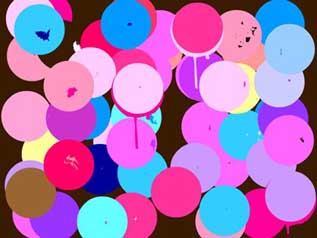 Still From Jo Jackson's History: the Complete Drawings Surprise, the Portland Art Museum will acquire video art from the Oregon Biennial. Last night in a very close vote, 65 members of the museum's Contemporary Art Council (disclosure I am one of the Co-VP's) gave the nod to Jo Jackson's, "History: the Complete Drawings." Its an excellent piece, chronicling the birth and death of various nation states. It's 45 minutes long and is flash based. Curators, Bruce Guenther and Jennifer Gately seemed very excited about the acquisition and the technical challenges of maintaining the work when the computer that runs it needs to be replaced in 5 years or so. The council was very interested in the # of video works in the collection and this decision certainly adds to its holdings significantly. Posted by Jeff Jahn on August 10, 2006 at 11:34 | Comments (1) PermalinkWednesday 08.09.06 A sense of scale  image and thermogram from current Mt. St. Helens eruption For those who might be taking the erupting volcano in Portland's backyard for granted, check this out (that's less than a month folks and the area is massive)... Richard Serra's got nothing on Mt. St. Helens, but who does? Posted by Jeff Jahn on August 09, 2006 at 1:03 | Comments (1) PermalinkTuesday 08.08.06 9/11's effect on art? Edward Winkleman has a great post on whether
or how 9/11 positively and negatively effected art today, here.
Posted by Jeff Jahn on August 08, 2006 at 10:50 | Comments (0) PermalinkMonday 08.07.06 Saturated Pasture 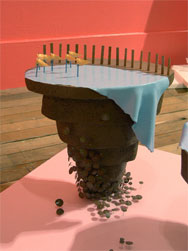
This is the final week to view Jenene Nagy’s Saturated Pasture at the Portland Building. Here she re-evaluates the constructed landscape and our relationship to it through the use of ordinary materials such as house paint, Styrofoam and painted nails in her installation in the second floor gallery. Saturated Pasture by Jenene Nagy • The Portland Building 1120 SW 5th Avenue • 7a - 6p • Monday - Friday Closes August 11 Posted by Melia Donovan on August 07, 2006 at 21:22 | Comments (0) Permalink8th Northwest Biennial at Tacoma Art Museum 
8th Northwest Biennial at Tacoma Art Museum The wait is over, the artists have been chosen. Out of 900 submissions (a 100% increase over previous biennial submissions), 41 artists were selected for the “visual impact of the images, the scope of each artist’s contributions, and the stage of the artist’s career.” ...(more) Posted by Melia Donovan on August 07, 2006 at 20:50 | Comments (6) PermalinkSunday 08.06.06 inClover Report 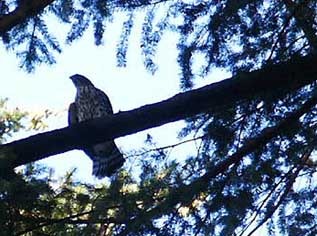 unidentified bird of prey in Mt Scott Park Saturday August 5th Ok it was a modified form of "art in a park" and on paper it sounded like a potentially terrible event, but it wasn't. Sure, some of the work was iffy but some was pretty good to excellent (Michael Keenan, Ellen George, Carolyn Zick, Harvest Henderson, Jacqueline Ehlis, Justin Oswald, TJ Norris+Abi Spring and a few others all had particularly strong works). Many had a lot of interesting references to Robert Smithson's work, utilizing a reflective/dislocating surface (Ehlis, TJ+Abi) and Harvest made a circle akin to the spiral jetty made of salad (with a name like "Harvest" it's unavoidable I guess). The fact that a couple of what I think were falcons (of the gyr variety? in Portland?) were hanging out in the park only made it... (more) Posted by Jeff Jahn on August 06, 2006 at 20:58 | Comments (3) PermalinkFriday 08.04.06 Weekly Web Roundup  The 2006 Oregon Biennial For this week’s Weekly Web Roundup the focus is on the 2006 Oregon Biennial. I haven’t been in to see it yet. Lame, I know, but I’m going on Saturday. So, with that, it seems to me that a collection of the reviews might be in order. Much like the discussion surrounding the artist statement, reading a review beforehand can have a similar effect. Will it taint the way one thinks about the work and the exhibition as a whole? Surely, they will call up issues that one might not have noticed going in cold. Posted by Melia Donovan on August 04, 2006 at 10:56 | Comments (4) PermalinkAvoiding tunnel vision Of course, all of the art writing out there this week isn't about the Oregon Biennial (but Port will have some very substantial stuff for you soon), instead you can
check out Brian Libby's piece on
John Brodie in the O today.
Also, because its important not to have Oregon tunnel vision the Guardian has a bit on one of my favorite artists Olafur Elliason. Posted by Jeff Jahn on August 04, 2006 at 10:02 | Comments (0) PermalinkWednesday 08.02.06 Rhoades Tragedy The art world is abuzz
with the sad news that Jason Rhoades has died. Some wrongly allege
this happened in Portland. Yes the new non profit I'm working on, Organism, was organizing a soiree with Rhoades
for August 12th in Portland. Organism has a short statement on their site
but the first place we saw anything "written" on it was art.blogging.la. Our thoughts and condolences are with his family and loved ones.
Update: The LA Times has a piece on Rhoades untimely death and points out a number of very important things (you will have to register). Rhoades was a West Coast artist with West Coast sensibilities. His all out assault on puritanical baggage is just one of his legacies, some of the others being his interest in religion, utopian ideas, putting a cosmopolitan sensibility over political correctness and generally making art that wasn't so easily comodified. Where others sought mostly to please, Rhoades would challenge by riding every fence imaginable. By all accounts he was very smart and an intense workaholic. He was really looking forward to the event in Portland and as the LAT mentions, some of the supplies (lube that approximates human bile, etc) that were to be used here will end up in a shrine in Joshua Tree. The curator for the event, Majorie Myers (a close personal friend of the artist) is grieving and as I mentioned before our thoughts are with his family and loved ones. Myself, I considered him the most gifted of the recent deluge of artists who utilize inexpensive materials, a leader. He was one of the three main artists who I believe defined that recent trend, Sarah Sze and Rachel Harrison being the other two and he burst on the scene much earlier. Definitely, he's an artist in the lineage of... (more) Posted by Jeff Jahn on August 02, 2006 at 10:20 | Comments (3) PermalinkTuesday 08.01.06 Feedback Loops We will have all sorts of interesting and useful news shortly. Including our
1st Thursday guide.
Till then lets read the Guardian who wonders why the British can't paint... which isn't true... journalists never try to to invent a crisis eh? Tyler Green reports on how Elisabeth Sussman is helping to make the upcoming Gordon Matta Clark retrospective a success. Would love for this or the Andrea Zittel show to come through the Portland Art Museum. In fact, putting Zittel in the context of Clark is interesting brain fodder. Also, just because its interesting Portland artist Scott Wayne Indiana reacts to the review of his piece in grey|area PORT published last week. Its true these publicly accessible feedback loops are an interesting part of the online revolution. There is a video piece in the Oregon biennial by Andrew Ellmacher & Mark Brandau that exploits a similar art discourse wank fest but there is something fresh about the call and response on the Internet and something so BFA thesis show about doing it as a video piece (granted Andrew and Mark were going for this, although maybe it simply accomplishes its aims all too easily in a Council of Trent, # of angels on the head of a pin way). Discourse is only its own reward only when it doesn't run on already well traveled rails. Complaining that there is nothing original left to do smacks of the fellow who wanted to close the US Patent Office over a hundred years ago because there was nothing new. Complaint art is often tedious but reacting to reviews always seems to bring out something honest or at least revealing. Posted by Jeff Jahn on August 01, 2006 at 14:40 | Comments (9) PermalinkSaturday 07.29.06 Weekly Web Round-up 
It’ll have to be a mini round up this week as I’m happily stuck in the studio and can’t tear myself away for long. I’m neglecting everything and everyone and though it feels selfish on some level – I have a family to care for and the laundry is piling up – I'm really not feeling that bad......(more) Posted by Melia Donovan on July 29, 2006 at 12:25 | Comments (0) PermalinkThursday 07.27.06 Organism launch event Yes, the Organism launch is tonight
at the Wonder Ballroom
(tickets are $20 for day of). Small Sails opens at 8:00, then Pipilotti Rist's,
"Im Not The Girl Who Misses Much" will be presented on two large backlit
screens. It's a major piece and the work that brought her international stardom.
Through the rock-n-roll sound system it should be quite the experience. Then evening
will culminate with an all experimental set by Courtney Taylor-Taylor and other members
of the Dandy Warhols. It will feature an intense 3 drummer rhythm section and some very cool
visuals. Big Thank You's go out to New
Deal Distillery, the Wonder Ballroom, KNRK
for the free publicity and especially Court, the rest of the musicians and those
who made it all happen. See you there, should be stunning. Look for a major update
to the website too...
Posted by Jeff Jahn on July 27, 2006 at 11:12 | Comments (0) PermalinkWednesday 07.26.06 Get a Job 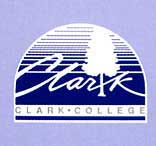 Great opportunity for the smart and savvy. And, it really isn't as far away as you think. Full-time Temporary Photography Instructor for 2006/07 year. Teaching responsibilities will include 18 contact hours of Digital Photography and Darkroom Photography. Other responsibilities will include overseeing darkroom and computer labs and supervising Lab Technician. (more...) Posted by Jenene Nagy on July 26, 2006 at 17:11 | Comments (0) PermalinkHe Still has it after all these years Tyler Green reports that Portland's own Allied
Works Architecture has been shortlisted for the new Clyfford Still museum in Denver.
Cloepfil and Co, will face some very steep competition from David Chipperfield (who makes austere...umm fun) and SANAA (who practices an elegant form of restraint) though.
Posted by Jeff Jahn on July 26, 2006 at 14:04 | Comments (0) PermalinkTuesday 07.25.06 Tramming it up In case you missed it when construction workers put up the tram tower, commissioner
Sam's blog has some nice pics.
Posted by Jeff Jahn on July 25, 2006 at 11:50 | Comments (0) PermalinkSunday 07.23.06 The other Washington posts on the Oregon Biennial It looks like the Oregon Biennial (which opens a week from now) will be getting
some national hype this year... considering the recent
travel article in the Washington Post. You will need to get a password etc...
(ughh). Nothing new here but Portland's own lil Chandra Bocci (who makes Phoebe Washburn
look sooo weak) gets some nice props and pics in it... that's fine, the news is out and Portland's oldish
news is now fresh for the rest of the country.
Posted by Jeff Jahn on July 23, 2006 at 17:26 | Comments (0) PermalinkThursday 07.20.06 Weekly Web Round-up  Trash When did trash become so cool? I ask you that question because as I write and edit this piece I am drinking wine out of a can – with a bendy straw. Posted by Melia Donovan on July 20, 2006 at 22:06 | Comments (6) PermalinkWe Will Link You We are waiting on confirmation for a number of cool news items regarding the Portland art scene but I wanted
to point out we have added 2 more blog items to our links page:
Matt McCormick's Action Items (part of the fabulous Urban Honking family)... this is what happens when a noted documentary filmmaker has jury duty. Rob Wilcox's Portland Or US Now... Rob used to be Bob, but now he's making the difficult transition to Rob-dom. Posted by Jeff Jahn on July 20, 2006 at 17:12 | Comments (2) PermalinkWednesday 07.19.06 Organism Emerges 
Details of (PORT's own) Jeff Jahn's latest curatorial concoction have begun to emerge. Organism's nascent aesthetic is one of hyperconnectivity and rampant lateral growth in which different genres and ideas freely intertwine, following the model of neurons forming new and unexpected synaptic connections. For instance, in it's launch event, it creates an interchange between Rock Stars like Courtney Taylor-Taylor of the Dandy Warhols, and video art by Pipilotti Rist. The launch is called Introducing Organism it is a fundraiser, kickoff and exhibit on July 27th at the Wonder Ballroom (tickets are available at ticketmaster the wonder ballroom and by sending an email to organism: Info@artorganism.org Music will be provided by The Dandy Warhols along with Small Sails opening. There will be 1 piece of video art by Pipilotti Rist as well as more info on organism at the event. Tickets are $15 advance $20 day of, $40 VIP lounge (upstairs and includes two free vodka drinks, thanks to Portland's own New Deal Vodka). Organism's website can be found at: www.artorganism.org more details.... Posted by Isaac Peterson on July 19, 2006 at 6:13 | Comments (0) PermalinkMonday 07.17.06 Portlanding about It's been a busy week in Portland with a lot of visual arts coverage:
There was D.K's long article on Henk Pander in The O. The Oregonian also had a Brian Libby review of Tim Dalbow and Michael Henzley's shows in the A&E. John Motley reviewed the Portrait Show in the Mercury. For me Storm Tharp was the obvious master of the genre but Nat Andreini's air guitar video was a nice turn as well. It's a good show, everyone should seek it out if you missed it. Richard Speer reviewed James' Boulton's latest in the WWEEK. Also, yes I'm getting ready to launch Organism (with the help of a very talented and committed team). Tickets have been available since Friday for the launch event + video art screening even. There are a lot of stories coming out on it this week so I will play fair, besides PORT isn't just some PR vehicle for Organism. Still, be sure PORT will fill you in some more in the coming days... it's worth the wait. Posted by Jeff Jahn on July 17, 2006 at 22:46 | Comments (3) PermalinkThursday 07.13.06 Cancel your plans! Art this weekend! 
Friday and Saturday boast two offerings of note in Portland for art-o-philes and those that love them. Posted by Melia Donovan on July 13, 2006 at 22:17 | Comments (0) PermalinkThe Metrop$20litan Museum The Met is increasing
its admissions price to $20, same as MoMA's dander raising fee. Carol
Vogel broke the story in the NYT's and Tyler Green has been all
over it, here and in
general. In Portland the high admission fee is a big discussion point as well.
Is this the long awaited that the massive super sizing museum building campaigns
that started in the late 90's have wrought? Yes, the Met has expanded but not
recently.
Posted by Jeff Jahn on July 13, 2006 at 12:16 | Comments (11) PermalinkMonday 07.10.06 Weekly Web Roundup  Time once again for the Weekly Web Roundup....(more) Posted by Melia Donovan on July 10, 2006 at 8:00 | Comments (0) PermalinkSunday 07.09.06 Matt McCormick in The New Tork Times One of our favorite Portlanders, Matt
McCormick got a nice
writeup in The New York Times Friday for his piece in the Uncertain States
of America Show (Portlanders have been getting a lot of coverage there lately
and we also know Roberta really likes Portland's civics). Sure, Matt's "Subconscious
Art Of Grafitti" removal is really old old news here (circa 2001). I wrote about it in
Modern Painters back in early 2004 and Art Forum noted it before that, but more about
Matt's work is always better, especially from Roberta Smith. The thing is his
work holds up over time and as Matt so succinctly put it, "Go Team Portland!"
Posted by Jeff Jahn on July 09, 2006 at 17:45 | Comments (0) PermalinkMonday 07.03.06 Holiday reading It's a busy holiday time but just in case you need a little more to read:
The latest Visual Codec is out and I penned a review (such archeic terms!) of Horia Boboia's recent show. Also, Matt Stadler published this bit on his favorite painting at PAM. (While we are at it, my fave is Ernst Ludwig Kirchner's Fir Trees) Posted by Jeff Jahn on July 03, 2006 at 17:04 | Comments (1) PermalinkFriday 06.30.06 Local Perspective 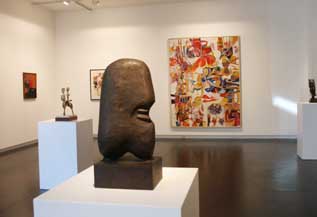
Clifford Gleeson (far left), Milton Wilson (large center painting), anonymous sculpture (foreground) Be certain to check out two significant historical shows that close this weekend. There's Hilda Morris's show of small sculpture and sumi ink drawings at Laura Russo Gallery and the excellent Milton Wilson and his peers at Pulliam Deffenbaugh to check out... (more) Posted by Jeff Jahn on June 30, 2006 at 12:25 | Comments (0) PermalinkFree day at Portland Art Museum 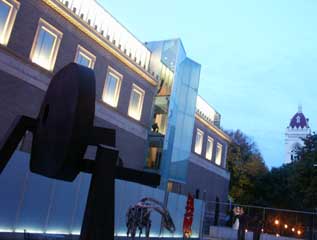 The Portland Art Museum is open free of charge today and yes you can take advantage of it even if your day job keeps you occupied during office hours, the Museum is open till 8:00 PM on Thursdays and Fridays. Besides the Hilda Morris and Great Painters in Bresca shows there are some things to really take note of at the Jubitz Center for Modern and Contemporary Art. First of all be certain to check out the Richard Rezac show that PORT reported on earlier. But the most exciting works are some of the pieces on loan. The show stopper is Mark Rothko's "Homage to Matisse" (lent by an anonymous donor) it's an essential work that needs to be included in any serious Rothko retrospective and the single most important artwork residing in the Pacific Northwest right now, yes it set an auction record for Rothko late last year. Other highlights are an early Untitled Donald Judd lent by the Miller Meigs collection. It's absolutely extra nice with its vermilion red color and placement near an Agnes Martin. Then there is the wonderful Hans Hofmann that really adds something to the Abstract Expressionist room. Posted by Jeff Jahn on June 30, 2006 at 0:00 | Comments (0) PermalinkWednesday 06.28.06 Think 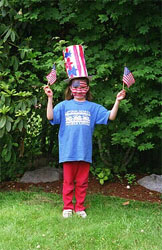 This Fourth of July, Sam Gould and the members of Red76 present you with an opportunity to experience an auditory glimpse into the war in Iraq. Entitled Bring the War Home, it is the closing project for a three-month residency the group held at the Yerba Buena Center for the Arts in San Francisco. Bring The War Home is a simple action set into motion to help remind Americans of the war in Iraq on the Fourth of July, and provoke discussion on the topic. Utilizing audio and video soldiers have recorded, Red76 has created a sound collage formatted into a downloadable MP3. Download this MP3 and play it outdoors as you feast on your hotdogs and down your PBRs. Remind yourself and your neighbors what those fireworks are all about. As an art group with sometimes changing members, Red76 seeks to create installations, performances and events that constantly point to the outside world, creating “an atmosphere wherein the public may become hyper aware of their surroundings and their day-to-day activities”. Established in 2000, Red76 have produced projects locally, nationally, and internationally. To learn more about Red76 and their latest project, click here. Posted by Jenene Nagy on June 28, 2006 at 21:28 | Comments (0) PermalinkWeekly Web Round-up  Courtesy of Michael John Muuss The heat of summer is clearly in Portland and so begins the slowing of the art season. That must be why I can’t seem to find much of interest for this week’s Weekly Web Round-up. I've got a couple of articles and a couple of activities for you to do while enjoying the lowered temperatures to come. Posted by Melia Donovan on June 28, 2006 at 9:56 | Comments (3) PermalinkThursday 06.22.06 Getting Tiki with it 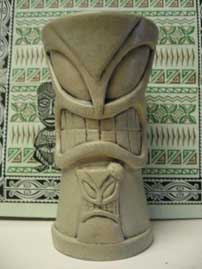 a cool Tiki mug Yes, PORT will have some pretty hefty content for you on Monday night (Matthew Day Jackson) but until then here is some weekend fodder to sacrifice to the volcano god: Portland's TIKI-KON starts on Friday, click here for details. If you love kitschy pseudo Polynesian culture and strong silly drinks this is for you. Apparently they will be taking a big tour of Portland's best private Tiki bars on Sunday. The main event though is Saturday which starts at the Jupiter Hotel, features a School of Rum bus and of a tour of Portland's public Tiki bars. There's even a sneak peek of the soon to open Thatch bar. Go and appease the volcano gods!...(more) Posted by Jeff Jahn on June 22, 2006 at 22:43 | Comments (0) PermalinkWeekly Web Round-up  Courtesy of Michael John Muuss Welcome to the first installment of the Weekly Web Roundup (name to change when I can think of a catchier title-any suggestions?). The plan is to post links to articles, shows and websites that are either related to Portland’s art scene, completely ridiculous or both. All I ask in return is for you to write me (melia@portlandart.net) whenever you’ve found something, written something-or had something written about you or others related to the arts in Portland that's linkable. If it's unrelated but funny, it'll probably make it to the list too....(more) Posted by Melia Donovan on June 22, 2006 at 8:00 | Comments (3) PermalinkWednesday 06.21.06 One Minute Film Fest @ Holocene  This Thursday night, the very trendy but actually quite cool Holocene is hosting the third annual One Minute Film Festival put on by Telegraph. As one of the younger art non-profits in town, Telegraph strives to link artists of different mediums together and to connect these artists with an audience. This year’s film fest features work by Ryan Jeffrey, whose evocative film was shown at PDX in May, Matt McCormick, and Jeremy Bird, among many others. The thread to all the films is that they are only 60 seconds long, so if you decide that one might not be your cup of tea, the pain will end quickly. One Minute Film Festival • Thursday June 22 • 9pm Holocene • 1001 SE Morrison $4-$10 sliding scale Posted by Jenene Nagy on June 21, 2006 at 22:18 | Comments (0) PermalinkSunday 06.18.06 Tram a-lamma ding dong *Update, The tram is now complete
 The beginnings of the aerial tram's middle tower as seen from the east The 20 story tall middle tower for the innovative and uber controversial aerial tram by AGPS architects is finally rising right next to I-5. Apart from being an impressive engineering feat it certainly does look good in its aluminum skin (yes some would rather have a log ride). Look, I like the project... it's the first bit of really innovative architecture to rise in Portland in decades and considering how many design jobs exist in this city it may be the first real outward symbol of the sea change taking place here (sophistication wise), besides the art scene. An armada of condos alone do not make for sophisticated citzenry and Portland is learning to not hide its strengths to the outside world anymore...(more) Posted by Jeff Jahn on June 18, 2006 at 23:23 | Comments (16) PermalinkSaturday 06.17.06 The Winner of PORT's 1st Annual Pretentious Art Writing Contest 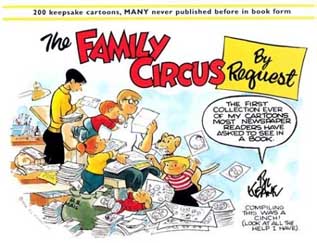 The oppressive humor archetype The pop-art (yet neo-minimalist) etchings of Ziggy and Family Circus, both liegemen to the Lichtensteinian legacy, question their own raison d'etre. Are they visual tropes? Are they self-conscious (self-mocking/self-loathing) po-mo nombrilisme? Or are they simply (and solely) stochastic snapshots sans lexical basis? The Family Circus series can best be examined as artistic interventions against the oppressive humor archetype, whereas the unappealingly desperate musings of Cathy Guisewite's eponymous series are truly indebted to Jenny Holzer’s oeuvre. Or, as Baudrillard and Guillaume so succinctly state, “What is produced with the romantic turn…is…the…play of…masculine hysteria…of …sexual paradigms that once again must be reinserted in the more general and universal context of a change in the paradigms of otherness.”[1] -------------------------------------------------------------------------------- [1] Jean Baudrillard and Marc Guillaume, Figures de l'alterite. Paris: Descartes et Cie., 1994. Submitted by Ethan Ham, who recieved a $50 Le Happy gift certificate for this fantastic abuse of thought and words. Thank you to everyone who submitted and to Le Happy, makers of the Le Trash Blanc crepe for their fantastic generosity and food. Posted by Jeff Jahn on June 17, 2006 at 22:07 | Comments (1) PermalinkWednesday 06.14.06 Turner Short List Announced  Tate has announced the four artists who have been short-listed for the often controversial Turner Prize 2006. The artists are Tomma Abts, Phil Collins, Mark Titchner and Rebecca Warren. The Prize, established in 1984, is awarded to a British artist under fifty for an outstanding exhibition or other presentation of their work in the twelve months preceding 9 May 2006. This year’s members of the jury include: (more) Posted by Jenene Nagy on June 14, 2006 at 10:01 | Comments (0) PermalinkTuesday 06.13.06 What works in Work/Live? Posted by Melia Donovan on June 13, 2006 at 14:28 | Comments (0) PermalinkFriday 06.09.06 Richard Rezac 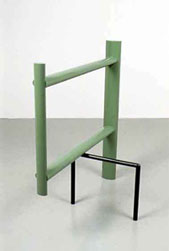
Saturday, the Portland Art Museum will play host to sculptor Richard Rezac’s work for a second time. The museum’s 1985 Oregon Artists Biennial debuted Mr. Rezac’s work 11 years after graduating from PNCA’s BFA program. Twenty-one years later, he is back with a selection of sculptures and drawings from 1998-2005...(more) Posted by Melia Donovan on June 09, 2006 at 8:00 | Comments (3) PermalinkTuesday 06.06.06 Affair In the Air 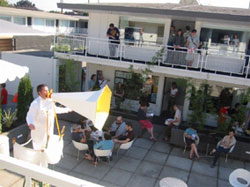 Well, folks, its confirmed. The 3rd Affair at the Jupiter Hotel art fair will be held on Sept 29-Oct.1, 2006. This influential event (the Aqua in Miami has since been modeled after the Affair) should prove to be even more extensive in representing a larger slice of the national scene. With less emphasis on Portland galleries than we have seen in the past, this year’s affair includes notables such as Modern Culture, Lemon Sky, and Saltworks. Co-Organizers Laurel Gitlen and Stuart Horodner surely know how to get the numbers out (over 3000 visitors last year) but what remains to be seen is how much of that traffic relates to actual sales. In any case, it’s a great event to sample galleries from out of town and to make some connections. This year’s special events include more... Posted by Jenene Nagy on June 06, 2006 at 8:26 | Comments (4) PermalinkMonday 06.05.06 Seeing the Oregonian for what it is Look we give them a
tough time occasionally but the Oregonian does provide a startling amount
of visual arts coverage like today's review of TJ
Norris' Grey|Area show. Yes, it is more descriptive than an
intellectual mediation on the specific details of sublimely liminal, less than
colorful work, but it does get the main points about the curator and the one
artist's work which just doesn't quite cut it. Most newspapers for a city of
2.1 million metro don't come close to this and if you want depth... there
is a reason PORT exists. There is a place for generalist publications and
a place for insider concerns.
Also, DK published his second best bit of writing to date with his expose on the Portland Art Center last week (his best was the retirement piece on PAM's beloved Donald Jenkins). He's tough on PAC but patient, pointing out their inconsistencies while slyly making important points about the inconsistencies of other art organizations as well. I do have concerns about whether programming by committee is a good idea though? Portland has to be tough on its arts organizations because nearly all are still either nascent or only just recently finding their strides. The city is under served but that is exciting (for the time bieng). The O even has Brian Libby of Portland Architecture freelancing. So why all the visual arts coverage? Because Portland's changes in identity and sophistication are some of the most rapid I've seen in any US city and the visual arts are the single best gauge of that shift. Posted by Jeff Jahn on June 05, 2006 at 0:00 | Comments (3) PermalinkThursday 06.01.06 Introducing Melia Donovan: I Don't Take Vacations - I Just Move To Interesting Places Though art making can be considered an interior and self-centered endeavor, I
have always enjoyed countering that aspect of production with activities that
enable a dialogue outside of the studio, in the larger community, to flourish.
For that reason, I am very excited to join PORT as the new Announcements and News
writer. I am a recent citizen of Oregon and if what I've read and experienced is true, the only native in the state is my friend Ramona in Hood
River. The massive influx of people from all over the world, really, necessitates
a forum for navigating, organizing and rallying the arts community. PORT has certainly
permitted me access to dialogue and information in a scant amount of time - I
moved into my house in January of this year. I can only hope to help do more of
the same.
Here's a little background about myself... Posted by Melia Donovan on June 01, 2006 at 0:05 | Comments (1) PermalinkIntroducing Jenene Nagy: Better Every Year I am addicted to art. I make it, I curate it, I teach it and now, I write about it. I feel honored to live in a city with such a rich and vital arts community where students, emerging artists, and international players all breathe the same air. My interest in working for PORT as a opportunities and announcements writer is two-fold, both reasons self-serving. I want to be connected, to be in the art world trenches. I want to be a vehicle that helps distribute information and share that information with as many people as I can reach. Secondly, I want to learn. Writing, criticism, community, movable type, I want to know more. I want to grow. I want to get better every year.
Posted by Jenene Nagy on June 01, 2006 at 0:00 | Comments (1) PermalinkPORT is 1.... and expanding Yes, today is PORT's first birthday and we are proud to announce two new additions
to our staff. From the outset PORT has been a successful experiment in evolving
the blog format into a serious visual art forum, one that could provide the
expertise that the subject deserves but is quite rare in more generalist publications. Big thanks go out to our sponsors who have made PORT possible.
It's true, when first conceiving of PORT we didn't realize we were creating a daily publication, but that is what it has become. The need for daily coverage is partially due to the ever expanding art scene activity in Portland as well as the increased interest from elsewhere in our local affairs. So yes, PORT is a local publication with an international reach. In fact, PORT's readership has constantly increased with a rise of over 17% in individual readers last month alone. With this explosion in Portland art scene activity and an ever expanding readership it became necessary to expand our writing staff (instead of creating our own brand of gin) and we are pleased to announce that Melia Donovan (news and announcements) and Jenene Nagy (artist opportunities and announcements) are joining us. We were fortunate to have such a highly qualified and competitive pool of applicants to choose from but Melia and Jenene both stood out. Stay tuned for details on our our 1 year birthday party in the next 2 weeks. They will both be introducing themselves here shortly, -The Management Jeff & Jenn Posted by Jeff Jahn on June 01, 2006 at 0:00 | Comments (0) PermalinkTuesday 05.30.06 Fletcher in the city Local boy, Harrell Fletcher received a nice review from Jerry Saltz for his recent
show at White Columns, read it on Artnet
here. I think Harrell started down this path with his scar
project. I'm also glad that Thomas
Hirschhorn is wearing thin with other critics like Saltz as well.... for the
longest time he seemed like the only artist critical of current events and I dug
it, now he's becoming a parody. That's the danger of political art and I still
miss Leon
Golub, nobody did it better.
Posted by Jeff Jahn on May 30, 2006 at 22:38 | Comments (4) PermalinkSaturday 05.27.06 Last Weekend for you to PMU Just a reminder Sunday May 28th is the last day to see Roxy Paine's excellent PMU exhibition at the Portland Art Museum.
Posted by Jeff Jahn on May 27, 2006 at 12:06 | Comments (0) PermalinkSunday 05.21.06 Thinking about the next I-5 bridge 
The soon to open Ravenel Bridge in Charleston South Carolina Well, even though I'm ensconced in a foofy hotel somewhere in the Midwest I'm still thinking about my home in Portland Oregon. What do I think about most? Well it isn't the aerial tram or even the art scene, it's the eventual design for the new I-5 bridge across the mighty Columbia River. For me bridges are the most interesting of architectural projects and although the finished bridge is 10 years away I suspect it will be a cable stayed design like Sir Norman Foster's Millau Viaduct. Why? because it will allow for great views, completely unlike the current truss bridge. The latest cable stayed bridge design to catch my eye is the Ravenel Bridge in Charleston South Carolina. It's fine but I'm unimpressed with how anonymous the cable stayed designs like; the Ravenel, Millau or the Sunshine Skyway bridge in Tampa Florida tend to be. Frankly, I love the fact that Portland's excellent Fremont Bridge design (and PORT's logo inspiration) came from the massive public outcry that the less than stellar Marquam Bridge design produced, let's demand something innovative and distinctive again. Still, our project will be much more demanding as rail will need to be incorporated as well? ...2 decks with a bottom one for rail freight? Posted by Jeff Jahn on May 21, 2006 at 22:59 | Comments (1) PermalinkFriday 05.19.06 The next wave Ok, now everyone is moving to Portland and this new wave seems to have some art business savvy, it isn't just artists anymore. Lately, there has been a mass exodus from Brooklyn too (this is more than the already steady stream we have experienced for the last 6 years).
Posted by Jeff Jahn on May 19, 2006 at 8:49 | Comments (0) PermalinkTuesday 05.09.06 some things PORT will have lots of pictures and critical content coming at you shortly but
until then, here are some things to sink your teeth into on the rest of the web:
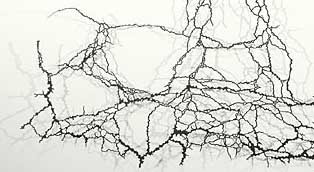 Detail of a Matthew Picton Matthew Picton (who is in the upcoming 2006 Oregon Biennial) received a good review for his show at Howard House from the Seattle Weekly. Even Jim Demetre likes him better than Maya Lin, which isn't quite fair to Lin. Being the most sucessful public landscape artist on the planet (aka Lin) requires that there be less emphasis on detailed visual fascination and conceptual rigor than Picton's work does (as an indoor gallery artist). Public art succeeds when its visual clarity allows the context of history and landscape to assert itself over the visual or even conceptual content. Another note, I pointed a serious Portland collector to Picton's Seattle gallery because he has lacked representation in Portland since September, hint... Also why do most of the more nationally known/experienced artists living in Oregon not have Portland galleries? Along similar lines to both Picton and Lin there is this story in the NYT's. In it Josiah McElheny tries to meld modernist design and the early moments of the universe into a single object. By combining two parallel universes into one space the worlds of aesthetic history and astrophysics take on an uneasy visual vibration. This synchretic melding of science and aesthetics is a big part of the trope that McElheny, Iñigo Manglano-Ovalle and Picton are pursuing. No this genre isn't touchy feelly, its clinical but it is a major emerging trend in the 21st century, artists reclaiming science as an aesthetic yet systematic force. Last but not least, noted Portland filmmaker Matt McCormick now has a great looking blog and he's into ghost towns (I love them too). Oregon has a large # of ghost towns. Posted by Jeff Jahn on May 09, 2006 at 21:29 | Comments (8) PermalinkSunday 05.07.06 The "School of Nan" Curtis era comes to an end at PNCA 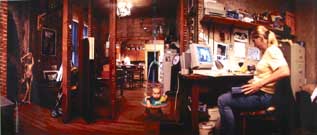
For months, those in the know have suspected that Nan Curtis might be altering her relationship with PNCA as director and curator of the Feldman Gallery as well as the chair of the sculpture department. Now it's official and it has been announced to faculty and students that she will be stepping down in those roles to pursue her own art. Savvy, sharp and capable of willing important exhibitions into reality, she will be greatly missed. Nan has been THE life force of PNCA's exhibitions program culminating with her Troca Brasil show last fall, it featured Ernesto Neto and Laura Lima's tarted up chickens. Other highlights of her curatorial tenure have been Charles Goldman and Heidi Cody's pop alphabets. Who might replace her? One obvious choice is PNCA alumnus and sometimes curatorial collaborator Cris Moss. Maybe PNCA will search for outside talent? Back to Curtis, her effects on students have been equally important and I once referred to it as the School of Nan. Please feel free to leave comments here. Let's wish her success on her new focus as well as remind her of all the positive impact she has had on the Portland's contemporary art community. Nan Curtis has been and will continue to be one its foremost pioneers. *Update, we broke the story yesterday but the O chimes in today... with the additional (much whispered about) and very important announcement that PNCA will inaugurate a MFA program in 2007. Finally, this city with over 10,000+ artists will have 2 MFA programs (Portland State has the other). Portland is growing up and Nan has laid a great deal of the groundwork, take a bow. Posted by Jeff Jahn on May 07, 2006 at 18:21 | Comments (5) PermalinkWednesday 05.03.06 Another Arts Building? In the Pearl? Tonight is the first of two public meetings about the fate of the Centennial
Mills building on the edge of the Pearl. Patricia Gardner is pushing to rehabilitate
this aging edifice into a giant arts building. Come by the forum tonight to
learn more and give feedback.
Centennial Mills Framework Plan Public Meeting Wednesday, May 3rd • 6:30 to 9:30p PDC Conference Room • 222 NW 5th Ave Posted by Jennifer Armbrust on May 03, 2006 at 9:35 | Comments (0) PermalinkTuesday 05.02.06 There is more stuff... always more stuff Art of Geography has produced a pretty
darn good map of the Pearl District, an invaluable online tool for those
who want to know where to look at art and dine out in the Pearl District. That's
pretty much Portland in a nutshell: lots of galleries and even more fine dining
for the hoard of food-ees here. Maybe throw in a few thousand coffee shops, tons of small fashion boutiques
and some great book stores... then you've got Portland.
Also, the latest Visual Codec is out. Then there is this article on group critiques that MAN pointed out. All young Portland artists should read it. Last but not least, TJ Norris takes on the the dark art of curating and his upcoming curatorial effort this June at Guestroom Gallery looks real good too. I remember being irked years ago when Randy Gragg told me I was the only independent seriously interested in curation in town. Both annoyed and flattered my counter was instantly, "but what about TJ." There were others too like, Matt Fleck, Muriel Bartol and Michael Oman-Reagan, Jacqueline Ehlis... even the ever mysterious Todd Johnson. Now there is a whole new crop of youngsters like Jenene Nagy, Josh Arseneau, Jesse Hayward and Mark Brandau... not to mention all the new gallerists who necessarily must take on that role. Posted by Jeff Jahn on May 02, 2006 at 19:03 | Comments (1) PermalinkSunday 04.30.06 Around the Web: PAM Directorship, Hilda Morris and Judd Auction 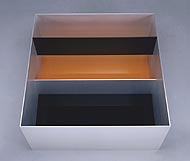 Donald Judd (1928-1994) Untitled, 1989 from Christies upcoming auction Things have been busy in Portland and we've been behind on pointing to other publication's good efforts, here are a couple of important things to check out if you havn't already: Although we give him hell about some arty but intellectually relevant concerns that his editors might not allow him to address, D.K. Row had a little bit on the progress the Portland Art Museum is making on a new director in the Oregonian's A&E. Nothing conclusive here but he reports PAM seems to be getting closer with the potential for an announcement in July. I'd urge caution on anything that early as museum directors are in very short supply and anyone shortlisted will probably be on other museum's radar's too. The advantage we have though is PAM has its building campaign done and a bigger endowment than the Guggenheim. Factor in that the museum is in a rapidly changing and truly unique city as well and it looks pretty good. Also, Portland very attractive these days as a whole new boatload of former New Yorkers (young and old) seemed to have just moved here in the last 6 months. It's an art city in the works. Still, Portland requires certain traits to get anything done. For starters the job requires the right combination of relentless energy, stronger art savvy than we have been accustomed to in that position recently... as well as an understanding that Portland is in a magic moment of emerging cultural sophistication whose expression is ultimately highly influenced by its cultural leaders. The city deserves the right leader for its premier cultural organization. The museum's next director actually will help shape Portland's identity, for better or worse. I will add that the search committees did listen to a lot of voices before they even decided which headhunters to use, which bodes well as long as they see a need for more balance in the museum's programming. This means major contemporary retrospectives like Rauschenberg, Tuttle or even Andrea Zittel need to come here. Donald Judd would be a dream come true in a city with so many design firms. Hopefully, the eventual appointment of a cultural leader (maybe without glaring weaknesses this time) will have a ripple effect on other organization? In the same article D.K. also reports a smidge on PICA's visual arts segment of TBA, including their announcement of artist Matthew Day Jackson. He's a super nice guy from the Pacific Northwest whom I met at Greater New York in 2005 (I have more reservations about his work though... is he just milking the Brooklyn fetish of the woods, puns and barbarians?). He was also part of the latest and altogether stillborn Whitney Biennial. Still, on his home turf I suspect he will go beyond just incorporating trees and Viking motifs, this isn't New York and using such materials in the Pacific Northwest asks that the ante be upped, he knows the trees are bigger here and we see em all the time.  Hilda Morris, Sea Drum, 1962-64. Cement and pigment over metal. Private collection. Also D.K. Row's editor, Barry Johnson, reported on the Hilda Morris retrospective in today's Oregonian. It's a lively, Jed Perl-esque jaunt about Hilda Morris and adds all sorts of human interest tidbits that one often finds in newspapers. One important note though, Morris was an abstract expressionist sculptor, and there are very few of them that were of any note. Hilda Morris might not be David Smith but she's better than most of the others and instead of constantly pairing her with her husband (who's a fine artist but not of Hilda's caliber... the words whispered by most everyone at the opening) let's make certain we get to see her alongside Clyfford Still and Rothko like we do at PAM's Jubitz center in more national shows. Her work can be found all over the East Coast too (her career wasn't just Portland and Seattle). Also, in case you've been under a rock you know there is a Donald Judd retro-er-um-auction-exihibition going on in New York till May 9th and The New York Times and the VVoice are catching up to Tyler Green's reporting here; 1, 2, 3 , 4. Look, Donald Judd is the most important artist to emerge after Warhol because in many ways he proved that overwhelming integrity and massive ambition could still yield results in a mitigated age of co-opted options and sampled meta culture (which is great too but it isn't everything). We need that kind of kutzpah today and no Matthew Barney does not even come close. Conveniently, Sarah Meigs (whose collection continues to impress me, not just for "the names" but in terms of quality) has a really great red Judd box (1962) on loan at PAM next to her Agnes Martin... it's much better than the Carl Andre in this context and to be fair it out classes everything nearby in the room, including the Martin. Note some galleries in the Jubitz Center at PAM will be closed May 1-5th for repairs due to all the traffic. The center reopens May 6th but the 1st floor will remain closed through the 19th (the elevator will allow access to floors 2-4 which includes Roxy Paine's PMU and the killer Judd on display.) Oh yeah and Ultra asked somebody some questions. Posted by Jeff Jahn on April 30, 2006 at 21:37 | Comments (4) PermalinkSunday 04.23.06 Kate Fowle Lecture at PSU 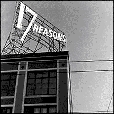
Kate Fowle, current chair and one of the founders of CCA's four year old Curatorial Practice program, will be the next PSU Monday night lecture series guest. Fowle has worked as an independent curator on shows including 17 Reasons, co-curated by Jack Hanley in his San Francisco gallery in 2003. Trained in the UK, Fowle continues working between San Francisco and England through her London-based curatorial partnership, smith + fowle, co-founded in 1998 with Deborah Smith. Their collaborative projects include the recently published book To Be Continued>Contemporary Art Practice in Public Places and Shelf Life, an exhibition of thirteen artists at Gasworks in London (among the list was Will Rogan, who recently had a solo show at Small A Projects). Monday, April 24 • 7 p PSU 5th Avenue Cinema • 510 SW Hall St. Room 92 (on the corner of 5th & Hall) Sponsored in part by PICA, PNCA, and Reed College Posted by Katherine Bovee on April 23, 2006 at 9:44 | Comments (0) PermalinkTuesday 04.18.06 To Dada or not to Dada, that is not the question? Everyone should read Tyler Green's absolutely spot on post on Dada
from yesterday. I'm glad somebody else gets pissed off that anything nonsensical
is automatically justified as a descedent of Dada, despite the fact that it was
a reaction to W.W.I. Plus this aspect of Dada has plenty
of resonance today, we've still got wars and some artists and collectives are rebelling
against bourgeois agendas.
The historical facts are it was an artistic reaction to perceived "bourgeois agendas" that many saw as the enablers of that incredibly bloody war. People actually thought it was going to be glorious (we've never heard that before eh?). Artist weren't immune to it either and great artists like Franz Marc and August Macke both died early on in the war. No, Dada wasn't an excuse to party and it was subversive precisely because artists found the social contract between the individual and their so called civilization could no longer be trusted as mechanized warfare essentially became a factory of human attrition and misery. Ever wonder why there is so much machinery in Dada? There's your answer, modern warfare (not that the non modern kind was better). If you really want to get a little more familiarity with that war and its effect on artists psyches' get yourself a copy of The Lost Voices of World War I: An International Anthology of Writers, Poets and Playwrights by Tim Cross. *Update here are five Portland artists and collectives who have some legitimate ties to Dada:  David Eckard & Podium at the Affair @ the Jupiter Hotel Art Fair 2004 David Eckard, whose kinky mechanical contraptions just keep getting... (read more)... Posted by Jeff Jahn on April 18, 2006 at 0:49 | Comments (5) PermalinkThursday 04.13.06 Guggen-time 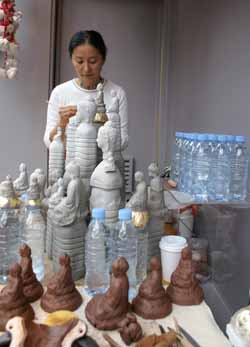 Yoko Inoue at Contemporary Crafts this last March Three of the recently announced Guggenheim fellowships have Portland ties. Of course the fantastic Roxy Paine has his PMU exhibit/production facility on view at PAM right now. Then there is Yoko Inoue, who recently completed an 11 day installation residency in Contemporary Crafts' largish window in March. Lastly, Lynne Tillman penned an essay for Core Sample way back in 2003. I was lucky enough to have dinner with both Inoue and Paine within 2 weeks time... two really nice, deserving people whose similar work ethic has paid off repeatedly. Congratulations! Posted by Jeff Jahn on April 13, 2006 at 0:05 | Comments (0) PermalinkTuesday 04.11.06 Around the web but mostly in the backyard There has been a lot of good local art coverage recently, and a dud that
requires a slight rejoinder.
In the Mercury John Motley penned a nice review of the excellent: From Anxiety to Ecstasy: Themes in German Expressionist Prints show at PAM. This is probably the single strongest show Ive ever seen at the museum (runner ups are the Diane Arbus show last year or the Let's Entertain spectacle back in 2000). Also, the Oregonian's DK Row interviewed Gregory Crewdson about his show at Reed's Cooley Gallery which opens tonight. Crewdson is kinda like Hans Hoffmann, more influential for his effects upon students like Justine Kurland who have surpassed him by being less contrived (Hollywood does that better). Ok so it wasn't all good, yesterday's Fresh review in the O by DK "Death" Row had all sorts of intellectual holes. True, I agree with David that the show is underwhelming but it shouldn't be critiqued for lack of craft or youth vapidity (vapidity knows no age), much less the ability to draw the human figure. This is especially true since Fresh isn't a show of figurative draughtsmen, it's like critiquing his review for being a poorly executed tax return! 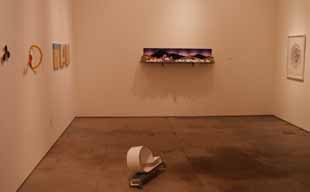 Bocci on the back wall of Fresh Also, his charge that Chandra Bocci is just "saccharine" misses the point to make an argument unsupported by a simple read of the work. Sparkle Fallout far from being untitled (as Row reports) seems to point to the cost of electricity (the whole fallout with PGE and Enron anyone?) and how it fuels our consumer culture of desire and disposable consequences. Instead of an anime knockoff, this is multifaceted social critique that can be criticized for other reasons. True Sparkle Fallout isn't her best work to date but had he bothered to note the title it would have been nice. I felt her piece in my Fresh Trouble show was more visually arresting and a forest fire of celebrity hair was a more than witty bonfire of the vanities in a time of hyper celebrity saturation. The works by Sean Healy and Brad Tucker are the strongest on view here. In the coming days expect PORT to publish a review that may or may not be as forgiving of this not exactly stellar show, but trust dear readers any dismissals will be relevant. Also, pay attention to the Oregonian's letters to the editor, a local arts writer (not affiliated with PORT) has made a pithy response. Will they dare publish it? For some non-Portland related art news check out this interesting Artnet article on Presentation Paintings. Portland's own Jacqueline Ehlis and other Dave Hickey alumni like Yek or Europe's Katherina Grosse all could have made this survey much stronger. To flesh out the theme, others like Karin Davie, Jennifer Steinkamp (to add video), Ingrid Calame, Francis Celentano, Jaq Chartier and James Boulton all relevant too. Other relevant Portland notables here are Michael Knutson, Tom Cramer, Eva Lake and Brendan Clenaghen. Posted by Jeff Jahn on April 11, 2006 at 0:35 | Comments (3) PermalinkThursday 04.06.06 Mayor Potter's First Thursday Symposium Below I've listed the announcement for Mayor Potter's community symposium on the future and importance of the arts community in Portland. This event frames an important dialogue, however, there is one glaringly obvious criticism. From 5-7 pm on the first real spring first thursday, none of the essential participants in the visual arts community will miss prime gallery hours for a bureaucratic brainstorming session. This sounds like an invitation to an important dialogue, but not much consideration was given to the visual arts community in planning the event. Note there is a comment section and survey on the web-site.
VisionPDX, Mayor Potter's new community vision project, will host an open house at City Hall, 1221 SW 4th, on April 6th from 5:00-7:00 p.m. The goal of VisionPDX is to create a vision for Portland for the next 30 years and beyond, and provides an opportunity for people from all over Portland to share their hopes and ideas for the future. Please come and lend YOUR vision for a strong arts community in the City of Portland. This special event will feature performances by BroadArts Theater and WellArts Theatre, and refreshments will be provided. Arts advocates can also sign up to host a visioning meeting with their friends and neighbors. The more VisionPDX hears about the arts, the more likelihood that the arts will be included in our city's vision! More information on VisionPDX can be found at: www.portlandonline.com/mayor/vision or call 503.823.5415, or email plvision@ci.portland.or.us. Posted by Isaac Peterson on April 06, 2006 at 1:08 | Comments (1) PermalinkWednesday 04.05.06 Live to Work? ... artists Work to Live The Willamette Week published a completely interesting article by Zach Dundas
today on a
potential solution to the critical creative live/work space issue in Portland
here. It's an important follow-up to his early
reporting on the issue here.
A synopsis, developer Brad Malsin of BEAM and Works Partnership Architecture have come up with a plan to build spartan, concrete box rental live/work lofts that would go for around $500 a month in the Central Eastside Arts District. This would be a huge boon since Portland is swarming with literally thousands upon thousands of artists, crafters and entrepreneurs who are currently using their ill equipped living spaces as studios illegally. This would be so much better, although owning a place is ultimately the way you want to go (some of the 30+ crowd have bought places in the NE as well as on North Mississippi and North Interstate recently). The secret apparently is WPA's plan for communal bathrooms and IKEA kitchenettes. Its true, most artists care less about doors and finished rooms than raw, impressionable space. I found it particularly interesting when one of the architects, Carrie Shilling stated, "Your making it less enticing in a way....That can be tough for some developers to think about because you're willfully restricting your profit if you build one." So what about the developer? Brad Malsin was the underdog developer who wasn't completely awarded the very important Burnside bridgehead redevelopment even though he had the best and most popular plan by far. I've also worked with him, he made my The Best Coast warehouse show possible by providing the space. He understood the collateral/catalytic effects that having 31 artists and a few thousand art lovers might have on his property, and to use his words at the time, "just trying to do the right thing for the community by doing something cool." Later, clarklewis... the best restaurant north of San Francisco opened up downstairs with a similar urban, spartan chic. I'm pretty sure Brad understands, he's from New York and saw how pure greed lead to less than ideal communities. I'll repeat my mantra, more growth is coming to Portland and instead of ignoring it, the city should encourage the kind of initiative and intelligent sensitivity this kind of project displays. Change will continue and it's best for everyone here that it be directed intelligently. Posted by Jeff Jahn on April 05, 2006 at 18:57 | Comments (0) PermalinkMonday 04.03.06 Around the web... now with Voltron references  Voltron There are a few things to take note out there right now and I think the Berlin Biennial, having been curated by artists and not curators curating artists to curate artists was a great plan. Check out Adrian Searle's review in the Guardian here. Artists usually don't think linearly, and the good ones don't make too many decisions out of fear. Many professional curators do when faced with a survey show and that's why I think this Berlin Biennial is making the right sort of waves. Kara Walker did a similar thing at the Metropolitan, read Roberta Smith's take in the NYT's. Trying to please too many masters or making too many second guesses makes for dull, intellectually stewed shows (i.e. mushy with no hard edges). Also, the latest Visual Codec (the online monthly visual arts magazine designed to enhance communication between Vancouver, Seattle and Portland's scenes) is out now. People from outside the region might not realize that the British Columbia, Washington and Oregon corridor is a kind of burgeoning I-5 international art zone and lately everyone has gotten a lot more connected. Some call the region Cascadia (Transylvainia was already taken) and the three territories have a lot in common but different. Vancouver is in many ways the most "inward" psychologically but not as an international gateway to Asia. Seattle creates some very organized work but is easilly the most sarcastic city in North America (billioniares and Kelsey Grammer's connection have that effect). Portland is "much more floral color wise with this profusive energy" (according to the late Linda Farris). I took that to mean less inward and somewhat more iconoclastic...probably due to the fact that the city is reawakening to its ambitions with a vengeance. It's all good and I suspect we may try to combine all three cities into one giant Voltron like robot sometime in the future. I penned this article on PDA for the latest issue. April also marks my last month of doing the Critical i articles for NWdrizzle magazine. Lets just say "i" have a lot of gigs both online and off-line that require my attention, change is inevitable. My complete archives for the last 5 years can be found here. Also, April 1 was my 7 year anniversary of living in Portland, it just keeps getting more interesting and its gratifying to know that all this is actually having some kind of effect. There has been a proliferation of voices lately and it's especially nice that some of them are so thoughtful. Posted by Jeff Jahn on April 03, 2006 at 0:42 | Comments (0) PermalinkFriday 03.31.06 Free Day at Portland Art Museum 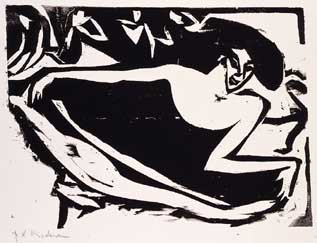 Ernst Ludwig Kirchner's Dancers (1909) woodcut (c) by Ingeborg & Dr. Wolfgang Henze-Ketterer, Wichtrach/Bern. Not only has the Portland Art Museum snuck in a minor redesign of their website's front page (the old one was just terrible and so so creme brulee) they are open free of charge today , thanks to the generous support of the Lamb Baldwin Foundation and the Maybelle Clark Macdonald Fund. Hours 10 AM - 8:00 PM I particularly like roaming the museum at night and you run into a lot of interesting people during those hours. For me nothing is better than taking in a good Anne Truitt, a Dan Flavin and the only Schnabel I have ever liked before a movie at the NW film center or Fox Theater (disclosure I am a board member of the Museum's Contemporary Art Council). Definitely check out shows like Roxy Paine's PMU. It's a brilliant work from a few years ago that complicates notions of artistic production, authorship and notions of control vs. serendipity. Basically the artist built a machine which makes paintings according to the algorithms he programed into it. It's a very theatrical even funny process when running (like those plastic animal mold machines at zoos) and very stark and minimalist when it isn't. Also check out what I consider to be the single best show I've ever seen at the Museum, From Anxiety to Ecstasy: Themes in German Expressionist Prints at the Gilkey Center. Now prints are often considered second tier to paintings for a reason but German expressionist prints are in a class all their own. The German Expressionists often used medieval woodblock printing and stark imagery to address the existential condition before anyone had even named it existentialism yet. Using the medieval to address the industrialized world has never been so successful done. It's still very edgy by today's standards and their social commentary really holds up with a beguiling mix of ugliness, exoticism, death and frustration. Just check out the names; George Grosz, Edvard Munch, Otto Meuller, Franz Marc, Max Pechstein, Erich Heckel and the best of the bunch, Ernst Ludwig Kirchner. Note, if you are a serious graphic designer you really shouldn't miss this. This show was culled mostly from the permanent collection and PAM has unexpected strength here due to the late Gordon Gilkey's role in recovering stolen art in post WWII Germany. Posted by Jeff Jahn on March 31, 2006 at 0:00 | Comments (0) PermalinkWednesday 03.29.06 Building to something I came across this article of interest on Arts Journal, a
developer is precollecting art for condo buyers in Toronto. In most ways
it sounds horrible, especially if the developer doesn't have much of an eye
but there is something interesting about it supporting the local art ecosystem.
Also, Brian Libby at Portland Architecture chimes in on Randy Gragg's take on the tram in the O. I've written on this before and how 15 million was a very unrealistic figure, but Gragg's point about the city of Portland's credibility being on the line with this public/private partnership is right on. Portland's biggest problem has always been one of follow through and the tram is highlighting the political grandstanding on all sides. It will get done but a reality check like Gragg's needed to be made. All interesting architecture creates debate and its looking like the tram fits the profile. It is kinda refreshing! Last but not least the NTY's recently ran a story on local luminary, Brad Cloepfil's museum at One Columbus Circle in NYNY. There are some nice photos too, but there are more on Allied Works site. Posted by Jeff Jahn on March 29, 2006 at 1:00 | Comments (2) PermalinkWednesday 03.22.06 Around the web It's been a busy week in local art news with the Biennial announcement, and both
the Oregonian
and WWEEK
have chimed in ... even Artnet took notice. Expectations are high and there is a lot of pressure on
Gately (welcome to Portland). Hmmmm might she have more room to work with than
just the Collins gallery too, hmmmmm? (that will help with 34 artists) Also,
it is nice that the WWEEK has decided to start regularly publishing art content
again. It's bad for everyone in Portland when the WWEEK cedes the main cultural
discussion in town to the O and it is good they are back in the game.
Elsewhere, it has seemed like blogs vs dead tree crit fest with Jerry Saltz blasting the New Yorker on MAN and Art.Blogging.LA educating Art on Paper about the nature of blogs. Also, chiming in on the Saltzflattening of the New Yorker, Todd Gibson makes a very nuanced case. This is all in addition to the PORT/ArtForum debate here on Red 76. Even more elsewhere and much longer ago, scientists have reconstructed a much brighter hued picture of the Parthenon. Also, since we are getting all oldschool here you should check out Edward Winkleman's Michelangelo quiz, I'm guessing #4 is is the real deal. Last but not least the Oregonian has a story on the proposed I-5 bridge. This is hugely important (not just because I love bridges) because the Portland-Vancouver metro area is experiencing booming population growth and the bridge is a major pragmatic and aesthetic statement about the negotiated directions that growth will take. Posted by Jeff Jahn on March 22, 2006 at 22:36 | Comments (0) PermalinkTuesday 03.21.06 Ultra Sam Sam
Adams, Portland's feel good City Commissioner, appears today on Ultra giving
them the Q & A. After talking about chickens and sharing his photos, he
makes an elusive reference to a forthcoming arthappy.org.
Hmm.... this guy's always got a trick or two up his sleeve. I guess I'll just
have to wait and see what it is this time. My art happy organization involves
more funding for artist grants, way more art in Portland's public schools and
a new contemporary arts space housing exhibitions and artist exchanges. I hope
Sam's is thinking this direction, too.
Posted by Jennifer Armbrust on March 21, 2006 at 17:49 | Comments (0) PermalinkSaturday 03.18.06 PAM Announces Artists for 2006 Biennial The hotly discussed and highly anticipated results are in. However, the Biennial exhibition opens in late July so you'll have to wait to see the goods. Congratulations to the selected artists!
The List... Brad Adkins (Portland) Marcy Adzich (Eugene) Holly Andres (Portland) Pat Boas (Beaverton) Chandra Bocci (Portland) Michael Brophy (Portland) Benjamin Buswell (Portland) Grace Carter and Holly Andres (Portland) Matt Clark (Portland) David Eckard (Portland) Andrew Ellmaker and Mark Brandau (Portland) Ty Ennis (Portland) Anna Fidler (Portland) Emily Ginsburg (Portland) Heidi Preuss Grew (Salem) Jesse Hayward (Portland) Mark Hooper (Portland) Jo Jackson (Portland) Kristan Kennedy (Portland) Zack Kircher (Portland) K.C. Madsen (Portland) Federico Nessi (Portland) Lucinda Parker (Portland) Matthew Picton (Ashland) Brittany Powell (Portland) Shawn Records (Portland) Vanessa Renwick (Portland) David Rosenak (Portland) Storm Tharp (Portland) Mariana Tres (Portland) Laura Vandenburgh (Springfield) Bill Will (Portland) Amanda Wojick (Eugene) According to the exhibition curator, Jennifer Gately, "This year's Biennial is dynamically different from past exhibitions with its range of mediums and intentions. It includes artists that represent a strong respect for history, and hints at shades of the future. As with any biennial, it presents an opportunity to explore, debate, and reflect upon the current state of visual art in Oregon." Let the discussions begin... Posted by Jennifer Armbrust on March 18, 2006 at 12:16 | Comments (1) PermalinkWednesday 03.15.06 Chairman of the bored Office chairs have such a mystique, are absolutely loaded with ennui and now Portland's Daniel Peterson brings us this gem.
Posted by Jeff Jahn on March 15, 2006 at 0:32 | Comments (1) PermalinkTuesday 03.14.06 Building and Questioning at Ground Zero The New York Times has a piece on the World Trade Center site today. Let's just say the current design for the Freedom Tower is a massive failure in imagination and hopefully never gets built. If we as a nation want a symbolic tower, then let's make a symbolic tower not an office building. It's a false start and design by comittee is useless for such an important site.
But this piece in the New Yorker by Paul Goldberger shows how Herzog & de Meuron have been creating interesting buildings that make one question their surroundings. This engagement of uncertainty is what is completely missing from the current Freedom Tower design...unless you want to count the uncertainty of funding. A good idea will find a way to happen and maybe it's wishful thinking but this WTC design looks like it's finding a way to die. *Update: looks like the deal is going south, let's hope it takes the design with it (then again these deals have a way of being resusicated). Posted by Jeff Jahn on March 14, 2006 at 0:31 | Comments (0) PermalinkSunday 03.12.06 Saltz of the earth Tyler over at MAN has a scoop on one of the finalists for the Pulitzer Prize in Critiscism, namely Jerry Saltz. Now I must admit Jerry embarassed the living hell out of me when he said a lot of nice things a few years ago so Im biased, but who else deserves it more? He beats the pavement, has an enormous appetite/love for art and writes polarizing prose in a field where you get more perks if you simply write Pangloss approved art-marketing drivel. Giving it to yet another castrated art historian or some art world mandarin curator is the wrong idea (yet it often happens). Critiscism should be rewarded for it's thoughtful provocation.
What's more Saltz is a New York critic who looks hard at other places and has even had a huge impact on places as remote as Portland with it's boiling scene. He has an eye and a pen and of course he isn't always right. Still, even when he's off he is meaningful and there is no better way to judge a critic than that. He's the most relevant art critic working today. Read this and tell me if I'm wrong? Posted by Jeff Jahn on March 12, 2006 at 22:05 | Comments (0) PermalinkSaturday 03.11.06 Oregon Biennial 2006 update Rejection letters for the 2006 Oregon Biennial are out and artists in the Portland area received them today (may take a few days depending where you are). If you didn't receive a rejection letter that's a good sign but doesn't insure you are in. Through our sources we hear the final list will be published in a few weeks.
I find it pointless to publish a list of rejections right now (but you can post comments). Still, the list of who isn't in will surprise some. Although we have known for several weeks that obvious art stars who have already been in biennials didn't receive studio visits. I think that's fine, new blood I say, put the spotlight where it can do some good. Besides, the city is full of a staggering amount of talent. Also, the museum has to prove its relevance to the boiling contemporary art scene here and just emphasizing the big players gives shows like this an air of stale inevitability. The museum can't afford that and still make a bid for relevance. Really, another group survey show doesn't help anyone who is already a big deal and hopefully this new Biennial will push the galleries to really take stock of their rosters and be more adventurous. There is some new news though; the next biennial in 2008 will combine both invitations and artist submissions (this is really the only way to go). This is important since the actual # of submissions is down this year (over 760). The last one was pushing 1000. Possible reasons for the decline are the requirement of antiquated slides (the museum has hopes for digital submissions in 2008), rather successful artists being annoyed by the rejection process and the intense unpopularity of the last biennial (it did have some good work but didn't reflect the energy of the scene). The 2006 Oregon Biennial needs to address and add to the discussion in order to be relevant to a scene that is already getting international attention (it looks like it may do just that but the proof is in the pudding). As soon as the final list is available we will let you know. Posted by Jeff Jahn on March 11, 2006 at 17:46 | Comments (5) PermalinkFriday 03.10.06 In Case You Somehow Forgot... This weekend, gallery fair madness resumes in NYC with the
Armory Show and spin-off fairs. ArtInfo
has somehow found me and added me to their mailing list, keeping me fully abreast
of sales stats and insider gossip. You too can join in the by-proxy fun on their
website with their frequent Fair
Reports. Rumor has it the mercury topped off today at 70 degrees in the
Big Apple and fair goers were traipsing around in sundresses. That sure beats
the snow/slush/rain/wind we've been forced to endure here!
If you're in Manhattan for the event, feel free to leave your impressions in the comments. Posted by Jennifer Armbrust on March 10, 2006 at 17:42 | Comments (0) PermalinkThursday 03.09.06 Changes in the Pearl 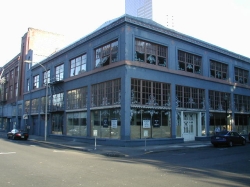
Changes are underway in the North Park blocks, and it's not just another condo or restaurant. DK Row reports in Thursday's Oregonian on the transformation of the former Daisy Kingdom building, which is being developed by Jim Winkler in order to provide a place for several of Portland's prominent galleries to buy their own property in the Pearl. With the new 9th and Flanders hub created after Pulliam Deffenbaugh, PDX and Elizabeth Leach all secured new spaces around this corner, the Pearl District has been able to keep its claim as Portland's art hot spot. Winkler's new development on 8th & Davis will further expand the Pearl's eastern borders, creating a link between the Pearl District and younger Chinatown galleries like Everett Station Lofts, Motel, Compound Gallery and Portland Art Center. Contemporary Crafts Museum & Gallery, relocating from its current location on Corbett Avenue, will occupy the largest space in the new building. Others include photography gallery Blue Sky, a new Augen satellite space, Froelick gallery and a new gallery owned by Charles A. Hartman, who recently moved from San Francisco. Galleries are in the final stages of purchase agreements and the center is expected to open in spring 2007. Posted by Katherine Bovee on March 09, 2006 at 11:07 | Comments (3) PermalinkTuesday 03.07.06 Olaf Breuning's "Group" in the Elizabeth Leach Gallery Video Window by MK Guth 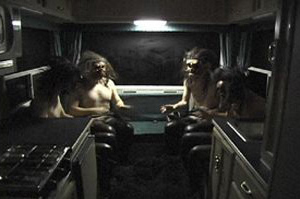 Still from Olaf Breuning's 2001 video "Group" Video Window is a forum for presenting different video works by national, international and regional artists. Each month a new video will be presented in the outside window of the Elizabeth Leach Gallery on opening night (for the First Thursday crowds), after which they will move to a monitor in the gallery for the duration of the month. Olaf Breuning's not to be missed video, "Group", will be my last selection for video window. "Group" documents the metamorphosis of bearded water drenched surf Vikings into Lord of the Flies Javamen. The characters in the video evolve and de-evolve, combining modern day camping van society with prehistoric antics. Breuning's highly constructed universes employ recognizable cultural cliches but amplifies and explodes them through his bizarre reconstructions and simulations. "Group" has the look of a National Geographic documentary on acid. This is the first time Olaf Breuning's work has ever been exhibited in Portland. Since this is my last month with Video Window I want to say I have enjoyed having the opportunity to present video works I admire by artists, Alix Pearlstein, David Eckard, Shawna Ferreira, Federico Nessi and Olaf Breuning. For those of you who have tuned in, Thanks! For those who have yet to visit Video Window come on by. April welcomes Matt McCormick to Video Window. Matt McCormick is a filmmaker who has directed several award winning films and music videos over the past ten years. He is also the founder of Peripheral Produce, an internationally recognized video distribution label specializing in short experimental work, and the director of the Portland Documentary and experimental Film Festival, Portland's premiere event for experimental, documentary, and otherwise obscure contemporary cinema. The PDX Film Festival will be running from April 26 - 30 Window of Elizabeth Leach Gallery • 417 N.W. 9th Ave • Portland, OR 97204 • Tel: 503 • 224 • 0324 Posted by Guest on March 07, 2006 at 22:31 | Comments (1) PermalinkSunday 03.05.06 It's soooo Whitney... I haven't been able to get too caught up in the latest Whitney Biennial... mainly
because is seems like such old news after Miami (and nowhere near as challenging). Also, because I live in Portland
the US city most likely to join the EU it's a bit retrograde (we are obsessed
with not making the same mistakes the rest of the country have made already).
If you are still curious Jerry Saltz gives his take here and Michael Kimmelman's take is somewhat helpful as well in the NYT's (with some pictures). I think the curators were right to try and bust up the hoard of less than toothy, lets giggle while Rome burns art... the stuff that the fairs and the Greater New York show have promulgated. Still, you can't overhaul a broken system (an increasingly predictable system?) by sampling from the same artists that produced the impasse with less than toothy critiques (weak ass pseudonyms, or masquerading as a gallery aren't enough, wasnt that 2002 and didn't Forcefield do it better?). I think Adrian Searle's take on the Tate Triennial illustrates the wall that has been hit even more clearly (but wasn't that wall clearly illustrated by the Stuckists? no they were entertaining and even older news). Maybe museum's just can't institutionalize radical change anymore with 'ennials in this very porous and communication heavy art world? I decided to skip the WB 06 after doing the Art Basel Miami art junket (I've seen a lot of its work or stuff like it elsewhere already). For me the best way to look at this WB is to think about its recent predecessors, both of which seemed at least galvanizing. The 2002 biennial infuriated people because it wasn't about New York, the 2004 one pleased people committed to New York because it seemed to support the effervescent New York market. Jerry Saltz was right in abstaining from praise, Schjeldahl acted relieved that he was in the right city (a question he seems to bring up frequently). Problem is, there is no one city anymore and the WB 06 seems to acknowledge that. The other problem is that conclusion isn't very provocative... the art fairs and the Greater New York show proved this point many moons ago. What's more the Uncertain States Of America show last fall ate its lunch. Ok we have an art impasse, isn't it time we stop curating shows about the impasse? *update: Todd Gibson's Haiku and his earlier observation. Also, show on the road and Bloggy check in... I still don't feel anything but ennui about this. If you dont travel much I guess it might be worthwhile. Posted by Jeff Jahn on March 05, 2006 at 22:33 | Comments (0) PermalinkThursday 03.02.06 Portland art is everywhere part deux Portlanders are showing all over the planet this weekend, so once again one
of the strongest art scenes in the country is coming to you so you can see some of the buzz elsewhere.
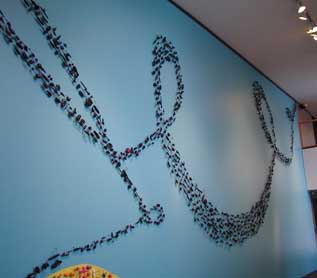 At Massachusetts' Fuller Museum, Hillary Pfeifer's s' warm looks like... Posted by Jeff Jahn on March 02, 2006 at 22:49 | Comments (0) PermalinkMonday 02.20.06 The impossiblity of more Damien Hirst in the mind of someone living in the art world? In Sunday's
Observer Sean O'Hagan had a nice chit chat with Damien Hirst whose latest
show opens up in Mexico City on Wednesday.
A couple of things: 1) This is not in New York, London or even LA, which is very smart. Mexico City at 21 million dwarfs New York and Hirst is reminding the art world of this. In an equally calculated move last March, Hirst treated New York to a show of his less than best work, a series of paintings. The message from Hirst was clear, he could dominate New York with second stringers and it was hilarious to watch. Basically, he's out to show he can make his own weather, and in a deeply religious and syncretic country like Mexico he should do fine. Also, it's not like people with the cash for a Hirst would somehow be impeded by any location, especially if he's showing better work than was available in New York. 2) The article points out that Hirst is, "more famous and more powerful than any other living artist." This seems like a foregone conclusion for the British but for us here stateside this isn't that obvious. Why? Hirst hasn't had a major US museum retrospective and Americans for better or worse defer to their institutions (possibly because we treat what little culture we have with kid gloves, whereas the British assault its suffocating tenure). Still it's a good move to remind American museums that he hasn't had a retrospective by hitting us below the belt in Mexico (Canada wouldn't quite work as well you know). 3) The spin paintings are drivel but entertaining as bad painting drivel. The butterflies are interesting and his vitrines are usually amazing. Despite the inherent camp in his work the focus on death insures it a certain immutable resonance even if he acts up for the ham loving British press. Like Picasso, he very much controls his own market and that is a big deal… if you cant beat the market system's inherent influence… just control the market... it's not that tough when you control production. To boot he synthesizes minimalism, pop and was doing autopises on the dead ideas that have not been resuscitated way before Dana Schutz did. It should be curated; Hirst, Schutz, Warhol, Murakami, Durant, Furnas, Cao Fei and maybe Banks Violette... call the show "Mortality?" Posted by Jeff Jahn on February 20, 2006 at 22:00 | Comments (2) PermalinkMonday 02.13.06 ESL and cafe's 1, would be institutions 0 February in Portland has been filled with a number decent quality to strong shows. It's been a weird month and the combination of seemingly relentless drizzle has
been broken up with unbelievably gorgeous, sunny days. Read on and see how the Everett Station Lofts and cafe art (indicating a yet another new wave of serious artists in town) stacks up this month...
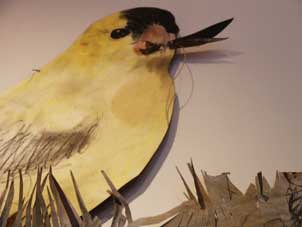 Andrew Myer's "Hunting Ground" (detail) Posted by Jeff Jahn on February 13, 2006 at 23:35 | Comments (6) PermalinkWednesday 02.08.06 Controversial ho hum 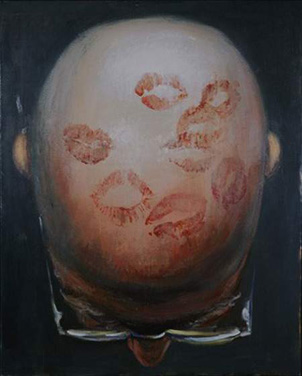 Appreciation of Beauty by William Park The most controversial art show in Portland (as determined by very unscientific means of overhearing "what's the deal with?") isn't what you would think. Sure we have shows about Nigerian genocide, naked girls eating frootloops and ecoterrorism but the show in question contains a few paintings by William Park that address middle-aged white guys with bald heads at Mark Woolley Gallery. Really, it is the familiarity and omnipresence that is causing a stir, not so much whether the subject is taboo (unless you are Zach Lund). I like some of these paintings a lot (mainly because they are so not my thing) and would have asked him to be in my Fresh Trouble show had I known of these new works. I find it interesting that they evoke such a response from young men and women who see them as symbols of boomer tyranny as they gentrify Portland left and right. Whereas boomer women have more varied responses and as expected gen-x and boomer men get all antsy if they are in the process of losing their hair. I'm not going to review this and instead make this an open thread for comments, so fire away... Why does foregrounding balding boomer men positively get people so stirred up???? Arguably, they are the demographic who wield the most power in this country and yes there is a lot of dissatisfaction but can't the bald enjoy their moment in the sun? Don't they deserve it? I don't think a hairless pate in itself is much of the issue, lots of other shows have clean shaven heads in the city. Posted by Jeff Jahn on February 08, 2006 at 21:33 | Comments (12) PermalinkTuesday 02.07.06 Around the web + welcome new sponsors I'm a big Gilbert and George fan and I'm very happy with the one on permanent
display at the Portland Art Museum but I found this Adrian
Searle review interesting. So now that all the newspapers are terrified of running
offensive cartoons only Gilbert and George can lampoon sacred things?
Also, closer to Portland the Oregonian has been running amuck with visual arts coverage, admirably calling for free days at the museum and talking to city commissioner Sam Adams (but how much does Adams really know about good art?… supporting lots of crappy art and shoddy organizations is just as stifling as no support). Then the O managed to write about Red 76's Ghosttown without mentioning they have national reach... they even have a show at Yerba Beuna in the spring. Yes, the O's coverage is all very populist (possibly to the exclusion of not giving credit to major accomplishments) but that is what the Oregonian does best and I'm glad they are foregrounding art as a major civic issue. Its editors and writers see that the city seems to be reinventing its self image and art seems to be where the action is… even politically. Also, a new visual arts publication, Visual Codec, has been officially on line for nearly one week and I had fun meeting some of them at the Lowbrow Lounge on First Thursday. Visual Codec is dedicated to increasing the flow of visual art information between Vancouver BC, Seattle and Portland. And yes I wrote an exhaustive but no where near complete anatomy of the Portland art scene for them. I like how the massive # of links make it a kind of index or primer for what is going on here, the web is definitely evolving language. Finally, Port would like to officially welcome three new sponsors; the Elizabeth Leach Gallery, Gallery 114 and the brand new Sugar gallery. You can check out their links to the right. Thank you sponsors, your support is invaluable. Posted by Jeff Jahn on February 07, 2006 at 21:58 | Comments (1) PermalinkSunday 02.05.06 East Burnside report on First Friday 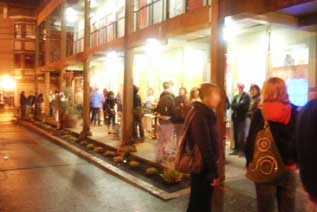 action on East Burnisde for First Friday Portland seems to sprout a new hip neighborhood every 6 months and more often than not it involves a couple of art galleries and hybrid fashion boutiques that also show art. The latest one has grown up along East Burnside directly across from The Jupiter Hotel, which hosts the annual Affair art fair. The adjacent and hopp'n Doug Fir lounge certainly doesn't hurt either. To be fair though, the very good Holst Architecture, KBOO radio, the Imago Theater and the New American Art Union were all there before The Affair and gave the area good bones as an arts district. Now it filling out with the Fix & Yes fashion boutiques as well as the Renowned gallery. As expected, First Friday's openings had a great deal more... Posted by Jeff Jahn on February 05, 2006 at 23:25 | Comments (5) PermalinkWednesday 02.01.06 Out on the web It's a pleasure to write about another web-based art project out of Portland. Local artist
Ethan Hamm has created EmailErosion.org
as a kind of John Cage inspired, spam effected study in information entropy.
Yes you can see it live at the Art Institute of Portland February 2nd but I
think the online version with webcam updates every 10 seconds will be more
like watching an online art execution... and therefore more interesting. Made
possible by a grant from Rhizome.org
The Oregonian's art blog penned by TJ Norris, is it art? (scroll down), has a nice interview with budding art impresario Gavin Shettler. Ok, the whole; I'm not a curator but I know some people who think they might be curators and I talk to them and they think I'm a curator... attitude wears a little thin. We don't need more art, so much as more opportunities to display good art in Portland and that does take having an eye (just to figure out who else has an eye). I've harped on the Portland Art Center before but it looks like they are improving their programming through subcontracting out to the Portland Modern publication and deviating from their previous 2 year schedule. This latest PM issue is excellent, where the previous two, although well intentioned were uneven or worse. Lets hope PAC ups their ante like Portland Modern has, and they do seem to be more responsive to valid critiques than some other orgs in town. These wondertwins will combine their powers on First Thursday too through an exhibit at PAC and the nearby Ogle Gallery. Shape of a bucket of water... form of an eagle! Lastly, since we are talking about curators Edward Winkleman has a great post on his curator of the month while Tyler Green discusses why MOCA's Ecstasy show is so nice in part 2. It's true New York museum shows often feel cloistered, whereas many MOCA shows have a nice expansive quality.... lets call it free-range arting. Actually so many museum shows are micromanaging crowd dynamics now they make me feel like a molecule of water in a fluidynamics experiment... I'd prefer museums be more than "cultural plumbing." Oh yes and latest my critical i article is out as well. Posted by Jeff Jahn on February 01, 2006 at 19:31 | Comments (2) PermalinkTuesday 01.31.06 Introducing Nicky Kriara PORT is pleased to introduce our new calendar blogger, Nicky Kriara. Nicky
is a recent veteran of the Everett Station Lofts, running the Epitome Gallery
for over 2 years. A rare native Portlander, she brings a wealth of experience
to the table, having studied at USC, U-Mass Amherst and the University of Oregon. PORT co-founder
Jennifer Armbrust, will continue to post and moderate once she returns from Europe.
The reasons for the change is academic, being a gallerist Jenn was busiest with
the calendar at the very moment a new show needed to be installed. As an artist
Nicky was looking for a way to stay connected to the scene while focusing on
her own work. Nicky impressed us with her sharp eyes and quick wit. Please join
me in welcoming her to the art-blogosphere. Expect her 1st First Thursday post
soon.
Posted by Jeff Jahn on January 31, 2006 at 19:33 | Comments (0) PermalinkSaturday 01.28.06 Getting all linky Dear readers, January 2006 has been a banner month for PORT and we continue
to make enhancements to the site. To that end we have added a
links page under our categories on the left. All of the Portland links either regularly
provide info about the arts in the city or discuss some
of the things that make Portland so appealing to arty people. The arts don't
exist in a vaccum and Portland is a city blessed with an obsession for good
food, walking not driving, hip
urban communities as well as its hyperactive art scene. The artist blogs chosen
aren't mere vanity sites or PR vehicles. These sites provide a window into their individual
experiences, which may be of great help to other artists. The list will continue
to grow as well.
As for the other links, check em out. I find that the web has greatly reduced the proprietary nature of some art world information. On the web everything becomes local. The two best art sites are Artnet's excellent magazine and Tyler Green's Modern Art Notes. Those two sites alone have made the rather small art world a great deal smaller. In the next week PORT will be announcing our new calendar person and photoblogger, bringing our our professional paid staff to 6 (but have no illusions, this is still a labor of love). There will be a host of new sponsors added this week as well. Thank you sponsors, you make this groundbreaking experiment in online visual arts publishing possible. When we created PORT we saw it as an opportunity to evolve the blog form into a focused, content rich publication that raises the level of criticism in Portland, while providing a template for a new type of local arts writing that is internationally accessible and relevant. Considering our readership #'s I'm pretty proud of our staff, readers, sponsors and Portland in general. It's an honor. As a thank you we published four critically rich reviews this week, more than doubling the number of critical pieces published in the city for that time period. I'd also like to note the WWeek just published its first visual arts feature since October and the Portland Tribune had a nice piece on the Ovitz collection (two things we have been shouting from the rooftops about for some time). I don't see PORT as needing to take part in any of the typical reindeer games that dead tree press usually requires. We are here to catalyze, create and draw attention to worthy information on Art that is of interest to Portlanders (and because Portland is a pretty dynamic place, the rest of the world). PORT is a very specialized kind of publication and Elizabeth Zimmer (a senior editor at The Village Voice), Matthew Stadler (moderator), myself, Jenn, and Katherine of PORT as well as Mike Merrill of urbanhonking.com, and PICA's Amanda Deutsch all discussed this in a forum during last year's PICA TBA festival. Simply put, arts writing is dying off as dead tree media gets increasingly squeezed economically. By specializing, PORT is merely one solution to a larger problem as intellegent critical information gets increasingly marginalized in traditional news media. Posted by Jeff Jahn on January 28, 2006 at 14:05 | Comments (0) PermalinkMonday 01.23.06 Extended Absence I will be heading out of town tomorrow to Los Angeles to participate in artLA
with galleries from around the country. Pulliam
Deffenbaugh, PDX
and Alysia Duckler
will be there too, representing Portland with a strong showing. This is the
second year for artLA, an art fair directed by Stephen Cohen of the long-running
photo L.A.. I, for
one, am looking forward to a new audience of art lovers and a little Santa Monica
sun.
I will then be taking the month of February off for a little R&R and some jet setting to Europe. So, I will be very scarce in these parts (Motel will also be closed through February). But, don't fear, I will be back in March. In the meantime, we will be introducing a new announcements writer who will be handling the First Thursday/First Friday listings. In case you were sending press releases directly to me, please re-route them to calendar@portlandart.net. Cheers! Jenn Posted by Jennifer Armbrust on January 23, 2006 at 10:47 | Comments (1) PermalinkSunday 01.22.06 Goose & gander the Oregonian on PAM's direction D.K. Row had a nice probing article on the future of the Portland Art Museum now that the Buchannan's have left. Good work, the O might not be able to discuss Danto and art the way PORT can but let's be fair we aren't a generalist publication and can indulge in intellectual pursuits. This is why the Oregonian is completely outpacing the WWeek in visual art coverage and providing the goods in a way most mid-sized city newspapers do not. I'd love to see the WWeek at least attempt to keep up by having their first feature article on art since October!
As far as the article details go some things need to be countered and fleshed out (feel free to comment): First, the museum already quantitatively dedicates more space to local artists than nearly any similar large generalist museum I can think of (with an entire wing). The new northwest curator position should address the qualitative issue. The real question is, will PAM balance its blockbuster programming with more serious curatorial efforts? It is about covering all the bases and when the Rosenquist retrospective didn't come here as it was first announced to, it stung... a lot. If a similar major retrospective or two were to come here it would be long overdue. Still, the newly minted Meigs endowment shows like the current Sophie Calle and upcoming Roxy Paine exhibitions do help more than a bit. Yes, there is room to do more shows like the Keinholtz (2003) and New in Town (2002) as well. It's been too long and now that construction has stopped there are opportunities. As for the Oregon Biennial, it will only be relevant if it makes relevant statements. The Bay Area Now shows do this and the 1999 Biennial arguably did so as well, it jump started the current explosion in scene activity (leaders like Michael Knutson, Sean Healy, Tom Cramer, Jacqueline Ehlis, Kristan Kennedy, Storm Tharp, and Brendan Clenaghen are 1999 alums who have only matured since then). Ironically, except for Cramer the O blasts or ignores these very good artists (by any scene's standards) while blasting the museum for similar caprices. Look, what is good for the goose is good for the gander. As for directors the PAM board (+ the Oregonian and public in general), they need to understand that Portland is filled to the gills with a hoard of interested artists (both young and old) as well as newcomers from other more culturally developed cities (some of these individuals have serious financial portfolios and collections but have stayed out of PAM and PICA's searchlights because the institutions were rightly percieved as inconsistent). These "untapped" people by and large have sophisticated tastes and their attendance at warehouse shows and the Affair at the Jupiter indicate a hard-core constituency of thousands exists. So much for hurting attendance. Contemporary art isn't the financial doom that the previous regime and the O suspect. In fact, it might help the museum more than anyone but a few insiders suspect. One of Portland's charms is how older patrons and youngsters actually mix at warehouse shows; it's a way to stay young/network depending on where you are in life. A moderate director can move the museum and city forward and institutionalize this fountain of youth and ambition by blessing the interaction (example: collector Bonnie Serkin recently comissioned Chandra Bocci for the Museum's contemporary art council holiday party). There needs to be more of that demographic mixing and I suggest a "moderate" director because I don't believe that big museums need to be the vanguard anymore, even MoMA doesn't/can't do that. That is for the warehouses and younger institutions. What the Museum needs to do is simply get in on some of that action and engage/support the best of it. It's already happening but there will be several litmus tests this year that will test the all important follow through. Posted by Jeff Jahn on January 22, 2006 at 16:37 | Comments (0) PermalinkTuesday 01.17.06 a little of this and that First off, I absolutely agree with the Portland
Architecture blog. At 45 million Portland's
aerial tram is absolutely worth it. Besides, no public transit project worth
a hoot costs 15 million, and this one spurs 1.9 billion in development. Then there
is the fact that it allows OHSU (Portland's biggest employer) to expand. Not to
mention it is the first really ambitious bit of world class signature architecture
the city has attempted since the Freemont bridge. In that context it seems like
a good deal. Visually, it gives Portland a symbol of its new progressive on the
outside as well as inside image.
Jerry Saltz's brilliant review of Robert Rauschenberg's combines is right on and one of his best bits of writing to date. Although I reject the idea of RR being the American Picasso, he is the artist that exemplified how Americans pragmatically reinvent themselves (at all costs, including risking serious duds). I logged a lot of time in front of the last combine pictured, Studio Painting, when it was on display at the Portland Art Museum a year or two ago. The way the piece foregrounded the idea of internal studio practices and pointed towards the transmission of the messy results via the image of telephone wires was practically romantic (even down to the pun of the two halves of the painting held in tension by the wall mountings, taut string and counterbalancing weight). In that painting Rauschenberg presents the studio struggle as a manufactured crime scene with a corpse, perpetrator, motive, opportunity and murder weapon he fabricated. Like Joseph Cornell, Rauschenberg always treated collaged elements as a game but unlike Duchamp was willing to play with readymades even if it meant losing. In Studio Painting Rauschenberg has it both ways; he wins then dismisses the outcome by pointing out how it was rigged. Artists love him because nobody purposefully cheated greatness of its patina better while achieving it. Current collage artists like Phoebe Washburn and Sarah Sze seem to be unwilling to cheat against their own system of rules like Rauschenberg. Posted by Jeff Jahn on January 17, 2006 at 22:54 | Comments (4) PermalinkMonday 01.16.06 2006, highlights for the year ahead in Portland art Ok 2005 was a ridiculously busy year for the Portland art scene and Im pleased that everyone (that matters) seems to be in the process of continuing to up the ante.
Here are some things in Portland to look forward to for the visual arts in 2006, if you live elsewhere expect to see more Porlanders from Iceland to Chandra Bocci's current show in San Francisco: 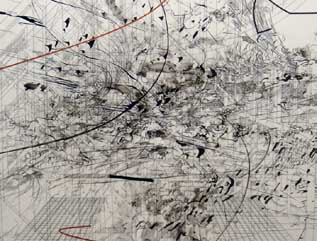
Detail of Ovitz's Untitled Mehretu 1) Opening Jan 24th, Reed College's Cooley Gallery is doing a two part show of recent painting, drawing and multi-media work from the Ovitz Family Collection called New Trajectories. It's a young collection featuring work by Richard Prince, Julie Mehretu etc. Michael Ovitz is the agent who facilitated David Letterman's defection from NBC to CBS after "the tasteless" picked Jay Leno to replace Johnnie. He also ran Disney for a while. What is interesting about the collection is that... Posted by Jeff Jahn on January 16, 2006 at 13:39 | Comments (0) PermalinkSunday 01.15.06 Portland Art Museum free on MLK Day Reminder to families and anyone who has Monday the 16th off. The Portland Art Museum is open free of charge for Martin Luther King Day. Considering the fact that one of the masterpieces of Western European art, The Holbein Madonna is on display... you really should go.
You want more? There is a small but worthy exhibit by dutch masters like Franz Hals that ends soon too. On the contemporary front there is a whole new wing plus Sophie Calle's "Exquisite Pain" which is on display for only one more month as well. Posted by Jeff Jahn on January 15, 2006 at 17:42 | Comments (0) PermalinkFriday 01.13.06 Gately Q & A in the O In today's Oregonian, D.K.
Row publishes an interview with the Museum's new Curator of Northwest Art, Jennifer
Gately. The interview offers a cursory overview of Gately's motivations,
interests and thoughts on her new position. As long as I've been in Portland,
the Museum has completely ignored
young local artists, except for the token exposure of the Biennial. The frustration
felt by the city's emergings is palpable. Gallerists in other cities are shocked
when I tell them that the museum's contemporary curators don't visit (of buy
from) the younger galleries in town. In the Q & A, Row presses Gately on
this pervasive discontent and she responds,
People are obviously angst ridden by this issue... Of course, change takes time. But I wouldn't be skeptical given the new wing (devoted to contemporary art) at the museum. I think the museum is aware of that (dissatisfaction) and everything happening now is an answer to that. Hiring Gately, who seems to be in touch with how Portland's up-and-comers fits into the greater schema of contemporary art, is a good first step. I'll also take it as an auspicious sign that Gately has already been in my own 'lil gallery before even beginning her work at the Museum. Let's hope that she will infuse the Museum with a much needed enthusiasm and begin engaging with Portland's young creatives with a seriousness that we haven't yet seen. We can also cross our fingers that as PAM undergoes major staff changes, it will, as Gately suggests, rectify some of it's past offenses and make a commitment to our city's talented up-and-comers. Posted by Jennifer Armbrust on January 13, 2006 at 14:15 | Comments (5) PermalinkTuesday 01.10.06 Brettell Lecture at PAM 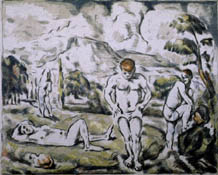 Grand Bathers Dr. Richard R. Brettell - Cèzanne and Beyond January 15, Sunday, 2:00 pm Portland Art Museum PGE Foundation Education Center, Whitsell Auditorium Yes, some are tired of dead French art in town but Cèzanne is so important and radical he gets an automatic exemption. Plus, Brettell is one of the country's foremost authorities on Impressionism and is Professor of Aesthetic Studies at the University of Texas at Dallas. His lecture will discuss the beginnings of the Modern movement as seen in the work of Cèzanne and other Impressionists. It is always nice to see an expert bring one of the greats to life. (free to museum members, call 503 226-0973 for tickets) Sponsored by the Paul G. Allen Family Foundation *note the Portland Art Museum will be open free of charge on Martin Luther King Day Posted by Jeff Jahn on January 10, 2006 at 22:42 | Comments (0) PermalinkOut on the web Over at MAN Tyler Green has a great two part interview with Terry Riley, the new Director of the Miami Art Museum. (remember Portland's art museum is looking for a new director) Here is part 1 & part
2. Some of this discussion is very relevant to Portland, Seattle and pretty
much any of the other major US cities that are also getting their visual arts act
together.
On Artnet, Kay Itoi did a piece on Tokyo, check it out here. ...and well this just cracks me up. Posted by Jeff Jahn on January 10, 2006 at 5:34 | Comments (0) PermalinkThursday 01.05.06 Everett Station Lofts 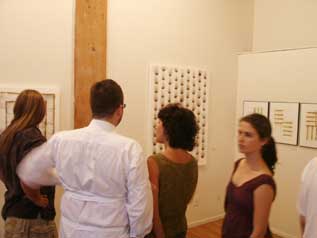 The Everett Station Lofts are sometimes great, sometimes terrible but always interesting artist run live work spaces in the thick of a lot of art action between Oldtown and The Pearl District.. I noticed about 4 of the best gallery spaces in this 15 unit complex are going to be changing hands. Here is a link for contacting the powers that be. The ESL's provide an excellent opportunity for the young and ambitious to try and run their own gallery. I can guarantee you'll get noticed here if you are serious. The best galleries from the past have launched some sucessful careers, they were galleries with names like Fleck, Nil, Field and Sound Vision, are you next? Yes, I can also guarantee you will get ignored if its merely ok or some pure hipster hangout who covers up the best painting or C-print in the show with the DJ on First Thursday. Posted by Jeff Jahn on January 05, 2006 at 21:50 | Comments (0) PermalinkTuesday 01.03.06 Jan 6th deadline for Oregon Biennial Reminder deadline for the much anticipated Oregon Biennial, curated by Portland's
newest curator Jennifer
Gately, is January 6th. Here
is the 2006 Oregon Biennial prospectus link, use it wisely.
Posted by Jeff Jahn on January 03, 2006 at 5:43 | Comments (0) PermalinkMonday 01.02.06 Looking to 2006 and looking back at 2005 in Portland art So what does 2006 hold for Portland Art? For Bruce Guenther Chief Curator of Modern and Contemporary Art (Portland Art Museum), "2006 will be a year for building the collection and the endowments... so the resolution is to 'buy more art'"
Artist With The Biggest Year in 2005: Matthew Picton. He sold well in LA and San Francisco but sold only one piece in his February 2005 show in Portland. Later, he was added to the new De Young museum's collection. Other projects are in the works. With great reviews from the LA Times' Christopher Knight and most everyone else he is Oregon's hottest artist. Big Year Honorable Mention... Posted by Jeff Jahn on January 02, 2006 at 21:06 | Comments (0) PermalinkSaturday 12.31.05 Happy New Year from PORT 2005 was a great year for art in Portland. As for PORT, we thived (not bad for an experimental form of art macroblog). Our monthly readership has more than doubled since our debut in June and even then we were pretty excited just how many thousands of readers we had. Since June our readership has steadily increased, a good sign. In Miami during the art fairs I was inundated with an impressive number of readers from afar, thanks for the compliments.
While at the fairs I also compared notes with a lot of other art writers and bloggers. I was surprised that we get a lot more daily and monthly readers than many of the New York based blogs, clearly there is a need for PORT and we thank our readers and sponsors for this success. Monday I'll post my "best of" lists along with input from our readers...until then, here is a link to my latest Critical i article. Till then, Happy New Year from all of us at PORT Posted by Jeff Jahn on December 31, 2005 at 15:39 | Comments (0) PermalinkMonday 12.26.05 2005 your best and worst picks *Note, due to the holidays posting on PORT will be more sporadic than our usual daily coverage until Jan 2 2006. Still, there will be some fun stuff to blog on between now and then.
Also, at PORT we value our readers and wouldn't consider subjecting you to the typical and nearly unavoidable slant of some multiple choice survey. Instead, we will listen to the squeaky wheel (a Portland tradition). In lieu of some faux scientific survey, simply email me your lists of the best and worst things in the Portland art scene or art world in general (use jeffATportlandart.net). I can't promise I'll publish everything (particularly the rantings of drunken monomaniacs) but whether I agree with it or not I'll add it to a series of end of the year compilations I'm doing. Of course all contributions except mine will remain anonymous and after the list comes out you can add to the discussion via our comments. Some suggestions: Best solo show Most disappointing solo show Worst show title Most worn out idea Most improved gallery Hippest gallery Most annoying art personality Worst art review Best art review Best new artist of 2005 Most improved artist Artist in the biggest rut Gallery in a rut Institution in a rut Suggestion list in a rut… etc, etc. Posted by Jeff Jahn on December 26, 2005 at 21:15 | Comments (1) PermalinkFriday 12.23.05 A Distinguished Guest Yes, the Portland Art Museum has been moving things around a bit by reconfiguring the Duchamp etc... But this distinguished guest, Rothko's Homage to Matisse is too good not to take note of. Mark Rothko is Portland's most famous artist and the relationship between Rothko's use of volumes and Matisse's couldn't be clearer than in this painting, plus there are the color choices and a certain sort of unsettling brushtroke they both liked to employ. It probably won't be here long so check it out at the Jubitz center.
Posted by Jeff Jahn on December 23, 2005 at 12:50 | Comments (1) PermalinkWednesday 12.21.05 Van Sant and Cramer on KBOO Be sure to tune into Art Focus on KBOO
radio (90.7 FM) at 10:30 AM on Thursday Dec 22nd. Guest host Tom
Cramer (arguably Portland's Artist Laureate) will be chatting with Gus
Van Sant. If you are outside of Portland's listening area you can stream it
here.
Posted by Jeff Jahn on December 21, 2005 at 19:32 | Comments (0) PermalinkTuesday 12.20.05 Holiday Art Consultant You've got a couple of days left before Christmas and maybe you want to buy some amazing art. Yes, art is highly subjective so this is tricky.... but regardless here's a little holiday gift guide for serious collectors.
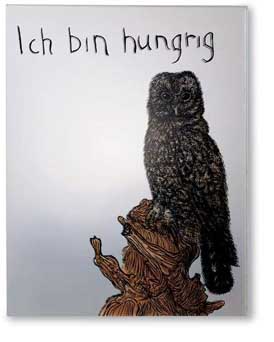
I Have Hunger, by Kiki Smith at Elizabeth Leach Gallery I just love this editioned print on a one of a kind antique mirror. Look, somebody has to buy this before I do. I'm buying a new car and a new laptop... yet this is relatively inexpensive (ohh the pain). Please buy this so I no longer feel tempted. 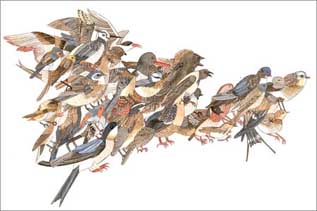
Ornithology by Carson Ellis at Motel 2005 was a big year for her, being the... Posted by Jeff Jahn on December 20, 2005 at 6:51 | Comments (0) PermalinkMonday 12.19.05 Discussion alert Now this is an active discussion, once again from Edward Winkleman. Really, I don't think critics are the issue here. Instead, it is just that the often dubious value of contemporary art is being undermined by the fact that some of it has become a good investment. It's the problem Peter Pan faces when he leaves Never Never Land. Most everyone is on too good of behavior on the intellectual front and the lack of radical ideas facilitates artist behavior and work that tries too hard to please those that hold their leashes.
What you want is a few out on a limb collectors that work with out on a limb artists to produce extremes that defy existing marketing logic. Sure it creates another market but it makes the tame stuff seem tame by comparison. Commerce in itself isn't bad so long as there are some entities that push the envelope and keep the system honest. Dave Hickey called these communities of desire... and maybe the problem is that the desires are too easilly sated? Posted by Jeff Jahn on December 19, 2005 at 19:19 | Comments (0) PermalinkSaturday 12.17.05 Out on the web I've, said it before... and Ill say it again Edward Winkleman's blog site has the best content oriented art posts on the internet, here is a lengthy discussion about purity
of medium in photography. I finally got to meet him in Miami and want to congratulate him on his gallery's move from Brooklyn to Chelsea.
Tyler Green has been on fire with his assault on Pixar's show at MoMA. Also, make certain to check out his Miami picks (I'll have an illustrated essay involving Miami and all sorts of other art world sediments in my next monthly NWdrizzle magazine article). Back in the neighborhood Chas Bowie is writing about art a lot again in the Mercury, we fling critical poo at eachother occasionally but I miss his voice in the art scene when he's writing about hipster tripe instead. Here he jinxes several good artists for the upcoming Oregon Biennial (funny thing was, most of these people [*correction who were living here at the time] applied to the last one except for Hildur who isn't eligible because she lives in freakin Iceland). Maybe, I'll make a list and jinx all the other decent eligible artists too! Posted by Jeff Jahn on December 17, 2005 at 11:54 | Comments (7) PermalinkFriday 12.16.05 Breaking News: New Curator Bruce
Guenther just announced PAM's
Harold and Arlene Schnitzer Curator of Northwest Art this morning at the City
Club. And she is... Jennifer Gately. Gately was formerly the Visual
Arts Director at the Sun Valley Center for the Arts. One of Gately's first
tasks will be the curation of the Oregon
Biennial.
Welcome aboard! **(update) David Row was on the ball and the Oregonian put this web exclusive up this morning.-jj Posted by Jennifer Armbrust on December 16, 2005 at 14:45 | Comments (2) PermalinkThursday 12.15.05 Prints for PICA  Saturday afternoon and evening marks the all-day print marathon and studio sale, Prints for PICA. More than 50 artists spend the day creating and collaborating for a floor-to-ceiling jam packed studio sale. Prints range in price from $100-250, and are sold on a first come, first served basis. Expect hidden gems and steals-of-a-deal! All proceeds benefit PICA and the artists. Prints for PICA • December 17, 4 to 9 p Studio 333 : 333 NE Hancock (@ MLK) Participating: Patrick Abbey, Kevin Abell, Brad Adkins, Rachel Allen, Nat Andreini, Megan Atiyeh, Josh Berger, Philippe Blanc, Patricia Boas, Christine Bourdette, Katherine Bovee, Michael Boyle, John Brodie, Chris Buckingham, Liz Calderon, Bruce Collin, Nan Curtis, Tim Dalbow, Laurie Daniel, Daniel Duford, Ty Ennis, Karen Esler, Alexander Felton, Shawna Ferreira, Anna Fidler, Harrell Fletcher, Gilles Foisy, Carla Forte, Kay French, Ken Frink, Scott Gallatly, Pedro Galvan, Robert Gamblin, Chris Gander, Ellen George, Emily Ginsburg, Ellen Goldschmidt, Cecilia Hallinan, Rob Halverson, Levi Hanes, Bob Hanson, Stephen Hayes, Sean Healy, Midori Hirose, Joe Hockett, Robin Hoffmeister, Deborah Horell, Marty Houston, Chris Hutchinson, David Inkpen, Joe Thurston, Kristan Kennedy, Una Kim, Kendra Larson, Patrick Long, Mark Mahaffey, Rae Mahaffey, Khaela Maricich, Mike McGovern, Bill Park, Nathaniel Price, Scott Porter, Driscoll Reid, Blair Saxon-Hill, Randell Sims, Stephen Slappe, Marty Schnapf, Stephanie Snyder, Adam Sorensen, Johanna Seligman, Blake Stellyes, BarbTetenbaum, Storm Tharp, Andrea U'ren, Elise Wagner. Morgan Walker, Heather Watkins, Marie Watt, Stephanie Wilson, Christopher Young, Fredrick Zal, Renee Zangara Posted by Jennifer Armbrust on December 15, 2005 at 17:49 | Comments (0) PermalinkBenefit Bash Ultra
gives the scoop on Gallery 500's going out/blowing out holiday benefit party.
Maybe we'll see you there...
Posted by Jennifer Armbrust on December 15, 2005 at 15:26 | Comments (0) PermalinkWednesday 12.14.05 Exposette Last Sunday, the Oregonian ran a long story exposing the dubious record of Lance Robbins, the developer backing Bryan Suereth's optimistically ambitious plans to set up shop in the Templeton Building on East Burnside. It turns out that Robbins, who began developing residential property in LA in the late 70s, has been quite successful turning rundown buildings into artist pads, but his tactics have earned him nicknames from local press such as "L.A.'s reigning slum king." Over the past two decades, Robbins has faced repeated charges of fraud and tenant abuse and most recently, is battling the revocation of his California real estate license. Shut out of the California market for the time being, Robbins and his partners have turned their sights towards out-of-state ventures like Portland's Templeton Building.
The sleuthing of writer Erin Hoover Barnett and researcher Lynne Palombo dug up facts that were new to Suereth and the Disjecta Board. The organization faces a daunting task of raising six figure sums for build-out and operations with a thin history of fundraising. Plus, the O reported that Disjecta will be asked for $200,000 to secure the building within the next several months. One Disjecta board member, Marshall Runkel, admitted to the serious implications that these new developments may have for Disjecta's ability to rally potential donors in this critical phase. And I'm not sure how many donors and members of the art community will be comforted by Suereth's assurances that the project rests on his own integrity or that it's a good opportunity for Robbins to clear his name. Arts organizations can still get away with cavalier strategies in grass roots circles, but it's clear that as Portland's art scene is rocketing towards a newfound maturity, its serious supporters are going to need much more than just casual assurances. Posted by Katherine Bovee on December 14, 2005 at 1:53 | Comments (20) PermalinkSunday 12.11.05 Toughlove for the Portland Art Center 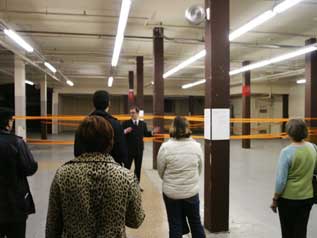 Director Gavin Shettler at the Portland Art Center's new home in Chinatown On December 8th the still unproven Portland Art Center unveiled its plans for its new home in Chinatown to a good crowd on a cold night. So far they have sold one enormous $10,000 painting by Cecilia Hallinan but lots of nice work and some cheesy stuff is still for sale though. Thankfully, the artists get 60% of the proceeds here. There will be at least three galleries within the complex, each with a focus on installation art, young unsigned talent and one rental space for other visual art organizations, respectively. More on the galleries later, but I think there needs to be some tough talk regarding PAC that needs to be addressed. Let's see how they handle the tough love. Wearing a suit in Portland says you... Posted by Jeff Jahn on December 11, 2005 at 23:22 | Comments (3) PermalinkSaturday 12.10.05 Reeding the Oregonian Reed curator Stephanie Snyder takes Oregonian critic D.K. (Death) Row to task about his Mona Hatoum review here. Often I'm flummoxed as to why curators, artists and gallerists feel they can't critique the critics (I'm currently trying to find time to respond to a response to a response I have been having with one local artist [p.s. artist, I'll get back to you soon]). It's healthy on both sides and this instance plays into my old saw about the Oregonian punishing artists who have relevance outside of Portland, possibly because of that relevance. I believe this is the case for globe trotting Northwest artists; Kornberg, Wojick, Ehlis, Healy, Conkle, Cowie and Picton (some of the most adept, intelligent, refined and most importantly "challenging" artist on the West Coast). Now we can add an international star like Mona Hatoum. Now this isn't a jihad like the WWeek would like to call it... but I'm firm on this. Sophistication and mastery of one's subject is not a crime. Part of the subtlety of artist like Hatoum, Ehlis, Kornberg and Picton is the fact that their work has mastered technique to a point where one isn't supposed to see some grand struggle in materials that gives personal clues into the artists' lives. Instead it is a more universal and internationally readable (i.e. neutral) presentation that doesn't foreground the artist or process as much as the content that accrues. These artists have been called slick or inscrutable but what they really are is confident and not patronizing. They allow the art to speak for itself but its nice that at least two people have been moved enough to discuss Hatoum's work publicly. It's all part of Portland's growing pains and I think polarizing reviews are important. After the mendacity and malaise of Miami the fact that Hatoum can get this kind of reaction in Portland is invigorating. DK does some good things though and I like his cynical but engaged attitude. Still he hasn't been the only author of the reviews in question at the O. It seems like an editorial policy to treat Portland like "the town" is isn't. Cities exist to discover, define and disseminate talent and Portland is in high geear even if the main newspaper wants to increase its appeal to the burbs by taking shots at the cosmopolitan changes in town. Those very real changes are being lead by the art scene in Portand and it's important to note the Orgonian has done an admirable job of providing coverage. The question is what kind of stance are they taking? Posted by Jeff Jahn on December 10, 2005 at 15:03 | Comments (1) PermalinkWednesday 12.07.05 Reality is the alternate reality The alternate reality of the art world is ... reality (of course) and on the internet there is a parallel version of the art world: Richard Prince asks some interesting questions about the nature of plagerism... how appropriate is that? Dave Hickey in the real world has gone all CEO and COO Tyler Green was a pro baseball player... so that's how he hits it out of the park so often? Elizabeth Murray is a fine gardener and painter, it figures! This Mary Boone is also an editor's dream... maybe it's the name? Posted by Jeff Jahn on December 07, 2005 at 6:24 | Comments (0) PermalinkTuesday 12.06.05 Electro-week Electronic music has historically had a fruitful relationship to visual art. Experimental pioneer John Cage had a deep influence on his cohorts at Black Mountain College in the 50s and there's a more recent wave of crossover between electronica and art. We've seen an influx of ex-art students as musicians, like Fischerspooner and Chicks on Speed, and DJs as artists, like Paul D. Miller (aka DJ Spooky) and Robin Rimbaud (aka Scanner). Carsten Nicolai produces some of the most sublime and thorough artwork dealing with electronic music, down to his dry, repetitive aesthetic tendencies.
This afternoon at Reed College, you can hear about the history and evolution of electronic music from visiting composer Bruce Bennet, who currently teaches at UC-Berkeley. Then, tomorrow, hear one of the best artists-as-musicians, Wynne Greenwood (Tracy and the Plastics) take the stage at Holocene with her alter-egos, beamed onstage via Greenwood's delightfully lowbrow videos. Some of us probably caught Greenwood at a truncated performance at PICA's late night venue during tba. Let's hope the crowd suits her better this time so she'll give us a longer show! Bruce Bennet, "The History of Electronic Music" Tuesday, December 6th • 4:15p • free Reed College, Psychology Auditorium • 3203 SE Woodstock Boulevard Tracy and the Plastics Wednesday, December 7th • 9p • $8 advance Holocene • 1001 SE Morrison • 503.239.7639 Posted by Katherine Bovee on December 06, 2005 at 9:56 | Comments (1) PermalinkMonday 12.05.05 Whit-nay The Whitney has released its roster
for the 2006 biennial. Seems to be very East Coast-heavy (surprise). At
MAN, Tyler Green questions its relevance. Especially coming off the market-driven
art fairs. My favorite jab, "The Whitney will have 100 or so artists in
a show that sounds Seinfeldian, like it will be about nothing."
**Update: additional info on the the "WB" can be found on this participant's blog. It all sounds a bit paternally Euro-centric and the inclusion of Europeans might really backfire. Besides there was just a show in Oslo on this same theme, lots of the same artists too. Although, Portland is more in line with this European worldview. Posted by Jennifer Armbrust on December 05, 2005 at 17:38 | Comments (1) PermalinkSaturday 12.03.05 ABMB by Proxy If you are reading PORT this weekend, chances are you are far, far away from the madness in Miami. However, that doesn't necessarily mean you want to be out of the loop. And fortunately, ArtInfo has been giving juicy coverage of the event. With the Ultimate Basel Blog, they get down to the nitty gritty of who, what and for how much. In "Day 2", they even give props to Portland-tied galleries (Liz Leach) and artists (Malia Jensen) with a mention of the Affair. According to the articles, booths are selling out right and left at Basel and NADA with sales above and beyond expectations. Ah yes, the art bubble continues to expand...
(Thanks to the OC Art Blog for the tip.) Posted by Jennifer Armbrust on December 03, 2005 at 0:50 | Comments (0) PermalinkWednesday 11.30.05 Harrell Fletcher at Artpace 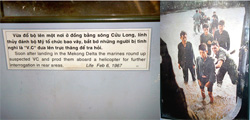
Harrell Fletcher recently wrapped up his residency at Artpace and his latest project, The American War, is currently on view there. While one can typically find subtle jabs at the politics of the art world in Fletcher's work, this series confronts a more overt political topic, war. The American War appropriates documents detailing the American War (better known as the Vietnam War to Americans) from the War Remnants Museum in Ho Chi Minh City, Vietnam. Bi-lingual captions detail horrifying photographs depicting American atrocities against civilians, chemical warfare, torture and other sickeningly explicit scenes from the war. It's a version of history that's rarely seen, and one can't help but draw correlations with the United States' current involvement in Iraq. By re-photographing these panels, Fletcher not only brings these documents to an American audience, but maintains a loose, snapshot-like quality that emphasizes their context within an institutional setting. The American War will travel to Solvent Space (Richmond, VA), White Columns and MIT's Center for Advanced Visual Studies in 2006. A catalog will also be available in the spring of 2006. Posted by Katherine Bovee on November 30, 2005 at 12:00 | Comments (0) PermalinkTuesday 11.29.05 Bienvenido a Miami Unless you're living under a rock, you must know that this week is Miami Madness.
Arty events abound around Art Basel Miami Beach with satellite fairs, projects,
parties, collection tours and lots and lots of schmoozing. To keep your finger
on the pulse, even from drippy PDX, there are plenty of bloggers on the beat.
JJ will be checking in with some posts from the eye of the storm. Tyler
Green gives the most comprehensive list of guides and blogs on the scene.
Also, check out abLA for the
inside scoop from Aqua. Uh oh, looks
like it's raining in South Beach, too.
Posted by Jennifer Armbrust on November 29, 2005 at 21:19 | Comments (0) PermalinkMonday 11.28.05 John Buchanan as Marie Antoinette La Creme de la Creme... Francophile museum director extrodinare John Buchanan will be leaving us for a San Francisco in February but first a onetime Portland Art Museum staffer wanted to share this gem of a painting with the world. It's a mark of success to be tartuffified in such world class splendor! seriously... Posted by Guest on November 28, 2005 at 22:56 | Comments (1) PermalinkSmithsonian, Smithson, Bowie Today marks the official launch of Eye
Level, the official blog of the Smithsonian American Art Museum. "Using
the museum's collection as a touchstone, the conversation at Eye Level will center
on the ways in which the nation's art connects to its history and culture."
One of their first posts captures
the intrigue and popularity of Smithson's Spiral Jetty with the inclusion
of a link to an
image of the piece by Portland's own Chas Bowie.
Posted by Jennifer Armbrust on November 28, 2005 at 16:04 | Comments (0) PermalinkSaturday 11.26.05 Messing with Minimalism David Cohen at Art Critical posted this nice review of two artists who tinkered with minimalism, Barry Le Va and Christopher Wilmarth. This is of great interest in Portland which sports a large # of very good artists who seek to do a lot more than mess with minimalism (a style that is rather easy to cop). I'm writing an essay on some of these "more than minimalism" artists for another publication, let's just say I don't believe the original minimalists were done much of a service by the term.
Posted by Jeff Jahn on November 26, 2005 at 15:55 | Comments (0) PermalinkTuesday 11.22.05 Buchanan Q & A MAN
interviews John Buchanan on his future position at FAMSF. Buchanan talks a
little about the Portland Art Museum and a lot about SF. The
Oregonian also gives its two cents on the departure. The question remains,
what's next for PAM?
Posted by Jennifer Armbrust on November 22, 2005 at 9:12 | Comments (0) PermalinkFriday 11.18.05 The End Of The Buchanan's At Portland Art Museum Thanks to Tyler Green's tip. There may be dancing in the streets amongst contemporary circles in town but John Buchanan, director of the Portland Art Museum and his wife Lucy have done some amazing things... including saving The Museum from financial ruin and redefining fundraising in town. Still, after the master plan was completed what was left? Certainly contemporary art is a hot topic in town and he made no secret of his dislike of most contemporary art... It was time and it is a mark of distinction to move on when needed.
JB officially becomes the new director of the Fine Arts Museums of San Francisco on February 1st. What does this means for PAM? ...change of course and Portland is ready for it. Thanks John. Posted by Guest on November 18, 2005 at 10:48 | Comments (2) PermalinkThursday 11.17.05 GO TO PORTLAND! NEW YORK IS DEAD According to NY
Arts. Kristin points out in the comments.
Posted by Jennifer Armbrust on November 17, 2005 at 10:26 | Comments (5) PermalinkTuesday 11.15.05 Stadler on TBA in Artforum 
Matthew Stadler reviews PICA's tba:05 festival in this month's issue of artforum, focusing on the dislocation that (for better or worse) is an inevitable part of such international performance festivals. Some artists take advantage of this by directly confronting the notion of dislocation through their art (Ivana Muller), by incorporating artifacts from the location of the performance or by finding dynamic ways to engage in an immediate ways with the audience and environs (Lone Twin, Lori Goldston and other performers at the Works). Other artists simply ignore the fact of their dislocation, reveling in their cosmopolitan existence that rises high above what Paul D Miller (aka DJ Spooky) dismissively deemed "cultural tourism." In the past two years, I felt that many performances fell short by conscientiously positioning themselves in an "avant-garde" that caters to the circuit of international performance festivals. There were too many gratuitous uses of video/multi-media, of "edgy" content that didn't ever find immediacy with audiences. While I saw this evidenced in fewer performances this year, it will perhaps always be latent in these kinds of international festivals. As Stadler suggests, the trick is for the performer to find a way to engage with their performance, to recapture the "live" aspect of performance, or at least bring awareness to the "intersection between 'live' and 'remote.'" Posted by Katherine Bovee on November 15, 2005 at 8:19 | Comments (1) PermalinkSunday 11.13.05 Excellent things to check out A daily dose discusses an interesting earth art project that involves excavating a volcano... no, not the Roden Crater, it is Eduardo Chillida's Mt. Tindaya project. Admittedly, digging into a volcano is one
of the most counterintuitive things human beings are capable of entertaining, but there you have it. Portlanders are especially into this sort of thing because
our fire mountains are a little too active to attempt this sort of thing and Portland is the only major US city with a volcano or two within its city limits. Our thankfully extinct Mt. Tabor doesn't have a Chillida or a Turrell but it does have an outdoor amphitheater placed right in Tabor's crater.
On artnet (that lady's man) Charlie Finch, takes a little tour of Columbia's MFA studios. In Portland I'm hearing some interesting rumblings about our very own PNCA stepping up to the plate and creating a serious MFA program. It's absolutely necessary. Currently PSU has the only MFA and that is pretty ridiculous for a city of Portland's size and generally art prone sentiments. Will PSU be left in the dust in the MFA race while it builds its new design building? Lastly, Edward Winkleman has a great post about the place where one of my heros, Aaron Copeland, wrote Appalachian Spring and its worth to society in general. In particular this sentence really caught my eye and it is very relevant to Portland, "... he's saying that 'nurturing artists of the highest merit' does not serve to advance 'the spiritual, physical, intellectual, social or economic well-being of the general public.'" Edward's analysis of that government official is spot on, and this fetish of what many here call "mediocracy" is a big problem everywhere. This issue of excellence has really been a burning subject in Portland, which has has experienced both a populist quantitative arts uprising (over 10,000 artists in town) and a qualitative shift where there are maybe 5-15 artists that are significantly better or completely unique in comparison to what is going on elsewhere (that is a lot, maybe 150-300 are pretty good or better). The question of recognizing excellence vs. community as opposing polarities is simply wrongheaded. Excellence serves the community in indelible and far reaching ways. London is imbued with Shakespeare and Vienna and Salzburg owe Mozart a lot. Portland has Rothko, Matt Groening and a bunch of top notch people that I wont mention because they still live here. There is no need to apologize for success and the excellence that often drives it. On that note here is a link to a Portlander who is doing some great things in a field parallel to art. Posted by Jeff Jahn on November 13, 2005 at 19:54 | Comments (5) PermalinkWednesday 11.09.05 Under Construction Since launching PORT, we have had a hard time making our text links visible. I have been playing with some different options to rectify the situation. You may notice some changes over the next couple of weeks until we get it right. For now, the unread links are a lighter gray and the read ones, a bit darker. We hope this eases site navigation. Feel free to give feedback in the "Comments" below. Thanks again for reading!
Posted by Jennifer Armbrust on November 09, 2005 at 23:15 | Comments (9) PermalinkMonday 11.07.05 Well, Portland Oregon and Slow Gin Fizz, if that ain't love than tell me what is? Here's a little sampling of Portland's art magnetism, as experienced by the NY times travel section: NYT Travel
And of course the Holbein: NYT Holbein 
Here's a conversation I had recently: It's a Holbein madonna. Oh really? which one? Oh, you know, it includes the patron's portraits... Jakob Meyer and his family. You mean THE HOLBEIN MADONNA. Oh my God. Can't you just feel that it's here? Doesn't the air feel kinda tingly or something? Doesn't everything seem a little more sparkly? Posted by Isaac Peterson on November 07, 2005 at 11:02 | Comments (10) PermalinkTuesday 11.01.05 connecting the dots Two Links:
Edward Winkleman has an excellent Q & A with his first curator of the month here. Also, my ongoing Critical i article features an updated version of the completely biased history of the Portland art scene since 1995. The last update was way back in October 2003 so this was way overdue. Posted by Jeff Jahn on November 01, 2005 at 22:14 | Comments (0) PermalinkSunday 10.30.05 The Art of the scare We have heard tales that the Masonic Temple that is now the Portland Art Museum's North Wing is haunted (from radio Gretchen),
anyone have any stories? Also in keeping with the theme, here is a link listing the haunted areas in and around Portland. Most Portlanders have heard
of the Shanghai Tunnels being haunted and the Terror in Cathedral Park beneath the St. John's Bridge (a lot of artist studios are in the Cathedral Park place building that used to be the HQ's of Columbia Sportswear).
Posted by Jeff Jahn on October 30, 2005 at 21:05 | Comments (0) PermalinkFriday 10.28.05 G500 to the Great Big Beyond 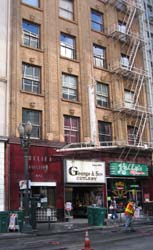
Justin Oswald has just announced that he will be closing the doors of Gallery 500 on December 1, after a final show that opens next week with work by Troy Briggs and Nicholas Di Genova. He's being secretive about future plans for now, but Oswald definitely isn't shutting the doors on Portland - we can expect more from him in the coming months. He writes, "I have a strong desire to discover alternate ways to continue re-invigorating the Portland art scene via new efforts and projects. How and when these ventures will come to light has yet to be announced, but I am committed to this city..." During the past 3 years, we've seen the space at 420 SW Washington evolve from the best Thursday night party pad to a legitimate gallery. Let's hope the trend continues in Oswald's next venture. Posted by Katherine Bovee on October 28, 2005 at 13:23 | Comments (1) PermalinkWednesday 10.26.05 Justin Harris the Younger 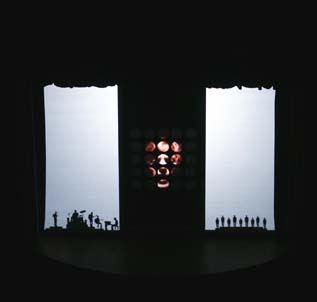 Justin Harris' Theater for One, The Late Great Libido: The Rock Opera The entire month of October has been one ridiculous art ride in Portland and here are a few more links to help you keep track of it all: The Oregonian ran a huge spread on the Hesse collection which sports one of the greatest masterpieces in Western art, the Holbein Madonna. It's very exciting to have this here despite the fact that it is a "blockbuster show". It opens at PAM Oct 29th. Lastly, PICA tips us off that Portlander Justin Harris, whose installation "Theater for One, The Late Great Libido: The Rock Opera" (one of the best works of art I saw last year) also got some great press in Melbourne. It is an an amazing Wittgenstein-level study in solipsistic virtuosity. Posted by Jeff Jahn on October 26, 2005 at 23:40 | Comments (0) PermalinkTuesday 10.25.05 Deliver 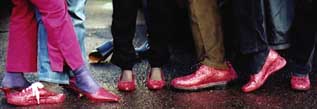 Portland's artists are getting around and the team of M.K. Guth, Cris Moss and Molly Dilworth who make up Red Shoe Delivery Service have received tons of great press down in Melbourne, here, here and here. It is just like Portland to export public transportation as art, although I suspect Melbourne's mass transit is light years ahead of any US city. Also one wonders why those Aussies think RSDS are New York based? Guth and Moss haven't lived there for some time now and Guth was always BI-coastal. We have also noticed Portland's City Commissioner, Sam Adams, has been blogging about the arts a lot lately. Still, the issue of affordable live/work space could really use some creative thinking and action. True, it might be beyond his scope but the issue wont go away until Portland becomes just like San Francisco? i.e. too expensive except for students or the most privileged and often least motivated of trustafarian artists. Some solid ideas need to be championed. Posted by Jeff Jahn on October 25, 2005 at 23:26 | Comments (0) PermalinkSunday 10.23.05 Collecting stories on collecting The Guardian has nice article relating to Portland's new hot topic (finally), serious collectors. Thanks to the guys just down the street (well if I-5 counts) at the OC art blog for pointing it out.
Posted by Jeff Jahn on October 23, 2005 at 13:28 | Comments (0) PermalinkFriday 10.21.05 Nixon Nation 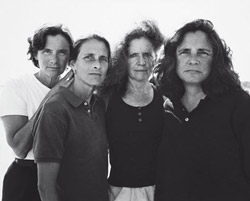 MAN offers a nice post citing the recent national prominence of Nicholas Nixon's The Brown Sisters. I was fortunate to see this series at Western Bridge over the summer. I found it to be thoughtful, compelling and, well, moving. The series consists (thus far) of 30 annual photographs of Nixon's wife and her three sisters. The women are always posed in the same arrangement. What I found most captivating was how they aged inconsistently, some years looking younger than the previous year. Equally fascinating were the shifting interpersonal dynamics read through body language. One can't help but be impressed, too, with the Nixon's conceptual foresight and execution. With a strong line up of exhibitions and some noteable sales, MAN asks astutely, what makes this work particularly meaningful now? Posted by Jennifer Armbrust on October 21, 2005 at 0:14 | Comments (1) PermalinkWednesday 10.19.05 WWeek vs. Oregonian & vis art coverage Ahh the latest WWeek jab at the Oregonian... must be a slow news week (yet still no art feature in the WWeek... in fact no review this week), whereas the Oregonian has been lavish with visual art coverage. Also, Ive always thought that "Death Row" is about the coolest nickname a critic could possibly have. If the editors are gonna fling mud at eachother they might as well fling some arts coverage around as well. The last WWeek feature article on the visual arts was in June!!!* Even the Mercury ran a feature on the affair art fair last month.
*Correction the WWeek ran 1 feature article between June and today's date but it is not archived online, "PAM Deconstructed" on September 28th. Similarly the old reviews are not archived either but that is by design... (bad design but design it is). Posted by Jeff Jahn on October 19, 2005 at 1:31 | Comments (12) PermalinkSunday 10.16.05 Jubitz till you can't Jubitz no more 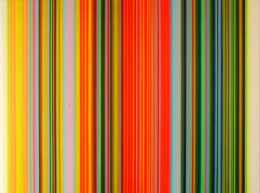 Tim Bavington's Voodoo Child a slight return, solo (in PAM's collection) Ok, so there is even more ink (or electrons) on Portland's new museum wing out there. In The Oregonian D.K. (Death) Row agrees with many of the same things in my review. He's dead on about the lack of Pop art in the collection. Although, he's a bit funny when he complains of a lack of collecting over the last 15 years then gets all frumpy about Laurie Reid, Din Q. Le and Tim Bavington being in the top floor's collection because the work is young. Row makes lots of good points but this is preposterous. First of all Reid was in the 2000 Whitney Biennial and Le was in the 2003 Venice Biennale. Lastly, Bavington is an exemplar of an important group of artists who studied under Dave Hickey in the 90's. He is also in LACMA's and the Albright Knox Gallery's collection (I might add our Bavington is better than theirs). Seriously, all of these are hardly unproven regional West Coast artists and these are exactly the sorts of aquisitions that strengthen the collection. If you got a problem with respected California artists, tough... welcome to yer typical West Coast museum being all youthful and snappy. Actually, that top floor of the Jubitz Center is for exactly that type of young work. The Oregonian also ran an architectural review. Lastly, here on PORT (in the comments) the debate has been going on for some time. Posted by Jeff Jahn on October 16, 2005 at 11:11 | Comments (4) PermalinkThursday 10.13.05 out there on the inter-heck Edward Winkleman has a great post on the recurring death of arts funding. 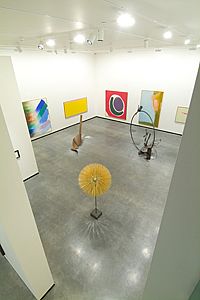
Also, Chas Bowie at the Mercury chimes in on the new Portland Art Museum and writes some similar things to my PORT review about the hang. He is absolutely right but many museums who have had their collections mothballed intentionally overhang for their openers and it can be fixed. It is a way to get key aquisitions as well. Still, he misses how absolutely crucial (but unglamourous) office space is to running a museum. At 28,000 sq feet of new galleries it adds a great deal more than the recent Walker expansion did. Besides, it isn't like the staff didn't have their offices in the other half of the wing before the renovation. Prior to the renovation they lacked air conditioning as well and Portland does get uncomfortably hot during the summer from time to time. In a smart move the offices have been designed so they can be easilly turned into gallery space in the future. Lastly, does the rental sales gallery have to be housed on museum grounds? Nice that the collection is stronger than expected though. Posted by Jeff Jahn on October 13, 2005 at 23:55 | Comments (5) PermalinkTuesday 10.11.05 Hackett weighs in: Seattle v. Portland Carolyn Zick's blog points the way to Monday's big story up north. Some people will consider this old news, but the Seattle Posts' Regina Hackett sounds the alarm to her fellow Seattlites who haven't been paying attention the past few years: Portland is gaining on Seattle. And, the way she admiringly describes the implications of the new PAM wing, perhaps she is harboring feelings that Portland has already caught up? Her solution: find ways to collaborate and make the Portland-Seattle-Vancouver corrider as accessible as possible.
Posted by Katherine Bovee on October 11, 2005 at 10:34 | Comments (1) Permalink2 things The Portland Architecture blog has two good art-ish posts right now. The first on the Lovejoy Columns and the second is on the "really new" economy.
The report on the new PAM wing will be tonight.
Posted by Jeff Jahn on October 11, 2005 at 1:57 | Comments (0) PermalinkSunday 10.09.05 Cranky, ascerbic radio time Just a note, Ill be on Eva Lake's Art
Star Radio on Monday the tenth at 5:00 PM. For those outside Portland you
can access it on the web here.
OK, I officially hate to discuss myself (and PORT is about Portland Art, not my mood) but here Eva seems to think Im some sort of ultimate optimist which is hilarious since generally the only thing I care about is high caliber art, criticism and an involvement with the challenges of the day. All of which is rare and the exception rather than the rule. I'm cranky and not very forgiving and I can be counted on to bitchslap the people who need it. If necessary, I'll draw blood critically. So I really don't know what she's talking about other than my belief that really high caliber art does change the world in a small, obstinate but important way by bringing a tacit form of visual poetry into being. Still, it's only for that tiny audience that still cares about the details... remember those things that can't be turned into a soundbyte? Maybe it's because the Pacific Northwest has a bad habit of fetishing a kind of self-imposed irrelevance that simply isn't my gig (although Portland has really changed its attitude in comparison to Seattle). I am a tactical, very discriminating optimist, it's a weapon and it only means something if you keep it sharp. I like to see talent develop to its fullest expression... nothing less. Maybe it is because she senses that I don't really feel disenfranchised? Well, it's because I'm not and I do believe part of it is because I'm an overeducated white male, 200lbs, 6'2", happy childhood and a generally charmed life who makes a point of backing things up with action, hard work etc. It is weird but Ive really noticed how much the art world seems to respect/tolerate cranky hypercritical men (like myself... and curator Bruce Guenther or legends like my role model Alfred Stieglitz, Dave Hickey, Robert Hughes, Jerry Saltz, Greenberg, Clyfford Still, Richard Serra) and has a problem with most women who try that shtick. Yet most of my favorite art world denizens are women, like the recently departed Linda Farris, Jane Bradley (RIP), Lynne Cooke, Karin Davie, Justine Kurland or Portland gallerists/collectors like Sylvia Engelman, Liz Leach, Jane Beebe or MaryAnn Deffenbaugh. These individuals all seem to be interested in getting the job done and are supportive without lots of posturing. Oh yes and my critique of the Portland Art museum's new Jubitz Center for Modern and Contemporary Art will be here tomorrow. Posted by Jeff Jahn on October 09, 2005 at 23:40 | Comments (4) PermalinkThursday 10.06.05 Portland is becoming.... Portland of course Portland's visual arts coming of age this week isn't just about the visual
arts, its about how the city conceives of itself and Portland blogger Gretchen
wonders if it's still Portland?
My answer is a resounding Yes, our visual arts scene is now more engaged internationally (new museum wing, art fair, and international artists in the galleries... some happen to live here) but there is a sense that Portland has something that other places don't have (from the ground up with lots of small businesses) and the artists are articulating that reality. Yes, there are "shiny people" but there are more funky artists as well and the great thing is how frequently they mix. The new Portland doesn't hide from the world, it engages it. People here seem obsessed with a "better way of life" and a cooler less souless city that is the envy of most people who know much of anything. It is the anti-imperialist but opportunist and forgiving America that Portland celebrates. It generally doesn't matter if you are a republican or democrat here, people feel enfranchised in this city. It all spills over into the visual arts. The people moving here want something different than New York or LA and so do the artists who keep streaming here. Instead of merely vetting inside jokes, quality of "experience" (often through design quality) is a big deal here. Now instead of Portland "not being like other places" it is really starting to articulate what would work better. Its a shift towards acknowledged civic leadership that is openly discussed elsewhere as a model. Seriously, what other US metropolis of 2.1+ million people is so obsessed with art, bicycling, ecology, neighborhoods full of small businesses and good food? Posted by Jeff Jahn on October 06, 2005 at 23:56 | Comments (0) PermalinkWednesday 10.05.05 Drugs, escapism and restlessness Tyler Green over at Modern Art Notes
is absolutely on fire with posts on the Getty
and Tomaselli.
I agree Tomaselli's work is likable but there is something so innocuous about
his work... I suppose its the difference between listening to Frank Zappa or Phish
covering Zappa. Something about the original was so much more threatening and
interesting and Tomaselli lacks that edge. It all seems relevant with MOCA's Exstacy
show and that whole Drunk
vs. Stoned series of shows in New York. The question is, is all this escapism
part of the reason things got the way things are in the White House? Hans Ulrich
Obrist and Daniel Birnbaum have a show in Oslo about the Uncertain
States of America that takes place this weekend... Portland's beloved Matt
McCormick will be part of it. Yes he's in my
show too.
Posted by Jeff Jahn on October 05, 2005 at 21:57 | Comments (0) PermalinkTuesday 10.04.05 Adolescent Lemming Crossing My latest Critical
i article is out now. It discusses the "what next" now that Portland's
art scene has officially achieved its adolescence. Yes, I'll have a post on the new modern and contemporary art wing at the museum soon. For a teaser I liked the athletic gallery spaces and numerous stairs, the placement of the Gilbert and George and think it is intentionally over hung to show off the collection's strengths (sculpture, minimalism) and holes (many... including Pop and major 80's artists). The photography galleries are wonderful.
Also, just in case anyone in Portland missed it Michael Brophy has a review in Art Forum... I know I know I fully expect the world to end too but for the record he deserves the attention. I want to see an ecology/contemporary artshow with him Tom Uttech, Alexis Rockman and Bruce Conkle. As for the Affair art fair... for an initial reaction lets just say its still 1000 times better than any of the Scope Fairs Ive seen. Although one artist summed it up best, "after seeing room after room of adolescent images on paper the whole drawing thing must die." Agreed, drawing has been uncool and formulaic since it became so ubiquitous. Hopefully the lemmings are just about to jump off the cliff! I was absolutely sick of it at least 2 years ago. Posted by Jeff Jahn on October 04, 2005 at 23:49 | Comments (7) PermalinkJeff Bailey Gallery by Jen Rybolt 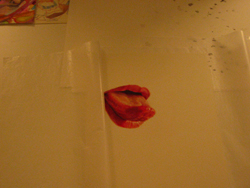
Standouts from the Jeff Bailey Gallery were a series of colored pencil tongues by Julia Randall (entitled Lick Line). The mouths were solitary on their sheets of white paper, and tissue really seemed to glisten with spittle as the mouths formed various expressions. Posted by Guest on October 04, 2005 at 16:13 | Comments (0) PermalinkBucheon Gallery at the Affair by Jen Rybolt San Francisco's Bucheon Gallery had a major standout item in the form of the pompom, felt and object-covered fabric draped over the room's bed like a natural coverlet (it usually hangs on a wall). This was by David McDermott. Jenny Dubnau's faces hung enigmatically on one wall, larger than life and definitely cryptic in their dead-ahead facing of the viewer. David Gerard Romero had a selection of smaller facial portraits-all in the throes of ecstasy, all hanging in formation above the latrine-and also a collection of erotic science fiction comic-style pieces. Posted by Guest on October 04, 2005 at 1:53 | Comments (1) PermalinkSolomon Fine Art by Jen Rybolt Solomon Fine Art (hailing from Seattle) featured a number of interesting objects and paintings, including pieces by Paul Shakespear and interesting wall pieces that contained sculptural elements by Ellen Garvens. The curator, Meli Solomon, nailed something that had been in the back of my mind all night: that people could experience art at the Affair as they would in their own homes- or at least in something more like their own homes than a gallery usually is. The size and content restrictions inherent in displaying in an enclosed space were outweighed favorably by the viewer's unconscious relationship with the more intimate space and lighting. Emily Isenberg had mentioned the same thing about Allston Skirt Gallery's selections; the shipping was prohibitive since they're located in Boston, and the space was limited, but that helped them to create a more intimate, homey atmosphere. Posted by Guest on October 04, 2005 at 1:27 | Comments (0) PermalinkSunday 10.02.05 Froelick Gallery at the Affair by Jen Rybolt I also had an interesting conversation with the fellow manning the room for Portland's Froelick Gallery as I checked out some painted panels by Wiyot artist Rick Bartow. The curator related that Bartow was a multidisciplined artist who is involved with ceramics, printmaking and other arenas in addition to painting, which led to his introducing Froelick to Japanese printmaker Ritsuko Ozeki (who also had a piece featured in the room). While we were there to see sort of the commerce side of contemporary art, it was nice to be reminded of the interrelation between different artists, mediums and that we are all involved with this because we are passionate about modes of expression. Posted by Guest on October 02, 2005 at 16:07 | Comments (2) PermalinkWe're only together for the kids, honestly (Compound Gallery at the Affair) by Jen Rybolt Compound Gallery (a Portland gallery that hosts international shows but also tends to focus on the new generation of Japanese artists) featured pieces by artists including Ren Sakuri (my favorite was a trio of colorfully afro'd women swarming around a long-barreled gun), Re:Verse (paper-collage backgrounds with felt children in the foreground, and terrible events unfolding in the meantime), Auurizum (cute animal-head-hooded figures), Meredith Dittmar (polymer figures), and Junpei Kawamura (amazing, incredibly detailed women comprised of layers of paper hand-inked and colored). The fluidity of Kawamura's fashionably styled females was remarkable considering the pieced-together nature of the whole. Posted by Guest on October 02, 2005 at 15:57 | Comments (0) PermalinkHeather Marx Gallery at the Affair by Jen Rybolt Heather Marx Gallery (San Francisco) also was provocative, although in a more highbrow manner than Art Palace. My eyes were first drawn to the Baroque centerpieces sculpted by David Henzel as pop culture commentary. They incorporated taxidermy elements arranged with autumnal dried flowers and pendulous glass beads that would- almost- be appropriate in your Grandmother's house. Pictured is the piece "Paparazzi." Davis and Davis photograph found dolls and discarded playthings in full sets- there was a definite narrative to these pieces. The dolls are left completely in the state in which they were found, from scuffs to tattered clothing, and then interact with each other in a mildly disturbing subtext. Libby Black recreates consumer goods in paper mache, down to the last detail. Her Louis Vuitton boombox and cassette selection (featuring Tina Turner among others) was done to scale and plastered in the familiar LV logo. She seems to ask us to consider our wants and desires against our actual needs. David Lyle paints greyscale (at least these selections) oil on panel versions of found vintage photographs depicting slices of Americana- but the America that isn't always smiling as it moves to pose for the photographer. One in particular, "State Fair Domination," is of an older woman who's just won prizes for all of her cakes but one, and that one she looks at discontentedly. Posted by Guest on October 02, 2005 at 15:44 | Comments (0) PermalinkArt Palace at the Affair by Jen Rybolt I next visited Arturio Palacios' gallery Art Palace (a play on his name, look closer). Austin, Texas has long held a reputation as the home of a thriving music scene and, as embodied by Art Palace, is clearly developing as a hotspot for new art as well. I really, really enjoyed the selections in this room. Ali Fitzgerald's graphite sketches, approximately 2'x3', were frenetic and detailed... apparently, she also does semi-truckload-sized paintings based on her sketches, although the content shifts slightly with the dimensions. Michael Sieben (also the founder of Austin gallery Camp Fig) offers marker/pen illustration-style drawings of comic-y dream-style monster/animals and paints the same on boards. The drawings were actually done on pages from "How To Draw" books... Posted by Guest on October 02, 2005 at 15:27 | Comments (0) PermalinkI thought I told you never to call me at this number... (The Affair by Jen Rybolt) Howard House from Seattle hosted a room dominated by a wall-sized collage of fabric, acrylic and pigment -- emblazoned with a huge skull and called Victory by Default -- by Donald Baechler. There were also a couple of graphite sketches flanking the skull piece by Chiara Minchio (entitled "Neonschnitte") done on neon paper that grabbed the eye. Posted by Guest on October 02, 2005 at 15:11 | Comments (1) PermalinkFriday 09.30.05 Don't tell me how to rock, I'm from here! The party has officially started here at the affair, the rain has stopped and we are feeling all of the pleasure and none of the guilt. If you come right now you can catch me breakdancing.
10 year old front man of the unlawful guardians started it off, followed by a strange but exciting solo performer who wowed the audience with his floor moves and unbridled passion. The affair is in full swing. Did you rock this hard when you were 10? This kid will never ever be called a nerd. I'd love to write more but I think I've gotta check out the what all the screaming is about.... 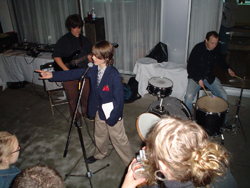
Posted by Isaac Peterson on September 30, 2005 at 23:08 | Comments (0) PermalinkThe Beginning of the Affair by Jen Rybolt Not even driving rain could keep the patrons from enjoying the evening.
White Column Gallery from New York City was my first stop. The first piece to grab my attention was "Gold Madonna" by Scott King. I was also intrigued by "Self Help Video," a found poster that was... shall we say "amended" by the artist Simon Bidwell. "Make Art Not War," a poster by Bob and Roberta Smith, was hung over the room's bed, which made it not only a play on the slogan "make love not war" but also reminded me of Ono and Lennon's bedded anti-war statement. Another highlight of personal interest were archival photographs by of early punk icons Lux Interior, Poison Ivy, Exene Cervenka, Lydia Lunch and a surprising photo of a Negative Trend member.... Posted by Guest on September 30, 2005 at 18:22 | Comments (0) PermalinkWednesday 09.28.05 Shining some light on the collection Light is the first of painters. There is no object so foul that intense
light will not make it beautiful. -Ralph Waldo Emerson
The new Center for Modern and Contemporary art has a very interesting subtext... light. It sounds banal but I'm certain everyone understands how light is the core of visual perception. For those in Portland this focus will make the collection very engaging during the dark months from November to April. Three works in the museum's practically secret contemporary collection certainly shine some light on the subject: 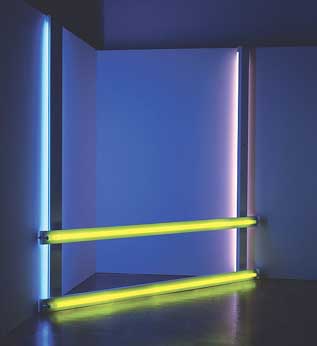
Dan Flavin Untitled (To Donna) II 1971. Fluorescent light. Portland Art Museum, Museum Purchase: National Endowment for the Arts Purchase Plan Grant matched by the Contemporary Art Council. © 2005 Estate of Dan Flavin / Artists Rights Society (ARS), New York 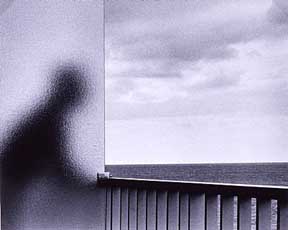
André Kertész Martinque 1972. Gelatin silver print. Portland Art Museum, Gift of the Collections Committee and Friends in memory of Elizabeth Swindells. ©Courtesy of the Estate of Andre Kertész, 2005. 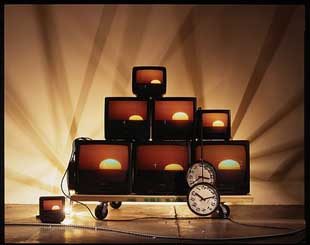 Matthew McCaslin Alaska 1995. Television sets, clocks, light bulbs, VCR, electrical hardware, rolling cart. Portland Art Museum, Museum Purchase, Robert Hale Ellis Jr. Fund for the Blanche Elouise Day Ellis and Robert Hale Ellis Memorial Collection. © Matthew McCaslin. Posted by Jeff Jahn on September 28, 2005 at 23:35 | Comments (0) PermalinkMonday 09.26.05 NKOTB Posted by Jennifer Armbrust on September 26, 2005 at 0:03 | Comments (0) PermalinkSunday 09.25.05 Confusing the confusion with a party It's been a week but Portland artist Scott Wayne Indiana has some nice dada ball pictures on his site of people he knows and doesn't
know. PICA's dada ball is Portland's ultimate
art party, although calling it a "surreal" experience of course isn't quite historically
correct. Although dada
and surrealism
were related, they weren't the same and dada was in many ways the more serious
and radical movement, whereas surrealism was more about public scandal (which
in many ways seems less radical to us after watching Michael Jackson's life
unfold). The later surrealists included Andre Breton and Jean Arp (who was also
a dadaist just to make things more confusing and therefore more interesting)
etc.
Next big art party is the opening of the Affair @ the Jupiter hotel art fair this Friday and then the opening of the Portland Art Museum on Saturday the 1st of October. Pfeeewwwww it's a busy fun time in Portland. For our readers from far away, we now have Jet Blue in Portland... get on it if you want to have a fun art weekend totally unlike LA and New York. Different is good. Posted by Jeff Jahn on September 25, 2005 at 21:06 | Comments (1) PermalinkFriday 09.23.05 Something in the Water Something seems to have sparked a trend and suddenly, everything's popping up
galleries. Perhaps it's the dense concentration of artists begging for exposure,
or the tepid Portland economy that makes it more enticing to create your
own job than work for someone else, or maybe it's just something in the water.
Whatever the cause, the result is four new galleries (two traditional, two hybrids)
opening in two weeks.
Paul Middendorf has defected from Disjecta and, for the moment at least, moved his Manifest Artistry projects to the back burner to team up with artist Paige Saez as co-director of Gallery Homeland. Infiltrating the less commercial Southeast quadrant of the city, Homeland has taken up quarters on the corner of 34th & Belmont, a stone's throw from coffee, cocktails and bourgeois groceries. Exhibiting young local favorites and importing trans-nationals, Homeland aims to "encourage emerging and challenging concepts in visual and performing arts." Their first show opens next Friday (competing with the Affair and the new CMCA wing) with three Portlanders, Zak Margolis, Charles Moss and Amy Steele. There will be live music with the artists and directors in attendance. Opening Reception • September 29th • 7p Gallery Homeland • 926 SE 34th Ave • Tel. 503.819.9656 Around the corner from Homeland is the Missing Link, delivering all things Japanese/toy/collectible to the East side of the river. Occupying the former Spoink! space, ML houses art shows in the back quarter and opened to a packed house last week with an exhibition by S.F. yeti-loving graff artist Bigfoot. Shows will rotate bi-monthly, at least in the beginning, with a line-up of skate/graff/design leaning artists. Expect some young fresh fellows to roll through this informal space, with price tags built for the creative class. Missing Link • 3314 SE Belmont • Tel. 503.235.0032 As we reported last week, Laurel Gitlen is gearing up for the launch of her new space, small A projects and now has a website. She has also added a screening of Heavy Metal Parking Lot to her housewarming on October 7th. Rat your hair, rip off your sleeves and grab a nice cold MGD for a night of all things Rockin'. Gallery opens September 30th • Reception October 7th small A projects • 1430 SE Third • Tel. 503.234.7993 Next we traverse Burnside to the other side of the river where we find what may or may not qualify as a gallery. Housed in one of Portland's sexiest buildings, where Wieden + Kennedy and Bluehour rub elbows, B Street Gallery is actually a facade for the showroom of the under-construction Civic condos. The gallery will last two years, until the condos are up and the showroom is closed. According to the website, they will feature work by "local and emerging artists celebrating everything about Burnside"?! Yes, indeed, those are their words. Have these people driven on Burnside recently? I am interested to see what about Burnside these artists will be exalting... the homeless sleeping on the sidewalk, the prostitutes, the crack heads, the traffic, that Volvo dealership, the fact that you can't ever make a left turn? Any old how, there's currently new artwork hanging by some of the Zeitgeist fellas: Paul Fujita, Keith Rosson and Mike McGovern. Hopefully they had some better ideas than I did. Open to the public October 1st B Street Gallery • 202 NW 13th Ave • Tel. 503.241.1926 Posted by Jennifer Armbrust on September 23, 2005 at 0:37 | Comments (0) PermalinkSunday 09.18.05 Tough as nails 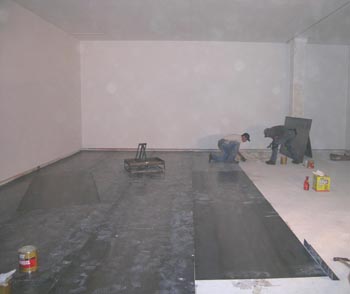 Pulliam Deffenbaugh Gallery is installing their kick ass metal floor now. They have suffered through years of (ugghh) carpeting and now it is cold hard steel. Ive been in shops with a steel floor but never a gallery. Will it set the bar higher for their artists in terms of toughness? I consider it a good thing as Portland's gallery boom isn't just an increase in #'s... there is also a deepening in toughness and scope too. Posted by Jeff Jahn on September 18, 2005 at 0:00 | Comments (0) PermalinkThursday 09.15.05 Getting the MOST out of Portland  Things are really humming in Portland these days so here is a little checkup of interesting local art writing on the net; still it's just the tip of the iceberg. Portland Public Sculpture takes on the single worst sited and clumsily executed public sculpture in PDX. You know that atrocity on the traffic triangle by Powell's books. Although, I think the interactive element is OK-ish enough for silly public sculpture the base is so clunky it must go. Sweet hell, I hate it. In fact, I should to have a spiritualist summon the ghost of noted stainless steel sculptor David Smith and suggest he haunt the sculptor. This belongs in mall in Clackamas… or better yet as a manmade reef somewhere off the Florida coast. I wonder, can anybody defend this thing? In the Oregonian DK Row (a.k.a. Death Row) took on The MOST at the T.B.A. festival. I find the trend for participatory art that incorporates officious bureaucracy like The MOST or Allison Smith's "The Muster" a bit disturbing. It's similar to Kafka's The Trial (Orson Welles' film version is one of my favorites). Maybe someone will eventually create a project called "The Man" and the artist will keep everyone but the richest and whitest folk down… Also at the Oregonian, Harvest Henderson had a nice piece on Mark Smith at Elizabeth Leach and some blowhard jerk curator's show. John Motley at The Mercury penned a nice review of Walid Raad's show at Reed College. Read PORT's review here. Posted by Jeff Jahn on September 15, 2005 at 23:47 | Comments (0) PermalinkTuesday 09.13.05 Told you so... 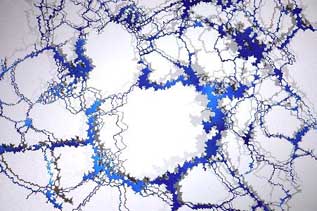 Just because I've told you so before and I like to rub it in.... Oregon's hottest up and coming artist, Matthew Picton, continues to garner critical raves from Miami to Christopher Knight at the L.A. Times. Now the San Francisco Chronicle adds to the critical din. Picton's work takes Smithson's nonsite or Richard Long's walks and brilliantly manages to invert the inevitability of wear and tear for a time. The end product is an engrossing negation of negation and an interesting avenue out of minimalism and into succinct complexity. His best works provide a location while being completely lost and out of context. Finally, earthworks have been removed from the dirt that many confuse as some kind of eco-minimalism. It's philosophical and elemental not moralistic and didactic folks. Admittedly, he's in the big international warehouse show I'm curating and he's debuting his newest body of work... I'm expecting a lot from him. Until then you can find him in San Francisco here. Posted by Jeff Jahn on September 13, 2005 at 22:52 | Comments (0) PermalinkChalk up another for the New Guard  Laurel Gitlen announces the opening of her new gallery space, Small A Projects. Laurel previously resided as gallery director of Savage Art Resources and will take over the Savage space under the Hawthorne bridge with her new endeavor. "Adopting a strategy that combines the best attributes of commercial galleries with the experimental attitude of alternative exhibition spaces, Small A Projects will present exhibitions and projects with emerging and underrecognized artists as well as more established artists." Gitlen will be offering rotating gallery exhibitions, one-night events, edition releases, video screenings and more in a push to educate and entice a diverse audience. She begins her programming on September 30th with ALL I WANT IS EVERYTHING, a group show celebrating the transcendental, transformative and humorous aspects of heavy metal and rock and roll featuring the work of Michael Bise (Houston), Barb Choit (Vancouver/NY), Zoe Crosher (LA), Craig Doty (New Haven), Erik Hanson and Josh Mannis (Chicago). Foregoing regionalism in favor of strong emerging nationals, Gitlen holds great promise for broadening and sharpening Portland's visual arts by importing influential and experimental up-and-comers. Expect a website and additional information within the next couple of weeks. Small A Projects • 1430 SE 3rd Ave Housewarming Party • First Friday, October 7th • 6 to 8p Posted by Jennifer Armbrust on September 13, 2005 at 17:42 | Comments (0) PermalinkThursday 09.08.05 Portland Influence It's no surprise that Portland is influencing other less "fringe" places,
this is a city that allows innovative ventures without 150 million in the bank.
Now, Ultra PDX, (our city's best fashion blog) points out another instance of
Portland's (aka PDX) influence over fashion centers. It's not like there aren't
trend spotter all over the city (occasionally with video cameras).
Posted by Jeff Jahn on September 08, 2005 at 19:02 | Comments (2) PermalinkNew Digs Wow, the new Mark Wooley Gallery is incredible and hosts a formidable group show of national artists.
I can't think of a more ideal space for exhibitions: giant movable walls, a beautiful wood floor, lots and lots of space. This is a beautiful coup for portland, and the send off show delivers on the promise of this space. I had time to pop in at the opening just long enough to take some pix, so I thought I would share them so you can take a look at the luxurious space for yourself. By the way, as I'm writing it's only nine, so there's still time to catch the all night dance party! 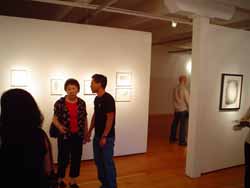
more photos.... Posted by Isaac Peterson on September 08, 2005 at 1:04 | Comments (0) PermalinkTuesday 09.06.05 Our 4th month Well folks, PORT continues to thrive with the supposedly slow month of August being our third straight month of readership
growth. Also, you'll notice all sorts of new sponsors.
To our readers and sponsors, your support is overwhelming, thank you... you know who you are. News from the net: PICA's Time Based Art festival opens Thursday with the free STREB performance in Portland's living room, Pioneer Courthouse Square... be there. Modern Art Notes does a good job on arts related Katrina info. Locally, arty Portlanders should email Richard to coordinate Portland efforts for artist victims. Outside the tragic sphere, John Motley at the Portland Mercury interviewed Merry Scully, the new gallery director at Elizabeth Leach. She seems to have cajones and we are interested how she might affect primary market shows at the gallery. I like adventurous people and Liz (that Portland firecracker) wouldn't have sought out Scully unless she brought that to the table.. Also, my latest Critical i article is out as well. As for the blogosphere PORT promises we will eventually have a blogroll, but until then we would really like to thank some of those quality art and culture blogs for linking to us: The OC art blog (thanks for listing us 1st) psst... I grew up in the OC during the dying days of disco... roller disco was a lowpoint for Western Civilization. Edward Winkleman … a Brooklyn gallerist who has the most consistently content-rich art posts around. He did a good job with Katrina coverage too. Ultra PDX (Portland's rock'n fashion and culture blog) From The Floor (a literary critic who often writes about private collections) … and last but not least the Portland public artwork blog (a masochistic subject if ever there was one… such pain!) Posted by Jeff Jahn on September 06, 2005 at 23:00 | Comments (3) PermalinkSunday 09.04.05 Zombies vs. Robots 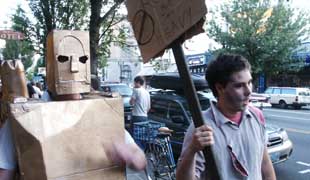
Generally I consider most political art to be a stunted and a bit stillborn. One great artist who happened to be political was the late Leon Golub. His stuff worked because his images of brutality were never too resolved or specific and thus never seem dated. Also, I agree with Mick Jagger that Jimi Hendrix's Star Spangled Banner at Woodstock was the best political performance art piece…ever. In Portland's recent First Thursday we were treated to the unveiling of Robots vs. Zombies at Couch Gallery in the Everett Station Lofts. It was amusing in a clumsy lo-fi way, and definitely a spoof on the polarized nature of American politics. I'll assume the brainless, trudging zombies are supposed to be the Republicans and the plodding, mechanically awkward robots are the Democrats acting out some political logic algorithm that spouts out cheap words like, "humans are our friends." There is some truth in these one-dimensional stereotypes, although one could argue that they are interchangeable. Adversaries often are. Although the costumes were too cheap and cheesy to take seriously it was a serious subject matter. A high point for me was when a zombie bashed a robot over the head with a "Robots are too heavy" sign…. Whatever happened to, "he's not heavy he's my robot!" Still, it was only partly amusing and half formed… a diversion at best and that seems dangerous. Then again these are dangerous times for nuanced free thinkers who think both the... Posted by Jeff Jahn on September 04, 2005 at 23:22 | Comments (1) PermalinkTuesday 08.30.05 busy PORTers PORT's staff are a busy bunch as I sit on my duff typing this:
Katherine along with her husband Philippe recieved a fine review from the Oregonian & Jenn does the infamous Ultra Q and chats about collecting in the WWeek. Posted by Jeff Jahn on August 30, 2005 at 23:20 | Comments (0) PermalinkWednesday 08.24.05 How to Be an Artist Do you want my advice about how to become a successful artist? I'm not so sure that you do. I have two words for you: MOX IE. Being a product of the academic art system myself, I have advice you might find contradictory, but let me explain. As you advance, there is a point in school when you realize that you are paying quite a lot of money for the experience of two simple things: a studio and resources which allow you to pursue your work independently, and participation in a ready-made artist community. Many people installed in an academic program take those things for granted, and just hope to skate through to greater earning potential.
My advice is this: Stop worrying so much about being accepted by galleries or academic institutions. Don't waste your mental and spiritual energies marketing yourself. Work as little as possible, as work is the great enemy of artists everywhere. Work just enough to fund a studio for yourself and buy whatever supplies you need. Ask for help from other people, you will be suprised how much help you will be given. Lose your apprentice mindset. Lose your student mindset. When people ask you what you do, don't ever say "I'm trying to be an artist" or "I'm trying to make it as an artist" say "I am an artist." It isn't arrogance, it's the truth. Don't suck up to anyone. Claim your own power. Put all your eggs in the same basket. Be reckless. Be daring. Be defiant. Don't think about shows at all. Think about the art you are doing. Then reach out, not to institutions, but to other people in the same position as you are. Other artists. Band together and support each other, encourage each other to work more, share studios and keep each other on track, work your heart out and enjoy it, drink whiskey and critique each other late at night on the weekends. Build an artist's community with integrity and galleries will come to you. If there is an older artist you admire write them a letter. The list of older artists who have taken me under their wing and given me guidance is far too long to write here. They will be flattered and will probably ask you to dinner. At the very least you will get a friendly rejection from someone you really admire. Here's a letter Jasper Johns wrote to me telling me he had no need for a studio assistant but wishing me good luck. Isn't it great to have Jasper Johns wish you luck? 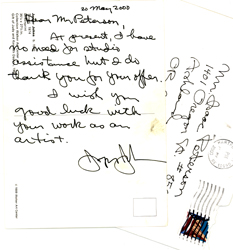
There's a giant book called Who's Who in American Art. Using it you can contact any artist you admire in the US. Matthew Barney always needs assistants. I think his policy is that he gives anyone an unpaid trial period and then if you do well you get on the payroll. So save some money and go! The first thing you'll learn is the exact temperature a refigerated room needs to be to sculpt in Vaseline. Regardless of what you think of his work, a year working for him would be equivalent to or better than any academic program. To be an artist there are only two rules: Work as hard as you can in your studio, and make friends with as many other artists as you can. In the immortal words of MC5: KICK OUT THE JAMS! Here's a relevant link on the same issue: foot in the door Posted by Isaac Peterson on August 24, 2005 at 11:53 | Comments (2) PermalinkFriday 08.19.05 Critical Cop Out ...Cop Out After reading Todd Gibson's recent diatribe about his least favorite critical cop out I thought it was as good as time as any to point
out some over-used critical cop outs.
1) quoting from an artist's statement in the first paragraph 2) using the word "postmodern" as a postmodern pastiche of postmodernity in a way that contextualizes the contemporary modern post-hyperbole world of the prefuture. 3) "Neo"-anything …after the matrix it needs to go away for at least 10 years 4) simply describing the show as a form of critical review 5) lists 6) using the word "slickness" as a pejorative and describing high production values as some inherently damning trait... exactly how is that? Did the artist accidentally produce something with impeccable finish? (For our non-Portland readers this is an issue because Portland's production values have climbed astronomically in certain cases and the staunch, old-time regionalists who have seen the city rapidly grow in sophistication now yearn for art that looks like it was whittled by beavers). 7) describing an artist's career as "on fire" then using it as the only justification for giving it more attention Posted by Jeff Jahn on August 19, 2005 at 2:08 | Comments (6) PermalinkTuesday 08.16.05 The Whitney Drill 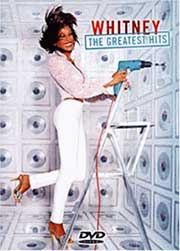
Wrong Whitney, and can't she afford a cordless drill? Well folks it is Whitney Biennial studio visit time again and since August is a notoriously dead month it's a topic ripe for near pointless conjecture. (Although Portland surprisingly still has a bit going on and then some.) Just in case you haven't come out of your studio for 8 months, Chrissie Iles and Philippe Vergne are the co-curators this time out. Don't worry, odds are they probably won't visit you or your favorite artists... For fun, let's explore some potential themes and trends for Whitney 06? 1) More fetish of fantasy escapism as a metaphor for liberal impotence? 2) Artists might be chosen through a series of photo shoots for Vogue… or better yet, pick only "seasoned" artists just to piss off all the young whippersnappers under 55. (call it the Boomer Biennial. I like it and I'm 30+ish. Has the whole youth thing gotten old?) 3) Just to keep the clichés fresh, declare "photography is dead" 4) Focus on the habits of infamous museum directors instead of art… Thomas Krens, Barry Munitz and Malcom Rogers? 5) Just rent out the Whitney to NADA and get it over with. Not gonna happen, but Clear Channel might eventually do it… Seriously, will it go political like the recent Venice Biennale? Or should it present artists who actively look at the future and its challenges instead of the backwards nostalgia of the last biennial? Will it be about paranoia and pleasure in keeping with the current state of the nation? Stasis as a theme? Maybe something about the demographic tension between the Boomers and everyone else? Will it travel as Tyler Green has suggested in the Wall Street Journal? Hmmmm lets look at the past, the 2002 Whitney was chock full of youth subculture mongering, it fetished doodle-fantasy and the trend stuck. It's best offering, the Forcefield collective, didn't stay together too long after being discovered though. At WB2002, The Royal Art Lodge's influence was everywhere but being Canadians they couldn't take part. It's also very likely the WB2002 had too many artists which weakened its arguments and suffocated people. Critics destroyed it, possibly because it wasn't New York centric (at a time when New York had just come under attack). Then again, they probably destroyed it because almost all of it lacked staying power, except Chris Johanson. (its not because he's in Portland either... he's often really good) The 2004 Whitney was hailed as a godsend, mostly because the theme of nostalgia was easy for most everyone to relate to. It also seemed attuned to "the market" and doing so again would look bad. Yes, WB2004 was all about New York despite the fact the art world has fragmented. Somehow WB2006 needs more teeth than the previous two and the now rampant quasi-Victoriana ain't the toothiest of genres. One last thing, the recent Greater New York show would have been a critical dud in LA, Seattle, Houston or Portland too. Standards are up in the West and each city has its better artists that make New York's B+ team look rather bad. Lets just see A team art please? (and no nostalgic Mr. T references?) Posted by Jeff Jahn on August 16, 2005 at 21:03 | Comments (0) PermalinkWednesday 08.10.05 Keeping up and walking Comparatively, Portland has a lot of art writers... even for a city twice its size and there is a lot of online content to keep up with. Here are some of the best links from PDX and abroad.
The Oregonian's Victoria Blake had a nice review of Eunice Parson's show. Recently there was an appropriate quashing of the latest Portland Art Center show too. For comparison here is PORT on Parsons. I felt the Parsons show was strong, mature and probably a bit overhung. Not too original (with collage does that matter?) but definitely a valid modernist redux from an octogenarian artist. The Mercury's John Motley reviews Chris Johanson this week. Last week Justin Westcoat Sanders wrote about the Steve Gutenberg show, stupid but entertaining. Also, the Merc now features the same horrid site redesign that Seattle's The Stranger has inflicted upon its readers. On Artnet, Donald Kuspit tries to explain the reduction of images into code (and pixels) but misses the historical boat and forgets that the Industrial Revolution was all about making everything in a coded, highly replicable way. Pixels are just an extension of the modularity that the Gutenberg printing press, particle physics, Hargreaves' Spinning Jenny and Henry Ford's assembly line have innovated. That is "the code" modern painters are intuiting. Kuspit's real flaw is coming at it as an art historian instead of a historian. Modern and contemporary art history's epistemology needs lots of help, mostly because it's so new. The last, but in many ways best link is to the Walking Portland blog. Portland is a city of walkers and that aspect really separates it from places like Seattle, Phoenix and LA etc. In my daily wanderings I notice things and mix with billionaires and bums in a way that profoundly effects my consciousness. It's urban and somehow riding around in a car is inherently suburban. Walking and Portland's appeal to a mass of artists are very related. Posted by Jeff Jahn on August 10, 2005 at 22:01 | Comments (0) PermalinkTuesday 08.09.05 South Beach Showing Tyler
Green has started leaking the line-up for Miami's satellite fairs. No word
on the elusive
NADA line-up but Portland makes a strong showing at Aqua.
Might as well book your reservations now. Should be another fabulous par-tay.
Posted by Jennifer Armbrust on August 09, 2005 at 13:06 | Comments (0) PermalinkGolden advice on gallery hunting Portland is filled to the gills with unsigned artists and a bunch of new galleries are moving in. Yet, many ridiculously talented artists are less than savvy when it comes to approaching these galleries. To the rescue comes Brooklyn gallerist Edward Winkleman with some golden advice here on his eponymous blog.
....and just for fun (because Tuesdays are dull) is this link. Posted by Jeff Jahn on August 09, 2005 at 0:02 | Comments (2) PermalinkThursday 08.04.05 I'm a man of wealth and taste Whenever I have to introduce myself, "Sympathy for the Devil" starts playing in my head against my will. Not that you could get any insight from that fact. I am an artist and a writer. I grew up in Juneau, Alaska and relocated to Oregon. I have just recently returned to Portland to live indefinitely after finishing my MFA in Cincinnati.
I am overjoyed to find such a rich, active art scene here. Jeff's observations on the expansive growth of the Portland art scene could not ring truer. Personally, I feel that Portland is sprinting towards greater recognition as a national and international art center, and I count myself among the privileged to have boarded the rocket just prior to launching. I am grateful to be involved, here and now. My goal in writing for PORT is to enrich the dialogue surrounding the emerging Portland Renaissance, through analysis and critical discussion. I believe that criticism and art grow symbiotically from the same impulse, each can be enriched by the presence of the other, while maintaining independent vitality. Following in the footsteps of Larry Charles ("Oh, you delicate genius!"), I believe neither in the all-knowing critic nor the isolated genius artist. I have come to see art as a social arena which is always powered by interaction and in which both the artist and the critic have free agency. Artists often create descriptions of things not found in the world, things yet to be seen, and it is up to the critic to try and decipher and identify them. I believe in the relevance of art, that it is not an elitist pastime affecting only those involved, but rather that it is a necessity for the survival of the human spirit. This is as true as it was in the days of the Lascaux cave painters as it is today, although today art takes many forms and exists simultaneously in a myriad of arenas, and the white cubes which replaced the caves have been swept clean of animal bones (mostly). As I said before, I am excited to be writing about art in the City of Roses, and I feel that much more will be written about this city and this decade. Posted by Isaac Peterson on August 04, 2005 at 17:49 | Comments (0) PermalinkWednesday 08.03.05 RACC-ing up a new cultural survey  The Regional Arts and Culture Council (RACC) just released the results of a new arts and culture survey poll backing up the already widely known anecdote that Portland is an extremely liberal, creative city that likes to say it likes to support the arts. Read it here. Here is just one highlight: "Portland-area residents are avid consumers of arts and culture performances and exhibitions. Almost two-thirds of the population (72%) attends an arts and culture events at least every few months. Fully one-third attend arts and culture events at least once a month. 16% attend arts events at least once a week." Ok, but anyone that attends an arts event every few months probably isn't all that serious a cultural consumer, important but not a core audience. The once a monthers are important too but it's that last group that really got my attention... Posted by Jeff Jahn on August 03, 2005 at 21:38 | Comments (0) PermalinkMonday 08.01.05 Introducing Isaac Peterson PORT welcomes Isaac
Peterson as its newest staff writer. Isaac is new to Portland and comes to
us with lots of art writing experience from Art Week and a recent MFA from the
University of Cincinnati. He's emblematic of the hoard of young artists that continue
to flood Portland's hectic scene and brings national level experience as a former
assistant to Judy
Pfaff. His writing style is energetic, informed and expansive. Portland rewards
talent fast and Isaac definitely has it. Thanks for finding us after being in town for only two days Isaac!
PORT's energy and scope is due to all of its excellent contributors and Isaac's previous posts have earned him a staff position. PORT itself is only two months old but the publication has been an exciting success, expanding Portland's international profile. So much so we've become a near daily publication with an avid core of daily readers and an ever growing monthly readership of thousands. PORT will continue to expand our international reach, providing everyone with internet access inside and outside Portland a window on this very active scene while providing a conduit for international information. Our readers are great and we thank you! Needless to say we are learning as we go along and there have been many recent technical refinements. Also, you'll notice even more sponsors added in September and it's exciting that we have been told we've affected attendance at some of the shows we've covered. We are grateful for all of the flattery and contentious snarking our readers bring both, to our forums and the streets. Posted by Jeff Jahn on August 01, 2005 at 21:16 | Comments (0) PermalinkSunday 07.31.05 Portland art district report & link-o-rama 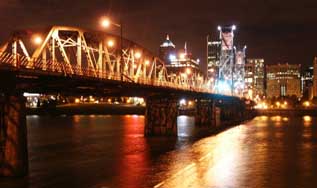 Portland is changing on a weekly basis and the latest critical i (my longrunning monthly column for NWdrizzle) does a little midterm report card for the numerous art districts in town. Read it here. The most notable finding is that a large # of very sophisticated graduates from good art schools continue to lead and redefine the sophistication level of the city. It seems like every young person in Portland is an artist. Overall, it isn't the institutions or galleries leading the way it's the almost goldrush phenomena of the artists scene that continues to be where the best action is in PDX (as many of us like to call it). That said, the fact that there are 2 newly minted arts districts and most of the galleries and institutions are becoming more cutting edge seems to back up Portland's reputation as a progressive city on the move. Want more portland blogs? Ultrapdx covers Portland's very active fashion scene Eva Lake's Lovelake covers her experience as an artist and gallerist Portland Food covers the very good and expansive restaurant scene in PDX (my recommendations clarklewis and Bluehour) and if you really want to dive into the Portland experience check out these blog spots: Orblogs and Urbanhonking Posted by Jeff Jahn on July 31, 2005 at 22:05 | Comments (1) PermalinkMonday 07.25.05 Around Cyberspace... Ben
Davis recaps Scope Hamptons on Artnet. In it, he takes customary swipes at
Scope for being scrappy,
cites the growing presence of Latin American artists and gives props to Lifeboat
by Paul Middendorf (PDX) and Mary Mattingly (NYC) of Manifest
Artistry.
Tyler Green dishes the dirt on Thomas Krens' future at the Gugg. With his loft on the market, is he moving on or just moving? AbLA likens the art market to the music biz with some precautionary words. With an (over?)inflated market and a recent tendency toward short-sightedness, is the art world setting itself up for a string of vapid one hit wonders? Caryn argues, and I agree, that artists, gallerists and collectors need to take the long view to build careers, not another spash in the pan. Posted by Jennifer Armbrust on July 25, 2005 at 20:31 | Comments (0) PermalinkLinda Farris 1945-2005 Simply, the greatest public champion of cutting edge art by cutting edge artists in the Pacific
Northwest...
Linda Farris passed away at her Seattle home Friday July 22nd as a hero to those in the visual arts because of her personal loyalty, eye and panache. Through her eponymous gallery in Seattle, Farris brought the likes of Robert Rauschenberg and Louise Nevelson to the Pacific Northwest. Despite the big time names it was her frank honesty, over the top hustle and daring that made her more than just an art dealer but an icon of fearlessness. Of all the people I have met in the art world none has impressed me like Linda Farris. With no double talk, a deep trust in artists, crazy in the best possible way, constant risk taking and a probing intelligence... she stood out. I respected her ability to piss off wall flowers and naysayers. Her legacy lives on in the artists whom she supported. Her innovative Contemporary Art Project (1999-2002) brought together 13 investors who each gave Linda $15,000 a year to collect cutting edge contemporary art. The results on such a modest budget were spectacular featuring; Justine Kurland, Sue De Beer, Karin Davie, Julie Mehretu, Delia brown, Cecily Brown, Lisa Yuskavage and Inka Essenhigh. In 2002 the CAP collection found its permanent home at the Seattle Art Museum. She also made contemporary art exciting on a personal grass roots level in Seattle, championing the work of Robert Yoder, Sherry Markovitz, Norie Sato and Jeffrey Bishop. After closing her gallery in 1996 she was instrumental in her support of artists like Jack Daws & Lisa Leidgren and many others in Seattle. Linda had a fast eye and supported Portland luminaries like Damali Ayo, Jacqueline Ehlis and Laura Fritz before anyone else in Seattle realized a renaissance was occurring to the south. Hell, she caught on faster than most in Portland. Yes, she's known as a very public personality but she was incredibly personable in the confidence of small groups. My fondest memories are driving her around downtown Portland with Frank Zappa's "peaches en regalia" blasting on the stereo, her incredibly good advice and her refereeing of a footrace in the University of Washington's Red Square between myself and Jacqueline Ehlis (fittingly between Linda and Barnett Newman's "Broken Obelisk"). It is an understatement to state that no Pacific Northwest art dealer before or since has had the balls of Linda Farris. It's fitting that her life sets a challenge. She set the bar and we could all do well to be a little bit more like her, but there will be only one Linda Farris. Also, check out the Seattle Post Intelligencer on Linda Farris here. Please feel free to leave some of your reminiscences about Linda as comments on PORT.... I fully expect her deeds to outlive the legend of her well lived life Posted by Jeff Jahn on July 25, 2005 at 2:06 | Comments (1) PermalinkTuesday 07.19.05 Do the PICA Shuffle? PICA has made two announcements, maybe three.
First off, Mark Russell has been named Guest Artistic Director of PICA's Time-Based Art Festival 2006 & 2007. Ok, a guest director is an innovative idea. Read about it here in the Portland Tribune. PICA's own website is woefully out of date so don't look there. What the Trib missed though (it was buried deep in the press release) is that longtime Managing Director, Victoria Frey, is now Kristy Edmund's replacement as Executive Director. This isn't so innovative when PICA is in desperate need to recover a tarnished image in the visual arts, generate excitement, forge ahead in new directions and reinvigorate fundraising. Frey has some serious questions to answer. The first being, "How is this new?" We also note how clearly the press release states that the TBA festival (performance art) is their "vanguard program." That #2 slot is where the visual arts stands folks. PICA and Frey will have to really make a case for PICA being relevant in the visual arts in Portland. Granted, the press release indicates there will be a "Guest Visual Arts" curator named in the Fall, but that task is a rather tall order. First is the space issue. PICA's current corporate lobby space is simply inadequate for serious exhibitions as pointed out by PORT yesterday and my article 2 months ago. Locals lovingly call it the "coat check." Not exactly worthy of the national level programming that PICA has as its stated mission. Next, is the fundraising issue, PICA needs to raise or allocate $75,000+ to do this properly. ($125,000+ is more like it) This amount is definitely do-able and the money exists but I'm uncertain if it exists for PICA's spotty record. It requires a curator that instills confidence and excitement along with the savvy to connect to the audience here. Will a guest curator be capable or even have the pull as an "instant lame duck" to raise that kind of excitement and funds? This guest curator will also need combat the rather significant hurt feelings with the art scene. Can a curator do that from afar or on a "guest" salary? Does guest = part time? PICA doesn't just need a guest visual art curator, they need a miracle worker.... or they have to settle for lowered expectations. Still, with the Art Museum's $40,000,000 new wing sporting some exciting contemporary programming PICA's visual arts isn't going to be able to survive lowered expectations and miracle workers aren't easy to come by. I want PICA to succeed in the visual arts but it will require some serious thinking. Posted by Jeff Jahn on July 19, 2005 at 22:54 | Comments (7) PermalinkSunday 07.17.05 Scoop on the Affair art fair 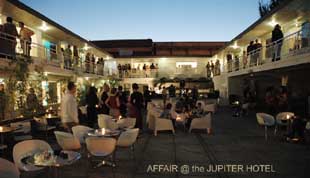 Because PORT readers like to be on top of things here is the scoop: the list of galleries and organizations for the Affair @ the Jupiter Hotel art fair September 30th-October 2nd The last Affair was way better than any Scope Fair so mark your calendars. This year's lineup is even better. Yes, there are art fairs everywhere (yawn), but this one is in Portland and therefore simply feels a lot better. This isn't some sattelite fair...it's a comet from the Oort (art?) cloud. (I'm not kidding, being in Portland and its relative novelty makes a huge difference). The addition of project rooms by Mona Hatoum, Art 21, Diverseworks and White Columns should give the show an even stronger profile. Add in the fact that the famous Doug Fir Lounge is operating this year (it's on the hotel courtyard) makes for a venue that couldn't get much cooler. With numerous other shows corresponding to the fair and CMCA it's worth the price of a jet blue ticket to Portland. Gallery List: Augen Gallery, Portland Allston Skirt Gallery, Boston Jeff Bailey Gallery, New York Blackfish Gallery, Portland Blanket Gallery, Vancouver, BC Bucheon Gallery, San Francisco Compound, Portland Alysia Duckler Gallery, Portland Froelick Gallery, Portland Gallery 500, Portland Garde Rail Gallery, Seattle Richard Heller Gallery, Los Angeles Howard House, Seattle Inman Gallery, Houston Greg Kucera Gallery, Seattle Elizabeth Leach Gallery, Portland Motel, Portland Lizabeth Olivera, Los Angeles PDX Contemporary Art, Portland Platform Gallery, Seattle Pulliam Deffenbaugh Gallery, Portland Ratio 3, San Francisco Laura Russo Gallery, Portland Savage Art Resources, Portland Solomon Projects, Atlanta Solomon Fine Art, Seattle Stephen Wirtz Gallery, San Francisco Projects: Art Gallery of Greater Victoria, Canada Fluent-Collaborative, Austin Diverseworks, Houston White Columns, New York Mona Hatoum, presented by Reed College Publishers: Clearcut Art21 Artpapers Portland Modern ...and you know PORT will have a presence: the whole Jupiter Hotel has wifi and Portland has a high-tech image to live up to. Posted by Jeff Jahn on July 17, 2005 at 14:17 | Comments (2) PermalinkThursday 07.14.05 Art and Opinions  Justine Kurland's Twisted Limbs (the Burned Forest), 2004 Ok It is possibly your last chance to see the Justine Kurland show by PICA in the Weiden and Kennedy lobby on Friday the 15th. The building isn't open on the weekends (uggh) and you need to see this work before 6:00 PM when the place locks up. Kurland is probably the best artist affiliated with Yale in the last 15 years (that includes Matthew Barney and her onetime prof Crewdsen). Oh yes and Saturday the 16th is the last day of PICA's Landmark show : NW 13th & Flanders : Open Wed - Sat, 12-6 pm free to PICA members, $2 general. See my PORT review here. I'm liking The Portland Mercury's new art critic John Motley, here is his Daniel Kaven review, he pays attention to details and whether consistencies and inconsistencies are intentional or not. Kudos. Last but not least is the Mercury's Chas Bowie who has written quite the head scratcher here about art writing? First off, what group of milquetoasts do you hang out with? Please back up the statement, "public digression runs counter to our natural instincts." I suppose that innately epicurean instinct (i.e. non public) is why blogging and reality TV shows have become so popular? I wonder what kind of waffletastic weenie crew you have met but the art world is generally opinionated and definitely chatty (catty too). It is what makes it work, everyone agrees to disagree. Yes, money is poisoning "Art" now but it in terms of print it just makes people ignore criticism more selectively. It doesn't silence the criticism, it just makes it disconnected for a time being. After the market correction one looks prescient. Yes some craven toadies edit themselves but people like Roberta Smith, Jerry Saltz, Christopher Knight and Tyler Green call it like they see it. From my own experience, when Robert Storr asked me what I thought of his Site Santa Fe show, I told him. We talked over some divergent points and amicably went our merry ways... absolutely no awkward silences. When I wrote a review for Modern Painters that basically tore apart the collective efforts of reasonably powerful curators like Ralph Rugoff and Matthew Higgs, Lisa Corrin etc. for the dull, badly premised Baja to Vancouver show my reviews editor's response was "nice f-ing review " and they printed the thing without alterations. I liked some parts of the show and gave credit where credit was due too. It's true British mags are more critical but Art Forum's review was only slightly more forgiving. Also, I'm not certain what art world you are in, but taking shots at Matthew Barney was pretty much the standard ice breaker for conversations a few years ago. Now it's the overheated market. Opinions are like assholes, everyone has one and it's more about how one backs up that opinion that matters. Art writing is tough for other reasons, the pay is generally lousy and it is difficult to enthusiastically sort the crud from the gems day in and day out. What the art world needs are better ideas after running on fumes and hedge fund money for too long. P.S. Banks Violette is no where near as interesting as Sue de Beer who relies more on noir's dread and excitement rather than kitsch and funhouse design. Posted by Jeff Jahn on July 14, 2005 at 22:13 | Comments (8) PermalinkWednesday 07.13.05 Virtually Hot off the Presses 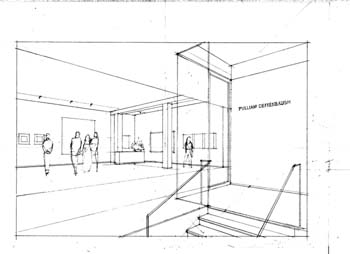 a peek at the new Pulliam Deffenbaugh Gallery Pulliam Deffenbaugh Gallery has released this nifty architect's rendering of their new space set to open in September. It's a busy renovation time and no less than five galleries are moving into better gallery spaces in Portland during the next year (some as property owners). Three of them, including P-D, will be doing so in mere months. Portland is upgrading en masse. Elizabeth Leach started the trend last year. Of note, the P-D space will not be carpeted as their current space is. I confess complete snobbery when it comes to gallery floors and there is no greater faux pax than carpet. I had a dream once where MoMA was covered in thick shag… even the outdoor sculpture court. I think it's part of the reason I dislike Matthew Barney, he is a carpet monger! It was the first thing I noticed at his Walker installation last May. Still, I liked Nan Curtis' shag carpet wear pattern piece at the Northwest Biennial in the Tacoma Art Museum last year. 
Also, I just got back from the Vintage Vandals & Zach Kircher show at Savage Art Resources. Both were good shows worth the trip, it was a packed house too. In fact, it was a great Portland moment with a combination of West Hill's super-patrons with the Weiden & Kennedy hipster crowd. I love it. The Vintage Vandals show was comprised of sometimes extremely entertaining additions to pre-existing kitsch paintings from Goodwill. Distinguished mostly through visual puns the group reminded me of college poetry slams where the winning poets would always be the funniest. 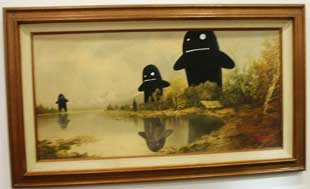 Driscoll Reid's Untitled There is talent here but the two best were Drsicoll Reid's Untitled and Evan Harris' Song of Sirens. Charming and foreboding this is good cheap art for hipsters who like to entertain visually but the better work was Kircher's in the other gallery. Somewhere between Norbert Bisky and Neo Rauch with a Roy Lichtenstein sense of humor Kircher has been at this style longer than those two living art stars have been stars and deserves a closer look. He would fit in well at Bellwether in Chelsea. Which reminds me, the excellent Portland artist Paul Green is in a group show "Idols of Perversity" at Bellwether through August 6th. Posted by Jeff Jahn on July 13, 2005 at 22:20 | Comments (0) PermalinkMonday 07.11.05 Bigger = Better  You must know by now that the Portland Art Museum has been expanding with a new Center for Modern and Contemporary Art with construction underway for at least the last year or so. The new wing is scheduled to open the first weekend in October (mark your calendars) coinciding with the Affair at the Jupiter Hotel and a gazillion other art events. To celebrate the Museum's $40 million North Building expansion and opening of the region's largest center for modern art, PAM will install Brushstrokes (1996), created by American artist Roy Lichtenstein (1923-97) in the last years of his life. The sculpture has been exhibited at the Corcoran Gallery of Art in D.C., and The Metropolitan Museum of Art, New York and will now make it's home in our fair city. This baby is big, the largest public work by Lichtenstein west of the Mississippi at 29.5 feet (not 30', mind you). The painted aluminum sculpture will be placed on the east side of the Museum campus and in conjunction with the installation of the new acquisition, the Museum will present a dossier exhibition centered around Lichtenstein's brushstroke-themed sculptures by featuring drawings, maquettes and small-scale sculpture. The size of the sculpture is a good match for the scale of the museum's new wing. For those of us who thought the Museum was a bit dated, the CMCA offers an ambitious attempt to deliver PAM into the 21st century. "The CMCA includes over 28,000 square feet of gallery space on six floors, showcasing more than 350 works of art in a full spectrum of mediums, and an underground link gallery that connects the North Building with the Museum's historic Belluschi Building. The North Building also includes magnificent ballrooms for community events, a new curatorial and administrative center, a 33,000-volume Art Study Center and Library, which is the region's most significant resource for art research, and the NW Film Center, the area's finest source for filmmaking arts. Fall 2005 marks the completion of the $40 million project, which is the culmination of the 10-year, $125 million master plan to develop the Museum's campus." This sort of well-executed contemporary arts center has the potential to help put Portland on the map by creating a legitimate venue for the import and export of national and internationally relevant art. I will look forward to seeing the curatorial schedule for the upcoming years which in my fantasy world would fall somewhere between the Hammer and MoMA. The Lichtenstein sculpture and CMCA open October 2, 2005. If you join PAM now, you can probably even beat the crowds and gain entree to the gala events. Posted by Jennifer Armbrust on July 11, 2005 at 17:58 | Comments (0) PermalinkSunday 07.10.05 mini me & mini you 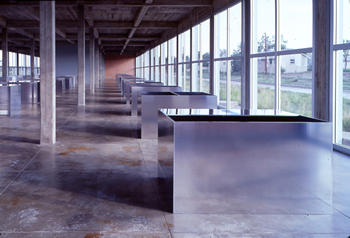
Definitely check out Tyler Green's post on Marfa here. The much abused and arguably abusive word "minimalism" has become so bastardized in the last 15 years that "minimal" and machined aluminum have become synonymous with yuppie aesthetics. If you drive a Lexus or Audi TT go home and count the # of milled aluminum items in your abode... see what I mean. It does show how influential Judd is though. Still, it is definitely a long overdue opportunity to take back the essential experience of Judd, Flavin, De Maria, Irwin, Sonnier and Jo Baer away from the balsamic vinegar crowd and their "minimal" décor lingo. These artists were/are intellectuals who didn't see man as the measure of all things and acknowledged like Shakespeare did in Hamlet that, "There are more things in heaven and earth….than are dreamt of in your philosophy." Currently, too many young artists are just sponging sweat off of Judd's back, but lack the rigorous ascetic iconoclasm. The man was a philosopher not a careerist and his works at Chinati are a great antidote to the intensely vain art that is literally in vogue. Besides, I suspect James Turrell's Roden Crater will be a more successful way to assume astro vivid focus than some pied wallpaper piper will ever achieve. Sometimes, doing things the hard way is the only way. Posted by Jeff Jahn on July 10, 2005 at 22:41 | Comments (0) PermalinkTuesday 07.05.05 The "P" word regarding Portland? 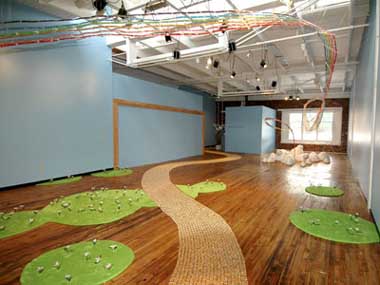 Chandra Bocci at Haze October 2004 (media: otter pops and mucho mustard packets) Writing the word "perfect" is a nasty habit and a sloth inducing moniker. Yet today, Budget Travel published a no holds barred gushing review of Portland that used the consarned "P" word. It is pretty much all true but man is it positive… in fact, my fillings feel funny after reading it. Portland does have major challenges and chief among them is not being content with what it has already achieved. Still, writer Kimberly Sevick was absolutely right about the food thing here and she even plugged one of our best artists Chandra Bocci. Some of the facts were off though, such as Bocci showing a pillow fight war at Haze. Actually, it was an amazing 70 ft looping rainbow of otter pops and a yellow brick road of mustard packets. The pillow fight was at ORLO. What Sevick missed, (other than restaurants like Blue Hour, clarklewis, Mingo, Genoa and the specifics of gallery scene, like Liz Leach, PDX, Woolley, Pulliam Deffenbaugh, Froelick, Laura Russo and Savage among others) was the fact that the young artists of the scene have really helped change Portland's overall level of sophistication by staging a lot of high profile shows. It is a rare thing with a lot of history in a short time. Posted by Jeff Jahn on July 05, 2005 at 21:54 | Comments (0) PermalinkMonday 07.04.05 Freedom from Liberty at WTC 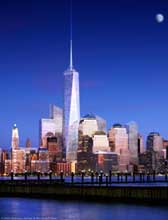 the newly redesigned Empire State Building with a twist Since it is the 4th of July here is a little bit on the Freedom Tower at the WTC site. Nicolai Ouroussoff pretty much nails it in the NYT's here. Also, check out the commentary by curbed. I'm going to take something from Jerry Saltz's January 2004 lecture in Portland, namely the Panorama at the Queen's Museum. Though unintentional, the Panorama looks like it will be the best WTC memorial (below). It is an insult to injury that the "Freedom from Liberty" tower's architecture is more of a Maginot Line challenge to terrorists than a challenging design. 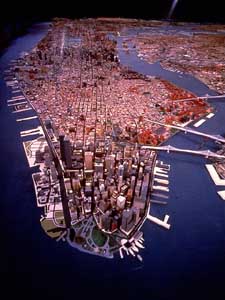 Posted by Jeff Jahn on July 04, 2005 at 14:13 | Comments (0) PermalinkFriday 07.01.05 Use antlers in all of your decorating 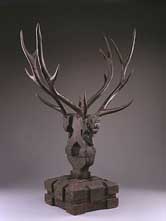
Two-headed Earth Spirit, Warring States period China The latest critical i, my ongoing experimental online magazine column for NWDrizzle is now up. In it I take on a Warring States period Chinese artifact from the Schnitzer's fantastic collection, Batman Begins and the boxing photography of Jim Lommasson. You can buy Lommasson's book here. His show at Powells Books comes down Sunday. There are other Portland art bloggers too, longtime diarist (+ once and future gallerist) Eva Lake and Scott Wayne Indiana are two of em. Posted by Jeff Jahn on July 01, 2005 at 23:13 | Comments (0) PermalinkMonday 06.27.05 A Less Modest Proposal 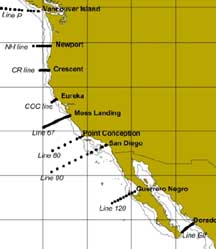 I've said it a hundred times and it's still true, culture is a growth industry on the West Coast. (I even said it on CNN last year.) Also, I think that art.blogging.la and zerodegreesart are onto something by proposing a stronger California Biennial, but I don't think they are thinking big enough. The west in general is getting itself together with major museum expansions in the works in Mexico, LA, Portland (October 2005) and Seattle (2007). Also, San Francisco just opened the new de Young. Instead, I believe a bigger triennial taking the strongest art from west of the Mississippi (the area most neglected by the Whitney Biennial) along with Mexico and Vancouver BC would be very difficult to ignore. Then again maybe focusing on coastal lands west of the Mississippi is the way to go(including Texas). The problem with the California Biennial, Oregon Biennial and Bay Area Now shows is they aren't broad enough thought bombs to galvanize discussion outside of their respective zones. The regional biennials are vanity shows that do some good but don't launch things on a larger scale like the Whitney often does. It is an ambition issue and there needs to be something that takes things to a higher level. For example the "Thing" show at the Hammer was a nice tight regional survey. Although excellent for what it was, "Thing" didn't stamp its foot quite loud enough. It wasnt designed to be the the West Coast's coming out party. The regional biennials like the California and Oregon ones seem a tad quaint in the same way the latest Greater New York felt mostly junior varsity and solipsistic (except Yuken Teruya). At GNY the artists were already too familiar to that scene and it felt picked over. The Whitney's advantage is it covers a huge area with a bias towards New York (it has been weakened by too much bias though). I think the Whitney Biennial would actually benefit from being challenged. I believe a western rodeo of an art show of... lets say 30 artists would also probably be LA biased but it would give validity to LA's strength as an international art city with a network of connections that East Coast museums probably are not aware of. The only way for LA to become Rome is to make more roads lead to it as a way to identify peripatetic talent that may or may not reside there. The argument is cosmopolitanism 101. Yes, 2 years ago the Baja to Vancouver show attempted to do this but it purposefully avoided taking stock of both Los Angeles and Portland (two of the most active US coastal art cities). Because it was mostly focused on Vancouver it felt out of touch and both Art Forum and Modern Painters (penned by yours truly) gave it pretty crushing reviews. Still, I believe it opened the discussion and pointed out a few pitfalls. First of all, it had too many curators on its committee (6) and a project like this would work better with only 3 or possibly two autonomous teams of two? Also, including some critics in with the curators might make it stronger? Tyler Green has made a good case for why biennials are dead but I believe the root of their malaise is their predictability. A western roundup would be something new and therefore more unpredictable. Things are still young and a bit untamed out here in the west. Why not put on a show that presents that as a strength? New York's weakness is it's lack of vacuum and breathing space. Yes, museum politics are an issue but if it takes place in one location it minimizes that issue. Lastly, this is obviously a difficult, possibly unlikely idea but it can't hurt to bring it up. It would require a real budget to truly make it happen too. Any additional thoughts? Posted by Jeff Jahn on June 27, 2005 at 23:43 | Comments (5) PermalinkSunday 06.26.05 Mountain on the Move  Those who live elsewhere might not know that Mt. St. Helens is currently erupting. In fact the "minor" eruption that took place march 8th was the most impressive thing I saw this year...ok any year (pictured above). The volcano is 65 miles from Portland and is quite visible on clear days in the city. For those who lack their own volcano you might enjoy Mount St. Helens: Photographs by Frank Gohlke, which opens June 29 at MOMA. Posted by Jeff Jahn on June 26, 2005 at 23:01 | Comments (0) PermalinkThursday 06.23.05 July is marvy in June 
This is old news to Portlanders….but the secret connection between Miranda July and Carrie Brownstein is (besides the article in Interview Magazine's July issue)… Portland of course. No one city can really lay exclusive claim to an artist though. Instead, artists are peripatetic gifts and this fact only makes miss July's first feature film's critical success even more marvy. July called Portland home until 2002 and we still see her around quite a bit. Brownstein of course is part of the Portland based rock group Sleater Kinney. July's multiple media talents are old news to the art world but that makes it kinda fun to see her catch on amongst the Ebert enclave. (Also, why do people tolerate the kind of pompous hand jive he is doing in the picture below?) Overall, the article is decent, if a little brief and it highlights both the seriousness of intent and the anti-focus group aesthetic decision making process that one finds a lot amongst Rose City citizens. (Could it be ambition without prefabricated outcomes?) In terms of July's career it's a mark of strength to take this sudden mass media momentum on her own terms. (it is also very Portland, other cities have pockets of this vibe too but practically everyone here has it) Here are some more Miranda July links: in the NYT, here, there and everyone else we know. In Portland, artist Jacqueline Ehlis continues her art coverage onslaught in the WWeek. All froth and saturation aside, her's is a very deserving show. Speaking of serious content, her interview with Eva Lake for Art Star Radio has now been transcribed here. To round out other Portland links it looks like the Portland Mercury has found itself a new art critic? We noticed there was no review last week, good to see a review with so many good June shows. Around the blogosphere Edward Winkleman makes some very provocative points about China and art fair/biennials. His point about China being so widely accepted is very interesting. I suspect that the Chinese, who impressively have had a large scale bureaucratic government for over 3,000 years found it easy to sway the allegiance of the neophyte art world's bureaucratic system. ....am I wrong? Yes, some of the Chinese stuff is good, but by and large the city of Los Angeles deserves at least as much attention. At least Ed Ruscha is getting the credit he is due. He is in the July issue of Interview too. Posted by Jeff Jahn on June 23, 2005 at 23:04 | Comments (1) PermalinkWednesday 06.22.05 Blood or Art?  It isn't always an easy choice and I'm certain Tim Dalbow is kidding, but this little email excerpt is too good: "Thanks for. . . .the mention of my blue balls (civic art project), but I'm already on to a new project designed for the nonprofit bleeding of poor artists for donations. If you haven't already heard I want to supply solicitation with pints (ouch) of my own blood. It costs me no money and it's a renewable resource!" -TSD It does touch a nerve regarding Portland's now too frequent tendency to raise money for nonprofit organizations through art auctions. It is as if the artists are some eternally milkable cow. Yes, like Rumplestiltskin, artists are capable of spinning straw into gold but that colorful character didn't fare too well in that bargain either. We should note that most of the auctions are noble and help raise hundreds of thousands of dollars for good causes but at best it is getting tired and at worst it seems vampiric. I think auctions should be rare and for emergencies, not long-term funding strategies. Any thoughts? Posted by Jeff Jahn on June 22, 2005 at 20:24 | Comments (5) PermalinkPoliticking and the Market Tyler
Green's got a great post this morning that touches on two recurring discussions
(replete with lots of links). First, debunking the myth of the merit-based major
art fairs a la Basel or Biennale (we all know it has been a politicking
game all along). And secondly, that art criticism (and I would say also the perceived "value"
of art) is no longer about content, intention, social relevance or technical innovation,
but rather, the market. These two issues are far from resolved but it seems timely to begin a serious dialogue about their cause and effects.
Posted by Jennifer Armbrust on June 22, 2005 at 9:56 | Comments (0) PermalinkIt's No Accident Be sure to check out Joseph Gallivan's article in Tuesday's Portland Tribune profiling collector Sylvia Engelman. Despite its title (an unfortunate editorial decision), the article provides a rare look into the motivations and activities of one of Portland's more important collectors, whose collection reveals an astute eye that is anything but accidental. Portland's collectors are notoriously shy, many accruing their collection with relative anonymity, most reticent to reveal their collection or ambitions in a public fashion. Engelman, who has proved her reputation for seeking out rising talent early on (Jacqueline Ehlis, Michael Oman-Reagan, Jesse Durost) as well as for collecting work by key international artists (Sol LeWitt, Damien Hirst) shares with refreshing candor the finer points of how and why she collects.
Posted by Katherine Bovee on June 22, 2005 at 0:39 | Comments (2) PermalinkSaturday 06.18.05 Fortress Munch As reported in today's NYT,
the Munch Museum in Oslo has re-opened ten months after the embarrasing heist
of "the Scream" and "Madonna". With $5.2 million in new sercurity
measures, getting into the museum promises to be as fun as boarding an airplane
("Could you remove your shoes and belt please..."). The anti-theft
measures involve bolting artwork to the walls (why this wasn't already in place
I have no idea, even hotels and corporate towers are smart enough to bolt their generic originals) and mounting thick glass panels over each piece. To the
shagrin of some administrators, the previously unadulterated views of the original
artwork are now intruded by Windex streaks and dust particles on the glass preventing
a good view of the brushstrokes. Oh the sacrifices!
Posted by Jennifer Armbrust on June 18, 2005 at 12:23 | Comments (1) PermalinkFriday 06.17.05 Danzine at the Whitney 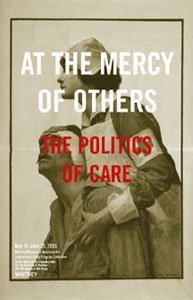 The ISP Curatorial Program at the Whitney is currently running At the Mercy of Others: the Politics of Care through June 25th. Part of this exhibition includes a Danzine Retrospective, curated by Teresa Dulce and Marne Lucas. This retrospective offers some much deserved attention for an organization that provided a decade of critical support for workers of Portland's booming sex industry. From the press release: "The 'Danzine Retrospective' is an important show celebrating ten years of health care and art through the efforts of the non-profit organization Danzine. The success rate of Danzine's outreach progams stems from the grass-roots design: need based, reality based, risk reduction services that reach a stigmatized population. Danzine mission statement 'Danzine was created by and for sex workers and it is our goal to provide the information and resources we needed to make more informed decisions, personally and professionally.' While the agency served needs of colleagues Portland, Oregon from 1995-2005, the risk reduction mission is timeless and its energy resurfaces as health organizations nationwide take cue from its efficacy and sensitivity to those it served." The installation itself is a recreation of "Switzerland", the lounge at the Danzine space, packed with ephemera from the organization's archives including a large collection of artwork, publication covers, event posters, pamphlets, postcards and t-shirts. Participating Artists include a number of Portland prolifics: Fishy, Dawn J., Christina LeBlanc-Stanley, Lara Lee, Scott Nasburg, Arnold Pander, Leslie Peterson, Bryan Pollard, Suzanne Shifflett, Stosh, Sean Tejaratchi, Melissa Tremblay, Ernest Truely, Gina Velour, Kristin Yount and more. A video installation by Teresa Dulce includes news footage from live performances at City Hall in 2000, and the Portland Bad Date Line. Art Gallery of The Graduate Center, City University of New York • 365 Fifth Avenue, NYC • Tel. 212.817.7386 • Tues through Sat 12-6 p Posted by Jennifer Armbrust on June 17, 2005 at 15:43 | Comments (0) PermalinkAll in the Family Margaret Kilgallen's retrospective, "In the Sweet Bye & Bye" opened at REDCAT
in L.A. on Wednesday. A gifted and compelling young artist, Kilgallen died of breast cancer 4 years ago (at age 33) and, to a certain extent, has been
mourned ever since. Her distinctive style was informed by the traditions of
sign painting and folk art and her work embodies a compassion and craft that
has touched the hearts of many. Portland punk photographer and filmmaker
Bill Daniel was on-hand at the opening with a screening of his new film,
"Who is Bozo Texino?". I won't be making it to L.A. before the show's
closure so I welcome any comments of the exhibition.
Speaking of influence, the NYT writes about a public art endeavor spearheaded by ESPO (there "Mr. Powers") in the name of art, commerce and community at Coney Island. Artists and business owners are collaborating to develop new signage on the boardwalk, resulting in some unexpected and enriching alliances and what might be called a minor revitalization. The article mentions but doesn't elaborate on the Dreamland Artist Clubhouse which celebrates their 2005 grand opening tonight, featuring a formidible roster of rising art stars. Something about this just warms the cockles of my heart. Posted by Jennifer Armbrust on June 17, 2005 at 9:36 | Comments (0) PermalinkTuesday 06.14.05 2005 Oregon Biennial on Saturday 
...according to Art Forum's Art Guide the postponed Oregon Biennial is taking place this weekend at an alternate site...the lovely state of Maine (scroll down). The greatly anticipated survey of Oregon art will be the most radical ever since only Maine artists were chosen. All kidding aside, the real one is rumoured to happen in 2006 and thankfully none of the last 2 biennials (although disappointing compared to the pool available) looked as underwhelming as the one in Portland Maine does. There has been talk that the yet to be hired Arlene & Harold Schnitzer Curator of NW Art will be involved. The format really deserves a serious re-appraisal too. Oregon artists are making real strides nationally and internationally and a more focused show of 6-9 artists makes a lot of sense to me. What do you think? Do you prefer it be more focused with less artists? Is jury by slide just too limiting? Should the museum simply commission works, especially considering the number of installation artists we have here? Does the thing really matter now that Portland artists are increasingly using the place as a base for national/international activity? The biennial's contentious nature does keep things interesting. Yes, there is a sense of catching up that needs to be addressed but some museum's move slow and the Portland Art museum is based on the venerable Metropolitan Museum's "better late than never" model. Fact is the biennial is an inexpensive blockbuster for the museum in this art crazy place. Posted by Jeff Jahn on June 14, 2005 at 19:08 | Comments (0) PermalinkMonday 06.13.05 Stumped 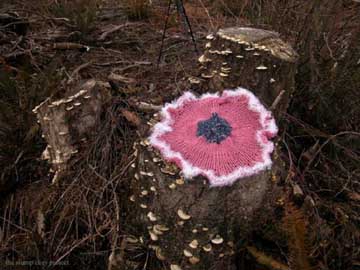
Stump Cozy by Shanon Schollian Ok it is a bit of a tired cliche; but there is a lot of tree art in the Pacific Northwest. Then again, why not when half of Brooklyn is faux forest happy. It's a tad ridiculous but there is something about not having the thing in a gallery that works wonders. Shanon Schollian's Stump Cozy project took place way back in 2002 and now the stumpmeister general himself, Michael Brophy, currently has a show at the Hallie Ford Museum. Malia Jensen also did some shirts for trees a while back too. Ok, lets just say the Lorax is a very influential character around here. The Portland Art Museum even has a serine but menacing Ernst Ludwig Kirchner depicting some Douglas Fir trees which I dearly love, but we have to wait until October to see it again due to construction. Posted by Jeff Jahn on June 13, 2005 at 22:57 | Comments (0) PermalinkFriday 06.10.05 Greetings & Salutations Since PORT has been up and running for over a week, I suppose it's time I introduced
myself. This online arts journal was an idea I had last year after being inspired
by the other regional art blogs popping up around the country, especially the
fine folks at art.blogging.la.
I had mentioned the idea to Jeff on a couple of occasions and at the beginning
of the year, he pressed me to pursue the idea more seriously so I enlisted him
as a collaborator. Six months and three additional staff writers later, viola!
The vision of this online arts journal is to catalyze critical discussion and disseminate information about art as lensed through Portland, Oregon. Using weblog functionality we are able to deliver you up-to-the-minute news, reviews and events. User comments are encouraged and easy to post (commenting requires a simple one-time registration, allowing us to weed out spammers and maintain transparency). You are invited to join in the discussion and interject your own supporting or dissenting ideas. Portland has a thriving art community which can only be strengthened by critical and sometimes firey discussion. So, play fair and don't be shy! As this endeavor unfolds I'm sure there will be changes, revisions and improvements. If you notice any technical problems, please email us and we'll fix it. I will be handling the announcements of openings and events and the calls for artists. These will be centered around events in the Portland-metro area or exhibitions of Portland-based artists in other locales. To be considered for our calendar, please visit the Contact page for more information. My day job consists of running Motel, a gallery in Portland's Chinatown showcasing up-and-coming artists and independent designers from around the country. I also work occasionally as a freelance graphic and web designer. Stop by and say hello if you're in Chinatown (we're on Northwest Couch between 5th & 6th). For more about me and the rest of the contributors, visit the About PORT section. Thanks and welcome! Posted by Jennifer Armbrust on June 10, 2005 at 10:56 | Comments (0) PermalinkHello, Congress? Over at MAN,
Tyler Green calls for accountability among non-profit heads, hilighting lavish
expenditures by Barry Munitz at the Getty (citing the
LAT). $6000 shower curtains, baubles, Cuban vacations all on his expense
account? And yet, he's only accountable to the hand-picked board that funded
this lifestyle. Time for some legislative intervention?
Posted by Jennifer Armbrust on June 10, 2005 at 10:03 | Comments (0) PermalinkWednesday 06.08.05 Art Wars? 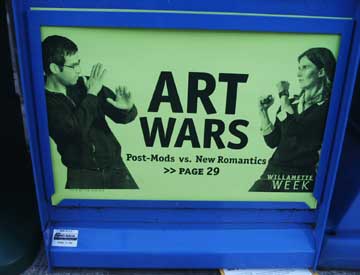
The Willamette Week (our Pulitzer Prize winning weekly) has this image plastered on boxes throughout town depicting Sean Healy and Jacqueline Ehlis mock Kung Fu fighting. Visual art is the big game in Portland and this generalist paper is trying to suss out the aesthetic agendas of the over 10,000+ artists in this city of 2.1 million. With new artists arriving each day good luck! Read the doomed thing here. (I apologize in advance, I'm mentioned). Needless to say I disagree with a lot of the silly particulars and the flakey absolutism of it all but its existence contributes to the general sense that there is something going on here (it could be compared to the music scene in Seattle in the 90's, not 1994 either). When I took the quiz I polled as a post-mod... so silly, frankly history is cyclical and we aren't post anything. Actually, the cover story in the same issue about live/work space is very good. I do think one can sift through artists by determining those who aren't satisfied with the morass of everyday life and do something about it. It's an existentialist... Posted by Jeff Jahn on June 08, 2005 at 23:47 | Comments (0) PermalinkMonday 06.06.05 Superflat Earth Society 
PORT digs Interview magazine's June issue devoted to all things Japanese, including art. Nice to read about Murakami and Yoko Ono seeing, "another world," in a philosophical sense. As expected, nothing too deep or intellectually charged in here but those two really matter and it is probably because they have romantic notions of change. (Portland is very into Superflat and much more recent Tokyo stuff and less so into Fluxus... but it is here too). Add in Yayoi Kusama and Tadao Ando for this issue and you got something. At least it is an American magazine focused on another country. Yet it is difficult to fathom Yoshitomo Nara being one of, "The Artists To Watch." ….ummm maybe in 1995. One's got to wonder what audience living under a rock (or Okalahoma cornfield) has yet to gain at least casual awareness of Nara? In a true Superflat leveling of commerce and high art Nara has licensed T-shirts, diaries and bookends as well as art. He is pretty much the Peter Frank of the art world. If you are in any kind of large city he is widely available. Maybe it's targeted at the hapless babies of Gen X'rs… We liked Nara in grad school, now my classmates are putting little Timmy in Nara wear? It's a better move than Louis Vuitton but is it the darn museum gift shop creeping into life? It will be interesting to see which one, Murakami (gone fashion) or Nara (gone Timmy's room décor) will be best remembered by history. It's the age old battle "models vs. babies"…two sides of the same coin. Posted by Jeff Jahn on June 06, 2005 at 17:44 | Comments (1) PermalinkThursday 06.02.05 Hitting the streets 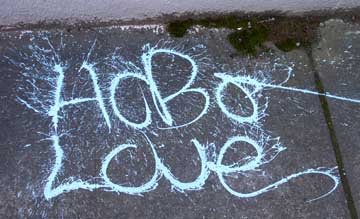
As Katherine mentioned in her recent post I write something called the critical i, here is the latest. There is a review of Justine Kurland's talk,a few shows from last month and takes Disjecta (a would be institution) and PICA to task. Also, it is First Thursday in Portland (the largest gallery hop), although tomorrow night's openings with Jacqueline Ehlis at Savage and the Snapshot Chronicles at Reed College might be the best new shows to see. Check out Jenn's list for shows tonight here. Also, for those not lucky enough to live in Portland you can see some of our best artists elsewhere. If you are in Chelsea, D.E. May is at Pavel Zoubok Gallery and Harrell Fletcher can be found at The Wrong Gallery. In LA Matthew Picton @ Solway Jones Gallery is attracting some important press, watch this one. In Montreal T.J. Norris debuts DK @ Atom Heart Posted by Jeff Jahn on June 02, 2005 at 18:02 | Comments (0) PermalinkGoing Public While intelligent critical discussion may not always happen in a very public fashion in Portland, I know it is taking place because I've heard it everywhere from informal conversations with acquaintances to academic lectures. Dialogue is taking place amongst artists, critics, gallery owners and curators based out of Portland. It's also happening by artists and art professionals coming to Portland to find out what the rumors are all about. It's obvious to longtime Portland residents, recent transplants and visitors that something is brewing here, and it's not to be missed.
Critical discussion about art in Portland reaches far beyond the few measly plots of printed real estate allotted to arts coverage in local print media. For a city of this size, with this much activity, with this many practicing artists and functioning galleries, and now, within the past few years, with the increasing amount of political interest in branding Portland as a city for art and artists, it's only natural to expect critical discussion to grow into maturity with its artists. It's truly mystifying why much of Portland's art writing has remained corralled by the scant amount of printed space available to the arts. The turf is much larger than that and the discussions go much deeper than that. Fellow PORT writer Jeff Jahn's NW Drizzle column broke away from a dependence on print (and the strictures of diminutive word counts imposed by the economic realities of print). With the launch of PORT, critical discussion now has a public forum that allows for a greater volume of writing with far more immediacy. My particular interest as a regular contributor of PORT is in inciting these discussions and ensuring that the link between Portland and the rest of the world is a two-way conduit for ideas. Posted by Katherine Bovee on June 02, 2005 at 10:17 | Comments (0) PermalinkWednesday 06.01.05 Contributor Andie DeLuca introduces herself I don't make art. I don't show it, sell it, or curate it. I simply love looking at it and writing about it. Though I grew up in Portland, I am fairly new to the appreciation of the Portland art scene. The love of art only captured me as an adult, and my years of study did not allow me the leisure to explore the wealth of local galleries and other exhibition spaces. I come to PORT with the desire to explore these venues and report on my findings. Like a newly arrived transplant from a distant city, I want to find the best galleries, artists, and environments. My goal is to draw on my love of the city and the authenticity of the art aficionado's experience to evaluate current exhibitions and trends. From small, out of the way spaces to the established galleries and that grande dame the Portland Art Museum, what is going on in Portland? More than just "knowing what I like," I also want to challenge myself to see new art in new ways, and to write about it fairly, but with an astute critical eye. I look forward to reading other's comments on my discoveries....
Posted by Andie DeLuca on June 01, 2005 at 14:30 | Comments (0) PermalinkWelcome to PORT 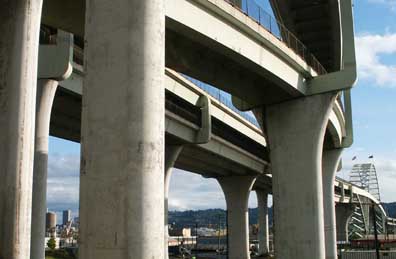
For those in the know, it isn't news that Portland Oregon's visual art scene has experienced a massive influx of artists (over 10,000 according to the last census) that has subsequently redefined the sophistication of this city of now 2.1 million metro inhabitants. This trend has only intensified and has been reported on by CNN, Art News and Modern Painters (by yours truly). What is so special about Portland is that unlike other major US cities visual art is the big game in town. Many artists have developed in noteworthy ways in the last five years. For context, Portland is a place where mass transit is popular, trees are big, volcanoes blow up, reading is relentless, shorts are nearly always ok, gallery hopping can be blood sport and civic issues like urban development are debated with a ferocity that might seem alien to other ennui drenched places. The art reflects this dynamicism that has been lost in many modern cities. In 2001 Peter Schjeldahl somewhat accurately called Portland "Sweden with SUV's" and once George Bush (the elder) much less accurately called it "Little Beirut." In other words like all interesting places it is hard to define and Portland artists are probably making those definitions even more difficult. With that in mind PORT is here to give a forum for the visual art shows, events and critical discussions that are taking place in this most European (yet pioneering) of US cities. PORT will also discuss shows and happenings elsewhere of interest. Here is a very short list of future events that some Portlanders look forward to and others will dread: October 1 The Portland Art Museum opens its massive new wing, the Center for Modern and Contemporary Art. September 30 - October 2 Portland's second annual contemporary art fair the Affair @ the Jupiter Hotel Spring 2006 AGPS architecture will unveil its one-of-a-kind urban aerial tram for Oregon Health and Sciences University. Posted by Jeff Jahn on June 01, 2005 at 2:20 | Comments (8) Permalink |
| s p o n s o r s |
 |
 |
 |
 |
 |
 |
 |
 |
 |
 |
 |
 |
 |
 |
 |
 |
 |
 |

|
Site Design: Jennifer Armbrust | • | Site Development: Philippe Blanc & Katherine Bovee | |

